
The Project Gutenberg EBook of Every Boy's Book: A Complete Encyclopædia of Sports and Amusements, by Various This eBook is for the use of anyone anywhere at no cost and with almost no restrictions whatsoever. You may copy it, give it away or re-use it under the terms of the Project Gutenberg License included with this eBook or online at www.gutenberg.org Title: Every Boy's Book: A Complete Encyclopædia of Sports and Amusements Author: Various Editor: Edmund Routledge Release Date: February 23, 2013 [EBook #42172] Language: English Character set encoding: ISO-8859-1 *** START OF THIS PROJECT GUTENBERG EBOOK EVERY BOY'S BOOK: SPORTS AND AMUSEMENTS *** Produced by Chris Curnow, Harry Lamé and the Online Distributed Proofreading Team at http://www.pgdp.net (This file was produced from images generously made available by The Internet Archive)
Please see Transcriber’s Notes at the end of this text.

EDITED BY
EDMUND ROUTLEDGE.
With more than Six Hundred Illustrations
FROM ORIGINAL DESIGNS.
LONDON:
GEORGE ROUTLEDGE AND SONS,
THE BROADWAY, LUDGATE.
NEW YORK: 416, BROOME STREET.
1869.
R. Clay, Son, and Taylor, Printers,
Bread Street Hill, London.
The twelve years that have passed since the first edition of Every Boy’s Book was published, have brought so many changes in our national sports and pastimes, and have seen the introduction of so many new games, that it has been thought desirable to remodel this work, in order to bring it down to the requirements of the present time. In carrying out this plan effectually, Every Boy’s Book has been almost entirely rewritten; and scarcely anything now remains of the old work except the title.
All the articles that were in the former edition have been thoroughly revised, and papers on Boxing, Canoeing, Croquet, Fives, Golf, Rackets, Sliding, Billiards, Bagatelle, Dominoes, Spectrum Analysis, Canaries, Hedgehogs, Jackdaws, Jays, Magpies, Owls, Parrots, Ravens, Boats, Cryptography, Deaf and Dumb Alphabet, Dominoes, Mimicry and Ventriloquism, Shows, Stamp Collecting, and Tinselling, appear now for the first time.
In carrying out this work much valuable assistance has been given by Professor Pepper, the Rev. J. G. Wood, W. B. Tegetmeier, Clement Scott, Sidney Daryl, J. T. Burgess, Dr. Viner, Thomas Archer, W. Robinson of the Field, Cholmondeley Pennell, and other well-known writers on sports.
The articles at the end of this work on American Billiards, Base Ball, and the Canadian sport of La Crosse, have been contributed by Henry Chadwick, the leading authority on these games in America.
Christmas, 1868.
It would be impossible for a single author to produce a book of this description with a fair prospect of success, because it necessarily treats of many subjects; and a perfect acquaintance with some of the more important would occupy a lifetime. The reading and researches of one man would not be sufficiently extensive to embrace the rich variety of the materials required. Being fully convinced of this fact, the Publishers have endeavoured to obtain the aid of the most distinguished writers in the various departments of knowledge which the following pages are intended to illustrate. Thus each contributor, in furnishing his quota of information for the work, has been engaged in a congenial task, one best suited to his peculiar turn of mind, as well as to his individual acquirements, and one upon which he could, therefore, with the greatest ease and accuracy dilate. This brief explanation will show in what spirit the Publishers embarked in the undertaking; and the accompanying list of the writers may be received as a proof that they have succeeded in securing the services of the most competent authorities. With that portion of the book with which he was practically acquainted each of the following gentlemen has dealt: W. Martin, Esq., C. Baker, Esq., R. B. Wormald, Esq., J. F. Wood, Esq., A. McLaren, Esq., Stonehenge, author of “Rural Sports,” and the Rev. J. G. Wood, author of several works on Natural History, who also furnished some of the designs. The remaining illustrations are by William Harvey and Harrison Weir; and the credit for the able manner in which they have been engraved is due to the brothers Dalziel.
2, Farringdon Street,
February, 1856.
| PART I. | |
| EASY GAMES WITHOUT TOYS. | |
| OUTDOOR. | |
| PAGE | |
| Hop, Step, and Jump | 1 |
| Hopping on the Bottle | 2 |
| Hop-Scotch | 2 |
| French and English | 3 |
| Drawing the Oven | 4 |
| I Spy | 4 |
| Pitch-Stone | 3 |
| Duck-Stone | 5 |
| Prisoner’s Base, or Prison Bars | 5 |
| Fox | 7 |
| Baste the Bear | 7 |
| Leap-Frog | 8 |
| Fly the Garter | 8 |
| Spanish Fly | 9 |
| Touch | 10 |
| Touch-Wood and Touch-Iron | 10 |
| Buck, Buck, how many Horns do I hold up? | 10 |
| Warning | 10 |
| Follow my Leader | 11 |
| The Fugleman | 11 |
| Hare and Hounds | 11 |
| Steeple Chase | 13 |
| Duck and Drake | 13 |
| Simon Says | 14 |
| King of the Castle | 14 |
| Battle for the Banner | 14 |
| Snow-Balls | 15 |
| Snow Castle | 16 |
| Snow Giant | 17 |
| Jack! Jack! show a Light! | 18 |
| Jingling | 19 |
| Jump little Nag-tail! | 19 |
| Jumping Rope | 20 |
| My Grandmother’s Clock | 20 |
| Rushing Bases | 21 |
| See-saw | 21 |
| Thread the Needle | 22 |
| Tom Tiddler’s Ground | 22 |
| Two to One | 22 |
| Walk, Moon, Walk! | 22 |
| Want a day’s work? | 23 |
| Will you List? | 23 |
| Whoop! | 24 |
| High Barbaree! | 24 |
| Bull in the Ring | 24 |
| Cock Fight | 25 |
| Dropping the Handkerchief | 25 |
| INDOOR. | |
| Blind Man’s Buff | 26 |
| Bob-Cherry | 26 |
| Buff | 27 |
| Concert | 27 |
| Consequences | 28 |
| Cross Questions & Crooked Answers | 28 |
| Dumb Motions | 29 |
| Family Coach | 29 |
| Frog in the Middle | 30 |
| The Four Elements | 31 |
| Hand | 31 |
| Hot Boiled Beans | 32 |
| Hot Cockles | 32 |
| How? Where? and When? | 32 |
| Hunt the Slipper | 33 |
| Hunt the Ring | 33 |
| Hunt the Whistle | 33 |
| Magic Music | 34 |
| Post | 34 |
| Proverbs | 35 |
| Puss in the Corner | 36 |
| Red-Cap and Black-Cap | 36 |
| Shadow Buff | 37 |
| Slate Games | 37 |
| Trades | 40 |
| Trussed Fowls | 40 |
| The Two Hats | 40 |
| What is my Thought like? | 41[viii] |
| EASY GAMES WITH TOYS. | |
| OUTDOOR. | |
| BALLS | 43 |
| Catch Ball | 43 |
| Doutee-Stool | 43 |
| Egg-Hat | 44 |
| Feeder | 44 |
| Monday, Tuesday | 45 |
| Nine-Holes | 46 |
| Northern Spell | 46 |
| Rounders | 46 |
| Sevens | 48 |
| Stool-Ball | 48 |
| Trap, Bat, and Ball | 48 |
| HOOPS | 49 |
| The Hoop | 50 |
| Encounters | 50 |
| Hoop Race | 51 |
| Posting | 51 |
| Tournament | 52 |
| Turnpike | 52 |
| KITES | 53 |
| How to make a Kite | 53 |
| Flying the Kite | 54 |
| Messengers | 55 |
| Calico Kites | 55 |
| Fancy Kites | 55 |
| MARBLES | 57 |
| Bounce Eye | 58 |
| Conqueror | 58 |
| Die Shot | 58 |
| Eggs in the Bush | 59 |
| Increase Pound | 59 |
| Knock out, or Lag out | 59 |
| Long Taw | 60 |
| Nine-Holes, or Bridge Board | 60 |
| Odd or Even | 61 |
| Picking the Plums | 61 |
| The Pyramid | 61 |
| Ring Taw | 61 |
| Spans and Snops, and Bounce About | 62 |
| Teetotum Shot | 62 |
| Three-Holes | 62 |
| Tipshares, or Handers | 63 |
| TOPS | 64 |
| The Humming-top | 64 |
| Peg-top | 65 |
| Spanish Peg-top | 65 |
| The Whip-top | 65 |
| Chip-stone | 66 |
| Peg-in-the-Ring | 66 |
| MISCELLANEOUS TOYS | 68 |
| The Apple Mill | 68 |
| Aunt Sally | 68 |
| Baton | 69 |
| Cat | 69 |
| Cat and Mouse | 70 |
| Knock-’em-down | 71 |
| Pea-shooters | 71 |
| Quoits | 71 |
| Nine-pins | 72 |
| Skittles | 72 |
| Dutch-pins | 73 |
| Throwing the Hammer | 73 |
| The Boomerang | 74 |
| The Skip-jack, or Jump-jack | 74 |
| The Sling | 74 |
| Walking on Stilts | 76 |
| The Sucker | 76 |
| INDOOR. | |
| Battledore and Shuttlecock | 78 |
| Bandilor | 79 |
| Cup and Ball | 79 |
| The Cutwater | 79 |
| Fox and Geese | 80 |
| Goose | 81 |
| Head, Body, and Legs | 81 |
| Knuckle-bones | 82 |
| Merelles, or Nine Men’s Morris | 83 |
| Paper Dart | 83 |
| The Popgun | 84 |
| Push-pin | 84 |
| Schimmel | 84 |
| Spelicans | 86 |
[ix] |
|
| PART II. | |
| ATHLETIC SPORTS AND MANLY EXERCISES. | |
| ANGLING | 89 |
| A Word about Fish | 90 |
| About the Rod | 91 |
| Choosing the Rod | 91 |
| Lines or Bottoms | 92 |
| Shotting the Line | 93 |
| The Float | 93 |
| Reels or Winches | 94 |
| Reel Lines | 94 |
| Hooks | 94 |
| How to bait a Hook | 95 |
| Baits | 95 |
| To Bait with Greaves | 97 |
| To Scour and Preserve Worms | 97 |
| The Plummet | 97 |
| Plumbing the Depth | 97 |
| Landing-hook and Landing-net | 98 |
| Clearing Ring and Line | 98 |
| Drag-hook | 98 |
| Bank Runner | 98 |
| Live-bait Kettle | 99 |
| Disgorger | 99 |
| Angling Axioms | 99 |
| Salmon | 100 |
| Trout | 100 |
| Jack or Pike | 101 |
| Gudgeon | 103 |
| Roach | 104 |
| Dace | 105 |
| Perch | 106 |
| Grayling | 107 |
| Chub | 108 |
| Carp | 109 |
| Tench | 110 |
| Pope, or Ruff | 110 |
| Bream | 111 |
| Flounder | 111 |
| Eels | 112 |
| Stickleback and Minnow | 113 |
| Barbel | 114 |
| Natural Fly-fishing, or Dipping | 115 |
| Fly-fishing and Artificial Flies | 115 |
| Materials for making Flies | 115 |
| ARCHERY | 121 |
| The Long-bow | 122 |
| The Cross-bow | 122 |
| Feats of the Bow | 123 |
| Length of Bows and Arrows, and how used in Ancient Times | 124 |
| Marks for Shooting at | 124 |
| Equipment for Archery | 125 |
| Ancient Directions for Archery | 125 |
| Decline of Archery | 125 |
| Modern Archery | 126 |
| The Bow | 126 |
| The String | 126 |
| Stringing the Bow | 127 |
| The Arrows | 127 |
| The Quiver | 128 |
| The Tassel, Brace, Belt, and Pouch | 128 |
| Shooting Glove, and Grease Pot | 129 |
| The Target | 129 |
| Butts | 130 |
| How to draw the Bow | 130 |
| Flight Shooting | 131 |
| Clout Shooting | 131 |
| Roving | 131 |
| General Hints for Archers | 132 |
| BOXING | 133 |
| CANOES AND CANOEING | 140 |
| CRICKET | 143 |
| The Bat | 145 |
| The Ball | 145 |
| The Stumps | 145 |
| Pads or Guards | 146 |
| Batting Gloves | 147 |
| Wicket-keeping Gloves | 148 |
| The Laws of Cricket | 148 |
| The Laws of Single Wicket | 152 |
| The Batsman.—Hints to Young Players | 153 |
| Fielding | 159 |
| Bowling | 162 |
| The Wicket-keeper | 165 |
| Long-stop | 166 |
| Point | 166 |
| Short-slip | 166 |
| Cover-point | 167 |
| Long-slip | 167 |
| Long-on | 167 |
| Long-off | 167 |
| Leg | 167 |
| Mid-wicket on and off | 167 |
| Third Man up | 167 |
| Diagram I.—Fast Round-arm Bowling | 168 |
| Diagram II.—Medium Pace Round-arm Bowling | 169 |
| Diagram III.—Slow Under-hand Bowling | 169 |
| CROQUET.—Materials of the Game | 170 |
| The Mallets | 170 |
| The Balls[x] | 171 |
| The Hoops | 171 |
| The Posts | 172 |
| Clips | 172 |
| Marking Board | 173 |
| Tunnel | 173 |
| The Cage | 173 |
| A Croquet Stand | 174 |
| How the Game is played | 174 |
| Diagram, No. I. | 177 |
| Dia„ram, N„. II. | 178 |
| Dia„ram, N„. III. | 179 |
| Dia„ram, N„. IV. | 180 |
| Rules | 181 |
| Striking | 181 |
| Order of Playing | 181 |
| The Croquet | 182 |
| The Posts | 185 |
| The Rover | 185 |
| Hints to Young Players | 186 |
| DRIVING | 192 |
| Introduction | 192 |
| The Horse in Harness | 193 |
| The Horse | 194 |
| The Harness | 194 |
| The Carriage | 195 |
| Putting to | 196 |
| Directions for Driving | 196 |
| FENCING | 198 |
| The Guard | 199 |
| Advance | 200 |
| Retreat | 201 |
| The Longe | 201 |
| The Recover | 201 |
| The Engage | 202 |
| Parades | 202 |
| Quarte | 203 |
| Tierce | 203 |
| Seconde | 205 |
| Demi-Cercle | 205 |
| Octave | 206 |
| Contre-Parades | 206 |
| Attacks | 207 |
| The Straight Thrust | 207 |
| The Disengagement | 207 |
| The One-Two | 208 |
| The Beat and Thrust | 208 |
| The Beat and Disengagement | 208 |
| Cut over the Point | 208 |
| Cut over the Disengagement | 208 |
| Double | 209 |
| All Feints | 209 |
| The Assault | 209 |
| General Advice | 210 |
| BROADSWORDS | 210 |
| Positions | 211 |
| Target | 212 |
| Cuts and Guards | 213 |
| Cuts | 213 |
| Points | 214 |
| Guards | 215 |
| Parry | 215 |
| Hanging Guard | 216 |
| Inside Guard | 216 |
| Outside Guard | 217 |
| Attack and Defence | 217 |
| Draw Swords | 218 |
| Recover Swords | 219 |
| Carry Swords | 219 |
| Slope Swords | 219 |
| Return Swords | 219 |
| Practices | 220 |
| Second Practice | 220 |
| Third Practice | 220 |
| Fourth Practice | 221 |
| Fifth Practice | 221 |
| Fort and Feeble | 222 |
| Drawing Cut | 222 |
| General Advice | 222 |
| FIVES | 223 |
| FOOT-BALL | 224 |
| GOLFING | 226 |
| GYMNASTICS | 228 |
| Introduction | 228 |
| Historical Memoranda | 229 |
| Modern Gymnastics | 230 |
| Walking | 230 |
| The Tip-toe March | 231 |
| Running | 232 |
| Jumping | 232 |
| Leaping | 233 |
| To climb up a Board | 234 |
| Climbing the Pole | 234 |
| Clim„ing t„e Rope | 235 |
| Clim„ing Trees | 235 |
| The Giant Stride, or Flying Steps, and its capabilities | 235 |
| Parallel Bars | 241 |
| The Horizontal Bar | 243 |
| The Horse | 246 |
| The Swing | 249 |
| Throwing the Javelin | 253 |
| The Trapeze, Single and Double | 254 |
| Tricks and Feats of Gymnastics | 262 |
| HOCKEY | 265 |
| RACKETS | 268 |
| RIDING | 270 |
| The Horse | 271 |
| The Marks of Age in the Horse | 271 |
| The Paces of the Horse | 272 |
| Terms used by Horsemen | 274 |
| Form of the Horse | 274 |
| Varieties of the Horse suitable for Boys | 274 |
| The Accoutrements and Aids | 275 |
| Mounting | 277 |
| Dismounting | 278 |
| The Management of the Reins | 278 |
| The Seat[xi] | 279 |
| The Control of the Horse | 280 |
| Management of the Walk | 280 |
| The Trot and Canter | 281 |
| The Management of the Gallop | 282 |
| Leaping | 282 |
| Treatment of Vices | 284 |
| ROWING | 288 |
| Historical Memoranda | 288 |
| Construction of Ancient Ships and Galleys | 289 |
| Roman Galleys, Ships, &c. | 290 |
| Of Boats | 291 |
| The Component Parts of Boats | 292 |
| The Oars and Sculls | 293 |
| Sea Rowing | 293 |
| River Rowing | 293 |
| Management of the Oar | 294 |
| The Essential Points in Rowing | 295 |
| Management of the Boat | 295 |
| Rowing together | 296 |
| Caution to Young Rowers | 296 |
| SAILING | 297 |
| Characters of a Yacht | 301 |
| Various kinds of Yachts | 302 |
| Description of the Cutter Yacht | 303 |
| Construction of the Hull | 303 |
| Something about the Masts, Spars, Ropes, &c. | 306 |
| Sailing a Yacht | 308 |
| Bringing up | 310 |
| Making Snug | 310 |
| Going back | 310 |
| Jibing | 310 |
| Bringing up at Moorings | 310 |
| Of the Mariners’ Compass, and various Nautical | |
| Terms | 311 |
| Cautions and Directions | 312 |
| Nautical Terms | 312 |
| SKATING | 316 |
| The Skate | 317 |
| Putting on the Skates | 318 |
| How to start upon the Inside Edge | 319 |
| Movement on the Outside Edge | 319 |
| Forward Roll | 320 |
| The Dutch Roll | 320 |
| The Figure of Eight | 321 |
| The Figure of Three | 321 |
| The Back Roll | 321 |
| General Directions to be followed by Persons learning to Skate | 322 |
| SLIDING | 323 |
| SWIMMING | 325 |
| Places and Times for Bathing and Swimming | 327 |
| Entering the Water | 328 |
| Aids to Swimming | 328 |
| Striking off and Swimming | 329 |
| How to manage the Legs | 330 |
| Plunging and Diving | 330 |
| Swimming under Water | 331 |
| Swimming on the Side | 332 |
| Swimming on the Back without employing the Feet | 332 |
| Floating | 333 |
| Treading Water | 333 |
| The Fling | 333 |
| Swimming on the Back | 334 |
| Thrusting | 334 |
| The Double Thrust | 335 |
| To Swim like a Dog | 335 |
| The Mill | 335 |
| The Wheel backwards and forwards | 335 |
| To Swim with one Hand | 336 |
| Hand over Hand Swimming | 336 |
| Balancing | 336 |
| The Cramp | 337 |
| Saving from Danger | 337 |
| Sports and Feats in Swimming | 338 |
| Bernardi’s system of Upright Swimming | 338 |
| The Prussian System of Pfuel | 339 |
| TRAINING | 342 |
| PART III. | |
| SCIENTIFIC PURSUITS. | |
| ACOUSTICS | 347 |
| Difference between Sound and Noise | 347 |
| Sounds, how propagated | 347 |
| To show how Sound travels through a Solid | 347 |
| To show that Sound depends on Vibration | 347 |
| Musical Figures resulting from Sound | 347 |
| To make an Æolian Harp | 348 |
| The Invisible Girl | 348 |
| Ventriloquism | 349 |
| AERONAUTICS | 350 |
| Balloons | 350 |
| How to make an Air-balloon | 351 |
| How to Fill a Balloon | 352 |
| To make Fire-Balloons | 352 |
| Parachutes[xii] | 352 |
| CHEMISTRY | 353 |
| Gases | 357 |
| Oxygen Gas | 358 |
| Experiments | 359 |
| Nitrogen | 360 |
| Experiments | 361 |
| Atmospheric Air | 362 |
| Hydrogen | 364 |
| Experiments | 364 |
| Water | 365 |
| Experiment | 366 |
| Chlorine | 367 |
| Experiments | 368 |
| Muriatic Acid Gas, or Hydric Chloride | 369 |
| Experiments | 370 |
| Iodine | 371 |
| Experiments | 371 |
| Bromine | 371 |
| Experiments | 371 |
| Fluorine | 372 |
| Experiment | 372 |
| Carbon | 372 |
| Experiments | 373 |
| Carbon and Hydrogen | 374 |
| Experiment | 375 |
| Coal Gas | 376 |
| Experiment | 376 |
| Phosphorus | 377 |
| Experiments | 377 |
| Sulphur | 378 |
| Metals | 379 |
| Potassium | 381 |
| Experiments | 381, 382, 383 |
| Crystallization of Metals | 383 |
| Experiment | 383 |
| To form a Solid from two Liquids | 384 |
| To form a Liquid from two Solids | 384 |
| Experiments | 384 |
| Changes of Colour produced by Colourless Liquids | 385 |
| ELECTRICITY | 386 |
| Simple Means of producing Electricity | 386 |
| Attraction and Repulsion exhibited | 387 |
| How to make an Electrical Machine | 388 |
| The Conductor | 389 |
| The Plate Electrical Machine | 389 |
| How to draw Sparks from the tip of the Nose | 389 |
| How to charge a Leyden Jar | 390 |
| The Electrical Battery | 390 |
| Dancing Balls and Dolls | 391 |
| The Electrical Kiss | 391 |
| Ringing Bells | 391 |
| Working Power of Electricity | 392 |
| The Electrified Wig | 392 |
| Imitation Thunder Clouds | 393 |
| The Lightning Stroke imitated | 393 |
| The Sportsman | 394 |
| GALVANISM, or Voltaic Electricity | 395 |
| Origin of Galvanism | 395 |
| Simple Experiment to excite Galvanic Action | 396 |
| With Metal Plates in Water | 396 |
| To make a Magnet by the Voltaic Current | 397 |
| Effects of Galvanism on a Magnet | 397 |
| Change of Colour by Galvanism | 397 |
| The Galvanic Shock | 398 |
| The Electrotype | 398 |
| How to make an Electrotype Apparatus | 398 |
| To obtain the Copy of a Coin or Medal | 399 |
| HEAT | 399 |
| Heat or Caloric | 399 |
| Expansion | 402 |
| HYDRAULICS | 404 |
| The Syphon | 405 |
| The Pump | 405 |
| The Hydraulic Dancer | 406 |
| The Water Snail or Archimedean Screw | 407 |
| MAGNETISM | 408 |
| Relation of Magnetism to Electricity | 408 |
| To make Artificial Magnets | 409 |
| How to Magnetise a Poker | 409 |
| To show Magnetic Repulsion and Attraction | 409 |
| North and South Poles of the Magnet | 410 |
| Polarity of the Magnet | 410 |
| The Magnetic Fish | 410 |
| The Ma„netic Swan | 411 |
| To suspend a Needle in the Air by Magnetism | 411 |
| To make Artificial Magnets without the aid either of Natural Loadstones or Artificial Magnets | 411 |
| Horse-shoe Magnets | 412 |
| Experiment to show that soft Iron possesses Magnetic Properties while it remains in the vicinity of a Magnet | 412 |
| Electro-Magnetism | 413 |
| Power of the Electro-Magnet | 413 |
| The Mariner’s Compass, and Experiments with a Pocket Compass | 413 |
| Variation of the Needle | 414 |
| Dip of the Needle | 414 |
| Useful Amusement with the Pocket Compass | 414 |
| Interesting Particulars concerning the Magnet | 415 |
| MECHANICS | 417 |
| Experiment of the Law of Motion | 417 |
| Balancing | 418 |
| The Prancing Horse | 418 |
| To construct a Figure, which being placed upon a curved surface and inclined in any position, shall, when left to itself, return to its former position[xiii] | 418 |
| To make a Carriage run in an inverted position without falling | 418 |
| To cause a Cylinder to roll by its own weight up-hill | 418 |
| The Balanced Stick | 419 |
| The Chinese Mandarin | 419 |
| To make a Shilling turn on its edge on the point of a Needle | 419 |
| The Dancing Pea | 420 |
| Obliquity of Motion | 420 |
| The Bridge of Knives | 421 |
| The Toper’s Tripod | 421 |
| THE MICROSCOPE | 422 |
| The Compound Microscope | 432 |
| OPTICS AND OPTICAL AMUSEMENTS | 455 |
| Light as an Effect | 455 |
| Refraction | 456 |
| The Invisible Coin made Visible | 456 |
| The Multiplying Glass | 457 |
| Transparent Bodies | 457 |
| The Prism | 457 |
| Composition of Light | 457 |
| A Natural Camera Obscura | 458 |
| Bullock’s-eye Experiment | 458 |
| The Camera Obscura | 458 |
| The Camera Lucida | 459 |
| The Magic Lantern | 460 |
| Painting the Slides | 460 |
| To exhibit the Magic Lantern | 461 |
| Effects of the Magic Lantern | 461 |
| Tempest at Sea | 461 |
| The Phantasmagoria | 462 |
| Dissolving Views | 462 |
| How to raise a Ghost | 462 |
| The Thaumatrope | 463 |
| The Bird in the Cage | 463 |
| Construction of the Phantasmacope | 464 |
| Curious Optical Illusions | 464, 465 |
| The Picture in the Air | 465 |
| Breathing Light and Darkness | 466 |
| To show that Rays of Light do not obstruct each other | 466 |
| Optics of a Soap-bubble | 467 |
| The Kaleidoscope | 467 |
| Simple Solar Microscope | 468 |
| Anamorphoses | 468 |
| The Cosmorama | 470 |
| Distorted Landscapes | 470 |
| PHOTOGRAPHY | 472 |
| How to make the Negative on Glass, using Collodion bromoiodized for Iron development | 472 |
| PNEUMATICS | 477 |
| Weight of the Air Proved by a pair of Bellows | 477 |
| The Pressure of the Air shown by a Wine-glass | 478 |
| Another Experiment | 478 |
| Elasticity of the Air | 478 |
| Reason for this | 479 |
| The Air-Pump | 479 |
| To prove that Air has Weight | 479 |
| To prove Air elastic | 480 |
| Sovereign and Feather | 480 |
| Air in the Egg | 480 |
| The Descending Smoke | 480 |
| The Soundless Bell | 481 |
| The Floating Fish | 481 |
| The Diving Bell | 482 |
| Experiments | 482, 484, 485 |
| With Ice or Snow | 485 |
| Without Snow or Ice | 485 |
| SPECTRUM ANALYSIS | 486 |
| How to use the Spectroscope | 488 |
| To obtain the Bright Lines in the Spectrum given by any Substance | 488 |
| Professor Stokes’ Absorption Bands | 489 |
| To Map out any Spectrum | 489 |
| PART IV. | |
| DOMESTIC PETS. | |
| BEES AND BEE-KEEPING | 493 |
| THE CANARY | 497 |
| DOGS | 506 |
| GOLD AND SILVER FISH | 516 |
| Glasses | 517 |
| Feeding | 517 |
| Diseases | 517 |
| THE GUINEA PIG | 518 |
| THE HEDGEHOG | 520 |
| THE JACKDAW | 521 |
| THE JAY | 523 |
| THE MAGPIE | 524 |
| OWLS | 526 |
| THE PARROT | 532 |
| PIGEONS | 541 |
| Varieties of Pigeons | 545 |
| Blue Rock Dove | 545 |
| The Antwerp, or Smerle[xiv] | 546 |
| The Pouter | 547 |
| The Carrier | 548 |
| The Dragon | 549 |
| The Tumbler | 549 |
| The Barb | 550 |
| The Owl | 551 |
| The Turbit | 551 |
| The Fantail | 551 |
| The Trumpeter | 552 |
| The Jacobin | 553 |
| POULTRY | 554 |
| Fowls | 554 |
| Fattening | 555 |
| Laying | 555 |
| Hatching | 555 |
| Rearing of Chickens | 556 |
| The Pintado, or Guinea Fowl | 557 |
| Ducks | 558 |
| THE RABBIT | 560 |
| THE RAVEN | 570 |
| SILKWORMS | 574 |
| Food of the Silkworm | 576 |
| Hatching, Feeding, and Temperature | 576 |
| Moultings | 577 |
| The Cocoon | 577 |
| The Aurelia | 578 |
| Winding the Silk | 578 |
| The Moth | 578 |
| General Remarks | 579 |
| THE SQUIRREL | 580 |
| WHITE MICE | 587 |
| PART V. | |
| MISCELLANEOUS. | |
| BAGATELLE | 591 |
| English Bagatelle | 591 |
| The French Game | 591 |
| Sans Egal | 591 |
| The Cannon Game | 592 |
| Mississippi | 592 |
| BILLIARDS | 593 |
| The Angles of the Table | 597 |
| The American Game | 602 |
| Pyramids, or Pyramid Pool | 602 |
| Winning and Losing Carambole Game | 602 |
| Pool | 603 |
| Italian Skittle Pool | 604 |
| BOAT-BUILDING | 605 |
| Cutter | 606 |
| Smack | 607 |
| Schooner | 607 |
| Lugger | 608 |
| CARPENTERING | 609 |
| The Shop and Bench | 609 |
| Of Planes | 610 |
| Saws | 611 |
| The Spoke Shave | 613 |
| Stock and Bits | 613 |
| How to make a Wheelbarrow | 613 |
| The Way to make a Box | 615 |
| To cut the Dovetails | 615 |
| The Bottom of the Box | 616 |
| THE GAME OF CHESS | 617 |
| The Laws of the Game | 618 |
| The King’s Knight’s opening | 620 |
| Game I.—Philidor’s Defence | 621 |
| Ga„e II.—Petroff’sDef„ | 622 |
| Variation A. on White’s 5th Move | 622 |
| Game III.—The Giuoco Piano | 622 |
| Variation A. on White’s 6th Move | 622 |
| Game IV.—The Evans’ Gambit | 623 |
| Variation A. on White’s 9th Move | 623 |
| Vari„tion B. on „hite’„ 9th „ | 624 |
| Vari„tion A. on Black’s 10th Move | 624 |
| The Gambit declined | 625 |
| Game V.—Ruy Lopez Knight’s Game | 626 |
| Variation B. on Black’s 3rd Move | 627 |
| Vari„tion C. on „lack„ 3rd „ | 627 |
| Game VI.—The Scotch Gambit | 627 |
| Variation A. on Black’s 4th Move | 628 |
| The King’s Bishop’s Opening | 630 |
| Game I.—The Lopez Gambit | 630 |
| Variation A. on White’s 4th Move | 631 |
| Game II.—The Double Gambit | 631 |
| Game III. | 631 |
| Variation A. on Black’s 4th Move | 632 |
| The King’s Gambit | 632 |
| Game I. | 632 |
| The Salvio Gambit | 633 |
| Variation A. on Black’s 4th Move | 633 |
| Game II.—The Muzio Gambit | 633 |
| Game I.—The Allgaier Gambit | 635 |
| Game II. | 635 |
| Game I.—The Bishop’s Gambit | 636 |
| Game II. | 636 |
| The Gambit refused | 638 |
| Game I. | 638 |
| Game II. | 639 |
| The Centre Gambit | 639 |
| Game I. | 639 |
| Variation A. on Black’s 3rd Move | 640 |
| Game II. | 640 |
| The Queen’s Gambit | 641 |
| Game I.[xv] | 641 |
| Variation A. on Black’s 3rd Move | 641 |
| Game II. | 642 |
| THE YOUNG CONJURER | 643 |
| Sleight of Hand | 645 |
| The Flying Shilling | 645 |
| Another Method | 646 |
| The Beads and Strings | 646 |
| To get a Ring out of a Handkerchief | 647 |
| To tie a Knot in a Handkerchief which cannot be drawn tight | 647 |
| The Three Cups | 648 |
| To tie a Handkerchief round your Leg, and get it off without untying the Knot | 648 |
| The Magic Bond | 649 |
| The Old Man and his Chair | 649 |
| To tie a Knot on the Left Wrist without letting the Right Hand approach it | 651 |
| The Handcuffs | 651 |
| To pull a String through your Button-hole | 652 |
| The Cut String restored | 652 |
| The Gordian Knot | 653 |
| The Knot loosened | 653 |
| To put Nuts into your Ear | 654 |
| To crack Walnuts in your Elbow | 654 |
| To take Feathers out of an empty Handkerchief | 654 |
| Tricks requiring Special Apparatus | 654 |
| The Die Trick | 655 |
| The Penetrative Pence | 656 |
| The Doll Trick | 657 |
| The Flying Coins | 657 |
| The Vanished Groat | 658 |
| The Restored Document | 658 |
| The Magic Rings | 658 |
| The Fish and Ink Trick | 659 |
| The Cannon Balls | 659 |
| The Shilling in the Ball of Cotton | 660 |
| The Egg and Bag Trick | 660 |
| The Dancing Egg | 661 |
| Bell and Shot | 661 |
| The Burned Handkerchief restored | 662 |
| The Fire-Eater | 662 |
| Tricks with Cards | 663 |
| To make the Pass | 663 |
| To tell a Card by its Back | 664 |
| The Card named without being Seen | 664 |
| The Card told by the Opera Glass | 664 |
| The Four Kings | 666 |
| Audacity | 666 |
| The Card found at the Second Guess | 666 |
| The Card found under the Hat | 667 |
| To call the Cards out of the Pack | 667 |
| Heads and Tails | 667 |
| The Surprise | 668 |
| The Revolution | 668 |
| The Slipped Card | 668 |
| The Nailed Card | 668 |
| To ascertain the Number of Points on three Unseen Cards | 669 |
| To tell the Numbers on two Unseen Cards | 669 |
| The Pairs repaired | 669 |
| The Queen digging for Diamonds | 670 |
| The Triple Deal | 670 |
| The Quadruple Deal | 671 |
| Tricks with Cards that require Apparatus | 671 |
| The Cards in the Vase | 671 |
| The Metamorphosis | 672 |
| To change a Card in a Person’s Hand | 673 |
| CRYPTOGRAPHY | 674 |
| THE DEAF AND DUMB ALPHABET | 682 |
| The Alphabet | 682 |
| The Numbers | 685 |
| DOMINOES | 685 |
| The ordinary Boy’s Game | 686 |
| All Fives | 687 |
| The Matadore Game | 687 |
| All Threes | 687 |
| Tidley-Wink | 688 |
| The Fortress | 688 |
| Whist Dominoes | 688 |
| DRAUGHTS | 689 |
| How to play the Game | 690 |
| The Moves | 690 |
| Laws of the Game | 690 |
| Games for Practice | 691 |
| Game I. | 691 |
| Game II. | 692 |
| FIREWORKS | 693 |
| Gunpowder | 693 |
| How to make Touch-paper | 694 |
| Cases for Squibs, Flower-pots, Rockets, Roman Candles, &c. | 694 |
| To choke the Cases | 694 |
| Composition for Squibs, &c. | 694 |
| How to fill the Cases | 695 |
| To make Crackers | 695 |
| Roman Candles and Stars | 695 |
| Rockets | 696 |
| Rains | 696 |
| Catherine Wheels | 696 |
| Various Coloured Fires | 696 |
| Crimson Fire | 696 |
| Blue„ | 697 |
| Green „ | 697 |
| Purple „ | 697 |
| White„ | 697 |
| Spur„ | 697 |
| Blue Lights | 697 |
| Port or Wild Fires | 697 |
| Slow Fire for Wheels | 697 |
| Dead Fire for Wheels | 697 |
| Cautions | 697 |
| To make an Illuminated Spiral Wheel | 698 |
| The Grand Volute | 698 |
| A brilliant Yew-tree[xvi] | 699 |
| GARDENING | 700 |
| On Laying out a Small Garden | 702 |
| Planting the Ground with Trees, Flowers, &c. | 703 |
| The Noblest Kind of Gardening for Boys | 703 |
| The Boy’s Flower Garden | 710 |
| T„e Bo„y’ Fruit Garden | 717 |
| Cropping the Ground | 719 |
| Digging | 719 |
| Hoeing | 720 |
| Raking | 720 |
| Weeding | 720 |
| Sowing Seeds | 721 |
| Transplanting | 721 |
| Watering | 722 |
| Various Modes of Propagation | 723 |
| Layers | 723 |
| Pipings | 723 |
| Grafting | 724 |
| Tongue-Grafting | 724 |
| Budding | 725 |
| Inarching | 725 |
| Grafting Clay | 726 |
| Pruning | 726 |
| Training | 726 |
| Insects and Depredators | 727 |
| Protection from Frost | 727 |
| The Young Gardener’s Calendar for the Work to be done in all the Months of the Year | 728 |
| January | 728 |
| February | 729 |
| March | 729 |
| April | 729 |
| May | 730 |
| June | 730 |
| July | 731 |
| August | 731 |
| September | 731 |
| October | 732 |
| November | 732 |
| December | 732 |
| MIMICRY AND VENTRILOQUISM | 733 |
| PUZZLES | 736 |
| The Divided Garden | 736 |
| The Vertical Line Puzzle | 736 |
| The Cardboard Puzzle | 736 |
| The Button Puzzle | 736 |
| The Circle Puzzle | 737 |
| The Cross Puzzle | 737 |
| Three-Square Puzzle | 737 |
| Cylinder Puzzle | 737 |
| The Nuns | 738 |
| The Dog Puzzle | 738 |
| Cutting out a Cross | 738 |
| Another Cross Puzzle | 738 |
| The Fountain Puzzle | 738 |
| The Cabinet-maker’s Puzzle | 739 |
| The String and Balls Puzzle | 739 |
| The Double-headed Puzzle | 739 |
| The Row of Halfpence | 740 |
| Typographical Advice | 740 |
| The Landlord made to Pay | 740 |
| Father and Son | 740 |
| Answers to Puzzles | 741 |
| The Divided Garden | 741 |
| Vertical Line Puzzle | 741 |
| Cut Card Puzzle | 741 |
| Button Puzzle | 741 |
| Circle Puzzle | 741 |
| The Cross Puzzle | 742 |
| Three-Square Puzzle | 742 |
| Cylinder Puzzle | 742 |
| The Nuns’ Puzzle | 742 |
| The Dog’s Puzzle | 742 |
| Cutting out a Cross Puzzle | 743 |
| Another Cross Puzzle | 743 |
| The Fountain Puzzle | 743 |
| The Cabinet-maker’s Puzzle | 743 |
| String and Balls Puzzle | 744 |
| Double-Headed Puzzle | 744 |
| The Row of Halfpence | 744 |
| Typographical Puzzle | 745 |
| The Landlord made to Pay | 745 |
| Father and Son | 745 |
| SHOWS | 746 |
| Punch and Judy | 746 |
| Fantoccini | 749 |
| The Sailor | 751 |
| The Juggler | 751 |
| The Headless Man | 751 |
| The Milkwoman | 751 |
| POSTAGE-STAMP COLLECTING, or Philately | 752 |
| TINSELLING | 768 |
| THE AMERICAN GAME OF BASE-BALL | 769 |
| American Billiards | 797 |
| La Crosse | 812 |
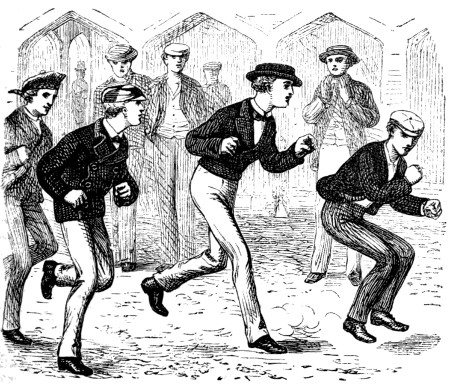
Make a mark on the ground at a place called the “starting point.” At ten yards’ distance from this make another, called the “spring.” Then let the players arrange themselves at the starting point, and in succession run to the second mark called the spring. From the spring make first a hop on one leg, from this make a long step, and from the step a long jump. Those who go over the greatest space of ground are of course the victors.
Various games are in vogue among boys, in which hopping on one foot is the principal object. Among these is one which not only assists in strengthening the limbs, but also teaches the performers the useful art of balancing themselves upon a movable substance. A wooden bottle, a round wooden log, or something of that description, is laid upon the ground, a mark is made at a certain distance, and the players have to hop from the mark upon the bottle, and retain their possession while they count a number agreed upon. In the olden times of Greece, this was considered an exercise of sufficient importance to give it a place at the public games. The performer in this case had to hop upon inflated leather bags, carefully greased, and of course, by their inevitable upsettings and floundering, caused great amusement to the spectators. The sports took place on the Dionysia, or festivals of Bacchus, when the vintage was gathered in, and the victor was appropriately rewarded with a cask of wine. The rustics in many parts of England introduce a modification of this game in their rural festivals. Two men place themselves opposite to each other, the right knee of each being supported on a wooden cylinder, while the remaining foot is totally unsupported. When they are fairly balanced, they grasp each other by the shoulders, and endeavour to cast their opponent to the ground, while themselves retain their position upon their fickle support.
This is a game played by hopping on one foot and kicking an oyster-shell or piece of tile from one compartment to the other, without halting the lifted foot, except in one case, to the ground, and without suffering the shell or tile to rest on any of the lines. A diagram is first drawn similar to the subjoined. It consists of twelve compartments, each being numbered, and at its further end the pleasant and inviting picture of a plum pudding with knife and fork therein stuck. In commencing the game, the players take their stand at the place marked by a star, and “quoit” for innings. The object is, that of doing what every boy is supposed to like above all things to do, i. e. “pitch into the pudding,” and he who can do this, and go nearest to the plum in the centre, plays first.
Method of Playing.—The winner begins by throwing his shell into No. 1; he then hops into the space, and kicks the tile out to the star *; he next throws the tile into No. 2, kicks it from No. 2 to No. 1, and thence out. He then throws it into No. 3, kicks it[3] from 3 to 2, from 2 to 1, and out. He next throws it into No. 4, kicks it from 4 to 3, from 3 to 2, from 2 to 1, and out; and so he proceeds till he has passed the cross and comes to No. 7, when he is permitted to rest himself, by standing with one foot in No. 6 and the other in No. 7; but he must resume hopping before he kicks the tile home. He then passes through the beds 8, 9, 10 and 11, as he did those of 1, 2, 3, 4, 5, &c., and so on, till he gets to plum pudding, when he may rest, and placing his tile on the plum, he is required, while standing on one foot, to kick it with such force as to send it through all the other beds to * at one kick. If one player throws his tile into the wrong compartment, or when he is kicking it out, he loses his innings, as he does also if the tile or his foot at any time rests on a line, or if he kicks his tile out of the diagram.
This is an old Greek game, and, like very many simple boys’ games, has retained its popularity to the present day. Its Greek name was rather a jaw-cracking one, but may be literally translated by “Pully-haully.” It consists of two parties of boys, who are chosen on different sides by lots. One party takes hold of one end of a strong rope, and the other party of the other end. A mark being made midway between the parties, each strives to pull the other over it, and those who are so pulled over, lose the game.
In this game, two leaders should be appointed, who must calculate the powers of their own side, and concert plans accordingly. The leader of either side should have a code of signals, in order to communicate with his own friends, that he may direct them when to stop, when to slacken, or when to pull hard. So important is the leader’s office, that a side with a good leader will always vanquish a much superior force which has no commander to guide it. For example, when all the boys are pulling furiously at the rope, the leader of one side sees that his opponents are leaning back too much, depending on their weight more than on their strength. He immediately gives the signal to slacken, when down go half the enemy on their backs, and are run away with merrily by the successful party, who drag them over the mark with the greatest ease. Or if the enemy begins to be wearied with hard pulling, an unanimous tug will often bring them upright, while they are off their guard, and once moved, the victory is easily gained. We have seen, assisted, and led this game hundreds of times, and never failed to find it productive of very great amusement. No knots are to be permitted on the rope, nor is the game to be considered as won, unless the entire side has been dragged over the line.
This is a game not very dissimilar to the preceding, but not so much to be recommended, as the clothes are very apt to be torn, and[4] if the players engage too roughly, the wrists are not unfrequently injured. The method of playing the game is as follows:—Several boys seat themselves in a row, clasping each other round the waist, thus fantastically representing a batch of loaves. Two other players then approach, representing the baker’s men, who have to detach the players from each other’s hold. To attain this object, they grasp the wrists of the second boy, and endeavour to pull him away from the boy in front of him. If they succeed, they pass to the third, and so on until they have drawn the entire batch. As sometimes an obstinate loaf sticks so tight to its companion, that it is not torn away without bringing with it a handful of jacket or other part of the clothing, the game ought not to be played by any but little boys.
This is a capital game for the summer months. The players divide themselves into two parties, one party remaining at a spot called “Bounds,” and concealing their faces, while the other party goes out and hides. After waiting for a few minutes, the home party shouts, “Coming, coming, coming.” After a short pause they repeat the cry, and after another short interval they again shout, “Coming.” If any out-player is not concealed, he may cry, “No,” and a few minutes more are allowed. At the last shout, the home players, leaving one to guard bounds, sally forth in search of their hidden companions. Directly one of the seekers sees one of the hiders, he shouts, “I Spy,” and runs home as fast as he can, pursued by the one he has found, who tries to touch him before he can reach bounds. If he succeeds, the one so touched is considered taken, and stands aside. If the hiding party can touch three, or more, if especially agreed upon, they get their hide over again. The object of the hiders is to intercept the seekers, and prevent them from reaching bounds without being touched. The worst player is left at the bounds, in order to warn his companions, which he does by the word “Home,” as any hider may touch any seeker.
This game is played by two boys, each of whom takes a smooth round pebble. One player then throws his pebble about twenty feet before him, and the next tries to strike it with his stone, each time of striking counting as one. If the two pebbles are near enough for the player to place one upon the other with his hand, he is at perfect liberty to do so. It is easy enough to play at this game when the pebbles are at some distance apart; but when they lie near each other, it is very difficult to take a good aim, and yet send one’s own pebble beyond the reach of the adversary’s aim. Two four-pound cannon balls are the best objects to pitch, as they roll evenly, and do not split, as pebbles always do when they get a hard knock.
This game may be played by any number of players. A large stone is selected, and placed on a particular spot, and the players first “Pink for Duck,” that is, they each throw their stones up to the mark, and the one who is farthest from it becomes “Duck.” The Duck places his stone on the other, while the rest of the players return to the bounds, and in succession pitch their stones at his with the endeavour to knock it off. If this is accomplished, Duck must immediately replace it, and the throwers must pick up their stones and run to the bounds. As soon as Duck has replaced his stone, he runs after any of the other players, and if he can succeed in catching or merely touching any one of them, the player so touched becomes Duck.
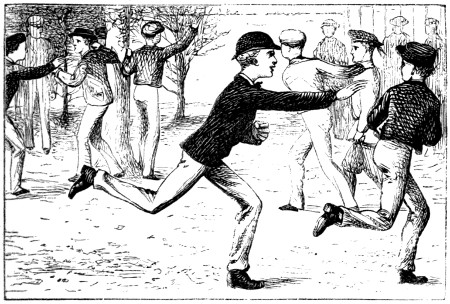
This is a most delightful game, and is a very great favourite among boys of all classes. It is commenced by choosing Captains, which is either done by lot or by the “sweet voices” of the youths. If by lot, a number of straws of different lengths are put in a bunch, and those who draw from one end, the other being hidden, the two longest straws, are the two “Captains;” each of which has the privilege of choosing his men: the drawer of the longest of the two straws has the first choice. When this has been arranged each Captain selects, alternately, a boy till the whole are drawn out.
This method is, however, often attended with considerable inconvenience, as it is not impossible that the lots may fall on the two worst players. It is very much better to let the boys choose the two[6] Captains, as the two best players will then assuredly be elected, and most of the success of the game depends on the Captains.
The leaders being thus chosen, the next point is to mark out the homes and prisons. First, two semicircles are drawn, large enough to hold the two parties, the distance between the semicircles being about twenty paces. These are the “homes,” or “bounds.” Twenty paces in front of these, two other semicircles, of a rather larger size, are marked out. These are the prisons; the prison of each party being in a line with the enemy’s home. These preliminaries being settled, the sides draw lots; the side drawing the longest straw having to commence the game. The Captain of side A orders out one of his own side, usually a poor player, who is bound to run at least beyond the prisons before he returns. Directly he has started, the Captain of side B sends out one of his men to pursue, and, if possible, to touch him before he can regain his own home. If this is accomplished, the successful runner is permitted to return home scathless, while the vanquished party must go to the prison belonging to his side; from which he cannot stir, until some one from his own side releases him, by touching him in spite of the enemy. This is not an easy task; as, in order to reach the prison, the player must cross the enemy’s home. It is allowable for the prisoner to stretch his hand as far towards his rescuer as possible, but he must keep some part of his body within the bounds; and if several prisoners are taken, it is sufficient for one to remain within the prison, while the rest, by joining hands, make a chain towards the boy who is trying to release them. When this is accomplished, both the prisoner and his rescuer return home, no one being able to touch them until they have reached their home and again started off. But the game is not only restricted to the two originally sent out. Directly Captain A sees his man pressed by his opponent, he sends out a third, who is in his turn pursued by another from side B; each being able to touch any who have preceded, but none who have left their home after him. The game soon becomes spirited; prisoners are made and released, the two Captains watching the game, and rarely exposing themselves, except in cases of emergency, but directing the whole proceedings. The game is considered won, when one party has succeeded in imprisoning the whole of the other side. Much depends upon the Captains, who sometimes, by a bold dash, rescue the most important of their prisoners, and thereby turn the fate of the battle; or, when the attention of the opposite side is occupied by some hardly-contested struggle, send some insignificant player to the rescue; who walks quietly up to the prison, and unsuspectedly lets out the prisoners one by one. No player is permitted to touch more than one person until he has returned to his home; when he can sally out again armed with fresh strength, like Antæus of old, who could not be conquered at wrestling, because whenever he touched the ground his strength was renewed by his mother Earth.
This game was extensively played at the school where our boyhood was passed; but we never saw it elsewhere. It used to afford us such amusement in the long summer evenings, that it deserves a place in this collection of sports. One player is termed Fox, and is furnished with a den, where none of the players may molest him. The other players arm themselves with twisted or knotted handkerchiefs, (one end to be tied in knots of almost incredible hardness,) and range themselves round the den waiting for the appearance of the Fox. He being also armed with a knotted handkerchief, hops out of his den. When he is fairly out, the other players attack him with their handkerchiefs, while he endeavours to strike one of them without putting down his other foot. If he does so he has to run back as fast as he can, without the power of striking the other players, who baste him the whole way. If, however, he succeeds in striking one without losing his balance, the one so struck becomes Fox; and, as he has both feet down, is accordingly basted to his den. The den is useful as a resting-place for the Fox, who is often sorely wearied by futile attempts to catch his foes.
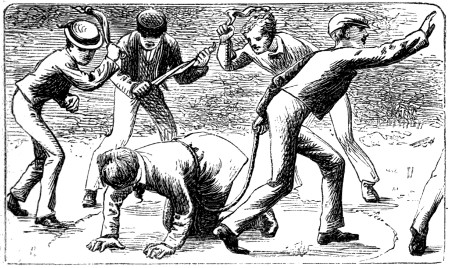
This is a funny game. The players generally draw lots for the first Bear, who selects his own Keeper. The Bear kneels on the ground, and his Keeper holds him with a rope about four feet long, within a circle of about five feet in diameter. The other players tie knots in their handkerchiefs, and begin to strike or baste the Bear, by running close to, or into the ring. Should the Keeper touch any of the boys while they are at this sport without dragging the Bear out of the[8] ring, or should the Bear catch hold of any player’s leg, so as to hold him fast, the player so touched or caught becomes Bear. The second Bear may select his Keeper as before, and the play continues.
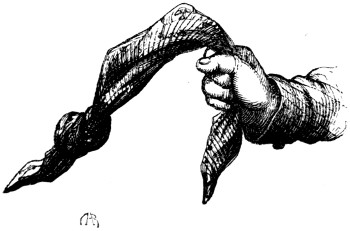
AN INSTRUMENT OF TORTURE.
This is an excellent game of agility, and very simple. It consists of any number of players; but from six to eight is the most convenient number. Having by agreement or lots determined who shall give the first “back,” one player so selected places himself in position, with his head inclined and his shoulders elevated, and his hands resting on his knees, at ten yards’ distance from the other players; one of whom immediately runs and leaps over him,—having made his leap, he sets a back at the same distance forward from the boy over whom he has just leaped. The third boy leaps over the first and second boy, and sets a “back” beyond the second; and the fourth boy leaps over the first, second, and third, and sets a “back” beyond the third, and so on till the players are out. The game may continue for any length of time, and generally lasts till the players are tired; but the proper rule should be, that all who do not go clean over should be out. Those who “make backs” should stand perfectly stiff and firm; and those who “make leaps” should not rest in their flight heavily upon the shoulders of their playmates, so as to throw them down, which is not fair play.
Chalk or make a line, or, as it is usually termed, “a garter,” on the ground; on this line one of the players must place himself and bend down as in leap-frog, while the other players in rotation leap over him, the last one as he flies over calling out “Foot it.” If he should fail in giving this notice, he is out, and must take the other boy’s place at the garter. The boy, immediately the word is given, rises, and places his right heel close to the middle of the left foot; he next moves the left forwards and places that heel close up to the[9] toes of his right foot, and bends down as before. This movement is called a “step,” and is repeated three times. The other players should fly from the garter each time a step is made, and the last player must invariably call out “Foot it” as he leaps over. After making the three “steps,” the player giving the back takes a short run, and, from the spot where he made his last step to, jumps as far forwards as he possibly can, and bends down again; the others jump from the garter and then fly over. Should any of the players be unable to jump easily over the one giving the back, but rather slide down upon, or ride on him, the player so failing must take the other’s place at the garter, and the game be begun again; if, also, through the impetus acquired in taking the jump from the garter, a player should happen to place his hands on the back of the player bending down, and then withdraw them in order to take the spring over, he is out, and must take his turn at the garter. It is usual, in some places, for the boy giving the back to take a hop, step, and a jump after he has footed it three times, the other players doing the same, and then flying over.
This game is capable of being varied to any extent by an ingenious boy, but it is generally played in the following way:—One boy, selected by chance, sets a back, as in “fly the garter,” and another is chosen leader. The game is commenced by the leader leaping over the one who gives the back, and the other players follow in succession; the leader then leaps back, and the others follow; then they all go over in a cross direction, and return, making, in all, four different ways. The leader then takes his cap in both hands, and leaves it on the boy’s back while he is “overing,” and his followers perform the same trick; in returning, the last man takes the lead, and removes his cap without disturbing the others, and each boy does the same: this trick is repeated in a cross direction. The next trick is throwing up the cap just before overing, and catching it before it falls; the next, reversing the cap on the head, and so balancing it while overing, without ever touching it with the hands; both tricks must be performed while leaping the four different ways. The leader, with his cap still balanced, now overs, and allows his cap to drop on the opposite side; the others do likewise, but they must be careful not to let their caps touch the others, nor to let their feet touch any of the caps in alighting; the leader now stoops down, picks up his cap with his teeth, and throws it over his head and the boy’s back; he then leaps after his cap, but avoids touching it with his feet. The other players follow him as before. The next trick is “knuckling,”—that is to say, overing with the hands clenched; the next, “slapping,” which is performed by placing one hand on the boy’s back, and hitting him with the other, while overing; the last, “spurring,” or touching him up with the heel. All these tricks must be performed in the four different[10] directions, and any boy failing to do them properly goes down, and the game begins afresh.
This is a brisk game, and may be played by any number of boys. One of the players being chosen as Touch, it is his business to run about in all directions after the other players, till he can touch one, who immediately becomes Touch in his turn. Sometimes when the game is played it is held as a law that Touch shall have no power over those boys who can touch iron and wood. The players then, when out of breath, rush to the nearest iron or wood they can find, to render themselves secure. Cross-touch is sometimes played, in which, whenever another player runs between Touch and the pursued, Touch must immediately leave the one he is after to follow him. But this rather confuses, and spoils the game.
These games are founded on the above. When the boys pursued by Touch can touch either wood or iron they are safe, the rule being that he must touch them as they run from one piece of wood or iron to another.
This is a very good game for three boys. The first is called the Buck, the second the Frog, and the third the Umpire. The boy who plays the Buck gives a back with his head down, and rests his hands on some wall or paling in front of him. The Frog now leaps on his back, and the Umpire stands by his side: the Frog now holds up one, two, three, five, or any number of fingers, and cries, “Buck! Buck! how many horns do I hold up?” The Buck then endeavours to guess the right number; if he succeeds, the Frog then becomes Buck, and in turn jumps on his back. The Umpire determines whether Buck has guessed the numbers rightly or not. In some places it is the custom to blindfold the Buck, in order to prevent him seeing. This plan, however, is scarcely necessary.
This is an excellent game for cold weather. It may be played by any number of boys. In playing it “loose bounds” are made near a wall or fence, about four feet wide and twelve long. One of the boys is selected, who is called the Cock, who takes his place within the bounds; the other players are called the Chickens, who distribute themselves in various parts of the playground. The Cock now clasps his hands together, and cries, “Warning once, warning twice, a bushel of wheat, and a bushel of rye, when the Cock crows out jump I.” He then, keeping his hands still clasped before him, runs after the other players; when he touches one, he and the player so touched[11] immediately make for the bounds; the other players immediately try to capture them before they get there; if they succeed, they are privileged to get upon their backs and ride them home. The Cock and his Chick now come out of the bounds hand-in-hand, and try to touch some other of the players; the moment they do this they break hands, and they and the player now touched run to the bounds as before, while the other players try to overtake them, so as to secure the ride. The three now come from the bounds in the same manner, capture or touch a boy, and return. If, while trying to touch the other boys, the players when sallying from the grounds break hands before they touch any one, they may immediately be ridden, if they can be caught before they reach the bounds. Sometimes when three players have been touched the Cock is allowed to join the out party, but this is of no advantage in playing the game.
This may be played by any number of boys: one being selected as the Leader, and the others are the Followers. The Followers arrange themselves in a line behind the Leader, who immediately begins to progress, and the others are bound to follow him. The fun of this sport is in the Leader carrying his Followers into “uncouth places,” over various “obstacles,” such as hedges, stiles, gate-posts, &c., through “extraordinary difficulties,” as ditches and quagmires,—every player being expected to perform his feats of agility; and those who fail are obliged to go last, and bear the emphatic name of the “Ass.” The game lasts till the Leader gives up, or the boys are all tired out.
This is a game something like the above. It consists of the Fugleman and his Squad. The Fugleman places himself in a central spot, and arranges his Squad before him in a line. He then commences with various odd gestures, which all the Squad are bound to imitate. He moves his head, arms, legs, hands, feet, in various directions, sometimes sneezes, coughs, weeps, laughs, and bellows, all of which the Squad are to imitate. Sometimes this is a most amusing scene, and provokes great laughter. Those who are observed to laugh, however, are immediately ordered to stand out of the line, and when half the number of players are so put out, the others are allowed to ride them three times round the playground, while the Fugleman with a knotted handkerchief accelerates their motions.

This is perhaps the very best game that can be introduced into a school. The principle of it is very simple, that one boy represents the Hare and runs away, while the others represent the Hounds and pursue him. The proper management of the game, however, requires[12] some skill. When we were at school in the north, this game was extensively played; and in more recent times, when we ourselves were masters instead of scholars, we reduced the game to a complete system. The first thing to be done is to choose a Hare, or if the chase is to be a long one, two Hares are required. The Hare should not be the best runner, but should be daring, and at the same time prudent, or he may trespass into forbidden lands, and thereby cause great mischief. A Huntsman and Whipper-in are then chosen. The Huntsman should be the best player, and the Whipper-in second best. Things having advanced so far, the whole party sally forth. The Hare is furnished with a large bag of white paper torn into small squares, which he scatters on the ground as he goes. An arrangement is made that the Hare shall not cross his path, nor return home until a certain time; in either of which cases he is considered caught. The Hounds also are bound to follow the track or “scent” implicitly, and not to make short cuts if they see the Hare. The Hare then starts, and has about seven minutes’ grace, at the expiration of which time the Huntsman blows a horn with which he is furnished, and sets off, the Hounds keeping nearly in Indian file, the Whipper-in bringing up the rear. The Huntsman is also furnished with a white flag, the Whipper-in with a red one, the staves being pointed and shod with metal. Off they go merrily enough, until at last the Huntsman loses the scent. He immediately shouts “Lost!” on which the Whipper-in sticks his flag in the ground where the scent was last seen, and the entire line walks or runs round it in a circle, within which they are tolerably sure to find the track. The Huntsman in the meanwhile has stuck his flag in the ground, and examines the country to see in what direction the Hare is likely to have gone.[13] When the track is found, the player who discovers it shouts Tally ho! the Huntsman takes up his flag, and ascertains whether it is really the track or not. If so, he blows his horn again, the Hounds form in line between the two flags, and off they go again. It is incredible how useful the two flags are. Many a Hare has been lost because the Hounds forgot where the last track was seen, and wasted time in searching for it again. Moreover, they seem to encourage the players wonderfully. We used often to make our chases fourteen or fifteen miles in length; but before such an undertaking is commenced, it is necessary to prepare by a series of shorter chases, which should however be given in an opposite direction to the course fixed upon for the grand chase, as otherwise the tracks are apt to get mixed, and the Hounds are thrown out. The Hare should always carefully survey his intended course a day or two previously, and then he will avoid getting himself into quagmires, or imprisoned in the bend of a river. A pocket compass is a most useful auxiliary, and prevents all chance of losing the way, a misfortune which is not at all unlikely to happen upon the Wiltshire downs or among the Derbyshire hills.
This is a trial of speed and agility, and may be played by any number of boys. It consists in the boys agreeing upon some distant object for a mark, such as a conspicuous tree, or house, or steeple. The players then start off in whatever direction they please, each one being at liberty to choose his own course. In a long run of a mile or so it very often happens that hedges, ditches, and other obstructions, have to be got over, which adds great interest to the play, and the best climbers and jumpers are the most likely to come in victors. He who comes in first to the appointed object is called the King, the second the Duke, the third the Marquis, the fourth the Viscount, the fifth the Earl, the sixth the Knight. The last receives the dignified appellation of the Snail, and the last but one the Tortoise.
At Oxford there were in our undergraduate days two clubs for the purpose of Steeple-chasing, one named the Kangaroo Club, and the other the Charitable Grinders, whose performances over hedges and ditches were really astonishing. There was also a club which kept a set of beagles, and used to hunt a red herring with intense perseverance.
This is a very simple sport, but necessarily restricted to those spots where there is a river, or a pond of some magnitude. It consists in throwing oyster-shells, flat stones, or broken tiles along the water, so as to make them hop as often as possible. One hop is called Dick, the second Duck, and the third Drake. The sea-shore is a capital place for this sport, as, if the player can only succeed in making the stone touch the top of a wave, it is tolerably certain[14] to make a succession of hops from wave to wave. If a rifle-bullet is shot along the water, it will go a great distance, making very long hops, and splashing up the water at every bound. In war, this method of firing at an enemy that lies low is extensively made use of, and is called “ricochet practice.” It is also much used in naval warfare.
This, if well managed, is a very comical game. The players are arranged as in Fugleman, the player who enacts Simon standing in front. He and all the other players clench their fists, keeping the thumb pointed upwards. No player is to obey his commands unless prefaced with the words, “Simon says.” Simon is himself subjected to the same rules. The game commences by Simon commanding,—“Simon says, turn down:” on which he turns his thumbs downwards, followed by the other players. He then says, “Simon says, turn up,” and brings his hands back again. When he has done so several times, and thinks that the players are off their guard, he merely gives the word, “Turn up,” or “Turn down,” without moving his hands. Some one, if not all, is sure to obey the command, and is subject to a forfeit. Simon is also subject to a forfeit, if he tells his companions to turn down while the thumbs are already down, or vice versâ. With a sharp player enacting Simon, the game is very spirited.
This is a very good game, and to play it properly there must be in the centre of the playground a small hill or hillock. One player, selected by choice or lot, ascends this hill, and is called the King; and the object of the other players is to pull or push him from his elevation, while he uses his endeavours to keep his “pride of place.” Fair pulls and fair pushes are only allowed at this game; the players must not take hold of any part of the clothes of the King, and must confine their grasps to the hand, the leg, or the arm. If a player violates these rules, he is to sit down upon the ground, and is called “Dummy.” The player who succeeds in dethroning the King, takes his place, and is subjected to the like attacks.
This game is to be played from a mound, the same as the above, and it may consist of any number of players. Each party selects a Captain, and having done this, divide themselves into Attackers and Defenders. The defending party provide themselves with a small flag, which is fixed on a staff on the top of the mound, and then arrange themselves on its side and at its base, so as to defend it from the attacks of their opponents, who advance towards the hillock, and endeavour to throw down those that oppose them. Those that are so thrown on either side, are called “dead men,” and must lie quiet till[15] the game is finished, which is concluded either when all the attacking party are dead, or the banner is carried off by one of them. The player who carries off the banner is called the Knight, and is chosen Captain for the next game.
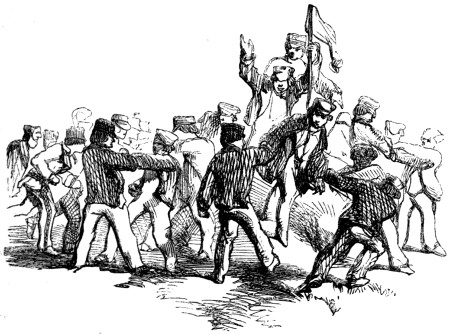
Every boy has played at snow-balls, from the time that his little fingers were first able to grasp and mould a handful of snow. Elderly gentlemen know to their cost how apt the youthful friend is to hurl very hard snow-balls, which appear to pick out the tenderest parts of his person, generally contriving to lodge just at the juncture of the chin and the comforter, or coming with a deafening squash in the very centre of his ear. Even the dread policeman does not always escape; and when he turns round, indignant at the temporary loss of his shiny hat, he cannot recognise his assailant in the boy who is calmly whistling the last new nigger-song, as he saunters along, with both his hands in his pockets. The prudent schoolmaster will also not venture too near the playground, unless he has provided himself with an umbrella. It is rather a remarkable fact, that whenever a Grammar-school and a National-school are within a reasonable distance of each other, they are always at deadly feud. So it was at the school where our youthful days were passed. One winter’s morning, just after school had opened, the door was flung violently open, and a party of National-school boys hurled a volley of snow-balls at the head-master. He, after the door had been secured, remarked in a particularly mild voice,—“Now, boys, if I had been at school, and[16] my schoolmaster had been assaulted by National-school boys, I should have gone out and given them a thrashing. Remember, I do not at all advise you to do so, but merely mention the course that I should have adopted under such circumstances. We will resume lessons at three.” So saying, he took off his gown, put on his hat and gloves, and walked out to see the fun. Now, the prospect of a morning’s holiday would have made us attack a force of twenty times our number, but as they only out-numbered us threefold, we commenced a pursuit without hesitation. After a sharp engagement, we drove them back to their own schoolroom. The cause of their yielding was, that they threw at random among us, whereas each of our balls was aimed at the face of an opponent, and we very seldom missed. When they had reached their school, they closed and barred their door; at which we made such a battering, that their master, a large negro, rushed out upon us, vowing vengeance, and flourishing a great cane. He was allowed to proceed a few yards from the door, when one snow-ball took off his hat, and two more lodged in his face. He immediately went to the right-about, and made for the school, which he reached under an avalanche of snow. We pursued, but he had succeeded in fastening the door, and we could not open it for some time. When we did, the school was deserted; not a boy was to be seen. There was no back entrance to account for their disappearance, and we were completely puzzled. At last, when we had quieted down a little, a murmuring was heard apparently below our feet, and on examination we found that the entire school had taken shelter in the coal-cellar. We made a dash at the door (a trap-door), and in spite of the showers of coal that came from below, fastened and padlocked the door, carefully throwing the key among a clump of fir-trees, where it was not likely to be found. Having achieved this victory, we had a snow-ball match among ourselves, and then returned to school. About five o’clock, in rushed the black schoolmaster, who had only just been liberated by the blacksmith, and who came to complain of our conduct. So far, however, from obtaining any satisfaction, he was forced to apologise for the conduct of his boys.
The object of this game is, that a castle of snow is built, which is attacked by one party and defended by the other. The method of building the castle is as follows:—A square place is cleared in the snow, the size of the projected castle. As many boys as possible then go to some distance from the cleared square, and commence making snow-balls, rolling them towards the castle. By the time that they have reached it, each ball is large enough to form a foundation-stone. By continuing this plan, the walls are built about five feet six inches high, a raised step running round the interior, on which, the defenders stand while hurling the balls against their opponents. In the centre are deposited innumerable snow-balls,[17] ready made; and a small boy is usually pressed into the service, to make snow-balls as fast as they are wanted. If the weather is very cold, some water splashed over the castle hardens and strengthens it considerably. The architect of the castle must not forget to leave space for a door.
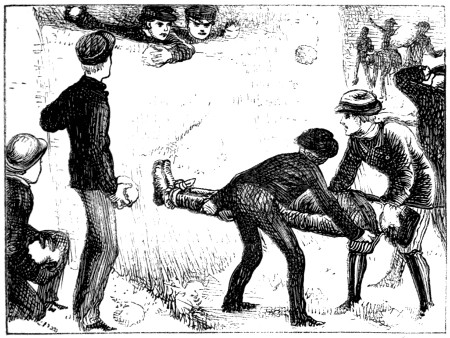
This is made in the same way as the snow castle, that is, by rolling large snow-balls to the place where the giant is to be erected, and then piled up and carved into form. He is not considered completed until two coals are inserted for eyes, and until he is further decorated with a pipe and an old hat. When he is quite finished, the juvenile sculptors retire to a distance, and with snow-balls endeavour to knock down their giant, with as much zest as they exhibited in building him. If a snow giant is well made, he will last until the leaves are out, the sun having but little power on so large a mass of hard snow. There is a legend extant respecting the preservation of snow through the warmer parts of the year. A certain Scotch laird had for a tenant a certain farmer. The laird had been requested by influential personages to transfer the farm to another man directly the lease was run out. The farmer’s wife, hearing of this from some gossip of hers, went to her landlord, and besought him to grant a renewal of the lease. When she called, he was at dinner with a numerous party of friends, and replied in a mocking tone, that the lease should be renewed when she brought him a snow-ball in July. She immediately called upon the guests to bear witness to the offer, and went home.[18] In due time the winter came, and with it the snow. One day, her husband, an excellent labourer, but not over bright, asked her why she was wasting so much meal. At that time, she had taken a large vessel of meal to a valley, and was pouring it into the space between two great stones. Upon the meal she placed a large quantity of snow, which she stamped down until it was hard. Upon this she poured more meal, and placed upon the meal a layer of straw. The whole affair was then thickly covered over with straw and reeds. To her husband, who thought she had fairly lost her senses, she deigned no reply, except that the meal would repay itself. So affairs went on until July, when the good dame, hearing that her landlord had invited a large party to dine with him, many of whom had been at the party when the promise was made, proceeded to the store of snow, which she found about half diminished. The remainder she kneaded hard, and put it in a wheelbarrow, well covered with straw, which she rolled up to the laird’s own house. When once there, she took out her snow-ball, and presenting it to her landlord, before all his guests, demanded the renewal of her lease. It may be satisfactory to know, that the laird, struck with her ingenuity and perseverance, at once granted her request.
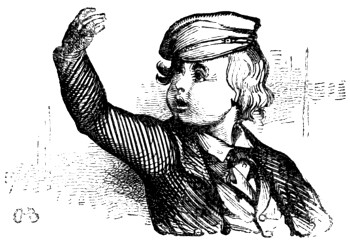
This game can only be played in the dusk of evening, when all the surrounding objects are lost in the deepening gloom. The players divide into two parties, and toss up for innings, which being gained, the winners start off to hide themselves, or get so far away that the others cannot see them; the losers remaining at the home. One of the hiding party is provided with a flint and steel, which, as soon as they are all ready, he strikes together; the sparks emitted guide the seekers as to what direction they must proceed in, and they must endeavour to capture the others ere they reach home; if they cannot[19] touch more than two of the boys, the hiders resume their innings, and the game continues as before. It is most usual, however, for the boys at the home to call out, “Jack, Jack! show a light!” before the possessor of the flint and steel does so. When one party is captured, the flint and steel must be given up to the captors, that they may carry on the game as before.
The jingling match is a common diversion at country wakes and fairs, and is often played by schoolboys. The match should be played on a soft grass-plot within a large circle, enclosed with ropes. The players rarely exceed nine or ten. All of these, except one of the most active, who is the “jingler,” have their eyes blindfolded with handkerchiefs. The jingler holds a small bell in his hand, which he is obliged to keep ringing incessantly so long as the play continues, which is commonly about twenty minutes. The business of the jingler is to elude the pursuit of his blindfolded companions, who follow him by the sound of the bell in all directions, and sometimes oblige him to exert his utmost abilities to effect his escape, which must be done within the boundaries of the rope, for the laws of the sport forbid him to pass beyond it. If he be caught in the time allotted for the continuance of the game, the person who caught him wins the match; if, on the contrary, they are not able to take him, he is proclaimed the winner.
In this game, six or eight players on each side is the best number. The two leaders should toss up for choice of partners, and after selecting them, toss again for innings. The loser must then place himself quite upright, with his face to a wall, against which he rests his hands; and one of his partners should next stoop down, and put his head against his leader’s skirts, as shown in the annexed illustration;[20] another partner also bends, and places his head against the skirts of the second player, and the rest of the partners must take their places in the same manner, one behind the other: when thus arranged, they are called “nags.” One of the winning party next takes a run, and placing his hands on the back of the last player or “nag,” endeavours to spring on to the back of the first, or at least to clear as many “nags” as he possibly can, in order to allow room for those following him to leap on the backs of the other “nags,” which they should do in succession, until they are all fairly astride. If any of the “nags” sink under the weight, or in trying to support themselves touch the ground either with their hands or knees, or if the riders can keep their seats without touching the ground, whilst their leader counts twenty, or repeats the words, “Jump little nag-tail one, two, three!” three times, concluding with “off, off, off!” the riders resume their innings, and begin again; on the contrary, should there not be sufficient space for all to leap on, or they are unable to keep their seats on the backs of the “nags,” they lose their innings, and become “nags” in their turn. The “nags” must, while in the line, hold either by the trousers of the player before them, or else lean their hands on their knees, or cross their arms on their breasts. Each rider must call out “Warning” before he leaps on the back of one of the “nags.”
Two players swing round a long rope, and when the revolutions become tolerably regular, one, two, or even more boys step forwards, and allowing it to swing over their heads, jump up as it descends, so as to let it pass under their feet as in the case of the common skipping-rope. The leapers must step forwards the moment the rope is at its highest, in order to be ready to skip over as it swings close to the ground; and they should be careful to keep the same time with the motions of the boys holding the rope, so as not to be struck by it in its circuit. Another game may be played with a long skipping-rope, by the player at one end holding the rope in his outside hand, making a step or two towards the other player, and with his help swinging it round, and then skipping over it.
In this amusing sport the players join hands, and extend their arms to their full extent. One of the outside players remains stationary, and the others run round him as fast as they can, which proceeding is called “winding the clock.” In this manner the straight line becomes a confused spiral, and all the players get huddled together in a most laughable manner. The winding of the clock usually leads to such disorder that it is next to impossible to unwind it without breaking the line of boys.
Two bases having been made, one at each end of the playground, all the players take up their position in one of them, except one, who is generally elected by counting out; this player, who is called “the King,” stations himself midway between the bases, and endeavours to catch the others as they rush through his territory from base to base. Should the king succeed in catching one of the trespassers, he raps him on the head, saying, “I crown thee king!” and the one so crowned joins the first king between the bases, and helps to catch the other players. When the out-players considerably outnumber those remaining in the bases, they may enter the bases, and, if they are strong enough, pull the others out and crown them. In this lively game the rule is, that a player must run to the opposite base if he puts both feet outside his own. In some parts of England this game is known by the name of “King Cæsar.”
For this amusement a stout plank should be laid across a felled tree or a low wall; it must be very nicely balanced if the players are of the same weight; but if one is heavier than the other, the end on which he intends to sit should be the shortest. Two players then take their seats on the plank, one at each end, whilst a third stations himself on the middle of it, as represented in the illustration; the name of this player is in some places Jack o’ both Sides, and in others Pudding. As the players by turns make slight springs from their toes, they are each alternately elevated and depressed, and it is the duty of Pudding to assist these movements by bearing all his weight on the foot, on the highest end of the plank, beyond the centre of the tree or wall on which it rests. This will be best understood by referring to the illustration: thus, A is the trunk of a tree;[22] across it a plank is laid, on which two players, B, C, take their seats; D is “Pudding;” it will be seen that his left foot is beyond the centre of the trunk A, on the highest end of the board, and consequently his weight being added to that of B will depress that end of the plank, and the end on which C sits must, of course, rise; Pudding then bears on his right foot, and C in turn descends; and thus the game continues during pleasure, Pudding bearing alternately on each side.
This game can be played by any number of boys, who must all join hands; the game is begun by the outside players at each end of the line holding the following dialogue: “How many miles to Babylon?” “Threescore and ten.” “Can I get there by candle-light?” “Yes, and back again.” “Then open the gates without more ado, and let the king and his men pass through.” The player and the one next to him at the end of the line opposite the last speaker then elevate their joined hands as high as they can, to allow the speaker to run under, and the whole line follows him, still holding hands. This should be done, if possible, without breaking the line by letting the hands go, and is styled “threading the needle.” When all the boys have passed through, the same conversation begins again, excepting that the respondent in his turn becomes the inquirer, and runs between the opposite players, the others following as before.
This is a very favourite game with little boys, and may be considered as a modification of rushing bases. A large base is formed by drawing a line across the playground, and one boy, called “Tom Tiddler,” takes his station within it, while the others run in crying out, “Here am I on Tom Tiddler’s ground, picking up gold and silver.” If Tom Tiddler can touch any boy while he is on his ground, the boy so touched takes his place as the guardian of the imaginary gold and silver.
Two to one is a very capital exercise with a common skipping-rope. It is done by skipping in the usual way for a short time, and then increasing the rapidity of your movements, and leaping tolerably high, endeavouring to swing the rope round so quickly that you can pass it twice under your feet while you are taking the leap; practise this till you are quite proficient, and then try to pass the rope three times under your foot instead of twice.
This may be played by any number of boys, who all tie large knots in one corner of their pocket-handkerchiefs, and then toss up to see[23] who shall be “Moon;” the loser is the one to whom the part falls, and he must be blindfolded. “Moon” now stands with his legs stretched apart, while his playmates go behind him in succession, and jerk their handkerchiefs between his legs, as far as they can and in whatsoever direction they please. When all the boys have done this, one of them cries “Walk, Moon, walk!” which is a signal for the blindfolded player to walk forwards until he treads upon one of the handkerchiefs, when in an instant the other players pick up their knotted handkerchiefs, with which they belabour the unlucky owner of the one trodden upon by Moon, as he runs to a distant base and back; after which he becomes Moon, and the game continues as before.
This is a capital game when well played, and the antics and grimaces of boys who are mimics cause great merriment. It also gives a boy a good notion of how mechanical labour is done, as no boy will ask for work unless he understands something of the nature of the business he solicits to be employed upon. The game begins thus, and it matters not how many boys are engaged in it:—A line is drawn; within that line is the shop, and when a bad workman is discharged he is pushed across the line. The employer, or master, should be a very sharp lad. A boy comes up, and the master asks him if he wants a day’s work; the boy says he does. He is then asked what trade he is; if he says a tailor, a coat is supposed to be given to him to make; if a shoemaker, a pair of shoes; if a tinker, a saucepan to bottom; if a stonemason, a stone to cut or saw, and every boy must imitate the actions of the tailor, shoemaker, &c., while at work, whatever the trades may be. Then the master looks over the work, finds fault, gets in a rage, discharges the workman, and, if he can, turns him out of the shop. But if in the struggle the boy turns the employer out, he then becomes master, and the other is set to work. So that, after a few good-natured trials of strength, each boy in turn generally becomes master.
This is a very old game, and in some places is called “playing at soldiers;” the whole ceremony of enlisting is gone through, taking the shilling and swearing to serve the Queen, &c. But there ought to be two parties of boys, of not less than a dozen, with a commanding officer on each side. After learning their exercise, such as shouldering arms and marching, war breaks out; then one party is English and the other the enemy. Their weapons ought to be bulrushes, or stout reeds, such as are used in building, or something that will not do any injury when the charge commences. The side that breaks or takes away the most weapons is the conqueror, and much skill may be displayed in capturing the arms of others, and[24] retaining your own. If boys can get some old soldier to drill them a few times, this may be made as good a game as they can play at. We have too few military amusements in our English games.
One player takes his station at a spot called the “home,” while the others go to seek out various hiding-places in which to ensconce themselves; when all are ready, one of them calls out “Whoop!” on which the player at the “home” instantly goes in search of the hiders, and endeavours to touch one of them as they run back to “home;” if he can do so, the one caught takes his place at the “home,” while he joins the out players.
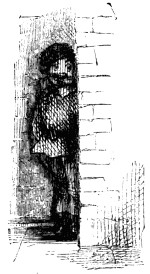
In this game sides are chosen, and one party remains “at home,” while the other hides. When the hiders are all ready, one of them calls out “High Barbaree!” upon which the seekers sally forth to look for them, as in “Whoop!” If the seekers can succeed in touching a certain number of the hiders before they can get to “home,” they take their turn at hiding. The number to be caught must be agreed upon beforehand, and of course depends upon the number of players. It is usual to mention this number in the cry—thus, “High barbaree! three caught he!”—“four caught he!” and so forth. As a general rule, the number to be caught should exceed half the number of the hiders.
This active, merry, noisy game can be played by any number of boys, and commences by their joining hands and forming a ring,[25] having enclosed some boy in the middle, who is the Bull. It is the Bull’s part to make a rush, break through the ring, and escape, and the part of the boys who form the ring to hold their hands so fast together that he cannot break their hold. Before making a rush the Bull must cry “boo” to give warning, so that the boys may grasp their hands more tightly. The whole ring generally replies to the Bull’s challenge by crying “boo” all together, and a pretty noise they make. When the Bull breaks through the ring he is pursued until captured, and the boy who seizes him first is “Bull” when they return. A good “Bull” will lead them a pretty dance, clearing hedges and ditches; and if he gets back and touches some mark agreed upon, near to where he broke through the ring, he is “Bull” again.
This humorous sport must not be confounded with the cruel battles between game-cocks once so popular in England. Two boys represent the feathered combatants; each hops upon one leg, with his arms folded, and bumps against the other, endeavouring to compel him to put both feet to the ground. The boy who keeps up longest wins the game.
A tolerably large ring should be formed by several boys standing in a circle and joining hands; another boy, who stands out, when all are ready walks round outside the ring, drops a handkerchief behind one of the players, and immediately runs off; he is instantly followed by the one behind whom he dropped the handkerchief, and who must track him in all his windings in and out under the arms of the boys in the ring, who elevate them for the purpose, and indeed wherever he runs to; should the pursuer be able to touch the pursued, the former takes the handkerchief in his turn, and the latter joins hands in the circle. If the boy who dropped the handkerchief is enabled to elude his follower by passing through and about the ring, he walks again round and drops the handkerchief behind some other player.
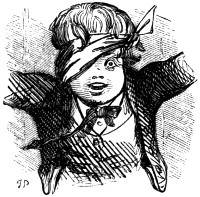
“SEEING’S BELIEVING.”
Consists in one person having a handkerchief bound over his eyes, so as to completely blind him, and thus blindfolded trying to chase the other players, either by the sound of their footsteps, or their subdued merriment, as they scramble away in all directions, endeavouring to avoid being caught by him; when he can manage to catch one, the player caught must in turn be blinded, and the game be begun again. In some places it is customary for one of the players to inquire of Buff (before the game begins), “How many horses has your father got?” to which inquiry he responds, “Three.” “What colours are they?” “Black, white, and grey.” The questioner then desires Buff to “turn round three times, and catch whom you may,” which request he complies with, and then tries to capture one of the players. It is often played by merely turning the blindfold hero round and round without questioning him, and then beginning. The handkerchief must be tied on fairly, so as to allow no little holes for Buffy to see through. Blind Man’s Buff is a very ancient pastime, having been known to the Grecian youths. In England it formerly went By the name of Hoodman Blind, because it was customary to blind Buff with his hood.
Attach a cherry to a piece of string, and then fasten it to a door, sufficiently high to compel the player to jump a little in order to[27] catch the cherry in his mouth. The cherry is then set swinging; and the players, ranging themselves in line, jump at the cherry, one after the other. This game is productive of much amusement, and may be kept up for a long time.
In this game one of the players enters the room, armed with a poker, with which he taps on the floor. “Where do you come from?” inquires one of the company. “Alas! from poor Buff, who is full of grief.” “And what did he say to you?” “He spoke thus,” is the reply—
Having thus spoken, the messenger leaves the room. While he has been delivering his speech, the company, however, endeavour to make him laugh, by asking him any absurd questions that may present themselves to their imagination. If they do not succeed in this, the emissary of the great Buff delivers himself of a more lengthy address:—
A noisier game than this could scarcely be desired by the most boisterous of our young friends. The players having selected a “conductor,” seat themselves round him in a circle. The conductor now assigns to each a musical instrument, and shows how it is to be played. When all are provided with their imaginary instruments, the conductor orders them to tune, and by so doing, he gives each musician a capital opportunity for making all sorts of discordant noises. When the different instruments have been tuned, the conductor waves an unseen bâton, and commences humming a lively air, in which he is accompanied by the whole of his band, each player endeavouring to imitate with his hands the different movements made in performing on a real instrument. Every now and then the conductor pretends to play on a certain instrument, and the player to whom it belongs must instantly alter his movements for those of the conductor, and continue to wield the bâton until the chief player abandons his instrument. Should a player omit to take the conductor’s office at the proper time, he must pay a forfeit. The fun of this game greatly depends upon the humour of the conductor, and the adroitness with which he relinquishes his bâton and takes up the instruments of the other players.
The first player writes an adjective on the upper part of a slip of paper, and then folds the slip so that the written word cannot be seen by the next player, who writes the name of a gentleman, real or imaginary, on the paper, which he passes to another after having folded it over again. The third player writes an adjective; the fourth, a lady’s name; the fifth, the name of a place; the sixth, what the gentleman said to the lady; the seventh, the lady’s reply; the eighth, the consequences; and the ninth, what the world said about the whole affair. One of the players now unfolds the slip and reads what has been written by the different persons engaged in the game, adding a few words to unite the disjointed members of the little narrative. As a specimen of the ludicrous result which arises from each player’s ignorance of what has been written by his companions, we give the following pathetic tale, in which the words and phrases printed in italics represent those written on the slip of paper:—“The ill-favoured Peter Wilkins met the adorable Jenny Jones in the silver mine of Potosi. He said to her, ‘Will you love me then as now?’ and she replied, ‘When did I refuse you anything?’ The consequences were, he drowned himself in the water-butt and she married the baker, and the world said, ‘Served them right!’” When there are only three or four players, the slip of paper is to be passed round from one to another until it is filled up. When the players are numerous, three or four slips may be commenced simultaneously by different persons.
This game will be best described by a short dialogue.
Harry.—I am going to put a question in a whisper to Tom, who is seated on my right hand, to which he will reply in the same tone. He will then put a question to his next neighbour, and receive his answer. When the tour of the circle is made, I shall commence by stating aloud the question put to me by my left-hand neighbour, answering it by the reply received in answer to my own from Tom. He will then do the same, giving my question and his next neighbour’s reply.—(Whispers to Tom.) Of what use are the bellows?
Tom.—To blow up the fire.—(To Charles) Of what use is a fire-engine?
Charles.—To put out a fire.—(To John) Of what use is a plough?
John.—To plough up the ground.—(To James) Of what use is a cap?
James.—To cover the head.—(To Edward) Of what use is a shoe?
Edward.—To protect your foot.—(To William) Of what use is a black pin?
William.—To fasten your collar with.—(To Harry) Of what use is a barometer?
Harry.—To tell the weather.—(Aloud) William has just asked me the use of a barometer? Tom replies, “To blow up the fire!”
Tom.—Harry has asked me the use of the bellows; and Charles replies, “To put out the fire!”
Charles.—Tom wishes to know the use of the fire-engine, and John tells him, “To plough up the ground,” &c.
Any mistake is punished by a forfeit.
The players form sides, and decide who shall be masters and who men. The principal aim of the men is to keep working as long as possible, and to prevent the masters taking their places. The men consult secretly among themselves, and decide upon some trade or profession, the practice of which may be certain movements of the arms, hands, or legs. They now range themselves opposite the masters, and the foreman tells them the first and last letters of the trade they are about to exercise; as for example, C—r for carpenter, D—t for druggist, B—h for blacksmith, and so on. The men now set to work and express in dumb motions the various labours belonging to the craft they have chosen. Let us suppose that they have selected the trade of blacksmith: one of the players will appear to be blowing the forge bellows, another will seem to be filing something in a vice, while others will be violently exerting themselves by wielding imaginary sledge-hammers round an unseen anvil. If any of the men speak at their work, or make use of inappropriate gestures, the whole side is out. The masters are allowed one guess each, and if none of them can hit upon the right trade, the men tell them their occupation, and then fix upon another. If the masters can guess the name of the trade, the men are out and become masters. The men need not continue their labours until all the masters have guessed, but may stop working, and demand their wages, after having plied their craft for a reasonable time. When the name of a trade consists of two words, the men must tell the first and last letter of each word, as C—h B—r, for coach builder.
The chief player in this amusing game must possess the faculty of inventing a long story, as well as a tolerably good memory. This player gives to each of the others the name of some person or thing to be mentioned in the story he is about to relate. For example, he may call one “the coachman,” another “the whip,” another “the inn,” another the “old gentleman,” another the “footman,” another “the luggage,” and so on, until he has named all the persons engaged in the game. The story-teller now takes his stand in the centre of the room, and commences his narrative; in the course of which he takes care to mention all the names given to the players.[30] When the name of a player is mentioned, he must immediately rise from his seat, turn round, and sit down again, or else pay a forfeit for his inattention; and whenever “the family coach” is named, all the players must rise simultaneously. In the following example of a story, the names given to the different players are printed in italics: “An old gentleman, dreading an attack of the gout, resolved to pay a visit to the hot wells of Bath; he therefore summoned his coachman, and ordered him to prepare THE FAMILY COACH (all the players rise, turn round, and sit down again). The coachman, not liking the prospect of so long a journey, tried to persuade the old gentleman that THE FAMILY COACH was out of repair, that the leader was almost blind, and that he (the coachman) could not drive without a new whip. The old gentleman stormed and swore upon hearing these paltry excuses, and ordered the coachman out of the room, while the little dog sprang from under his master’s chair and flew at the calves of the offender, who was forced to make a precipitate exit. Early the next morning, THE FAMILY COACH belonging to the old gentleman stopped at an inn on the Bath road, much to the surprise of the landlord, who had never seen such a lumbering conveyance before. The family coach contained the old gentleman, the old lady (his wife), and the little dog that had made such a furious attack on the poor coachman’s legs. The landlord called the landlady, who came bustling out of the inn to welcome the old gentleman and old lady. The footman jumped down from behind THE FAMILY COACH, and helped the old gentleman and the old lady to alight, while the boots and chambermaid belonging to the inn busied themselves with the luggage. The little dog trotted after the old lady, but just as it was going into the inn, the coachman gave it a cut with his whip. The little dog howled, upon which the old gentleman turned round, and seeing the coachman with his whip raised, he seized him by the throat. The footman came to the assistance of his friend the coachman, and the ostler belonging to the inn took the side of the old gentleman. The landlord, landlady, chambermaid, boots, cook, stable-boy, barmaid, and all the other inmates of the inn, rushed into the road to see what was the matter, and their cries, joined to the yells of the little dog and the screams of the old lady, so frightened the leader, the white horse, and the brown mare, that they ran away with THE FAMILY COACH.” Of course this tale might have been continued to any length, but the specimen we have given will be sufficient to give the story-teller some idea of what is expected from him to keep up the fun of the game.
This is a highly amusing, though very simple game. One player seated on the ground is surrounded by his comrades, who pull and buffet him till he can catch one of them, when the person so caught takes his place, and is buffeted in like manner. As the players sport[31] round the Frog, they usually cry, “Frog in the middle—can’t catch me!” but they frequently find that this is vain boasting, as Froggy does catch them now and then.
The party being seated in a circle, the player who has been chosen to commence the game takes a knotted handkerchief, and throws it suddenly into another’s lap, calling out at the same time either “Earth!” “Water!” “Air!” or “Fire!” If “Earth” be called out, the player into whose lap the handkerchief has fallen must name some quadruped before the other can count ten; if “Water!” he must name a fish; if “Air!” a bird; and if “Fire!” he must remain silent. Should the player name a wrong animal, or speak when he ought to be silent, he must pay a forfeit and take a turn at throwing the handkerchief; but should he perform his task properly, he must throw the handkerchief back to the first player. Those who have never joined in this simple game can have no idea of the absurd errors into which the different players fall when summoned unawares to name a particular kind of animal.
The game of Hand is of great antiquity, and is common to almost every nation, whether savage or civilized. In many of the rural districts of England this universal pastime is known by the name of “Coddem.” To play at Hand, sides must be formed, and the players of each side must seat themselves at a table opposite their antagonists. Chance decides which of the sides shall first hide the piece; which may be any small object that can be easily held in the closed hand of one of the players. One of the fortunate players now exhibits the piece to his opponents; having done which, he cries out, “Hands down!” at which signal he and his comrades put their hands out of sight, and in the language of the game, commence “working the piece,” which operation is performed by shifting the piece from hand to hand, so as to deceive the opposite players as to its whereabouts. When the piece has been properly worked, the chief player calls out, “Hands up,” and he and all his comrades simultaneously place their closed fists on the table. The top player on the opposite side has now to fix upon the hand in which the piece is concealed. There are two ways of guessing, either of which he may adopt; the first is to point at once to the hand supposed to contain the piece, and cry out, “Hand!” The second mode of guessing is to point to those hands which appear to be empty, saying with each guess, “Take that hand away!” and when most of the hands have been removed from the table, to fix upon the most likely-looking one among those that remain. If the guesser can find the piece without making a mistake, he claims it for his party, and is entitled to guess again when the opposite side regains it; but if he makes a[32] mistake, either by ordering the hand that holds the piece to be removed, or by “handing” an empty fist, his antagonists retain the piece, and having concealed it, the second player attempts to discover its whereabouts. From our description, the reader will probably regard Hand as a mere frivolous game of chance; but we can assure him that chance has little to do with the discovery of the piece. A good Hand player watches the faces of his opponents while their hands are engaged in working the piece under the table; he scrutinises the different hands, and does not allow himself to be misled by any of the cunning devices which the hiders employ to throw him off the right scent; again, when he has the piece in his possession, he takes care not to let a tightly-clenched fist, a guilty smile, or an anxious expression, betray the fact to his wary antagonist.
In this game, one of the players is sent out of the room, while the others hide a handkerchief or any small article that can be easily secreted. When the article has been concealed, the door is opened, and the seeker is invited to enter in these words: “Hot boiled beans and butter; walk in and find your supper.” The seeker now sets to work to look for the hidden article. When he approaches the place of concealment, his playmates must give him notice of it, by telling him that he is “rather warm,” “very hot,” or, if he gets very near it, that he “burns.” When he wanders away from the object of his search, he is told that he is “cold;” and if he persists in his mistaken course, he is informed that he “freezes.” Should the seeker succeed in finding the hidden article, another player goes out of the room in his stead.
One player with his eyes bandaged lays his head on a chair, or in another player’s lap, while the others strike him on his back with their open hands. In this unenviable position he remains until he can guess who strikes him, when the striker takes his place. The poet Gay describes this pastime in the following lines:—
One of the players is sent out of the room, while the others fix upon a subject, which may be anything to which the three questions, “How do you like it?” “Where do you like it?” and “When do you like it?” will apply. When the subject has been decided upon, the out-player is summoned. He now puts the first question to the nearest player, who returns him a puzzling answer; he then passes to the next, and repeats the same question; then to the next, and[33] so on, until he has made the round of the room. If none of the answers enable him to guess the subject, he tries each player with the second question, and if the answers to this leave him still in the dark, he solicits a reply from each to the third and last question. Should the player fail to guess the subject after asking the three questions, he pays a forfeit and takes another turn outside; but should he succeed in guessing it during his rounds, the player last questioned must pay a forfeit, and go out of the room in his place. The in-players should always endeavour to hit upon some word that has two or three meanings for a subject, as such a word renders the answers extremely confusing. For instance, if Jack be the subject decided on, one of the players may say, in answer to the first query, that he likes it “fried,” referring to fish called the Jack; in answer to the second, that he likes it “before the kitchen fire,” referring now to a roasting-jack; and in answer to the third, that he likes it when he is “dressing,” now regarding the subject as a boot-jack.
This old-fashioned pastime is so generally known that it is scarcely necessary to describe it; however, as it forms one of the merriest indoor sports for the long winter evenings, it would be absurd to omit it in this work. Several boys seat themselves in a circle on the ground, and another, taking his place inside the ring, gives a slipper to one of them, by whom it is immediately and secretly handed to one of his neighbours; it is now passed round from one sitter to another, with as much dexterity as possible, so as to completely perplex the “hunter” (or player standing in the middle) in his endeavours to “chase the slipper by its sound,” and who must continue his search until successful. The player in whose possession it is found must in his turn “hunt the slipper,” whilst the former hunter joins the sitters.
A game almost similar to the former. A piece of tape, on which a ring is fastened, is held by the players as they stand in a circle, with one in the middle. The ring is passed from hand to hand, and the hunter’s business is to find out in whose hand the ring is.
A boy who has never seen the game played is elected hunter; the others seat themselves on the ground, as in Hunt the Slipper. The hunter, having been shown the whistle, kneels in the centre of the circle, and lays his head in the lap of one of the players until the whistle is concealed. While he is in this posture, the whistle is to be secretly attached to the back part of his jacket or coat, by means of a piece of string and a bent pin. One of the players now blows the whistle and drops it, and the hunter, being released, is told to[34] find it; but this is no easy task, as he carries the object of his search about his own person. As the hunter kneels in the centre of the group, the different players blow through the whistle and drop it, as the opportunities occur. The puzzled hunter is sometimes fairly tired out before he discovers the trick that is played upon him. We need scarcely say that the whistle should be very small and light.
This is a very similar game to Hot Boiled Beans. One player having been sent out of the room, the others arrange some simple task for him to perform on his return. When this has been done, he is summoned by the magic music, which is played by one of his comrades, either by tapping a tea-tray with a key, or by rattling the poker and tongs together. The boy who has been sent out of the room must perform his appointed task under the guidance of the musician, who so regulates his performance on the rude instruments that the music gets loud and noisy when the puzzled player does what he ought not to do, and grows soft and quiet when he does anything towards the performance of his task. To render this game more intelligible, we will suppose the task to be the removal of a certain chair from one room to another. The player having entered the room is saluted by the magic music, the unmeaning clatter of which only confuses him at first. He walks towards the side of the room where the chair is stationed, and as he approaches it the clatter grows fainter; this informs him that he is in the right path. He touches the table, but removes his hand at the sound of the music, which suddenly gets terribly noisy. He touches the chair; the music ceases. He now knows that he is expected to do something with this particular chair, so he very naturally sits down upon it; but he jumps up directly he hears the “clatter, clatter, clatter” of the music. He lifts the chair, and as he does so the music grows soft again. He now turns the chair upside down; carries it into the middle of the room; places it on the sofa; but all to no purpose, as he cannot stop the continual clatter of the magic music. At last he carries the chair into the adjoining room; the music ceases, and his troublesome task is accomplished. In this noisy but amusing game the players go out of the room, and have tasks set them in turns. The musician generally retains his office throughout the game.
This exciting game may be played by an unlimited number, and is particularly adapted for a large party. One of the players, called “the postman,” has his eyes bandaged as in Blind Man’s Buff; another volunteers to fill the office of “postmaster-general,” and all the rest seat themselves round the room. At the commencement of the game the postmaster assigns to each player the name of a town, and, if the players are numerous, he writes the names given to them on a[35] slip of paper, in case his memory should fail him. These preliminaries having been arranged, the blind postman is placed in the centre of the room, and the postmaster-general retires to some snug corner, whence he can overlook the other players. When this important functionary calls out the names of two towns,—thus, “London to Halifax,”—the players who bear these names must immediately change seats, and as they run from one side of the room to another, the postman tries to capture them. If the postman can succeed in catching one of the players, or if he can manage to sit down on an empty chair, the player that is caught, or excluded from his place, becomes postman. The postmaster-general is not changed throughout the game unless he gets tired of his office. When a player remains seated after his name has been called he must pay a forfeit, or if the game is played without forfeits he must go to the bottom of the class, which is represented by a particular chair, and to make room for him all the players who were formerly below him shift their places.
One player leaves the room, and while he is absent the rest fix upon some proverb. The words are then distributed among them, and each player, in reply to a question asked by the guesser, has to introduce his particular word. When all the words have been introduced, the guesser has to guess the name of the proverb, and another player takes his place. If, however, he cannot make it out, he has to leave the room again.
LIST OF PROVERBS.
Four players take their stations in the four corners of a room, and a fifth, called “Puss,” places himself in the middle of it; the players in the corners then change places by running to the opposite ends, and Puss must endeavour to get into one of the vacant places before the opposite player is able to reach it; if he can do so, the player left out becomes Puss.
The players sit round in a circle, each taking a colour. Thus one is red-cap, another black-cap, and so on. One of them, who takes the place of master, and has no colour, taking up a cap says: “Hullo, here’s a false stitch. Who made it, blue-cap?” Blue-cap then answers, “Who, sir? I, sir?” “Yes, you, sir!” “Not I, sir.[37]” “Who then, sir?” “Yellow-cap, sir.” Yellow-cap then starts up and says, “Who, sir? I, sir?” and goes through the dialogues, giving another colour. The player who neglects to start up when his colour is mentioned, or who does not repeat the question correctly, pays a forfeit.
Shadow Buff differs very materially from Blind Man’s Buff, but it is equally amusing. A large piece of white linen should be fastened neatly up at one end of room, so that it hangs quite smooth; Buff (not blinded) seats himself on a low stool with his face to the linen, and a table, on which is a lighted candle, should be placed about four or five feet behind him, and the rest of the lights in the room extinguished. Buffy’s playfellows next pass in succession, between the candle and him, distorting their features in as grotesque a manner as possible—hopping, limping, and performing various odd antics, so as to make their shadows very unlike their usual looks. Buffy must then try to guess to whom the shadows belong, and if he guesses correctly, the player whose shadow he recognises takes his place. Buff is allowed only one guess for each person, and must not turn his head either to the right or left to see who passes.
Birds, Beasts, and Fishes.—“Now, Tom,” said Harry, “get your slate and pencil, and I’ll show you such a jolly game. Well now, look here, I have put down h × × × a. Now that stands for a beast’s name, the first and last letters of which are h and a, with three letters between, represented by the crosses.”
“Let’s see,” replied Tom, scratching his head, “I know—Hare.”
“You muff! There are only four letters in ‘hare,’ and five in my word. Try again—mind you have only three guesses; so look out.”
Tom wondered again for a minute, and then suddenly blurted out, “I know—Horse.”
“Wrong again,” replied Harry; “the last letter of Horse is e and not a. Now be careful, Tom, for this is your last turn.”
Again Tom scratched his head, bit his fingers, and after meditating for at least two minutes and a half, shouted out in a moment of inspiration—“Hyena!”
As he was right, it now became his turn to put down a name. So he wrote on the slate s × × × × × w, at the same time telling Harry it was a bird; for according to the rules of this game you must say whether this name represents a beast, a fish, a bird, an insect, or a reptile.
Harry in a minute shouted “Sparrow!” and so the game went on; and such a capital game did Tom and Harry have, that they sent this account of it to us in the hope that we would make it known to the world in “Every Boy’s Book.”
French and English.—On the slate should be drawn a plan somewhat like the following. The dots represent soldiers, one side being termed French and the other English. Each player is provided with a sharply pointed pencil, and the game is played as follows:—English, keeping the point of his pencil on a spot denoted by a cannon, draws it quickly across the slate in the direction of the other army. The pencil naturally leaves a line to mark his track, and if this mark passes through any of the men belonging to the other side, they are considered dead. The game is over as soon as all the men on one side are dead. Each player has a certain space on the slate allotted to him, and he may dispose his men in whatever part of it he pleases.[39] The track of the pencil must be straight or curved; any shot in which there is an angle does not count. In p. 38 we give a battle-field where the strife is ended. In this the English side has killed all the opposite side in eight shots, while the French in eight have only been able to kill nine men.
Noughts and Crosses.—This is a capital game, and one which every school-boy truly enjoys. A figure is drawn as follows, and the object of the one player is to draw three crosses in a line before the other can draw three noughts. Thus A begins by drawing a + in the centre division; B follows with a nought in the top right-hand corner. A then draws a + in the bottom right-hand corner, because by this means he gets two crosses in a line, and spoils one of B’s chances. B in a hurry instantly places a 0 in the top left-hand corner, and A follows by placing his + between the two 0’s. B then, seeing that in the centre line A already has two crosses, places a 0 in the third vacant space of the line; while A, as a last resource, plants his + in the second space of the left-hand line. Then when B puts a 0 in the centre space at the left-hand, A places a + in the bottom left-hand corner, and the game is drawn, the plan standing as above.
Every player, except one who holds the office of reader, selects a trade or profession, which he must retain throughout the game. When all have chosen their trades, the reader opens a book at random, and reads a passage from it aloud; but when he comes to any common noun, he looks at one of the tradesmen, who must instantly name some article that he is supposed to have for sale, or some implement connected with the exercise of his craft. By this substitution of one noun for another, the most pathetic passage is converted into an indescribable jumble of absurdities. In the following burlesqued extract from an Eastern tale, the words in italics are supposed to be supplied by the different tradesmen, in place of the nouns omitted by the reader:—
“One offered the prince a bucket of the most precious mutton chops of Golconda; another a curious piece of a Wellington boot, made by a European artist; another a piece of the richest plum-pudding from the looms of China; another a gridiron, said to be a sovereign remedy against all poisons and infectious diseases; another a choice piece of the most fragrant Turkey rhubarb, in a warming-pan, inlaid with acid drops; another a coffin full of genuine treacle; another a rocking-horse of the purest breed of Arabia; and another a Flanders brick of exquisite beauty. The whole court of the palace was overspread with gingerbread-nuts; and long rows of slaves were continually passing loaded with corn-plasters, tenpenny-nails, bees’-wax, and other articles of high price.”
Two boys having seated themselves on the floor, are trussed by their playmates; that is to say, each boy has his wrists tied together with a handkerchief, and his legs secured just above the ancles with another; his arms are then passed over his knees, and a broomstick is pushed over one arm, under both knees, and out again over the other arm. The “trussed fowls” are now carried into the centre of room and placed opposite each other, with their toes just touching. The fun now begins; as each fowl endeavours, with the aid of his toes, to turn his antagonist over on his back or side, and the one who can succeed in doing this wins the game. It frequently happens that both players turn over together, to the great amusement of the spectators. On board ship these comical encounters frequently take place between the boys, who are trussed by their elder shipmates.
This game, although only two persons are engaged in it at a time, furnishes much amusement, from the contradictory nature of its words and actions. The rules relative to it are as follow:—If three mistakes are made by the person who responds to the inquiries of the[41] player who brings the hats round, and whom for distinction’s sake we will call the questioner, he must pay three forfeits, and is out of the game; when the questioner desires the respondent to be seated, the latter must stand up; when he begs him to put his hat on, he must take it off; when he requests him to stand, he must sit; and in every point, the respondent must take special care to do always the very reverse of what the questioner wishes him. The questioner may sit down, stand up, put his hat on, or take it off, without desiring the respondent to do so, or giving him the least intimation of his intention; the latter must, therefore, be always on his guard, so as to act in a contrary way in an instant, else he incurs a forfeit. These rules being settled, the game is simply this: one player places a hat on his head, takes another in his hand, and gives it to one of the company; he then begins conversing with him, endeavouring both by words and actions to puzzle him as much as he can, so as to cause him to pay a forfeit. We will give a slight specimen of a dialogue, describing the accompanying movements of the hats, in which A is the questioner, B the respondent:
A. (taking his hat off.) A very beautiful evening, sir.
B. (putting his hat on.) Yes, indeed, a most lovely one.
A. (putting his hat on, and sitting down, B. instantly taking his off and getting up.) Pray be seated, sir; I really cannot think of sitting while you stand (gets up, and B. sits down). Have you been out of town this year? (takes off his hat.)
B. (putting his on.) I have not yet, but I think I shall, before (A. sits down, B. gets up) the beauty of the season has entirely passed away, venture a few miles out of town.
A. (putting his hat on.) I beg ten thousand pardons, you are standing while I am sitting; pardon me, your hat is on—you must pay a forfeit.
It generally happens, that before the dialogue has been carried thus far the respondent has incurred three forfeits, and is, of course, out; the questioner then goes in succession to the others, and the same scene is repeated by each: the conversation, it is almost needless to add, should be varied as much as possible, and the more nonsensical it is the better.
The leader of the game commences it by asking each of his companions in turn, “What is my thought like?” to which they reply at hazard, by mentioning anything that first comes into their thoughts, of course avoiding naming the same thing twice over, as that incurs the penalty of a forfeit. The leader carefully notes down all the answers he receives, and then revealing his thought, desires to know what the thing thought of resembles in what it has been compared to.
John.—Charles, what is my thought like?
Charles.—A young girl.
John.—James?
James.—A queen.
John.—Now, Harry?
Harry.—A lion.
John.—Tom?
Tom.—Beauty.
John.—You, William?
William.—An oak-tree.
John.—Alfred, it is your turn.
Alfred.—A beautiful woman.
John.—Andrew?
Andrew.—Hope.
John.—Arthur?
Arthur.—A hedgehog.
John.—Ben?
Ben.—A rose.
John.—And you, Cecil?
Cecil.—A vine.
John.—My thought was a rose; so now, Charles, tell me why a rose is like a young girl.
Charles.—Because it is loveliest when only half-blown.
John.—And why a queen?
James.—Because the rose is the queen of all flowers.
John.—Harry, why is a rose like a lion?
Harry.—Because it is one of the emblems of England.
John.—And why, Tom, is it like beauty?
Tom.—Because it soon fades.
John.—William, why is it like an oak?
William.—Because both spring from the earth.
John.—And you, Alfred; why is a rose like a beautiful woman?
Alfred.—Because its fragrance often remains after the charms are faded.
John.—Andrew, why is a rose like hope?
Andrew.—Because in returning sunshine it forgets the past storm.
John.—Arthur, why is a rose like a hedgehog?
Arthur.—Because its thorns defend it from a rough grasp.
John.—You, Ben, having fixed upon the same thing as myself, must pay a forfeit. Cecil, why is a rose like a vine?
Cecil.—Because in old times they were both considered essential to a banquet. I can think of nothing better.
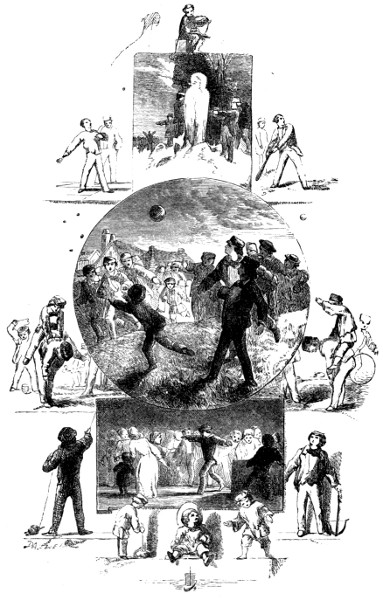
EASY GAMES WITH TOYS, OUTDOOR.
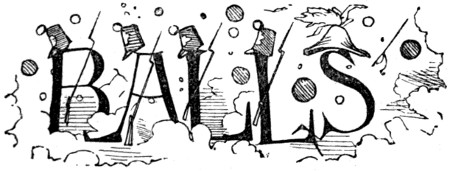
This is very simple play. The ball is thrown into the air by one player, the others standing round him. He calls out the name of the player, for whom the ball is thrown. If it be caught by the player so called, before the ball reaches the ground twice, he scores a point; if any of the other players catch it, they score a point, and the other loses one.
This is a variety of the above game. A certain number of stools are set up in a circular form, and at a distance from each other, and every one is occupied by a single player; when the ball is struck, which is done, as before, by the hand, every one of them is obliged to alter his situation, running in succession from stool to stool; and if he who threw the ball can regain it in time to strike any of the players before he reaches the stool to which he is running, he takes his place, and the person touched must throw the ball, until he can in like manner return to the circle.
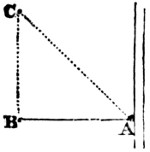
All the players engaged in this favourite pastime must place their caps on the ground, close to the wall, in such a manner that a ball may be easily pitched into them. A line being marked on the ground about fifteen feet from the wall, one of the players takes his station at it, and begins the game by throwing the ball into one of the caps; the moment this is done all the boys run away, excepting the one into whose cap the ball is thrown, who immediately runs to take it out, and endeavours to strike one of the fugitives by throwing the ball at him; if he can do so, the one struck has a small stone, called “an egg,” placed in his cap, and has to take his turn at pitching the ball. Should the thrower fail to hit one of the boys as they are running away, an “egg” is put into his cap, and he has to pitch the ball into the caps again. If a player fails to throw the ball into a cap, he earns an “egg,” but continues throwing until he succeeds. When a player gets three “eggs” in his cap, he is out. When all the players but one have been struck out, he is considered the winner, and the punishment of the losers then commences; one of them standing near the wall bounces the ball at it with all his force, and next stands with his back to the wall, stretching out his right arm, and placing the back of his hand quite close to the wall, while the winner, standing where the ball fell, takes aim, and throws the ball at the said loser’s hand three times: each of the losers likewise receives the same punishment from him. In some places it is usual, when one boy gets out, for him to bounce the ball against the wall, and all the other players, standing at the spot where the ball first touched the ground, to have their three balls at his back, as he stands with his face to the wall. Should the ball in rebounding swerve either to the right or left, a line must be drawn, from the spot where it falls, to a place directly in a straight line from the boy at the wall; thus, suppose A is the boy who has just bounced the ball, which instead of going direct to B, has deviated from the straight line A B to C, a line should be drawn from C to B, and the winner should stand at the latter.
In this game four or five stones or marks must be placed on the ground, as in the annexed figure, A, B, C, D, E, about twelve or fifteen yards asunder; these marks are called bases, and one of them, as A, is styled “home.” The players next toss up for the office of “feeder,” who takes his place about two yards in front of “home,” as at F, and the rest of the players stand at and round the home. The feeder then calls out “Play!” and pitches the ball to the first player, who endeavours to strike it with[45] a bat, as far as he possibly can; should he succeed in hitting the ball, he immediately drops the bat, and runs to the first base on his right hand, as E, while the feeder is going after the ball: but if he can run all the bases and then home, before the ball is in hand, so much the better. If, however, the feeder obtains the ball soon enough to throw it at, and strike him with it as he is running from base to base, the player is out; he is also out if the feeder catches the ball: in either case the player becomes feeder, and the latter runs home to join his playmates. Should any of the other players be out at the bases, when one is caught or struck out, they also must run home. If the first player could only reach the base E, after striking the ball, he should, when the second player strikes it, run to the base D, as it is not allowable for two persons to be at one base at one and the same minute; he proceeds in the same manner to the third and fourth bases, until he arrives home again, thus enabling the others to get to their bases and home in their respective turns. The player with the bat is not obliged to take every ball the feeder chooses to give him; if he does not like a throw, he catches the ball and throws it back again. He is not allowed to make more than three “offers” at the ball; if he does so he is out, and must be feeder.
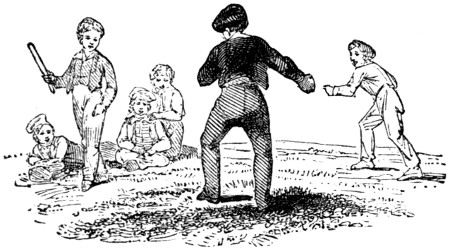
This game, which takes its title from the names assumed by the players, is played by seven boys, each of whom calls himself after one of the days of the week. To show the manner of playing the game, we will suppose that some boys are playing at it, and that the ball is taken by “Wednesday;” he throws it up against a wall, calling out at the same time the assumed name of any one of the other players, who should be standing around—we will suppose, for instance, “Friday!” All the boys but Friday run away, and he endeavours to catch it ere it falls to the ground; if he can do so, he throws it up again, calling out another boy’s name—say “Sunday!” Should the ball touch the ground before he can catch it, he must[46] pick it up and throw it at the retreating party; and if he succeeds in hitting one of them, the boy struck has to throw the ball up the next time; but if he cannot strike one he loses a point, as in Egg-hat; indeed, in the rules respecting the punishment of the losers, and the number of points each player is restricted to, it resembles that game.
Dig near a wall nine holes, of about six inches in diameter, and three deep. Let each player have one of these, according to his number, which must be determined by lot. At about six yards from the holes draw a line, and from this, as a fielding place, one player pitches the ball into one of the holes. The boy to whom this hole is assigned immediately runs to it, while all the other players run off in different directions. The player snatches the ball from the hole, and throws it at one of the “runners;” if he hits him, the one so hit becomes “pitcher,” and the one that struck him marks one. Should he not hit him, the player who throws the ball loses a point, and bowls. The player who misses his aim at throwing the ball at his partners a second time becomes a “Tenner.” If he loses a third hit, he is a “Fifteener;” if the fourth, he stands out and can play no more. When all the players are thus out, the last player remaining in wins the game, and he can compel each of the losers to stand with their hands open against the wall, for him to throw at, and give what is called the “Brandy Ball.” If the ball be a soft one, this conclusion of the game is all very well; but if a hard ball be used, it ought to be omitted, or the “Brandy” may be too strong.
This game is played with a trap and ball, which is struck with a bat or bludgeon at the pleasure of the players; but the latter is most commonly used. The performance of this game does not require the attendance of either of the parties in the field to catch or stop the ball, for the contest between them is simply who shall strike it the greatest distance in a given number of strokes; the length of each stroke is measured before the ball is returned, by means of a cord made fast at one end near the trap, the other being stretched into the field by a person stationed there for that purpose, who adjusts it to the ball, wherever it may be.
The cord is divided into yards, which are properly numbered upon in it in succession, so that the person at the bottom of the ground can easily ascertain the distance of each stroke by the number of the yards, which he calls to the players to place to their account, and the ball is thrown back.
This is a most excellent game, and very popular in some of our English counties. It is played with a moderate-sized ball and a[47] hand-bat, i. e. a bat that can be held in one hand, and which is about two feet in length, smooth, and round. Two parties play at the game, and there ought not to be less than five on a side; and the first innings is decided by throwing up the ball, the party catching it being allowed to go in first.
In playing the game, five stones, or stakes (called bases), or, if these be not convenient, as many holes may be made, at about sixteen yards apart, forming the five parts of a pentagon, as in the diagram. At the centre of this figure is a station called the feeder’s place, being the spot at which one of the out party stands to give the ball to the batsman, or to “feed” him, as it is technically termed. The out party are distributed over the field, except the feeder, who takes his station at F to deliver the balls, while one of the in party takes the bat and places himself at Fig. 1, which is enclosed within a circle, and called the Home, and where all the rest of the in party stand. The feeder then says “Play,” and delivers his ball to the batsman, who immediately strikes it as far as he can. As soon as he has done so, he drops his bat, and runs to as many of the stations as he can; but he must touch at all, or he will be out. If while he is running to the second, or between any of the bases, the returned ball is sent up and strikes him, he is out, and the next of the in party takes up the bat. If he is not struck while he runs, as soon as he reaches one of the stations the next of the in party takes up the bat, another ball is given by the feeder, and he runs to the first, or as many other of the stations as he can; the first batsman does the same, so as to go the whole round of the bases to the home at No. 1. The in player is also out if he tips the ball behind him, or if he misses striking it when delivered. The in players as they arrive at home take the bat again, till they are got out, according to the rules of the game just given. When it happens that all are out but two, the best of the two may, with the consent of the other, call for “three fair hits for the rounder.” Standing at the home, the feeder then gives him in succession three balls. He may decline as many balls as he pleases, if they do not suit him; but if he strikes at the ball, he is only allowed to do so twice without running. On the delivery of the third ball, he must run the entire course, touching with his bat at every one of the five points. If, during his progress, he be touched by the ball, or it be grounded at the home while he is absent, he is declared out, and the opposite side go in and take their places. If, on the contrary, he reaches home without being struck or the ball grounded, his side go in again, and continue the game as before. Should he miss the ball when striking at it the third time, the rounder is lost. In the play the feeder is allowed to make feint or pretence of throwing the ball, in order to tempt a player to run[48] from his base, so as to get a chance of hitting him. It is usual also for the out party to place a player behind the home, so that when a batsman makes a tip on the side of the home, he may seize the ball and strike him out before he reaches the first base.
This game is very like Catch-ball. The object is to catch a ball seven times in a particular fashion; hence the name. The player begins by throwing the ball in the air and catching it seven times with both hands. Then he catches it seven times with the right hand, next seven times with the left. Then he throws the ball up, claps his hand while it is in the air, and catches it seven times with both hands, then with the right, and then with the left. The players are allowed to make as many more variations as they please; and he who goes through the series first wins the game.
This is an old English sport, mentioned by Gower and Chaucer, and was at one period common to women as well as men. In the northern parts of England, particularly in Yorkshire, it is practised in the following manner:—A stool being set upon the ground, one of the players takes his place before it, while his antagonist, standing at a distance, tosses a ball, with the intention of striking the stool. It is the former player’s business to prevent this, by breaking it away with the hand, reckoning one to the game for every stroke of the ball; if, on the contrary, it should be missed by the hand, and touch the stool, the players change places. The conqueror of the game is he who strikes the ball most times before it touches the stool.
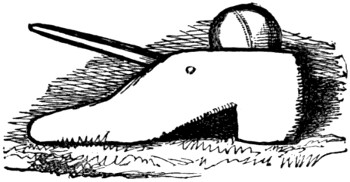
This game is so called from the trap used to elevate the ball when it is to be struck by the batsman. It is one of the earliest games played with the trap and ball, and we can trace it to the commencement of the fourteenth century. The manner in which it was then played was somewhat different to the style at the present day. As now played, the trap is no longer elevated, but set on the ground, and is generally made in the form of a shoe, the heel part being hollowed[49] out for the reception of the ball: but some boys, when they cannot get a trap, make a hole in the ground, and having obtained the crochet bone of an ox, place it in a slanting position, one end being in the hole and the other out of it. The elevated end is then sharply struck with the bat, which causes the ball to rise to a considerable height, and then all the purposes of a trap are answered, especially if the ground be hard and dry.
It is usual in the present game of Trap and Ball to place two boundaries, at a given distance from the trap, between which it is necessary for the ball to fall when struck by the batsman, for if it falls outside of either, he gives up his bat and is out. He is also out if he strikes the ball into the air, so that it is caught by an opposite player; and, again, if the ball when returned by an adversary touches the trap, or rests within one bat’s length of it. Every stroke tells for one towards the striker’s game.
There are some variations in the play of the game in different counties. In Essex and Suffolk, for instance, the game is played with a cudgel instead of a bat, which would seem to be a preferable weapon, as those who strike with it rarely miss their blow, but frequently send it to an astonishing distance, no boundaries being set.
The ball being stopped by one of the opposing party, the striker forms his judgment of the ability of the person who is to throw it back, and calls in consequence for any number of scores towards the game that he thinks proper. It is then returned, and if it appears to his antagonist to rest at a sufficient distance to justify the striker’s call, he obtains his number; but when a contrary opinion is held, a measurement takes place, and if the scores demanded exceed in number the length of the cudgel from the trap to the ball, he loses the whole, and is out; while, on the other hand, if the lengths of the bat are more than the scores called for, the matter terminates in the striker’s favour, and they are set up to his account.
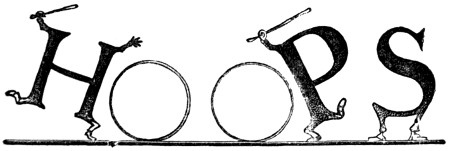
Trundling the hoop is a pastime of uncertain origin, but it has long contributed to the health and amusement of the youth of Great Britain. Iron hoops have almost superseded the old-fashioned wooden ones, and instead of being trundled with a stick, they are usually[50] guided by an iron hook shaped like the annexed figure. On a cold frosty morning the hoop is an invaluable companion to a boy, as he is enabled by its aid to defy the weather, and dispense with overcoats, comforters, and all such devices for keeping out the wintry wind. Often have we envied our juvenile friends, as they have rushed past us with their hoops, and lamented that custom should prevent grown-up people indulging in the same healthful recreation.
The proper and legitimate hoop, however, should be made of a stout ashen lath, round on the outside and flat on the inside, and should be well fastened at its point of juncture; it should be in height so as to reach midway between the youngster’s elbow and shoulder, so that he may not have to stoop while striking it. The stick should be about sixteen inches long, and made of tough ash; and, in bowling the hoop, the bowler should strike it vigorously in the centre, and in a direction horizontal with the ground. Such hoop exercise is exceedingly good, and a good run with such a hoop will warm the youth in the very coldest weather.
The games, properly so called, that can be played with the hoop are very few, and not generally known.
Two boys start at different ends of the playground with their hoops, and, meeting in the middle, each endeavours to knock down the hoop of his antagonist, while his own remains upright.
There is no small skill required in this game, for it is not always easy to make the hoops touch each other at all. Then a light hoop has little chance against a heavy one, unless it can strike it sideways, for if it were struck directly in front, it would be certainly upset.
Also, a ready hand at recovering a falling or tottering hoop wins many a game that appears to be hopelessly lost.
Wooden hoops, also, give due exercise to the arm; and there is some tact required in knowing exactly where to strike a hoop, so as to propel it with the greatest force.
This cannot well be done with iron hoops, and forms one of the objections to them. Moreover, boys always complain that they soon lose their round form, and are awkward to bowl. Still, there is something cheering in the ringing sound of an iron hoop, as it rushes[51] along under the pressure of the curved iron rod that is used instead of a hoop-stick; and as long as boys don’t drive them against the legs of unwary passengers, they are very well in their way.
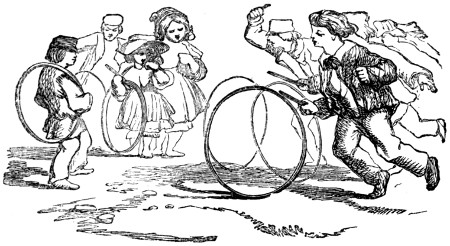
Any number of boys can join in this exciting sport, but they ought all to be provided with hoops as nearly equal in size as possible. At a given signal the players all start together, and each endeavours to reach the winning post (which may be any distant object) before his companions. He who arrives at the winning-post last is generally received with groans, hisses, and other vocal signs of disapprobation.
Bases, called posting-stations, are formed at regular distances, in a large circle or ellipse, and at each base a player is stationed. Every player, except the hoop-driver, has charge of a base. Let us suppose that there are seven players—A, B, C, D, E, F, and G, and that the latter holds the hoop: the other six players having taken possession of their stations, G now starts from the station belonging to F, and drives the hoop towards A, who waits, with hoop-stick in hand, ready to relieve G of his charge. G stops at the posting-station, while A trundles the hoop to B, who takes charge of it, and delivers it to C. C trundles the hoop to D; D transfers it to E; E delivers it to F; and F conveys it in safety to the first player, G. In this way the game continues, until all the players have worked round the circle five or six times. It is considered very disgraceful to touch the hoop with the hand, or to allow it to fall after it has been started on its journey. The game is rendered much more lively by increasing the number of players, and having two or three hoop-drivers to follow each other from base to base.
This game is almost the same as Encounters. Two boys drive their hoops one against the other, and he whose hoop falls in the encounter is conquered. With eight players this game may be rendered very exciting. Four of the players stand in a row, about six feet apart, and, at a considerable distance, the other four take their stand, facing them. At a given signal each player dashes towards his opponent, and strives to overturn his hoop. The four victors now pair off, and charge two against two. The conquerors then urge their hoops one against the other, and he who succeeds in overturning the hoop of his antagonist wins the game. Wooden hoops are more suitable for Tournament than iron ones, though the game is usually played with the latter.
Five or six boys can play at this game, though only one hoop is required. Chance decides which of the players shall first take the hoop. The other players become turnpike-keepers. Each turnpike is formed of two bricks or stones, placed on the ground, and separated by about three fingers’ breadths. These turnpikes are fixed at regular distances, and their number is regulated by the number of keepers. When all is ready, the first player starts his hoop, and endeavours to drive it through all the turnpikes; should he succeed in this, he turns the hoop, drives it back again, and retains it until it touches one of the turnpikes, the keeper of which now becomes hoop-driver. When a player touches the hoop with his hand, or allows it to fall, he must deliver it up to the nearest turnpike-keeper. Each keeper must stand on that side of his turnpike which is towards the right hand of the hoop-driver, and it therefore follows that he must alter his position when the hoop-driver returns. Should a keeper stand on his wrong side, the driver need not send the hoop through his turnpike. When the players are numerous, there may be two or more hoops driven at once.
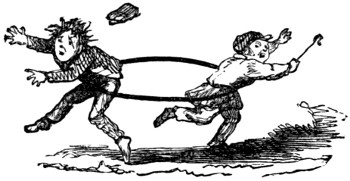
HOOP STICKS.
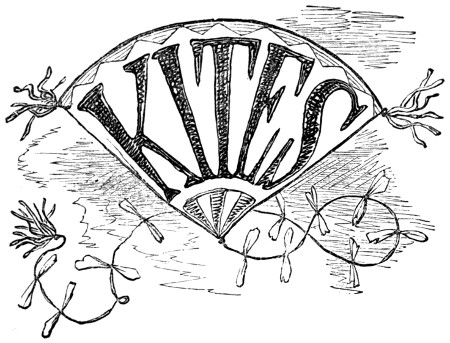
The form of the kite and manner of flying it must be familiar to all our readers. This favourite toy probably received its denomination from having originally been made in the shape of the bird called the kite. The flying of paper kites is a favourite pastime among the Chinese. On a certain day they hold a sort of kite festival, and then people of all ages hasten to the hills to fly their kites, the fantastic shapes and gaudy colours of which produce an extraordinary effect. Philosophers have occasionally taken the kite out of the hands of the schoolboy, and have applied it to useful and curious purposes. By means of a kite formed of a silk handkerchief stretched over a wooden frame, Dr. Franklin drew down lightning from the clouds, and demonstrated its identity with electricity. Many years ago Mr. Pocock, of Bristol, travelled on the road between Bath and London in a carriage drawn by two paper kites, supported at a moderate elevation, and impelled by the wind. The paper kite has also been employed to convey a line over the capital of Pompey’s Pillar. We do not expect our readers to perform any electrical or locomotive experiments with their kites; but we are quite sure that they may derive great amusement from these little aërial machines, especially if they manufacture them with their own hands. We know of no pleasanter occupation for a summer’s day than watching the graceful flight of a well-made kite.
For the upright get a good straight lath, as A B, in the annexed figure, and next procure half of a thin hoop or cane for the bow C D, and then tie the hoop to the upright at A, and take care to have as much on one side of the upright as on the other; otherwise your kite[54] will be sure to fall on one side when flying. Notch the two ends of the bow C D, and tie a long piece of string to D; pass it round the upright at E, and then fasten it at C; next carry the string to A, pass it down to D, and tie it there: from thence it is to be continued to B, passed round a notch there, and carried up again to C, then down the upright at F, and up to D, where it is to be finally fastened off. The skeleton being thus finished, the next thing to be done is to paste several sheets of paper so as to form a surface large enough to cover the kite and allow of a little turn over to fasten the outer edges; after you have pasted the paper on to the skeleton, you must make two holes, in the upright, as at G, G, through which the belly-band is to be passed, knotting the two ends of the string to keep it from slipping through the holes. The wings are to be made of several sheets of paper, cut into slips, rolled close up, so as to bear some resemblance to a tassel, and tied to the sides of the kite at C, D. The tail, which should be about fifteen times the length of the kite, is made by folding a number of pieces of paper so as to be about an inch in breadth, and four inches in length, and afterwards tying them on a string at intervals of three inches, and is finished by affixing to the end of the string a large tassel made in the same manner as the wings. Tie the string with which you intend to fly the kite to the belly-band, and your kite is complete and ready for service.

We need not enter very minutely into the rules to be observed in flying a kite, as every boy is acquainted with them. Unless there be a nice breeze stirring, the kite-flyer need not expect to have much sport, as nothing can be more vexatious than attempting to fly a kite when there is not sufficient wind for the purpose. To raise the kite in the first instance, the flyer will require the aid of another boy. The owner of the kite having unwound a considerable length of string, now turns his face towards the wind and prepares for a run, while his assistant holds the kite by its lower extremity as high as he can from the ground. At a given signal the assistant lets the kite go, and if all circumstances be favourable it will soar upwards with great rapidity. With a well-constructed kite, in a good breeze[55] the flyer need not trouble himself to run very fast nor very far, as his kite will soon find its balance, and float quite steadily on the wind. The kite-flyer should be careful not to let out string too fast. When a kite pitches, it is a sign that it is built lop-side, or that its tail is not long enough.
Some boys amuse themselves by sending messengers up to their kites when they have let out all their string. A messenger is formed of a piece of paper three or four inches square, in the centre of which a hole is made. The end of the string is passed through the hole, and the wind quickly drives the messenger up to the kite. The kite-flyer should be careful not to send up too many messengers, lest they weigh down the kite.
Calico has many advantages over paper as a covering for kites; it is not so liable to be torn, is not damaged by wet, and may be sewn on the framework much more neatly than paper can be pasted. Being much heavier than paper, it is, however, only suited for large kites. A portable calico kite may now be procured at most of the toy-shops. The framework of this kite is formed of two slender pieces of wood, which turn on a common centre in such a manner that they can either be shut up, so that one piece lies flat upon the other, or opened out into the form of a cross. The calico covering is attached to this cross by means of tapes. This portable kite can be rolled up and carried to the field without inconvenience.
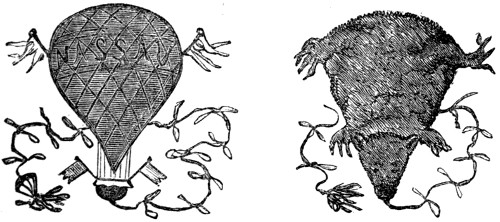
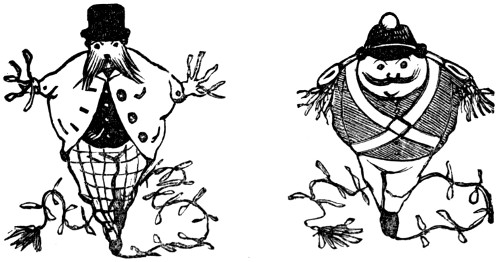
Ingenious boys now and then take a hint from the Chinese, and so shape and paint their kites that they resemble different animate and[56] inanimate objects. The “officer kite,” which has the figure of a soldier painted on it, and the “hawk kite,” which rudely represents a flying hawk, are common forms of fancy kites. A very funny effect may be produced by painting a kite like a sailor, and attaching moveable arms, instead of the ordinary tassel wings, to the shoulders. We present our readers with a few suggestive forms, which are quite novel. All fancy kites should be painted with the most glaring colours, and the figures on them drawn as coarsely as possible, as they are intended to be seen at a great distance.
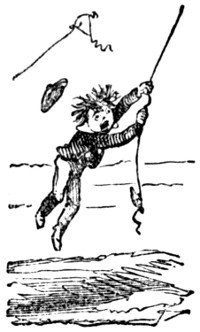
A HIGH FLYER.

In ancient times, when we were boys, and indulged in the luxury of marbles, they were very different from their present form. They were made of stone, nicely polished, and some of them, called “alleys,” of the purest marble. Many of the stone marbles were beautifully variegated, and now and then a fancy pet was treasured under the name of “taw,” which had somewhat the virtues of a talisman, for to “lose it or to give it” were “such perdition,” as Othello says, as could never be exceeded. Of late years, marbles, like all other matters, have undergone considerable change. Foreign marbles have been introduced, prodigiously cheaper, it is true, than our old English marbles, but infinitely worse; and various kinds of “patent marbles” have had their day. Some of these go by the name of Dutchmen, others are called Frenchmen, and others again Chinamen, while it is not quite impossible to procure some right old English marbles, which, if they can be procured, are still the best. We would advise all marble players to procure these, if they can, as “marbles” is a royal game, and ought to be duly honoured.
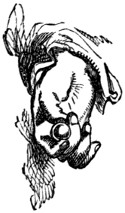
HOW TO HOLD YOUR TAW.
How to Shoot your Marble.—The art of holding a marble to shoot it properly seems to be lost among our London boys, who are generally[58] content to throw one marble at another, or if they shoot it to hold it in the turn of the fore-finger, forcing it out by the thumb, which is placed behind it. This, in our boyish days, was held to be a very illegitimate way of proceeding, derogatory to the true marble-player, and bore the dishonourable appellation of “fulking,” and any one who made it his rule to hold a marble in such a manner was looked upon as a charlatan, or almost a cheat. The true way to hold your taw is to place it between the point of the forefinger and the first joint of the thumb, and to propel it from the nail of the thumb with strong muscular force; and so great was the skill attained by many boys, that they would sometimes strike a marble at five yards’ distance, and frequently shoot one to six or seven.
This game is played by several players, each of whom puts down a marble in a small ring. One player then stands in a perpendicular position over the cluster of marbles, and, taking his own bounce in his hand, lets it fall from his eye on to the heap, and those forced out of the ring by this method are considered won. If he does not succeed in this, and his marble falls within the ring, it belongs to the common stock, and is there impounded.
There is a game called “Conqueror,” which is extensively played in some places. A piece of hard ground, and free from stones, is chosen for the spot. The first player lays his marble on the ground, and the second throws his own at it with all his force, and endeavours to break it. If he succeeds, his marble counts one, and the vanquished player lays down another marble. If two players have marbles that have already vanquished others, the “Conqueror” counts all the conquered of the other party in addition to his own. For example, suppose A, being conqueror of twenty, breaks B, also a conqueror of twenty, A counts forty-one, i. e. twenty of his own, twenty for the vanquished belonging to B, and one for B itself.
Nuts, chestnuts, and other similar objects are also employed in this game, only they are fastened to a string, and swung against the opponent, instead of being thrown.
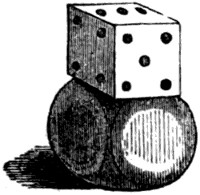
This is a very good game, and requires both skill and caution. It is played by elevating a die upon a marble, whose sides are slightly ground down, so that it will stand firmly, and firing at it from an offing, which is generally at a distance of about four feet from it. The die-keeper undertakes[59] to pay to the shooter who knocks down the die the number which falls uppermost, receiving one marble from each player as he shoots.
This game is a great improvement upon odd or even. Dick asks Tom to guess the number of “eggs in the bush”—that is, the number of marbles in his closed hand. If Tom can guess the right number, he takes all; but if he is out in his reckoning, he pays Dick as many marbles as will make up or leave the exact number. Suppose Dick has six marbles in his hand; now, if Tom should guess either four or eight, he would have to forfeit two marbles to Dick, because four is two less, and eight is two more, than the exact number. The players hold the “eggs in the bush” alternately.
In most respects resembles Ring taw, the variations being, that if before a marble is shot out of the ring one player’s taw is struck by another’s (excepting his partner’s), or if his taw remains within the ring, he puts a shot in the pound, continues in the game, and shoots again from the offing before any of his companions. If his taw is struck after one or more marbles have been driven out of the ring, if he has taken any shots himself, he gives them to the player who struck him, puts a taw in the ring, and shoots from the offing, as before. If, however, he has not won any marbles during the game, before his taw is struck, he is “killed” and put out of the game; he is likewise out if, after any shots have been struck out, his taw gets within the pound—if it remains on the line it is nothing. He then puts the marbles (if he has won any) into the circle, adding one to them for the taw struck, and shoots again from the offing. In case he cannot gain any shots after his taw gets “fat,” as remaining in the ring is termed, he is killed, and out for the rest of the game. When only one marble remains in the ring, the taw may continue inside it without being “fat.” Each player seldom puts more than one marble in the ring at the beginning or a game.
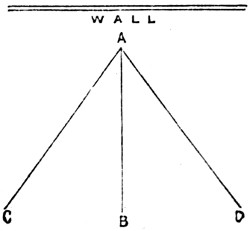
This game is played by knocking marbles against a wall, or perpendicular board set up for the purpose; and the skill displayed in it depends upon the player’s attention to what is called in mechanics the resolution of forces: for instance, if an object be struck against the wall at A from the mark at B, it will return again to B in a straight line; if it be sent from C to A, it will, instead of returning to C, pass off aslant to D, and its course will[60] form the angle C A D; the angle of incidence being equal to the angle of reflection.
The game is played by any number of players: the first player throws his marble against the wall, so that it may rebound and fall about a yard distant from it; the other players then, in succession, throw their marbles against the wall, in such a way as to cause them to strike any of those already lagged out, and the marble struck is considered won by the owner of the taw that strikes it, in addition to which the winner has another throw. When only two boys play, each successively throws out till one of the “laggers” is struck, and he who strikes takes up all.
Long taw is played by two persons in the following manner. One boy places his marble on the ground at A, the other at B; then both retire to the spot C. The first boy now shoots at B from a line marked at C. If he strikes it, he takes it and shoots at A; if he strikes A, he then wins the game. If, however, he misses B, the second boy then shoots at B; if he strikes it, he can then either shoot at the first boy’s taw at the place at which it lies, or he can shoot at A. If he hits his opponent’s taw, he is said to kill him, and wins the game, or if he shoots at A, and hits it. The boy who hits the last shot has the privilege of shooting at the taw of the other, provided it has not already been killed. If he hits it, the taw is taken, or the owner must pay one, and the game ends; and if he misses it, the game is then at an end also. Long taw is a game seldom played by London boys, but is very common in the different English counties.
This game is played by means of a piece of board cut into the form of a bridge, having nine arches, and just large enough to let the marbles pass through, as in the subjoined diagram. One of the players undertakes to be “bridge-keeper,” and the stipulation usually made is, that he should receive one for every unsuccessful shot, and pay to those who shoot their marbles through the arches the numbers standing over them. The place from which the players shoot their marbles is generally about four feet from the bridge.
One player extends his closed hand containing some marbles, and asks his opponent to guess whether their number is odd or even. Should he guess wrong, he forfeits a marble, and his questioner tries him with another lot; but should he guess right, the first player must pay him a marble, and take a turn at guessing.
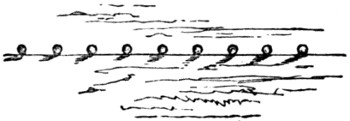
This game consists in each player placing a marble on a line drawn upon the ground thus, and the whole shooting at them in succession from a mark about four feet off. The order of the shots is determined beforehand, by pitching at a marble from a six-feet offing, those nearest being first, second, third, and fourth in order, as the marbles lie. The marbles knocked off the line are won by the respective shooters.
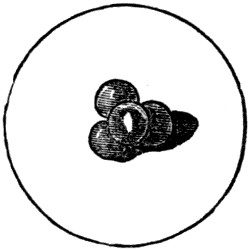
In this game a boy generally sits upon the ground, with his legs open wide, and, making a small circle, places in it three marbles at the three points of a triangle, and the fourth on the top of them, so as to form a small pyramid. A distance of about four feet is then chosen as the point to shoot from, and the other players shoot at the pyramid. Those that strike it have all the marbles they knock out of the ring; but if they miss, they lose their shots.
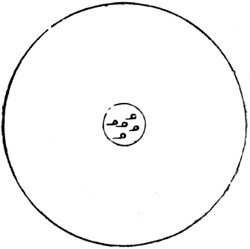
Ring taw is a game requiring skill and judgment, and is a most excellent game. It is played as follows. Two rings are drawn upon the ground, a small one, six inches in diameter, enclosed by a larger one, six feet in diameter. Into the small ring each player puts a marble, called “shot.” The players then proceed to any part of the large ring, and from thence, as an offing, shoot at the marbles in the centre. If a player knocks a marble out of the ring he wins it, and he is entitled to shoot again before his companions can have a shot. When all the players have shot their marbles,[62] they shoot from the places at which their marbles rested at the last shot. If the shooter’s taw remain in the small circle, he is out, and has to drop a marble in the ring, and he must put in besides all the marbles he had previously won in that game. It is a rule, also, that when one player shoots at and strikes another’s taw, the taw so struck is considered dead, and its owner must give up to the striker of the taw all the marbles he may have previously won during the game. The game is concluded when all the marbles are shot out of the ring, or all the taws are killed.
This consists of one boy laying down his taw, and, giving a distance, his antagonist shoots at it; if he misses, the first boy shoots at the taw of the second, till one is struck, which the striker claims. Bounce About is the same game played by throwing large marbles instead of shooting smaller ones, he who strikes the other’s bounce being the winner.

This is played on the same conditions as Die Shot. A teetotum is set spinning by the keeper, and, when in motion, any player is allowed to shoot at it, upon the payment of one marble, receiving, if he strikes, turns over, and stops the teetotum, as many marbles as are indicated on the side that falls uppermost. This is a very skilful game, and requires good shots.

This game is played by making three holes in the ground, about a yard and a half or two yards asunder. About two yards from the first hole a line is drawn. The right to shoot first is decided by chance. The first shooter now knuckles down at the line, and[63] endeavours to shoot into the first hole. If he does this he proceeds to the second, then to the third, and wins the game; but this rarely occurs. If he misses the first hole, the other players shoot their taws, and if neither of them enter the hole, the first shot immediately does so; and then he has the privilege either of proceeding to the second hole, or of killing the other men by shooting at and hitting them, when they must either give up their taws or drop one. Sometimes a player will kill all his antagonists in succession without proceeding to any hole except the first, and thus wins the game; at other times the game may be won by any of the players killing their antagonists during any period of the game. It is a rule that no one can “kill a taw” till he has been in the first hole.
This game is played by two or more players. To play it, a hole, of the diameter of three inches, is first made on a smooth or level piece of ground, and a line is marked at about seven feet from it. Each boy puts down two, three, or four marbles, as may be agreed upon, and then the whole party bowl for their throws, by retiring to three times the distance already marked from the hole, and bowling one marble to it; the order of throws being determined by the nearness that each boy’s marble approaches the hole. When this is settled, the first thrower takes all the marbles in his hand, and throws them in a cluster towards the hole. If an even number falls in, such as 2, 4, 6, 8, 10, he wins all; but if an odd number falls in, he loses all.
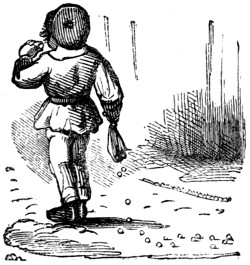
“MARBLES ARE OUT”
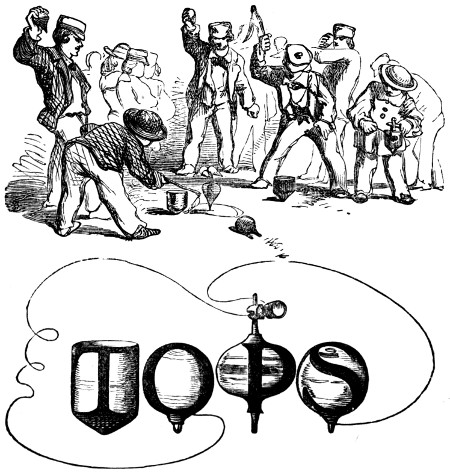
The peg-top appears to be a modern invention, but the whip-top is of great antiquity, it having been used in remote times by the Grecian boys; it was well known at Rome in the days of Virgil, and in England as early at least as the fourteenth century, when its form was the same as it is now. Strutt, in his “Sports and Pastimes of the People of England,” relates the following amusing anecdote of Prince Henry, the eldest son of James I., which he met with in an old manuscript at the British Museum: “The first time that the prince went to the town of Stirling to meet the king, seeing a little without the gate of the town a stack of corn in proportion not unlike to a top wherewith he used to play, he said to some that were with him, ‘Lo, there is a goodly top!’ Whereupon one of them saying, ‘Why do you not play with it then?’ he answered, ‘Set you it up for me and I will play with it.’”
These cannot easily be made, but can very easily be purchased by those who are so lucky as to have the money. They are made hollow, having at their crown a peg, round which is wound a string; this, being pulled through a kind of fork, gives motion to the top, and sets it spinning—the fork and the string being left in the spinner’s[65] hand. In spinning the top, care should be taken to wind the string firmly and evenly on the peg; and when it is pulled out, neither too much nor too little force should be used, and a firm and steady hand should be employed, while the top should be held in a perpendicular position. The string should be drawn with a steadily increasing force, or the top will not hum properly.
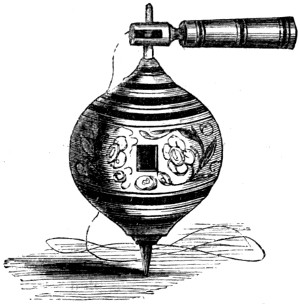
There are various kinds of Peg-tops, and they also vary in shape, some being much rounder than others. Those are the best which are shaped like a pear. There is also great variety as regards the shape and size of the peg, which in some tops is short and thick, in others long and tapering. Again, tops are made of different kinds of wood, some being made of deal, others of elm, some of yew-tree, and others of boxwood. These last are the Boxers so highly prized. Some of the very best tops are made of lignum vitæ, with long, handsome pegs.
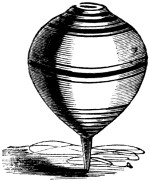
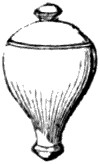
The Spanish peg-top is made of mahogany. It is shaped somewhat like a pear; instead of a sharp iron peg, it has a small rounded knob at the end. As it spins for a much longer time than the English peg-top, and does not require to be thrown with any degree of force in order to set it up, it is extremely well adapted for playing on flooring or pavement.
Whip-top is a capital sport when played by two persons; and is played by first whirling the top into motion by turning it sharply with[66] both hands, and then by flogging it till its motion becomes very rapid. When two persons play whip-top, the object should be for each to whip his top to a certain goal, he who reaches it first being the victor.
This game is played by two boys, in the following manner: Two lines, about six feet apart, are marked upon the ground, which ought to be smooth and hard. Some small stones are then procured and placed midway between the lines; they should not be larger than a small bean, and the black and polished ones are the most sought after. The tops are now set up spinning on the ground, and the players, being each provided with a small wooden spoon, dexterously introduce them under the pegs of the spinning tops, and then, with the top still spinning in the spoon, throw the point of the peg against the stone, so as to chip it out of bounds; he who does this the soonest being the victor. While the top continues to spin, he may take it up with the spoon as many times as he can, and when it spins out he must again wind up, pursuing the same plan till he “chips out.”
Directions.—In winding up the top do not wet the end of the line too much, and take care to lay it closely and evenly within the grooves. In throwing the top from you, the line must be pulled in with a peculiar jerk of the hand, which practice alone can give. The string button should be held close in the hand, between the last two fingers of the hand. There is what is called an “underhand” way of spinning a top, i. e. by holding it peg downwards, throwing it in a straight line forward, and withdrawing the string; but as we dislike everything underhand, we shall not recommend this practice any more than we shall the Spanish tops, which are spun after this method.
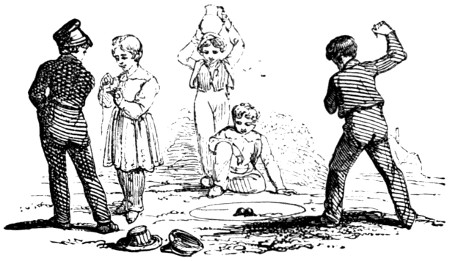
This game may be played by any number of boys. A ring about a yard in diameter is first marked on the ground, and another ring[67] surrounding the first, and at a yard’s distance from it, is also marked. The players must stand on this ring, and from it throw their tops. One player begins by throwing his top spinning into the ring, and while it is there spinning the other players are at liberty to peg at it as quickly as they can. If none of them hit it while it is spinning, and if it rolls out of the ring, the owner is allowed to take it up, and having wound it, to peg at the others which may be still spinning in the circle. Should any of the tops, when they cease spinning, fall within the ring, they are considered dead, and are placed in the centre of the circle for the others to peg at. The player who succeeds in striking any of the tops out of the circle claims those so struck out. In some places each player may ransom his top with a marble.
Sleeping tops are exposed to much danger in the play, for they offer a fair mark to the “pegger,” and often get split, when the “peg” is taken by the splitter as his trophy. Long-pegged tops are the best for the game, for they lie more upon their sides after their fall, and, before the spinning entirely ceases, are the more likely to spin out of the ring.
There is a way of making the top spring out of the ring directly it has touched the ground. Only long-pegged tops will execute this feat. It is done by drawing the hand sharply towards the body just as the top leaves the string. When the manœuvre is well executed, the top will drive any opponent that it strikes entirely out of the ring, while it does not remain within the dangerous circle itself for more than a few seconds.
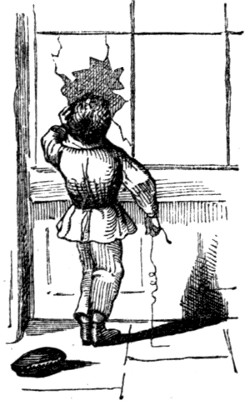
“TOPS ARE IN.”
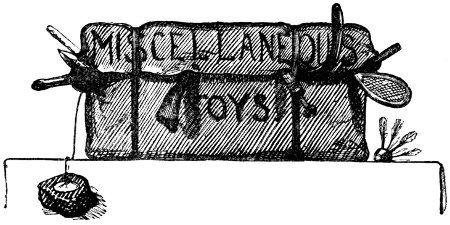
There are some out-door games played with toys which do not fall under any of our previous headings. These games we now lay before our reader, together with a description of the toys in common use.
The Apple Mill is made by boring a hole in a nut, just large enough to pass a thin skewer through; the kernel should then be extracted, and another hole bored in the side of the nut, as A in the annexed figure. A skewer should next be cut or thinned, leaving it large enough at the top to form a head, as shown in the cut. A piece of string is then to be tied to the skewer, and passed through the hole in the side of the nut at A, and an apple stuck on the end of the skewer. The mill being now complete in all its works, it should be twirled round in the same manner as the humming top to wind up the string, holding the nut stationary between the forefinger and thumb of the left hand; when this is done, the string must be pulled out quickly, and the mill will immediately spin round. When an apple cannot be procured, a small potato will serve equally well.
This amusing game is of a very simple character, consisting essentially in throwing at a small object. Aunt Sally herself is composed of a head and bust cut out of a solid block of wood, and generally carved with negro features, and painted black. In the middle of her nose, or between her lips, a hole is bored, into which is stuck a short pipe. To break it is the object of the game. An iron[69] rod serves to support the wooden figure at a proper elevation from the ground; and when in gala costume, Aunt Sally is usually arrayed in a mob cap and a petticoat. The mode of playing the game is as follows:—
The iron rod is stuck in the ground, a pipe put into the old lady’s mouth, and a line drawn upon the ground, at twelve, sixteen, or more paces. At this line the players stand, and each is furnished with three short cudgels, about eighteen inches in length, which they hurl at Aunt Sally’s head, in hopes of hitting the pipe. The best plan is to throw the cudgels underhand, giving them a rapid rotatory movement at the same time. Some persons insert an additional pipe into each ear; but this is an innovation, and leads to careless throwing. It is better to hang a sheet, net, or large cloth behind Aunt Sally, in order to catch the sticks, and save the trouble of continually fetching them from a distance. Within doors, the iron rod is furnished with a loaded pedestal.
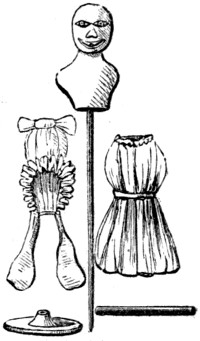
Or, “Throwing Sticks.” This very popular game among the Greeks was by them called Kyndalismos. It was played with short batons, and required considerable strength and quickness of eye. With us the game is played in much the same manner as the Greeks played it. A stick is fixed in a kind of cup or hole, about six inches deep, in a loose moist soil, and the players consist of the Keeper and Throwers. The Keeper places on the top of the stick some article, such as an apple or orange, and the Throwers endeavour to knock it off, by throwing at it with short thick sticks, or batons; whoever succeeds in doing this claims the prize, whenever it falls without the hole. The Thrower will soon find in his play, that to hit the stick is of little importance, as from the perpendicular line of gravity which the apple or orange will take in its descent, it is almost certain to fall into the hole. The aim, therefore, should be to strike the object from the stick. This game is very common at fairs and similar places, and three sticks, with articles upon them, are usually set up, but which offer no advantage to the throwers.
Tip Cat, although not altogether a nice pastime, ought to be noticed here. It is a dangerous game, and should be played with great caution on the part of the players. It is a rustic game, well known, and generally goes by the name of Cat. It is played with a[70] cudgel or bludgeon, resembling that used for trap-ball. Its name is derived from a piece of wood called a “Cat,” of about six inches in length, and an inch and half, or two, in diameter, diminished from the middle to both the ends, being of the shape of a spindle or double cone; by this contrivance the places of the trap and ball are at once supplied, for when the Cat is laid upon the ground, the player with his stick tips it at one end by a smart stroke, which causes it to rise in the air with a rotatory motion, high enough for him to strike it as it falls, in the same manner as he would a ball.

There are various methods of playing the game of Cat. The first is exceedingly simple, and consists in making a large ring upon the ground, in the middle of which the striker takes his station. His business is to beat the Cat over the ring; if he fails in so doing he is out, and another player takes his place; if he is successful, he judges with his eye the distance the Cat is driven from the centre of the ring, and calls for a number at pleasure to be scored for the game: if the number demanded be found, upon measurement, to exceed the same number of lengths of the bludgeon, he is out; on the contrary, if it does not, he obtains his call.
The second method of playing Cat is to make four, six, or eight holes in the ground, in a circular direction, and as nearly as possible at equal distances from each other, and at every hole is placed a player with his bludgeon. One of the opposite party who stands in the field tosses the Cat to the batsman who is nearest him, and every time the Cat is struck the players are obliged to change their situations, and run once from one hole to another in succession. If the Cat be driven to any very great distance, they continue to run in the same order, and claim a score of one towards the game every time they quit one hole and run to another. But if the Cat be stopped by their opponents, and thrown across between any two of the holes, before the player, who has quitted one of them, can reach the other, he is out.
This sport, which is of French origin, is for two players only. Both being blindfolded, they are tied to the ends of a long string, which is fastened by a loose knot in the middle to a post, and, as the[71] knot is very slightly tied, the players are enabled to move about with facility. The player who takes the part of the “mouse” scrapes two pieces of wood together, so as to make a grating noise, and for which purpose the edges of one of the pieces of wood are notched: the sound attracts the other player, who represents the “cat,” and he immediately uses his utmost efforts to catch his prey, by following the noise as well as he can, the “mouse” at the same time struggling about, in order to escape being caught.
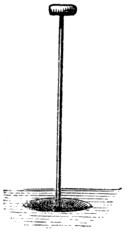
A similar game to Aunt Sally, but a simpler one, is made by scooping a hole in the ground, and placing in it an upright stick; on the top of it is placed a stone, or similar substance. The player then retires to a distance, and flings at the stone with cudgels or balls, the latter being preferable. If the stone falls into the hole, the player only counts one towards the game; but if it falls outside the hole, he counts two. This is a capital game for the seaside, and can be played upon the sands. This game is almost similar to Baton.
The pea-shooter is a tube of metal, through which a pea may be propelled with great force by a puff of air from the mouth. The ordinary tin pea-shooters sold in the shops are comparatively worthless. We should advise the reader to procure a straight piece of brass tube from two to four feet long, and get a brazier to tin one end of it, so that the brass may not corrode when placed in the mouth. With such a tube peas, pellets of clay, and other projectiles may be shot with great precision to a considerable distance. The game of puff and dart is played with a long brass tube, and a small dart having a needle point. The dart is blown through the tube at a target, on which there are divisions bearing different numbers.
The game of Quoits is very excellent. It seems to have derived its name from the ancient discus, and with us in the present day is a circular plate of iron perforated in the middle, not always of one size, but larger or smaller to suit the strength or convenience of the several candidates.
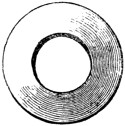
To play at Quoits an iron pin called a hob is driven into the ground within a few inches of the top, and at the distance of eighteen or twenty yards, as may be agreed upon, a second pin of iron is also fixed. The players are generally divided into parties, and[72] the players pitch the quoits from hob to hob; those who pitch the nearest reckoning towards the game. But the determination is discriminately made; for instance, if a quoit belonging to A lies nearest to the hob, and a quoit belonging to B the second, A can claim but one towards the game, though all his other quoits be nearer to the hob than all the other quoits of B, because one quoit of B being the second nearest to the hob, cuts out, as it is called, all behind it. If no such quoit had interfered, then A would have reckoned all his as one each. Having all cast their quoits, the players walk to the opposite side, and determine the state of the play. Then taking their stand there, throw their quoits back again, and continue to do so alternately, till the end of the game. A quoit that falls with its flat side upward does not count.
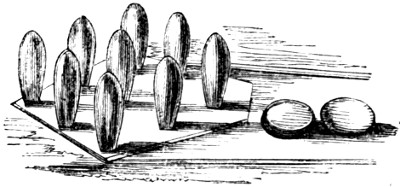
This game, as its name denotes, is played by means of nine pins, which are set up in a regular order, the aim of the players being to throw down as many as possible in the fewest attempts. Each player is permitted to throw three times at the pins, and if he can knock them all down in two throws, it is called a “single,” and they are again set up for his last throw; or, if he can knock them down in one throw, it is called a “double,” and they are set up. A heavy wooden ball, called a “bowl,” is used to throw at the pins.
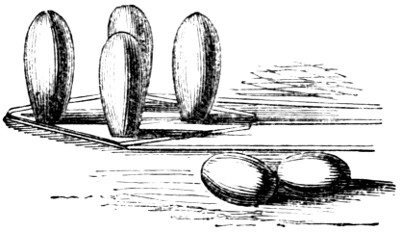
Skittles is played in a manner somewhat similar to the preceding game, but the number of pins is only four. These are very large, and[73] are arranged on a square framework, so as to present one of the angles to the player. The bowl used for playing this game is of the shape of a cheese, and is usually made of lignum vitæ, as being very heavy and hard wood. The game requires more bodily strength than nine-pins, as the bowl must be thrown upon the skittles, and not rolled up to them.
The best play is to throw the bowl with a round-handed swing of the arm, so as to strike the nearest skittle at the right of its upper third. The ball then springs to the second skittle, and from this generally twists to the third, while the fourth skittle is sent down by the roll of the one first struck. It is very difficult to make this throw successfully, and many players prefer driving down the first and third skittles with a straightforward shoot, and then making their second ball spring across from the second to the fourth. This latter stroke appears very difficult, but is soon learnt; the great point being to throw the bowl high, so that it may drop as perpendicularly as possible on the left of the upper third of the second skittle. In the long run, the constant repetition of this practice will overbalance occasional brilliancy of play.
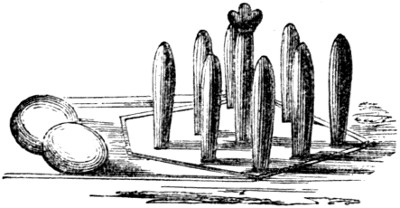
This game is nothing more than a modification of nine-pins; the pins being higher, and the centre one bearing the name of king, and a crown upon its head. The great point in this game is to strike the king out of the board without knocking down any of the subjects. If this can be done, the game is won. In all other cases, the king counts for no more than any of his subjects.
This is a good athletic sport, but the Hammer can scarcely be called a toy. The hammer used by rustics is generally the sledge-hammer of the blacksmith, with a head weighing some twelve or fourteen pounds. The players are all single and do not join in parties, and the prize is given to him who makes the greatest number of long throws in a dozen. It does not merely require strength to throw the sledge-hammer, but a nice calculation of the area which the Hammer has to pass over in its flight, combined with the strength of the thrower.

This instrument is a curved piece of wood, flat on one side, and slightly rounded on the other. It is used by the natives of New South Wales, who can throw it so dexterously as to kill a man behind a tree, where he may have fled for safety. It should be held horizontally in throwing it, and cast by bringing the arm backwards, and after making a variety of curves it will come back again to the person who send it. If skilfully thrown, it may be made to go in almost any direction the thrower pleases.
[1] The instrument represented in the cut is the Australian boomerang. Those used in England have a sharper curve.
The skip-jack is manufactured out of the merry-thought of a goose, which must, of course, be well cleaned before it is used. A strong doubled string must be tied at the two ends of the bone, and a piece of wood about three inches long put between the strings, as shown in the marginal illustration, and twisted round until the string acquires the force of a spring. A bit of shoemaker’s wax should then be put in the hollow of the bone at the spot where the end of the piece of wood touches, and when the wood is pressed slightly on the wax the jack is set; it adheres but a very short time, and then springs forcibly up. The skip-jack is placed on the ground with the wax downwards, and in some parts of the country it is usual to call out, “Up, Jack!” or “Jump, Jack!” just before it springs.
The art of slinging, or of casting stones with a sling, is of very high antiquity. We see it represented on the Nimroud monuments, and the feat of the divine youth, David, is familiar to every one. In the earliest times there were bands of slingers, and probably whole regiments of them, and there is little doubt that the art of slinging preceded that of archery. The former seemed, however, to belong to the Asiatic, as the latter did to the European nations. Our Saxon ancestors, also, seem to have been skilful in their manner of holding the sling. Its form is preserved in several of their paintings, and the manner in which it was used by them, as far back as the eighth century, may be seen in the annexed cut. We have also sufficient testimony to prove, that men armed with slings formed part of the Anglo-Norman soldiery.
In country districts, slinging of stones is a common sport; and the sling so used consists simply of a piece of leather cut into the subjoined form, to which are affixed two cords, one having a loop. In using it, leather is suffered to hang from the strong downwards; the slinger places his little finger in the loop, and holds the other end in his hand, and then putting the stone in the hole of the sling at A, which prevents its falling, whirls the whole round for three or four times, to obtain a strong centrifugal force, and suddenly letting go of that part of the sling held in his hand, the stone flies forward with inconceivable rapidity, making a twanging sound in the ear as it flies. Slinging is a very good exercise for imparting strength to the arm, but young slingers should be very careful where they send their stones, or they may do much damage.
If any of my readers may wish to construct a better kind of sling, they may do it in the following manner:—Get a currier to cut a piece of very strong buckskin leather in this shape, the centre being cut into bars. Two long strips of the same leather are then cut of this shape,
two cuts being made along them, so as to leave three leather cords. These are plaited together, and the flat ends firmly sewn to the centrepiece. The shape will then be this:
A sling made on this principle will carry a stone of a pound weight. The loop and point should be whipped with silk. The accuracy that can be obtained with such a weapon is astonishing, only the missiles should always be leaden bullets of the same weight—two or three ounces being the best average weight. At the school where my boyhood was spent, we used to send such bullets just over the weather-cock of one of the loftiest spires in England, and stripped a chestnut-tree of its blossoms. One year there was a solitary blossom on the top of the tree, which defied our efforts for many days. The blossoms were soon knocked off, but the green stalk resisted the blows for a long time. It was battered to pieces, but bent to the strokes, and had to be knocked off in fragments. I mention this to show the accuracy of aim that can be attained by practice.

Among the Swiss, and in several districts in the South of France, walking on stilts is not only an amusing, but a useful, practice, as by means of these crane-like legs men and women transform themselves into the order of “Waders,” emulating the long-legged storks and herons, and can cross over marshes and flooded grounds without wetting their feet. Stilts are easily made, being nothing but a pair of poles, with a wooden step at the sides for the feet to stand on. The poles are kept in their proper place by the hands. A little practice will soon render a youth “easy on his stilts,” and they may be made an amusing and healthy exercise.
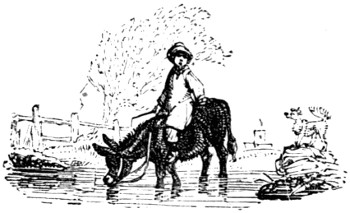
The sucker is a toy of the simplest construction imaginable; it is made by merely cutting a circular piece out of some tolerably stout leather, boring a hole in its centre, and then passing a string through the hole, taking the precaution to make a large knot at the end of the string, to prevent its being drawn completely through the hole.[77] Before using the sucker, it must be steeped in water until it becomes quite soft and pliable. If its smooth, moist surface be now pressed so closely against the flat side of a stone or other body, that the air cannot enter between them, the weight of the atmosphere pressing on the upper surface of the leather will cause it to adhere so strongly, that the stone, if its weight be proportioned to the extent of the disc of leather, may be raised by lifting the string. If the sucker could act with full effect, every square inch of its surface would support about the weight of fourteen pounds. The feet of the common house-fly are provided with minute natural suckers, by aid of which the insect is enabled to run up a smooth pane of glass and walk along the ceiling.
Our young readers will in all probability remark that we have laid but little stress on games with toys, and that comparatively few toys have been mentioned. We have done so intentionally, because the book is written expressly for boys, and those, English boys. Now an English boy always likes a toy that will do something. For example, he cares not one farthing for all the elegant imitations of guns in the world, as long as he can have his pea-shooter; and the walnut stock, the glittering decorations, and the burnished but useless barrel of the toy gun, are nothing in his eyes, when compared with the plain tin barrel of his beloved pea-shooter, which will throw a missile with rifle-like accuracy of aim.
For these reasons, we have mentioned but very few toys, looking with contempt upon those innumerable fabrications that find their place in the windows of toy-shops, and in ninety-nine cases out of a hundred are only purchased for the immediate gratification of spoilt children, who unconsciously illustrate the real objects of toys, by pulling them to pieces, and converting the fragments to unexpected uses.
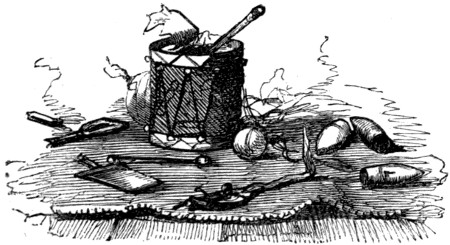
END OF TOYS.
There are many elaborate toys which are not included under this head, as they are always sold with printed directions for using them. The games which follow are played with toys of the simplest construction, many of which may be easily manufactured by the reader.
This game is so well known as to require but little remark. The Battledores may be purchased at the toy-shops, as may also be the Cocks; but many of our young friends who know anything about carpentry may easily make both for themselves. The Battledores can be cut out with a key-hole saw into the subjoined shape. They should be about a quarter of an inch thick, the handles about six inches long, and the “spades” of about five inches long, and five broad. The Shuttlecock may be made by cutting a piece of cork into the following form, and placing a small brass nail at its lower end. The top should be plumed with five feathers standing outwards from the rim, being fastened by a little gum into small holes cut therein. The practice of the game is for two players to beat the Cock backwards and forwards from one to the other, and the one that lets it fall, by failing to strike it with his bat, is to give to the other a pea, bead, pin, or some other small article. Some foreigners, particularly the Chinese, play at this game with the toes, hands, elbows, and other parts of the body, and will keep the Cocks up in a most amusing manner, in the midst of many grotesque gestures.
This toy is simply a wheel or pulley of hard wood, having a very deep groove, round which a strong but fine cord is wound. The player holds the free end of the cord between his finger and thumb, gives a rapid rotatory motion to the bandilor, by allowing it to fall towards the ground; by a sudden jerk he now tightens the cord in the groove, and the toy rises towards his hand. A little practice will enable any one to keep the bandilor in motion for a considerable time by causing it to rise and fall alternately.
A ball of ivory or hard wood is attached to a stem of the same substance, having a shallow cup at one end and a point at the other. The player holds the stem in his right hand, as shown in the figure; and, having caused the ball to revolve by twirling it between the finger and thumb of his left, he jerks it up and catches it either in the cup, or upon the spike, to receive which a hole is made in the ball. We need scarcely say that the latter feat can only be performed by a skilful player. Cup and Ball was the favourite pastime at the court of Henry III. of France.
The Cutwater is a circular piece of sheet lead, notched like a saw round the edge, and having two holes pierced in it at some distance from each other, through which is passed a piece of string, the two ends being afterwards tied together. The annexed figure shows this toy, and the way it is to be held by the player. To set the Cutwater in action, the double string must be alternately pulled and slackened. Every time the string is relaxed the disc revolves, in consequence of the impetus it has acquired from the previous pull; and every time the string is tightened, it whirls round in an opposite direction, as the double string is then untwisted. If the edge of this toy be dipped in water, it may be made to sprinkle the bystanders and the player; hence its title of “Cutwater.”
Fifteen ordinary draughtsmen compose the flock of geese. The fox may either be two draughtsmen placed one upon another, or any small object which may be at hand. The game is played on a board marked as shown in the annexed engraving. The fox is placed in the middle of the board, and the geese on the points on one side of it, as shown in the illustration. The game is to confine the fox to some spot on the board, so that there shall be either the edge of the board or else two rows of men round him. When the fox cannot escape, the game is done, and the player of the geese wins; but when one of the geese is left on a point next to that occupied by the fox, and is not supported by another goose behind, or by the edge of the board, the fox can take it, and by jumping over its head to the next space, he may, perhaps, escape the persecutions of some of the others, as all the geese are compelled to move forwards towards the end of the board that was unoccupied at the commencement of the game. The fox is allowed to move either backwards or forwards. Neither fox nor goose must be moved more than one space at a time. If the fox neglects to take when he has a chance, he is huffed, and one of the captured geese is restored to the back of the board. The fox should avoid getting into the lower square of the board if possible, as he will find it difficult to extricate himself from a position which can be so easily blockaded.
There is another method of playing fox and geese on a chessboard; namely, with four white men, representing the geese, and one black one, representing the fox.
The geese are ranged on the four white squares nearest one player, and the fox may be placed where his owner pleases. The best place for him is that marked in the diagram, as he can manœuvre in a very puzzling way.
The geese can only move forward, and the fox moves either way. The object of the geese is to pen up the fox so that he cannot move, and the fox has to break through.
If the game is properly played, the geese must win, the secret being to keep them all in line as much as possible. The fox tries to prevent this plan from being followed up; and if he can succeed in doubling the geese, or getting one to stand before another, he is nearly sure to pass through them.
To play at Goose a board must be made containing sixty-three circles, placed so as to form some resemblance to the shape of a goose, and numbered consecutively. Two dice and a box, and as many counters as there are players, are required. Each player in turn throws the dice, and according to the number he throws, so he reckons, counting from No. 1, and placing his counter on the number he obtains. The player who first reaches sixty-three wins the game. But mark; he must throw sixty-three exactly, or else he has to count the surplus number back from sixty-three. For instance, suppose when at sixty he throws eight, this makes sixty-eight, five over sixty-three. The player must, therefore, take five back from sixty-three, and leave his counter at fifty-eight. The game is called Goose from the fact that a goose is usually drawn on every fourth and fifth ring; and the player who lands on one of these, scores double the number he has just thrown. Several obstacles occur, however, on the journey. On one ring is drawn a bridge, to pass which a toll of one counter must be paid. A little farther on is an inn, where the player halts for two turns and pays two to the pool; but if he fall into the pond, the unfortunate wight has to stay there until another player tumbles in too, when he is allowed to proceed on his journey. The last hindrance is a gloomy prison, in which the same rule holds good, except that the relieving party, instead of going on as in the case of the pond, remains in durance vile until somebody else enters the prison-house. Other obstacles may be inserted at the players’ option.
One player takes an oblong piece of paper, and having divided it into three equal parts by folding, he sketches a comic head, either with pen or pencil, in the upper space; he then doubles the paper over, and hands it to another, who draws a body in the middle compartment, folds the paper over once more, and passes it to a third, who completes the figure by drawing a pair of legs in the lower space. The player who draws the head, must continue the neck a little way into the middle space, and he who sketches the body must just commence the legs in the lower compartment; this arrangement insures the connexion of head, body, and legs. Our first illustration shows how the paper is to be folded over for drawing the different parts of a figure. Each player should be provided with a pen or pencil, and a few pieces of paper; having drawn a head, he should fold his sketch in a proper manner and pass it to his right-hand neighbour; in this way a number of figures may be finished simultaneously. A knowledge of drawing is not expected of any player, as the crudest notion of a head, a body, or a pair of legs, will fully meet the requirements[82] of the game. Those who have never played at Head, Body, and Legs, can have no idea of the absurd combinations that spring from the independent labours of the different players; thus, a man’s body will sometimes get joined to a donkey’s head, and be supported by the legs of an ostrich.
This game is played with five little bones from a sheep’s trotter. One player tosses up the knuckle-bones, sometimes one at a time, sometimes all together, and catches them either in the palm or on the back of his hand, according to certain rules. Should he fail to perform one of the tricks properly, he must hand the bones to his opponent, who attempts to go through the same series of manœuvres with them. When the first player regains the bones through the unskilful play of his adversary, he once more attempts the feat he failed to accomplish before, and if he succeeds he tries to pass through the subsequent stages of the game. The player who first arrives at the end of the regulated series of tricks wins the game. It would be impossible to give the reader a clear idea of the manner[83] of performing each trick without the aid of diagrams. In almost every school may be found an experienced player at knuckle-bones, whose directions will be of more value than any remarks we can make, though we were to devote a couple of pages to this pastime. In some parts of England a similar game, called “Jackstones,” is played with small round pebbles.
This is an ancient English game, and ought not to be laid aside; so we resuscitate it for the benefit of young England. It used to be played in England on the ground with stones, but may be played best on a table indoors. The form of the merelle-table, and the lines upon it, as it appeared in the fourteenth century, are here represented. These lines are still the same. The black spots at every angle and intersection of the lines are the places for the men to be laid upon. The men are different in form and colour, for distinction sake. The manner of playing is briefly thus: Two persons, having each of them nine pieces, or men, lay them down alternately, one by one, upon the spots; and the business of either party is to prevent his antagonist from placing three of his pieces so as to form a row of three without the intervention of an opposing piece. If a row be formed, he that made it is at liberty to take up one of his competitor’s pieces from any part he thinks most to his advantage; excepting he has made a row, which must not be touched if he have another piece upon the board that is not a component part of that row. When all the pieces are laid down, they are played backwards and forwards in any direction that the lines run, but can only move from one spot to another at one time. He that takes all his antagonist’s pieces, is the conqueror.
To form this dart you must take an oblong piece of paper, and fold it down the middle lengthwise; then double each of the lower corners up to the middle crease, and fold the doubled paper over to the same mark; you must now turn each folded side outwards, and your dart will resemble the annexed figure. The paper dart, when thrown from the hand, rarely hits the object aimed at, as it generally makes a graceful curve in passing through the air. Boys sometimes amuse themselves by fighting sham battles with these harmless weapons.
The best Popguns are made of a strong straight piece of elder-tree, which ought to be cut from an inner branch, and should be about six inches long. The pith of this should be pierced out by an iron ramrod fitting the hole; and when the inside is made thoroughly smooth by rubbing the rod up and down, it is ready for use. The pellets are made with moistened tow—brown paper is a nasty thing to put into the mouth, and we shall never advise the use of it. When the pellet is prepared, it should be laid over the mouth of the gun in such a quantity as to require squeezing and plugging in. The first pellet should be driven through the gun to its other end; the second pellet is to be driven in, in a similar manner to the first, and then it is forced through the gun: the air between the pellets being incompressible beyond a certain point, forces out the lower pellet with a loud “pop;” hence the the term “Popgun,” which has been applied to them. Popgun-playing is not a very healthy exercise, the pressing of the rammer against the pit of the stomach frequently leading to derangement of that organ. To prevent this, the lad who plays at popgun should have a small round board slung over his neck by a string, hanging as low as the pit of his stomach, like a “conductor’s ticket,” against which he should press the handle of his ramrod when he fires off his popgun.
This trifling game is usually played by two boys. Each player places a pin on the table, and then endeavours to push one pin across the other with his finger-nail; should he succeed, both pins become his property. At starting, the pins must be placed head to head, and the players push alternately. Sometimes each player puts down two, three, or even more pins.
To play this amusing game, which is of German origin, it is necessary to be furnished with five cards, on which are painted the figures of a white horse, an inn, a bell, a hammer, and a bell and hammer; with eight little ivory cubes marked on one side only, six numbered 1, 2, 3, 4, 5, 6, and the other two marked, one with a bell and the other with a hammer; with a box for throwing the dice, a hammer for disposing of the cards by auction, and a proportionate quantity of counters for the players. The cards, dice-box, and auctioneer’s hammer, are shown in the annexed illustration. Any youth who can draw may easily prepare the cards; the cubes may be procured from an ivory-worker’s and may be marked with ink. The game can be[85] played by as many persons as are present. The counters are to be distributed by one of the players who holds the office of cashier, their value having been previously determined upon by the players. This being done, twelve are to be deposited by each player in the pool. The cashier then disposes of the five cards separately to the highest bidders, the produce of which is also to be placed in the pool. The white horse is by far the most valuable card, and therefore fetches the highest price in counters. The inn ranks next, and is usually purchased by the most speculative player, as its value depends upon circumstances. The bell and the hammer generally fetch the same number of counters, these cards being equally valuable, and the card upon which both bell and hammer are painted fetches about half the number that is given for one of the single figures. The bidders are not bound to confine themselves to the number of counters dealt out to them at the beginning of the game; should they exceed it, they may pay the remainder of the debt by instalments out of their receipts in the course of the game.
Each person is at liberty to purchase as many cards as he may think proper.
The dice are then to be thrown by the players alternately, beginning with the holder of the white horse, any one being allowed to dispose of his throw to the highest bidder. When all blanks are thrown, each of the players pays one to the holder of the white horse, and he pays one to the inn. If with the blanks the bell, or hammer, or the bell and hammer together are thrown, the possessor of the card so thrown pays one to the white horse.
When numbers accompany the bell, hammer, or bell and hammer, the cashier is to pay the counters, to the amount of numbers thrown, to the holder of such card, from the pool; but if numbers are thrown unaccompanied, the cashier then pays to the thrower.
When the pool is nearly empty there arises an advantage to the inn, for if a player throws a figure greater than the quantity contained[86] in the pool he pays the overplus to the inn; thus: suppose 4 are in the pool, if the players throws 10, he is to pay 6 to the inn; and if 2 are thrown, those 2 are paid to him from the pool, and so on till a figure is thrown which clears the pool, and so concludes the game.
If all blanks are thrown after the inn begins to receive, the players pay nothing, but the owner of the white horse pays one to the inn; and should the bell, &c. be thrown with the blanks, the holder of that card pays one to the inn; and if numbers accompany the bell, &c. the holder of that card must pay to the inn the number thrown above those remaining in the pool. Nuts are sometimes used as counters, and the players keep their winnings. Sometimes the cashier receives a halfpenny or a penny a dozen for the counters, and when the game is finished the receipts are divided among the players according to their winnings. Those who do not hold cards frequently find themselves richer at the close of the game than their speculative companions, whose winnings do not always exceed the price paid for their cards.
Spelicans are made of thin pieces of ivory cut into different forms, some being like spears, others saws, bearded hooks, &c.; of some of the patterns there are duplicates, whilst of others only one. Each pattern has a value assigned to it, the lowest being five, and the highest forty; the numbers do not run in regular succession—as five, six, seven, eight—but irregularly, as five, sixteen, twenty-five. Hooks, made of bone, are used pointers.
The game is played as follows:—One player should take up all the spelicans in a bundle, and holding them at a little height from the table, let them fall down in a confused heap on it; each player must then try alternately to take away a spelican from the heap without moving any of the others, and this it is generally very easy to accomplish at the first, for the top ones are mostly unconnected with the rest, but as the players proceed it requires some tact to jerk them out, with the help of the hook, made pointed for that purpose. The player who, at the entire removal of the heap, has the greatest number of spelicans, wins the game. Should any of the spelicans, while being removed shake the others, they must be put back into the heap again. It is usual in some places, instead of each player removing a spelican alternately, for one to continue lifting up the spelicans until he happens to shake one, when another player takes his turn until he in like manner fails, when another tries his fortune; and so the game continues, until all the spelicans are withdrawn.
INCLUDING
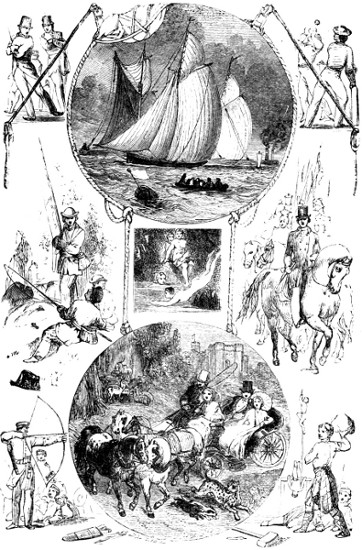
ATHLETIC SPORTS.
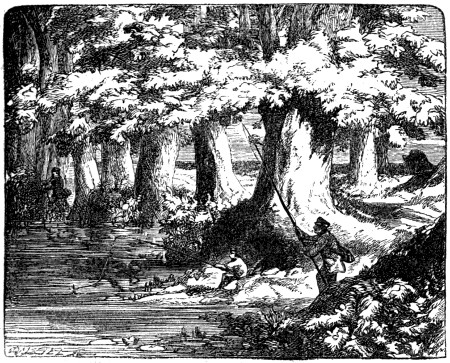
What can be more delightful than angling? Not indeed so much on account of the fish we may catch, but for the pleasantness of the recreation itself, for the cool streams, the shady trees, the little sunny nooks, the tiny or gigantic cascades, the meandering rills, the still pools, “with sedges overhung;” the picturesque mill-wheels, the deep mill-ponds, “smooth sheeted by the flood;” and above all, for[90] the hair-breadth escapes, for the duckings, for the hazards, for the triumphs. We do not wonder at boys being fond of angling, it is almost an instinct with them, and has long been a favourite amusement with boys of all degrees, ages and constitutions. Therefore we shall be somewhat comprehensive in our notices of this interesting sport, that every boy who can bait a hook and hold a line may be an angler if he will.
First, however, let us say a word about fish in general, before we come to fish in particular. Fish or fishes are, to speak scientifically, a class of vertebrated animals (having a backbone) inhabiting the water; which breathe through the medium of that fluid by means of branchiæ or gills, instead of lungs; which swim by means of fins, and are mostly covered with scales. They are also generally furnished with a white membraneous bag close to the backbone, called the air bladder, by the dilatation or compression of which it is supposed they can rise or sink in the water at pleasure. All parts of their bodies seem to aid them in swimming in the water; their fins, their tails, and the undulation of their back-bones assist progression, and their whole structure is as much adapted for swimming as that of a bird is for flight.
The fins of fish consist of thin elastic membrane, supported by bony rays, and are denominated according to their position—dorsal on the back, pectoral on the breast, ventral near the vent, anal that between the vent and the tail, and caudal the tail fins. The dorsal and ventral fins appear to balance the fish, and the pectoral to push it forward; while the tail fins are the grand instruments of motion, and enable the creature to dart forward almost as rapidly as the bullet from a gun.
With regard to the senses of fishes, the eye holds the first place; but this is best adapted for seeing under water. Of the organ of hearing there is no outward sign. The organ of taste is thought to be very unsensitive, and the sense of touch but slightly developed. To preserve their own existence, and to transmit it to their posterity, seems to be their only enjoyment; they move forward in pursuit of whatever they can swallow, conquer, or enjoy, and their insatiable appetite impels them to encounter every danger, whilst to their rapacity there seems to be no bound. A single pike has been known to devour a hundred roach in three days. The fecundity of fish is prodigious. The number of eggs in the codfish often amounts to more than three millions; those of flounders are above a million, of the mackarel 500,000, of the sole 100,000, and of the lobster 20,000; but the sturgeon is far more productive than any of these, as it has been known to have more than twenty millions of eggs!
Without saying any more about “Fish in the abstract,” as the angler called his “catch,” when he returned without one, we must go to the art of “catching fish;” and the first thing to be attended[91] to is the necessary fishing apparatus, which may be increased to any extent; but the young angler would be wise to limit his stock as much as possible. We have fished many a hundred miles of water, and killed many a thousand of fish, with no better equipment than this:—One rod of about fourteen feet long, with three tops,—one stiff top, for bottom fishing and trolling, and two for fly-fishing. Two reels or winches, one holding a silk and hair line of thirty-five yards in length for fly-fishing, and the other holding a similar line, of forty yards, but much stronger, for bottom fishing, trolling, &c. One moderate-sized creel or fishing basket. One tin bait-box for worms or gentles; one tin live-bait can for carrying pike baits or minnows; and one strong bag for carrying ground-bait. A landing-net; some shoemaker’s wax in a piece of soft leather; a large clasp-knife; a pair of sharp-pointed scissors; a pocket-book, the centre filled with leaves of flannel to hold flies, and the remainder fitted up with gut, hooks, silk, baiting-needles, a pair of small pliers, split shot, floats, &c.

The rod is a material article in the young angler’s catalogue, and much care should be taken to procure a good one. The fishing-tackle shops keep a great variety, made of bamboo cane, hazel, hickory, and other kinds of wood. Rods are of different lengths, some fitted as walking-canes, and others made to pack in canvass bags; the latter are preferred, because you may have them any length, and they are more true. Those made of bamboo cane are the best for general angling; but the rods made of the white cane much superior for fine fishing, particularly for roach, being very light in weight, but stiff.
In choosing a rod (not a school rod, for no one likes to choose that), observe that it is perfectly straight, when all the joints are put together and that it gradually tapers from the butt to the top, and is from twelve to sixteen feet long. A bad rod is likely to snap in striking a heavy fish. Rods fitted with several tops are at once the best and most convenient. Some anglers have one rod for trolling, another for barbel, perch, or other heavy fish, as well as one for[92] fly-fishing—which boys may have when they become men—but a thoroughly good rod will suit the juvenile for all purposes. We have now one with which we can fish for anything, from a bleak to a pike, by only changing the top and second joints.
A good trolling rod should be made of the choicest stout and well-seasoned bamboo cane, from fourteen to sixteen feet in length. When trolling with the gorge, or live-bait fishing, a long rod is necessary, to enable the angler to drop in his baited hook over high sedges, rushes, &c. as also when the water is bright, for he should then keep as far away from it as he can, which a long rod enables him to do while dipping, casting, or spinning his bait. If either a jack or pike see him, it is very rare indeed that he will take the bait; and again, with a long rod you will be able to drop your baited hook in some very likely place for jack or pike, such as a small hole, division, or clear place among a bed of weeds, in a river or any other water where there are any weeds.
There is some difference of opinion among anglers about the number of rings necessary for trolling rods: those who have their line on a thumb winder, or on a bank runner, seldom place more than two or three rings on their rod, and others have only one large ring at the top; but if a winch is used, there should be a ring to every joint including the butt; make each ring of double twist wire, fixed so as always to stand out, and nearly large enough to admit the top of your little finger; the top joint should have two rings, the top one nearly three times the size of the others; this prevents any obstruction of the line running, which is of material consequence. When not in use, rods should be kept nicely stowed in a moderately dry place, and they ought to be well scraped and revarnished every three years; should the joints become loose by shrinking, they should be slightly moistened. Should any accident befall a rod while fishing, and you should not have a spare top with you, your only remedy will be to splice your rod. To do this the ends of the broken pieces for about two inches must be laid parallel to each other, and then tightly bound together with waxed silk, or very strong yellow hempen twine.
Next to the rod the line is of the utmost importance. Good lines should be well twisted. The twisted lines should be made wholly of silk, or silk hair, but those made of gut are the strongest and best for young anglers; the twisted hair are the cheapest, and the single horsehair the finest. The young angler will find a line of about four yards in length the most useful. A single gut line, with a small porcupine float, is commonly useful for general fishing; the plaited silk lines are the best for trolling, and are less inclined to break or tangle than the twisted.
The line must be shotted, that the float may partially sink in the water; and in putting on the shots, place them all together within three inches of the bottom loop of the line; to which loop fix the loop of the hair or gut to which the hook is tied. When you make a line of silk, gut, or hair, remember it must be always finest at the bottom, where the hook is fastened, very gradually increasing in thickness to the top.
There are various kinds of floats, each adapted for different kinds of fishing. The principal are: 1. Tip-capped floats; 2. Cork floats; 3. Plugged floats. The tip-capped floats are made of several pieces of quills, or of reed for the middle, and ivory or tortoiseshell for the top and bottom, and narrow at each end, gradually increasing in circumference to the middle. They are superior to all others for angling in waters which are not very rapid, particularly in roach fishing, as the least movement or fine bite sinks them below the water. The tip-capped float is also best for pond fishing for carp and tench, as it requires but few shot to sink it, and consequently disturbs the water but little when cast. The young angler should note that the caps which fix the lines to the float are not rough at the edge, as this roughness chafes and weakens a fine line; should this be the case, he should smooth them before use. The best caps are made of gutta-percha.
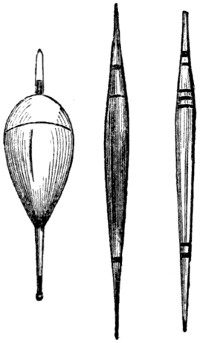
Cork Floats are generally made of quills at the top, with a piece of cork, which is burned or bored in the middle to admit the quill, and then filed or ground down smooth and painted. The bottom is plugged with wood, and has a ring to let the line pass through. Cork floats are well calculated to fish in heavy or rapid streams, as they require a great many shot to sink them, which weight of shot prevents the baited hook from passing too rapidly over the bottom. Cork floats are made of various sizes and forms; instead of common quills, some introduce the quills of the porcupine, which make an excellent strong float. Except for live-bait fishing a tapering cork float is preferable to a round one.
Plugged Floats.—These kind of floats are the cheapest, and made of indifferent quills, some of them of one goose quill with a wooden plug at the bottom, from which they take their name: they are very apt to loosen by the plug coming out. They are often used by the[94] young angler, because they are cheap; but we may say in the words of the ancient Roman, “Bad is the best.”
A reel or winch is a most necessary addition to the rod and line, as it enables you to vary the length of your line at pleasure, and to play your fish. The best winches are those to fix in a groove on the rod, and are fastened with brass ferrules made for the purpose on the butt, because you can fasten such a winch to any sized joint.
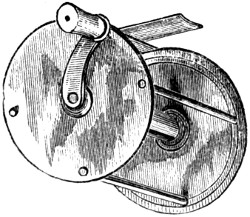
There are three kinds of winches, check, multipliers, and plain: the multiplying winch is apt soon to get out of order, unless carefully and constantly oiled, and is otherwise the least efficient and most expensive of the three. I would recommend young anglers at first, to purchase a plain and strong winch, which will answer every purpose, and be much less expensive. A check winch is, however, the best.
Are mostly made of silk and horsehair, twisted or plaited together, but some are made entirely of silk. I prefer the latter, as it is less likely to twist, runs more freely, and is less likely to rot. The length of lines vary from fifteen to eighty yards; but for general purposes thirty or five-and-thirty yards is quite long enough. The line should always be unwound after a day’s fishing, as, if it is allowed to remain wet on the reel, it soon rots.
Hooks are to be bought at the angling shops, of all sizes, and suitable for the kind of fish to be caught. There are great controversies among adept anglers about hooks, which are sometimes as violent as those upon politics or religion. Some anglers prefer what are called the Limerick hooks, some the Kendal; while others again prefer the Kirby or Sneckbend. We are hooked to the Kirby, as we consider those to be by far the best for holding the fish—a most important particular. The hooks found most suitable for the following fish are these:—
To bait a hook with a worm, use the following method: First enter the point of the hook close to the top of the worm’s head, and carry it carefully down to within a quarter of an inch of its tail; to do which you must gently squeeze or work up the worm with your left thumb and finger, while with your right you are gradually working the hook downwards. The small lively piece of the worm at the point of the hook moving about will entice the fish; but, mind, if too much of the worm hangs loose, though it may entice fish to nibble, yet they will seldom take the whole in their mouth, so as to enable the angler to hook them; on the contrary, he is frequently tantalized with a bite, and, when he strikes, finds part of his worm gone, and his fish too. Therefore, to bait a hook well with a worm is necessary to ensure hooking a fish when you strike; and it consists in drawing the worm without injuring it (use him as you would a friend, Walton says) quite over and up the shank of the hook, leaving only a small lively part of the tail below. If you bait with half a worm, prefer the tail end, and enter the point of the hook into the top part, and bring it down nearly to the end of the tail, leaving only a very small piece of it loose. If you bait with two worms on the same hook, draw the first up above the shank, while you put the second on in the same manner as directed with one worm, but enter the hook near the tail of the second worm; then draw the first one down on the second over the shank of the hook, and all will then be well covered, and the bait will be a very bon-bon for perch, chub, carp, barbel, and all large fish; but when angling for gudgeon, and other small fish, half a red worm is sufficient, and the tail end is best. If blood-worms are used, put on two or three, in doing which be tender, or you will burst them.
The principal baits are—
1. Lob-worms are found in gardens or churchyards, late in the evening; they have a red head, a streak down the back, and a broad tail. This is a good worm for salmon, chub, trout, barbel, eels, and large perch.
2. Brandling is found in old dunghills, rotten earth or cow-dung, and the best in tanners’ bark. It is a good bait for any kind of fish.
3. The Marsh-worm is found in marshy grounds, or on the banks of rivers; and is a good bait for trout, perch, gudgeon, grayling, and bream.
4. The Tagtail is found in marly lands or meadows, after a shower; and is a good bait for trout when the water is muddy.
5. The Ash-grub is found in the bark of trees. It is a good bait for grayling, dace, roach, or chub.
6. Cowdung Bait is found under cowdung, from May to Michaelmas; and is good bait for grayling, dace, roach, or chub.
7. Caterpillars can be found on almost every tree or plant. Almost any small caterpillar will answer.
8. The Cabbage caterpillar is found on cabbages.
9. The Crabtree-worm can be taken by beating the branches of the crab-apple.
10. Gentles. These are bred in putrid meat—liver producing the best—or may generally be obtained from the butchers. They are an excellent bait for most kinds of fish.
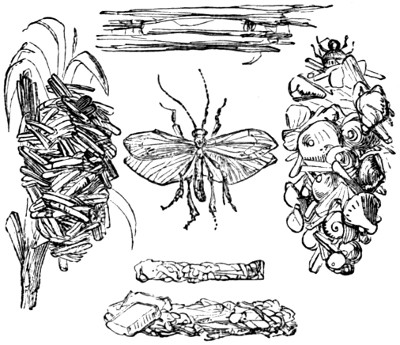
THE CADDIS FLY.
11. Caddis is found in ditches, or on the sides of brooks. It is an excellent bait for trout, grayling, roach, dace, or chub.
12. Flag-worms are found among flags in old pits or ponds, and are good bait for grayling, tench, bream, carp, roach, and dace.
13. Grasshoppers are found in sun-burnt grass, and are good bait for chub, trout, and grayling.
14. Wasp-grubs are to be obtained from wasps’ nests, and are a good bait for most fish that will take gentles.[2]
[2] Wasp-grubs will keep better, and be easier to fit on the hook, if they are baked for half-an-hour.
15. Cockchafers are found humming round the bushes at about dusk on a summer evening, and everywhere, and sometimes in cowdung; are a capital bait for chub, though not for anything else.
16. White-bread Paste is prepared by dipping white bread in water (soaking and squeezing it in the corner of a pocket-handkerchief is[97] the best way), and then working it a little in the palm of the hand. It is a good bait for carp, tench, chub, or roach. Some add a little honey.
17. Cheese Paste is made with fresh cheese, worked up in the hand. It is a good bait for chub.
18. Ground Bait should be used in the spot about to be fished, and, if possible, the night before, and should be fresh. For carp, chub, roach, or dace, use white bread soaked in water, and mixed with bran, pollard, or meal. For barbel, chandler’s greaves, boiled and worked up into a ball with clay. Gentles may also be used as ground bait for any of the above.
First select the whitest pieces from those you have soaked, and put two or three of them upon your hook, or as much as will cover it from the bend to and over the point; these pieces should be put on the hook separately, one after the other—not a large piece doubled, as some slovenly boys will do, for then the hook is prevented from entering firmly the fish you may strike. These little particulars of baiting are of considerable advantage to young anglers, who ought to remember also that it is a bad practice to soak greaves in hot water, for it makes them rotten, and they in consequence soon fall off the hook.
To do this, the young angler should provide himself with a quantity of fresh moss. Wash out all the earth and squeeze it, but not too dry; then put it into a jar and squeeze it lightly down: throw in the worms upon it. The jar should be kept in a cool place in summer, and the moss changed once in three or four days. Gentles should be thrown into a mixture of damp sand or bran to scour them, and will be ready in two or three days.
Plummets are used by anglers for sounding the depth of a stream or hole. They are of two kinds, either the folding plummet, or the common plummet. The folding plummet, which is the better, is made of a slip of sheet lead, folded up; and this the young angler should never be without.
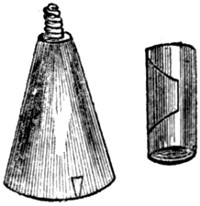
Is performed in the following manner: If a folding plummet, unfold about two inches of it, pass the hook over its side, and then fold the plummet up again: your hook is now secured from drawing away from the plummet. As success depends much in angling at a proper depth, the young angler should take due pains, and measure the depth accurately before he begins fishing. When the plumb-lead touches[98] the bottom, and the top of the float is even with the surface of the water, you will have the true depth.

The landing-hook or gaff is a large hook, which is sometimes barbed like a fish-hook, and sometimes plain, fastened to one end of a handle; this latter is occasionally composed of several pieces, which run one into another, like the slides of a telescope. A landing-net is a small net mounted on a iron ring, which is fastened, like the landing-hook, to the end of a handle or pole.
The clearing-line is made of several yards of strong small cord, to the end of which is fastened a heavy ring of lead or brass. If the hook should get fast in a heavy weed, post, or anything else, this ring is put over the butt of the rod, and suffered to slip down the line to the hook. The rod should be held in the right hand, the top pointing downwards, the clearing-line in the left, the ring falling on the hook, from its weight, generally clears the hook from what it may have struck against. If not, the angler should hold the rod firmly, and draw the line sideways, and break away. In this case, the angler seldom loses more than a hook, if he acts as above directed; but without the assistance of a clearing-line he frequently loses his float as well as his hook and line, and sometimes breaks his top joint. The brass clearing-rings are to be preferred, because they are jointed, and in consequence can be used when the angler has a winch in his rod, in which case the leaden ring could not be passed over the winch.
The drag is a piece of iron with three or four stout wire hooks without barbs, placed back to back, fastened to a strong cord line, and which is used to draw away weeds.
The bank-runner is mostly used in the day-time, when the angler is fishing for roach, barbel, &c. It is stuck in the bank, the bottom[99] being strong turned wood, sharpened for the purpose, with a winder at the top for the line, which should be from forty to sixty yards long, made of silk, thin cord, or plaited Dutch twine. But there should be a cork and bullet to the line, and the bait a dace or gudgeon, which should swim about mid-water.
This should be of an oblong form, and not round; bright inside, and brown out. In getting out the bait, never put your hand into the water, which frightens the fish, and, by heating the water, makes them sickly and dull; but make use of a small net, which is easily carried in the fish-kettle, by having a piece of the lid cut away in one corner.
This is an instrument with a forked top, about six inches long, made of iron, brass, or bone. Its use is to get the hook from a fish when swallowed; and in using it, the forked end is thrust down upon the swallowed hook with one hand, while the line is held tight with the other: pressure disgorges the hook, and it is then easily drawn out. In attempting to get a gorged hook from a fish without this instrument, you run a hazard of breaking the hook and hurting yourself. When the fish is hooked through the lip, the angler has only to hold the fish steadily in one hand, while with the other he carefully disengages the hook.
1. Never fish any water without leave from the proprietor, unless it be water that is free to all comers.
2. Never use unfair bait, or attempt to take fish in any but a fair and sportsmanlike manner.
3. Never start on a day’s fishing without first considering the wind, weather, and water.
4. Never let your shadow fall on the water.
5. Use the finest tackle of which your fishing will admit.
6. Never begin bottom fishing without first plumbing the depth.
7. Never intrude upon another fisherman’s water.
8. And always remember that nothing is lost by politeness.
The Salmon is the king of fresh-water fish. It is handsome in form, its head is small, its nose pointed, its back and sides grey, its belly silvery, and its flesh the well-known salmon colour. The male may generally be distinguished by its having the lower jaw more “hooked,” or turned up at the point, than the female; the head is also generally somewhat longer, in comparison to the rest of the body.
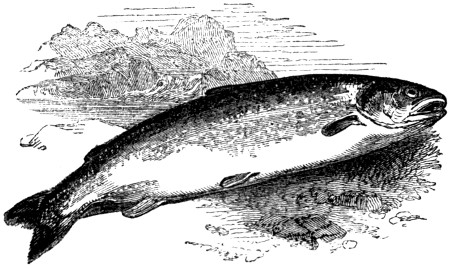
Salmon bite best from six till eleven in the forenoon, and from three in the afternoon until sunset, especially when there is a moderate breeze upon the water. The chief months to angle for them are March, April, May, and June. They are to be fished for with lob-worms, or in spinning with minnows, but a large artificial fly is the most killing bait. The rod, for a boy, should not be less than fifteen feet long, with a good running line, and the reel should contain at least fourscore yards. The hook must be large and long in the shank. Few of our young readers, however, will be able to go salmon fishing till they have reached maturity, and, therefore, to give detailed instructions as to the modes of capturing the fish would be superfluous.
This beautiful fish is much prized. Izaak Walton says of it, “It is more sharp-sighted than any hawk, and more watchful and timorous[101] than your high-mettled merlin is bold.” In its habits it is a very solitary and predacious fish.
The trout are found in lakes and rivers and minor streams, and are finest in appearance from the beginning of April to the end of July or middle of August: their principal spawning time is from November to January. The most brilliant and beautiful trout are generally found in streams that flow rapidly over rocky or chalky bottoms. They feed upon worms, minnows, and other small fish, but their favourite food consists of insects, flies, caterpillars, &c. upon which they thrive and fatten prodigiously.
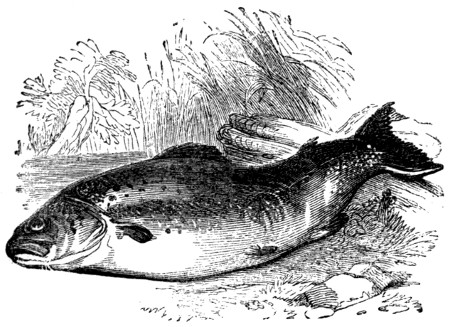
In angling for the trout we must have a stout rod and running tackle. The principal baits for him are natural and artificial flies, minnows, and worms. The minnow is, perhaps, the most taking bait for large trout: it should be cast lightly on the water, and drawn trippingly against the current so as to spin. The angler must strike directly his bait is seized. The favourite haunts of the trout are scours, mill tails, eddies, pools, the roots of overhanging trees, and the “nethers” of bridges and weirs.
The mighty luce or pike, says Walton, is taken to be the tyrant, as the salmon is the king, of the fresh waters. His aspect is savage but by no means repulsive, and when in fine condition a large pike is altogether a grand-looking fish. His teeth are very sharp and very numerous, being upwards of seven hundred, and his voracious appetite is such that nothing comes amiss to him. He has been known to swallow the plummet, and the clay and bran balls of ground bait of the angler, and he will prey upon “rats and mice and such small deer,” with ducks, geese, and even swans, which he has been known[102] to pull under water. He often grows to an enormous size (no wonder), and has been taken upwards of ninety pounds in weight.
Pike are fond of dull, shady, and unfrequented waters, with a sandy, chalky, or clayey bottom, and are found among or near flags, bulrushes, or water docks. They seldom seek a very rapid stream, although weirs and mill-pools are often their favourite retreat in the early summer months—that is, in June and July, when they have recently spawned. In winter they retire into the depths, eddies, and waters little acted upon by the current.
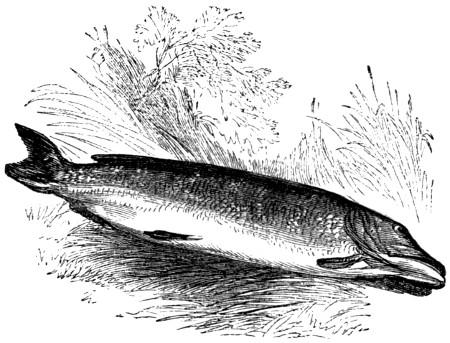
The pike is in its prime during October and November, but is in season from June to February; the baits used for it are gudgeon, minnows, chub, and bleak, and should be about three or four inches in length. The rod should be strong; the line of dressed silk, at least sixty yards long, wound upon the winch already described. Hooks for trolling, called dead gorges, and other sorts for trolling, snap, &c. and fishing needles, are to be bought at every shop where fishing tackle is sold; in the choice of the first, let them not be too large, nor their temper injured by the lead on the shanks, nor the points stand too proud; and although usually sold on wire, it is recommended to cut off the wire about half an inch from the lead, and with a double silk, well waxed, fasten about a foot of good gimp to the wire, with a noose at the other end of the gimp large enough to admit the bait to pass through to hang it upon the line. The best baits are gudgeon and dace of a middling size; put the baiting needle in at the mouth and out at the middle of the tail, drawing the gimp and hook after it, fixing the point of the hook near the eye of the fish; tie the tail to the gimp, which will not only keep it in a proper position, but prevent the tail from catching against the weeds and roots in the water. Thus baited, the hook is to be fastened to the[103] line and dropped gently in the water near the sides of the river, across the water, or where it is likely pike resort; keep the bait in constant motion, sometimes letting it sink near the bottom and gradually raising it. When the bait is taken, let the pike have what line he chooses. It will be soon known when he has reached his hole, which he generally flies to, by his not drawing more. Allow him ten minutes for gorging the bait, wind up the line gently till you think it is nearly at its stretch, and then strike. Manage him with a gentle hand, keeping him, however, from roots and stumps, which he will try to fasten the line upon, till he is sufficiently tired, and a landing net can be used; but by no means, however apparently exhausted he may be, attempt to lift him out with the rod and line only.
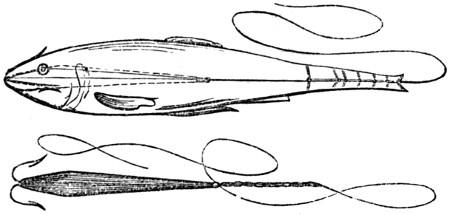
In trolling, the bait hook should never be thrown too far; in small rivers the opposite bank may be fished with ease, though the violence of its falls upon the water in long throws soon spoils the bait by rubbing off its scales. In angling for pike always prefer a rough wind. If a pike goes slowly up a stream, after taking the bait, it is said to be the sign of a good fish.
Is one of the most delicious fish for eating, although small in size. It bites freely from the latter end of spring until autumn, in gloomy warm days, from an hour after sunrise to within the same space of its setting; and during the rest of the year, in the middle of the day, when it is warmest.
In angling for gudgeon the tackle must be very fine, a single hair or fine gut fine, a hook No. 8 or 9, a short rod and line, and a small tapering cork float. The gudgeon will take the small red-worm greedily, and blood-worms—the first is perhaps the best. A rake or the boat-hook should be kept frequently stirring the bottom. To the spot so stirred gudgeon assemble in shoals, expecting food from the discolouring of the water. They are apt to nibble at the bait; the angler ought not, therefore, to strike till the float goes well down.

GUDGEON AND BREAM.
Should any young angler desire a good day’s fishing for gudgeon, and a pleasant walk into the bargain, he should seek out some sequestered gravelly stream, and providing himself with a rake with a long handle, he may have sport till he is tired of it. He will find the fish scattered up and down every river in the shallows during the heat of summer, but in winter they get into deeper water. Gudgeon are to be fished for there with your hook always touching the ground.
The roach is a handsome fish either in or out of the water. It inhabits many of our deep still rivers, delighting most in quiet waters. It is gregarious, keeping in large shoals. It delights in gravelly, sandy, or a kind of slimy marl bottom, under a deep gentle running stream; in summer it often frequents shallows near the tails of fords, or lies under banks among weeds, under the shades of boughs, and at or opposite the mouth of a rivulet or brook, that empties itself into a large river. In winter the roach like to get into clear, deep, and still waters.
The tackle for roach must be fine and strong, a twelve-foot rod and a five-foot line, a porcupine float, and hooks No. 11 or 12. The bait, gentils, bread-paste, boiled wheat or red worms. The ground bait should be damp meal or bran, mixed with soaked bread or clay (the former best). In fishing for roach in ponds, chew and throw in white bread. The hook should be No. 6, and the bait either touch the bottom or lie within one inch of it. As many gentils should be put on the hook as will cover it, all but the barb. Strike directly the float goes down.
The season for roach fishing in the Thames begins about the latter[105] end of August and continues through the winter. To London Bridge and among the shipping below it, numbers of roach return in June and July, after having been up the river to spawn, and many of them are taken by means of a strong cord, to which is fastened a leaden weight, more or less, according to the strength of the current; a foot above this lead a twine twelve feet long is joined to the cord, and to this twine at convenient distances are tied a dozen hair links, with roach hooks at the ends; these are baited with white snails or periwinkles, the fisherman holds the cord in his hand, and easily feels the biting of the fish, which is a signal to pull up, and frequently five or six are taken at a haul.
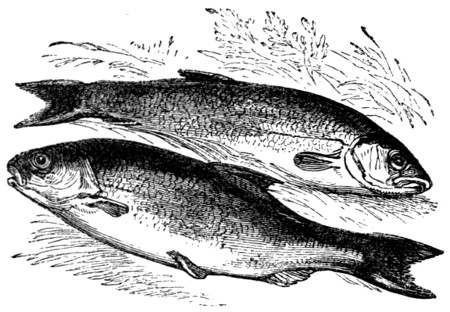
ROACH AND DACE.
Dace are gregarious—are great breeders—very lively—and during summer fond of playing near the surface. Their haunts are deep water, near the piles of bridges, where the stream is gentle, and has a sandy or clayey bottom. They like deep holes that are shaded by water-lily leaves, and under the foam caused by an eddy; in the warm months they are to be found in shoals on the shallows and gravels.
The baits for dace are red-worms, gentles, and small flies, natural or artificial, used as in fly-fishing for trout. In angling for dace with worms, maggots, &c. the tackle cannot be too fine, the float small, the hook No. 9, the shot a foot from it; by baiting the place with a few maggots before fishing, the diversion will be increased. If you angle in an eddy between two mill streams, and the water is only two or three feet deep, there will be a greater chance of success than where it is deeper; bait and strike as in roach fishing. The ground-bait may also be the same.
Fish for dace within three inches of the ground, especially where the ant fly is the bait under water. In fishing, take advantage if you[106] can of a still, warm, gloomy day, or go in a summer’s evening to a gravelly or sandy shallow, or tail end of a mill-stream, and as long as the light continues the dace will yield diversion.
“Perch feed on perch,” is an old maxim; the perch being the only one of all fresh-water fish that feeds on its own kind. His excuse is a prodigious appetite, like that of Saturn, who ate his own offspring. Notwithstanding this wicked propensity, the perch is a beautiful fish, the back and part of the sides being a deep green, marked with broad black bars, pointing downwards; the spaces between are golden, the belly white, and the fins tinged with scarlet. They vary greatly in size. The largest perch we ever caught weighed three pounds twelve ounces, and was taken with a roach bait near Richmond. Their general length is about ten or twelve inches.

Perch are found in ponds and in clear rivers with pebbly, clayey, or sandy bottoms. They are fond of water moderately deep, and frequent holes near to gentle streams where there is an eddy, the hollows under banks, among weeds and roots of trees, piles of bridges, or in ponds which are fed by a brook or rivulet. The perch is a bold biter in the summer, but scarcely ever in the winter. In the middle of a warm sunshiny day, you are sure to have him with a proper bait. In the winter he bites best in large quiet eddies, to which he retreats after the first heavy flood.
The baits for perch are various, as well as the manner of using them. Of worms, the best are brandlings, and red dunghill-worms, well scoured. The hook may be varied from No. 2 to 6, being well whipped to a strong silkworm gut, with a shot or two a foot from it. Put the point of the hook in at the head of the worm, out again a little lower than the middle, pushing it above the shank of the hook upon the gut; then put the point of the hook into the worm again the reverse way, and draw the head part down so as to cover the[107] hook entirely. This is the most enticing method that can be adopted in worm-fishing. Use a small cork float to keep the bait at six or twelve inches from the bottom, or sometimes about mid-water. In angling near the bottom, raise the bait very frequently from thence almost to the surface, letting it gradually fall again. Should a good shoal be met with, they are so greedy that sometimes they may be all caught.
Other baits for perch are cadbait and gentles; but the best and most enticing bait is a live minnow. If you find the fish shy, try not long in one spot. In baiting your hook with the minnow, fix your hook through his upper lip, and use a small reel with your rod. Your hook should be No. 5, fastened to a link of gut.
The grayling is a fish of elegant form; the back is of a dusky purple, the sides of a fine silvery grey, with the scales in long parallel rows or lines (from which the fish derives its name), marked with black spots, irregularly placed. It is rather a hog-backed fish; and, from the nose and belly touching the ground together, is supposed to feed mostly at the bottom. In length it seldom exceeds sixteen inches, but some have been caught upwards of five pounds in weight.

The haunts of the grayling are in rapid, clear streams, particularly such as flow through mountainous countries. They are usually taken in the same manner as the trout, and with similar baits. They do not bite freely till late in August, or early in September, and may be found at the tails of sharp streams and in deep water. They rise more boldly than the trout, and if missed several times will still pursue the bait. They will bite during the whole of the cold cloudy days; but the preferable time to look after them is between eight[108] and twelve o’clock in the morning, and from four in the afternoon till after sunset. Grasshoppers, wasp-grubs, maggots, and the artificial fly, are the most killing baits.
This fish takes its name from the shape of the head, not only in our own, but in other languages. The head and back are of a deep dusky green, the sides silvery. The tail is forked, and very black at the end, and altogether the chub is rather a handsome fish, although its flesh is not much in esteem.
The haunts of the chub are in rivers whose bottoms are of sand or clay, or which flow over a gravelly bottom, in deep holes, under hollow banks; in summer, particularly where shaded by trees, &c. they frequently float on the surface, and are sometimes found in streams and deep waters, where the currents are strong. In ponds fed by a rivulet they grow to a large size.

To fish for chub at the bottom, you should have a stout long rod, a strong line (and if you use a reel, you will be the better able to fish under bushes), with two yards or more of the best silkworm gut at bottom; a hook proportionate to the bait used; a swan-quill float; and the line so shotted, eight or ten inches from the hook, as to sink the float to a quarter of an inch above the surface. The same groundbait is to be used as for carp. The best baits are greaves, cheese paste, or the tail end of a well-scoured lob-worm. The cockchafer is also a very tempting bait, especially towards dusk: no float or shot are required for this.
After baiting your hook with a cockchafer, move it two or three times near the surface, as in the act of flying; then drop it in the water, tapping the rod gently, which will cause the appearance of its struggling to escape. This attracts the chub, who are so fond of this bait, that they will rise two or three at a time to seize it. But mind and be ready with your landing-net.
The chub will take a grub, wasps, maggots, paste of fine new bread worked in the hand, and tinged with vermilion, to make it look like salmon-roe; but the best bait for bottom or float-fishing for the chub is new Cheshire cheese, worked with the crumb of a new roll, or the pith from the backbone of an ox. In baiting with the cheese, put a round lump the size of a cherry on a large hook, so as to cover the bend, and some way up the shank; fish six inches from the bottom, or in cold weather the bait may lie on the ground. When there is a bite, the float will be drawn under water: strike immediately, and give him play, holding a tolerably tight line, to keep the fish clear from weeds and stumps.
The best time for fishing for chub is chiefly before sunrise to nine in the morning, and from four till after sunset in the summer; but, in winter, the middle of the day is best. In hot weather, the chub is to be fished for at or near the top of the water, and not deeper than midwater; and in cold weather, close to or near the bottom; and the main point in taking the fish is for the angler to keep himself out of sight. A very deadly way of killing chub, and certainly the most artistic method, is with the artificial fly, used as in trout fishing. Flies are made expressly for this purpose, and of these the best are red and black palmers, and the Marlow buzz.
Carp are esteemed among the richest fresh-water fish we have in the kingdom, and are as cunning as foxes. The angler, therefore, must be “wide awake” to catch him, and also as patient as a saint. He may, however, fish for him at any time in the day during warm weather. The bait may be either worms or paste. Of worms, the bluish marsh or meadow is the best; but a red-worm, not too big, will do: of paste, the best is made of bread and honey; and the spot intended should be well baited beforehand. In a large pond, to draw[110] them together, throw in either grains, or soaked bread worked up with meal or bran; follow this with a few of the small baits you intend to angle with.
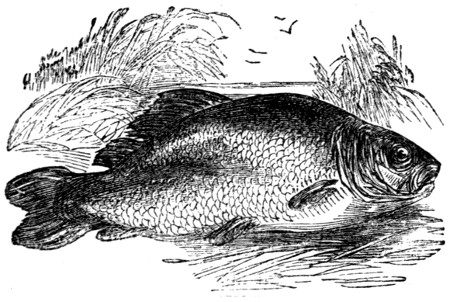
Whilst you are fishing, chew a little bread, and throw it in about the place where your float swims. In fishing for carp in ponds, the bait and about half a foot of the gut nearest the hook should lie on the bottom; otherwise the carp will continually suck the bait off. When the carp has fairly taken the bait, you will perceive the float move steadily away or under water, then strike, and not till then. In this way, with due patience, you will prove a match for these crafty fish.
The tench is one of our most useful fresh-water fishes, for the ease with which it may be preserved, and the goodness of its flesh. It is very usual to breed it in ponds, but naturally, like many others of the carp tribe, it is generally found in lakes and still waters; its favourite haunts are in places well shaded with bushes or rushes. In standing waters, it lies under weeds, near sluices, and at pond-heads.
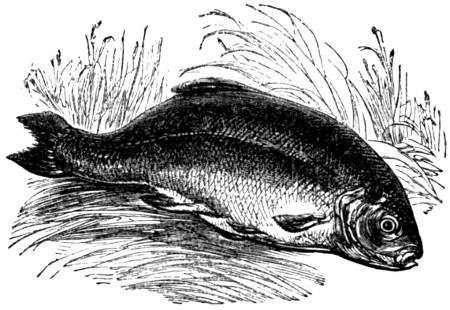
The best baits for tench are bread paste and red worms, but he usually prefers the latter. He feeds best in the three hot months. The worm should be put on the hook in the method directed for perch, but the hook itself should be of a somewhat smaller size. Use a light float and strong gut line, and let the bait swim within an inch or two of the bottom.
Is something like a perch in shape, but more bluff and bulky. He is found principally in slow, deep, quiet rivers, which have a loamy bottom. The spawning time is in April. The best baits for him are red-worms and brandlings. The places where he is to be had are[111] where the water is deep and still; and these places should be baited with some clay-balls, with which worms are mixed. Should the water be muddy, worms will do alone; but if clear, clay must be used to render it opaque before you fish. The fish will bite at any time of a warm summer’s day, when the sky is cloudy. In angling, use a No. 8 or 9 hook, with a quill float; and the moment you see the float disappear, strike.
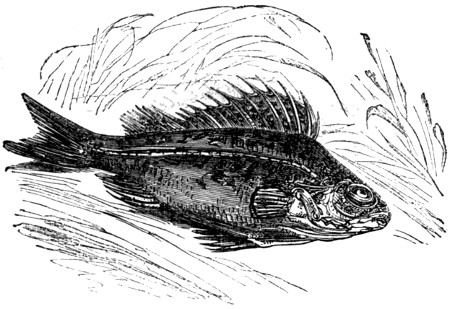
The bream, at full growth, is a large and stately fish, and is oftentimes as fat as a hog. He is principally found in large ponds or in lakes, and in still rivers where the waters are deep and shaded by weeds; and may be taken throughout the latter part of summer and autumn.
The baits are many: paste made of white bread and honey, gentles, wasp-grubs, and brandlings; but much the best general bait is the tail end of a lob-worm. Use lob-worms, cut in pieces, brewers’ grains, or greaves, as groundbaits in the places where you intend to angle. Use a gut line, quill float, and hook the same as for perch. Sound the bottom, which should be eight or ten feet deep, and stand at least two yards from the bank from which you fish; the bait should just touch or trip along the bottom.
The flounder is a well-known flat-fish very common about our own coasts; and should any of our young friends be at the seaside, it is well that they should know how to take flounder. They are also found in rivers, at some distance from the sea. They may be taken in May, July, and August,—not in June, as that is their spawning[112] time. The best baits are red-worms and marsh-worms, on a No. 6 hook; and you should fish at the bottom.

THE FLOUNDER.
Eels are denizens of the mud; but they are fond of clean not foul mud, and ought never to be sought after in filthy places. There are many modes of taking them: by rod and line, by dead line, by sniggling, by bobbing, and by spearing. When a rod is used, you should put a brandling or red-worm on a No. 8 hook; the bait should touch the bottom; and, when you have a “bite,” the float should be drawn quite under water before you strike.
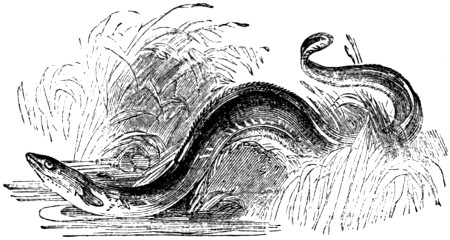
The dead line is a line of whipcord, with hooks about two feet asunder, baited with lob-worms or small fish, and having a weight at the end. You should also have a bank-runner—a reel on a pin or stake stuck into the ground on the edge of the bank; the line and baits should be thrown in, and left for the eels to amuse themselves with,—looked to, and drawn up at your leisure.
In sniggling, a lob-worm is put upon a stout worsted needle; the line is on a winder; and the fish will be found near flood-gates, wharfings, bridges, piles, holes in the banks of rivers, ponds, and canals. The bait should be put into the lurking-places of the eel, by means of a stick with a forked head; and when the bait is taken, which will easily be known by the pull of the string, strike.
Bobbing for eels.—In this process long red-worms are strung on threads of worsted, until a bunch as large as the two fists is formed around a piece of lead. The whole is sunk to the bottom, or nearly so, then raised a little, then depressed, so as to induce the eels to bite. When this occurs, heave up without hurry. The number of eels taken in this way is often prodigious.
In spearing eels, the spearer usually goes into the mud in a pair of pants or mud pattens, pieces of square board fastened into the heel to prevent sinking. He takes an eel-spear in his hand, something like Neptune’s trident, and progs the mud all over, and the eels are caught between the forked blades of the spear. Great numbers of eels are taken in this way on the muddy ooze of salt or fresh-water rivers.
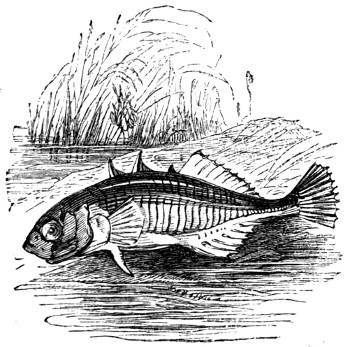
The stickleback is a dark-coloured little fish, found in ditches and ponds. They are best caught with a small hand-net, and are occasionally used as bait for perch. The minnow is very beautiful in appearance, being of a rose colour underneath, and may be taken with a worm and a No. 13 hook at any time of day; but more easily with a small hand-net. They are commonly found in little rivulets, rills, or small sandy streams, and are highly prized by the angler as baits for many kinds of fish.
The barbel is a bold, sturdy, handsome-looking fish, although its flesh is coarse to the eater; but he is a rare fellow for sport, and often affords great amusement as well as chagrin to the angler by his bolting off with the line by a “coup de barbel,” and breaking it with his tail. Izaak Walton says, that barbel “flock together like sheep.”
Barbel are to be found in the strongest runs of water. In summer, they love the shallowest and sharpest streams, and will lurk under weeds, and will root and dig in the sand like pigs. Sometimes he retires to deep and swift bridges, or to flood-gates or weirs, and will rest himself against piles or hollow places. In winter he gets into deep water.
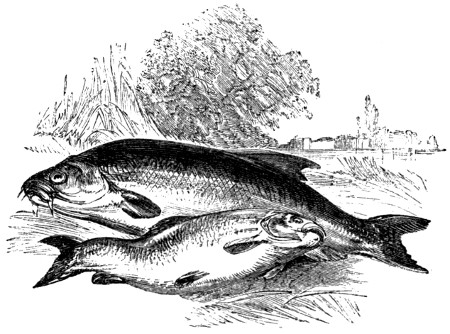
BARBEL WITH GOLD CARP.
In fishing for barbel in large streams, you should go out in a boat provided with greaves, gentles, and red-worms; and, before you begin fishing, you should throw in plenty of groundbait—such as soaked greaves, bran and clay made into small balls, maggots, or lob-worms. They may be angled for with a stout rod, strong running line, cork float, and No. 7 or 8 hook, baited with marshworms or greaves. The barbel being a sharp biter, strike the moment you feel a nibble. He may be caught from May to October all day, but best in the morning and evening. After he is struck he will frequently make a run, but you must play him gently; keep him clear of weeds, and try to get him into deep water; and when you have him, mind he does not bounce out of your hand and drop down the stream again.
Fishing with a fly may be practised either with the natural fly, usually called “dipping,” or with the artificial fly; in which latter case the sport is called “fly-fishing,” or sometimes “whipping.” Dipping requires a moderately long and stiff rod, of about twelve or thirteen feet. The line should not be above a yard in length from the end of the rod, but the reel should contain sufficient to play the fish if necessary. When the river is much overhung with bushes, it is a good plan to wind the line round the end of the top joint, leaving only a few inches dependent; and then, having thrust the rod through some small opening in the bushes, gradually to unwind the line by turning the rod in the hand, so as to drop the fly on the water in the most gentle manner. In this insidious way large fish are often taken with any of the flies which are in season and found at the time on the banks of the river which is fished, especially if they are only just coming out, and the fish are not yet satiated with them. It is quite needless to give a list of the natural flies which are likely to prove serviceable to the fisherman, because he has only to look for those which at the time are tempting the fish, and then to endeavour to find them on the banks, and at once to try their powers. In the case of chub, however, he will find grasshoppers and humble-bees more useful than any of the flies, and yet they are neither of them often seen upon the waters, and may be considered exceptional cases. The fish which will generally take the natural fly are grayling, trout, chub, and dace.
For this delightful sport, which captivates alike the sexagenarian and the schoolboy, rods and tackle of the finest quality are required. It is true, that a good workman will take fish even with a willow wand, but still he would do far better with a rod turned out by a good maker; and few young hands will be able to do much without a well-finished specimen of the art of rod-making. The rod should be strong, yet fine, and either of dressed silk, or silk and hair mixed. The lower portion, called the foot-length, is of gut, generally occupying about five or six feet of it, to which one, two, or three flies are attached, the one at the end being called a stretcher, and the others droppers.
The fly-fisher should be able to make his own flies, as there is a great advantage in being able to “do for oneself;” and it may sometimes happen that he may be out of a particular fly when far away from “fly shops.”
Feathers of various kinds; hairs of various kinds; very fine sewing silk; gold and silver twist. Of the first, the young fly-fisher must[116] provide himself with the feathers of the duck, cock, grouse, snipe, bittern, woodcock, partridge, landrail, starling, jay, golden plover, and peacock. Of the second, the fur from Tommy’s tail, from the skins of squirrels, moles, and water rats, camel’s hair, hare’s ear, fur from its neck, the yellow fur from the neck of the martin, mohairs of different shades, camlets, black horsehair, hog’s down dyed various colours. And with these, gimps, silks, and tinsel, a good pair of pliers, and a pair of fine-pointed scissors.
In making your fly, imitate as nearly as possible the natural fly you wish to represent; to do this properly, it will be well to dissect a natural fly, and to imitate its several parts, and then to reconstruct it with a reference to the whole. With a hook of the proper size, and a feather of the right colour, the fly-maker may now commence. His feather must be stripped down on each side, leaving just so much as will do for the wings at the fine end; a piece of fine gut, free from imperfection, and properly tested as to its strength; dubbing or hackle; and a piece of fine silk well waxed with shoemaker’s wax.
Let the essay be now made. Hold your hook in the left hand, wrap the silk round the bare hook two or three times, and put the finest end of the gut on the under side of the hook. If you are working for a tackle fly, begin at the band and work up to the head, after turning three or four times round the hook and gut; fasten on the tackle, and continue the winding of the silk until it reaches the end of the hook, then turn it back two or three times, to form the head. The dubbing must now be twisted round the silk, and wrapped upon the hook for nearly half the proposed length of the body; fasten it there by a single loop, that both hands may be at liberty to manage the tackle.
When sufficient of the feather is wound upon the hook, the remainder should be held under the thumb of the left hand, and the entangled fibres picked out with a needle. The silk and dubbing must now be twisted over the end of the tackle, until the body of the fly is of the length required, and then fastened. If gold or silver twist is used, the twist should be fastened to the lower end of the body before the dubbing is applied to the silk.
To make a winged fly, the same method must be observed in tying on the hook; then take the feather which is to form the wings, and place it even on the upper side of the shank, with the roots pointing towards the bend of the hook; fasten the feathers, by winding the silk over it, and cut the root end close with a pair of scissors, and divide the wings as equally as possible with a needle, passing the silk two or three times between them, to make them stand in a proper position; bring the silk down the shank of the hook the proposed length of the body, and fasten it, then apply the dubbing to the silk, and twist it towards the wings; fasten in the hackle for legs, and wind it neatly under the wings, so as to hide the ends of the cut fibres: the silk must be fastened above the wings—be careful of this.
It would be impossible for us, nor would it be very useful to the young fly-fisher, to give him directions for making every kind of fly. We may, however, throw out a few hints concerning the making of most of the flies in common use, and of the materials employed.
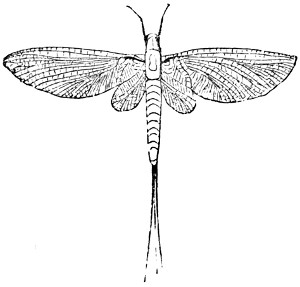
1. The green drake or May fly.—This is one of the most killing trout flies, but it is seldom in the water for a longer period than three weeks. The time of its appearance varies in different rivers, but it generally rises about the last week in May, and continues for about three weeks. The wings are made of the light feathers of a grey drake, dyed a pale yellow-green colour, by being boiled for a minute or two in a decoction of green vitriol. The body is formed of amber-coloured mohair or silk ribbon, with dark green silk; the head of peacock’s harl, and the tail of three long hairs taken from a sable muff.
2. The black gnat.—The body of this fly is made of black ostrich harl, and the wings of a pale starling’s feather; it must be dressed short and thick. It is in use from the end of April till the end of May, and is a good killer when the water is low.
3. Hare’s ear.—The wings are made from the feather of a starling’s wing, the body from the fur of the hare’s ear, the legs of a ginger cock’s hackle.
4. Cock tail.—Wings of the light feather from a snipe’s wing, the body of yellow mohair.
5. Whirling dun.—Wings of a snipe’s feather, body of blue fur wrapped with yellow silk, and a blue cock’s hackle for legs; the tail of two hairs from a coloured muff.
6. Grey drake.—Wings of a dark grey feather of the mallard, the body of white silk, striped with dark silk, the head of a peacock’s harl, and the tail of three hairs from a sable muff.
7. Cowdung fly.—The wings of the feather of a landrail, the body of yellow camlet, mixed with a little brown bear-fur, and a ginger hackle for legs; the wings should be dressed flat.
8. Bee fly.—The body of thread of various colours, arranged in stripes of the following order:—black, white, light yellow, white, black, white; the legs of a black hackle; the wings from the feathers of a blue pigeon’s wing: the body must be dressed thick.
9. Red palmer.—The body of dark-red mohair, ribbed with gold twist, and wrapped with a red cock’s hackle.
10. Peacock palmer.—The body of a peacock’s harl, wrapped with a dusky-red cock’s hackle.
11. Kingdom fly.—Wings of a woodcock’s feather, the body of white silk, striped with green, and the legs of a red cock’s hackle.
12. White gnat.—The wings of a small white feather, the body of white silk, and the legs of a red cock’s hackle.
13. Blue dun.—The wings of a starling’s feather, the body of blue fur from a water rat, mixed with a little lemon-colour mohair; the tail is forked, and should be made of two fibres from the feather used for the wing.
14. Red ant.—The wings of a light starling’s feather, the body of peacock’s harl made thick at the tail, and a ginger hackle for legs.
15. Gold spinner.—Wings of a starling’s feather, body of orange silk, ribbed with gold twist, and the legs of a red hackle.
16. Great white moth.—Wings of a feather from the wing of a white owl, the body of white cotton, and a white cock’s hackle wrapped round the body.
17. Governor.—Wings of a woodcock’s feather, the body of a peacock’s harl, tied with orange silk.
18. March brown.—Wings of the dark mottled feather from the tail of a partridge, the body of fur from a hare’s ear, well mixed with a little yellow worsted, and a grizzled cock’s hackle for legs.
19. Stone fly.—Wings of a dusky-blue cock’s hackle, or a mottled feather from a hen pheasant, the body of dark-brown and yellow camlet mixed, and a grizzled hackle for legs; the wings should be flat.
20. Black silver palmer.—The body of black ostrich harl, ribbed with silver twist, and wrapped with black cock’s hackle.
21. Willow fly.—The wings of dark grizzled cock’s hackle, the body of blue squirrel’s fur, mixed with yellow mohair.
22. Yellow palmer.—The wings of white hackle, dyed yellow, the body of yellow silk.
23. Black palmer.—The body of black ostrich’s harl, wrapped with a black cock’s hackle.
24. Black palmer ribbed with gold.—The body of peacock’s harl, wrapped with a black cock’s hackle, and ribbed with gold twist.
25. Marlow Buzz or Cock-a-Boundhu.—This is one of the most killing flies known, and should never be off the line during the trout[119] season. The body of peacock’s harl, ribbed with gold twist, and a dark-red cock’s hackle over all.
26. The Grouse Hackle.—This is also a very killing fly, especially late in the evening, during June, July, and August. Body of brown fur, ribbed with gold twist, and a grouse hackle over all; hook No. 10.
The foregoing list comprises twenty-six of the most killing flies; and the following are the months in which they will be found to kill best.
February, red cowdung fly, blue dun; March, brown; April, black gnat, stone fly, gravel or spider fly, the green tail, brown, blue dun; May, green drake, grey drake, oak fly, hazel fly, little iron blue and yellow sally; June, hare’s ear, cock tail, whirling dun, marlow buzz, bee fly, kingdom fly, white gnat, blue gnat, blue dun, governor, fern fly; gold spinner; July, red ant, red spinner, yellow dun, coachman, fern fly; August, whirling blue, red spinner, pale yellow dun; September, willow fly, silver twisted blue, whirling blue.
It would of course be impossible, in a work of this description, to give a list of all the artificial flies used by experienced fishermen, but the above are a few of the most killing. For bleak, dace, roach, chub, &c. a piece of a maggot, or a small piece of white leather, should be placed at the end of the hook.
Having thus given the “order of flies,” natural and artificial, we may imagine the young fly-fisher, with rod in hand, proportionate to his strength and the breadth of the stream, ready to throw his fly; but let his rod and running tackle be in good order, and the idea of the coachman’s whip out of his mind. He is not to flog the water, but to tickle it. The novice should teach himself to handle the line, by beginning with it alone, (i. e. without flies or hook,) trying a short length first, and lengthening it gradually. In using the rod, it should be drawn vigorously back, though without a jerk, and thrown forward again when the line has reached its full extent behind. Take care in doing this, that the fly be not whipped off. When tolerably expert, put on one fly, and try awhile with that, adopting two or three when able to use them properly.
In fly-fishing keep as far from the water as possible, especially if fishing for trout. Let only the flies touch the water, and keep moving them gently and slowly on the surface. When a fish rises, let not a moment elapse before you strike, and do it sharply.
When you have two flies on your line, you must try to throw your line so that the bottom fly shall reach the water first; it must be done always as lightly as possible, so that it may resemble a natural fly settling upon the water. You must suffer the line to float gently down the stream, at the same time working it towards you.
The best time for angling with the fly is when there is a gentle breeze upon the water; south and west winds are to be preferred, when the water has been disturbed by heavy rains and is just resuming its natural colour, or when the day is dull and cloudy. The best[120] time, morning and evening. In cold weather the fish bite deeper, and you should then let the fly sink a little. Take care to have the wind in your back, and the sun in your face, if possible.
When you see a rise, throw your fly about half a yard above the fish’s nose, and let it fall down with the stream; watch it narrowly, and strike as the fish rises, giving him an “infinite little moment” to taste. When you have hooked, play your fish carefully, keeping up his head and running him down the stream, at the same time steering him towards you. If you see a fish rise at a natural fly, throw your bait a little before him, so that he may take it as “one of the number.”
To know what flies the fish are most likely to take, observe what natural flies are about the water, or on the grass, trees, or bushes in the vicinity of the river; and take that fly which is the most in abundance, either natural or artificial at your discretion.
Such are a few practical particulars concerning angling and fly-fishing, sufficient to enable any young angler to begin. For more abundant information we refer him to Mr. Stoddart and Mr. Stewart, for fly-fishing, Mr. Cholmondeley Pennell for pike-fishing, “Hewitt Wheatley” for grayling fishing, and Mr. Francis Francis for the various modes of bottom fishing.

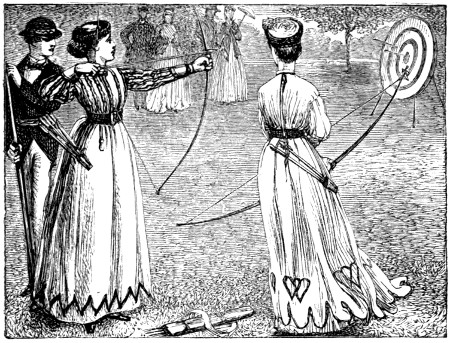
The skill of the English in archery was always very great. Our ancestors used the bow for a double purpose: in time of war, it was a far more dreadful instrument of destruction than our present soldier’s musket; while in the “piping times of peace,” it became an object of amusement. The victories the English obtained over their enemies in times of war were many, and what the world calls glorious; and they stand upon record in our history, where the young reader may peruse them with interest and advantage.

SAXON BOW AND ARROW.
The Anglo-Saxons and the Danes were certainly well acquainted with the use of the bow, which they used, not so much for war purposes,[122] as in the sports of the field. But it is well known that the Normans used the bow as a military weapon, and under their government the practice of archery was not only much improved, but generally diffused throughout the kingdom. The long-bow was an instrument of Norman introduction, and there seems good reason to believe that the arbalist, or cross-bow, was used by these sturdy invaders.
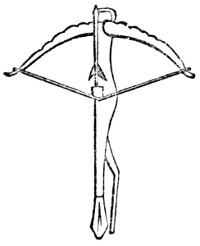
NORMAN-BOW.
The use of the English long-bow arrived at the highest perfection in the reign of Edward III.; and, notwithstanding the introduction of fire-arms, continued for a long time after to be successfully cultivated. Cressy, Poictiers, Agincourt, and many other victories, were obtained by its use; and Sir John Fortescue writes, “That mighte of the realme of Englande standyth upon her archers,”—as it will now upon our riflemen or sharpshooters, when our army shall get the right kind of gun.
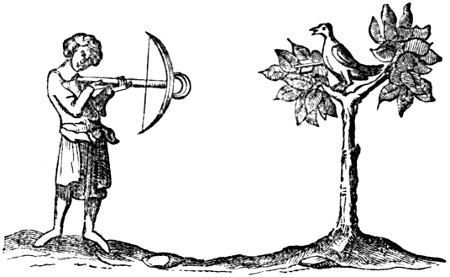
The cross-bow, or arbalist, was a popular weapon with the Etolians, and was introduced into England in the thirteenth century. The arrows shot from it were called “guorrels.” It was fastened upon a stock, and discharged by means of a catch or trigger, which probably gave rise to the lock on the modern musket. One historian informs us, that Richard the First was wounded by an arrow from a bow of this kind; and also, that the English cross-bow was used chiefly at sieges of fortified places, and on ship-board in battles upon the sea. It was, however, used in recreation, and acquired great reputation among the citizens of London, who had “butts” in various places for the practice of this kind of archery; as at Newington Butts, Brentford Butts, and other spots, which still retain the name of Butts: and in the reign of Edward IV. an act passed, which directed[123] that butts should be in every township, where the inhabitants should shoot on every feast-day, under a penalty of a halfpenny when they shall omit the exercise.

Mr. Grose informs us that an archer could shoot six arrows in the time necessary to charge and discharge a musket; and even in modern days, a practised bowman has been known to shoot twelve arrows in a minute into a circle not larger than the circumference of a man’s hat, at a distance of forty yards. Of the power of the bow, and of the distance it will carry, some remarkable anecdotes are told. Xenophon mentions an Arcadian, whose head was shot through by a Carduchian archer. Stuart mentions a random shot of a Turk, which he found to be 584 yards; and Mr. Strutt saw the Turkish ambassador shoot 480 yards in the old archery-ground in London. An old author speaks of a Turkish bow, the arrow of which was known to pierce a steel target two inches thick. In the journal of King Edward VI., it is mentioned that 100 archers of the king’s guard shot at an inch board, and that some of the arrows passed through this, and into another board behind it, although the wood was extremely solid and firm. William de Brensia relates that a Welshman having directed an arrow at a horse-soldier of his, who was clad in armour, and had his leathern coat under it, the arrow, beside piercing the man through the hip, struck also through the saddle, and mortally wounded the horse on which he sat. Another Welsh soldier having shot an arrow at one of his horsemen, who was covered with strong armour, the shaft penetrated through his thigh, and fixed in the saddle; but what is most remarkable is, that as the horseman drew his bridle aside, in order to turn round, he received another arrow in the opposite thigh, which passing through it, he was firmly fixed to the saddle on both sides. Mr. Barrington, in the “Archæologiæ,” relates a tradition that one Leigh, an attorney (it must have been a barrister), shot an arrow a mile in three flights; and Carew, speaking[124] of the Cornish archers two centuries back, says that the butts for long shooting were placed 480 yards apart. Such, my good friends, are the feats you may emulate with the bow.
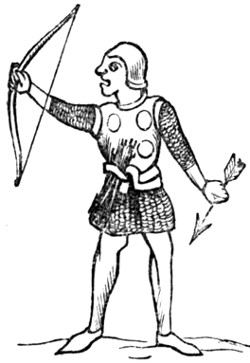
NORMAN BOWMAN EQUIPPED FOR BATTLE.
The length of the bow varied, but was usually the height of the bearer, as the Act of Edward IV. commands every man to have a bow his own height. The arrows were of different weights and sizes; the lighter sort, for long ranges, about two feet three inches; while the heavy were a cloth yard in length. The heads had various shapes, among which the broad arrow extended in width to nearly four inches to the extremity of the wings. Of these, 24 in a sheaf were put into a quiver, and, in action, about 12 in the girdle. They were trimmed with three goose-quill feathers each, and when the archers shot in volley, the quantity of arrows in the air was compared by Froissart to a fall of snow. The farthest range of arrows was estimated at eleven score yards. The archers, in order of battle, generally carried, beside the bow, axe, and target, a stake pointed at both ends. They formed in open ranks, in files eight deep. When on the point of engaging, they advanced a few paces beyond the intended line, and fixed their stakes, inclined towards the enemy, in the ground. They then stepped backward, and from behind these chevaux-de-frise dealt forth their destructive arrows; and when the enemy were thrown into confusion, they sallied, and with small battle-axes and swords completed the defeat.
The marks usually shot at by the archers for pastime were “butts,” “prickes,” and “rovers.” The “butt” was a level mark, made by placing a target on a slope of a hill or bank of earth, and required a strong arrow. The “pricke” was a “mark of compass,” but always of one distance, and had some emblem on a pole for shooting at; and to this mark strong swift arrows of one flight, with a middling size feather, were best suited. The “rover” was a mark of uncertain length, and often an arrow shot forth from[125] a bow. Other marks were used, as the standard, the target, hazel-wands, rose-garlands, and the popinjay, which was an artificial parrot or peacock, or sometimes the common cock, set upon a post or pole, as seen in the engraving.
Roger Ascham, who was well versed in the subject of archery, says that it was necessary for the archer to have a bracer, or close sleeve, to lace upon the left arm; and to this was added a shooting-glove for the protection of the fingers. The bow was to be made of elm, ash, or yew; the bow-string to be composed of good hemp, flax, or silk; the arrows were to be made of oak, hornbeam, or birch. The feathers from a goose, and especially of a grey goose, he thought preferable to any for the pluming of an arrow.
Ascham says: “First take care of a graceful attitude.” The archer should stand fairly and upright with his body, his left foot at a convenient distance from his right, holding the bow by its middle, with his left arm stretched out, and with the first three fingers and the thumb of his right hand on the lower part of the arrow affixed to the string of the bow. The notch of the arrow to rest between the fore-finger and the middle finger of the right hand. The arrow, in drawing the bow, was to be elevated to the right ear. The shaft of the arrow below the feathers to be rested on the knuckle of the fore-finger of the left hand. The arrow was to be drawn to the head, and not held too long in that situation, but neatly and smartly discharged. Among the requisites necessary to constitute a good archer are, a clear sight steadily directed to the mark,—a proper judgment of distances, to determine the length of the ground. He ought also to know how to take advantage of a side-wind, and to be well acquainted with what compass his arrows would take in their flight. “Courage,” he says also, “is an indispensable requisite; as he who shoots with the least trepidation is sure to shoot badly.”
Notwithstanding the great advantages of archery in ancient days, somehow or other it began to decline even at the time of its zenith; so that, from time to time, acts of parliament were made to compel the citizens of London, and other towns, to practise it. Some of our monarchs made sumptuous archery entertainments. In the reign of Queen Elizabeth, a grand shooting-match was held in London of all the archers in the surrounding districts; and these meeting at the appointed time, with their different companies, proceeded in a pompous march from Merchant Tailors’ Hall, numbering 3,000 archers, sumptuously apparelled, every man having a long-bow and four arrows; 940 of them had gold chains about their necks. This splendid company was attended by 4,000 whifflers and bellmen. The queen met[126] them in Smithfield, and presided at their sports. But still the art continued to decline, and, with the increase of other warlike weapons, became at last almost extinct. Within these few years, however, it has again become a somewhat favourite exercise, near London, and in various parts of the country. In Scotland, the “Royal Company of Archers”—the Queen’s body-guard for Scotland—comprises many of the Scottish nobility, and King George IV. recognised it. It now comprises about 500 members, who meet weekly, and at certain seasons contend for several annual prizes.
Convinced as we are that the practice of archery possesses, in point of health, all the advantages of field sports, without their cruelty to animals, and demoralizing oppression to our fellow-creatures, we strongly recommend it to our juvenile friends. It is an exercise adapted to every age and every degree of strength; and especially adapted to young ladies, whose sedentary occupations,—rendered still more injurious by the pestiferous Berlin wool,—disposes them to disease and consumption. I do not wish to sing the praises of the art to their full extent, but I wish to see it universally cultivated, and should hail with pleasure the time when it can be again said, as with Statius, “Pudor est nescere sagittas.”
Proceeding now to the modern practice of the art, we must first begin with
The Bow may be made of the yew-tree, laburnum, thorn, or acacia, and is generally formed of two pieces of wood joined together, the back piece being of a different wood to the front, and the grain reversed. It is of great importance to secure a good bow. We would not, therefore, advise the young archer to make one, but to buy one at a good archery shop, where they may be had at all prices. Upon making a purchase, he should examine the bow well, to observe whether it be well set in all its parts, of an elegant cut or shape, and free from flaws, knots, or cracks. He should look well at the ends, and to those points on which the bow-string is fixed, which ought to be tipped with horn. The proper length of a bow for a youth is about five feet. The flat or outward part of a bow is called its back, and the inward part its belly; and in stringing it the young archer should be particularly careful to keep the belly inwards, or the bow will break.
The string of the bow should be made of hemp, and whipped with sewing silk at that part of it which receives the arrow, marked C in the annexed plan. The thickness of the string should depend upon the length of the bow, and should never be too thin for its[127] powers, as the snapping of a string sometimes causes the snapping of the bow. The young archer should never use a string in the least out of order, and should avoid cat-gut strings especially. A bow five feet long, when bent, should have a string about five inches from the centre. This will be a guide in stringing the bow. The young archer should take great pride in the care of his bow, especially of the string, and look carefully, after every day’s shooting, at the “whipping” of the string, and at the wearing points, repairing the least defect. He ought also to place his bow in an oil-skin case, lined with baize; and when put away for the season it should be well rubbed with oil, and polished. He should also have always two or three spare strings in readiness, in case the one in use may fly.
The young archer must be very careful in performing this feat, or he will fail in the attempt; to do so safely, he must take the bow in his right hand by the handle, the flat part towards him; then let his arm rest against his side, then put the lower end of the bow against the inside of the right foot, bring his left foot forward, and place the centre of the left wrist on the upper level of the bow below the loop of the string, the fore-finger knuckle on one edge of the bow, and the top of the thumb upon the other; then up with the bow and loop it. This feat, however, can be best learned by seeing another expert person perform it. In unstringing the bow, the short horn should be placed on the ground against the right foot, the middle of the bow grasped in the right hand, and the left wrist placed on the upper horn, so that the fore-finger may unloop the string when the bow is brought down, as in the manner of stringing it.

Arrows are generally made of some white wood, such as ash, deal, or the wood of the orbele poplar, and are sometimes varnished. They are both blunt and sharp. The sharp ones are for target shooting, the blunt ones principally for roving; they also vary as regards length, some being long, and some short. In purchasing them, the principal thing to be attended to is, that they are perfectly straight, well made, and that the plumes are securely fitted. There should be three on each arrow; one, which is of a darker colour than the rest, is called the cock plume, and in shooting should be placed uppermost. The length and weight of the arrows should be in proportion to the size of the bow. The[128] nicks of arrows should be cased with horn, and they should fit the string exactly.
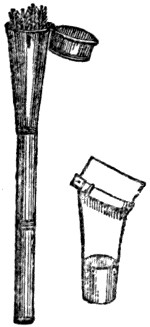
The quiver is used to contain the arrows, and is usually made of wood, or tin, or leather, those made of the latter material being the most serviceable and convenient to wear. It should be long enough to contain the arrows up to the feather, without bruising or crushing the plumes, which ought always to be kept perfectly straight and unruffled. The quiver in shooting is not carried, but the arrows are placed in a pouch attached to the belt.
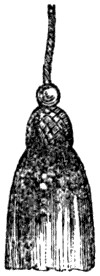
TASSEL.
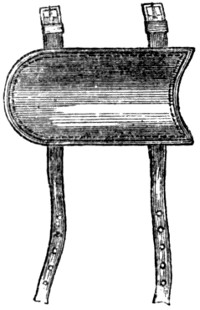
BRACE.
The Tassel is usually made of green worsted, and is used by the archer for the purpose of cleansing the arrow from dirt after being taken from the ground. It is usually suspended on the left side of the archer.
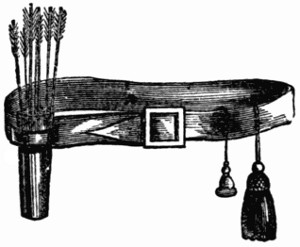
THE BELT.
The Brace is of leather, and is buckled on the arm to save it from being hurt by the string upon the discharge of the arrow. It ought[129] to be very smooth on its surface, so as to offer no impediment to the bow-string.
The Belt is made of leather, and is buckled round the waist. It has fastened to it a pouch, for the temporary reception of the arrows in shooting.
The Shooting Glove is made of cow-hide, or horse ball leather. It has places or stalls for three fingers only, with a wrist strap to fasten it on. Its use is to protect the fingers from the action of the string, and in selecting it the young archer should be careful that the finger stalls are neither too long nor too short for the hand.
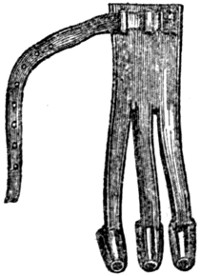
THE GLOVE.
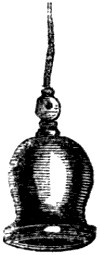
THE GREASE POT.
The Grease Box hangs usually by the side of the tassel, and contains a small portion of grease composed of suet and bees-wax well compounded. This is used for rubbing on the fingers of the shooting glove, and is indispensable to the archer.
Targets are made with plaited straw bands, wound round a centre, and sewn together. Over this body is placed a facing of canvass, the ground of which is painted white; upon the white are painted four circles, and a gold centre called the bull’s eye. The first circle close to the eye is red; the next white, called the inner white; the third black; and the fourth white, called the outer white; while the outside verge, called the petticoat of the target, is painted green.
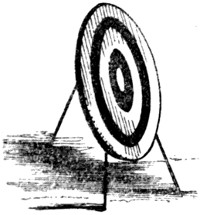
A certain value in shooting is given to each circle of the target, which is thus computed: Outer white 1; Black 3; Inner white 5; Red 7, and the Gold Eye 9.
There are usually two targets in an archery field, placed at certain distances from each other, which shortens the labour of walking; for[130] if one target only be used, a great deal of time is lost in going from the shooting mark to the target to fetch the arrows, and in returning to the spot again.
The prizes usually shot for in archery matches are gold and silver medals, silver cups, silver arrows, silver gilt bugles, prize bows and arrows. There are generally two prizes given; the first for the shots nearest the gold centre, the second for the number of shots put into the target, according to their value.
A person is usually appointed to register the shots at the targets, who has a card similar to the form given below, by which he takes an account of the hits as they are made.
| NAMES | GOLD | RED | INNER WHITE |
BLACK | OUTER WHITE |
TOTAL | VALUE |
|---|---|---|---|---|---|---|---|
| Smith | 2 | 3 | 7 | 3 | 11 | 26 | 100 |
| Jones | 1 | 6 | 5 | 8 | 7 | 27 | 107 |
| Brown | 3 | 4 | 9 | 7 | 18 | 41 | 139 |
The markings are usually made by the marker with a pin, holes being less liable to obliteration than pencil marks.
Are usually made of pieces of turf piled one upon another, and laid one upon the other in the following shape. They are usually about six feet high and four feet broad at the face, upon which a circular piece of thin white pasteboard, about six inches in diameter, is affixed with pegs. Butts are generally placed in the field in sets of four, so as not to stand in the way of each other. And when shot at, the arrows placed in the pasteboard mark are alone reckoned, and those who here place the greatest number of shots are the winners of the prize.
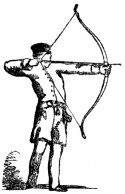
POSITION IN SHOOTING.
The ancient directions for drawing the bow, or rather the arrow, have been already given. The archer having placed himself opposite to the target, with his face a little inclined to the right, should swing himself slightly round, so that his eye and the target are in an exact line. He should stand quite upright, his left foot slightly in advance. Holding the bow horizontally in his left hand, he should draw an arrow from his pouch and carry it under the string and over the left side of the bow. The fore-finger of the left hand now holds the arrow secure on the wooden part of the bow at its centre, while the right hand fixes the nick of the arrow on the string, where it is held fast between the first and second fingers, the cock feather being uppermost. The fore-finger of the left hand may now be removed from[131] the arrow, and the centre of the bow grasped tightly. The bow is now raised gradually by the left hand, at the same time that the string is pulled by the right; and when the arrow is drawn about two-thirds of its length, the neck of it should be brought close to the right ear and the aim should be taken. The aim should be taken quickly, and the string loosened freely from the fingers with a peculiar touch, which no books can teach, and which nothing but experience and skill can give. In long shots the right hand must be lowered, and the arrow sent so as to form a greater curve in its flight. The archer should look at his mark, not at his shaft, and when he has shot should retreat to the leftward, and take his position behind the person with whom he is shooting.
This is principally engaged in for the purpose of ascertaining the greatest distance to which the arrows can be sent by the respective shooters. It requires no skill in aiming, but much care in drawing the arrow, as nothing is more likely to fracture the bow than flight shooting. The archer who sends his arrows to the greatest distance is the winner.
In clout shooting the target is only a small piece of white pasteboard attached to a stick about five feet from the ground, and placed at a distance of from 120 to 150 yards. In it seven makes the game, and all arrows that fall within two bows’ length of the foot of the stick are marked in counting.
So called from the shooters roving from place to place, over field, heath, moor, common, finding their marks in trees, posts, bushes, &c. The distances constantly varying, give to young archers a great deal of practice; besides which, the variety of the scenery, and the various incidents that occur in a day’s roving, are often highly interesting and exciting. By roving the eye gets a habit of measuring distances, and the hand and arm strength for the bow. Blunt-headed arrows are the best for roving, of which about a dozen ought to be carried by each archer. Sharp arrows would imbed themselves too deeply in trees to be easily extracted. In a roving party, arrows that reach within five bows’ length of the mark tell, and those which are nearest cut the others out. Each archer measures with his own bow. The number of the game is often nine, but generally twelve.
1. In commencing archery never begin with a stiff bow, but select one adapted to your strength, and change this for a stronger from time to time.
2. Never shoot with another person’s bow.
3. Never put an arrow in the string when any one stands between you and the target, or you may shoot out an eye.
4. Never talk, jibe, or jest at the time of shooting.
5. Always study to take a graceful attitude in shooting, or in moving about the field.
6. Never draw a bow near another person; as, should it snap, the danger will be greater to him than yourself.
7. Never let your bow-string get untwisted or ravelled by neglect.
8. Never exhibit impatience at the tardy efforts of your compeers, or chagrin at your own failures.
9. Never shoot alone if you can help it, as it leads to negligence and indifference.
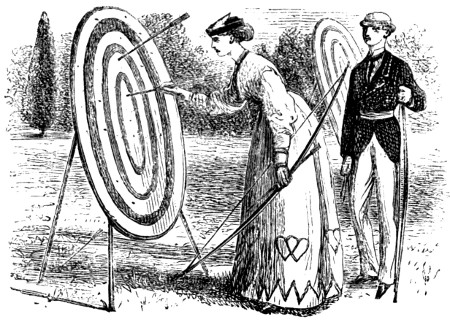
We will first give briefly some of the reasons why we have determined to mention this branch of the manly exercises. Firstly, we do so because we have a great personal esteem for the art, though none can be more sternly opposed to its abuse. Secondly, because it affords one of the finest exercises in the world, employing every limb and every muscle in the body, giving at the same time readiness of hand and quickness of eye, while it tests and improves the patience and endurance. And, thirdly, because every one likes to know how to use the weapons which Nature has given him, and will contrive to acquire the desired knowledge whenever he can find an opportunity. All Englishmen, and therefore all English boys, are proud of their natural weapon, and compare it with the knife, the loaded stick, the knuckleduster, and the pistol of other nations. The principle of fair play and justice is strongly developed in an English breast, and in nothing is the principle so thoroughly carried out as in boxing. No unfair advantage is allowed to either side, no striking upon the vital parts of the body is permitted, and the use of the foot, tooth, or nail is forbidden under the severest penalties. Even in the very prize ring, where men are trained for the express purpose of hitting each other with the utmost force of which human arms are capable, there is little harm done, and in a few days both combatants look as if nothing had happened to them. It is not so even in a wrestling county, or in some few parts of our own land where men fight like brute beasts, and use their best endeavours to maim or blind their adversaries for life. A well-known American writer has expressed, in his own humorous language, the astonishment which he felt at witnessing a short “turn up” at an English cattle-fair. The grave propriety of the affair, and the admirable order in which it was conducted, struck him with profound admiration, as contrasted with the “inglorious and inevitable Yankee clinches, followed by a general mêlée,” which in popular language is termed a “free fight,” and in which every one attacks every one else with any weapons and in any manner.
Before proceeding to our genuine English Boxing, we must just mention the French “savate,” of which we have heard so much of late. We have seen it practised and taught in the salles d’armes, and for it, as a system for boxing, we have the profoundest contempt;[134] as also for that execrable French custom of striking upwards with the knee when at close quarters—an atrocity for which we should like to see a man soundly horsewhipped on the spot.
Now, the savate simply consists in this. You make a feint, as if to strike in the usual manner, and then, instead of striking with the fist, you kick with the foot. Or, when your antagonist is pressing you sharply, you send the point of your toe into his chest, and stop him. Or, you retreat from him, suddenly turn round, and kick at him backwards—of course being quite unable to tell where the blow will alight, and possibly inflicting an injury the effects of which will be felt for life.
Those who are practised in this manœuvre will employ it with wonderful skill. They will hit you on the nose or on the forehead without the least apparent effort, and with the greatest certainty; they will fling you back from your advance with stunning force, and the effect of the lash-out is terrific. Indeed, if the object of boxing be to use all means of offence and defence, the savate is indispensable.
Having many opportunities of visiting several schools of arms, we carefully considered this system, which was then totally unknown to us; and after watching it well for some time, during our residence in Paris, we came to the conclusion that the savate is useful enough in case you are attacked by ruffianly fellows, whom you must needs maim, lest they should maim you; and that by the combined use of the savate and a stick, or even the fist, a man may knock over a couple of assailants simultaneously and effectually.
And if a Frenchman who uses the savate were opposed to an Englishman who never heard of it, the probability is that the former would win, because the latter would lay himself open to a mode of attack which he had always been taught to consider unfair and unmanly. But we do not believe that it would be of the slightest value against any one who knew that his antagonist would employ it, and think that the person attempting to use it would find himself hurled to the ground, and probably discover that his leg was violently sprained. So much for the savate.
It is not easy to teach any branch of the science of arms in a book, and boxing is perhaps as difficult to be learned from books as fencing. Still, something can be done even through the medium of ink and paper; and the reader can, at all events, learn to avoid the errors to which a total novice is subject.
The first and most important point is the position in which the boxer stands.
This is not very dissimilar to that of a left-handed fencer, except that the right arm, instead of being raised, is brought across the body, so that it defends the pit of the stomach (technically called the “mark”), and only leaves a very small portion of the chest open to a blow. The left arm is rather higher than if it held a foil, and[135] the elbow is kept well to the side. This latter point is most important, as it is impossible to hit straight from the shoulder if the elbow should project from the side.
The weight of the body rests mostly on the right leg, so that the boxer can step backwards or forwards, while still keeping his side to the adversary. If you stand opposite a good sparrer in boxing attitude, you will be surprised to find how well guarded he is, and how difficult it is to hit him, even if he neither moves nor attempts to return the blow. His left hand keeps you well away from him, and his right is ready either to stop or throw off your blow.
It will be seen from the foregoing description, as well as by reference to the illustration, that a right-handed boxer stands with his left side towards the opponent, uses his left hand for the chief part of the hitting, and reserves the right for stopping, parrying, or returning blows when at close quarters, or what is technically called a “rally.”
Practise this attitude before a glass. You will soon see if you lay yourself open, and will learn to stand in a correct position. Advance and retreat also before the glass, and so make sure that you do not expose some weak point while so doing. I met a French gentleman who had made himself really a creditable boxer, merely by practising before his mirror; and after a few days of practical work with the gloves he became quite a formidable antagonist.
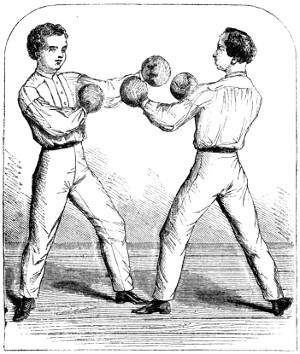
Another important point is the making up of the fist—not such a simple matter as it seems. The fingers must be clenched tightly, and the thumb doubled down outside them, so that when presented towards your antagonist he can see no part of it projecting over the fingers. This can also be practised at the glass. If the hand be rightly held, it will be seen that the knuckles form a kind of arch, of which the middle knuckle is the keystone. It is with this knuckle that you strike; and be sure to clench the hand with all your power[137] as you deliver the stroke; otherwise you will run a sad risk of dislocating either a finger or a thumb.
The position of the head is of no small importance. On no account bear forwards, as is the way of muffs, but keep it lightly thrown back, and never take your eye off that of your opponent. Greenhorns always lower the head, and rush at their antagonist with their arms flying about like the sails of a windmill; and the natural consequence is, that their opponent quickly steps aside, lets them pass, and knocks them neatly over by a blow on the temple, which they cannot possibly see or guard.
Having got our attitude and doubled our fist, we now learn to strike. Deliver your blow straight and from the shoulder, not merely with the arm. Put all your body into the stroke, and aid it with the spring of the right foot against the ground. Thus you add to the blow the force of a kick, and the stroke comes with such terrific force that I have seen a tall man lifted fairly off the ground and deposited on his back by a straight shoulder-hit, even though the two were merely sparring with the gloves.
Never draw back your hand before you strike, as that tells your opponent what you are contemplating. Your stroke should flash out like the lightning, without warning and straight to the mark. You cannot strike too rapidly, and you cannot recover yourself too quickly. Practise this repeatedly before a glass, and note the length of your reach, for in a knowledge of distance lies half the art of boxing. As a general rule, if you can get your left toe on a level with your antagonist’s heel, you have your proper distance. This rule, however, is necessarily variable, as in the case of the contest to which allusion has just been made, where one party could reach a full foot beyond the other, and had, in consequence, the advantage of twelve inches of space at his disposal.
Now that we have practised the left hand and arm, let us turn to the right. Except when striking, you need not trouble yourself to close the fist very tightly, but may let the hand lie in an easy and unconstrained position across the chest, ready for use in any direction that may be required.
The chief use of the right hand and arm are for parrying and stopping, which are thus achieved:—
If your opponent delivers a blow at the face or upper part of the chest, and you find yourself in a good position, do not retreat from it, but fling your right arm sharply outwards and upwards, catching the opponent’s arm by the wrist, and throwing it out of the direction in which it was aimed. The effect of the parry is very powerful, as it mostly lays open the antagonist’s head, and gives opportunity for a smart return blow with the left hand; it is then near the opponent’s head, and has only a short distance to traverse. This return blow is technically called the “counter,” and is usually very effective, as it takes effect just at the moment when the antagonist is expecting[138] his own blow to strike, and turns the tables on him after a rather discouraging fashion.
Practise this also before the glass, parrying an imaginary blow from the opponent, and simultaneously shooting your own left hand against the spot where your antagonist’s head ought to be. I have often found that a quick double blow when countering is very embarrassing, and gives an opportunity of stepping in and planting your right hand after your left with enormous effect.
Stopping is performed in another manner, and must often be used where the parry is impracticable. For example, if your antagonist strikes at the body the parry cannot be accomplished, and you must either get away, stop, or take the blow in hopes of retaliation. In stopping you receive the blow on your arm, and thereby break its force, while, unless your opponent is possessed of herculean strength, the arm scarcely feels the stroke, yielding before the assault and acting like the cotton bales that have saved many a ship from the enemy’s cannon.
If you are fortunate enough to find a good boxer, get him to give you a few lessons in the practical department of the art, and in all cases be careful to keep your temper. I know that few things are more annoying than when you have made a telling plan of attack, and are just about to begin its execution, to be checked by a short dab on the nose, which makes your eyes water and the lids blink, and forces you to act on the defensive for the next few minutes, while the tears are streaming down your cheeks, and you cannot use a handkerchief by reason of the gloves.
Remember that there are two golden rules for a boxer, namely, hit straight and keep your temper. Fail in either of these requisites, and you will probably come off second best; fail in both, and you will certainly do so. Listen to an account of a battle where strength and weight and anger were overmatched by skill and coolness:—“As the assailant rushed in he ran a prominent feature of his face against a fist which was travelling in another direction, and immediately after struck the knuckles of the young man’s other fist a severe blow with the part of his person known as the epigastrium to one branch of science, and the bread-basket to another. This second round closed the battle.”
So we say again, keep your temper and hit straight. You see a circular blow takes more time to deliver than a straight one, and if your opponent swings his arm round at you, while you dart out your own fist at him, your blow will have taken effect long before his clumsy circumgyratory attempt has completed its journey.
Let me here offer another piece of advice. Do not buy cheap gloves. You may get them at a saving of half-a-crown or so, but you will soon wish that you had expended the money in obtaining a better pair. Gloves require the best horsehair, arranged after a peculiar fashion, in order to give them the mixed softness and[139] elasticity which they require. Inferior gloves soon become hard and knotty, the stuffing gets thin in some places, especially just in those very parts where it is most required. The consequence is, that the gloves become practically useless, and the blows are nearly as severe as if struck with the bare hand.
Remember that, although we strongly approve of boxing, it is not to be understood that we want every one to be fighting. We very much approve of fencing and single-stick, but we certainly have no wish that every one who learns to use the foil or the single-stick in mimic combat should want to try his rapier or his broadsword in deadly fight.
As a mere exercise it stands supreme; but it is even something beyond an exercise. It shows that superior strength and height and weight are powerless before superior skill, and that a small boy who knows how to box will certainly conquer a big one who is ignorant of the art. We say again, we do not recommend fighting; but still it is good to know how to stand up in one’s own defence, and we heartily wish that when we went to school some kind friend had taught us the rudiments of the art.
The brutal bully of a school never holds his own when he meets with an antagonist who is skilful in the use of his hands, and is forced to confess that his brute strength and cruel nature are useless in such a contest. We once saw a school bully get his deserts in a charming manner. He had fallen upon (of course) a much smaller boy, and was chasing him down a passage between a double row of forms. Suddenly his victim turned round, and delivered a right-and-left blow on the chin of his tormentor, astonishing him in no slight degree. The bully pressed on, thinking to annihilate his impertinent antagonist, but could not do so on account of the narrowness of the passage. As he pressed forward the bold little fellow retreated backwards, step by step, popping in his blows sharp and quick, and stepping back just as those of his persecutor were delivered. The bully never guarded a single blow or succeeded in hitting one, and by the time that they had made their way through the defile he was obliged to confess himself beaten, and was deposed for ever from the despotic throne which he had so long disgraced.
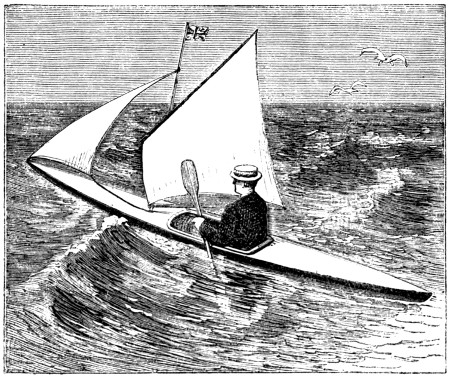
Despite the assertion of even so great an authority as Mr. Macgregor, whose name has now become a household word, canoeing is an amusement that must necessarily involve a considerable amount of danger, and ought to be indulged in by no one who has not, according to the Eton phrase, passed in swimming. Whether or not it is a very comfortable means of locomotion is purely a matter of personal feeling; but in face of the fact that the Canoe Club now numbers upwards of a hundred members, and that the boat-builders have had extensive orders for canoes, it is only fair to suppose that those who venture enjoy the new mode of locomotion. There is one circumstance that will, no doubt, obtain for canoes great favour, especially with young people, and that is, their cheapness. Messrs. Searle at Lambeth, Simmons at Putney, or Wheeler at Richmond, will build a good stout travelling canoe, after the fashion of the Rob Roy, for 15l.; which price includes mast, sails, apron, paddles, and all necessaries. Any respectable boatbuilder would no doubt do the same, when he is once provided with the necessary instructions, which, I need scarcely add, it is essential should be carried out to the letter, for the slightest deviation from the recognised standard might cause the most disagreeable results. The following points are the most important.
In having a canoe built, it is a matter of considerable moment, that in certain portions of its framework it should be constructed for and peculiarly adapted to the particular person who is going to use it. The length of the foot decides the height the canoe should be from keel to deck; the length of the legs the space required for the “well;” while the weight, of course, decides the displacement that is to be accounted for, and must be taken into consideration at the same time as the amount of luggage that it is proposed to carry. Oak is the best wood that can be used, with the top streak of mahogany and the deck of fine cedar. These were the materials of the Rob Roy, and as her weight with all her fittings was only 71 lbs., it would be unreasonable to want one lighter; indeed, for anything like knocking about flimsy canoes are utterly and entirely useless, and only aggravate the labour of paddling. The length over all should be 14 feet; beam, 26 inches; depth, from top of deck to bottom of keel, 12 inches, though towards the gunwale this is reduced to 81⁄2; inches. The well should be 32 inches long and 20 broad, and protected by a combing of oak half an inch in height. If your canoe is intended for travelling purposes, the beam should be 6 inches abaft midships; so that when stores, provisions, sails, and so on, are stowed away forward, it brings the craft to very nearly an even keel. Otherwise, it should only be 1 foot abaft midships. The boards that compose the floor, and on which you have to sit, resting your back against the backboard, are about two feet long, and are fitted so that the knees just touch the combing, while the heels are against the footboard on the keel, thus obviating the discomfort that would follow on having to keep the legs stretched out straight at full length. As I take it for granted that no one would think of going to the expense of having a canoe built without securing the services of some one who could supply him with the many minor details that it would be impossible to give here, I shall not enter more minutely into any of the less important matters, but would add, that a comfortable backboard, after the following pattern, goes a long way to lightening the labour of paddling. It should be made of two strips of oak, 18 inches long, 21⁄2; inches wide, arched by two crosspieces, one of which should be grooved, so as to rest on the combing, and work after the fashion of a hinge, it being fastened thereon by a stout cord. The result is that the muscles down the back are supported and rested while the spine is left free. The greatest possible care should be taken in selecting the apron, which is too often left to the last moment and chosen in a hurry. Being intended to prevent the water making its way over the deck into the well, and at the same time to avoid being fastened in any way likely to impede the canoeist in case of an upset, it may readily be understood that it requires nice discrimination and handiwork. It should fit close to him—in short, he should be measured for it as for a coat. Mr. Macgregor has invented a new apron, the receipt for which may[142] be easily obtained, as well as any other particulars, at Messrs. Searle’s at Lambeth.
I should recommend the novice in canoeing to rest content with propelling himself by the aid of his paddle for a while—in fact, until he is thoroughly at home in his craft and the way to manœuvre her. Spruce-fir is the best wood of which to have it made, as it combines lightness and durability, two qualities that can be readily appreciated after a day’s locomotion. The action, though it need not be violent, except in currents and so on, is very fatiguing, owing to the motion the body takes from side to side. At the same time, practice will prove to the novice that he requires to move but very little from one side to the other. There can of course be no harm in having a mast fitted to your canoe, and as soon as you feel capable of the risk, set it up, hoist your sail, and be prepared to capsize. This latter alternative is only added by way of warning. With caution nothing of the sort need happen, for the stiffness of canoes under sail in a strong wind and heavy weather has been satisfactorily proved on more than one occasion. Messrs. Silver and Co. of Bishopsgate Street, make the sails according to a regulation pattern that has been supplied them, while the boom, yard, and woven cord can best be obtained at Mr. Farlow’s, the fishing-tackle maker’s, in the Strand. I have thought it advisable to give these names, as they are recommended by Mr. Macgregor himself, who speaks in their favour with that best of all good reasons for doing so, namely, that he has found their wares satisfactory. In conclusion, I am bound to add that I am under much obligation to him for the information he has afforded me concerning this pleasant and novel form of aquatic amusement.
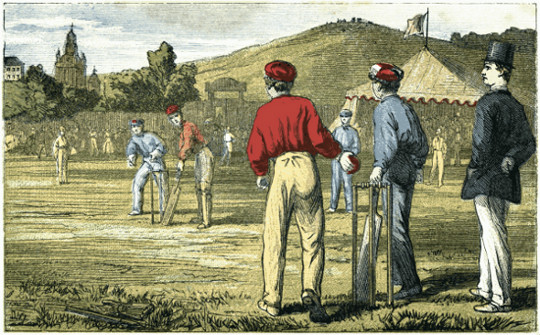
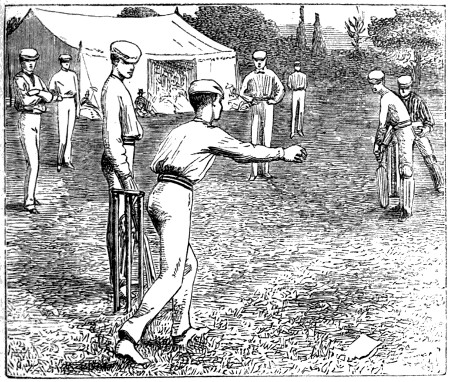
The game of cricket is the noblest of English pastimes. It combines athletic power, grace, quickness of eye and of hand, nimbleness of leg, and scientific skill. It is played by high and low, rich and poor, man and boy; and there is no game, either native or foreign, can compete with it for manliness, fairness, and healthfulness. Every one should learn to play it, and all should begin early. How it originated, or who evolved its beautiful laws and regulations, it is now difficult to discover. We have nothing like it among the sports of the Greeks and Romans, and we can only trace it to an old English pastime in the reign of Edward III., called “club-ball.” Strutt, in his “Pastimes of the People of England,” gives the following engravings, representing two specimens of club-ball: the first from a MS. in the Bodleian Library, dated 1344,—and exhibits a female figure in the act of throwing a ball to a man, who elevates his bat to strike it. The next specimen of ball, taken from a drawing more ancient than the former, i. e. a genealogical roll of kings of England[144] to the time of Henry III., in the Royal Library, presents two players only; and he who is possessed of the bat holds the ball also, which he either threw into the air, and struck with his bat as it descended, or cast forcibly upon the ground, and beat it away when it rebounded. But we should be rather inclined to trace the game of cricket to trap-ball, which was, no doubt, an improvement upon the early games played with the bat and ball. This may be traced as far back as the fourteenth century, and a curious specimen of the manner in which it was then played is given in a beautiful MS. in the possession of Francis Douce, Esq. Here are only two players; but the game then consisted of six or eight of a side, and the size of the bat indicates the holder to have possessed no great judgment in striking the ball. There was another game, called “stool-ball,” from which some have supposed cricket to have been derived; but there is no evidence in favour of this position, and it seems rather more reasonable to look upon it as a modification of “trap-ball” than any other game.
The regulation size of the bat, called by Felix the mighty sceptre of delight, is 38 inches in length, of which 25 inches are taken up by the pod, or, according to the more modern term, the blade, and 13 by the handle.
No bats are made longer than this, although, of course, they are allowed to be of various smaller proportions, in order to suite the height of the player.

We must strongly impress on all young players the great importance of using a bat in proportion to their strength. If they use a very heavy bat, they will not be able to move it quickly enough to play the ball properly, and are apt, in consequence, to get into a sluggish style of play, which is almost sure to stick to them all their lives. A very light bat is equally injurious: the batsman sees an easy ball approach, plays hard at it, when, instead of going right over the head of long-on, it drops an easy catch into mid-wicket’s hands, in consequence of there not being enough driving power in the bat to send it further.

The present style of ball, with the exception of some very slight modifications, seems to have been in use since cricket assumed anything like its present form. According to the rules of the present day, it must not be more than 9 inches in circumference, and must not weigh more than 53⁄4 or less than 51⁄4 ounces. Match balls are always treble-seamed, and are sold at the average price of 7s. 6d. But for ordinary practice, a double-seamed ball, at about 6s., will be found quite good enough, and will answer just as well as the more expensive article.
The stumps have undergone more change during the last hundred and fifty years than any of the accessories to cricket.
At first they were two in number and only 12 inches high. A third stump, 2 feet in length, was laid across them, although, with the exception of being knocked down by the bowler, it was similar in no respect to the bails of the present day, as the wicket-keeper was[146] obliged, in order to stump a person, to place the ball in a large hole dug between the two stumps.
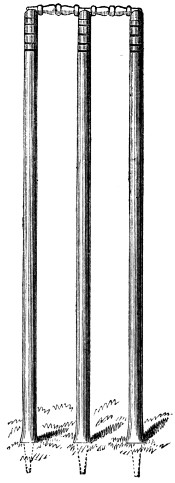
In the year 1780 the width between the two stumps was decreased to 6 inches. It was also at this time that a bail was introduced, for it is almost impossible to dignify the transverse stump, 2 feet long, which was in use till this date, by that appellation. In 1781 a third stump was added, and the height of the wickets increased to 22 inches. The addition of a stump was mainly owing to the fact, that Lumpy, a celebrated bowler of that day, sent the ball almost three times running between the two stumps. This was thought so unfair for the bowler, that it was resolved to increase the number of stumps in order to give him a better chance.
In 1814 we find that the wickets were increased in height to 26 inches, and in width to 8 inches, and in 1817 another inch was added to their length. This, with the exception of dividing the bail into two equal parts, is the last change that has taken place.
Since the introduction of round-hand bowling, pads or guards have come into vogue, and at the present time it is really a dangerous feat to play without them. The first notion of a leg-guard was two thin boards placed anglewise on the right shin. Since that time improvements have been effected in them at various times, until they have arrived at their present state of excellence.
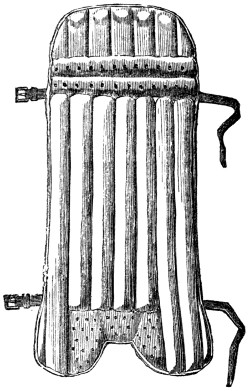
The leg-guard itself is now so well-known as to render any description of it needless; but as there are two or three fastenings in use, it will perhaps be as well to state what they are, and also which is the best. The first consists of three sets of tape, one round the ancle and two round the knee. These naturally take a great deal of time to fasten properly, and if one breaks, the pad is rendered useless for some time. The next is three pieces of elastic, with a catch which fastens almost instantaneously; but in course of time it loses its elasticity, and the pad dangles on one leg in a loose and awkward[147] manner. The third, and in our opinion the best fastening, is two sets of straps, with holes pierced at very slight intervals. The player can then have his pad as tight as he pleases, without the chance of the fastenings breaking or becoming loose, as in the case of the other two. There are several other guards, such as elbow and private-guards; but they are scarcely ever used.
These are now made with the palm cut clear away, thus enabling the batsman to hold the bat in a much firmer manner than he could[148] were the palm of his hand covered by the glove. As will be seen by referring to the accompanying cut, the india-rubber is placed differently on the two hands. This difference will be more particularly noticed on the two thumbs. The left one, as it is always behind the handle of the bat, requires no guard; but the back of the left hand being in front of the bowler, is covered with a semicircle of india-rubber, while the strips of the india-rubber on the fingers are much longer than those on the right hand. It may be urged by those who object to the use of batting gloves, that the ball is likely to fly off them and give a catch. This, although true, very rarely happens, and besides, if the ball came with enough force to fly into the air off the glove, is it not very probable that, without a glove to shield them, the fingers would be broken by the same collision?
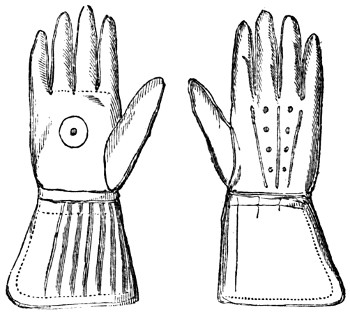
These might be more appropriately termed gauntlets, for they are much longer than the ordinary gloves, and entirely cover the wrist. Thanks to the suggestions of the best wicket-keepers of the day, they have now been greatly improved, and have padding only in those parts where it can possibly be required. It is absurd to try to keep wicket well without wearing these gauntlets; therefore let no young cricketer be fool-hardy enough to attempt the feat. As the right and left hand gloves are precisely the same, the artist has drawn one glove in two positions, in order to show the front and back of it.
The following are the laws which govern the game everywhere. They have been recently revised by the Marylebone Club, usually considered the highest authority in the game.
1. The Ball must weigh not less than 51⁄2 ounces, nor more than 53⁄4 ounces. It must measure not less than 9 inches, nor more than 91⁄4 inches, in circumference. At the beginning of each innings either party may call for a new ball.
[It is, however, not customary to have a new ball at the beginning of each innings. One a match is usually considered sufficient.]
2. The Bat must not exceed 41⁄4 inches in the widest part; it must not be more than 38 inches in length.
3. The Stumps must be 3 in number, 27 inches out of the ground; the bails 8 inches in length; the stumps of equal and of sufficient thickness to prevent the ball from passing through.
4. The Bowling Crease must be in a line with the stumps; 6 feet 8 inches in length; the stumps in the centre; with a return crease at each end towards the bowler, at right angles.
5. The Popping Crease must be 4 feet from the wicket, and parallel to it, unlimited in length, but not shorter than the bowling crease; unlimited in length, so that the batsman may keep out of the way of the ball when it is thrown in.
6. The wickets must be pitched opposite to each other by the umpires, at the distance of 22 yards.
7. It shall not be lawful for either party during a match, without the consent of the other, to alter the ground by rolling, watering, covering, mowing, or beating, except at the commencement of each innings, when the ground shall be swept and rolled, unless the side next going in object to it. This rule is not meant to prevent the striker from beating the ground with his bat near to the spot where he stands during the innings, nor to prevent the bowler from filling up holes with sawdust, &c. when the ground is wet.
8. After rain the wickets may be changed with the consent of both parties.
9. The Bowler shall deliver the ball with one foot on the ground behind the bowling crease, and within the return crease, and shall bowl four balls before he change wickets, which he shall be permitted to do only once in the same innings.
[In a one day’s match six balls are usually allowed as an over.]
10. The ball must be bowled; if thrown or jerked, the umpire shall call “no ball.”
11. He may require the striker at the wicket from which he is bowling to stand on that side of it which he may direct.
12. If the bowler shall toss the ball over the striker’s head, or bowl it so wide that in the opinion of the umpire it shall not be fairly within the reach of the batsman, he shall adjudge one run to the party receiving the innings without an appeal, which shall be put down to the score of wide balls; such balls shall not be reckoned as one of the four or six balls: but if the batsman shall by any means bring himself within reach of the ball, the run shall not be scored.
13. If the bowler deliver a “no ball” or a “wide ball,” the striker shall be allowed as many runs as he can get, and he shall not be put out except by running out. In the event of no run being obtained by any other means, then one run shall be added to the score of “no balls” or “wide balls,” as the case may be. All runs obtained for “wide balls” to be scored to “wide balls.” If the ball shall first touch any part of the striker’s dress or person (except his hands), the umpire shall call “leg bye.”
[If, however, the batsman runs two byes from a wide or a no ball, they are scored as two wides only. Many young players are in the habit of running a single bye off a wide ball, without ever thinking that they endanger their wicket without the slightest possible chance of advantage to themselves.]
14. At the beginning of each innings the umpire shall call “play;” from that time to the end of each innings no trial ball shall be allowed to any bowler.
[This rule is very seldom enforced, as a new bowler is almost invariably allowed a trial ball, though not on the wicket.]
15. The Striker is Out if either of the bails be struck off, or if a stump be bowled out of the ground;
16. Or, if the ball, from a stroke of the bat or hand, but not the wrist, be held before it touches the ground, although it be hugged to the body of the catcher;
17. Or, if in striking, or at any other time while the ball shall be in play, both his feet shall be over the popping-crease, and his wicket put down, except his bat be grounded within it;
18. Or, if in striking at the ball, he hit down his wicket;
19. Or, if under pretence of running or otherwise, either of the strikers prevent a ball from being caught, the striker of the ball is out;
20. Or, if the ball be struck, and he wilfully strike it again;
[This does not prevent the batsman from hitting the ball off his wicket when it glides in from not being blocked with sufficient force.]
21. Or, if in running the wicket be struck down by a throw, or by the hand or arm (with ball in hand), before his bat (in hand) or some part of his person be grounded over the popping-crease. But if both the bails be off, a stump must be struck out of the ground;
22. Or, if any part of the striker’s dress knock down the wicket;
23. Or, if the striker touch or take up the ball while at play, unless at the request of the opposite party;
24. Or, if with any part of his person he stop the ball, which in the opinion of the umpire at the bowler’s wicket shall have been pitched in a straight line from it to the striker’s wicket, and would have hit it.
[On the 15th of April, 1863, the M. C. C. altered this rule as follows:—“Or, if the ball hit any part of his person which in the opinion of the umpire at the bowler’s wicket shall have been placed in a straight line from it to the striker’s wicket.” But at their next meeting, discovering that their former[151] proceedings were informal, they cancelled their new rule; so that the law remains as before.
It is almost impossible for a round-arm bowler, unless he bowl over the wicket, to pitch the ball in a straight line.]
25. If the players have crossed each other, he that runs for the wicket which is put down is out.
26. A ball being caught, no runs shall be reckoned.
27. A striker being run out, that run which he and his partner were attempting shall not be reckoned.
28. If a lost ball be called, the striker shall be allowed six runs; but if more than six shall have been run before “lost ball” shall have been called, then the striker shall have all which have been run.
29. After the ball shall have been finally settled in the wicket-keeper’s or bowler’s hand, it shall be considered dead; but when the bowler is about to deliver the ball, if the striker at his wicket go outside the popping-crease before such actual delivery, the said bowler may put him out, unless (with reference to the 21st law) his bat in hand, or some part of his person, be within the popping-crease.
30. The striker shall not retire from his wicket and return to it to complete his innings after another has been in, without the consent of the opposite party.
31. No substitute shall in any case be allowed to stand out, or run between wickets for another person, without the consent of the opposite party; and in case any person shall be allowed to run for another, the striker shall be out, if either he or his substitute be off the ground in manner mentioned in laws 17 and 21, while the ball is in play.
32. In all cases where a substitute shall be allowed, the consent of the opposite party shall also be obtained as to the person to act as substitute, and the place in the field which he shall take.
33. If any fieldsman stop the ball with his bat, the ball shall be considered dead, and the opposite party shall add five runs to their score; if any be run, they shall have five in all.
34. The ball having been hit, the striker may guard his wicket with his bat, or with any part of his body except his hands; that the 23rd law may not be infringed.
35. The wicket-keeper shall not take the ball for the purpose of stumping until it has passed the wicket; he shall not move until the ball be out of the bowler’s hand; he shall not by any noise incommode the striker; and if any part of his person be over or before the wicket, although the ball hit it, the striker shall not be out.
36. The umpires are the sole judges of fair or unfair play; and all disputes shall be determined by them, each at his own wicket; but in case of a catch, which the umpire at the wicket bowled from cannot see sufficiently to decide upon, he may apply to the other umpire, whose opinion shall be conclusive.
37. The umpires in all matches shall pitch fair wickets; and the parties shall toss up for choice of innings. The umpires shall change wickets after each party has had one innings.
38. They shall allow two minutes for each striker to come in, and ten minutes between each innings. When the umpire shall call “play,” the party refusing to play shall lose the match.
39. They are not to order a striker out unless appealed to by the adversaries;
40. But if one of the bowler’s feet be not on the ground behind the bowling-crease, and within the return-crease, when he shall deliver the ball, the umpire at his wicket, unasked, must call “no ball.”
41. If either the strikers run a short run, the umpire must call “one short.”
[The run is of course not scored.]
42. No umpire shall be allowed to bet.
43. No umpire is to be changed during a match, without the consent of both parties, except in case of violation of the 42nd law; then either party may dismiss the transgressor.
44. After the delivery of four or six balls the umpire must call “over,” but not until the ball shall be finally settled in the wicket-keeper’s or bowler’s hand; the ball shall then be considered dead; nevertheless, if an idea be entertained that either of the strikers is out, a question may be put previously to, but not after, the delivery of the next ball.
45. The umpire must take especial care to call “no ball” instantly upon delivery; “wide ball” as soon as it shall pass the striker.
46. The players who go in second shall follow their innings, if they have obtained eighty runs less than their antagonists, except in all matches limited to only one day’s play, when the number shall be limited to sixty instead of eighty.
47. When one of the strikers shall have been put out, the use of the bat shall not be allowed to any person until the next striker shall come in.
Note.—The Committee of the Marylebone Club think it desirable that, previously to the commencement of a match, one of each side should be declared the manager of it; and that the new laws with respect to substitutes may be carried out in a spirit of fairness and mutual concession, it is their wish that such substitutes be allowed in all reasonable cases, and that the umpire should inquire if it is done with the consent of the manager of the opposite side.
Complaints having been made that it is the practice of some players when at the wicket to make holes in the ground for a footing, the Committee are of opinion that the umpires should be empowered to prevent it.
1. When there shall be less than five players on a side, bounds shall be placed 22 yards each in a line from the off and leg-stump.
2. The ball must be hit before the bounds to entitle the striker to a run, which run cannot be obtained unless he touch the bowling-stump[153] or crease in a line with his bat, or some part of his person, or go beyond them, returning to the popping-crease, as at double wicket, according to the 21st law.
3. When the striker shall hit the ball, one of his feet must be on the ground, and behind the popping-crease, otherwise the umpire shall call “no hit.”
4. When there shall be less than five players on a side, neither byes nor overthrows shall be allowed, nor shall the striker be caught out behind the wicket, nor stumped out.
5. The fieldsman must return the ball so that it shall cross the play between the wicket and the bowling-stump, or between the bowling-stump and the bounds; the striker may run till the ball be so returned.
6. After the striker shall have made one run, if he starts again he must touch the bowling-stump, and turn before the ball cross the play, to entitle him to another.
7. The striker shall be entitled to three runs for lost ball, and the same number for ball stopped with bat, with reference to the 28th and 33rd laws of double wicket.
8. When there shall be more than four players on a side, there shall be no bounds. All hits, byes, and overthrows shall then be allowed.
9. The bowler is subject to the same laws as at double wicket.
10. Not more than one minute shall be allowed between each ball.
The first point to be considered in batting is the sort of bat to be used. Many young cricketers cramp their play by using a bat much too heavy for them. Now, it stands to reason that one should be able to have a complete mastery over the weapon one wields. A bat weighing about two pounds will be found quite heavy enough for most schoolboys. It may, however, be urged that the heaviest bats drive the farthest, and that many of the old-fashioned players made some of their famous hits with them; but it must also be borne in mind that those were the days of underhand bowling, and that at the present time cutting and leg-hitting, in consequence of the swift round-arm bowling, are infinitely more prevalent than forward drives, and that in many cases the position of field-on is done away with altogether. Therefore let us beg young players to use a light bat, one that feels almost as a whip in their hands, and one with which they can play back as quickly as is necessitated by the speed of the bowling.
And now a few words with regard to guard. Of course, in many instances, the distance from the wickets depends considerably upon the pace and pitch of the bowling, but as a rule the safest guard is about four inches from the popping-crease. This block not only gives you a better chance of stopping shooters, but also enables you[154] to play forward better, since you can cover more ground than if your block were nearer the wicket. A leg hit can also be made sooner, and consequently squarer, and with a good long block there is less chance of hitting your wicket in playing back, and more chance of stopping a full-pitched ball before it touches the ground.
The left foot should be at right angle to the wickets, and the other parallel with them. Free hitters keep their hands at the upper part of the handle of the bat, whilst some players, who have a reputation for steadiness, hold it with the hands three or four inches apart. The former position enables a player to hit much sooner, and also to have a much longer reach. The advantages of the position are readily discovered when there is a chance of a cut or a leg-hit.
The batsman should stand quite erect, endeavouring to make the most of his height. Before the ball is delivered, the bat should be raised, with the full face presented to the bowler, and covering as much of the wicket as possible.
The moment the bowler is about to deliver the ball, raise your bat slightly from the block, keeping it almost straight to him. If you hold it, as some players do, still on the block-hole until the ball approaches, you are almost sure to be too late for the ball; and although, if it be straight, you may keep it off your wicket, yet it is a hundred chances to one that you will miss all the leg balls, or those which come to the off-side.
Play, too, as low as possible. It is much better to hit a ball well along the ground for two, than to send one high into the air, although you get four or five for it. Sooner or later you will lose your wicket, for the ball is sure at some time to be caught by long-on or long-off.
Assuming that the player has taken up his position at the wicket, we must now fully impress upon him the importance of not being in a hurry to score. In fact, nothing is so injurious as making runs in the first over. The best maxim to be observed is, play steadily until you can understand the bowling. It is astonishing how much confidence you gain after you have played a dozen balls or so. Then, when you have, as it were, taken the measure of your opponent, lunge out, as soon as you get a chance, and show the field your favourite drive, and prepare to make a score.
In writing the last sentence, we are reminded of the many mishaps and even serious accidents that have occurred on the cricket-field in consequence of the careless manner in which some players run. They rush between the wickets, watching the course of the ball rather than the wicket towards which they are going; occasionally they run too far and lose time, or else do not run far enough and lose runs; or, what is even worse, a collision takes place between the two batsmen, and one is run out, if not seriously injured by the bat or body of his comrade. The simplest plan, therefore, is always to run on the right side, to keep the bat in the right hand, and to watch the wicket towards which you are running.
It has often been remarked that the most difficult balls to play are shooters, and those that are well pitched up and just take the bail off. Indeed, some shooters are almost sure to take a wicket; the moment, therefore, that a ball shoots, drop the bat back close to the stumps, and chop down upon the ball. Stopping a shooter is always a sign of good play, and often at Lord’s produces more applause than a hit which scores two or three runs. Some players, like Parr and Carpenter, can stop shooters so well, that although they only chop down upon them, yet the force of the stroke often drives the ball far enough to obtain a run.
How happens it that so many players miss the cut, although they attempt this stroke at almost every ball that rises to the off? As a rule, young players hit too soon, and if they touch the ball, in most cases they give either point or cover-point an easy catch; others hit in time, but play with a horizontal bat, the face of which is presented to the bowler. The ball then rises in many instances either to slip or long-slip, with the usual result. In cutting, the batsman should wait until the ball has almost passed the wicket, and then drop down upon it, with the face of the bat almost towards the ground. This keeps the ball down and drives it in the direction required. In cutting, the left foot acts as a pivot, and the right foot is drawn back. The advantage of taking a long block is here shown, as occasionally this leg knocks down the wicket; and if the block is near the stumps, they are easily struck by the bat itself.
In leg-hitting, on the contrary, the right acts as a pivot, and the left is thrown forwards. The sooner the hit is made the squarer the ball goes, and, as a rule, the greater distance also. Since then, in swift bowling, long-on is generally done away with, a leg ball that is hit in front of long leg is safe to obtain more runs than if hit much behind the wicket.
A very common habit among young players is to strike at wide balls. Many and many a time have we seen a batsman rush out to a wide off-ball, and send it into point’s or cover’s hands, thus depriving himself of his innings and his side of a run. Before we conclude this somewhat desultory chapter, we must urge upon everybody the importance of wearing both gloves and leg-guards when playing against swift bowling. The many dangerous accidents that have happened in consequence of the legs and hands having no protection, should induce every person to guard himself as much as possible. One can stand up to the wicket much better, and have far more confidence, when one knows that a blow from the ball upon the legs is likely to produce no ill effect. The absence of pads causes many players to run away from the ball, and if the ball turns, the off-stump in most cases will soon be prostrate.
Be careful, too, in running, that you ground your bat on the popping-crease. Nothing is so tantalizing to a player as to lose a run[156] through the carelessness of his companion, who in his excitement runs an inch or so short of the proper distance.
The moment the ball has left the bowler at your wicket, walk a yard or two; you may by this means steal many a run that it would be impossible to obtain if you were at your own wicket when the ball was hit.
Never, if you can possibly avoid it, hit a ball on the wrong side. How disgusting it is to see a big awkward player swipe a ball right round to the off-side which he should have drawn or played to mid-wicket on!
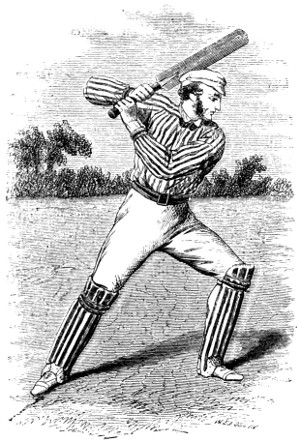
THE LEG HIT.
Do not run away from the ball. If you do, you can never get a good leg hit; besides, you naturally expose your wicket, and if the ball turns in (as it often will do), you will find it almost impossible to be back in time to save your off-stump.
As a rule, play forward whenever you can; but be sure you don’t run out of your ground to hit unless you feel perfectly confident of your success.
Waiting for the ball is always a dangerous experiment, and will often result in your playing back so far that you upset your own wickets when in the act of achieving a most scientific cut.
Be careful to keep one foot steadily planted within the popping-crease; it is sometimes impossible to help being bowled or caught, but the worst player in the world can always prevent the wicket-keeper stumping him.
Mind, too, that the bat ought to strike the ball, and not the ball the bat.
Be always cautious of straight balls, however tempting they may appear. Remember that if you miss them, you are safe to lose your wicket; therefore always treat them with the respect that they deserve.
Balls, too, that come about five inches above the bails should generally be allowed to pass, for unless you are well skilled in the art of hitting down, you are sure to give a catch.
And now a word or two with regard to the three leg hits—the draw, the forward, and the backward leg hit.
When a ball seems pitched at the leg stump, hold your bat straight, as it were, for a block; but the moment the bat meets the ball, turn the face of it a trifle round towards you, and the ball will then slip off between your legs and the stumps. This is called the draw.
This play, however, requires a great deal of practice, and should very rarely be attempted by inexperienced players.
The forward leg hit is made in the following manner:—When a ball is pitched rather wide on the near side, advance the left foot in front of the wicket, turn half round, and hit down upon the ball as hard as you can.
When the ball is pitched inside the near stump, step back with the right foot, and with an upright bat play it off the wicket. The ball will fly rapidly along the ground, and usually between leg and long-stop.
Recollect, the sooner you hit at a leg ball the squarer it goes.
The cut is the most difficult of all, and can only be accomplished when the ball rises a little wide of the off-bail. Even then you are very likely to play either too soon or too late at it, and it is very rare indeed that a player makes a really good legitimate cut.
When you see the ball about to rise a foot away from off-bail, draw the right leg backwards, and, with a horizontal bat, give the ball something between a pat and a push, between point and short-slip.
This is very far from being a scientific definition of this delightful stroke; but I think, from the plain manner in which I have stated it, that it will be more likely to be understood.
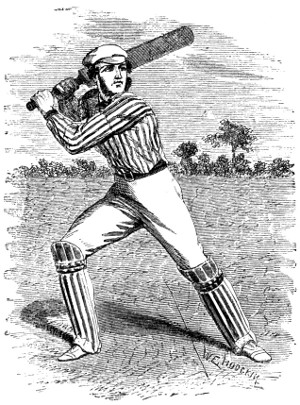
THE CUT.
The technical names for the various balls the batsman is likely to receive are—the full pitch, the tice, the hop, the half volley, the ground ball, and the shooter.
Leg balls and balls to cut we have already explained.
At first sight, a full pitch would seem one of the easiest balls to play; but in reality it is not; and many a good batsman, who could play any number of well-pitched balls, has lost his wicket by playing rashly or across a toss. Again, if hit carelessly, it is almost sure to be caught by one of the long-fields; and often, when the batsman tries to play it down, it hits the top of his bat, and goes into long-stop’s hands. The best plan (if you are not very tall), when you think it is too high to take your wicket, is to leave it alone altogether; but when you feel persuaded that if you miss the ball it will take the stumps, either play it down, or else hit it where there is no field.
The tice is almost a full pitch. If you have a long reach, go in and play it forward; if not, however, keep your bat down and block[159] it. Running in is generally a bad habit, as it is sure to engender a loose style of play.
The long hop, if straight, should be played very carefully, and with an upright bat. Those batsmen who have, as it is called, “got their eye in,” can usually strike at one with impunity; but as the ball is liable to twist every time it reaches the ground, the young player should be very careful in striking at it.
A half volley is a ball which rises well from the pitch. Catches are, however, often the result of hitting right at a half volley.
A ground ball is perhaps better known among our young friends as a sneak. If played at with a high bat, the wicket is almost sure to fall. The best plan is to keep the bat well down, and play forward at it. If the bat is kept in a straight line with the ball, you cannot miss it, and often by playing it forward you can send it past the bowler.
A shooter is the most difficult ball to play, and if not treated with proper respect, is sure to take the wicket. The moment the ball shoots, play back, dropping the bat down on it within an inch of the stumps. You are by this means very likely to keep it off your wicket, but do not try to hit it. Left-hand bowling generally turns in from the off; therefore play forward at it.
Although not of so interesting a character as batting and bowling, yet fielding is in itself of too much importance to be overlooked, or even carelessly practised, by anybody who desires to become a cricketer. Many a match has been lost by loose fielding, and instances without number have occurred of a man who, after being missed before he has made a run, has sent his score up to fifty before receiving his dismissal. It is astonishing how many runs may be saved by careful fielding. Hits which at first seem good for four, only obtain one through good fielding, and that even a sharp run.
Quick fielding should be practised by the tyro, before either of the other two departments of the game. As soon as a boy gets a ball in his hand, he tries to catch it, or to get a companion to throw it to him; and thus before he even knows how to handle a bat, many a boy has in him the elements of a good field. As, however, the fascination of batting grows upon him, he cares less for the other parts of the game; and thus it happens that although we have many gentlemen cricketers who bat just as well as professionals, yet the latter obtain the mastery through their superior bowling and fielding, which they are obliged to practise as often as batting, in order to obtain the reputation of good players. I have, however, heard it stated that no finer fielding can be seen than that shown in the University match. This is generally admitted; but it must be borne in mind that the University match is played by young men whose ages vary from twenty to five-and-twenty, whereas most of the players are[160] over thirty, and some rapidly approaching to forty, an age at which the bones are not so lissom as those that have just arrived at man’s estate.
As a proof of this I may cite the Gentlemen and Players’ match at Lord’s, a contest (if such it can be called) which is only worth seeing on account of the excellent bowling and fielding of the professional players. It is satisfactory to know that it is the opinion of most judges of the game, that as long as the gentlemen persist in practising batting only, they will scarcely have a chance against the players.
No advice, however, will produce the same good upon a young player in the matter of fielding as watching a match in which some of the best players take part. In this he should bear well in mind the manner in which the ball is stopped and thrown to the wicket-keeper.
Supposing that our cricketer can stop and catch a ball pretty well, the next point for him to study is to throw it in carefully. How many men that should have been run out save their wickets through the bad throwing of a field, who, either through hurry or nervousness, pitches the ball over the wicket-keeper’s head, or sends it in so much along the ground as to render the picking up of it sharply by the wicket-keeper a matter of impossibility! The best plan is to throw in a catch to the top of the bails. A long hop occasionally meets with success; but if the ground is bumpy, and the ball is thrown in from a distance, it is very possible that it will go over the man’s head.
One of the most prominent failings of a young eleven is the careless manner in which they back up. Overthrows in a professional eleven are almost a matter of impossibility, for if the ball passes one field there is almost sure to be another behind him to stay its progress; whereas, in some clubs, if there is one man to back up the wicket-keeper, the ball is considered safe, and as he generally stands within a few yards of the wicket, he usually misses the ball if it passes the amateur Lockyer. If, however, it is expedient to throw the ball to the bowler, and he does not wish to hurt his fingers, an overthrow is sure to follow, for long-on or long-off scarcely ever thinks it his duty to stand behind the bowler’s wicket when the ball is thrown in. Overthrows in themselves are not only annoying, because they are obtained through no merit of the batsman, but because they always produce a merciless laugh from the spectators, and occasionally epithets of a not very complimentary character. It is therefore the captain’s bounden duty to make his eleven back up well, and not to consider the ball safe unless two or three people are behind the wicket at which it is thrown.
One naturally imagines that the wicket-keeper’s hands get occasionally damaged from the sharp throwing to which he is subjected. Whatever he would do without his thick gauntlets, it is unpleasant[161] to imagine. Care should on all occasions, therefore, be taken to save his hands, and when the batsmen are not running, there is no need to throw the ball as hard as possible at him. The long-stop, who returns the ball to the wicket-keeper oftener than any other field, should send it in gently when there is no run, and the wicket-keeper ought, in throwing it to the bowler, to toss it as quietly as he can, in order not to deaden the fingers of that important functionary.
Whilst writing about bowler and wicket-keeper, we cannot allow the opportunity to pass of requesting all players to obey with the utmost fidelity any order given to them in the field. The wicket-keeper can, by raising his hand, change the positions of the field unknown to the batsman, who, hitting a ball to a place which he thinks is not covered, and finding it suddenly stopped, sees that he must play more carefully in future.
Two of the most important positions in the field are the mid-wickets and cover-point, and no player, unless he is a safe catch, and can return the ball sharply, should ever be placed there. It has been computed that mid-wicket runs more out than any other field. Anybody who has seen R. Daft in this place will be surprised at the rapidity with which he picks up the ball and sends it in. The space that a good cover-point can command is really astonishing. Players seeing that the ball has passed point feel sure that it is safe for one, whereas, if cover runs in and sends it in well to the wicket-keeper, one of the batsmen will probably have “run out” to his name.
Long-stop should on no account be too close to the wicket. If he takes a position where he feels sure he can stop one run, he will do much more service than nearer the stumps. Not only will he be able to stop some balls which might have gone over his head, but he may stay the progress of many leg-hits and slipped balls, besides standing a better chance of a catch.
Catching comes so naturally that we need say little about it. The chief point to be remembered is to keep the hands well together. Occasionally one sees—in catching—the ball slip through a man’s hands altogether. At other times the ball lodges in the hands for an instant, and then drops to the ground, because the arms were not drawn back with the ball, but held out to meet it. In catching, the arms should always be drawn back as the ball comes, as this lessens the force with which the ball strikes the hands. A good plan, but one which, however, requires much practice, is to pat the ball up as it comes, and then to catch it. It is evident that when the ball has thus been sent up, it descends much more slowly than when it comes direct from the bat.
Even, however, if, in spite of advice and practice, one of the field is unfortunate enough to miss a catch, the captain should not allow any unfeeling remarks to be made. The anguish of the unfortunate player is quite deep enough without being aggravated by growls and[162] sneers from comrades who may perhaps do the same thing in a few minutes.
The captain should also do all he can to prevent talking in the field. It is time to do that when a wicket falls, but very unlike a true cricketer to endeavour to attract the field’s attention just as the bowler is about to deliver the ball.
We have read in a manual of Cricket that there are four styles of bowling, and Felix, we believe, in his excellent work on the Bat, states that there are five modes, all of which are in general use. For the present purpose, however, we think it will be sufficient if we confine our remarks to two styles,—
1. Round-arm Bowling.
2. Underhand Bowling.
The former is an innovation upon the latter, and, like all improvements, met with a great deal of opposition at first, since it was more difficult to play, and made the innings shorter. Now, however, the batting seems to have obtained as much mastery over the round-arm bowling as before it had over the underhand, and it is even probable that in a few years a new style will be introduced, in order to decrease the inordinate length which innings assume now-a-days.
The following hints apply to the round-arm bowling:—
The ball should be held with the fingers across the seams, as this occasionally makes the ball twist, and renders the defence of the batsman a matter of more difficulty. Many bowlers, however, can never get what is technically called “a twist on,” whereas others, after an hour’s practice, can manage to make the ball twist in any direction they please.
It is also important to take a run of a few yards, increasing the distance in proportion to the pace. This allows the bowler to get his arm into swing, and increases the impetus with which the ball is delivered.
The bowler should always stand with his body well towards the other wicket. We have seen a man run almost round the wicket and deliver the ball without looking at the stumps he is supposed to aim at. Long practice had enabled him to bowl pretty well, but the absurdity of his position was so apparent that it provoked a laugh from all who saw it.
It must not be imagined, however, that a bowler should always deliver the same style of ball. Many a wicket (paradoxical as it may seem) falls from a ball that is not straight. A batsman who has had a hit to leg for four, becomes at once anxious to get another. Very often, if a bowler pitches the ball in a different manner, the batsman endeavours to give another specimen of his favourite hit, and equally often loses his wicket. Practise, therefore, change of[163] pace and pitch, as catches are almost sure at some time to be the result.
Nyren, one of the earliest writers on Cricket, speaks of this plan in the following manner:—
“When it is difficult to part two batsmen, and either of them has a favourite hit, I have often succeeded in getting him out by opening the field where his hit is placed, at the same time hinting to the bowler to give him a different style of ball. This, with the opening of the field, has tempted him to plant his favourite hit, and in his anxiety to do so he has not unfrequently committed an error fatal to him.”
In writing of round-arm bowling let us recommend young bowlers to practise bowling over the wicket in preference to what is usually termed round or outside it. The former plan is the only mode that necessitates straight bowling, since, from the position of the arm, the ball may be straight all the way, whereas, in the latter, the ball must come in from the leg side. Again, it will be recollected that in the late discussion about leg before wicket, many of the best judges gave it as their opinion that the batsman could not be given out l. b. w. unless the ball was delivered over the wicket. To these advantages may be added the fact that a much better view of the opponent’s stumps can be obtained, and that the distance is also shorter than from the outside of the wicket.
Among the most common faults of young players may be cited a habit of not pitching the ball far enough. This is mainly owing to a want of power in the arms, but still a little careful practice will considerably assist the player. Those nice specimens of bowling known as bailers, when the bail is knocked off, can only be obtained by a ball that is well pitched up. Shooters, also, are the result of balls that touch the ground near the wicket. We may also add that a ball that is pitched short is easy to play, since it can be seen well, and its coming in contact with the ground deadens its force and checks its speed.
Another practice which is often condemned is a habit of bowling fast. Now, it is a great mistake to imagine that fast bowling is the most difficult to play, as may be ascertained by the fact that our fastest bowlers by no means take the most wickets, excepting Jackson, whose bowling, however, is not so successful now as it was at one time. Fast bowling does not so readily allow accuracy of pitch as a slower style; besides, a fast bowler soon gets tired, then bowls loosely, and then gets taken off. Those tips (for they are nothing else) to the slips for four or five, are more the result of the bowler than the batsman. Let us, therefore, earnestly recommend young bowlers to begin bowling slowly, and to increase their pace as they grow older and stronger. Many a promising bowler has been irretrievably spoilt by beginning to bowl too fast for his strength, and finding in a short time that he has no style at all, and that the fruit[164] of his labour is principally found in the number of byes scored off him.
Particular care must also be taken to avoid bowling over the shoulder. It is a pity that there is not some more stringent rule than at present exists with regard to law 10, although in such a case the most successful bowlers would find their occupation gone; besides, as the no-balling of a bowler by an umpire usually causes the greatest unpleasantness in a match, spoiling the amicable feeling which almost invariably exists in the cricket-field, it is much better to avoid the head and front of the offending, by practising the best means to prevent the arm getting over the shoulder. We recollect at school a big sturdy fellow, who, not content with bowling over his shoulder, delivered the ball always as fast as he could. His bowling, however, (as might be expected) was so loose that his services were never called into requisition at a match; but at practice he occasionally handled the ball, much to the dread of the batsman he opposed. One day he was bowling against the present writer in his usual headstrong style, and actually sent a ball over the wicket-keeper’s head into long-stop’s hands. This naturally frightened us, as we thought it just possible that the next might hit us on the chest. A narrow escape we had, for the very next was pitched so high, that, had we not quickly dropped on the ground, it would have hit us on the head with such force as probably to stop cricket with us for ever.
Our remarks on underhand bowling, or slows, must necessarily be brief. That good slows are effective, particularly against county twenty-twos, is proved by the analysis of R. C. Tinley’s bowling, and the destructive power of Mr. V. E. Walker’s slows is well known to most of those who have played against him.
It is often a good plan to begin with a fast bowler at one end and slows at the other. The change of pace and delivery is very puzzling to the batsman, who is compelled to play the two styles on a different plan. If, however, a slow bowler is hit about much, he should be changed at once, as the hits from slows generally add up quicker than those from round-arm.
If change of pitch is advantageous in the swift bowling, it is the very soul of slows. Full pitches, leg balls, off balls, shooters, all styles and forms, should be allowed full play. The bowler, too, must dodge about, and make himself an extra field, going wherever he imagines the ball will be hit. In writing about slows we cannot pass unmentioned the great advantage derived from making a ball twist in from the leg. It is always understood that the leg stump is the hardest to defend, and consequently the best to attack.
A slow ball is pitched a little wide of the leg, the batsman runs away from his guard, and, in his imagination, sees the ball hit to square leg for four. In reality, however, he finds his off-stump knocked down by this same leg ball at which, in his ignorance, he[165] struck too soon, and therefore saw it hit his stump before he could be back to stop it.
The positions of the field may be varied according to the opinion of the bowler.
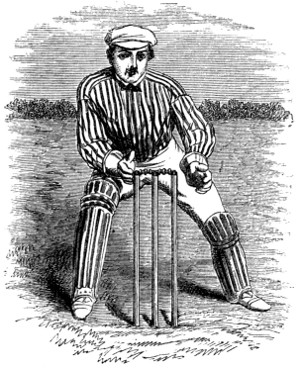
The duties of the wicket-keeper are to stop the balls when missed by the striker, to stump him when off his ground, and to catch the ball, and knock the wickets down before the striker, when running, can ground his bat over the popping-crease. Since the introduction of fast bowling this position has become the most dangerous in the field, and a wicket-keeper seldom gets through a match without receiving some bruises. He should always wear pads and gloves. Some people recommend a guard for the abdomen, but this is scarcely ever used.
The wicket-keeper should, if possible, be captain of his eleven. As he is behind the striker, he can by a motion of his hand move any of the field closer or further, unknown to the batsman. This naturally requires great tact, and is often the means of saving many a run, or of getting a wicket.
He should stand in a somewhat stooping position, his left leg well forward and his hands close together, while his eyes should watch every movement of the ball. He should be very cautious about taking leg balls, as, if he gets too near, he is likely to receive a blow from the batsman.
As soon as the ball is thrown to him from the long-stop, he ought to advance two or three yards (provided, in the meantime, the batsmen are not running), and send it gently into the bowler’s hands.
The moment a hit is made, he should stand on that side of the wicket farthest from the ball, and wait quietly till it is thrown in. The ball should be thrown in by one pitch, and not in long hops, as is often the case among bad players. Above all, he should knock the wicket down as seldom as possible, but content himself with striking a bail off when he thinks the batsman is out of his ground.
Stands behind the wicket-keeper, in order to prevent byes.
He must be careful not to be too far away from the wicket, or else clever players are apt to steal a bye before the ball has reached him. The moment he gets the ball, he should return it sharply into the wicket-keeper’s hands, and scarcely ever throw it over to the bowler. He should assist in backing up short slip, and also endeavour to save runs on the leg side. When slows are put on in a match, the long-stop is usually changed to a position about twelve yards behind the bowler’s head.
Stands in a direct line with the popping-crease, at a distance of about twelve yards on the off-side, for fast bowling. The faster the bowling, the sharper he should stand. He should commence at first at the distance we have just mentioned, and approach when he sees the player about to strike. A sharp point may often stop a hard hit to cover-point. This position is, however, rather dangerous in fast bowling, and, at the same time, one of the most important. For slow bowling, he should come in to about five yards, and stand at a more acute angle than when the delivery is very swift.
Stands a few yards behind the wicket on the off-side. As this position does not entail much running, it is usually allotted to the bowlers. The balls come in very sharply when the bowling is swift, and the person occupying this position has to watch the ball very attentively, or he stands a very good chance of receiving it in his face. It is also his duty to back up the wicket-keeper, and to take his place at the wicket when that functionary runs after the ball.
Stands some distance behind point, to prevent a second run. The sharper the bowling is, the squarer he should stand. He must also be particular in backing up, as he can prevent many an overthrow.
Performs the same duties, and occupies the same position, with regard to slip as the last-mentioned field does to point. He should, when he can, back up long-stop and save a second run.
Stands deep on the on-side. When the bowling is very swift, he can take the place of mid-wicket on, as a ball in such a case is seldom hit fair, either on the on or off side. He must be a good catch, a good thrower, and very swift on his legs.
Occupies the same position as long-on at the other side of the wicket.
Stands about the same distance behind the wicket on the on-side as long-on does before it. He must possess a quick eye and great agility. Leg-hits, after touching the ground, usually turn off in quite a different direction from what one would expect. Leg should therefore try to get them before they pitch, or else be careful in running to meet them.
Stand halfway between the long-fields and the striker’s wicket. As many catches come to these parts of the field, they should be very sharp and active, and try to prevent the ball going past them.
In very swift bowling the long-on often takes this position. He stands between point and short-slip, in a direct line with the bowling-crease, at a distance of about twelve yards.
And now, having given the functions of the fieldsmen, we propose to show, by diagrams, their positions with regard to fast and slow bowling.
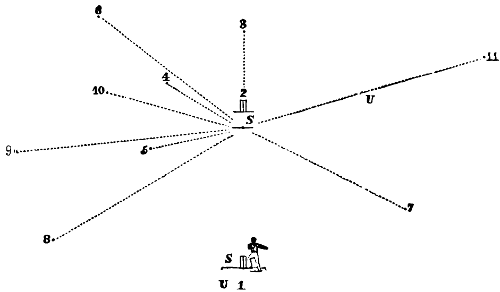
S. Striker; 1. The Bowler; 2. Wicket-Keeper; 3. Long-Stop; 4. Short-Slip; 5. Point; 6. Long-Slip; 7. Mid-Wicket on; 8. Long-off; 9. Cover-Point; 10. Third Man up; 11. Long-Leg; U. Umpire.
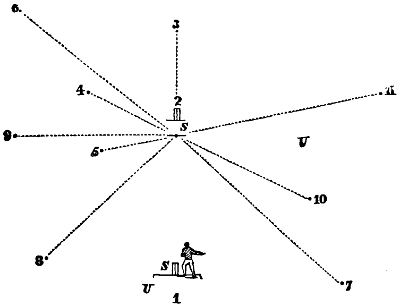
S. Striker; 1. Bowler; 2. Wicket-Keeper; 3. Long-Stop; 4. Short-Slip; 5. Point; 6. Long-Slip; 7. Long-on; 8. Long-off; 9. Cover-Point; 10. Mid-Wicket on; 11. Leg; U. Umpire.

1. Bowler; 2. Wicket-Keeper; 3. Leg; 4. Short-Slip. 5. Point; 6. Extra Long-on; 7. Long-on; 8. Long-off; 9. Mid-Wicket off; 10. Mid-Wicket on; 11. Square-Leg; S. Striker. U. Umpire.
As in very swift bowling the ball is often hit to the off, it will be seen that in Diagram I. we have placed no less than six out of the eleven on that side. Mid-wicket on and long-off should be a little nearer the bowler, and long-slip nearer the long-stop, than represented in the illustration.
In Diagram II. third man up is made mid-wicket on, while cover-point comes in nearer than when the bowling was very fast.
In Diagram III., as the bowling is slow, no long-stop is required; he is therefore sent as an additional field behind the bowler. Short-slip stands in very close to the wickets.

The mallet, of which in a Croquet set there are eight, varies in length from 32 to 39 inches. The handle is thin and round, and is fastened into the head somewhat in the manner of an ordinary mallet used for knocking in tent pegs. The head slightly resembles in shape a dice-box, inasmuch as it is narrower in the centre than at the ends. The mallet is the active agent in the game, just as the bat is at cricket; and as the mallet is always in the hands of the striker, care should be taken that it is well planed. Towards the top of the handle a few circular lines may be cut with advantage, as they give a firmer hold to the hand. At the bottom of the handle is usually painted a colour, or a number of lines, corresponding to the marks on one of the balls. Such an arrangement, although not absolutely necessary—since a player can use any mallet without interfering with the game—is of advantage in according to each player the same coloured mallet as his ball; and were the mallets uncoloured, disputes would probably arise about one which was a greater favourite than the others. Some people prefer to have the colour of all the balls painted on their mallets. This is a very good plan if one is in the habit of playing with inattentive people, who will not recollect when it is their turn to play. As the hard surface of the end of the mallet-head coming sharply in contact[171] with a ball often cracks, chips, or breaks it in two pieces, it has been suggested that a piece of wash-leather should be let in at each end of the head, in order to deaden the force of the stroke. We do not, however, recommend the adoption of this plan, as it is very expensive, and the wash-leather is not only likely to be soon torn, but in the course of the game may come out altogether; besides, a Croquet-ball can always be replaced for a trifling sum, and, if played with carefully, ought to last twelve months at least.
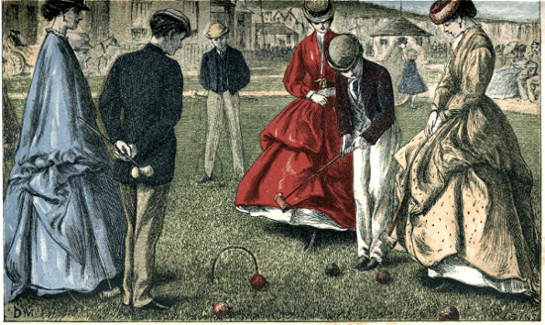
CROQUET.
The balls are eight in number, and are generally painted different colours—blue, pink, black, yellow, brown, orange, red, green. The size varies from 3 inches to 3⅝ inches in diameter. The balls of some of the better Croquet games are not entirely covered with paint, but adorned simply by a band of paint, about half an inch in width, or with lines of blue and red, varying from one to four in number, as in the illustration. Balls coloured thus are, however, not so easily distinguishable as those which are painted all over.
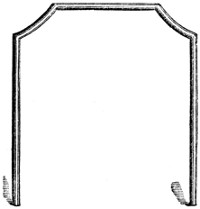
The hoops, ten in number, are made of iron. They are about 16 inches high, and 12 inches wide; although these dimensions are not of much importance. In some games the hoops are of bronze, or else are painted a golden colour. Usually, however, they are of a black, iron tint. The set with which we generally play is painted white. This plan is in many respects advantageous, for as the shades of evening close round the players the contrast between the grass and the hoops becomes less vivid, and consequently in the excitement of the game a player occasionally tumbles over a hoop, and probably hurts his legs; when, however, the hoops are painted[172] white, the play can be continued to a late hour without the chance of such a casualty as the breaking of one’s shins against the iron hoops.
The posts, two in number, should be from 24 to 36 inches high. One end must be sharpened into a point, in order to allow it to stick well in the ground. One is called the starting, the other the turning post. The top half is, in the cheaper sets, divided into eight divisions, each of which is painted according to the colours of the ball. Thus, beginning from the top, we trace the divisions into the following order:—
The order of the colours acts as a guide to the players; and since those on each side play alternately, it follows that in a game of eight, the dark balls—blue, black, brown, and green—are matched against the light balls—pink, yellow, orange, and red. The advantage of this arrangement is plainly manifest, since, during the game, the players, without referring to the peg, will know that the light colours play alternately with the dark. We admit, however, that opinion may be divided about the lightness of red as a colour; and we therefore hope that the Croquet-makers will change it into white, which is not likely to be confounded with the yellow, for the latter, in consequence of being in more frequent use, is sure to become dark in much shorter time than the former. Some, however, as in the illustration, have red and blue divisions, marked from one to four, to correspond with the number of rings painted on the balls.
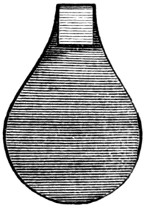
A set of Croquet-clips—little pieces of tin, coloured according to the colours of the balls, in order to slip over the hoops, and thus show the hoop through which the player has next to pass—has been lately introduced. We do not, however, recommend the use of them, as they are liable to cause much confusion, and certainly give a great deal of trouble to those players who adopt them.
A gentleman has invented a marking-board, on which is placed the position of each player after his stroke is made; but as this requires an umpire to mark the positions of the balls, we do not think the plan worth adoption.

In some games a very narrow hoop—scarcely wide enough for the ball to pass through—has been introduced under the name of tunnel. It certainly adds to the complication of the game.
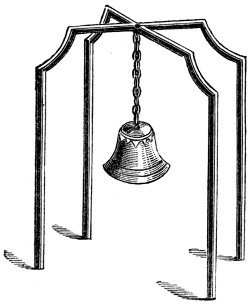
Is another novelty, formed by placing two hoops across each other, and fastening a bell at the point of intersection, which has to be struck by the ball passing through.
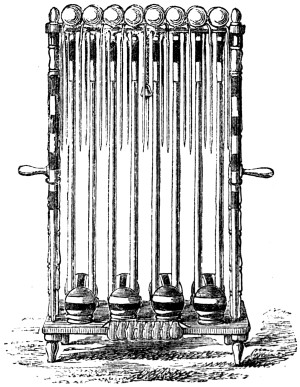
Is one of the best of the recent inventions in Croquet, and is to be recommended as a great improvement over the unwieldy box, which contains usually a Croquet set, and which is generally so badly arranged that a quarter of an hour is occupied in taking out the Croquet implements, and about double that time in replacing them after the game is over.
Sides are chosen in the usual manner, the captain of one side taking the first ball and the captain of the other the second; while the remaining balls are given to the other players in the order in which they are chosen. Eight persons can play at this game, but any smaller number will do equally well. If only six or four play, the same number of balls must be used; but if two play, the game is improved by each player taking two balls and playing them alternately as usual. If there be an odd number of players—either three, five, or seven—the players play against each other, or else one person takes[175] two balls and plays for each side. It has been suggested that to amuse a large party two games should go on at once, through the same hoops, one side to begin at the starting-post and the other at the turning-post. The confusion, however, caused by the balls getting in each other’s way would quite spoil all chance of good play.
Assuming that each player has a ball and a mallet, that the hoops are arranged in either of the three positions given on pages 177, 178, 179, 180, we now come to the mode of playing the game. The object is to drive the balls through all the hoops, in the direction indicated by the dotted lines on the diagrams, and to strike the two posts. The side all of whose members succeed in performing this feat first wins the game.
Now, although this is the chief object of the game, yet the act from which it derives its title, to wit “Croquet,” is of much greater importance than would at first be imagined. If a player hit with his ball any of the others, he is allowed to place his own against the ball he has struck, and setting his foot upon his own ball, he hits it with the mallet, and the force of the blow drives the opponent’s ball a considerable distance in the direction towards which the mallet is directed. As the player is allowed to croquet either friend or foe, it is evident that he can do a great deal of damage or service, according to his inclination, since he is at liberty to drive the ball in any direction he pleases. (See Rules of the Croquet, page 182.) It must, however, be borne in mind that no player can croquet or be croqued until he has been through the first hoop.
The holder of the first ball, placing his ball a mallet’s length in any direction from the starting-post, endeavours by striking it with the end of his mallet to drive it through the first hoop. If he succeeds, he continues his turn, and attempts to send the ball through the second hoop, and then through the third; for driving the ball through a hoop or croquing another ball imparts the privilege of an additional stroke. When he has finished, the second goes on, and the other players follow in the order in which the balls are marked upon the post. Till a player has gone through the first hoop he is not allowed to have an extra turn, if his ball hit that of another. In a short time is palpably shown the great advantage of the croquet. Often when a player has his ball in a good position in front of a hoop, another will hit it and drive it to the other end of the croquet-ground, compelling the croqued ball to take two or three turns before it can regain its former position. Occasionally two or three balls lie close to each other, and one is struck by a ball which was some distance off. The striker is now allowed to place his ball by the side of the one he has struck, and then, after croquing it, is almost sure of hitting the two others, since his last stroke has brought him very near to them.
The player who reaches the turning-post first has great advantages for a time, for as soon as he touches it he commences his return journey, and meeting the other players on their road to the farthest[176] point of their voyage, he is able to croquet them and considerably impede their progress. While writing about the turning-post, we cannot refrain from calling attention to a strange rule which appears in a recently-issued manual of Croquet. In this work it is stated that on touching the post the striker discontinues playing, and is not allowed for the act the same privilege that he obtains for passing through a hoop. This regulation is, we think, so unfair that we cannot allow this work to go to press without taking the opportunity of recording our protest against the adoption of the rule in question. It must be evident to anybody who knows anything about the game that it is a more difficult task to strike the post than to pass through a hoop. Now, touching the post is a point in the game, for it is one of the stations that everybody must pass on the journey; and as for each other point, such as passing a hoop or croquing, the player is allowed an additional turn, surely it stands to reason that the same advantage should be accorded to a player who performs the feat of striking the turning-post. Captain Mayne Reid and all the other writers on Croquet (with one exception) agree with us in the view we have taken on this subject, to which we have at some length drawn attention, in the hope that the author of the obnoxious rule will think fit to make the necessary alteration.
When a player has passed through all the hoops, he becomes what is called in the technical language of Croquet a Rover, and is privileged to rove about over the ground croquing his friends and foes (see page 185). It is therefore obvious that a good player can prove, when thus situated, of immense advantage to his side, and should on no account hit the starting or winning post till all on his side have passed through the last hoop (see page 191). Good players, however, generally content themselves with passing through all the hoops but two, as it often happens that if a Rover is tiresome his adversaries unite in their efforts to drive his ball against the starting-post, and thus kill him. This, of course, they cannot do until he has passed through all the hoops. The excitement towards the end of the game is almost inconceivable; each stroke is watched with the keenest interest. Gradually one by one the players hit the post, until perhaps only two remain, and now occurs an opportunity for skilful play. If the two opponents are good players, they afford a rare treat to the bystanders. The object of each is first to hit the post, and, failing in that, to keep as far off his adversary as he can. Both endeavour, at the same time drawing nearer to the great object in view, to keep the post between their own and the other ball. At length one plays at the post, misses it, and sends his ball near his adversary, who first hits it, next croquets it away, and then strikes the post, while all his side wave their mallets aloft, and loudly shout “Victory!”
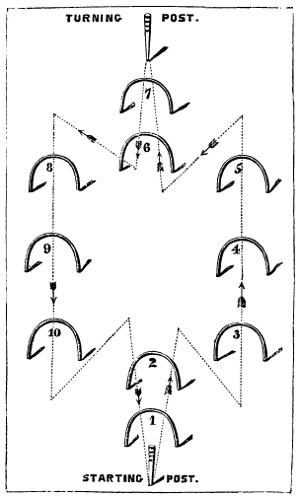
Diagram No. 1.—This position, which is the simplest of those we have drawn, is the one which we recommend all young players to adopt. The space between the hoops and between the hoops and the posts should be about six feet, although it can be varied in proportion to the capabilities of the different players. The course of the ball is indicated by the dotted lines, and the arrows show the direction in which at starting the ball should travel. Although it may appear rather a simple matter to go through the two first hoops by one straight stroke, yet the unfortunate player will soon find out his mistake by experience, and that, in attempting to pass through the hoops, “Slow and sure” is the best maxim to adopt.
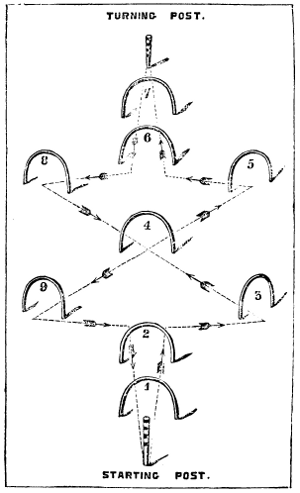
Diagram No. 2.—In this, the second, diagram it will be seen that the two centre side hoops are done away with, and that one is placed in the centre of the game instead: but although in the play we now require one hoop less than in the former diagram, yet the player will have to pass through the same number of hoops as before, since he travels twice through the hoop in the centre—once on his way to the turning-post, and once on his return. This position is necessarily not so simple as the last one, for now all chance of going through the three side hoops in one turn is done away with, and few players will be able to make the passage in less than three turns.
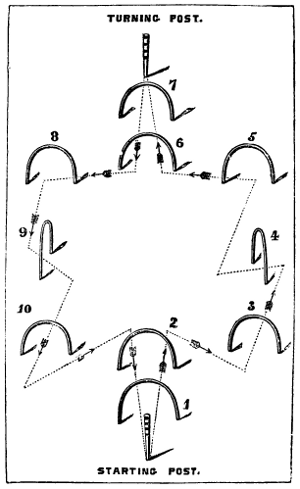
Diagram No. 3.—In this the same number of hoops is used as in the first diagram, but the hoops numbered respectively 4 and 9, instead of being placed parallel to the others, are now at right-angles to them: thus, in playing from 3 to 4, one has to keep to the right of the second ring, and then to pass through it from the outside of the game—a much more difficult arrangement than either of the other positions we have described. As the player’s knowledge of Croquet increases, many other positions will suggest themselves; but those we have printed are the simplest, and are the diagrams in general use at the present time.
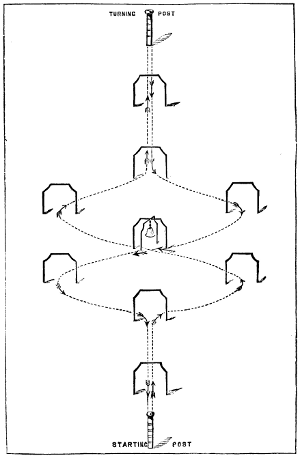
Diagram No. 4.—In this diagram the cage is introduced; otherwise it is nearly the same as Diagram No. 2.
The reader is now requested to give his attention to the following Rules, which we believe will be found to meet all the requisites of the game.
1. At the commencement of the game the ball is to be placed a mallet’s length from the starting-post in any direction, and the player endeavours to drive it through the first hoop.
[As the distance between the first post and the first hoop depends so much upon the size of the Croquet-ground, the first rule may be altered to suit the convenience of the players; but if the length is less than a mallet, the player will probably strike the post with his own mallet.]
2. In striking the ball, the player must stand on one side of the ball, and not behind it.
3. In striking, the mallet must be about an inch from the ground, and must not be pushed along it when the stroke is made, except when the distance between the ball and some other object is too small to admit the mallet lengthwise.
[Some players wish only one hand to be used in striking. Most of the large sets, however, are too heavy to allow this rule to be generally carried out.]
4. The ball must be struck with an end of the mallet, and not by the side.
5. The balls are to be played in the order in which they are marked upon the post.
6. If any player play out of his turn, he finishes the stroke; but for the violation of the last rule he is deprived of the next turn.
[It may perhaps be suggested that a player, seeing a good opportunity for some effective stroke, would purposely play out of his turn. This we doubt; for not only would the deprivation of his next turn do him a great deal of damage, but the chances are that one of the other players would stop him before he had commenced the stroke.]
7. If a player play with a wrong ball, he has to replace the ball and lose his next turn.
[This penalty is not enforced against a player if the error be not discovered before the arrival of his second turn.]
8. If a player by a stroke of his mallet drives his ball through the next hoop in the order of his course, he is allowed to continue his stroke.
9. A player may in one stroke drive his ball through more than one hoop.
10. If a ball, in going through a hoop, strike another ball, the player can either continue his stroke at the next hoop, or else croquet the ball that is struck; but he is not allowed two turns for passing through a hoop, and then hitting a ball.
11. If a ball strike another ball, and then pass through a hoop, the player can either croquet or continue his stroke, and has not to pass through the same hoop again.
[From this rule the reader may infer, that if a ball go through its hoop either by striking another ball or by hitting the sides of the hoop, it is considered to have passed the hoop.
It has been suggested that a ball is dead directly it croquets another, and that therefore any stroke it makes after that is of no avail; but as this not only does away with Rule 11, but prevents any player croquing two balls in one stroke, we cannot adopt it.]
12. If a ball, instead of playing at its hoop, play at a ball on the other side of the hoop, and consequently have to be moved by the hand through its own hoop in order to croquet, it is not considered to have gone through the hoop, but must return to the proper side of the hoop in the ordinary manner.
13. A ball is not through a hoop if the handle of the mallet when laid across the two sides of the hoop from whence the ball came touches the ball without moving the hoop.
14. If a player strike a ball which he cannot croquet, and by that stroke go through a hoop, the last stroke holds good, and he has another turn.
15. If a ball, when croqued through its hoop in a wrong direction, roll back through the hoop, it has not to pass through the same hoop in the same direction again.
[When the game of Croquet first came into fashion, there was only one mode of the croquet, which was that usually known as the tight croquet. Since then other forms, known as the loose and slipping croquet, have come into fashion, and have met with so much favour that it is impossible to deny their claims to our attention. In the tight croquet the player must keep his foot upon his own ball, and is not allowed to move it while he makes the stroke; but in the loose croquet he need not even put his foot on his own ball at all, and is able consequently to drive not only his adversary’s ball, but also his own, in any direction he pleases. The adoption of this plan, even although it lengthens and complicates the game, affords so much pleasure to the players themselves, that it is becoming universally adopted. Some writers, however, insist that to rovers only should the privilege of the loose croquet be accorded; whilst others, on the other hand, would allow the privilege only to those who are not rovers.[183] In fact, so much is to be said on each side, that the better plan is to allow the players to choose which of these courses they think fit to adopt. In some places, in addition to the loose croquet, a practice prevails which is usually known by the term “taking two off.” Thus if a player croquet a ball, he is allowed to drive his own ball in any direction he pleases, without touching the croqued ball. After this he has another stroke, so that he is enabled to get close to any ball on the ground. This plan seems to us so highly objectionable, and so thoroughly subversive of all good play, that we must decline to recommend it. It should also be known that many of our correspondents object to loose croquet altogether, on the ground that it tends greatly to prolong the turns, and thus spoils the game, as people, grown tired of waiting, lose all interest in it, and forget when their turn comes to play. What expressions more common on the ground than “Whose turn is it now?”]
16. A player is allowed the privilege of croquing whenever his ball strikes another, except when by doing so he makes the ball that is struck hit the winning-post, if it have passed through the hoops.
17. In the tight croquet the player must keep his foot firmly upon his own ball, and if the stroke move it the ball must afterwards be brought back to the position it occupied before it was struck.
[Some writers insist that if the croqueur’s ball slip, he loses his turn. This arrangement is too absurd to be tolerated for an instant.]
18. No ball can croquet, or be croqued, until it has passed through the first hoop.
[It has been the custom to allow a player to take up his ball, and play, when his turn comes, from the starting-post again, if he misses the first hoop. This plan, however, has nothing to recommend it. It would enable a player who wished to play last to do so at ease by intentionally missing the hoop, and is obviously so unfair that we have no wish to adopt it.]
19. No ball (except a rover) can croquet the same ball twice, until it (the croqueur) has passed through a hoop or touched the post since its first croquet.
[If, however, the croqueur be a rover, he cannot croquet the same ball twice in one turn. In either case, however, he is at liberty to strike the same ball twice, but this act does not allow him the privilege of a fresh stroke.]
20. A croquet need not necessarily be a distinct stroke. If the striking ball in its passage hit either a post or a hoop, and then cannon upon a ball, the privilege holds good; and if, also, one ball strike two or more others, each of these is croqued in the order in which they were struck; but the striker has only one additional stroke when he has croqued the lot, and not one for each ball he has struck.
21. As the moving of the croquing ball in the tight croquet is of itself illegal, it stands to reason that if this ball during the stroke[184] slip and touch another ball, the player has not the right to claim the privilege of the croquet.
[In the loose croquet a player may by his croquing stroke drive his own ball through a hoop.]
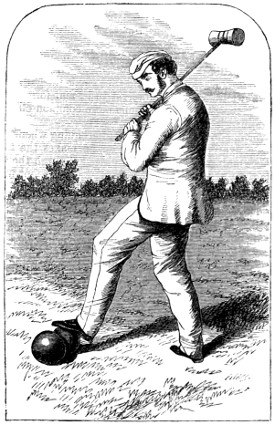
THE TIGHT CROQUET.
22. A player, after striking a ball, is not necessarily compelled to croquet it, but is allowed to play in any direction he pleases.
[It must, however, be understood that he must play from the place where his ball is, and not, since he abnegates the privilege of it, as after a croquet, from a position touching the ball he has struck.]
23. If a player hit a rover, and by the blow force the other ball against the winning-post, he cannot croquet the ball, as it is plainly[185] dead; he however retains the privilege of another turn. As the ball is dead, it must be moved at once.
24. If a player in the act of croquing do not move the croqued ball at least 6 inches, he is at liberty to take the stroke over again.
[Of course the croqued ball must be placed in the position it occupied before it was struck.]
25. If a ball go through a hoop and then croquet a ball, both strokes count.
26. If a player croquet a ball illegally, both balls must be restored to their former positions.
27. If a ball hit two or more balls by one stroke, and croquet one, it is forced to croquet all it has struck, and is not allowed to croquet one and leave the others alone.
Some writers give certain privileges for passing two hoops at a time, and for striking the posts—such as placing the ball a mallet’s length in any direction from its original position. This plan, however, is very irregular, and affords too great an advantage to one player to be adopted.
28. Striking the posts enables the player to have a fresh turn, and is in all respects equivalent to passing a hoop.
29. A player who, having gone through all the hoops, strikes the winning-post, is dead; and being out of the game, is not allowed to have a fresh turn.
30. If either of the posts be struck by a ball that is driven thither by a croquing or croqued ball, or in passing through the next hoop to it in the right direction, the stroke holds good.
31. If a ball be moved by a player when it should not have been touched, it must be restored to its former position, even if the stroke have sent it against a post or through a hoop.
32. If any ball (or balls) be struck by the ball moved, as in the last rule, it must be at once replaced in its former position.
33. If a ball, in the tight croquet, slip from under the feet and strike the turning-post, the stroke does not count.
[By the same rule, if a player in croquing strike the winning-post, the stroke does not count.]
34. If a ball be hit off the ground on a gravel-walk or a flower-bed, it is to be placed at once 12 inches at right-angles from the limit of the boundary.
35. As a rover has passed through all the hoops, he is not allowed to croquet the same ball twice in one turn.
36. A rover has only the right to play a second time when he croquets another ball.
37. A ball is dead as soon as it has passed through all the hoops and struck the two posts.
38. A rover who hits another ball, and then the post, is dead, and cannot take another turn.
[A rover who croquets another ball against the post is according to Rule 23 allowed another turn; but if a rover, in croquing a ball, lets his ball slip against the post, he is dead according to the principles of loose croquet.]
39. The game is finished when all the players on one side have gone through all the hoops and struck the two posts.
40. A match is the best of three games.
41. A tournament is the best of three matches.
It is almost impossible (as the reader will already have perceived) to overestimate the great importance that “the croquet” bears upon the game. A player who devotes all his efforts to pass through the hoops will find himself soon left behind by those who look upon that department of the game as merely subservient to the more fascinating task of driving away a foe, or of helping a friend; and this fact becomes more and more patent when the number of players is six or eight. True, when only two play, if one gets a good start, it is a somewhat difficult matter for the other player to stay his progress; and as this inevitably takes away half the interest of the game, we recommend a pair of players to use a couple of balls, since by so doing one can assist the other, and develop the croquet to great advantage; but then, again, it is not expedient to devote the whole of one’s energies to produce a collision between two balls. The player’s first rule should be to pass through a hoop; if, however, he sees an equal chance of passing through it after he has gone out of his route to drive an adverse player away, he should at all times make use of the croquet; for it must be remembered that keeping an enemy back is almost equivalent to making progress, and that the game cannot be lost as long as a foe’s ball is behind one’s own. The art of the tight croquet consists in placing the striking ball in juxtaposition to that ball which has been croqued, and then, setting the left foot upon his own ball, the striker hits it sharply with his mallet, and consequently the other ball is driven by the power of the stroke to a distance in proportion to the force with which the ball was struck. In the loose croquet, however, the player need not place his foot upon the ball at all, but by adopting the following stroke can drive the two balls forward in the same direction, or by hitting his own ball with a slanting mallet can drive the balls away at an angle to each other. The purpose of this feat is either to aid a friend or to do damage to an enemy. A friend can by croquing send a partner through the hoop he wishes to pass, or else drive an enemy—who[187] has obtained a good position, and who feels certain of going through a hoop at his next turn—exactly in the opposite direction to that in which he wishes to travel. In order, however, to make this stroke very effective, great care must be taken with regard to the way in which the ball is driven. Many thoughtless players think nothing of driving a foe close to a friend, or, in the hopes of assisting their side, send a friend in the immediate neighbourhood of a foe—thus improving the position of the adverse side, and damaging that of their own. The difference that a few thoughtful players make to a side is wonderful. Whilst others hit their balls about without ever thinking that at his next turn a foe will probably croquet them, the careful players, anticipating the positions of the other bails, place themselves in a position from which, when their next turn comes, they can either go through a hoop, or croquet the ball of a more careless player. Thus, if foe B is behind a hoop through which A has to pass, but requires two turns for the passage, it would be very absurd if A were to place himself close to B, in the hope of passing through next time, since B would be sure to croquet him, and place him in even a worse position than he occupies in the illustration. A should content himself by playing to C, for B would not go so far out of his way to croquet him, and then A could go through the ring the next time he plays.
If A is at the side of a hoop through which he cannot possibly[188] pass in one turn, he should play behind the ring to the spot marked B, and not in a line marked A C, or else he would probably go either too far or not far enough, and be forced to accomplish in three turns what, if he had gone to B, he could probably have done in two.
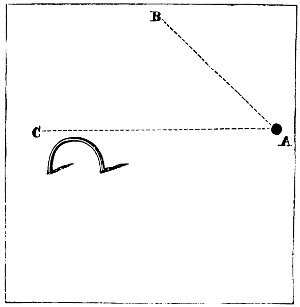
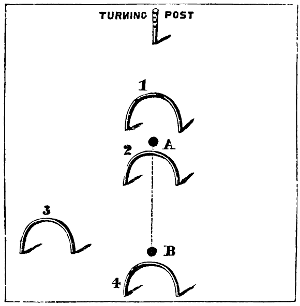
Suppose B to be placed in front of the fourth hoop (see Positions of Hoops, Diagram No. 2), and A, whose turn it is, to be behind No. 2;—many players would just go through No. 2, and then quietly drop down to No. 3, in the hope of passing through at the next turn. A thoughtful player, however, would, by driving his ball sharply through hoop No. 2, obtain a position close to B, and next, taking a second turn for going through the hoop, would be able to croquet B, and drive him a long way off his hoop, and then return to a good position behind No. 3.
The following position will show one of the advantages of the loose croquet. It is the turn of the ball C to play, and he has to go through the hoop e in the direction e A. In his present position it is impossible for him to go through the hoop at one turn. If, however, he croquets D, and then indulges in the loose croquet, he can drive his own ball to B, and send the other to A. He can then pass through the hoop, and can croquet D again at the spot A.
We have mentioned this problem more as an example for young players than because it is a recognised rule. Many such plans, equally advantageous to follow, will readily present themselves to players in the course of the game, and in no more forcible manner can they show their good play than by disregarding the passage of a hoop in order to croquet a foe and thus spoil his position. It can be easily understood that a player who, by passing through all the hoops, obtains the title of “Rover,” and may therefore rove wherever he pleases, has far more power than one whose flight is fettered by being compelled to pass through the little iron hoops that dot the Croquet-ground. He can either keep close to a laggard friend, and aid him by the croquet, or he can take up a position a little in advance[190] of a forward foe, and delay his progress in a very unpleasant manner. Suppose that A has just passed through the last hoop but two, and that B, a rover, has taken up a position close to the hoop, in such a manner that a portion of it intervenes between him and A. If, then,[191] the latter play near the hoop, B is sure to croquet him and drive him away. He is therefore compelled to keep some distance off the hoop until a friend comes to aid him, unless a change in his position allows him to croquet B, which, if the latter is a good player, is not likely to occur. Now, having shown how a rover can worry a foe, let us demonstrate how he can aid a friend. A is close to the hoop through which he has to pass, and B, a rover of his own side, is in a line with him. If B hit A, he will probably drive him off his hoop and spoil his turn; but if B play to C, a spot halfway between the two hoops, A can go through his hoop, croquet B at C, drive him to D, and then go through the next hoop, croquet B at D (for he has been through a hoop since he last croqued him), drive him to the other side of the next hoop, and so on. A rover playing with another ball can be of more help to him than hindrance to a foe; and as it is more important to get the balls of one’s own side forward than to delay those of a foe, the former plan should, when feasible, be adopted. Thus it will be seen that a good rover is of the greatest service to the side, and that the sooner he is placed hors de combat the better for the opposite side. The rovers on the other side should therefore do all they can to make the rover’s ball hit the post by croquing it against it, if possible; for although if all on his side hit the post before those on the other side the game is won, yet when the best player, being dead, is able to render no further assistance, the game often goes against that side. This plan, however, must be adopted with the greatest precaution and care, and on no account whatever should a bad player be thus disposed of, since the mere fact of keeping him in the game is of the highest importance, as his services are of little avail to his own side, who cannot win as long as one of their party remains in the game. With these few desultory hints we conclude this article, which all beginners should study carefully, and (we hope) with advantage.

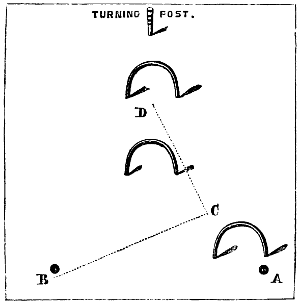
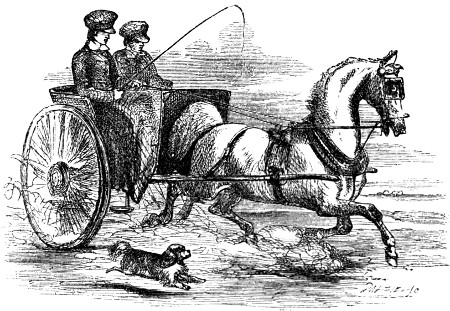
Our young friends ought to know, not only how to ride, but also how to drive. From the very earliest times, horse and chariot races were considered the noblest of sports, and Apollo is represented as driving the chariot of the sun. The four horses were typical of the four seasons of the year. Four horses driven abreast was common also to the Olympic games, and the Hippodrome was the scene of chariot races in which even a greater number was sometimes used.
It was, indeed, an imposing sight to see the Hippodromic course at the time of one of these chariot festivals. The place set apart for the contest was about a mile in length. Over a bar that ran across the entrance of the lists was placed a brazen dolphin, and upon an altar in the middle of the barrier stood an eagle of the same metal. By means of a machine, put in motion by the president of the games, the eagle suddenly sprang up into the air with its wings extended, so as to be seen by all spectators; and at the same moment the dolphin sank to the ground, which was a signal for the cars to arrange themselves in order for the race. Besides the statue of Hippodamia, and the table on which were placed the crowns and palm-branches, there were several images and altars in the course, particularly[193] that of the genius Taraxippus, who, as his name imports, was said to inspire the horses with a secret terror, which was increased by the shrill clangour of the trumpets placed near the boundary, and the deafening shouts and outcries of the multitude.
While the chariots were ranged in line ready to start, the horses, whose ardour it was difficult to restrain, attracted all eyes by their beauty, as well as for the victories which some of them had already gained. Pindar speaks of no less than forty chariots engaged at one and the same time. If we recollect that they had to run twelve times the length of the Hippodrome, in going and returning, and to steer round a pillar or goal erected near each extremity, we may imagine what confusion must have ensued when, upon the signal trumpet being sounded, they started amid a cloud of dust, crossing and jostling each other, and rushing forward with such rapidity that the eye could scarcely follow them. At one of the boundaries a narrow pass was left only for the chariots, which often baffled the skill of the expertest driver; and there were upwards of twenty turnings to make round the two pillars; so that at almost every moment some accident happened, calculated to excite the pity or insulting laughter of the assembly. In such a number of chariots at full speed, pushing for precedence in turning round the columns, on which victory often depended, some were sure to be dashed to pieces, covering the course with their fragments, and adding to the dangers of the race. As it was, moreover, exceedingly difficult for the charioteer, in his unsteady two-wheeled car, to retain his standing attitude, many were thrown out, when the masterless horses plunged wildly about the Hippodrome, overturning others who had, perhaps, previously escaped every danger, and thought themselves sure of winning. To increase the confusion, and thereby afford better opportunities for the display of skill and courage, there was reason to believe that some artifice was employed for the express purpose of frightening the horses when they reached the statue of Taraxippus. So great sometimes was their consternation, that, no longer regarding the rein, the whip, or the voice of their master, they broke loose, or overturned the chariot, and wounded the driver.
Such is the ancient description given by a Greek writer of the chariot races of the Hippodrome. We have no coach racing now-a-days, except omnibus racing in the streets: not a great deal of “coaching.” Now and then, indeed, we see the “Brighton four-horse,” and start with wonder at the sight. But still there are necessities for private driving, more important at the present than at any former period; and we hold driving to be not only a necessary, but an indispensable accomplishment to every young gentleman.
A horse fully equipped in harness, attached to a dennet or stanhope, is one of the most beautiful things to look at in the world:[194] few boys are trusted to drive a pair; nor have they physical power for the task. We will therefore confine our attention chiefly to single harness, adding only a short description of the various kinds of carriages in common use. If, however, the youthful charioteer can drive a single horse well, he will find no difficulty in controlling a pair, provided their mouths are sufficiently tender for his strength to manage. The horse is here represented harnessed to a light dennet-gig.
May be either a full-sized harness horse, or a galloway, or a pony; the two last being the best fitted for juvenile driving.
In every case, is composed of the same parts, which consist of three essential divisions: 1st, the driving, or guiding part; 2d, the drawing part; and 3d, that for holding up the shafts. The driving part comprises the bridle and reins. The bridle is made up of a front piece (1), a head piece (2), two cheek pieces and winkers (3), a nose band (4), and a throat lash (5). The cheek pieces are buckled to the bit (6) by means of leather loops, called billets, as also are the driving-reins (7), and the bearing-rein, which is attached to a separate bit called the bridoon (a plain snaffle), and then is hooked to the pad-hook. This is now very generally dispensed with, as shown in the cut at the head of this article; but for young drivers it is often desirable when they have not strength to check the fall of a horse. The drawing parts consist of a padded oval ring fitted to the shoulders, and called the collar (10), sometimes replaced by a padded strap across the chest called the breast-strap. On the collar are fastened two iron bars called hames (12), by means of a strap at the top and bottom (8-11), and these hames have a ring in the[195] upper part for the reins to pass through, called the hame terret (9); and nearer the lower part, a strong arm of iron covered with a coating of brass, silver, or leather, which receives in its eye the tug of the trace (13.) The trace (17) is a long and strong strap of double leather, stitched, which runs from the collar to the drawing bar, and may be lengthened or shortened by a buckle. The part for holding the gig up consists of a pad or saddle, which is buckled on to the horse by the belly-band (16), and from which the shaft is suspended by the back-band and shaft-tug. It is prevented from slipping forward by the crupper, which is slipped over the tail. Besides these parts, some horses have in addition a breechen (18-19) which holds the shafts back in going down hill; and when they are addicted to kicking, a strap is buckled over their hips to the shaft which is called a kicking-strap.
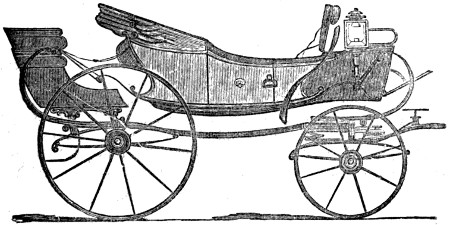
THE BRITZSCHKA.
The Dennet-gig, as represented in the last page, is the most common form for a two-wheeled carriage; but there are also the Stanhope, the Cabriolet, as here shown, the Tilbury, and the Dog-cart. The various open four-wheeled carriages are the Britzschka,[196] Barouche, and Phaeton; and of closed four-wheeled carriages there are the Brougham and Clarence on elliptic springs, and the chariot and family coach with c springs. When these two last are made to open, they are called the Landaulet and Landau.
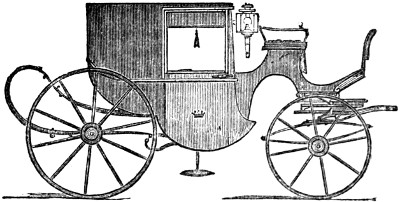
NEW BROUGHAM.
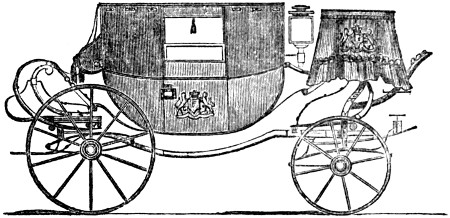
THE FAMILY COACH.
Before driving, it is necessary that the horse or pony should be “put to,” which is effected as follows: 1st, slip the shafts through the tugs, or, if there are hooks, drop them down into them; 2d, put the traces on to the drawing-bar, either hooking them on, or else slipping them on to the eyes, and being careful to place the leather stops in these, to prevent the trace coming off; 3d, buckle the belly-band sufficiently tight; and 4th, buckle the kicking-strap, or breechen, if either is used. After this, the reins are taken from the terrets, where they were previously placed, and the horse is ready.
In driving, the reins are held differently from the mode already described as used in riding, the fore-finger being first placed between[197] them, and then both the reins are grasped by all the other fingers, and the near-side rein is also held firmly against the fore-finger by means of the thumb. In this way, on an emergency, the near or left rein may be pulled by itself, by holding it firmly with the thumb, and suffering the other, or off rein, to slip through the fingers, or vice versâ. The most usual way is to pull the left rein with the left hand, and the right with the right hand, by hooking one or two fingers over it while held firmly in the left. In this manner, with the whip also held in the right hand, the horse is guided or stopped. The young driver should take care and keep his feet well before him, with his knees as straight and firm as possible, so that in case of a fall of the horse he may not be thrown forwards out of the vehicle he is driving. He should also sit square to his work, with his elbow held easily to his side, and his left thumb pointing to his horse’s head, by which, as in riding, his elbow is pretty sure to be properly placed. The bit should not be too firmly pulled against, but a light and “give and take” kind of handling is the best, by which the horse is allowed freedom of action, and yet is checked if he makes a mistake. In meeting other vehicles, the rule is to keep to your left, and in passing them, to leave them also on your left. This should be rigidly adhered to for fear of the accidents which would otherwise constantly happen.
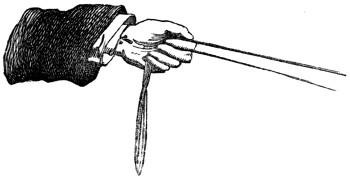
In reference to driving in America, nothing better can be given than the rules of the English school for driving. In America the rule governing the side to pass another rider on is the reverse of the English rule. In America the law is “drive to the right.” In England it is to the left. The former appears to us to be the “right” one.
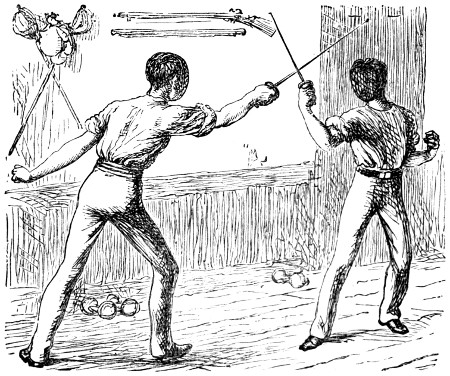
Fencing is the art of using the small-sword or rapier. The small-sword has a straight blade, about thirty-two inches in length, outside the guard, and is fashioned for thrusting only. Although it is an art of the greatest antiquity, very great improvements have been made in it during the last half-century, chiefly by French masters, who excel those of all other countries. This has been attributed to various causes; by some to the agility and acknowledged power of rapid physical action possessed by this nation; by others, to their natural vivacity and mental quickness. In my opinion, however, a more direct and powerful cause may be traced in the great encouragement and universal patronage which it has ever received from every grade of a chivalrous and military people. Every regiment has its maître d’armes, and every barrack its fencing-school. Indeed, in so important a light was the proper teaching of this art held, that one of the French kings (Louis XIV.) granted letters-patent to twenty eminent masters, who alone were permitted to teach in Paris. When a vacancy occurred, no interest and no favour could enable a candidate to obtain this privilege: he had to fence in public with six of these chosen masters; and if by any of them he was beaten by two distinct hits, he was considered unqualified to teach in the capital.[199] Independent of its value as the scientific use of the sword,—the gentleman’s weapon of defence, par excellence,—fencing stands unrivalled as an exercise; and it is in this sense that it will now be treated. The most eminent physicians which this country have produced have all, in the most earnest manner, recommended it to the attention of the young. Thus, Dr. Clive says:—
“Muscular exertion is essential in perfecting the form of the body, and those exercises which require the exercise of the greatest number of muscles are the most conducive to this end. Fencing causes more muscles to act at the same time than most other exercises. It promotes the expansion of the chest, and improves respiration, whereby the functions of the most important organs of the body are more perfectly performed.”
Sir Anthony Carlisle uses similar language:—
“According to my judgment, the exercise of fencing tends to promote bodily health, and the development of athletic powers. It is likewise apparent, that the attitudes and exertions of fencing are conducive to the manly forms and muscular energies of the human figure.”
Again, Sir Everard Home, in still stronger terms:—
“Of all the different modes in which the body can be exercised, there is none, in my judgment, that is capable of giving strength and velocity, as well as precision, to the action of all the voluntary muscles of the body in an equal degree as the practice of fencing, and none more conducive to bodily health.”
I shall give one more extract from another physician of equal eminence, Dr. Babbington:—
“I am of opinion that, in addition to the amusement which this exercise (fencing) affords, it is particularly calculated to excite in young persons a greater degree of energy and circumspection than they might otherwise possess; and it is obvious that, in respect of health, that mode of exertion is superior to all others, which, while it gives motion and activity to every part of the body, produces at the same time corresponding interest in the mind.”
Sir John Sinclair, Dr. Pemberton, &c., speak in terms equally recommendatory.
To avoid all danger in the lessons and practice, foils are substituted for real swords. Strong wire masks are worn on the face, a well-padded glove on the hand, and the upper part of the body, at which alone the thrusts are aimed, is protected by a strong jacket, the right side and collar of which should be of leather.
The first movement a beginner has to learn is the manner of placing himself in the position called
It is from this position that all movements are made, whether offensive or defensive. Let the beginner be placed with his knees[200] straight, his feet at right angles, heel to heel; the right foot, right side, and face directed to the master. The body must be held upright and firm, the arms hanging down by the side, but easily and without constraint; the left hand holding the foil a few inches beneath its guard. Next let him bring the right hand across the body, and seize the foil-handle; by a second movement, bring the foil above the head, the hands separating as they ascend, until both arms be nearly extended upwards and outwards. Here pause. This may be called the first position of the Guard.
These movements should be frequently practised, as they accustom the arms to move independently of the body, flatten the joints of the shoulders, and give prominence to the chest.
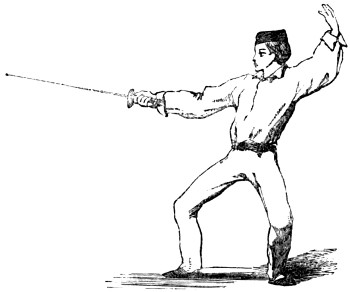
To arrive at the second position of the Guard, the right arm, with the foil, is brought down to the front, until the right elbow is a little above and in advance of the waist; the fore-arm and foil sloping upwards; the point of the foil being the height of the upper part of the face; then, by a second movement, the learner must sink down, separating the knees, and stepping forward with the right foot fourteen or sixteen inches; for, of course, the guard of a tall man will be wider than that of a short one. However, his own comfort in the position will direct him as to the distance; and the general rule is, that the knee of the left leg will jut over the toes of the left foot, and the right leg from ankle to knee be perpendicular. It is in this position that he will receive all attacks from an adversary, and from this position will all his own attacks be made. Also in this position will he
upon an adversary, when beyond hitting distance. The step in the advance is usually about that of the width of the Guard, although of[201] course this would vary with circumstances. The step is made by advancing the right foot the distance I have named; and on its reaching the ground, the left foot is brought up, and takes its place. To
the reverse of the above movement is made. The left foot takes the lead, stepping to the rear about as far as the right had stepped to the front; the right occupying its place on its taking up its new position. The next movement,
is a very important movement, and is rather difficult to make properly, and fatiguing to practise. Indeed, the first movements in fencing are the most trying to the learner; and he must not be discouraged if he fails to do them correctly at first—practice only will give him this power. The Longe is that extension of body which accompanies every attack, and is thus made: The right arm is extended straight from the shoulder, the arm and blade being on the same level; by a second movement, the right foot is raised from the ground, and a step made forward, about eighteen inches in length, while the left remains firmly planted in its place. At the instant that this step is made, the left hand is allowed to fall within a few inches of the left thigh, and the left knee is stiffened back until the leg is perfectly straight.
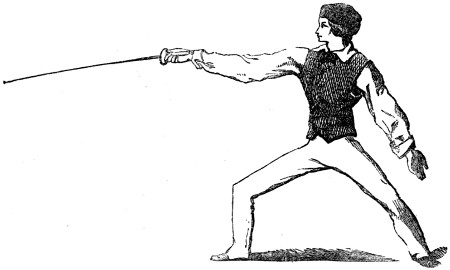
The thigh of the right leg will now be in a position nearly horizontal; from the knee downwards, perpendicular. Having executed the Longe, the next movement to be made is
that is, to return from the position of the Longe to that of the Guard,[202] and is thus effected: The left arm is nimbly thrown up to its place, the right arm drawn in, and the left knee re-bent. These movements must be made at the same time, as it is their united action that enables a person to recover from so extended a position as the Longe quick enough to avoid a thrust if his own attack has failed.
These movements must be frequently practised before any others are attempted—the Guard, the Advance, the Retreat, the Longe, and the Recover; and when the learner has attained some proficiency in them, he may begin the more delicate movements of attack and defence. Of these I will now speak.
It is customary for adversaries, on coming to the Guard, to Engage, or to join blades, on what is called the inside, that is, the right side; although there are occasions on which it is advisable to engage on the outside, or on the left; otherwise called the Quarte or Tierce sides.
Two men thus opposed to each other will at once perceive that there are two lines of attack open to them, i. e. the line inside and the line outside the blade—these, and no more. But these may be, and in fencing are, subdivided into inside above the hand, and inside under the hand, and the same subdivision for outside. This gives four lines of attack—or, to speak more simply, gives four openings through which an adversary may be assailed. Now, to protect each of these assailable points, are four defensive movements, called
Each opening has its own parade or defence, and each parade will guard its own opening, and, strictly speaking, no other. The opening inside above the hand is defended by two parades.
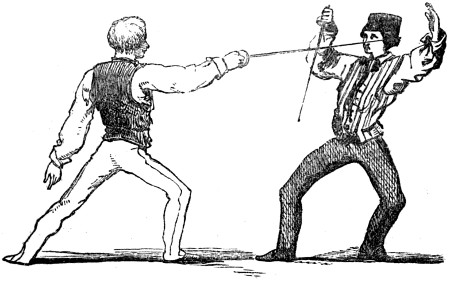
As its name imports, the first and most natural parade is that of[203] Prime. The action of drawing the sword from its sheath is almost exactly the movement made use of in the parade of Prime.
In this parade, the hand is raised as high as the forehead, so that the fencer can see his opponent’s face under his wrist. The blade of the foil is almost horizontal, but the point is rather lowered towards the ground. As this parade will throw the right side of the body open to the adversary’s sword, it is good play to disengage from left to right, and deliver a rapid thrust at the adversary, in order to anticipate him before he can bring his own sword round for another thrust. His point will be thrown far out of line, so that he is behind-hand in point of time.
This is a very useful parade for fencers of short stature, as they can sometimes get in their blade under their adversary’s arm, after they have parried his thrust.
The other parade is that of
It is thus formed. On the approach of the point of an adversary’s blade (and how these approaches are made I will presently explain), the right hand is moved a few inches—three or four will be enough—across the body on the inside; the hand being neither depressed nor raised, and the foil being kept on the same slope as in the Guard. This guards the body on the inside above the hand, but (and here comes an important law in fencing) the very movement which has guarded the body on one side has exposed it on the other: this is the case with all the simple parades.
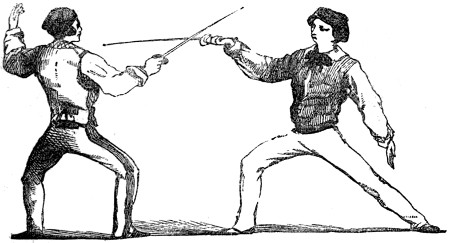
Suppose, now, that the exposed part outside above the hand were assailed, then the defence for it is the parade of
It is formed by turning the hand with the nails downwards, and[204] crossing to the opposite side some six or eight inches; the hand and point at the same elevation as before: this will guard this opening. If, however, the attack had been made under instead of over the hand, then the proper parade would have been Seconde.
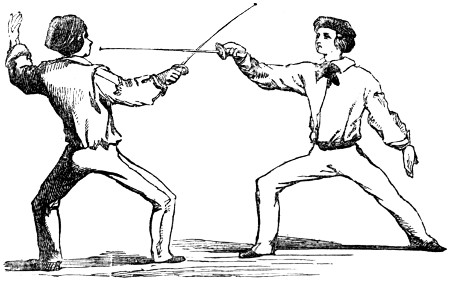
There is another method of parrying, called Quarte, over the arm, which is executed by making almost the same parade as in Tierce, with this exception—first, the hand is retained in its original position, with the nails upwards; and, secondly, the point is not raised above the eye of the adversary.
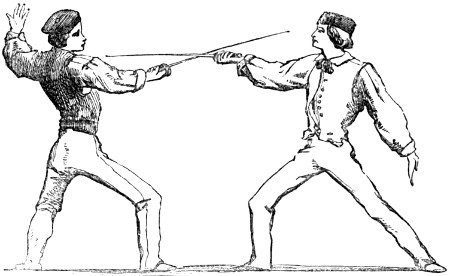
It is rather more delicate than tierce, but wants its power and energy. The Ripostes, or reply thrusts, are made, as they would have been had the parade been that of Tierce.
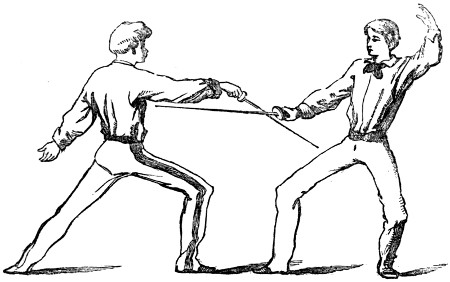
is formed by turning the hand in the same position in which it was turned for Tierce, but the point of the foil slopes as much downwards as in Tierce it did upwards; the direction and distance for the hand to traverse being the same. Again, had the attack been delivered at none of these, but at the inside under the hand, then the proper parade would have been
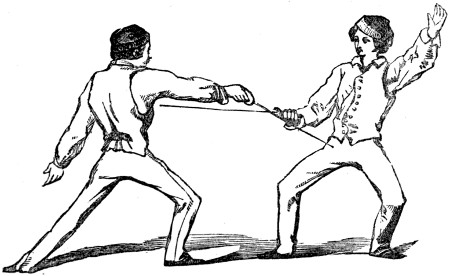
which, as its name expresses, is a half-circle, described by a sweep of the blade traversing the under line. Next comes the parade of
In this parade the hand is held as in Quarte; the hilt of the foil is kept lower than that of the opponent; the blade is almost horizontal, the point being only slightly lower than the hilt, and directed towards the body of the adversary.
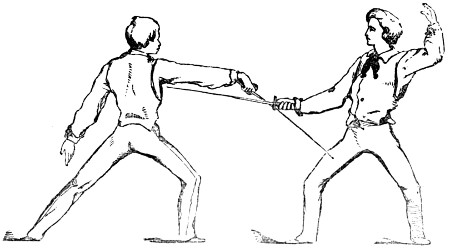
Octave is extremely useful when the fencer misses his parade of Demi-cercle, as there is but a short distance for the point to traverse, and it generally meets the blade of the adversary before the point can be properly fixed. Moreover, it brings the point so near the adversary’s body, that he will not venture to make another thrust until he has removed the foil.
Thus I have enumerated, and partly explained, the forms and uses of these four parades: they are called Simple Parades, to distinguish them from another set of defensive movements, called
I have said and shown that a man standing foil in hand, in the position of the guard, is exposed in four distinct places to thrusts from an adversary within longing distance. I have also shown that he has a defence for each of these exposed places; but if a man has but one defence for each assailable part, then his adversary, knowing beforehand what the defence must be, would be prepared beforehand to deceive him. But if he has a reserve—if he has a second defence for each part, then the adversary cannot tell what the defence will be, until his attack, false or real, is begun.
To meet this contingency, a second series of defences have been devised, which are of an entirely different nature from the Simple Parades.
Again, as each of the simple parades is framed to guard only one opening, it was found desirable that the contre-parades should be of a more comprehensive character. They are therefore devised so that each is capable of protecting the entire front. It is evident that this object could not be attained without the sacrifice of quickness, because a larger space must be traversed, and therefore more time is occupied with a contre than a simple parade.
To know one contre-parade is virtually to know all, as they are all formed on the same plan. They are all full circles in the position of hand and direction of foil of the different simple parades; or more clearly speaking, each simple parade has a contre-parade; there are, therefore, four simple and four contre-parades, which may be thus arranged:—
| Quarte | Contre de Quarte. |
| Tierce | Contre de Tierce. |
| Seconde | Contre de Seconde. |
| Demi-cercle | Contre de Cercle. |
I have said that a contre-parade is a full circle in the position of hand and direction of blade of its simple; thus, contre de quarte is made by retaining the hand in the position of quarte, while the foil describes a circle descending on the inside, and returning by the outside to the place of its departure. So with all the others, the foil following the direction of the simple parade, of which it is the contre. These complete the entire system of defences.
I now come to movements of an opposite nature, namely, the
and shall begin with the most simple of them. I will again suppose two adversaries standing, en guard, within longing distance of each other: now the most simple movement that the attacking party could make would be,
to the outside or inside, according to his line of engagement. I have, in describing the longe, in effect described the straight thrust; it is but a longe in a straight line, taking care, however, to feel firmly the adversary’s blade, but taking care also not to press or lean on it during the delivering of the thrust.
Next in character comes
This attack is made by dropping the point of the foil beneath the adversary’s blade, and raising it on the opposite side, at the same time, rising with the arm fully extended; on the completion of the extension the longe is made and the thrust delivered.
is but a double disengagement, the first being but a feint or false attack, to induce the adversary to form a parade to cover the part threatened, for the covering of one part of the body exposes the opposite: the second disengagement is made to take advantage of this exposure. The arm is extended halfway on the first, and then wholly on the second, to be immediately followed by the longe.
This is another variety of attack. Supposing the adversary’s blade to be firmly joined to yours, when you wished to deliver a straight thrust, there would then be danger of your falling upon his point. This danger is avoided by giving a slight beat on his blade the instant preceding your extension of arm, of course to be followed en suite by the longe.
The companion attack to this attack is
The beat here takes the character of the first disengagement in one-two, i. e. becomes a feint, and is intended to induce the adversary to return to the place he occupied when the beat was made. You then immediately pass to the opposite side of his blade in the manner described in the disengagement.
It will be seen that all these movements pass under the adversary’s blade. However, there are certain situations in the assault, as a fencing bout is called, when an adversary is more assailable over the point than under the blade; for this purpose there is what the French call the coupé sur point, or
It is thus made: By the action of the hand, and without drawing it back at all, the foil is raised and brought down on the opposite side of the adversary’s blade, the arm being extended during its fall to the horizontal position, on attaining which the longe is delivered.
is on the same principle as the one-two and the beat and disengagement. On the adversary opposing the first movement (the cut) with a parade, the second movement (the disengagement) is made to the opposite side, to be followed of course by the longe; the extension of the arm being divided between the two movements.
These attacks are called simple attacks, because they may be parried by one or more simple parades, according to the number of movements in the attack. In fact, every attack can be parried, and every parade can be deceived: it is the additional movement last made which hits or guards.
Thus, you threaten by a disengagement to the outside; your adversary bars your way effectually by the parade of tierce; you make a second disengagement to the inside, which is now exposed from the very fact of the outside being guarded (for both lines of attack cannot be guarded at the same time), thus converting your attack into one-two; but if your adversary parries quarte on your second movement, your attack would be warded off. This can be carried much further, but the above will, I think, be sufficient to explain the nature of simple parades and attacks.
To deceive a contre-parade, a separate movement, called a doublé, or
has been invented; it is very simple in principle, and admirably answers the purpose. For instance, if you were to threaten your adversary by a disengagement to the outside, and if, instead of tierce, he parried contre de quarte, the double is then made by your making a second disengagement to the same side as the first, for it will be found that his contre de quarte has replaced the blades in the positions they occupied previous to your disengagement. You will then have an opening, and may finish the attack by the longe.
As all the contre-parades are on the same plan and principle, so are all the doubles. Of course, it is understood that you will make all the movements of the double en suite, and without allowing your adversary’s blade to overtake yours.
The foregoing movements having been well practised in the lesson, the next step is that of all feints and all parades, and may be practised either with a master or fellow-pupil. The practice consists of one pupil standing on the defensive entirely, while another assumes the offensive, and attacks him with all the feints of which he is master, the other, of course, defending with all his parades. It is excellent practice, as it accustoms the pupil to think for himself gradually, he having thus but one set of movements to think about. He is therefore enabled to make them boldly, without having to encounter unknown movements from his adversary.
It also enables him to see the extent of his resources, both for attack and defence. When he can both attack and defend with some presence of mind, he may then begin
that is, he may encounter an adversary, to attack or defend as occasion presents. He is then left to his own resources entirely. The following
given by a very eminent fencer and excellent teacher, cannot fail to be of use:—
“Do not put yourself on the position of the guard within the reach of your adversary’s thrust, especially at the time of drawing your sword.
“If you are much inferior make no long assaults.
“Do nothing that is useless; every movement should tend to your advantage.
“Let your movements be made as much within the line of your adversary’s body as possible.
“Endeavour both to discover your adversary’s designs, and to conceal your own.
“Two skilful men, acting together, fight more with their heads than their hands.
“The smaller you can make the movements with your foil, the quicker will your point arrive at your adversary’s body.
“Do not endeavour to give many thrusts on the longe, thus running the risk of receiving one in the interim.
“If your adversary drops his foil by accident, or in consequence of a smart parade of yours, you should immediately pick it up, and present it to him politely.
“Always join blades (if possible) previously to another attack, after a hit is given.”
The principal distinction between the broadsword and the rapier is, that the latter is formed only for thrusting, while the former is adapted for cutting also. Indeed, those who use the broadsword are, in my opinion, too apt to neglect the use of the point, and to give their attention almost exclusively to the cuts.
The first lesson in the sword exercise is necessarily to know how to stand. The learner should be instructed to perform the different movements by word of command, remembering to consider the first parts of the word as a caution, and not to stir until the last syllable is uttered. At the last syllable, the movement should be performed smartly. In giving the word, the instructor always makes a slight pause, in order to give his pupils time to remember what they must do. For example, the words Draw Swords, is given thus, Draw . . . . . Swords—the word swords being spoken smartly, in order that the movement may correspond.
First Position.—Make the target[3] about fourteen inches in diameter, and place it on the wall, having its centre about four feet from the ground. Draw a perpendicular line from the spot at the bottom of the target to the ground, and continue it on the floor, in order to ensure the proper position of the heels. The learner stands perfectly upright opposite the target, with his right side towards it, his heels close together, his right toe pointing to the target, and his left foot at right angles with the left. His arms must be clasped behind his back, his right palm supporting the left elbow, and his left hand grasping the right arm just above the elbow. In this position, he must bend both knees and sink down as far as possible. This will not be very far at first, but he will soon sink down quite easily. See accompanying figure (1).
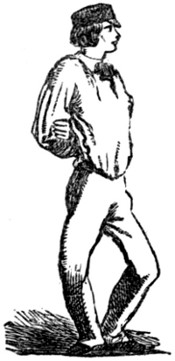
Fig. 1.
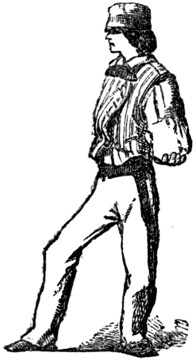
Fig. 2.
Second Position.—This is accomplished by placing the right foot smartly in front, about sixteen or fourteen inches before the left. See (2). He must accustom himself to balance himself so perfectly on his left foot, that he can place the right either before or behind it, without losing his balance.
Third Position.—The third position must then be learned. This consists in stepping well forward with the right foot, until the left knee is quite straight, and the right knee exactly perpendicularly placed over the right foot. Great care must be taken to keep the heels exactly in the same line, and the body perfectly upright. See Figure (3).
These preliminaries having been settled, the learner stands upright before the target, as in (1). A sword is then put into his hand, and the target is explained as follows:—
The interior lines represent the cuts. Cut one being directed from No. 1 diagonally through the target, coming out at 4. Cut two is the same, only from left to right. Three is made upwards diagonally, and four is the same, only in the opposite direction. Cut five is horizontally through the target, from right to left, and six from left to right.[213] Cut seven is perpendicularly downwards. Care must be taken that the cuts are fairly given with the edge.
The swords drawn on the target represent the guards. The seventh guard ought, however, not to be made directly across, but must have the point directly rather forwards and downwards, as a cut 7 glides off the blade, and can be instantly answered either by a thrust or by cut 1.
The two dark circles represent the places where the thrusts take effect.

The learner begins by taking the sword in his right hand, having its edge toward the target and its back resting on his shoulder. His right arm is bent at right angles, and the elbow against his side. The left hand must rest upon the hip, the thumb being to the rear. At the word—
Cut 1.—The young swordsman extends his right arm, and makes the cut clear through the target. When the point has cleared the target, continue the sweep of the sword, and by a turn of the wrist bring it with its back on the left shoulder, its edge towards the left. The arm is then ready for
Cut 2.—Bring the sword from 2 to 3, continue the movement of the sword, and turn the wrist so that the point is below the right hip and the edge towards the ground.
Cut 3.—Cut through the target diagonally, bringing the sword from No. 3 to No. 2, and bring the sword onwards, so that it rests with the edge downwards, and point below the left hip. At
Cut 4.—Cut from 4 to 1, and bring the sword round until its point is over the right shoulder, and its edge well to the right.
Cut 5.—At the word Five, make a horizontal cut from 5 to 6, and sweep the sword round until it rests on the left shoulder, with its edge to the left, and its point well over the shoulder.
Cut 6.—Cut horizontally through the target, from 6 to 5, and bring the sword over the head, with its edge upwards, and its point hanging over the back. From this position,—
Cut 7.—Make a downward stroke until the sword reaches the centre of the target. Arrest it there, and remain with the arm extended, waiting for the word
First Point.—Draw back the sword, until the right wrist is against the right temple, the edge of the sword being upwards. Make a slight pause, and then thrust smartly forward towards the centre of the target, raising the right wrist as high as No. 1, and pressing the left shoulder well back.
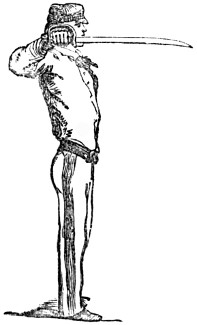
FIRST POINT.
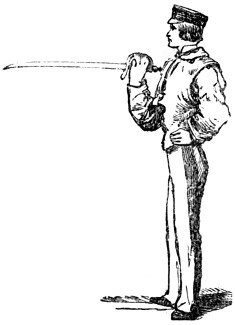
SECOND POINT.

FIRST POINT.

SECOND POINT.
Second Point.—Turn the wrist round to the left, so that the edge comes upwards, draw the hand back until it rests on the breast, and give the point forwards, to the centre of the target, raising the hand as before.
Third Point.—Give the handle of the sword a slight twist in the hand to the right, so that the edge again comes uppermost, and the guard rests against the back of the hand. Draw back the hand until it rests against the right hip, and deliver it forwards towards the spot at the bottom of the target, raising the wrist as high as the spot in the centre. The object in raising the wrist is to deceive the eye of the opponent, who will be more likely to notice the position of your wrist than of your point. In all the thrusts, the left shoulder[215] should be rather brought forward before the point is given, and pressed well back while it is being delivered.
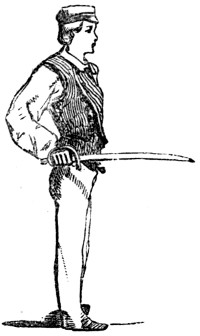
THIRD POINT.
Wait after the third point has been delivered for the word
Defend.—At this word draw up the hand smartly, and form the first guard. Make the other guards in succession as they are named, while the instructor proves their accuracy by giving the corresponding cuts. The guards must be learned from the target, by placing the sword in exactly the same position as those delineated. The guards are these:—
The two spots H and I mark the places towards which the points are made, H for the first and second point, I for the third.
The parry or parade of a thrust is executed with the back of the sword. The firmest way of parrying is to hold the sword perpendicular, with its edge to the right and its hilt about the height of and close to the right shoulder; then, by sweeping the sword round from left to right, any thrust within its sweep is thrown wide of the body.
The parry is executed with the wrist and not with the arm, which must not move.
When the pupil is acquainted with both cuts and guards, he should learn the hanging guard, a most useful position, as it keeps the body well hidden under the sword, and at the same time leaves the sword in a good position to strike or thrust.
It is accomplished in the following way. Step out to the second position, as in Figure 2, raise the arm until the hand is just over the right foot, and as high as the head. The edge of the sword is upwards, and the point is directed downwards and towards the left. The left shoulder is pressed rather forward, and the neck and chest drawn inward.
In this position, the swordsman is in a position to receive or make an attack as he may think fit. It is rather fatiguing at first, owing to the unaccustomed position of the arm and head, but the fatigue is soon overcome, and then it will be found that there is no attitude which gives equal advantages.
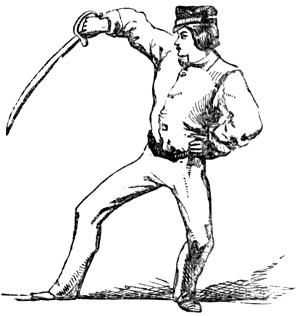
HANGING GUARD.
There are two other modes of standing on guard, each possessing their peculiar advantages. These are, the inside and outside guard. The inside guard is made as follows:—
Stand in the second position, having the wrist of the right hand nearly as low as the waist, the hand being exactly over the right foot. The point of the sword is raised as high as the eyes, and the edge is turned inwards, as will be seen from the accompanying engraving.
The outside guard is formed in the same manner as the inside, with the exception that the edge of the sword is turned well outwards.
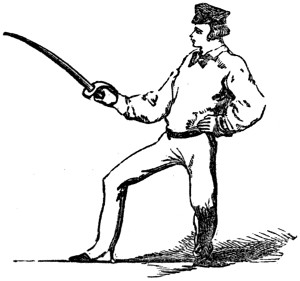
OUTSIDE GUARD.
To get to the hanging guard, the words are given as follows:—inside guard—outside guard—guard.
The swordsman having learned thus far, is taught to combine the[218] three movements of striking, thrusting, and guarding, by the following exercise:—
The young swordsman must remember that in this, as in all the exercises, the cuts and points must be given in the third position, as in the accompanying illustration, which shows the swordsman just as he has delivered the seventh cut, and is waiting for the next word before he resumes the first position.
The guards, on the contrary, are given in the first position, as is seen in the figure on p. 219, which illustrates the seventh guard.
These exercises are always learned with the single-stick, or basket-hilted cudgel, in order to avoid the dangers which would be inevitable if the sword were used. But as the single-stick is only an imitation of the sword, I will give the method of getting the sword out of the sheath into any position required.
The first word of command is draw swords. At the word draw, seize the sheath just below the hilt, with the left hand, and raise the hilt as high as the hip, at the same time grasping the hilt with the right hand, turning the edge of the sword to the rear, and drawing it partially from the sheath, to ensure its easy removal.
At the word swords, draw the blade smartly out of the scabbard, throwing the point upwards, at the full extent of the arm, the edge being still to the rear.
The wrist is now smartly lowered until it is level with the chin, the blade upright, and the edge to the left. This is the position of recover swords. The elbow must be kept close to the body, as in the cut.

RECOVER SWORDS.
The wrist is now sharply lowered until the arm hangs at its full length, the wrist being in the line with the hip, the edge of the sword to the front, and its back resting in the hollow of the shoulder, the fingers lightly holding the hilt. The left hand hangs at the side until the word inside guard, when it is placed on the left hip.
At the word swords, raise the right hand smartly, until it forms a right angle at the elbow.
At the word, raise the blade until it is perpendicular, move the hilt to the hollow of the left shoulder, drop the point of the sword into the scabbard (which has been grasped by the left hand and slightly raised,)[220] at the same time turning the edge to the rear. Pause an instant, and send the sword smartly into the sheath, removing both hands as the hilt strikes against the mouth of the scabbard: drop them to the side, with the palms outwards, and stand in the first position.
There are many exercises with the broadsword, called Practices. I have given one of them, which is to be practised alone; but when the pupil has attained some confidence in the use of his weapon, he must be placed opposite another pupil, and they must go through them, each taking the attack and defence in turn.
The young swordsman must be provided with a very stout wire mask, which defends the face and part of the neck, and which should be worked in a kind of helmet above, to guard against the disastrous consequences of receiving the seventh guard. No practices, loose or otherwise, should be permitted without the masks, as neither party would be able to cut or thrust with proper confidence.
This is very useful in teaching the point and parry, as well as giving steadiness on the feet. Two boys are placed opposite each other, at just such a distance, that when perfectly erect they can touch the hilt of their adversary’s sword with the point of their own.
The one who gives the first point is called Front Rank, (there may be a dozen in each rank, each having tried the distance to his right by extending his sword,) and the one who gives first parry is called Rear Rank.
| WORD OF COMMAND. |
FRONT RANK. | REAR RANK. | ||||
|---|---|---|---|---|---|---|
| Guard. | Hanging Guard. | Hanging Guard. | ||||
| Third Point. | Prepare to give Third Point. | Prepare to Parry. | ||||
| Point. | - | Give Third Point, and when parried spring back to First Position, and prepare to parry. |
- | Parry Third Point, and prepare to give Third Point. |
||
| Point. | - | Parry Third Point, and prepare for Third Point. |
- | Give Third Point, and prepare to Parry. |
||
| Point, &c. &c. | ||||||
This should be continued until both are weary. Both swordsmen should learn to do it more rapidly every time they practise. Next time of going through it, front rank and rear rank change places, as they must do in all the practices.
| WORD OF COMMAND. |
FRONT RANK. | REAR RANK. |
|---|---|---|
| Guard. | Hanging Guard. | Hanging Guard. |
| Leg. | Cut Four. | Cut Seven. |
| Inside Guard. | Inside Guard. | Inside Guard. |
| Leg. | Cut Six [at Leg]. | Cut Six [at Neck]. |
| Outside Guard. | Outside Guard. | Outside Guard. |
| Leg. | Cut Five [at Leg]. | Cut Five [at Neck]. |
| Guard. | Hanging Guard. | Hanging Guard. |
| Slope Swords. | Slope Swords. | Slope Swords. |
In this and the other practices, the cuts must be delivered in the[221] third position, and the guards in the first. In the third and fourth practices, the cuts must be given lightly, as many of them are not intended to be guarded, but merely to show the powers of the sword in various positions.
| WORD OF COMMAND. |
FRONT RANK. | REAR RANK. |
|---|---|---|
| Guard. | Hanging Guard. | Hanging Guard. |
| Head. | Seventh Cut. | Seventh Guard. |
| Head. | Seventh Guard. | Cut Seven. |
| Leg. | Fourth Cut. | Seventh Guard. |
| Leg. | Seventh Guard. | Fourth Cut. |
| Head. | Seventh Cut. | Seventh Guard. |
| Head. | Seventh Guard. | Seventh Cut. |
| Guard. | Hanging Guard. | Hanging Guard. |
| Slope Swords. | Slope Swords. | Slope Swords. |
In this and the preceding exercise, the power of shifting the leg is shown. If two swordsmen attack each other, and No. 1 strikes at the leg of No. 2, it will be better for No. 2 not to oppose the cut by the third or fourth guard, but to draw back the leg smartly, and cut six or seven at the adversary’s head or neck.
In loose play, as it is called, i. e. when two parties engage with swords without following any word of command, but strike and guard as they can, both players stand in the second position, because they can either advance or retreat as they choose, and can longe out to the third position for a thrust or a cut, or spring up to the first position for a guard with equal ease.
It is often a kind of trap, to put the right leg more forward than usual, in order to induce the adversary to make a cut at it. When he does so, the leg is drawn back, the stroke passes harmless, and the deceived striker gets the stick of his opponent on his head or shoulders.
We now come to a very complicated exercise, called the
| WORD OF COMMAND. |
FRONT RANK. | REAR RANK. |
|---|---|---|
| Draw Swords. | Draw Swords. | Draw Swords. |
| Inside Guard. | Inside Guard. | Inside Guard. |
| Outside Guard. | Outside Guard. | Outside Guard. |
| Guard. | Hanging Guard. | Hanging Guard. |
| Head. | Seventh Cut. | Seventh Guard. |
| Head. | Seventh Guard. | Seventh Cut. |
| Arm. | Second Cut [at Arm]. | Second Guard. |
| Head. | Seventh Guard. | Seventh Cut. |
| Head. | Seventh Cut. | Seventh Guard. |
| Arm. | Second Guard. | Second Cut [at Arm]. |
| Head. | Seventh Cut. | Seventh Guard. |
| Head. | Seventh Guard. | Seventh Cut. |
| Right Side. | Sixth Cut. | Sixth Guard. |
| Head. | Seventh Guard. | Seventh Cut. |
| Head. | Seventh Cut. | Seventh Guard. |
| Right Side. | Sixth Guard. | Sixth Cut. |
| Guard. | Hanging Guard. | Hanging Guard. |
This practice is capital exercise, and looks very imposing. All these practices ought to be so familiar, that the words of command are not needed, the only word required being First, Second, or Third Practices, as the case may be.
I remember once, that two of my pupils had attained such a mastery of their weapons, that we used often to go through the practices with real swords. On one occasion, we were acting a charade, and my eldest pupil and myself were enacting the part of two distinguished foreigners (country unknown) who were to get up a fight. So we began by a little quarrel, and finally drew our swords and set hard to work at the fifth practice, which we could do with extreme rapidity, and without the use of words of command. The spectators were horrified, and the ladies greatly alarmed; for there seems to be no particular order in that practice, and an inexperienced eye would certainly fancy that the combatants were in earnest.
The half of the sword blade next the hilt is called the “fort,” because it is the strongest place on which the cut of an adversary can be received. Always parry and guard with the fort of your sword, as, if you try to guard a cut with the “feeble,” which is the remaining half of the blade, your guard will be forced, and the cut take effect.
The drawing cut is made best with a curved sword, and is executed by placing the edge of the sword on the object, and drawing it over it until it is severed. A good large mangel worzel is capital practice. Place the root loose on a table, stand at arm’s length from it, lay the edge of the sword lightly on it, and slice the root by repeatedly drawing the sword over it. This is very difficult, although it looks easy enough, and is sure to jar the arm from the wrist to the shoulder the first time or two, while the sword glides off as if the root were cased in polished steel. However, a little practice will soon overcome the difficulty. This cut is much in use among the Sikhs.
Never look at your own sword, but watch the eye and sword wrist of your opponent.
Remember that the great point in this exercise, as in fencing, is to gain time. Endeavour, therefore, to advance your point nearer your adversary than his is to you.
Begin the assault out of distance, so that neither party can complain of being taken by surprise.
If the two parties exchange a cut or a thrust at the same moment, the one who gave his cut or thrust in the third position is victorious.
When a cut or thrust is made, the one who receives it passes his sword, i. e. stick, into his left hand, and his opponent comes to inside guard.
Always spring back to the second position after delivering a cut or thrust.
Keep the line of direction carefully, or you will leave an open space for the adversary to get his sword into.
Last and most important, Don’t lose your temper.
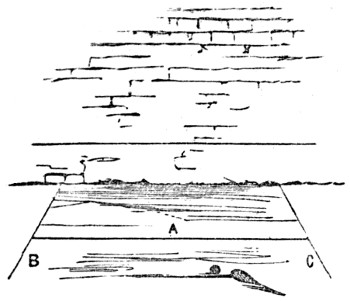
It is impossible to play at this excellent game unless there be a high wall, free from abutments, and a smooth, dry, paved ground before it. When this can be procured, a line is drawn on the wall, about 38 inches from the ground; another line is drawn on the ground, about 10 feet from the wall, A; and two others are drawn on each side as boundaries, B C. The instruments used in the play are a ball of tightly-sewn leather and a fives-bat. It has a long handle, and an oval bowl of wood. The ball is hard, rebounding, small, and white. The game may be played by two or four people; in the last case, two on each side. The method of play is as follows:—The game may be played either single-handed or with partners. When it is played with partners, the players toss up for innings. The first player takes the ball, and strikes it against the wall with his bat above the line on the wall, and so that it may fall without the line on the ground. The other then strikes it, and the players continue to hit it against the wall, either before it comes to the ground or at the first bounce, until one of them missing it, or driving it out of bounds, or beneath the wall-line, loses or goes out. Of course the ball may fall anywhere within the side boundaries, after being once struck up by the player who is in. The game is usually fifteen, but is sometimes extended to twenty-five. The game above described is that known as bat-fives, and differs little from the game of rackets, except that it may be played in any open court, and that a differently-shaped bat and a larger ball are employed. Fives was originally played with the hand, instead of a racket, and in the fourteenth century was called Hand Tennis in England, and in France, Palm Play. It is said to have obtained the name of Fives, from ten of the Earl of Hertford’s servants having played before Queen Elizabeth, five of a[224] side; but more probably on account of the five fingers of the hand. This game of “hand-fives” is the one ordinarily played by boys, and known technically as “fives.” The ball is hit against the wall entirely by the hand, and no bat of any description is used. The game may be played by two or more people, and is usually fifteen. Players with tender hands usually play with an ordinary kid or padded glove, either of which is quite admissible. There are variations of the game at different schools, owing to peculiarities in the shape of the courts. At Eton, for instance, a buttress of the chapel abuts into the court, and the Eton courts at Oxford are made on a similar plan. But the game as ordinarily played is that as described above.
Uncertain as to the date of its origin, there is no English game which is at once so popular and about which so much difference of opinion exists. All agree as to its manly character, its capabilities for endurance, activity, hardihood, and strategical skill, but there are very few who agree entirely as to the rules by which the game should be played.
In ancient records there is no mention of the game before the reign of Edward III.; and at that period it seems to have been so popular that by royal edict it was put down, as being antagonistic to the royal amusement of archery. But that it flourished, and flourished considerably, beyond that date, there is no doubt. In many market-towns of England and Scotland, and notably in that of Kingston-on-Thames, all business is suspended on Shrove Tuesday, and a great game of foot-ball is played in the market-place. All is officially conducted, and the mayor is honoured with the privilege of “kick-off.”
It would seem a pity at first sight that there is no authority like that of the Marylebone Club to revise the laws of foot-ball and insist upon their being observed in all places where the game is played. Foot-ball as now constituted is not, and cannot be, a national game. There are hardly two schools in England that agree in its first principles, and that are not continually wrangling and disputing as to how the game should be played. To touch the ball with the hands is in some eyes a heresy, and in others an uncommon virtue. Some schools advocate running with the ball, while others consider such licence as antagonistic to the proper principles and well-being of the game. And, indeed, looking round at the various head-quarters of foot-ball in England, it really does seem a difficult matter to reconcile the games as now played so as to suit all tastes. Rugby and Eton foot-ball can hardly be looked upon as the same game.
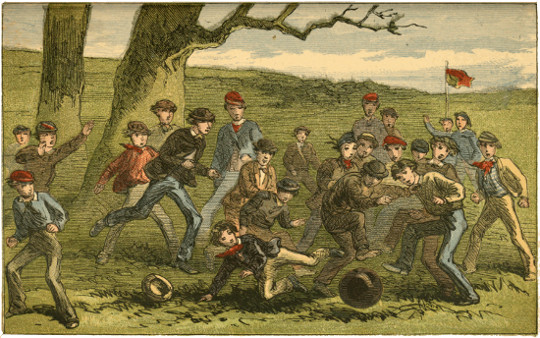
FOOTBALL.
We have one set of people advocating the employment of only eleven, or at most twenty, players on a side, and another maintaining that a hundred or so on a side matters little. We have one school playing the game against a brick wall, another using boundaries of canvas, another dashing the ball about in narrow cloisters, and another marshalling a little army of players, with regularly organized back and forward players, reserve forces, vanguard, scouts, runners, all of whom have their direct influence on the fate and fortunes of the game.
The great essentials for foot-ball are pluck, endurance, and good temper. Half the disputes at foot-ball which are ascribed to “hacking” and “shinning” would not have occurred had good temper been observed. No one “hacks” or “shins” wilfully, except he loses his temper; and a player in foot-ball, as in other games, who cannot keep his temper is unfit in every way to enjoy the game. As a match at foot-ball is now made, two parties, containing any number of competitors, take the field, and, having tossed up for sides, stand between two goals, placed at a distance of some eighty yards apart. The party that loses the toss has the privilege of “kick-off.” The goal is marked by two upright poles, driven into the ground about ten yards apart. The ball, which used formerly to be made of a blown bladder, is now made of an inflated vulcanized india-rubber case, inclosed again in a case of laced and well-sewn leather. The object of each party is to drive the ball through the goal of their antagonists. The skill of the players is best employed in attacking and defending the goals.
In the game of football the fewer the rules, and the simpler those rules are, the better. The great “bone of contention” with lovers of the game is, as to whether players should be allowed to touch the ball with their hands or not. Eton and Westminster players will be arguing for ever that the game is foot-ball, and not hand-ball; while Rugbæans, on the other hand, will contend that without the use of the hands as well as the feet the game is robbed of one of its principal charms. In the following rules a medium course is advocated, as, while nothing looks so bad as to see a lazy or inactive player, who does not care to follow the ball, playing fives with it whenever it comes within his reach, it would be equally absurd to stop a player who catches the ball fairly either on the full or first bound from running a yard or so with it in his hands, in order to allow him to get up the necessary impetus for a strong drop-kick. With regard also to “off-side,” it is essentially necessary that some clear and definite rules should be laid down. What can possibly look worse than to see a player, again one of those who are too indolent to “follow up” the ball, coolly stand in the middle of the course, or, worse still, at the very door of his neighbour’s goal, waiting until the ball is kicked up to him, in order that he, fresh and full of wind as he is, may follow it in to the goal? It is hoped that the[226] following rules may give general satisfaction, and prevent disputes and obstacles:—
1. A goal may be obtained by a fair full kick or drop-kick off the hand, provided the ball goes over the bar which runs between the goal-posts; or a goal may be obtained by a fair foot-ball “bulley,” which sends the ball through all obstacles anywhere between the posts.
2. The foot-ball course must be marked by side boundaries. When the ball is kicked outside these boundaries, a player of either side may kick it into the course again in a straight line from where it went out.
3. A player who shall not have been behind the last player on his own side who kicked the ball shall be considered “off his side.”
4. No player who shall be “off his side” shall be allowed to kick the ball until it shall have touched one of the opposite side, when he becomes on his side again, and may join in the game.
5. A player who obtains a fair catch of the ball, either full or on the first bound, may take a short run, in order to obtain a “drop-kick,” or may kick it at once full off his hands.
6. Any player of the opposite side may use his best endeavours to prevent a drop or full kick after a fair catch.
7. No “holding” must be allowed at any period of the game.
8. No “shinning” or “hacking” is to be allowed.
9. At the commencement of the game the captains of each side shall determine mutually how long the game is to last.
10. At the end of the time, no matter in what position the game is, one of the captains shall cry “no game,” and the game shall immediately cease.

Golfing is played with a club and ball. The club is from three to four feet long, according to the height and length of arm of the player. It is curved and massive towards the end, to give strength and weight. This knob is formed for strength from some very tough wood, as beech, and as it curves and proceeds upwards is planed off, so as to adapt itself to the handle, to which it is partly glued and tightly corded down. A want of due attention to these particulars in the making of it will render the head liable to split and fly off by either a very hard or indirect stroke. The face of the club is further secured by a piece of hard bone, and occasionally of ivory, at least half an inch thick. It is also loaded with from four to six ounces of lead, according to the will of the player. The handle is usually bound with cord, list, or velvet, at the pleasure of the owner. It is, however, to be remembered, that the form of the club, the materials of which it is made, and the numbers taken to the golfing ground, vary considerably, according to the circumstances and habits of the[227] players, the attendant cad or caddie having usually many varieties, to suit every peculiarity under which the ball may be placed; for in many clubs it can never be touched by the hand until holed.
The golf ball is about the size of an egg, and is made very hard. It is composed of stout leather, which, having been previously soaked in boiling water, allows of its being first very firmly sewed, and then turned inside out, leaving a small opening only, by which it is very forcibly stuffed with feathers. The leather being yet wet, it contracts into a ball of the dimensions stated, but never gets circular, as that used in the game of cricket. It is afterwards painted over with several coats of white paint; in doing which it is requisite that the lead used should be very pure and exceedingly well ground down, as well as that each coat laid on should be perfectly dry and hard before another is applied.
The game is played by two or more persons, so that there be an equal number on each side; but only two balls are used, one belonging to each party, each party also striking in turn: but if the last striker does not drive his ball as far as that of his opponent, one of his party must then strike one, or perhaps two more, and the game is thus marked by calling out one, two, or three more, as the case may be. If more than two are playing, the same person does not strike twice in succession: a miss is considered one. The party who puts the ball into the hole in the fewest strokes wins the game.
The grounds used for this sport vary in different parts of Scotland. Some are nearly square, in which case a hole is made in each corner; but if it be irregular in figure, it is not uncommon to place one at each angle, so that the party shall traverse the whole surface, and finish at the spot from whence he started; a quarter of a mile being usually allowed between each hole. Besides the stick, or club, already described, there are others, usually carried by an attendant for each party. These are called, by way of distinction, putters—of which, however, there are several sorts, one being short, stiff, and heavy, similar in figure, but longer on the head, for making a steady and direct stroke when near the hole. Another, formed of iron, instead of wood, is used for making a hit at a ball when very unfavourably placed, as in a rut, where the common club would be in danger of breaking. When a ball falls into a hole or rut, from which it is impossible to strike it out, the party is allowed, by a special agreement, in some clubs, to take it out with his hand, and throw it up in a line with the spot, which is accounted as one, and he then strikes from where it chances to rest; but, as already observed, this indulgence does not extend to every Golfing Society.

The study of Gymnastics is of the utmost importance to young persons, as its object is to call into exercise, and to train to perfection, all the corporeal or bodily powers. It is the education of the limbs, joints, and muscles; and includes not only the systematic training of these, but also assists the sciences of riding, driving, wrestling, rowing, sailing, skating, swimming, &c.
In the following gymnastic exercises we have determined to introduce only those more simple and useful feats which may be said to make up the “Alphabet of the Science,” and all the individual and progressive exercises are susceptible of being everywhere introduced. They may be performed in very small spaces, and require no particular preparation, expense, or place. By attention to the directions any pupil between the ages of twelve and sixteen may train and exercise himself, and a number of other children younger than himself; and this excellent study may thus become a source of amusement and delight.
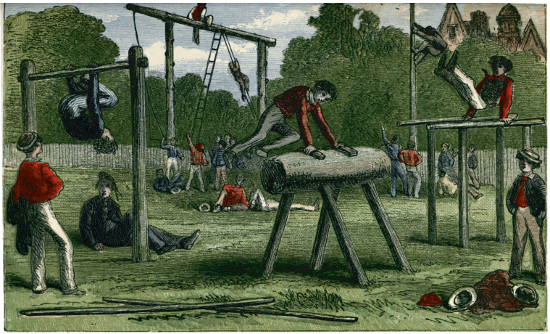
GYMNASTICS.
The first gymnasium is said to have been established at Sparta, and some years afterwards at Athens. In the former city the exercises partook of a rude military character; but among the Athenians, who were always disposed to mingle the elements of the beautiful in whatever they undertook, gymnastics were refined, and the Gymnasia became temples of the Graces. In each there was a place called Palæstra, in which wrestling, boxing, running, leaping, throwing the discus, and other exercises of the kind were taught. Gymnastics were afterwards divided into two principal branches—the Palæstræ, taking its name from the Palæstra, and the Orchestræ. The former embraced the whole class of athletic exercises; the latter dancing, and the art of gesticulation and declamation.
The Gymnasia were spacious edifices, surrounded by gardens and a sacred grove. Their principal parts were: 1. The Portices, furnished with seats and side buildings, where the youths met to converse. 2. The Ephebeion, that part of the edifice where the youth alone exercised. 3. The Apodyterion, or undressing room to the Conisterium, or small court in which was kept the yellow kind of sand sprinkled by the wrestlers over their bodies after being anointed with the aroma, or oil tempered with wax. 5. The Palæstra properly was the place for wrestling. 6. The Sphæristerium, where the game of ball was played. 7. Aliterium, where the wrestlers anointed themselves with oil. 8. The Area or great court, where running, leaping, and pitching the quoit were performed. 9. The Xysta, open walks in which the youths exercised themselves in running. 10. The Balanea, or baths. Behind the Xysta lay the Stadium, which, as its name imports, was the eighth of a mile in length; and in this were performed all sorts of exercises, in the presence of large numbers of persons and the chiefs of the state.
To all these branches of gymnastics the Grecian youth applied themselves with peculiar eagerness, and on quitting the schools devoted to them a particular portion of their time, since they regarded them as a preparation for victory in the Olympic and other games, and as the best possible means for promoting health and ripening the physical powers; nor could anything be better adapted for those whose heroism was liberty, and whose first great aims were to be good citizens and the defenders of their country.
The Romans never made gymnastics a national matter, but considered them merely as preparatory to the military service; and, though forming a part of the exhibitions at festivals, they were practised only by a particular class trained for brutal entertainments, at which large bets were laid by the spectators, as is still the custom on our own racecourse: but when all the acquisitions of the human intellect were lost in the utter corruption of the Roman empire and the irruptions of wandering nations, the gymnastic art perished.
The commencement of tournaments during the Dark Ages in some degree revived athletic exercises; but the invention of gunpowder, the use of the small sword, the rifle, and scientific tactics, by which battles were gained more by skill than force, kept down the training of the body for athletic feats. But in the last century, when men broke loose from the yoke of authority, and education began to be studied, it was found that physical education had been forgotten. Salzmann, a German clergyman, invented a system of physical exercises, principally confined to running, leaping, swimming, climbing, and balancing; and at the commencement of the present century a German of the name of Volker established the first gymnasium in London, while Captain Clias, a Swiss, established one in the Royal Military Asylum; and since then many of the best schools and colleges have a gymnasium attached to their establishments.
It generally happens that the pupils of a gymnasium, after a time, lose their interest in the exercises. The reason of this appears to be that little or no difference is made in the exercises of different ages, and it is natural that an exercise repeated for years should become wearisome. Gymnastics, therefore, when they are taught, should be divided into two courses. In the first course we would include walking and pedestrian excursions, elementary exercises of various tests, running, leaping in height, in length, in depth, leaping with a pole (in length and height), vaulting, balancing, exercises on the single and parallel bars, climbing, throwing, dragging, pushing, lifting, carrying, wrestling, jumping (1. with the hoop; 2. with the rope), exercises with the dumb bells, various gymnastic feats or games; and, lastly, swimming, skating, fencing, riding on horseback, rowing, &c.
Gymnastic exercises may be begun by a boy of about eight years of age, or may be commenced at any age; but in all cases he should begin gently, and proceed gradually, without any abrupt transitions. They should be commenced before breakfast in the morning, or before dinner or supper; but never immediately after meals: and the pupil should be very careful, after becoming heated by exercises, of draughts or cold, and especially refrain from lying on the damp ground, or from standing without his coat or other garments; and rigidly guard against the dangerous practice of drinking cold water, which, in many instances, has been known to produce immediate death.
In all gymnastic exercises walking, running, and jumping deserve the preference, because they are the most natural movements of man, and those which he has most frequent occasion to use. This exercise, within the reach of everybody, ought to be placed among the number[231] of those which are direct conservators of health, and which have the most important beneficial effects upon our mental and moral economy. Walking provokes appetite, assists digestion, accelerates the circulation, brings the fluids to the skin, strengthens the memory, and gives cheerfulness to the mind, and in fatiguing the limbs gives repose to the senses and the brain.
It might be supposed that every one knows how to walk: not so, however; some persons crawl, some hobble, some shuffle along. Few have the graceful noble movement that ought to belong to progression, or, however well formed, preserve a really erect position and an air of becoming confidence and dignity. To teach walking—that is to say, to teach young persons to walk properly—we should advise a class of them to unite, that they may be able to teach themselves, which they may readily do if they follow the instructions given below.
A company of boys being formed, the eldest, or the one best adapted to the task, should act as captain, and at the word of command, “Fall in,” all the boys are to advance on the same line, preserving between each the distance of about an arm’s length. At the word “Dress” each boy places his right hand on the left shoulder of the next, extending his arm at full length, and turning his head to the right. At the word “Attention” the arms fall down by the side, and the head returns to the first position. The captain should now place his little regiment in the following manner:—1. The head up. 2. The shoulders back. 3. The body erect. 4. The stomach in. 5. The knees straight, the heels on the same line. 6. The toes turned very slightly outwards. The captain now stands before his men, and advancing his left foot, his knee straight, and his toe inclined towards the ground, he counts one, two, placing his boot on the ground, the toe before the heel; he then directs his pupils to obey him, and to follow his motions, and says, “March,” when each foot is advanced simultaneously, till he gives the word “Halt.” He then makes them advance, wheel to the right and left, in slow time, quick time, always observing the position of the body, and requiring that they move all together.
This movement is preparatory to running and jumping. The boys being in line, the word “On tip-toes” is given: each boy places his hands on his sides, and waits for the word, “Rise;” when they all gently raise themselves on their toes, joining their heels together, and keeping the knees straight, remain in this position till the word “Rest” is given, when they fall back slightly on their heels, their hands at the same time falling down by their sides. Proceeding in this manner through a few courses, with such changes as may present themselves, the pupils will soon acquire a habit of[232] graceful walking, of the highest importance to every one who studies a gentlemanly bearing.
Running is both useful and natural; it favours the development of the chest, dilates the lungs, and, when moderate, is a highly salutary exercise. To run fast and gracefully one should as it were graze the ground with the feet, by keeping the legs as straight as possible whilst moving them forward. During the course the upper part of the body is inclined a little forward, the arms are as it were glued to the sides, and turned in at the point of the hips, the hands shut, and the nails turned inwards. The faults in running are swinging the arms, raising the legs too high behind, taking too large strides, bending the knees too much, and in not properly managing their wind. In all running exercises the young should begin gradually, and never run themselves out of breath at any time. By careful practice a boy may soon acquire the power of running a mile in ten minutes; this is called moderate running: in what is called prompt running a thousand yards in two minutes is thought very good work, and in quick running 600 yards in a minute is considered good. The first distance that children, from eight to ten years of age, may be made to run is about 200 yards; the second, for those more advanced, 300 yards; and the third, for adults, 400 yards. It is however most essential, that in running boys should not over-tax their strength or “wind.” We are not all constituted alike, and a boy who could last for 200 yards or so might injure himself considerably by racing for a mile.
Of all the corporeal exercises jumping is one of the most useful; and during our lives very many instances occur of a good jump having done us essential service. To jump with grace and assurance one should always fall on the toes, taking care especially to bend the knees on the hips: the upper part of the body should be inclined forwards, and the arms extended towards the ground. The hands should serve to break the fall when jumping from a great height. In jumping we should hold the breath and never alight on the heels. Boys should exercise themselves in jumping, by jumping in length, and jumping from a height, with attention to the above cautions. They may make progressive exercises in length by varying the distance from time to time, and in height by jumping from a flight of stairs or steps, increasing a step at a time: they will soon be able to jump in length three yards, and from a height six feet, without injury.
Leaping is somewhat different to what is called jumping, as the object is to pass over an obstacle; and, as in jumping, it is of great importance to draw in the breath, while the hands should be shut, the arms pendent, to operate after the manner of a fly-wheel or pendulum. It may be practised by a leaping stand, which can be easily made of two sticks or stakes sunk in the ground, in which little catches are made at various distances, on which an even piece may be laid, that may readily be knocked over, so as to offer no resistance to the jumper, and injure him by an ugly fall.
The principal exercises in leaping are:—1. The high leap without a run. 2. The high leap with a run. 3. The long leap without a run. 4. And the long leap with a run. In the first of these the legs and feet are closed, the knees are bent till the calves nearly touch the thighs, and the arms are thrown in the direction of the leap, which increases the impulse. This leap may be practised at the following progressive heights,—eighteen inches, twenty-four inches, thirty-two inches, forty-eight inches, which last is perhaps what few lads would attain.
The high leap with a run.—The run should never exceed twelve paces, the distance between the point of springing and the obstacle to leap over to be about three-fifths the height of the obstacle from the ground; and in making it the leaper should go fairly and straightly over without veering to the side, and descend on the ball of the foot just beyond the toes. The heights that may be cleared by the running leap vary from three to six feet. A good leaper of sixteen years old ought to leap four feet six inches, and an extraordinarily good leaper five feet. Adults well trained will leap six, and some have been known to leap seven feet.
The long leap without a run.—The long leap may be marked out from four to eight feet, according to the agility and strength of the leaper; and the object to be cleared, a small block of wood, which should in this kind of leap be never more than six inches high, placed midway. In leaping the body is bent forward, the feet are closed, the arms first sway forwards, then backwards, and then forwards at the moment of taking the leap. In this kind of leap ten or twelve feet is considered good work.
The long leap with a run.—The run should be on firm level ground. The body should be inclined forward, and the run consist of about twelve paces, a small block of wood, as before, being placed mid distance in the leap. The spring should be principally on the right foot, and the arms should be thrown forwards at the time of the leap. In descending, if the leap be a very long one, the leaper should descend principally upon his toes; if the leap be not very long, he may descend on the balls of the toes. The leap is considered good if fifteen feet be cleared, but twenty may be done by a good leaper, and one or two individuals have fairly reached twenty-three feet.
Vaulting.—Vaulting is performed by springing over some stationary body, such as a gate or bar, by the aid of the hands, which bear upon it. To perform it, the vaulter may approach the bar with a slight run, and placing his hands upon it, heave himself up and throw his legs obliquely over it. The legs should be kept close together: while the body is in suspension over the bar, the right hand supports and guides it, while the left is free. The vaulter may commence this exercise with a bar or a stile three feet high, and extend it gradually to six feet.
Leaping with a Pole.—A great variety of leaps may be practised with a pole, which should be of a sufficient length, and shod at one end with iron, so as to take hold of the ground. The leaper should grasp with his right hand that part of the pole a little below the level of his head, and with his left that part of it just below the level of his hips; he should then make a slight run, and, placing the pole on the ground, take a spring forward, and swing himself slightly round, so that when he alights the fall may be brought towards the place from which he rose.
The pole is also employed in both long and deep leaps. In both of these the mode of holding the pole is similar; but in leaping from a height the pole should be grasped at the level of the knee, and then the leaper, with a slight circular swing, should descend on the balls of his toes.
This should be firmly fixed at an angle of thirty degrees. The climber should seize both sides with his hands, and place his feet in the middle on the soles. This will teach him to hold firm by his hands, and to cling with his feet. As the climber gets used to this exercise, the angle of the board may be increased. The young gymnast can ascend when the plank is perfectly perpendicular. A pole may be mounted in the same manner.
The pole should be about nine inches in diameter, and firmly fixed in the ground in a perpendicular position. In mounting, the pole is to be grasped firmly with both hands, the right above the left. The legs are alternately to grasp the pole in the ascent by means of the great toe, which is turned towards the pole. In descending, the friction is to be thrown on the inner part of the thighs, and the hands are left comparatively free.
Climbing the mast is similar to climbing the pole; but in this exercise the climber is unable to grasp it with his hands, but holds it in his arms: the position of the legs is the same as for the pole.
In climbing the rope, it is firmly grasped by the hands, which are placed one above the other, and so moved alternately. The heels are crossed over the rope, which is held fast by their pressure, the body being supported principally by them. In the sailor’s method the rope passes from the hands round the inside of the thigh, under the knee-joint, over the outside of the leg, and across the instep. But the enterprising gymnast will not be satisfied until he can climb the rope by his hands only, allowing the rest of his body to hang freely suspended.
In climbing trees the hands, and feet, and knees, are all to be used; but the climber should never forget that it is to the hands that he has to trust. He should carefully look upwards and select the branches for his hands, and the knobs and other excrescences of the trees for his feet. He should also mark the best openings for the advance of his body. He should also be particularly cautious in laying hold of withered branches, or those that have suffered decay at their junction with the body of the tree, in consequence of the growth of moss, or through the effects of wet. In descending, he should be more cautious than in ascending, and hold fast by his hands. He should rarely slide down by a branch to the ground, as distances are very ill-calculated from the branches of a tree.
The valuable and invigorating apparatus which is called the Giant Stride in some places, and the Flying Steps in others, is to be found in many schools where an inclosed open-air playground can be secured. Excepting on a few occasions, or when the charm of novelty induces the boys to exercise, it is seldom in much favour, and is usually seen idle, with the ironwork rusting, the beam rotting, and the ropes yielding to exposure.
In fact, it really seems as if the masters and teachers were doing their best to weaken their apparatus, and to cause a severe accident whenever it breaks down, as such is always the case, sooner or later. The rusty iron gives way to a harder pull than usual, the ropes snap, or the upright post breaks off level with the ground, and falls with dreadful force. We knew of a boy being killed by such an accident, and in consequence the parents of the other pupils laid the blame on the Giant Stride itself, instead of on those who allowed it to get into such a state of decay.
Boys, too, soon get tired of it; they take hold of the ropes, run round a few times, and then leave it, naturally, seeing no interest in such a proceeding. But in reality the Giant Stride is a most[236] useful article in the muscular education, as it exercises at the same time the arms and legs, is capital for the lungs, and strengthens those invaluable muscles about the loins which we so sadly neglect, and by reason of whose weakness many dangerous injuries occur to young and old.
There is something most fascinating in the exercises that can be achieved on this apparatus; the gymnast seems to be almost endowed with wings, and in his aërial course hardly touches the ground with his toes, flying, like feathered Mercury, through the air, and literally basking in the pure element. The common posture of holding the bars close to the breast, and then running round the post, is radically false, and deprives the Giant Stride of all its use, and the greater part of its pleasure. Being ourselves ardent advocates of this instrument as affording an amount of healthy exercise not to be obtained by any other means, we gladly take this opportunity of describing the manufacture and capabilities of the Giant Stride.
Having fixed upon a suitable spot of level ground, well laid with gravel, and carefully drained, dig a hole at least seven feet in depth, and fill about eighteen inches with stones about the size of the fist, or, to use a homely but expressive simile, as if a sack of potatoes had been emptied into it. Pound and press the stones well down, and then pour rough gravel upon them until you have made the surface tolerably level. The object of these stones is to prevent the water from accumulating round the post and rotting it.
Now for the post. This should be at least twenty feet long, so as to leave about fifteen feet projecting when set upright in the hole. The butt should be left very large, as is done with ordinary wooden gate-posts, and the whole affair ought to be made of thoroughly seasoned wood. Unless this is the case, it is sure to rot, and then down it comes some day, when least expected. Triangular steps should be nailed upon opposite sides, like those on railway signal-posts, as otherwise the daily task of removing and replacing the ropes will be very irksome.
Get a blacksmith to make a stout iron pin, such as is shown at a, having a projecting shoulder, to prevent it from entering too far into the wood. He should also make a strong iron collar to put over the top of the pole, as is seen at b, where the pin is also shown fixed. The last piece of blacksmith’s work is an iron disc, having a cap or thimble in the middle, which is intended to receive the iron pin, and to enable the disc to spin round freely. Four holes are[237] bored through the edge of the disc, as seen at c. Purchase four iron S hooks, and the same number of swivels, and good store of well-made half-inch rope, and the machine may then be set up.
First char carefully the whole of the butt that is to enter the ground, and for about six inches above, in order to prevent the wood from being injured by wet. Place it upright in the hole, testing it by a plumb-line tied to the top, and fill in the hole with earth, pounding it down firmly with a heavy rammer. You cannot be too careful about this process, and the apparatus should not be used until the earth has had time to settle. While waiting for this operation, cut the rope into appropriate lengths, and fasten one end of each rope to a swivel, and the other to the centre of a stout bâton of elm or oak wood, about eighteen inches long. Unless you are very sure of your powers of splicing ropes and making “eyes,” let the ropemaker do this for you, as it is a most important operation, and involves the security of the gymnast in no slight degree. It is necessary to have swivels, as the ropes would otherwise become so twisted as to lose their freedom of play, or even to weaken their structure. These preparations being completed, mount the post by the steps, taking the cap with you, grease the pin well with an end of tallow-candle, and slip the cap upon it, taking care to spin it well in order to assure yourself that all is right. Hang the swivels to the circular plate by means of the S hooks, one curve of which passes through the hole in the plate, and the other through the loop in the swivel.
The ropes should be just so long that when they hang loosely along the pole the cross-bar should be two feet from the ground. As, however, new ropes stretch in a wonderful manner, it is needful to allow considerably for this property.
One thing more is needed, and then the whole apparatus will be complete.
Measure the greatest distance which can be reached by the feet of any one swinging round by the ropes, and about one yard beyond that line erect a slender pole nearly as high as the central post, having pegs driven at intervals of four inches. This is intended to aid the learner in leaping, and the mode by which this object is accomplished is seen in fig. 1.
Having now everything ready, we first look to all the fastenings, a precaution which must never be neglected; see that the pin and swivels are well greased, take the cross-bar of one rope in both hands, and retire from the post as far as the outstretched arms will permit. Of course, if there are four performers, each takes his stand exactly opposite his neighbour. It is better not to exercise alone, on account of the unequal strain on the post; and it is evident that the opposite players should be as nearly as possible of similar weights, so as to balance each other in their course. It may easily be imagined that the strain upon the base of the post is enormous,[238] there being a leverage of fifteen feet, and that some precautions are necessary to prevent injury.
Keeping our right sides to the post, and the rope tightly stretched, we begin to run, throwing as much weight as possible on the rope, and as little as possible on the feet. As the pace increases, the feet are taken off the ground, and touch it at longer intervals, until, when at full speed, they only come to the ground occasionally, just sufficient to maintain the impetus.
Having kept up this speed as long as is agreeable, we slacken the pace gradually, and stop. Next time we take care to run the contrary way, keeping the left side towards the pole. This is done to exercise equally the muscular system on both sides of the body; and to save time and space, we will say, once for all, that when any feat is described, it must be accomplished in either direction with equal ease.
We will now explain the method of leaping, one of the most exciting of all these exercises.
Set the string to quite a low elevation,—say two feet from the ground,—stand with your back to it, the cross-bar in your hands, and run quickly round. When you come about one quarter of the distance, try to fling yourself into the air, not by jumping with the legs, but by letting the whole weight depend on the rope, so that[239] the centrifugal force takes you off your feet. As you touch the ground, take about three long steps, and at the third step hurl yourself again off the ground, with the body straight, and the feet extended well behind, and the impetus will carry you over the string, and land you neatly on the other side. You will soon learn to increase the height of the jump, until you can pass over the string at an elevation of ten feet with perfect certainty.
Another very pretty, though not so dashing, a feat is to spin round on your own axis as you run round the course. At first it is needful to manage this cautiously, as a slip of the foot is sure to disturb your balance, and send you ignominiously scraping your way over the gravel in a derogatory and rather painful position. When, however, you have mastered this art, you can go round revolving the whole time, keeping your legs straight, feet together, and toes pointed.
There are many modifications of these exercises which I should right well like to describe; but as our space is limited, we must content ourselves with two more. At the same time I may say, that if any of the readers of this book succeed in achieving them, they will bid fair to attain no mean position in the gymnastic art.
In the first of these exercises the performer never moves hand or foot, but holds himself straight, stiff, and immovable as an Egyptian statue, and in the course of his progress round the central post his feet describe a series of circles, or rather spirals, while his hands merely move in a circle, and serve as the axis on which the body revolves. This feat is not very easily made intelligible, but with the help of two diagrams we hope that our readers will comprehend it. Fig. 2 shows the method of commencing it. The performer grasps the cross-bar in both hands at the full stretch of his arms, holds himself quite straight and stiff, points his toes, and then falls forward, as shown in the engraving. If he has the strength and nerve to hold himself quite stiff, though his face comes rather near the ground, the whole body swings off the ground, the hands being the pivot, and the feet take the course denoted by the dotted line, the hands retaining their position. It is possible, by dint of practice, to manage so as to make the entire circuit of the pole in four such revolutions, and the course of the performer is shown by the accompanying[240] diagram (fig. 3), where the dark circle in the centre represents the pole, the dotted line is the course taken by the hands, and the continuous line the course of the feet.
This is a most elegant and graceful performance, and never fails to elicit the admiration and applause of the bystanders. There seem to be no means of propulsion, and the performer appears, to an uninitiated spectator, to be impelled by a simple act of volition.
The last is the most daring and difficult of all the feats, being nothing less than passing over the string with the head downwards and the feet in the air. This need not be attempted by any but a tolerable gymnast, and is achieved by running at the string in the manner already described, and just as the body is rising in the swing drawing the hands smartly to the breast, throwing the feet into the air, and clasping the rope between them. It is a most dashing feat, and generally takes spectators entirely by surprise.
We should well have liked a longer disquisition on a favourite subject, but must now take our leave, merely assuring the reader that the few exercises which we have described are the keys to the thorough mastery of the Giant Stride.
As a last caution, let us recommend that the ropes should be taken down every evening and put in a dry spot, as they are liable to be much weakened if permitted to hang in the open air. In wet weather the same precaution should be taken.
These are two pieces of wood, from six to eight feet in length, and about four inches square, the edges rounded. For lads, they are fixed at about eighteen inches apart, and supported by two round standards, firmly fixed in the ground, from three to four feet high, according to the stature of the boys.
Balancing.—Being placed between the bars and in the centre, put your hands right and left on the bars at the same time. After a little jump upwards, preserve your equilibrium on both wrists, the legs close; this is called the first position. Then communicate to your body a gentle movement of balancing from behind, forwards, and continue this for several times, the body moving as it were upon a pivot. This should be practised until the body swings freely backwards and forwards.

To bring both legs over.—From the first position, after a little movement of balancing, bring both legs, close and at once, over one of the bars forwards, without touching it or moving your hands from the place. The same ought to be made backwards, from right to left.
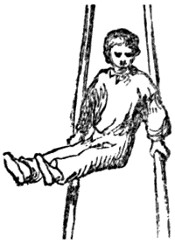
To jump out.—After having communicated to the body a movement of balance, the moment at which the legs are raised over the bars, jump backwards over the right without touching it with the feet or waist; then perform the same jump forwards. By the vaulting jump you may easily come between the bars, and also bring your body over both without touching them otherwise than with your hands.
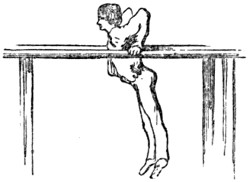
To rise and sink down.—Being in equilibrium in the middle of the bars, place the legs backwards, the heels close to the upper part of the thigh. From this position, come gently down, till the elbows nearly meet behind the back, then rise up gently without any impulse or touching the ground with your feet.
To kiss the bar behind the hands.—In the same position as before, bring the body gently down between the bars without touching the ground with your knees; kiss the bar behind each hand alternately, and then rise up in the first position.
Jumping on the Bars.—Keep the knees straight and jump along the bars backward and forward. Afterwards, do the same with the fingers turned inside. These will be learned easier, if the young gymnast tries them first with bent knees.

WALKING ON THE BARS.
Walking on the Bars.—Walk on the hands to the end and back again. In walking backwards, take care to keep the elbows straight, or you will come down. When this is done with ease, do the same, only keep your fingers inside the bars.
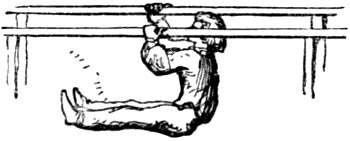
L.
L.—Sit on the ground between the bars; take hold of the bars with your hands and raise your body still in the sitting position, and stay there as long as you can. When that is learned, jump along the bars in the same attitude. Keep your knees straight, and don’t mind if your limbs ache a little.

The Arm Swing.—Rest the fore arms on the bars, and swing. When tired of swinging, let the body hang straight, and then rise on the hands. Not easy at first, but soon done with practice.
The Roll.—Rest on the fore arms, swing backward, and turn completely over, catching the bars under the arms. It looks difficult, but is easy enough, only wanting a little nerve.
The Janus.—Sit astride the bars, having your hands rather behind. Now raise the feet, swing through the bars, and come up astride on the other side. Your arms will then be twisted, and your face will be looking in the opposite direction. Swing boldly, or the shins will be knocked against the bars.

The Sausage.—Kneel on the bars. Stretch the hands as far forward as possible, and hitch the toes over the bars behind, at the same time stretching them backwards as far as possible. Now let the body sink between the bars, being supported by the hands and insteps. Now rise again. Difficult, but soon learnt.
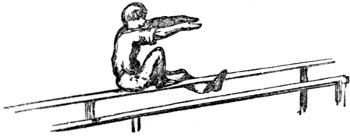
To stand on a bar.—Sit astride one of the bars. Place the heel of the right foot on the bar, hitching the left instep under it. Draw yourself up by means[243] of the left instep. Take care of your balance. This is a very useful accomplishment, and may possibly stand the gymnast in good stead.
The Drop.—Stand on the bars with each foot over one of the posts. Spring slightly into the air, put the feet together, and come down stiff, catching yourself by your hands. This should be done over the posts, as the bars might be broken, were the weight of the faller to come in the middle.
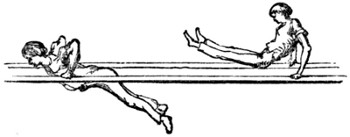
The Spring.—Swing at one end, and with a sudden impulse leap to the other on your hands. Take care of the balance of the body, or you will come on your back between the bars.

The Barber’s Curl.—Hang on one end of the bars as in the L. Keep the knees straight, and turn over slowly, not letting the feet come to the ground. Stay there while you count ten, and come back the same way.
Let two strong upright posts be firmly fastened into the ground, about six feet apart, and let a wooden bar be strongly mortised into their tops. The bar should be made of white deal, about two inches and a half in diameter. The bar must have no knot in it, or it will break. It should be so high from the ground that a spring is required to reach it with the hands. The surface of the bar should be free from all roughnesses, but not polished.
The Grasp.—The fingers should be hooked over the pole, keeping the thumb on the same side as the fingers. Hang as long as possible, first with both hands, then with each hand by turns.—See p. 244.
The Walk.—Hang by the hands, and walk by them from one end of the pole to the other, backwards and forwards. Do not slip. Do it first with both hands on the same side of the pole, afterwards with a hand at each side.—See p. 244.
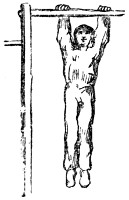
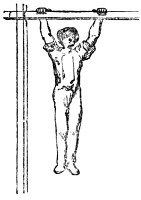
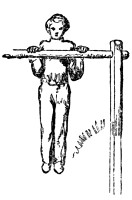

THE GRASP.

THE WALK.

BREASTING THE BAR.
Breasting the Bar.—Hang by the hands, and draw up the body slowly until the chest touches the bar. Practise this as often as possible—knees straight.
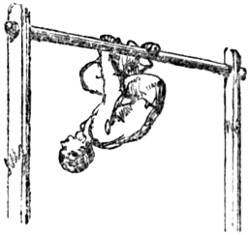
Kicking the Bar.—Hang by the hands and draw up the feet very slowly until the instep touches the pole. Do it several times. Difficult at first, but soon learned. Do not kick about, or jerk yourself upward, or you may strain yourself.

Swinging.—Hang by the hands and swing backwards and forwards. Practise this until your heels are considerably above your head each way. After a while, let go of the pole as you swing back, and catch it again as you come down. An inch or two at first is enough, but do not be satisfied until the hands can have a space of eight or ten inches between themselves and the bar.

To sit on the Bar.—Hang by the hands, and pass one of your feet through them, hitching your knee over the bar. Then give a good[245] swing backwards, and come up sitting on the bar with one leg. Now draw the other leg over, and do not tumble off.
Circling the Bar.—Hang by the hands, and curl the body gently over the bar. If it is too difficult, stop for a minute or two, try something else, and after an interval try it again. It will be soon learned.
The true Lover’s Knot.—Grasp the bar; pass the left knee through the right arm, so as to let the knee rest in the elbow; pass the right knee over the instep of the left foot; let go with the left hand, and with it grasp the right foot. You will now be suspended by the right hand, and will be packed up in a remarkably small space. Take care of the right wrist, or you will spin round and twist off.

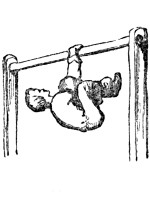
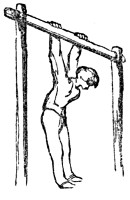

CIRCLING THE BAR.

TRUE LOVER’S KNOT.

PASSING THROUGH THE ARMS.
Passing through the Arms.—Hang by the hands, and bring the feet between them, permitting them to pass through until they can nearly touch the ground; now return in the same way. This cannot be done properly without practising, as the muscles of the shoulder blades must be capable of great relaxation, together with great power.
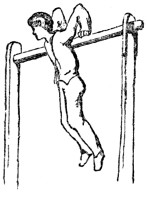
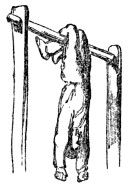

THE GRASSHOPPER.

HANGING BY THE LEGS.
The Grasshopper.—Sit on the pole, grasping it with the fingers to the front. Slide gradually off, until the small of the back rests against the pole, while the arms are elevated at the elbows like a grasshopper’s legs. Now draw yourself up again.
Hanging by the legs.—This is easy enough, and a capital preservative[246] against determination of the blood to the brain. First practise it with both legs over the pole; then take off the left leg and hitch it over the right instep; then learn to hang by one leg only, while you try to carry a weight in your hands. When you are perfect and confident, sit on the pole, and drop off backwards, catching yourself by the legs. This must be done with a fall like a plummet, or the body will swing, and probably unhitch the legs from the pole.

THE ARM-CHAIR.
The Arm-chair.—Hang on the bar by the arms just below the elbows, keeping the elbows firmly pressed to the side. The hands should be lower than the bar, to counteract the swing of the body.

HANGING BY THE FEET.
Hanging by the feet.—Hang by the hands, and curl up the body, until the insteps are well hitched over the bar. Let go the hands cautiously, and permit the body to hang at full length. The best way to reach the bar again is to seize one of your legs, and pull yourself up by it.
To leave the Bar.—Never get on the bar or leave it in a clumsy manner; there should be art about everything. To leave the bar effectively is well worth practising. Here are six modes:—
1. Sit on the bar; drop and hang by the legs, at the same time giving the body a swing forwards which will loosen the hold of the legs. Alight on the hands, and get gently on the feet. This is rather a brilliant finish, and not so difficult as it appears.
2. Sit on the bar, place both hands on one side, and vault over.
3. Sit astride, place both hands on the bar in front, bring up both feet, at the same time springing upright; run along the bar and jump off the end, or slide down the post if it is too high to jump.
4. Hang by the hands, draw up the body until the chest touches the bar; spring off backwards by the force of the arms.
5. Hang by the hands, and swing completely round once, letting the impetus hurl you forward. Take care to cross the feet and come down on the toes.
6. If you are tired and cannot perform any of these things, merely hang by the hands, and come round through them, but never merely loose the pole.
There is not a more graceful or more interesting series of exercises than those performed on the Wooden Horse. They are very useful[247] also, as they give exceeding pliancy to the limbs, and teach the gymnast how to take advantage of the weight of each member. They have also the advantage of requiring some daring, and a spirited lad will always surpass at these exercises.
The horse is made of a great cylinder of wood mounted on four legs, which are firmly fastened into the ground—their ends should be charred as was directed for the Giant Stride.
Nearer one end than the other a piece of stout rough leather is firmly nailed, to represent the saddle, and two curved pieces of wood bound the saddle and represent the pommels. The hind pommel should be nearly half an inch higher than the other. They may be covered with leather also.
On the off side of the horse a pit about a foot deep and four feet square should be dug and filled with sawdust, while on the near side the paving should be either very fine gravel, or, if possible, sand.
There should be several horses, adapted to the different sizes of boys who are to practise on them. When a boy can place his chin on a level with the saddle, he should change to a higher horse, as the top of the saddle ought to be on a level with the nose of the gymnast.
Mounting.—Stand by the horse, place one hand on each pommel, spring up, so that the body is supported by the hands, while the legs rest lightly against the horse. Keep the body upright and knees straight. Down and up again several times. Always come down on the toes.
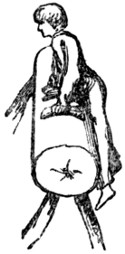
Now do the same thing; but, in springing up, throw out the right leg until it is nearly at right angles with the body, then the left. Afterwards spread both legs as widely as possible.
When this can be done with ease, spring up as before, rest a moment, then throw the right leg easily over the saddle, removing the right hand, and there you are.
Dismounting.—Put the left hand on the fore pommel, right hand on the saddle, spring off and come to the ground, keeping your right hand still on the saddle. Be sure in all these exercises to come down on the toes.
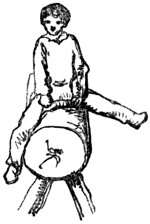
Sustaining the body.—1. Spring up as in mounting, and throw the body away from the horse, bringing it back again without coming to the ground.
2. Mount, and putting both hands on the front pommel, raise the body as high as you can. Don’t be afraid of going too high.
3. Do the same, but swing the body backwards and forwards. Hard work, but capital exercise.
4. Do the same, and slap the soles of your shoes together.
Knee practice.—1. Put your hands on the pommels, spring up, and lodge your right knee on the saddle. Down, and then the left knee. Then both knees. Practise these well.
2. Hands on pommels, leap up and touch the saddle with both toes.
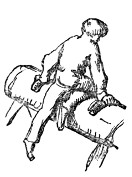

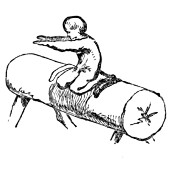

KNEE PRACTICE.

TOUCH SADDLE.

JUMPING OFF.
3. Kneel on the saddle with both knees; now lean well forward and jump off. Very easy, but requires confidence.
Swinging practice.—1. Sit behind the saddle, put the left hand on the front pommel, and the right hand on the other. Raise the body and swing round the horse, seating yourself on his neck, before the saddle. Change hands, and swing round until you regain your former position.

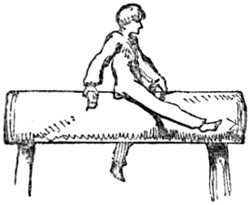
2. Put both hands on the front pommel, raise the body, and suddenly swing boldly upwards, turning round and crossing the legs, so that you will sit on the saddle with your face to the tail. Keep the hands in their places, and swing back again in the same manner.
Miscellaneous Exercises.—Hands on pommels, spring up and put the right leg through the arms, letting the left hang straight. Withdraw the right leg, and spring up again, using the left leg, and letting the right hang down.
Hands on pommels, spring up, and seat yourself like a lady behind the saddle; spring down to the ground, and seat yourself in a similar manner before the saddle.
Hands on pommels, spring up, cross your feet, pass them through the hands, and come to the ground on the opposite side.
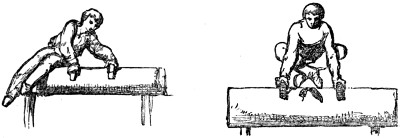
Take a short run, place the hands on the pommels, and vault completely over the horse, keeping the knees straight.

Sit behind the saddle, put both hands on the hind pommel, and throw yourself off over the horse’s tail.
Hands on pommels, spring up, make the body into an L, let the feet pass through the hands and rest suspended without touching the saddle. Knees quite straight.
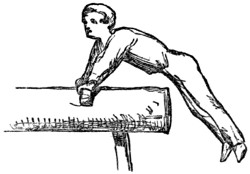
A good one for a finish.—Take a run, put both hands on the very top of the pommels, and throw yourself over in a regular somerset. That is not bad, but you can do better after the somerset has been well learned.
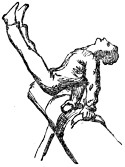
Throw the somerset as before, only do not let go the hands. You will now be standing with your back to the horse, the spine considerably bent, and your arms thrown over your head. Wait so for a few seconds, and then with a powerful effort throw yourself back again, so as to come on the ground on the same side of the horse from which you started. This is really difficult, as it requires practice, strength, and confidence, but it looks so well that it is worth learning. The writer of these few instructions has often astonished the natives with it, and has lately repeated it after two years’ absence from any gymnasium.
Let no one despise this exercise. It is worth learning, if only as a preservation against sea sickness. If any one can stand a twenty-feet[250] swing for half-an-hour, the sea may toss its worst, for he will come off unscathed. Now, I do not mean to say that merely sitting on a board and getting swung by some one else is any great object: far from it. But there are some very graceful exercises to be managed on the swing. Here are some:—
1. The way to get into the swing is as follows:—Take one rope in each hand, just above the seat; walk backwards until the ropes are freely stretched. Now run sharply forwards, letting the hands glide up the ropes as far as possible, and the instant that you feel a check, grasp the rope tightly, and spring into the seat standing. When there, work easily up by alternately bending and straightening the knees. (See 1.)
2. When in good swing, slip the feet off the seat (which should not be more than four inches wide); let the hands slide down the ropes, and come down sitting. To recover the standing position, reach upwards with the hands as high as possible, and draw yourself upwards as the swing is going forwards, when the seat will place itself exactly under your feet.
3. Now for some feats.
Let the swing go very gently. Place both hands at the level of the shoulders, and suddenly extend them, keeping the arms straight. Take care, as there will be a violent vibration, and you will be shot out of the swing before you know where you are. Practise it first while the swing is still, but do not be satisfied until you can do it while in strong swing, and without closing the hands, merely letting the palms rest against the ropes. (See 2.)
Swing still. Stand up on the seat, and grasp the rope with the hands as low as possible, without bending the body or the knees. Now lean forward, making your hands the pivot, and do not be astonished at finding your heels in the air, and your head downward. To recover yourself, the body must be bent a little. (See 3.)
Stand sideways on the seat, grasp one rope with both hands leaning your back against the other, taking care to have the rope well between the shoulder blades. Put the inner centre of the left foot against the opposite rope, and fix the right foot in the same manner against the left heel. Now let go both hands, and lean well backwards, when you will be exactly balanced. When you are secure with a quiet swing, practise it while the swing[251] is moving, until you can lie securely against the rope while you are moving freely. The balance is entirely kept by the shoulder blades against the rope, and the arms must be folded in order to throw the shoulder blades well back. If the gymnast gets alarmed, and puts his hands out to save himself, the rope slips off his back, and out he goes. (See 4.)

Fig. 4.
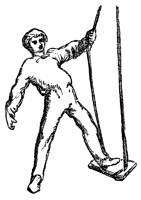
Fig. 5.
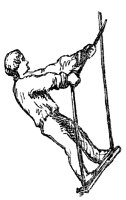
Fig. 6.
While the swing is working, suddenly hang out at one side, supporting yourself by one hand on the rope, and one foot on the seat. Practise this on both sides. (See 5.)
Seize the left rope with both hands, press the feet firmly against the ropes where they join the seat, and fall out forwards. The ropes will now cross, and when the swing is in full operation, the curves described are most elegant. To recover the ordinary position, wait until the swing is going backwards, and a powerful twist of the body will uncross the ropes, when the right hand should take hold of the right rope and steady the swing. (See 6.)
When the swing is in motion, grasp the ropes as tight as possible, and raise the feet until they are high in air between the ropes. Take care of the balance in the back swing, as, if the body is suffered to bend backwards, the hands will hardly bear the strain. Now slide slowly and carefully down the ropes until the head rests on the footboard.
To make a telling exit from the swing, two ways may be adopted. First way:—Get the swing into a firm, steady movement, sit down, and bring both hands inside the ropes; and just as the swing has passed its centre, strike the seat away with the hands and you will shoot forward several yards. Take care to come down on the toes, and to lean well backwards as you leave the swing, as the impetus will bring you upright as you touch the ground. (See 7.)
The second method is, to seat yourself in the same manner, and as the swing crosses its centre backwards, lean well forwards and strike away the seat. You will then be hurled backwards, and if your balance is good, will come to the ground in a very elegant attitude. Be sure to lean well forward, cross the feet, clasp the hands, and come down on the toes. (See 8.)
Great care must be taken to lean well backwards if you shoot out forwards, and well forwards as you shoot backwards, or in the one case you will come with your nose on the ground, and in the other you will find the back of your head rather damaged. So practise with gentle swings at first, and then increase. I have often done it with the swing at full speed, and in one instance in a public gymnasium, I shot so far forward that the spot was marked by a row of iron nails driven into the floor.
In a volume of this nature, it is impossible to give more than a comparatively slight sketch of any subject. I am sure, however, that if the reader will master even these short instructions in gymnastic exercises, he will be able to realize that great blessing, the sound body, in which only a sound mind can reside. His trained eye will be accustomed to measure instinctively any obstacle in his way, and the training of his body will enable him to put forth the full power of his muscles to overcome the obstacle. Danger will lose half its perils to him who thus knows how to meet it. A strong rope will be as safe as a staircase to him; it will be perfectly indifferent to him whether his head or his heels be uppermost, and he will be enabled by the presence of mind which such studies engender to think out calmly modes of escape from danger which would instantly overwhelm those whose bodies are uninstructed.
But even to pass by the question of utility, it is a duty of man to preserve his body in health, and to develop its powers. Every man would think himself wrong to neglect the mind; surely then, every man ought no less to think it wrong to neglect the body, which is made by the same mighty Hand that implanted the mind within it. Indeed, the neglected body is sure to injure the mind, and therefore those who improve their bodies are at the same time improving their minds.
I know one young man, who owes all his health, and probably his life, to gymnastic exercise. From his earliest childhood he was always ailing, and through the whole of his childhood was never suffered to sleep unwatched. When he entered upon manhood, the childish illness changed into annual fevers, which held their sway until he had been for some time at one of the Universities.
His medical attendant advised him to take regular exercise, and recommended the study of gymnastics. He rapidly improved in health and strength, his fever has not attacked him for eight or nine years, and he actually led the gymnasium for a whole year.
Were I to have the charge of a school, I should consider the gymnasium as part of the regular school discipline, and take care that the boys were exercised as carefully in their bodily as their mental powers.
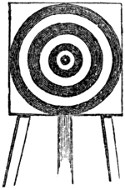
This play is very interesting, and gives strength to the arm, and exactness to the eye. In playing it, a square target must be procured, made of thick wood, about four feet in diameter, and on which should be marked concentral circles, the same as those of a target in archery. This should be well supported behind by two stout back pieces, resting in the ground, so as to prevent the target from being easily overturned. The circles may be several in number; the centre should be black, and about six inches in diameter, and count ten; the second circle should be red, and should count five; and the third should be light blue, and count three. The other parts of the target to count as may be agreed. The javelins should consist of poles of ash or fir, about an inch and half in diameter, and should be five feet six inches in length. They should have a spike in one end, which should be surrounded with a rim of iron; the spike should be about two inches long, thick, and strong, so as to enable it to become fixed in the target without splitting it. The game may be played by any number of boys, and is commenced as follows:—
One player takes a javelin in his right hand, and walking to a distance from the target, previously agreed upon by the players, he poises his javelin, by holding it in the hollow of his hand, between the ball of the thumb and the fleshy part at the side, and his elbow is at the same time bent, and his arm elevated so that his hand is a little above his ear, the javelin being at the same time nicely balanced with the smaller fingers, touching it so as to direct its course; it is then launched forward at the target, and, if properly poised, directed and thrown, will go to it in a direct line. The point at which it strikes the target is then marked, and then the other players follow in the same way for twelve times in succession: the person who scores the most marks being the victor.
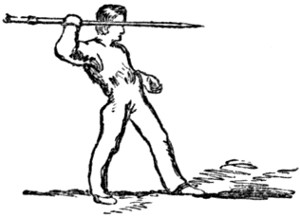
The javelin will fly better and straighter if a rotatory movement is communicated to it by a slight pull of the little finger as it leaves the hand. When some skill has been obtained in darting, blunt javelins with padded ends should be procured, and the players should accustom[254] themselves to avoid, parry, or catch a javelin thrown at them. When they can do so with certainty, they may storm a fort. The best fort is a hedge with gaps. The players divide into two parties, one defending and the other attacking. Each player should be furnished with three javelins at least, well padded and nicely balanced. The art of catching and returning a javelin is exceedingly useful in this game. We well remember an occasion when, on storming a fort, one of our opponents, whose frame was larger than his soul, had prudently retired into the background until all our spears were exhausted, but, on seeing us weaponless, he with great courage ran up to the hedge and hurled his spear, as we were running forward to pick up a fallen lance. The moment he had thrown the javelin he ran away as fast as he could, but was overtaken by his own weapon, which took him in the rear, and toppled him over in beautiful style. We have only known one accident at this game, and that was caused by the impetuosity of one of the garrison, who on seeing an enemy crawling up through the gap, and finding himself without a spear, snatched up a bow that was lying near, and made a thrust at him, which sent the sharp horn tip of the bow through his under lip.
Should the intending gymnast possess a strongly-built barn or outhouse, which is large enough to permit the trapeze to have fair play, and strong enough to endure the stress of the swinging weight, the ropes can be suspended from a beam, either belonging to the building or inserted for the express purpose, and resting at each end on strong brackets. But as such buildings are very seldom to be obtained, we here give a sketch of a plan invented, we believe, by Messrs. Snoxell, the well-known furnishers of gymnasia. Although its structure may appear to be light and flimsy, it is in reality possessed of strength which renders a fracture impossible, and is indeed far more fitted to resist the enormous strain which is laid upon it, than if it were made of massive beams morticed.
In the first place the upright poles (a) do not pass into the ground, but are supported upon stone slabs, so there is no fear of that terrible enemy of the gymnasium—rotting wood, which silently decays and suddenly snaps off level with the surface of the ground. The cross piece (b) is affixed to the uprights by a simple cap, bent at right angles, as is seen at f. The cross piece is permanently secured into the cap, but the uprights can be slipped in and out without difficulty. At c may be seen four slender wire ropes, the upper ends of which are fastened to the uprights, and the lower ends are furnished with hooks. These hooks are intended to be slipped into the staples (e), which are firmly secured into the ground, just as the old bull-rings were fixed. At d are seen the tightening screws, which are simply turned by hand, and shorten the wire ropes just as the connecting screws of a railway train draw the carriages together.
The apparatus is so perfectly simple that it can be set up or taken down by two boys in five minutes, or by one boy in rather a longer period. The process is as follows:—
The uprights are slipped into the caps, and the hooks at the ends of the wire ropes or stays are hitched into the staples of one side, say at e. The uprights are then reared, and their bases set on the stones. The hooks of the opposite stays are then hitched into the staples at e e, and the screws at d turned until the stays are quite tight and the uprights are perfectly perpendicular.
It seems rather a complicated process to read about, but it is remarkably simple when reduced to action. We have mounted and dismounted one of these ingenious contrivances in a wonderfully short space of time, and without any assistance.
For practising the feat of passing through the air from one trapeze to another a double set of apparatus is required; but for most useful purposes one set is sufficient. The ropes by which the bar is suspended must be thoroughly stretched before they are attached to the bar, or there will be no certainty in the swing. Few persons who have not had practical experience on this subject would imagine how[256] greatly the length of a rope is increased by the process of stretching, and how absolutely necessary is this precaution.
The ropes are passed at each end over an iron eye, the upper one of which is hitched over a hook on the cross bar, and the other receives the hook which suspends the bar. On looking at the illustration the reader will notice these hooks just above the bar. They are useful, because, when needed, a pair of rings can be substituted for the bar, and permit certain variations in the performances, Still, their presence or absence is quite optional, and the only remark that need be made is, that they should be furnished with springs like the fastening of a breguet chain, so as to guard against the possibility of slipping. The bar itself must be very heavy, or otherwise it will not have sufficient weight to keep the cords at full stretch, and in consequence will not swing truly. Those which were employed by Leotard were iron, with a mere shell of wood, so as to give a pleasant hold for the hands, and we have seen them made of iron, coated with leather. The last point that needs notice is the perch or stand from which the performer launches himself. This may be fixed at any convenient elevation, and its centre should exactly coincide with the centre of the bar. Having now the apparatus ready, let us commence the performance.
Set the bar swinging boldly; ascend the perch quickly, and seize the bar in both hands. Wait for a moment, until the ropes are fully stretched, and then launch yourself for a swing. Now there are two ways of doing everything—a right and a wrong way; and the present instance affords no exception to the rule. The wrong way—and the usual way—is to fall forwards from the perch. Now this is quite wrong; and if you act in such a manner you will bungle your sway, and will not retain sufficient impetus to enable you to return to the perch.
The right mode of starting is as follows: Stand as seen in the accompanying illustration—the spine well bent backwards, the body tolerably stiff, and leaning well against the heavy bar. Now draw yourself up gently by the arms, as if you were trying to lift your chin above the bar, and you will find yourself started without any trouble. Keep the back still bent, and as you descend allow the arms gradually to assume a perfectly straight position. You will then swing out fairly and boldly, and by the least possible sway at the end of the swing will retain sufficient impetus to enable you to resume your stand on the perch.
Even in this there is an art. If you merely allow yourself to swing back as you swing forward, you will be disagreeably reminded of your error, by hitting the back of the leg smartly against the edge of the perch. In order to avoid this misfortune, draw up the legs sharply just before you reach the end of the return swing, and you will find them come down on the perch with perfect ease.
If you are using the rings instead of the bar, you can vary this[257] part of the performance by turning round in the air, and crossing the ropes so that you alight on the perch with your back towards the trapèze, though it is necessary to give a sharp twist as your foot touches the perch, and so to turn in the direction in which you started.
Take notice that the arms are always at full length during the swing, and that the illustrations which represent the performer swinging with bent arms are entirely erroneous. There is another fault into which the artists mostly fall. Thinking that they are obtaining pictorial effect, they represent the ropes which sustain the bar as forming an angle with the arms of the performer, whereas the arms, body, and ropes are, or ought to be, all in the same line.
The real attitude in the trapèze is given in the accompanying illustration, wherein it will be seen that the ropes, the arms, and the body are all in the same line; and, indeed, a little reflection will prove that they must be so. Note the position and action, or rather[258] the non-action of the body, and be careful to imitate it. During the swing, let the body and limbs hang at full length, and be sure to keep the feet nearly together, and the toes pointed. The illustrations are all wrong in this respect. They always will show the performer in an attitude which the draughtsman is pleased to think a graceful one; but it is inexpressibly graceless and ridiculous in the eyes of a gymnast.
When you have accomplished the swing and return satisfactorily, you may advance another step. Swing off as usual; and, when you have reached the extremity of the swing, you will find yourself balanced for a moment motionless, the attraction of gravitation being balanced by the impetus of the swing. Just at this important point, shift your hold on the bar, and change sides, as you would do if the bar were hanging quietly.
You will then face the spot whence you started, and in landing on the perch you must be careful to give yourself a twist as you place your feet on the perch, and with a slight exertion of the arms you will draw yourself upright without difficulty, and without running[259] the risk of falling off the perch again—a frequent and ignominious misfortune.
It will now be time to practise the descent from the swinging trapèze to the ground. Begin by sitting on the bar, grasping it with the hands, and falling off backwards, taking care to come to the ground with pointed toes and crossed feet. The reason of this precaution is that, if the feet are crossed, the knees are separated, and that when the body yields—as it must do when it touches the earth—there is no danger of hitting the chin against the knee, and thereby receiving a momentary shock to the brain by the teeth striking together.
When you can manage the “fall-back,” as it is called, with tolerable ease and certainty, seize the bar with the hands, set it swinging, keeping your face to the perch, and when you are nearly at the full extent of the swing loosen your hold, and allow yourself to come to the ground. Be very careful to point the toes, as has already been described, and continue the practice until you can stand on the perch, launch yourself backwards, and fly off at the highest point of the swing.
Always leave the bar while you are swinging backwards, because the attitude of the body is then such as to insure your coming to the ground in the correct position; whereas, if you do so while swinging forward, you are nearly certain to overbalance yourself, and either fall on your nose, or go staggering along in a very ignominious style.
The next process is to start as usual, raise yourself in a sitting position on the bar, and ask some one to remove the perch. Fall back as before, only, instead of coming on the ground, hang by the legs, and accustom yourself to swing in this attitude. When you can accomplish that feat without difficulty, and feel no nervousness at your strange position, remove one leg from the bar and hang by the other. Practise this with both feet. It is not nearly so difficult as it looks, and is an important feat to perform, because it gives such perfect presence of mind.
The next feat looks positively awful, but, as usual in gymnastic performances, is perfectly easy, requiring no skill at all and only a little courage. Sit on the bar when it is still, and do the “fall-back.” But, instead of allowing the feet to pass between the ropes, spread the legs as far apart as possible, and bend up the feet rigidly. The consequence is, that the insteps hitch in the ropes, slide down them, and the body becomes suspended by the feet, which are firmly hitched between the ropes and the bar, as seen in the accompanying illustration.
If you possess a second trapèze, you may now proceed to the beautiful series of performances which are achieved upon them.
Let them at first be set moderately near each other, so that when the bar of the first trapèze is at full swing, it passes within a yard or[260] four feet of the second. Start off as usual, and just as you are well on the rise, after passing through the upright, loose your hold of the bar, and you will pass through the air towards the second bar which you catch rapidly.
If you perform the feat nicely, you will have so much impetus to spare that you will be carried along on the second bar, and may either attempt to return or quietly drop to the ground at the end of the swing. If you prefer the latter course, be sure to turn through your arms and come down on your toes.
You will find that the return to the perch, simple as it looks, is by far the most difficult feat that has yet been mentioned. Make but the least mistake and failure is certain. If you do not catch the bar exactly at the right moment, you lose your impetus, and if you do not seize it exactly in the right place you do not swing truly between the uprights, and consequently cannot land on the spot at which you aim.
The method of performing this feat is as follows: Swing off the perch, pass to the second bar, and while at the full extent of the[261] swing, change sides, and give yourself a slight impulse with the feet. You will now meet the first bar swinging towards you, and if you can seize it just at the right moment, you will find yourself with sufficient impetus to reach the perch. If not, swing once more, give yourself a hearty impulse with the legs and try it again. Failure is certain at first, but after a little practice the feat becomes easy.
Here we must protest against the totally erroneous ideas of artists respecting the attitude of the body while the performer passes from one bar to another. We think that without an exception they all represent him as shooting horizontally through the air, with his hands stretched out, and with one leg bent and the other straight. Now, if any one will watch a performer on the trapèze, he will see that the attitude is nearly perpendicular, and that any other position is really absurd and impracticable.
In the accompanying illustration, we have given a sketch of the real attitude of the performer, wherein it will be seen that the body is nearly perpendicular, and that the arms are kept bent, with the hands close to the shoulders, ready to be darted out in a moment when the trapèze swings within distance.
We are the more particular in giving these illustrations, because they are needed in order to correct the very false notions which are prevalent respecting this beautiful exercise. Parents especially are apt to form their judgments from the illustrations which are seen upon advertising bills and in illustrated journals, and thinking that the exercise must be attended with great danger, do not like to give their permission for their sons to learn it.
Let our readers be assured that there is no more danger in this beautiful exercise than in jumping over a chair—perhaps not quite so much—while the manner in which it develops the muscular powers of the arms, shoulders, and loins, is unapproachable by any other system.
One caution is, however, needful. Take care that every loop and splice be perfectly secure, look over the whole of the apparatus daily, and never venture upon the trapèze until you have ascertained that nothing is likely to give way. If you perceive the slightest feeling of insecurity, the whole enjoyment of the exercise is lost, and no benefit can be expected from it.
The book.—Fix a book between the toes of the feet, and, by a jerk, throw it over the head.
The chalk line.—Draw a line with chalk on the floor; against this place the toes of both feet; then kneel down, and rise up again without leaving the line, or using the hands.
Stepping through.—Take a small piece of cane about a foot long, and holding it between the hands, leap through it. Afterwards take a tobacco-pipe, and perform the same feat without breaking; after this, join the hands together, and leap through them, which is not very difficult of accomplishment.
Armless.—Lying upon the back with the arms across the chest, the attempt must be made to rise on the feet again.
Hop against the wall.—Stand with one toe close against the wall, about two feet from the ground, and turn the other over it, without removing the toe from the wall.
Stoop if you can.—One boy having placed his heels against the wall, another must place near his toes a shilling, and tell him he may have it if he can pick it up. This he will find to be impossible for him to do while his heels touch the wall, as there is no room for his back to balance the other parts of his body.
The spring from the wall.—Placing yourself at a proper distance from the wall with your face opposite to it, throw yourself forward until you support yourself by one hand. Then spring back into your former position. Begin this feat at a short distance from the wall, and increase the distance by degrees. The “athlete” will, in a short time, be able to stand at nearly the length of his body from the wall. This feat is sometimes called the palm spring, but the palm has really[263] nothing to do with it. The thumb spring is similar, but dangerous, and many have sprained their thumbs in attempting it.
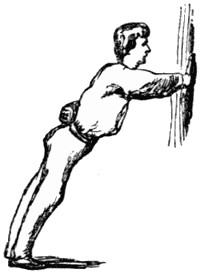
The long reach.—This is a somewhat difficult feat, and requires great caution in its performance. A line is chalked on the floor, at which the toes must be placed, and from which they are not to remove. The left hand is then to be thrown forward in a long reach until the body descends upon it, without any part touching the floor in its descent; the right hand is now to be stretched out as far forward as possible, and with a piece of chalk, a mark is made on the floor at its fullest extent, the body being sustained by the left hand during the operation. The boy should now recover the upright position on his legs, by springing back from the left hand without touching the floor in any way. The length reached, and the perfection with which the body recovers itself, distinguishes the winner of the game.
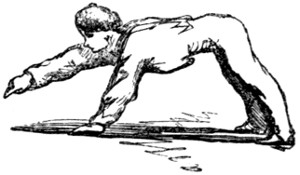
The stooping stretch.—In this feat a line is drawn on the floor, at which the outer edge of the left foot is placed, and behind this, at a short distance, the right heel. Taking a piece of chalk in the left hand, the youngster passes it between the legs, and under the bend of the left knee, chalking the floor with it as far forward as he can. He then recovers his position without moving his feet from the line at which they had been fixed.
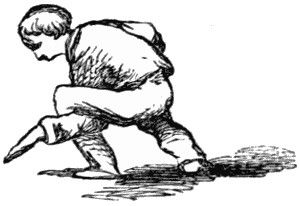
The chair feat.—Place three chairs in the situation indicated in the cut (p. 264), and lay down upon them, the head resting on one, the heels upon another, and the lower part of the body on the third or middle chair, which should be much lighter than the others. Then, by stiffening the body and limbs, and throwing up the chest into a state[264] of rigidity, it will not be difficult for a boy to remove the middle chair, and to pass it quite over on the other side of him.
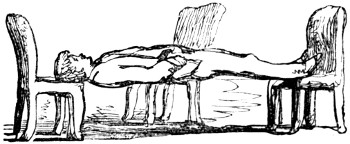
The poker feat.—Take a common poker and hold it the lower end downwards, in the manner shown in the cut, i. e. by the fingers, thumb, and ball of the palm. Then, by the mere motion of the fingers and thumb, and the fulcrum of the palm, work the poker upwards till you raise it through the whole length to that part of it which goes into the fire. This trick depends mainly upon the strength of the muscles of the hand and fingers, combined with a certain knack to be acquired by practice.
The stick feat, or from hand to mouth.—Take a piece of stick of the length of the fore arm, measuring from the elbow to the end of the middle finger. Hold it in the hand horizontally before you, the knuckles being down and the nails upwards, and the elbow being on a line with the hand. Then raise the left end of the stick from the breast to the mouth, without any other movement of the hand than the arm at the wrist. This is a difficult feat, but may be easily acquired by practice.
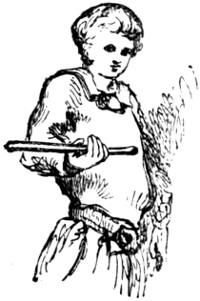
Walking on stilts.—Among the Swiss, and in several districts in the South of France, walking on stilts is not only an amusing, but a[265] useful practice, as by means of these crane-like legs men and women transform themselves into the order of “Waders,” emulating the long-legged storks and herons, and can cross over marshes and flooded grounds without wetting their feet. Stilts are easily made, being nothing but a pair of poles, with a wooden step at the sides for the feet to stand on. The poles are kept in their proper place by the hands. A little practice will soon render a youth “easy on his stilts,” and they may be made an amusing and healthy exercise.

In all the general principles, hockey bears a great resemblance to foot-ball, the game consisting in driving a ball through a goal. The ball, however, is of much smaller dimensions, even where a ball, and not a bung, is used; and it is impelled, not by the foot, but by certain sticks, or clubs, called hockeys, or hookeys, because the end with which the ball is struck is more or less hooked.
The shape and dimensions of the hockey-stick are entirely arbitrary, being left to the peculiar taste of the owners. Some like their hockeys to be sharply hooked, while others prefer them merely bent over at the end. Some players like a very thick, heavy stick, which can be put down in front of the ball in order to neutralize the blows of the opposite side, while others can play best with a slight and springy weapon, that can be used with one hand, and is employed to tap the ball away just as an opponent is about to strike, and to coax it, as it were, towards the goal through the mass of adverse sticks.
The four sticks shown in the engraving are very good samples of the forms best adapted for use. Fig. 1 is much in favour with some players, and is therefore given; but for our own part we never could play to our satisfaction with it, the large and deep curve deceiving the eye and causing the player to let the ball pass through the hook, besides running the risk of entanglement in the opponent’s stick.
Fig. 2 is usually a favourite, but the angle of the head with the handle is arranged according to the fancy of the player. Some like the head to be made of horn, backed with lead like a golf-stick; but this formation is hardly necessary, costing a rather large sum, and not conveying correspondent advantages.
Fig. 3 is a queer and eccentric form, which is not suitable to every[266] player on account of its weight and generally large proportions. We have, however, seen it employed with extraordinary effect by a player who was accustomed to drive his opponents into a state of considerable excitement by his faculty of stopping the ball with this overgrown weapon, and then planting it so firmly that all the opposing sticks could not get at the ball in spite of their battering. In this way he would save many a game that had well-nigh been given up as hopeless, and by thus checking the ball on its way to the goal, would give time for his own side to come up and turn the tables. The great hooked end of this club was bound with very strong iron wire.
The same player was equally successful with a stick the exact reverse of the preceding, and represented as fig. 4. This was a very slight ashen stick, with a small, but rather heavy head, so that when shaken it would bend and spring like whalebone. This little stick was used for darting among the struggles and clatter of contending weapons, and giving the ball just a wee pat now and then at critical moments, so as to edge it a little nearer the goal, and at the same time to knock it away just as the blow of the opponent descended.
The ball used for this game is sometimes an ordinary cask bung. As this would speedily be knocked to pieces, it is generally quilted with string, as shown in the illustration, for the better preserving its integrity. Sooner or later, however, it goes to pieces, for the string is sure to be cut or worn through, and the cork soon gives way. Balls, too, are apt to get their jackets knocked off, and if struck hard will sometimes fly in the face of a player, who cannot avoid it at so short a distance, and do no small damage. A hollow india-rubber ball is very good; but the best that we have yet seen, was a common globular india-rubber bottle, such as can be procured at any stationer’s, with the neck cut off, and partly filled up by leaving a strip of the neck and securing it by the proper varnish.
It made a capital ball. Nothing could hurt it, and it could hurt no one. We have had it driven into our face at two yards’ distance, and felt little the worse for it five minutes afterwards. It would not roll very far by itself, but required to be edged carefully by the sticks; it never could get cut against flints, or spoiled by thorns or splinters; it was big enough to be easily seen if knocked into a ditch or over a hedge, and if struck into water it would not sink but come to the surface at once, bobbing about as if to draw attention to its presence. It remained in constant action for two years to our knowledge, had been employed for several seasons before we made its acquaintance, and for aught we know may be in use now. In fact, if it were only kept out of the way of a fire or an ostrich, we know nothing that would hurt the ball except burning or swallowing. Even in the latter case we fancy that the ostrich would be the sufferer rather than the ball.
Having now described the instruments, we will proceed to the method of playing the game.
As has already been mentioned, this game is in principle similar to foot-ball. Two goals are set up, at a convenient distance from and exactly opposite to each other, as in foot-ball. The same goals indeed will answer as for that game, only the cross pole should be lashed to the uprights at a much lower elevation, say three feet six inches or four feet from the ground, and the uprights should be within six feet of each other. Very good and simple goals can be made by taking long osiers, willow branches or brambles, pointing the two ends, bending them over and sticking the pointed extremities into the earth, so as to make an arch. A peg is driven exactly half-way between the goals, goal-lines are drawn as at foot-ball, and the ground is then laid out.
The players, having previously chosen their sides, arrange themselves between the goals, facing each other, and always having their left sides towards the enemy’s goal and their right towards their own. The ball is then thrown in the air, so as to fall on or near the wooden peg, and each party try with their sticks to drive it through the goal of the enemy.
The rules of this fine game are few and simple.
1. The game is won by the ball passing through the enemy’s goal.
2. The ball must be struck through the goal with the stick, not thrown or kicked.
3. Each player shall strike from right to left, and any player infringing this rule is liable to the penalty of a blow on the shins from any of the opposite side.
4. Each player shall remain on his own side, and if he crosses to that of the opponents is liable to the same penalty.
5. No player shall raise the head of his stick higher than his shoulder, on pain of the same penalty.
6. The ball may be stopped with the stick, or with any part of the person, provided that the intervening player is on his own side.
7. If the ball be kicked or thrown through the goal, or if struck beyond the goal-lines, it is to be fetched by the junior player of the side who struck the last blow, and gently thrown towards the centre peg.
8. Any player wilfully striking another, except when inflicting the penalty contained in rules 3, 4, and 5, is immediately to be excluded from the game.
By means of these rules, the game of hockey is shorn of the danger consequent on the loose and unrestrained play that is sometimes seen, the sticks brandished in all directions, and the two sides so intermixed that it is hardly possible to discriminate between them. Many a person has been seriously damaged by such undisciplined play, and teeth have been struck out, or even eyes lost in the contest. By strict adherence, however, to the above rules, there is no fear of[268] incurring any injuries, and this really fine game is rendered as safe as it is exciting.
As a general rule, a good player seldom if ever strikes the ball with any violence, but keeps it well in hand, trundling it along rather than knocking it forcibly, and endeavouring, if he finds it likely to pass out of his control, to strike it gently towards another of his own side, who may keep it in its course towards the enemy’s goal.
A bad player, on the contrary, rushes about without any definite purpose, shouts continually at the top of his voice, brandishes his stick to the danger of other persons’ eyes and the detriment of his own hands, which are sure to be painfully blistered in half an hour, and exhausts his strength and breath so early in the game, that he fails just at the critical moment, and sees the ball driven past him without being able to check it.
As a parting word of advice, let us recommend to our readers to play this game as quietly as they can contrive to do, and as a golden rule, always to keep the head of the hockey-stick close to the ground.
Above all, keep your temper intact, and don’t lose it even if one of your own side should make some stupid mistake, and lose you a winning game. Take especial care to keep strictly to the rules, and if your opponent should break them and render himself liable to the penalty, be merciful to his shins, and inflict the punishment as a warning to deter from future transgression, and not as a spiteful opportunity for giving a blow which cannot be returned.
This game is not easily played without what is called a racket ground, which consists of a large space of ground, a parallelogram, of not less than fifty yards long, by twenty-five broad. Where such an advantage presents itself, the game may be easily attempted. Sometimes the high dead wall of a garden may be made into a racket wall, by fixing up some boards and net-work along the top, supposing there is space enough below, when the game may be played in a small way. The wall should be painted black, and the ground be divided into four equal divisions, which should be distinctly marked either by chipping a groove in it by a spade, or by chalk. It is very essential, however, that the flooring of the court should be paved. These divisions are, two close to the wall, as A and B, and two in front of them, as C and D, which divisions are occupied by those who play the game. The wall should be marked by a broad line of white paint at forty-two inches from the ground, and above this line every ball must strike. The ball is, according to law, only to weigh[269] one ounce, and is either white, or made so from time to time by dipping into a bag of chalk, that it may be the better seen against the black wall by the players. The ball is made of pure white and tightly-sewn leather. The bat used to propel the ball is of a legal make, and its lower end of a spoon form, over which is placed a strong net-work of silk-wire, or catgut. The bat is called a racket.

How the game is played.—Rackets is a very simple game, and may be played either by two or more players. When it is played by four persons, one stands in each of the compartments, A, B, C, D; those near the wall being called in-hand, and those furthest from it out-hand players. When two play, each player takes two of the divisions, and the one who takes the A first from the wall is called in-hand player, and the other out-hand player. Having determined by lot who is to begin the game, the in-hand player nearest the wall strikes his ball against it; if it strikes under the line, goes over the wall, does not rebound into the out-hand spaces, or goes beyond the racket ground, the striker is out, and the out-hand player takes his place; but if the player is more successful, and the ball rebounds into the out-hand spaces, and hopping from the ground is sent back to the wall again, to rebound into one of the in spaces, the game goes on. In a close-court game the “server” who serves the ball properly above the line but not accurately into his adversary’s court is allowed three trials before his “hand” is out. The play of the game is, that the in-player should send the ball in such a manner against the wall that, on its rebound, the opposite party, or player, shall be able to pick it up or hit it. Whenever this happens, he who struck the ball counts one point, or an ace, and the play is continued until one player or party scores eleven, or, as is sometimes and now more frequently played, fifteen.
This capital game, so conducive to health and affording such excellent exercise, may be played either in an open court—that is, a court with only one wall, against which the game is played—or in a closed court which is surrounded by four walls. Sometimes a compromise is made by the employment of the ordinary high front wall, and a smaller back wall, omitting the side walls altogether. The closed court game is the best and far the most scientific, but the great expense necessary for erecting a proper court compels many to content themselves with an ordinary old-fashioned open court game, for there seems little doubt that the open court game is the oldest and the one which in old days was held in highest favour.
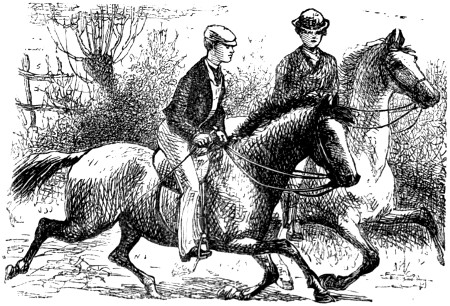
A boy on horseback is a king on his throne; he feels more than “boy” the moment he gets astride of anything in the shape of a nag. Boys have an instinct for riding, an impulse they cannot resist, like the instinct for eating, breathing or moving. In his earliest days, in the very “boyhood of being,” “Ride a-cock horse to Banbury Cross” is a ditty of infinite delight, and long before the days of corderoys the equestrian exercise of “Grandfather’s Stick” affords him “joy ineffable.” Then comes the noble game of Hippas, or the wooden “Bucephalus,” on which he feels greater than Alexander; and last, though very little, yet still not least, the “pet Shetland,” which adds to the bliss of being mounted, a positive progressive locomotion, and the “greater than Alexander” is made greater still. Considering, therefore, that all boys love riding, it is for us to tell them how they may “mount the fiery Pegasus,” and ride with elegance and safety,
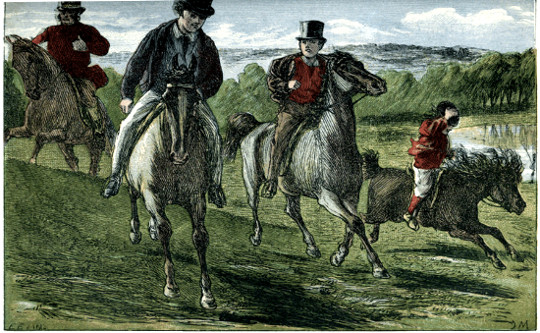
RIDING.
The horse is one of the most beautiful and graceful animals in nature, and perhaps the most useful to man, though in this respect it would be difficult to say which of the four or five domesticated quadrupeds bears the palm. During life, the horse and the dog would each contest the point; while in relative value after death, the bullock, sheep, and swine, are fairly entitled to an equal share with them. But there is something very captivating in the appearance of the horse, whether used for the purposes of war, or for racing, or for hunting, or road-work; and in all these several capacities the readers of this book may possibly admire him, though it is chiefly as the riding-horse, or hack, that he usually attracts their notice.
In the animal kingdom, the horse belongs to the division Vertebrata, and class Mammalia, he having a back-bone composed of vertebræ, and his young being suckled. His broad and undivided hoof places him among the ungulata; and lastly, his teeth are as follows, viz. six front teeth, above and below, called “nippers;” two canine in each jaw, called “tusks;” and the remainder, consisting of grinders, having flat surfaces opposed to each other, with rough ridges on them, by which the grass, hay, and corn are rubbed or ground down to a fine pulp, adapted to the stomach. These teeth are moved or rolled on each other by a peculiar action of the muscles of the jaw, so as to aid the process.
By means of the gradual wearing down of the front teeth, or nippers, the age of the horse may be known. Each of the nippers has a hollow in its upper surface, which is very deep and black when the tooth first rises above the gum, and is gradually effaced by the friction caused by the cropping of the grass, or by biting at the manger, or other kinds of rubbing; but as these vary a good deal according to circumstances, so the precise degree of wearing away will also be liable to fluctuations; and the rules laid down only approximate to the truth, without positive accuracy as to a few months. There are also two sets of teeth; a milk set, which first rise, beginning at once after birth, and a permanent set, which replace the milk-teeth as they fall out. The milk-teeth come up two at a time, but all are up by the end of the first year. The permanent teeth, also, make their appearance by twos, the first pair showing themselves in the place of the two middle milk-teeth in the third year, and being generally level with the other milk-teeth by the end of the fourth year, by which time the next pair have fallen out, and the permanent teeth have shown themselves in their places. At five years of age the horse has lost all his nippers, and his corner permanent teeth have nearly completed their growth. The tusks[272] are also above the gums. The centre nippers are now much worn, and the next are becoming slightly so. At six years old the “mark” in the centre nippers is quite gone; at seven years of age this disappears from the next pair, and at eight from the corner nippers; after which, none but a professed judge is likely to make out the age of the horse by an inspection of his mouth; and, indeed, at all times the tyro is liable to be deceived by the frauds of the low horse-dealer, who cuts off the top of the teeth, and then scoops out a hollow with a gouge; after which a hot iron gives the black surface which in the natural state is presented to the eye. This trick is called “bishoping.”
The natural paces of the horse are the walk, trot, and the gallop; to them are added by man the canter, and sometimes the amble and the run. In the walk, each leg is taken up and put down separately, one after the other, the print of the hind foot in good walkers generally extending a few inches beyond that of the fore foot. The order in which the feet touch the ground is as follows: 1st, the off fore foot; 2d, the near hind foot; 3d, the near fore foot; and 4th, the off hind foot.
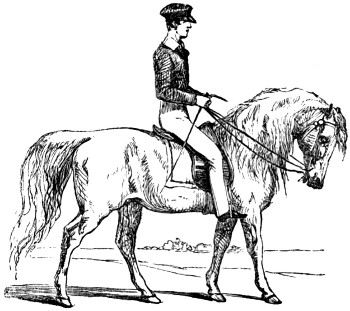

The gallop consists of a succession of leaps, during a great part of which all the feet are off the ground. As the feet come to the ground they strike it in regular succession; but the exact order will depend upon the lead, which may be either with the off or near fore leg. When in action and the horse is leading with the off fore foot[273] (which if well broken he would do), the off hind and near fore feet touch the ground simultaneously next the near hind foot, and lastly, the off fore foot which he leads with. In the trot, the two legs of opposite sides are moved exactly together, and touch the ground at the same moment; whilst in the amble the two legs of each side move together, and the horse is supported for the instant upon the half of his usual and regular foundation. To counteract this deficiency[274] in the centre of gravity, the body is balanced from side to side in a waddling manner.
The left side is called the “near side,” the right the “off.” Four inches make “a hand.” The upper part of the horse’s neck is called his “crest;” the bony ridge in front of the saddle the “withers,” the part between the saddle and the tail the “croup;” the bony points, one on each side the bosom, the “shoulder points;” and the line between these and the back of the withers, corresponding with the shoulder blade, is the “line of the shoulder.” The body between the hip and shoulder line is called the “middle piece.” In the fore legs, the two divisions are called the “arm” and “cannon;” above which is the “elbow-joint,” and between them the “knee-joint.” In the hind leg, the two parts are called the “thigh” and “cannon;” and the joints are the “stifle” and “hock.” Below these, in both the hind and fore legs, are the upper and lower “pasterns,” then the “coronet,” or ring between the leg and foot, and lastly, “the hoof.”
It is a common observation of the horseman that the horse can go in all forms; and this is borne out by the fact, that he does occasionally do so; but nevertheless, it is well known, that among a large number it will be found that those whose form is most in accordance with the shape considered the best by good judges, will turn out the best movers. In technical language, the horse whose “points” are the best will be the best horse. These points are considered to be: a neat head well set on a lean wiry neck, the latter with a very gentle curve, whose convexity looks upwards (the opposite form to this makes the “ewe neck”); moderately high withers; a sloping shoulder, wide in the blade, which should be well furnished with muscles; strong muscular loins; a croup not too straight nor too drooping, with the tail set on with an elegant sweep; ribs well rounded, and carried back near to the hips, so as to make the horse what is called “well ribbed;” circumference or girth of good dimensions, indicating plenty of “bellows’ room;” thighs and arms muscular; hocks and knees bony and large, without being diseased; cannon bones large and flat, with the suspensory ligament and tendon large, strong, and clearly defined; fetlock joints strong, but not round and inflamed. The eye should be full, clear, and free from specks; and the ears should be moderately small and erect; the feet should be round, and not contracted at the heels, with a well-formed frog.
Besides the several kinds of horses suitable for grown people, those for boys are the galloway, the cob, and the pony. The first of[275] these may be considered either a small horse or a large pony, and is usually about fourteen hands high; and though strong and capable of carrying weight, yet of a moderately light and active make. He is so called from the district where he was originally bred in large numbers. The cob is a thick and very strong pony, or galloway, frequently made to look still more so by cutting his tail and mane short, called “hogging” them, thus—
Correctly speaking, a pony is understood to be under thirteen hands in height, a galloway between thirteen and fourteen and a half, anything over that a horse.
Many ponies are now bred almost of pure Arabian blood, and they are well suited for lads who have mastered the early difficulties connected with keeping the seat under all ordinary circumstances; but as they are generally very high-spirited, they are scarcely suited for the beginner, and he had better content himself with an animal of more plebeian pedigree and sluggish temperament.
Required by the young amateur, are either a pad or saddle, according to his age, together with a bridle and a whip or stick. Spurs are seldom desirable for any but the accomplished rider, as they are apt to irritate the pony if not used with discretion, and it is rather difficult to put an old head upon young shoulders. If the learner is very young, a pad which is made without any tree affords a better hold for the knees than a regular saddle, and will also enable him to ride without stirrups, which feat he will hardly manage on an ordinary smooth saddle. The stirrups are of the following form, but are often, for boys, made much lighter. They ought always to be[276] used with strong stirrup leathers, and these should be attached to the saddle by spring-bars, which release the stirrups in case of the leg being entangled in them after a fall. The groom should always remove the leathers after the ride, and replace them on the opposite side of the saddle, by which means their tendency to hang as shown at (a), is rectified, and they assume the position indicated by the one marked (b), both representing the left, or near, side.
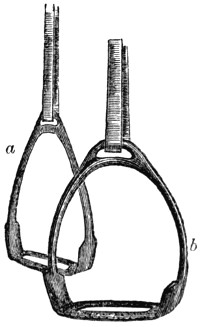
The bridle is either a single or a double-reined one, according to the mouth of the pony ridden. A single-reined bridle is usually a snaffle, it being very improper to allow any one to ride with a curb alone, unless he has very steady and light hands. The snaffle bit is merely a jointed bar of iron (5 5) in the accompanying sketch, but when used alone it has a light cross-bar as well as the ring there shown, in order to prevent the bit being pulled through the mouth. This, however, in the double-reined bridle is omitted, since it would interfere with the action of the curb. Snaffles are either smooth or twisted, and are made of all sizes, the smallest being only adapted for occasional use, and not for the hands of the learner, who should have a large smooth one. The curb-bit consists of three parts; the mouthpiece (1), which usually has a bend in it called the port, for the purpose of pressing against the roof of the mouth; secondly, of the cheek-piece (2), which has a ring (3) at the lower end for the attachment of the rein, and another at the upper end for the head-piece of the bridle; and thirdly, the curb-chain (4). This chain is pressed against the outside of the lower jaw, by the upper arm of the curb used as a lever, and it should be hooked up sufficiently tight to act upon it by pulling the rein, whilst at the same time it should be loose enough to prevent its fretting the jaw. This delicacy of adjustment requires some little practice, and the young rider should always ask his teacher to show him the proper mode of applying the curb-chain. Sometimes[277] a martingale is needed, in order to keep the pony’s head down, but generally the young rider is better without it, if he will keep his hands well down, and avoid all jerking of the mouth.
The rider, even at the earliest age, should first examine the girths and the bridle, and see if they are properly adjusted; for though when leaving home he may be able to depend upon a steady and experienced groom, yet, after putting up at strange stables, he is liable to be led into an accident by careless servants, and therefore it is better to get into the habit of always inspecting these essentials to safety and comfort. If there is an attendant groom, he should hold the rein with his right hand, standing by the off shoulder of the horse, so as with his left hand to hold the stirrup iron for the rider’s right foot as he throws it over the horse’s back. The next thing to be done is for the rider to stand at the shoulder of the pony with his left side towards that part. He then lays hold of the reins with his left hand, drawing them up so short as to feel the mouth, and at the same time twisting a lock of the mane in his fingers so as to steady the hand. Next, the left foot is placed in the stirrup when the accompanying attitude is presented, exactly as here shown. At this moment a spring is given from the right foot, the right hand reaches the cantle of the saddle, and the body is raised till the right leg is brought up to the level of the left, when the slightest imaginable pause is made, and then the right leg is thrown over the back of the pony, keeping the toe down and heel elevated, or with the spur on mischief may happen, while the right hand leaves its hold, and the body falls into its position in the centre of the saddle; after which, the right foot has only to be placed in the stirrup to complete the act of mounting.
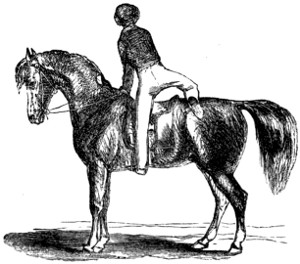
Is exactly the reverse of the last process, and requires, first, the reins to be shortened and held in the left hand with a lock of the mane; secondly, the right leg is taken out of the stirrup, and is thrown over the back of the horse until it is brought down to the level of the other leg. After this, if the pony is of a small size, suitable to that of the rider, the body is gently lowered to the ground, and the left leg is liberated from the stirrup; but if the horse is too high for this, the foot is taken out of the stirrup by raising the body by means of the hands on the pommel and cantle of the saddle, and then the body is lowered to the ground by their assistance.
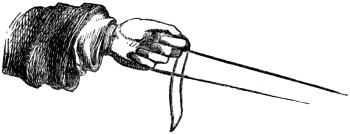
Is of great importance to the comfort of the rider, and also to his appearance, for unless they are held properly, the body is sure to be[279] awkwardly balanced. When the single rein is used, the best position is to place the middle, ring, and little fingers between the two reins, and then to turn both over the fore-finger, where they are tightly held by the thumb. In all cases the thumb ought to point towards the horse’s ears, by which the elbow is sure to be kept in its place close to the side, and a good command of the reins is insured. If a double-reined bridle is employed, the middle finger separates the two snaffle reins, and the little one those attached to the curb, all being turned over the fore-finger, and firmly held by the thumb. In both cases the ends of the reins are turned over the left, or near, side of the pony’s shoulder. When it is intended to turn the horse to the left, it is only necessary to raise the thumb towards the chest of the rider; and on the contrary, when the desire is to turn him to the right, the little finger is turned downwards and backwards towards the fork. In many well-broken ponies the mere moving of the whole hand to the right or left is sufficient, which, by pressing the reins against the neck, indicates the wish of the rider, and is promptly responded to by the handy pony. This action, however, is objected to by some good horsemen, though, in my opinion, most erroneously, as it is capable of being made highly effective in practice.

Should always be square to the front, without either shoulder being in advance; the loins moderately arched inwards without stiffness; the elbows close to the side, but held easily; the knees placed upon the padded part of the flat in front of the stirrup-leathers; toes turned very slightly outwards, and the foot resting on the stirrup, the inside of which should be opposite the ball of the great toe, and the outside corresponding with the little toe. In hunting, however, it may be placed “home,” that is, with the stirrup close to the instep. The heel should be well lowered as far as possible beneath the level of the toe, which gives a firm seat. But the great point is to obtain a good grasp of the saddle by the knees, which should be always ready to lay hold like a vice, without however constantly tiring the muscles by such an effort. The left hand is now to be[280] held very slightly above the pommel of the saddle, and the right easily by the side of it, with the whip held in a slanting position, as at page 273, in which however both hands are much too high above the withers. In order to show the effect of an incorrect mode of holding the reins, the rider has only to place his hands with the knuckles in a horizontal position, and the elbow is sure to be turned out in a most awkward manner.
Is effected by the reins, heels, voice, and whip, variously used according to his disposition and temper. Some require only the most gentle usage, which in fact is almost always the most efficacious, especially by young people, for whom the horse and dog seem to have an especial affection, and to be always more ready to obey them than might be expected, when their want of strength to enforce their wishes is considered. The young rider will therefore generally find it to his own interest, as well as that of the noble animal he bestrides, to use his whip and heel as little as possible, and to effect his object solely by his voice and the gentlest pressure of the bit. In this way the most high-couraged horses are kept in order by young lads in the racing stables, and the amateur will do well to follow their example. It is astonishing how fond horses and dogs are of being talked to by their juvenile masters, and it is right to gratify their love of society by so doing on all occasions. The reins serve, as already explained, to turn to the right or left, or by drawing tight to stop the horse, and on the contrary, by relaxing them to cause him to proceed, aided if necessary by the voice, heel, or whip. When it is desired that the right leg should lead in the canter or gallop, the left rein is pulled and the left leg pressed against the flank, by which means the body of the pony is made to present the right side obliquely forwards, and by consequence the right leg leads off. On the other hand, if it is wished to lead with the left leg, or to change from the right, the right rein is pulled, the right leg pressed to the side, and then the left shoulder looks forwards and the left leg leads off.
When it is wished to make the pony walk, he must be quieted down by soothing him with the voice if he has been excited by the gallop or trot; and then, by sitting very quietly in the saddle, and loosing the reins as much as will allow the head to nod in unison with the action of the body and legs, the walk is generally at once fallen into, and there is no farther difficulty except to prevent a stumble. A tight rein is not desirable in this pace, since it prevents that liberty of action which is required, and leads to a short walk, or very often a jog-trot; and yet there should be such a gentle hold, or[281] preparation for a hold rather, as will suffice to check the mouth in case of a mistake. This is a very difficult art to acquire, and is only learnt by long practice; but as few ponies fall at this pace, great liberty may generally be allowed to their mouths. Besides this, little is necessary, more than to sit steadily, but not stiffly, in the saddle, and not to sway about more than is sufficient to avoid the appearance of having swallowed a poker.
Are effected by rather different methods, but both require a very steady hand, and a quiet treatment. In order to cause the pony to trot, the reins are taken rather short in the hand, and the mouth is held somewhat firmly, but taking great care not to jerk it. The animal is then slightly stimulated by the voice, and the body, if necessary, rises from the saddle, as in the trot, so as to indicate what is wanted. This seldom fails to effect the purpose, and the horse at once breaks into a trot; or, if very irritable, he may be compelled to do so by laying hold of an ear and twisting it, to avoid which he drops his head, and trots as a natural consequence. The canter is also an acquired pace, and for its due performance a curb-bridle is required. In order to make the pony begin this pace, the left rein is pulled, and the rider’s left leg pressed against the side, by which the horse’s right leg is made to lead off, this being the most usual, and certainly the most comfortable “lead” for the rider. The hands must make a very gentle and steady pull on the curb-rein, and the body generally must be very quiet in the saddle, whilst, at the same[282] time, a very gentle stimulus is given by the voice, which must be repeated at short intervals, or the canter will be changed to a trot, or walk, both of which are preferred to it by most ponies and horses. Young riders should avoid cantering long upon one leg, as it leads to inflammation of the joints, and they should either change the lead or alter the pace to a trot or walk.

Requires little instruction, practice being the main agent in effecting a good seat during this pace. The seat is either close to the saddle, with the body inclining backwards (p. 275), or standing in the stirrups, in which position the knees and calves only touch the saddle, and the body is bent forwards over the withers (p. 273). It should be the endeavour of the rider, while he bends his shoulders forwards, to throw his loins well back, so as to avoid straining the horse’s fore-quarters, by bearing too much weight upon them. This is done by the hold of the knees on the saddle, and by keeping the feet back, also by rounding the loins backwards, and thus throwing the centre of gravity as far as possible behind the stirrup leathers. The object of standing in the stirrups is to save the horse when at his full gallop, as in racing, or in hunting, when he is going over ploughed ground or up hill. In either of these cases, this attitude allows the horse to exert himself without feeling the weight of the rider impede his movements more than can be avoided.
Is only an extra exertion added to the ordinary spring of the gallop, the attitude being exactly the same. It is best learnt by beginning with small ditches, which the rider is soon able to clear without difficulty. He may next try sheep-hurdles, or very low stiles; but the latter being strong and firmly fixed, are dangerous to the rider, unless the pony is very sure of clearing them. A leaping-bar, if procurable, should always be adopted in preference to either, as a fall over it is not attended with any bad consequences. The groom should place it at the lowest notch, and the pony then may be suffered to clear it at a moderate gallop; after which, if the young rider is able to sit pretty closely, he may be indulged with a higher notch, and gradually it may be raised until the limits of the pony’s powers are reached. In riding at a bar, the learner should lay hold of a snaffle-rein in each hand, taking care to keep them close together, by the right rein being held also in the left hand. The pony is then to be urged to a smart canter or hand gallop, and held straight to the bar in this way, so that he is obliged to leap; or if disliking the act, being urged by the whip down the shoulder, or the spur, or the groom’s voice and whip behind. Young riders, however, should never be put upon a bad or reluctant leaper, but should be taught upon one which is fond of the amusement. At the moment of rising into the air for the leap the[283] reins are relaxed, but should not be left quite loose; while the pony is in the air the body becomes upright, and as he descends it leans well back, until, after a high leap, it almost touches the croup. During this period the reins should be suffered to remain nearly loose, the hand barely feeling the mouth; but as the pony reaches the ground a stronger hold is taken, in order to guard against a mistake, which might require the aid of the rider to prevent a fall. It is not that he can keep the animal up, but that he checks him, and makes him exert himself in a double degree. There are various kinds of leaping; as the flying leap, the standing leap, the leap in hand, &c. The flying leap is merely one taken at a fast pace, and when the rider can maintain a good seat in the gallop, it is the easiest of all to sit. The standing leap is effected from a state of quiescence, and is much more difficult to sit, because the horse rises and falls more suddenly and abruptly. Between the two is the slow or steady leap, which is only effected safely by the clever hunter or well-broken pony; but when perfect it is almost as smooth as a rocking-horse. This is the mode in which the young rider should be taught to leap. Leaping in hand is necessary for most ponies in the hunting field, which would otherwise never be able to compete with full-sized hunters in the way they do. The young hunter, when he meets with a gate or other strong fence, which he knows is too much for the powers of his pony, at once gets off and leads him over by the rein; and when well taught, these little creatures will often tilt themselves over high timber, &c. in a marvellously clever manner, so that I have known them in this[284] way obtain a good place in long and severe runs. If, therefore, my readers are allowed to partake in this exciting sport during their Christmas holidays, they should teach their ponies to leap in hand, or they will be sure to be thrown out.

The chief vices which are met with among ponies are—1st, Obstinate Stopping; 2d, Stumbling from Carelessness; 3d, Rearing; 4th, Kicking; 5th, Shying; and 6th, Running Away.

Obstinate Stopping, which in its worst forms is called “jibbing,” is a very troublesome vice, and even in the saddle is sometimes attended with danger, whilst in driving it is so to a dreadful degree.
The rider should never attempt to force his pony forward with the whip or spur, which only aggravates the bad-tempered brute; but should patiently sit quiet in the saddle, and keep his temper, until the pony chooses to move forward again. In this way sometimes very vicious animals are cured when they find that their stable is not the sooner reached by their device; on the other hand, if the whip is used, the pony, especially if of Welsh breed, is very apt to lie down and roll his rider in the dirt, or even sometimes to bolt into a river, or pond, and leave him in danger of his life. My young friends will therefore remember my advice when being mounted upon an obstinate pony, and having lost their tempers, they have proceeded to use their whips, and are bemired or half drowned in consequence.
Stumbling is more a defect of conformation than a vice; but nevertheless, it greatly depends upon a want of spirit to keep up a steady action of the fore legs. It often happens that a pony trots along for[285] a mile or two safely enough; but after going that distance he becomes lazy and careless, and trips with one foot and then with the other, a sure prelude to such a fall as the following, which would be a very bad one, and sufficient to cut both knees to the bone, and to cause serious damage to the rider. The only way to avoid such accidents is to keep the pony at a steady pace, fast enough to keep him alive, but not enough so to tire him. Loose stones and broken ground should be avoided, and a careful hold should be kept upon the mouth, without being so tight as to gag it. When a stumble actually takes place, the body should be well thrown back and the mouth forcibly jerked, so as to make the pony exert himself to keep his legs. An unsafe animal of this kind is, however, wholly unfit for young riders, and they should never be allowed to ride one.
Rearing is a very dangerous vice, and not very common among ponies after they are once broken in. If the rider should, however, be placed upon a rearer, he should be careful to avoid hanging upon the bit when he rises in the air, but on the contrary should loose the reins entirely, and clasp the neck, if the pony should rise very high in the air. The accompanying sketch shows this vice in a very trifling degree, and in such a case the seat thus represented is sufficiently forward to prevent accidents.
The rider will, however, observe that the reins are quite loose. It often happens that this vice is produced by too tight and severe a curb in a tender mouth, and that upon changing the bit, or letting out the curb chain, the tendency to rise is entirely gone. Whenever, therefore, the young rider finds his pony inclined to rear, let him look[286] well to his bit, and at once drop the curb rein if he has one. If, however, he has only a snaffle, he may rest assured that it is a regular habit, and at once make up his mind either to battle with it or to change his pony.

Kicking is much more common among ponies than rearing, and very many of these little animals are given to practise it. It is[287] perhaps partly owing to the teasing of their young masters that it is so common; but whatever the cause, there can be no doubt that it is too prevalent among them. Sometimes it exists as a regular attempt to unhorse the rider, which is a very troublesome habit, and one very difficult to break, because it so often succeeds that the pony is tempted to try again. When this vice is met with, the rider should do all in his power to keep his pony’s head up, by jerking the bit, and at the same time he should sit well back, with his feet well forwards, with heels down, and trust to his knees in holding on. When kicking is only the result of high spirits and “freshness,” the best remedy is a smart gallop, which soon stops all these pranks, and makes the most riotous animal quiet.
Shying is also very common among ponies, and in them is often the result of cunning, which leads them to pretend a greater degree of shyness than they really possess. The best mode of treatment is to take as little notice as possible of the shying, but carefully to make the pony pass the object at which he is looking, without regarding how this is effected. The whip should seldom be used at all, and never after the object is passed.
Bolting, or Running Away, is often the result of want of exercise, but sometimes it is a systematic vice. A powerful bit and a steady seat, with good hands, are the best means of grappling with this habit, which is sometimes a very dangerous one. If the pony really runs away, the rider should not pull dead at his mouth, but should relax his hold for a short time, and then take a sharp pull, which is often effectual. A good gallop until he is tired will often cure a runaway for the rest of his life. There are a variety of bits intended expressly to counteract this vice, such as the Hanoverian Pelham, the curb with a high port, &c.; but nothing is perfectly effectual where there is a determination to run away. A nose-band has lately been invented for the purpose, which answers better than anything hitherto brought out; it consists of a long nose-band which crosses behind the jaw and then hooks on to the bit in the same way as the ordinary curb-chain. When the rein is pulled hard, this nose-band is drawn tight round the jaw, by which the mouth is closed, and the port is pressed strongly against the roof of the mouth, causing a great degree of pain, sufficient to stop most horses. This powerful remedy, which has been named the Bucephalus nose-band, should not lightly be used; but in the case of a runaway horse, or pony, it is the only really efficacious one.
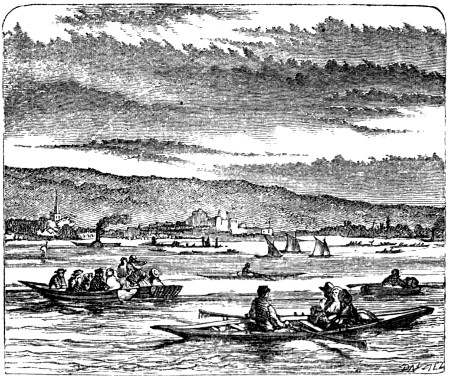
The sea service is the glory of Old England, notwithstanding all the glorious land service of ancient and modern days. A country having nearly ten thousand miles of sea-coast, with numerous ports, harbours, estuaries, river mouths, and capacious bays, must ever be a maritime nation, and look for its supremacy to the sea—to her sons being amphibious; and nothing is better calculated to develop the inherent instinct for sea duties than the amusements of boating, of rowing, of sailing, and other aquatic sports. Every young gentleman in England should know how to manage a boat, and to sail a cutter; and it will be our duty to initiate him into the methods of doing so.
The origin of ships must be traced to the ark of Noah; but this was not a sailing or a rowing vessel, but simply a large floating house or receptacle for Noah and his family, and the various types of animated nature. The first navigators were the Phœnicians, who[289] sailed in various seas. They were succeeded by the ships of Carthage, Egypt, Venice, Genoa, Holland, and Portugal. The Saxons under Alfred, and the Danes under Canute, had formidable navies. Alfred, who ascended the throne in 872, commenced the first English fleet in person, and is said to have suggested a variety of improvements in the structure, as well as greatly to have increased the size of the vessels, some of the largest of which carried sixty oars. After the death of Alfred, the naval power of England seems to have lain dormant; and this, no doubt, tempted the Norman invasion in 1066, under William the Bastard, who sailed for the coast of England with a fleet of 900 vessels; and so sensible was he of the importance of the naval service, that he gave certain privileges to certain towns on the sea-coast, which were from their number called the Cinque Ports. Richard I. fitted out large fleets; and his successor, John, asserted the exclusive right of the English nation to the dominion of the seas. The reign of Edward I. was also distinguished for successes at sea. Henry VII., on gaining the throne, in 1485, put the navy into a respectable condition; and a large ship, called the “Great Harry,” which may properly be termed the first ship of the British navy, was built at a cost of 14,000l. The discovery of America, about the period of the accession of Henry VIII., gave a new stimulus to our navy, and many ships were then built of large tonnage, some of a thousand tons. But Queen Elizabeth, deeply impressed with the maxim, that “whosoever commands the sea, commands the trade of the world,” and that “whosoever commands the trade, commands the riches of the world,” and consequently the world itself, so encouraged and restored the marine, that she may be called the “Restorer of the naval power of England;” and, in a few years after, the invasion of the Spanish Armada put our naval power to the proof. Charles I., the great and courageous Cromwell, and even the pleasure-loving Charles II., were all impressed with the great advantages of a formidable navy; and in the reign of Anne, fifty-two French ships, containing more than 3,000 guns, were captured. And during the reign of George III. the naval superiority was placed by a series of glorious successes beyond all dispute; and it is to be hoped that the reign of our beloved Queen Victoria, who is herself a sailor, and full of every generous aspiration that belongs to a British Tar, will, notwithstanding the “mistakes of the Admiralty,” prove that England still retains the sovereignty of the ocean, and on that element she will defy the world.
The Egyptian vessels are the earliest of which any well-authenticated graphic illustration has been preserved. We here give a view of one of their earliest sailing vessels. The celebrated Egyptian vessel called the “Isis” is said to have been in length 180 feet, in[290] breadth 45 feet, and in height, from the upper edge of the deck to the bottom of the well, 43 feet. The well-known ship of Hiero, king of Syracuse, was nearly 400 tons burden.

They were in length about 125 feet, and in breadth 10 feet. Their first requisite was swiftness, and no part of the side was left vacant where an oar could be put out; hence they had often three banks of oars, one above the other. In most ancient ships, there was placed at the prow an image called “the sign.” The part of the vessel that cut the water was called the “goose.” At the stern, which generally resembled a shield, was set or some way delineated a representation of the deity to whose tutelary favour the ship was committed, and to which daily prayer and sacrifice were offered. War ships were chiefly rowed with oars, that they might be able to tack about. The first long ships were rowed with fifty oars, but afterwards a larger number was used. In the more perfect condition of ancient navigation, there were some ships that had as many as five tiers of oars, and three hundred rowers. Two large holes at the prow of the vessel, occasionally used for oars, were called the ship’s “eyes;” and a wooden projection at the prow, covered with brass, was called a “beak;” and pieces of wood placed on each side of the prow of a vessel, to ward off the force of the enemy’s beak, were called the ship’s “ears.” Over these vessels were certain raised platforms, and on their forecastles were towers on which the soldiers stood, whose shields were[291] usually hung upon the railings which begirt the ship. The sides of the prow were called “cheeks.” The anchors at first used were often large stones, or even bags of sand; afterwards, however, the ancient ships carried anchors with one, two, and four flukes. The larger anchor was called the “sacred anchor,” and reserved for the most trying occasions. Among the ancients, ships were usually termed “horses,” which explains many ancient fables. The elder Pliny, for instance, tells us of a boy who was carried by water some miles every day on the back of a dolphin to school; the vessel, in all probability, having a dolphin at the prow. Arion, the famous musician of Lesbos, having made great wealth in foreign parts by his profession, was returning home by ship, when the sailors resolved to kill him, and seize upon his riches. Playing once again, at his last request, a favourite tune, he leaped into the sea. A dolphin, attracted by his melody, received him safely on its back, and carried him again to the coast where Periander lived. Arion, doubtless, escaped by a boat, the fore-part of which consisted of a dolphin.
Having thus given the young reader a notion of ancient boats and ships, we shall now proceed to make him acquainted with the modern practices of rowing, boating, sailing, &c.
A Boat is properly a vessel propelled by oars. In a more extensive sense the word is applied to other small vessels, which differ in construction and name, according to the services in which they are employed. Thus they are light or strong, sharp or flat-bottomed, open or decked, according as they are intended for swiftness or burden, deep or shallow water, &c.
The Barge is a long, light, narrow boat, employed in harbours, and unfit for sea. The Long Boat is the largest boat belonging to a ship, generally furnished with two sails, and is employed for cruising short distances, bringing the cargo and bales on board, &c.
The Launch is more flat-bottomed than the long boat, which it has generally superseded. The Pinnace resembles the barge, but is smaller. The Cutters of a ship are broader and deeper than the barge or pinnace, and are employed in carrying light articles, single passengers, &c. on board.
Yawls are used for similar purposes to the barge and pinnace. A Gig is a long, narrow boat, used for expedition, and rowed with six or eight oars. The Jolly Boat is smaller than a yawl, and is used for going on shore. A merchant ship seldom has more than two boats,—a long boat and a yawl.
A Wherry is a light, sharp boat, used in a river or harbour for transporting passengers. A Punt is a flat-bottomed boat, chiefly used for fishing on a fresh water river. A Skiff is a small sharp-nosed boat, used in rivers. A Dingy is a very small stiff boat used by yachts. A Yacht is a pleasure sailing-boat. A Lugger is a boat[292] which is furnished with sails of a peculiar cut. A Funny is a small light boat used in river rowing, and made with her bow and stern nearly alike.
Rowing boats consist of the bows (1); the stem, or entrance (2); the stern (8), where are the rudder and the lines for steering; the rowlocks (3), for giving purchase to the oars; and the thwarts, or seats (4). At the bottom are the foot-boards (5), which are easily removed, in order to bail out any water which may leak into the boat. Besides these parts there is a board placed across the boat for the feet of the rower, called a stretcher. The whole boat is composed of one or more planks, called streaks, nailed upon a light oak framework, called the timbers, or ribs; and the upper streak, upon which the rowlocks are placed, is called the wale-streak. Boats with two rowlocks opposite each other are called sculling boats, and are propelled by a pair of light oars called sculls, the art being called “sculling.” When a boat is fitted with a pair of rowlocks not opposite each other, it is called a pair-oared boat. If with two in the middle opposite each other, and two others, one before and the other behind, but not opposite each other, it is called a randan. When a boat has four rowlocks, none of which are opposite one another, it is called a four-oared boat, and so on up to ten oars, which is the utmost limit in common use for any kind of boat but the pleasure barge, which sometimes has twenty-four oars, as in the City barges of London. The rowlock nearest the bow is called the bow rowlock, or No. 1; the next No. 2, and so on; and the oars used in them receive the same number, the one nearest the stern being called the “stroke oar.” The rowlocks in river and sea boats are somewhat different in shape though identical in principle, both consisting of a square space of about the breadth of a man’s hand, and both lying on the wale-streak; but in river boats being generally bounded before and behind by a flat piece of oak or ash called, respectively, the thowl-pin and stopper; whilst in sea boats they are merely common round wooden pins dropped into holes made in the wale-streak, but still receiving the same names. The thowl-pin is for the purpose of pulling the oar against, whilst the stopper prevents the oar from slipping forwards when the rower is pushing it in that direction after the stroke.
A scull is a small oar used with one hand, and requiring a pair, as in the case of oars, one being placed in the rowlock on each side the boat, and the pair being used by one person with his right and left hands. Oars are used by both hands, and a pair-oared boat consequently requires two oarsmen; a four-oared boat four, and so on. Both sculls and oars consist of the same parts, except that the handle of the oar is made long enough for both hands, as at (b). In every case there is a rounded handle (a b), a loom, square in form, and extending from the handle to the button, or about one-third of the length of the oar; and beyond the button is the blade, which is first nearly round, and then gradually widens, until it assumes the form best adapted for laying hold of the water, which is now found to be broad rather than long, as was formerly thought to be desirable. The button is a piece of leather nailed on to prevent the oar from slipping through the rowlock, but only used in river rowing, as it is not adapted for the rough work which is often met with in sea rowing.
This is necessarily less elegant than river rowing, because of the rough nature of the element on which the exercise is pursued. The oar must be held firmly in the hands, the inside hand being placed at (b), and the outside at (a), and both hands grasping the oar between the thumbs and fingers. The whole art consists in the crew moving backwards and forwards together, called “swinging,” and laying hold of the water as well as they can, taking care to avoid pulling in the air with great force when there is a trough or interval between two waves, and on the other hand equally avoiding a heavy wave, which has a tendency to dash the oar out of the hand. All this requires practice in the rowers, and also in the steersman, called the coxswain, who should watch for the high waves, and warn his men when a heavy one is coming. He should also take care to cross the roll of the sea as much as possible, so as to avoid being struck on the side of the boat called “the counter,” which would either swamp her, or else knock the oars out of the rowlocks. In this kind of rowing, the “feathering” of the oar, to be presently described, is not attempted, on account of the roughness of the water, but it merely is pulled steadily, but strongly, backwards, and is then pushed forwards in the rowlocks.
The art of river rowing is capable of a high degree of elegance, and few sights are more pleasing to a lover of graceful forms than[294] that of a crew of fine lads, or young men, rowing well together and in good style. To do this requires great practice, and attention to a few essential points, which I will here endeavour to describe.
The rower should, as far as possible, take some good oarsman for his model, and endeavour to imitate him in every respect, which is the only mode of acquiring a good style. Description is useful in putting the learner in the way of acquiring what is to be taught, but it is not all-sufficient for the purpose. In the first place, the learner should place himself square on the seat, with his feet straight before him, and the toes slightly turned out. The knees may either be kept together, in the Newcastle or Clasper style, or separated considerably, as practised generally in England, the latter being in my opinion the better mode, as it allows the body to come more forward over the knees. The feet are to be placed firmly against the stretcher, which is to be let out or shortened, to suit the length of the individual; and one foot may be placed in the strap which is generally attached to the stretcher in modern boats. The oar is then taken in hand, raising it by the handle, and then either at once placing it in the rowlock, or else first dropping it flat on the water, and then raising the handle it may gently be lowered to its place. The outside hand is placed upon the handle at (a), with the thumb as well as the fingers above it, while the other hand firmly grasps it lower down at (b), keeping the nut towards the person. The arms are now quickly thrust forward till they are quite straight at the elbows, after which the back follows them by bending forward at the hips, carefully avoiding any roundness of the shoulders. When the hands have reached their full stretch they are raised, and the blade quietly and neatly dropped into the water; immediately after which, and with the water just covering the blade, the body is brought back with a graceful yet powerful action, till it reaches a part a little behind the perpendicular of the back of the seat, when the hands are brought back to the ribs, the elbows gliding close by the hips; and at the last moment, as the hand touches the rib, the wrist of the inside hand is depressed, the knuckles being at the same time brought against the chest, and the oar is made to rotate in the rowlock, which is called “feathering” it, and by which it is brought cleanly out of the water. The next action is to push the oar rapidly forward again, first however restoring it to its original position in the rowlock, which is effected by raising the wrist, and then darting the arms forward till the elbows are quite straight, which brings the rower to where we started from in the description. In “backing water” the reverse of these actions takes place. The oar is first reversed in the rowlock, and then it is pushed through the water with as much power as is needed, and pulled through the air. When the oars on one side are pulled, and those on the other are backed,[295] the boat is made to turn on its own water. “Holding water” is effected by the oars being held in the position of backing without moving them.
1st. To straighten the arms before bending the body forward; 2d, to drop the oar cleanly into the water; 3d, to draw it straight through at the same depth; 4th, to feather neatly, and without bringing the oar out before doing so; 5th, to use the back and shoulders freely, keeping the arms as straight as possible; and 6th, to keep the eyes fixed upon the rower before them, avoiding looking out of the boat, by which means the body is almost sure to swing backwards and forwards in a straight line.
Every boat without a rudder is manœuvred in the water, either by pulling both sides alike, in which case it progresses in a straight line, or by reversing the action of the oars, equally on both sides, pushing them through the water instead of pulling them, and called backing water, when the boat recedes; or by pulling one side only, on which the boat describes a segment of a circle, which is made smaller by pulling one oar, and backing the other. By means of a rudder the boat is made to take a certain course, independent of the rowers, called “steering,” the chief art in which consists in keeping the rudder as still as possible, by holding the lines “taut,” and avoiding pulling them from one side to the other more than is absolutely necessary. Some steersmen think it necessary to swing backwards and forwards with a great effort, but this is quite useless, and the more still they keep the better. Every coxswain should know the course of the stream or tide; and when meeting other boats he should, if he is going down stream, give them the side nearest the shore, so as to allow them the advantage of the slack water, which is quite prejudicial to him. When a crew are steered by a competent coxswain, they ought to be perfectly obedient to his commands, rowing exactly as he tells them. His orders are communicated by the following words, viz. when desiring his crew to row he says, “Pull all;” or if wishing any one oar to be pulled, he says “Pull bow,” or “Pull, No. 3,” or 4, &c. as the case may be. If they are to stop rowing, he says “Easy all,” or for any one oar, “Easy bow,” or No. 2. The same kind of order is conveyed when “backing” or “holding water” is desired; the only variation, as before, being between confining his order to any one or more oars, or extending it to all. In this way all the evolutions practicable on the water are managed, and the coxswain has complete control over the boat, being able to cause her to be rowed slowly or quickly, or to be stopped, backed, or turned on her own centre.
Is of the utmost importance to the success of a boat when she is manned by a crew; and they should all endeavour to attain the same style as the “stroke-oar,” who should be the best in the boat, and as free from faults as possible. In a four or eight-oared boat, every one of the crew would do well to imitate his stroke by rowing with him occasionally in a pair-oared boat, or else, if this is not practicable, by pulling behind a waterman who rows in the same style as the stroke-oar. In this way an uniform kind of rowing is attained, and the boat is propelled equally by all at the same time. The great object is for all to lay hold of the water at the same moment, and pull their oars through it and out with the same power and at the same time; this is called “keeping stroke.” “Keeping time” means, all “feathering” the oar together, by which the peculiar click of the oars in the rowlocks is made exactly at the same instant. When this is not done precisely together, the “time” is defective, and the ear at once detects the error; but even when the “time” is ever so good, the want of keeping stroke is fatal to the speed of any boat, however good the individuals may be.
Do not be over anxious to avoid “catching crabs,” which is an event likely to occur in early practice; and should it happen, throw the oar quickly upwards out of the rowlock, and no mischief will ensue. The young rower should be at once shown how to free his oar in this way, and then he may pull with that freedom from restraint which is necessary to produce a good style. Do not stand on the seats, or lean out of the boat, and never attempt any practical jokes on the water, as it is a dangerous element to trifle with.


It would be very difficult to trace to its origin the art of sailing. Perhaps the curled leaf passing over the water, with one end erect, might have given to observant man the first notion of a sail. It has been supposed that the Nautila, Argonaut, or sailor-fish, was suggestive of the first sailing-vessel; but long before the Argonaut had been noticed, sails of some kind or other had no doubt been common. A man could not stand in the simplest boat without perceiving that the wind exerted a power upon him and his boat; and therefore the idea of a sail must have been identical with the first launching of the rudest boat. The science of sailing, however, has grown up gradually through a succession of ages, and has now reached a perfection of which the ancients had no idea.
We will first speak of the various kinds of vessels, which are distinguished principally by the number of masts, and the number and shape of their sails.
A Sloop is properly a vessel with one mast, having her sails, with the exception of her topsails, set in the plane of her length, which is technically called “set fore and aft.” Her topsail is a square sail,[298] rigged at right angles to the plane of her length. The bowsprit is generally elevated from the bows, inclining slightly to the deck. The term “sloop” is now usually applied to a man-of-war, ship-rigged, and carrying less than 18 guns.
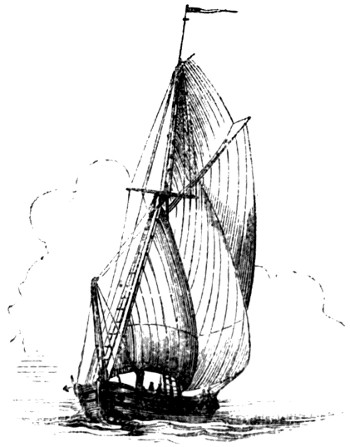
A Cutter differs from a sloop in being without a square sail, and in having her bowsprit horizontal; her mast at the same time “raking” aft. Her topsail is fore and aft, and triangular in shape.
A Brig is a square-rigged vessel, with two masts.
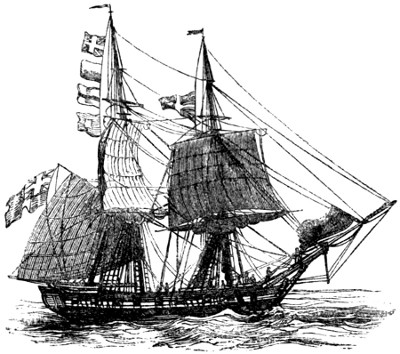
A Schooner is a two-masted vessel, with fore and aft topsails, which are called gaff-topsails. Sometimes she has a square fore-topsail and top-gallantsail.
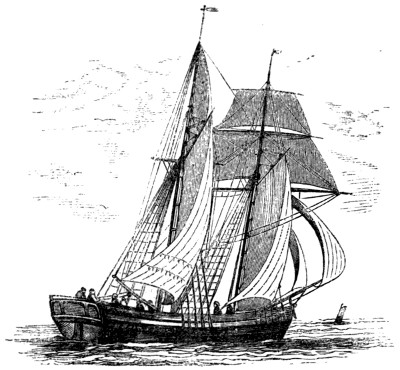
A Brigantine is something between a schooner and a brig, and is worked either with oars (called sweeps) or sails.
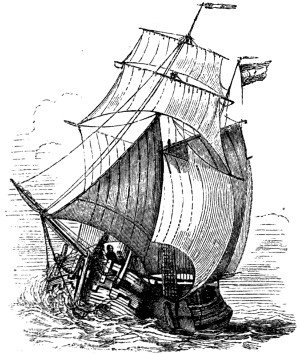
DUTCH GALLEOT.
A Dutch Galleot is rigged like a schooner, but of a broader and more Chinese build, her bottom being nearly flat.
A Billy-boy is rigged sometimes like a sloop, and sometimes like a schooner; but her bottom is nearly flat, and she draws but little water.
A Smack is a small vessel with one mast like a cutter, used principally for fishing.
A Canoe is a boat used by savages, usually made of a trunk of a tree, hollowed.

A Felucca has two triangular sails, is used in the Mediterranean, and is particularly swift. It can also use oars in calm weather.
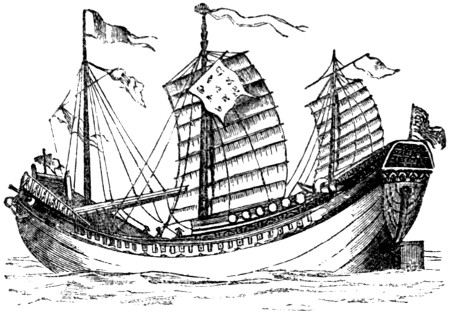
A Junk is a Chinese vessel, used either for war or merchandise, is built very heavily.
A Proa is used by the natives of the Ladrone Islands, and is remarkable for its swiftness and sailing close to the wind. The lee-side is quite straight, and the weather-side is convex, like a common boat. Both head and stern are equally sharp; and in working her there is no necessity to tack or turn at any time. Besides this peculiarity of construction, the proa has on her lee-side what is called an “out-rigger,” which is made of two poles, extending about 10 feet from her side, having at their extremity a piece of solid wood. This prevents her from having any lee-way. She will sail with a good wind twenty miles an hour.
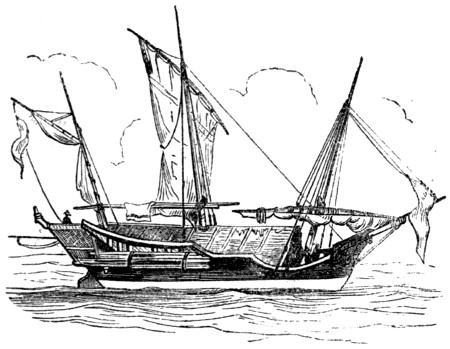
The natives of the Society Islands use a canoe, averaging in length from ten to forty feet. It is made of a trunk of a tree, hollowed out; and is just wide enough for a person to sit down. It will carry from one to as many as thirty persons. It also has an outrigger, like a proa. When a native leaves one island to go to another, he joins two large canoes together, and builds on them a small hut, which will hold all his family. This is the most convenient way to travel in a canoe, for it is difficult to see anything but one’s knees when sitting down in the ordinary manner. These canoes carry a square sail in the fore-part.
We will now speak of the vessels we have most to do with—viz. yachts.
Speed, safety, and accommodation are the three first qualities of a yacht. She ought to be pleasing to the eye when afloat, of such a breadth as to carry her canvass with ease, and at the same time so[302] sharp in her bow and well-shapen astern as to displace her weight of water smoothly and gradually, while she leaves it in the same way.
Yachts are of various kinds, according to their size. If more than eighty tons burden, the schooner is most suitable; for, as the spars are more numerous, they are proportionally lighter. The schooner, as has been before observed, has two masts—the foremast and mainmast; the one bearing the sail called the boom-foresail, and the other a mainsail. She has two or more headsails, called staysail, fore-staysail, and jib. Her topsails are either square or fore and aft.
The Cutter has one mast and four sails—viz. mainsail, maintopsail, foresail, and jib. Some smaller craft have larger jibs, and no foresail.
The Dandy-rigged Yacht differs from a cutter, in having no boom for her mainsail, which can consequently be brailed up by a rope passing round it. She has a mizen-mast standing in the stern, which sets a sail called a mizen, and which is stretched on a horizontal spar, projecting over the stern. This style of rig is more safe for a yacht, as the boom in ordinary cutters is liable to sweep persons overboard; and the sail can be taken in quicker by brailing it up than by lowering it down.
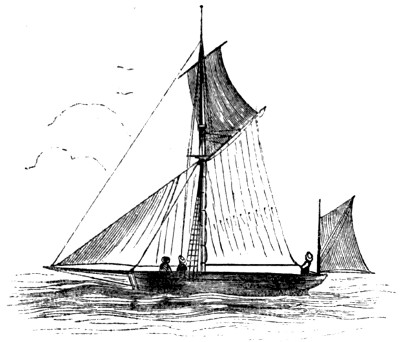
The Hatteener has only two sails, a fore and a main sail, of a triangular shape. Each has a spar standing from the deck to the peak of the sail, and a boom at the bottom, like a cutter. This rig, from setting more canvass abaft, is well adapted for narrow waters.
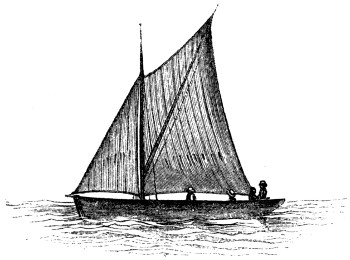
One of the most handy rigs for a young sailor is a triangular mainsail[303] and foresail rig, on a good-sized open boat. She should be at least twenty feet long, and five feet on her beam. The foresail is carried over the stem for about a foot, by means of an iron bowsprit, which ships and unships on the nose of the boat. Her mainsail has a spar reaching from the lower part of the mast to the upper corner of the sail; a rope is fastened in the middle of this spar, and passes through a block on the mast, by which the sail is hoisted. The advantages of this rig are, that it can be easily managed, while under it the boat is much safer than under most other kinds of rig; for, should a squall arise, the yachtsman has only to let fly his foresheet and put his helm alee, and the boat will right immediately. With this rig, a boat stands very well to windward, and may be easily brought about.
But the vessel with which we have most to do in our directions for sailing is the Cutter Yacht, which stands closer to the wind than any other kind of European boat; and of which we propose, in the first instance, to give a general description.
The first step in the construction of the hull is laying down the keel or backbone of the vessel; which is done by fixing a strong piece of wood, generally oak, upon blocks, that the rest of the timber may be securely added; the stem is then joined to the fore-post, nearly at right angles, slanting a little forward as it ascends; and the stern-post to its after or hinder part, sloping upwards and backwards. The[304] timbers and ribs are next cut out of solid wood, and placed transversely on the keel, their width varying according to the lines of a plan previously drawn out,—being, of course, farthest apart at the beam; these, as well as the planks of larger craft, are made to bend into the required shape by being steamed and bolted in while hot. The skeleton being completed, her planks are then secured by copper or iron nails to the timbers, and riveted. The deck is made of narrow planks, running fore and aft. From the level of the deck, her sides are raised by upright timbers, called “stancheons,” cased over by the bulwarks, and surmounted by a rail called the “gunwale.” Some yachts are only half-decked, the after-part being left open and fitted with seats; but, in order to prevent the water from getting in, a portion of deck, called water-ways, is left at each side; which opposes a further barrier by its terminating on the inner edge in a high crest or combing. The stepping the mast requires great care, since the good or bad sailing of the boat depends very greatly upon it. If we divide the length of a good yacht into three parts, the point at which the foremost part joins the middle part will be the widest part, and there will be nearly the place for the cutter’s mast. But the American builders have departed from this rule in the construction of their celebrated yacht, “The America,” whose model, after all the study and ingenuity that have been applied to yacht-building, seems to resemble the simple yet beautiful model which nature has given us in the duck. The bow of this vessel rises very gradually for some distance along the keel, like the breast of the duck; and, further imitating the same model, her beam or widest part is abaft, or further back than the centre. This superior vessel will sail nearly four points[305] off the wind, and will probably work an entire change in the present style of yacht-building. We have now glanced at all the principal parts of the hull, except that all-important part, the rudder; which swings by a hinge from the stern-post, and is moved by a handle fixed to its upper part, bearing the name of “a tiller,” and which is used to steer the boat. Before proceeding with our instructions for sailing a yacht, it will be necessary to describe the action of the rudder; as the art of steering is the nicest and most important branch of seamanship.
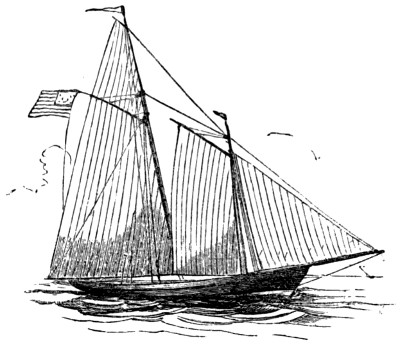

The rudder is a flat board, with a pole rising up on the side, which is fastened to the vessel; on the top of which is fixed the tiller. In large vessels, there are two ropes fastened to the tiller, which are carried through blocks on each side of the vessel; then brought back through blocks fastened on the mizenmast, and passed round a wheel, by which means a greater command is obtained over the rudder. When the tiller is moved to the right (starboard), the rudder, of course, is forced in the water to the left (port). As the vessel moves on, the water presses against the rudder on the port side, and thus forces her stern to the starboard side, and her bow to the port. When the tiller is moved to the left, it of course produces a contrary effect. If the ship is moving backwards, then, by moving the tiller to the right, the bow is also turned to the right; for the water presses against the rudder behind it on the left side, and thus pushes the stern to the left. In steering, care must be taken not to steer too much,—that is, not to move the rudder too violently or more than is necessary,—as this materially stops her way.
We here present the young yachtsman with a cutter at anchor, with her ropes and spars numbered; and which ought to be thoroughly known, as well as the uses to which they are applied in sailing a yacht:—
The Mast (8) is a spar set nearly upright, inclining a little aft, to support yards and sails. In a yacht, it is kept in its place by two shrouds on each side, made of strong rope, and fastened to the sides of the vessel.
The Bowsprit (6) is a spar carried out from the forepart of a yacht, secured at its inner end between two strong posts piercing the deck, called “the bitts.” It is kept in its place by the bobstay (7), which is fastened to the stem, and by a shroud on each side secured to the bow.
The Boom (15) is that spar which sets out the mainsail below, and is attached at one end to the mast by a swivel cable, called the “goose-neck,” and is eased off or hauled in at the other by the mainsheet (24), which is a rope passing from the end of the boom through a block on the side of the vessel.
The Gaff (14) sets out the mainsail above, and slides up and down the mast by means of a crescent end, which embraces it. The sides of this curve are called “horns.”
The Topmast (9) stands above the mast, and is made to slide up and down. On it a topsail (i. e. a gaff-topsail) is set in light winds; but both sail and mast are generally lowered in squally weather. It[307] is kept steady by a backstay (17) on each side of the foretopmast-stay. The latter is brought down to the bowsprit.
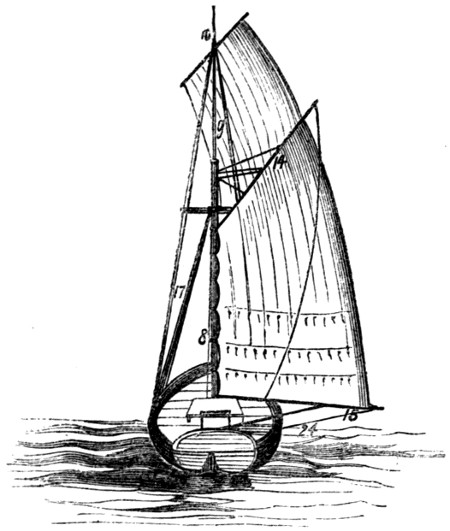
CUTTER BEFORE THE WIND.
Ropes.—There are various ropes to hoist and lower sails, called haulyards (pronounced halliards). There are also other ropes of great importance, especially those called the sheets, which are to haul in the sails, and make them stand to the wind. In a yacht, the mainsail has sometimes a sheet each side; and sometimes only one sheet reeved through double blocks, which travel on an iron rod, called “a horse,” from side to side. The jib has two sheets, the starboard and port (right and left). The foresail has the same, except in some instances, when it has but one sheet working on a traveller, like the mainsail. The topsail has only one, which is rove through a sheave at the end of the gaff and a block at the throat of the gaff, and then down to a cleat or fastening place on the deck. Signal[308] haulyards are for hauling up the colours, and pass through a small sheave, in the truck (10), at the end of the topmast. The ensign haulyards are reeved through a small block at the peak end, and lead down to the boom. The other ropes on board a yacht are for the support of the spars, and are called “standing rigging,” while those used for the sails are called “running rigging.”
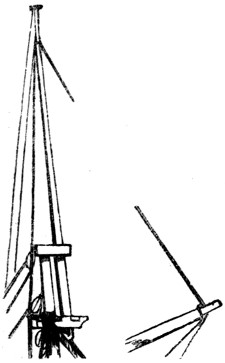
TOPMAST AND FORETOPMAST STAY.
If the reader has paid attention to our instructions, he ought now to be pretty well conversant with build, rigging, spars, and sails of a yacht; the next thing, therefore, is to explain the actual practical sailing of a yacht. The number of hands must depend on the tonnage of the boat and the number of sails. It is best to have a steersman, and one hand for each sail. Our yacht is now lying at anchor, or moorings, which consists of a chain and buoy, fastened to a heavy anchor sunk in the bed of the river. Having got on board, by means of the little boat called a “dingy,” we first unloose the fore and mainsail, and forestaysail; haul out the jib on the bowsprit, ready for hoisting; hoist the colours, with the name of the yacht or club to which she belongs, to the gaff-end; and stand by to hoist the canvass. We will suppose it just past high water, the yacht swinging ebb, and the wind up stream; we shall, therefore, have tide with us, and the wind against us. We now hoist the throat and peak halliards, till the former is well up block to block; then, by hauling at the peak-halliards till the after part of the sail is taut (tight), the mainsail is set, and she swings head to wind. The next thing is to hoist the forestaysail and the jib, which must be well purchased up, and the sheet well hauled in, before we can get her on the wind, i. e. sail close up to the wind. The ropes must now be coiled up, and hung on the cleat belonging to each. Our canvass being now up, we may cast off, slack out the mainsail, haul in jibsheet on the contrary tack to which we intend to sail, and we are under weigh.
We have already told the reader that “starboard” means right, and “port” means left. Formerly, the word “larboard” was used for left; but, owing to the similarity between the two words starboard and larboard, the word port was substituted for the latter. A boat is said to be on the starboard tack, when the wind is blowing from the starboard side; the port side is then called the lee side, and the starboard the weather side. She is on the port tack when the wind blows from the port side, which is then called the weather side, and the starboard the lee side. When in steering she is brought nearer the wind, she is said to “luff;” and when further from it, to “bear away.” When the helm is put so as to cause the boat to luff, the helm is “put up;” when it causes the boat to bear away, it is “put down,” or a-lee.
Proceeding to our cruise, we must haul the jib-sheet well in, put the helm up, and sail close to the wind; as, the wind being against us, we shall have to “beat up,” that is, sail in a zigzag direction. In[309] sailing close to the wind, we must always take care not to sail too close, but always keep the canvass quite full. Upon the skill of the steersman, mainly depend the motions of the boat; he must endeavour to attain the happy medium of keeping the boat close to the wind, and yet not allowing the canvass to shake. The practised yachtsman feels with his helm every variation of the wind, and meets it with a turn to port or starboard; but the young sailor would do well to watch the colour at the masthead, and, by keeping it in a line with the gaff, he will not steer very wildly. We are now getting near the opposite bank from whence we started, and must therefore tack. If the boat is quick in stays (i. e. will go round quickly), and the bottom is not muddy, and is deep enough for the boat, we may go pretty close to the bank before we tack; but if she is a slow tub, we must begin in good time. First, we must see that all the canvass is quite full; then the mainsail must be hauled to the middle of the boat, or amidships, and the helm put gradually down. When she is head to wind, let fly the jibsheet; if she is on the starboard tack, haul in the port foresheet taut, which is called backing the foresail; the wind, by blowing on the foresail, assists the boat round. When she begins to fill on the other tack, cast off the port (now the weather) foresheet, and haul in the leesheet and also the jibsheet, and trim the mainsail (i. e. let go, or haul in, the mainsheet), according to the direction of the wind. If when the boat is in stays, or head to wind, she moves neither way, put the helm amidships; if she moves back, put the helm the contrary way to what you had it before, resuming its former position when she moves on again. When the wind gets more on our beam (i. e. blows directly across us), we may slack out the canvass a little; the more aft it blows, so much more we must square our sails. There is a heavy cloud in the wind’s eye, that admonishes us that a squall is brewing, and the dark ripple of the water to windward tells us that it will soon be here. Keep her well full, that as the squall strikes her she may have good way on; and luff into the wind as soon as the squall begins: and if she does not right at once, let go jib and foresheets; if that fails, cast off the mainsheet, and send a hand to stand by the fore and jib halliards, which must be let go when the squall becomes violent. We must now reef the mainsail; to effect this, allow plenty of room for driving to leeward; set taut the “topping-lift,” a rope which hoists up the end of the boom; lower the halliards; hook at the end of the boom an earring which is higher up in the sail, and tie up the reef-points; then, having set up our mainsail, hoisted a smaller jib, and drawn in the foresheet, we are under sail again.
We must take care always to observe the rules of sailing, when meeting with another yacht. Whichever boat is running free must make way for one close hauled; for a boat when close hauled cannot conveniently alter her course, but when she is running free she is always able to move to which side she pleases. As we get into wider water, we shall find more swell, that impedes the boat to windward;[310] but, if the waves be long enough, there is a way of easing her over them, by putting down the helm slightly, just before the highest of them strikes her bow; thus, by stopping the boat’s way, she strikes the sea with less violence.
Our destination outward bound being in sight, we must prepare to bring up. The anchor must be got on deck; the cable passed through the hawsehole, and shackled or fastened to the anchor, with its stock made ready and secured; then suspended over the bowsprit shrouds, and made ready to let go. Lower the head-sails, put down the helm till she is head to wind, and when she is fairly stopped we may drop the anchor.
The mainsail may now be triced up, with the peak lowered, and with the helm to one quarter or the other, according as the tide sets; we may then hope to lie securely as long as we choose.
In getting under weigh once more, first haul the cable short; get all the canvass ready to set up; weigh anchor, and, as the wind is fair, set the head sails first and the mainsail afterwards; the peak should not be too high in running, nor the back of the mainsail fast, but raised slightly to let the wind into the head sails. The tide is now against us; we must, therefore, keep out of the strength of it as much as possible.
In rounding the next point we shall jib, or jibe, one of the most difficult manœuvres in sailing; for in doing so there is danger of broaching-to, so as to run on shore; of being swept overboard by the boom as it passes from side to side; and of carrying away or snapping the boom itself. To avoid these mischances, give the shore a wide berth; take in the mainsheet, keeping its coils clear for running out; trice up the tack of the mainsail, and if the breeze is strong, lower the peak; you may then put your helm to the opposite side to which the boom swings, and, on the instant the mainsail has traversed to the other side, change your helm to the reverse and meet her;—this prevents the broaching-to which would otherwise occur.
We are still against the tide, and our moorings are in sight. To bring her up handsomely calls for more skill than even handling her well. Our object now must be to lay her still at the moorings from whence we started, and at the same time to have enough way to reach them. In our present case it will be best to round her to about an[311] hundred yards short of the moorings, and, when head to wind, lower the mainsail, leaving the head sails standing—this with putting up the helm will bring her head round again—then take in the jib, and, if she has way enough, the foresail also; and with the opposing tide we may steer our craft so steadily to the buoy as to take it on board with ease.
Having informed the young sailor of what is necessary to be done on board, we will now impress on his mind a few useful nautical terms and maxims, which may lead to the preservation of life and limb.
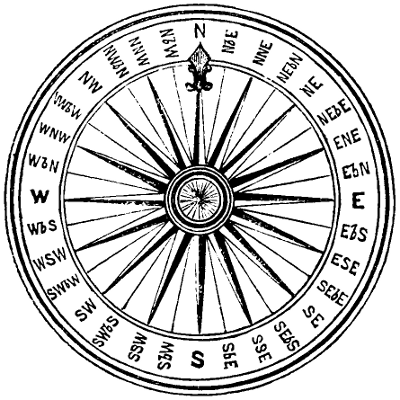
The ancients, whose only guides over the trackless waters were the heavenly bodies, so often obscured by clouds, could not venture far from shore. It is the compass which has enabled us to steer boldly across the deep. The directive power of the loadstone has been long known to the Chinese, and it was brought over to Europe about the year 1260. The communication of the magnetic power to steel and suspending it on a pivot, is undoubtedly an European invention. The compass is composed of a magnetic needle suspended freely on a pivot, and supporting a card marked with the thirty-two points of direction into which the horizon is divided, and which are thence called the points of the compass. The needle always points nearly north, and the direction of the boat may be easily seen by looking at the card. The whole apparatus on board a ship is enclosed in a box with a glass cover, to allow the card to be seen without being disturbed by the wind. This box is also sometimes suspended, to prevent the needle being affected by the motion of the vessel. The whole is then placed at the binnacle, in sight of the helmsman. In the inside of that part of the compass-box which is directly in a line with the bow, is a clear[312] black stroke, called the lubber line, which the helmsman uses to keep his course; that is, he must always keep the point of the card which indicates her course pointing at the lubber line. Every young yachtsman must learn to box the compass; that is, to repeat all its points in order.
1. Never leave anything in the gangway, and keep the decks clear.
2. Coil up all ropes; and have a place for everything, and everything in its place.
3. Take care that in tacking or jibing the boom does not knock you overboard.
4. Stand clear of ropes’ ends and blocks flying about, when you are tacking, and the sails shaking.
5. Keep a good look out ahead, and also for squalls, which may generally be observed to windward.
6. Always obey the orders of the steersman promptly.
7. Keep all your standing rigging taut.
8. When the boat is on the wind, sit on the weather side.
9. Should the boat capsize, keep yourself clear of the rigging, and swim ashore.
The young yachtsman should on no account attempt to take command of a boat till he is thoroughly experienced, and should never go in one without having at least one experienced hand on board; he should also always have his eyes open to what is going on, and be ever ready to lend assistance with the greatest promptitude. Quickness and agility are the characteristics of a sailor; without these, numerous would be the losses at sea. The casting off or belaying a rope quickly, is often attended with the most important consequences, in which the losing or saving of life may be concerned; and we would therefore advise all who are emulous of being sailors, to be attentive to their duties, quick in their evolutions, and steady in all their doings.
Aback, the situation of the sails when the wind presses their surfaces against the mast.
Abaft, towards the stern; e.g., abaft the mainmast, behind the mainmast.
About, on the other tack; going about, tacking.
Abreast, alongside of.
Adrift, broken from moorings.
Afloat, on the surface of the water.
Ahead, in the direction of the vessel’s head.
Amidships, in the middle of the vessel.
Apeak, when the cable is hove taut, so as to bring the vessel nearly over the anchor.
Astern, in the direction of her stern.
Avast, an order to stop.
Athwart, across—as “thwart hawse.”
Backstays, ropes running from topmast and top-gallantmast to her sides.
Ballast, heavy materials placed in the bottom of the boat, to bring her low in the water.
Beacon, a post or buoy placed over a shallow bank, to warn vessels.
Bearings, the widest part of the vessel below the upper deck. The bearings of an object is its direction according to the points of the compass.
Belay, to; to make a rope fast.
Bend, to; is to make a sail fast to the yard, or a cable to the anchor.
Berth, the place where the vessel lies; a man’s sleeping place on board.
Bulwarks, the woodworks of a vessel above deck; also the wooden partition between cabins.
Bunting, the woollen stuff of which ships’ colours are made.
Buoy, a floating cask or piece of wood.
Cabin, the after part of the vessel in which the officers live.
Capstan, a machine placed perpendicularly on deck, round which the cable is passed, in order to hoist the anchor. It is moved round with bars of wood stuck into it, which are called handspikes or capstanbars.
Cathead, large pieces of wood over the bow, having sheaves within them, by which the anchor is hoisted or lowered.
Cleat, pieces of wood on which ropes are belayed.
Combings, raised woodwork round the hatches, to prevent the water going down to the hold.
Companion, ladder leading down to the state cabins.
Davits, rods of timber or iron, with sheaves or blocks at their ends, projecting over a vessel’s side or stern, to hoist boats up to.
Draught, the depth of water which a vessel requires to float her.
Feather, to; to lift the blade of the oar horizontally as it comes out of the water.
Fenders, pieces of wood or rope hanging over the side of a boat, to keep it from chafing.
Fathom, six feet.
Flat, a sheet is said to be hauled flat, when it is hauled down close.
Fore and Aft, lengthwise with the vessel.
Forecastle, the part of the vessel before the foremast.
Foul Anchor, when the cable has a turn round the anchor.
Gaff, a spar to which the head of a fore and aft sail is bent.
Gage, depth of water in a vessel—this water is called “bilge water.”
Gangway, that part of a vessel’s side through which people pass in and out of the vessel.
Gaskets, pieces of rope or plaited stuff, used to fasten the sail to the yard when it is furled.
Give way, to; to row more forcibly.
Grapnel, a small anchor with several claws, generally four, used to secure boats.
Gunwale, (pron. Gun’el,) the upper rail of a boat or vessel.
Gybe, or Jibe, to; to shift over the boom of a fore-and-aft sail.
Halliards, ropes used for hoisting or lowering yards and sails.
Hatchway, an opening of the deck.
Hatches, the coverings of hatchways.
Hawser, a large rope.
Helm, the steering apparatus.
Hold water, to; to stop the progress of a boat, by keeping the oars in the water.
Jib, a triangular headsail.
Jib-boom, a spar rigged out beyond the bowsprit.
Jurymast, a temporary mast rigged in the place of a lost one.
Lee Board, a board fitted to the lee side of flat-bottomed boats, to prevent their drifting to leeward.
Log, a journal of the proceedings of a vessel; also a line with a triangular piece of board, called the log ship, which is cast overboard to ascertain the ship’s rate of sailing.
Luff, to; to steer the boat nearer the wind.
Lurch, the sudden rolling of a vessel to one side.
Marling-spike, an iron pin sharpened at one end, to separate the strands of a rope.
Martingale, or Dolphin-striker, a short perpendicular spar under the bowsprit’s end.
Miss stays, to fail going about.
Oakum, pieces of yarn picked to pieces, used for caulking.
Overhaul, to; when a rope is passed through two blocks, in order to make a tackle, the rope which is hauled on is called the fall; if one of the blocks gets loose, the act of hauling on the rope between the blocks, in order to separate them, is called overhauling.
Painter, a rope attached to the bow of a boat.
Pendant, a long narrow flag at the mast-head.
Quarter, that part of the vessel between the stern and the main chains.
Ratlines (pron. Rat’lin’s,) ropes fastened across the shrouds, like the steps of a ladder.
Scud, to; to drive along before a gale with no sail, or only enough to keep her ahead of the sea. Also, low thin clouds flying swiftly before the wind.
Spanker, or Driver, the after sail of a ship or bark. It is fore and aft sail set with a boom and gaff.
Splice, to; to join two ropes together by entwining their strands; a rope is generally formed of three strands twisted together.
Spring, to; to split a mast.
Stays, large ropes leading from the masthead forward.
Staysail, a sail hoisted on a stay.
Steerage, the part of the between decks just before the after cabin.
Stretcher, pieces of wood placed across a boat’s bottom for the rowers to put their feet against.
Surge, large swelling waves breaking over rocks.
Taut, tight.
Throat, the inner edge of the gaff which embraces the mast.
Unbend, to; to untie.
Unmoor, to; to heave up one anchor, or to unfasten the ship from her moorings.
Vane, a piece of bunting flying at the masthead to show the direction of the wind.
Waist, the part of the upper deck between the quarterdeck and forecastle.
Wake, the path that a ship leaves behind her in the water.
Wear, to; to come round on the other side of the wind without backing.

Let A B be the vessel, G the direction of the wind; A B is sailing in the direction B C, and wants to change her course to A D; if she tacks, she traverses the direction C H D; if she wears, she goes off from the wind in the direction C E D.
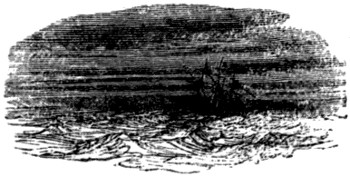

Skating is one of the finest gymnastic exercises, by which man, as Klopstock says, “like the Homeric gods, strides with winged feet over the sea transmuted into solid ground.” It is one of the healthiest exercises, bringing the body into action by a great variety of motions. The art is mentioned in the Edda, written eight hundred years ago, in which the god Uller is represented as distinguished by beauty, arrows, and skates.

SKATING.
It is not known at what period skating was introduced into England, but there are indications of it in the thirteenth century, for Fitz Stephen, in his History of London, says, that it was in that time customary, when the ice was sufficiently strong, for the young citizens of London to fasten the leg-bones of animals under the[317] soles of the feet by tying them round the ancles, and then taking a pole shod with iron into their hands, they pushed themselves forward by striking it against the ice, and moved with a celerity equal to a bird flying through the air or an arrow from a cross-bow.
Fitz Stephen describes another kind of diversion on the ice in these words, which may be acceptable to the young reader. He says: “Others make a seat of ice as large as a millstone, and having placed one of their companions on it, they draw him along, when it sometimes happens that moving in slippery places they all fall down together, which is rare sport, provided no harm be engendered.” Ibral mentions, that in his time it was customary to use sledges, which being extended from the centre by means of a strong rope, those who are seated on them are moved round with great rapidity.
The use of the modern skate is supposed to have been brought from Holland, and for many years skating has been exercised with much elegance in England and in Scotland. Somehow or other, we do not of late years have those severe frosts which enable the skater to practise his art with vigour; but there is now a skating club in London who anticipate trips to Holland during the winter months, where the art may be practised in all its perfection.
In early days we were “prodigiously,” as Dominie Sampson would say, fond of the sport. Our first attempts were made during the great frost in 1813-14, which lasted eleven weeks, and during which time there was a fair on the Thames, and skating was practised in a most delightful manner. One of the finest and most beautiful skaters of that period was Robert Fergusson, a Scotchman, who had been a “gentleman of means,” in the early part of his life, but having shot, horsed, tandem’d, dog’d, and skated away his substance, was so reduced as to become a teacher of his favourite art, and near the water works of old London Bridge, on the west side, he pitched his tent during the frost, inviting “gentlemen,” who could afford a “crown” to become his pupils in the art of “Land flying,” as he termed it. He boasted of having taught the Prince of Wales, and he sported the three ostrich feathers and “Ich dien” over his canvas. To him in youthful ardour we repaired, and the substance of his teachings we subjoin for the special benefit of our young friends.
The first maxim of Fergusson to his pupils was, “Throw fear to the dogs;” the next, “Put on your skates securely;” and the third, “Keep your balance:” and premising this as a “start,” I shall now describe the various kinds of skates, and the methods of using them.
There are various kinds of skates. Some, such as the Dutch skates, are very large and somewhat cumbersome, but very safe for those who skate with heavy loads on their shoulders, as they do in Holland, Denmark, and Russia. In these the iron often projects above six inches from the wood, and curls up towards the shin-bone above[318] a foot, that the skater may glide the more easily over the hillocks of snow common to large expanses of ice.
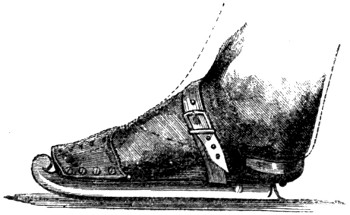
Some skates are what are called fluted, that is, they have a groove running along the centre of the iron, which are the best for beginners, as they take a better hold of the ice. The plain skates have no such groove, and are better adapted for those who have partially acquired the art, as with them the utmost velocity and elegance of movement may be performed.[4]
[4] Fluted skates, however, are dangerous for any but those of light weight, as the cut ice is apt to “ball” in the groove, and so to throw the wearer, if he leans on one side.
The iron of the skate, which lies under the foot, is called its blade; this varies in different kinds of skates, and the practised professor of skating will choose a high or a low bladed skate, according to the nature of the ice; but the beginner should never use a skate whose blade is more than three quarters of an inch in depth and a quarter of an inch in breadth, for when the blades are deeper than this, the balance of the body is not so easily preserved, and the ancles are liable to be sprained or twisted.
In putting on the skate, the “youngster” should kneel on one knee and fasten the skate on the foot of the other leg. If he should have a high laced boot, called in the eastern counties a “high-low,” he will find such an excellent support to the whole machinery. Or if he can provide himself with a “skate boot,” in which the skate and shoe are all of a piece, he will do better. Such skates were invented in the great frost about seven years ago, but just as they were coming in the frost went out; but they can still be procured. At all events, the skater should bear in mind that the skate must be fastened securely and firmly to the foot, by being well fastened to the heel and sole of the boot by means of the screw and points, and well, but not clumsily, strapped round the ancle, exactly so tight as to confine the foot without hurting it or impeding the motions of the ancle joints. There is a new skate now in use by the London Skating Club,[319] called the elastic skate, or spring skate, in which a spring is introduced at the bottom of the foot, which keeps it fast in every part. Skates are also now made of gutta percha, and these are well worthy the notice of the young skater.

Having risen to the perpendicular, the learner should first ascertain, by moving his feet about on the ice, whether the skates are firmly and comfortably fixed on his feet. He should then walk a little on them, supporting himself by a light pole about six feet in length, having an iron spike at its end. Having in this manner got a little used to the feel of the skate on his foot, he should then endeavour to throw away all fear and strike out slowly with the right foot, leaning on the inside edge of the skate, and making the pressure greatest at that part of the skate opposite the ball of the great toe, at the same time bending slightly forward. When the skate has moved about a yard forward in this manner, the left foot should be brought to the ice in precisely similar manner. The figure represents the skater starting and proceeding on the inside edge.
Having practised on the inside edge for some days, to get used to the skates, the learner may afterwards attempt the “outside edge,” which is nothing more than throwing themselves upon the outer edge of the skate, and making the balance of the body bend to that side which will necessarily enable them to form a semicircle. In this much assistance will be derived by placing a bag of lead shot in the pocket next to the foot employed in making the outside stroke, which will produce an artificial poise of the body at first very useful. At the commencement of the outside stroke the knee of the employed leg should be a little bent, and gradually brought to a rectilineal position when the stroke is completed. The best method of getting to the “outside edge” is to form the circle inwards—say with the right foot and with considerable force; in the course of this, place the left foot down in front of the right, and lean powerfully on the outside of the left heel. A little practice and confidence in his balance will enable the student to lift his right foot, and hang it behind while he proceeds to cut outside with his left foot. Let him then stop, and begin the inward circle with the left foot, and slip down the outer edge of the right heel in the same way.
The young skater has now learned to balance himself, and can venture to strike out at once to the right, on the heel of the right[320] foot, keeping the left suspended behind, with its toe closely pointed to the heel of the right. As he advances, the left must be brought past the inside of the right with a slight jerk; this slight jerk produces an opposing balancing motion of the body; the right foot then quickly poises, first on the outside of the heel, and then on the inside of its toe, and by placing the left foot down before it, and striking outside to the left, giving at the same time a slight push with the inside of the right toe, he passes from right to left. Having learned this much, the skater will proceed to change from left to right, and then from right to left again, without any trouble. To skate “outside edge” properly, the toe of the suspended foot must be pointed close to the ice behind the other, and kept there until the foot be regained, when it must be brought sharply round to the change. The skater must keep himself erect, leaning most on the heel.
This mode of skating having been acquired, an endless variety of figures, devices, and modes of movement may be practised; such as “the roll,” the figure of 3, of 6, or of 8, “the spread-eagle,” “the mercury,” “the backward outside edge,” “the circle,” “the waltz,” “the minuet,” “the pirouette,” “the quadrille,” &c.
The first step towards figure skating is the
which is performed in the manner already prescribed in the directions on the “outside edge.” To perform it gracefully, the skater should bring his left shoulder forward, throw his right arm back, look over that shoulder, and boldly incline his body to that side, proceeding alternately, with ease, grace, and deliberation. When he wishes to stop, he should bring both his feet together, and stop gradually; or he may stop suddenly, by pressing on the heels of his skates, taking care not to throw his toes up too much, or he will cut “all-fours.”
is so called from the motion being used in Holland by the travelling and trading classes in their common avocation. The figures it presents on the ice are small segments of very large circles; which enables the skater to diverge but very slightly from the right line of his course, and consequently accelerates his progress.

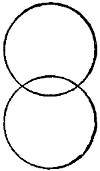
This is composed by merely finishing the great circles, of which the above segments form a part. To produce it, when the skater comes to the finish of the stroke on the right foot, he should throw the left quite across it, which will make him bear hard on the outside of the right skate, from which he must immediately strike. By completing the circle in this manner on each leg, the figure subjoined is performed.
This is performed principally on the inside edge backwards. The head of the 3 is formed of half a small circle on the heel of the outside edge; but when the circle is nearly completed, the skater leans suddenly forward, and rests on the same toe inside, and a backward motion is produced, which develops the tail of the 3. The right legged figure is that of the 3 in its natural position, and the figure made by the left leg is the same figure reversed; as per example. In these evolutions, the motion is not, strictly speaking, backwards, but rather sideways, as his face and body are always in the direction of his motions.
By the “back roll,” as it is termed, the skater moves from one foot to the other alternately. His face is turned towards the left shoulder. The inside of the left skate bears on the ice, and the skater immediately strikes from it to the outside back of the other, by pressing it into the ice as forcibly as he can at the toe. The “back cross roll” is performed in a similar manner, the stroke being from the outside, instead of the inside of the skate.

The above motions combine the elements of skating, and having acquired these, the learner may perform an infinite variety of movements, such as “the cornua ammonis,” “the Dutch maze,” “the fish,” “the kite,” “the true lovers’ knot,” &c.; with any other devices his imagination may suggest. He may also engage in the quadrille[322] or waltz, and exhibit his person in every variety of graceful form, at the same time that he exercises every muscle of the body.
1. Let your dress fit closely, but at the same time be of sufficient ease to ensure freedom of motion. Neither skirts to coats nor full trowsers should be worn.
2. Let flannel be worn next the skin by the delicate, and an extra under-garment by the robust. Let the chest be well defended against the cold. A piece of brown paper laid between the waistcoat and shirt is one of the best chest protectors.
3. Be careful in venturing upon the ice, unless it be sufficiently strong to bear the weight of the number that flock to it; and watch for the increase of numbers, that you may retire before danger ensues.
4. Avoid rough and very smooth ice, and look carefully out for obstructions thereon; such as small twigs of trees, stones, or “hobbles;” as well as for rotten ice, cracks where the ice has risen higher on one side than the other, or holes. Should you suddenly come upon rotten ice, do not stop, but pass over it as rapidly as possible. Should you fall down upon it, roll lengthwise towards the firmer part, without attempting to stand or walk upon it.
5. Should the skater fall into a hole, he should extend his pole or stick across it, and hold on to it till assistance arrives: should he have no stick, he may extend his arms horizontally across the edges of the ice, till a rope can be thrown to him.
6. After an unlucky immersion in the water, the unfortunate skater should immediately take off his skates, and, if able, run home as quickly as he can. He should then pull off all his wet clothes, take a tablespoonful of brandy in a glass of hot water, rub himself thoroughly with dry towels, and go to bed.
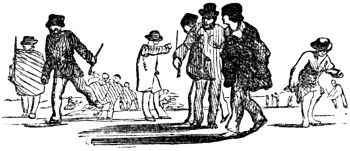
What can be jollier or more enjoyable than sliding for an hour upon a crisp wintry morning, when the snow is lying three inches deep on the ground? You may say what you please about the pleasures of skating, but if you talk for an hour you’ll never convince us that there’s more fun in it than in sliding. We confess we gaze with admiration at a man twisting about on the ice like a teetotum on a ricketty tea-tray, and that when, like a crab, he goes backwards or waltzes round on one foot, while the other is gracefully poised in the air, we feel a pleasure in looking at him; but then, after watching a party of skaters for a short time, we begin to wonder how it is that they all look so solemn, as if each man were engaged on such an important task that he could not speak a word to his neighbour, and then we come to the conclusion that there is more display than real jolly pleasure in skating, and that the highly-trained skater goes through his evolutions rather in the hope of affording satisfaction to the spectators than of deriving enjoyment himself, for we defy any jolly-tempered fellow to feel jovial on a winter morning in company without laughing and shouting with glee at any person he comes across.
Therefore, when on turning from the mystic movements of a troup of skaters to a party of sliders, we hear them laugh and shout at each other, “now, then, keep the pot boiling,” and other choice sentences, and when we see a broad grin of pleasure plainly depicted on their rosy faces, we cannot but think that the enjoyment of sliding shows itself in a far more demonstrative manner than skating, and that more pleasure is derived from looking at a crowd of merry urchins going gaily down a slide than in seeing quadrilles danced, or names cut on the ice, by a band of skilled pâtineurs.
We also like sliding on account of its simplicity. All that its devotees require is a good sharp frost. What care they for ice? The hobnails in London boys’ boots soon produce a shiny slippery surface, and in a short time a respectable slide is made out of the drippings from a water-can, which a servant may have filled at the pump the day before.
There are, we are sure, few English lads who do not know how to slide. It seems to come as a matter of course to most boys; but still, lest there be some benighted youth to whom the pleasures of the slide are still unknown, we must insert a few hints on the subject.
Take a sharp run of about ten yards, and as soon as you feel that you are upon the slide, push the sole of the left foot as far along as you can, making the weight of the body rest almost upon it. You will then slide away, the right foot following without any effort on your part. We say advisedly do not push your foot until you feel well upon the slide, for if you are not very careful about this point you will endeavour to slide on that part of the earth which is not slippery, and although the momentum may impel you as far as the slippery portion, yet your progress will not be very great, as the force which was required to carry you along the whole length of the slide is partly wasted by the resistance which, at the start-off, the hard earth offers to your foot. Then, we have seen many boys in their first attempts to slide, place the heel upon the slide before the toe. The consequence is that they either fall over, or else only slip along a few yards, for a moment’s reflection will show that much greater force can be exerted by pushing the sole along than is exerted when the heel takes its place, and in the latter case, instead of the weight of the body assisting one’s progress, it probably causes the youthful tyro to fall backwards upon Mother Earth, and to wonder how it happens that he does not get on so well at first as other boys.
And now surmising that the slider is proficient in the first rudiments of the art, let us enumerate a few of the feats which a slider may perform while on the glassy track.
Foremost amongst these stands the postman’s knock, in which a boy slides upon one foot only, while with the other he gives double taps quickly upon the ice, in imitation of the noise made by the red-coated messenger at our street doors. This, however, should not be attempted until the performer is well on the slide, or the result will probably be that he’ll measure his length upon the ground. This is also known as “knocking at the cobbler’s door.”
Then comes the “carambole,” which consists in the slider sinking down two or three times during his journey, and rising as he reaches its termination; unless, however, he is very careful the weight of his body will drag him down altogether, and he will continue his journey on another portion of his frame, rather than on his feet. But the best accomplishment to be performed on a slide is the game known as “turnpikes.” Two stones or bricks are placed on the slide, with sufficient distance between them for a boy’s foot to pass through. The turnpike, thus roughly made, is to be kept by one of the party. Off start the sliders, taking care to pass through the pike, without displacing or even touching its walls. Woe betide the unlucky wight whose foot infringes this rule! He is instantly turned off the slide, and has to wait until some other incautious player commits a like offence, and is thus compelled to take his place.
Such are a few of the feats performed by adepts in this graceful art. Most lads, however, will be able to invent many more for themselves, and numerous are the sports that can be indulged in.
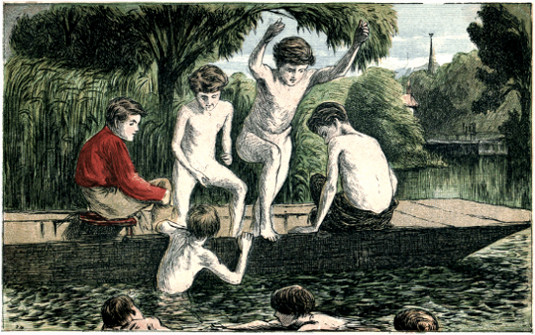
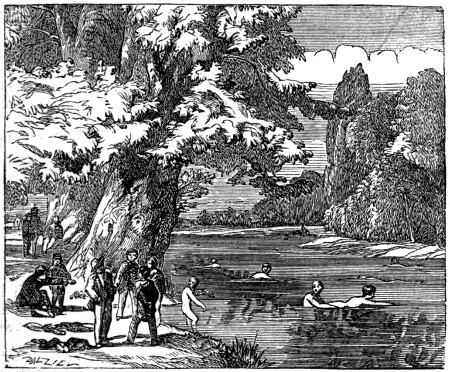
Swimming is the most useful of all athletic accomplishments, as by it human life is frequently saved which might have been sacrificed. It is also useful in the development of muscular strength, as well as highly beneficial to the nervous system, and repairs the vital functions when falling into decline. In places near the sea or rivers, to know how to swim is an indispensable accomplishment. The ancients, particularly the Greeks, held the art in such high estimation as to bestow rewards upon the most perfect swimmers.
From the little familiarity with immersion in water which the inhabitants of our over-grown towns and cities possess, a very great proportion of the English population are but little acquainted with the art of swimming, and with the mode in which they should conduct themselves when risk of drowning presents itself. The English, above all other persons, should be good swimmers, exposed as they are by their insular situation, and commercial pursuits, and disposition to visit other lands, so frequently to perils by sea; yet, while most towns on the Continent abound in baths and swimming-schools, in British towns they are still few in number.
Most animals have a natural aptitude for swimming, not found in man; for they will at once swim when even first thrown into the[326] water; but it must be noticed that the motions they then employ much more resemble their ordinary movements of progression than those made use of by men under similar circumstances.
The children of many uncivilized nations, especially in warm climates, frequent the water from an early age, and seem almost to swim by instinct. The remarkable powers of endurance, agility, and strength manifested while in the water by many individuals of savage tribes are well known,—powers which often enable them to come off victorious in struggles with some of the fiercest inhabitants of those rivers and coasts.
The art of swimming is by no means difficult of attainment, and several authors have supplied directions to facilitate its acquisition. Above all things, self-confidence (not rashness leading into danger) is required; and, when this is possessed, all difficulty soon ceases. Dr. Franklin, himself an expert swimmer, recommends that at first a familiarity with the buoyant power of water should be gained; and to acquire this, he directs the learner, after advancing into the water breast high, to turn round, so as to bring his face to the shore: he is then to let an egg fall in the water, which, being white, will be seen at the bottom. His object must now be, by diving down with his eyes open, to reach and bring up the egg. He will easily perceive that there is no danger in this experiment, as the water gets shallower, of course, towards the shore, and because whenever he likes, by depressing his feet, he can raise his head again above water.
The thing that will most strike beginners will be the great difficulty they experience in forcing themselves through the water to reach the egg, in consequence of the great resistance the water itself offers to their progress: and this is indeed the practical lesson derivable from the experiment; for the learner becomes aware of the very great sustaining or supporting power of water, and hence has confidence. This sustaining power of water is shown under many circumstances: thus, a stone which on land requires two men to remove it, might in water be easily carried by one. A man might walk without harm on broken glass in deep water, because his weight is supported by the water. This knowledge of fluid support constitutes the groundwork of all efforts in swimming, or in self-preservation from drowning.
Should a person accidentally fall into the water, provided he retained his presence of mind, a knowledge of the above facts would save him probably from a “watery grave.” The body being but very slightly heavier than the volume of water it displaces, will, with a very slight motion of the hands under water, float. When the chest is thoroughly inflated with air, it is lighter than water, and floats naturally, having half the head above water; so that the person exposed to danger has only to turn upon his back, in order that that half, consisting of his face, with the mouth and nostrils, be above the water line.
But to float thus upon the water, the greatest care must be taken[327] not to elevate the arms or other parts above its surface; and it is in remembering this caution, that presence of mind in the time of dangers confers so much benefit; for, in the moment of terror, a person thrown into the water almost instinctively stretches out his hands aloft to grasp at some object, thereby depriving himself of a means of proceeding which would frequently keep him afloat until succour arrived. By elevating any part of the body in this way, we remove it from the support afforded by the water, and thus render sinking inevitable.
Dr. Arnot, in allusion to this subject, says that many persons are drowned who might be saved, for the following reasons:—
1. From their believing that their constant exertions are necessary to preserve the body from sinking, and their hence assuming the position of a swimmer, with the face downwards, in which the whole head must be kept out of the water, in order to enable them to breathe; whereas, when lying on the back, only the face need be above the water.
2. From the groundless fear that water entering by the ears may drown as if it entered by the mouth or nose, and their employing exertions to prevent this.
3. The keeping of the hands above water, already alluded to.
4. Neglecting to take the opportunity of the intervals of the waves passing over the head, to renew the air in their chest by an inspiration.
5. Their not knowing the importance of keeping the chest as full of air as possible, which has nearly the same effect as tying a bladder full of air around the neck would have.
But although floating in water is sufficient to preserve from immediate danger, this will not alone enable us to swim. To swim, does not mean simply to float, but to progress; and progression by this means depends, like the flight of birds, upon the law in Mechanics of every action being followed by a corresponding reaction, but in an opposite direction; and thus, as the reaction of the air compressed by the downward action of the bird’s wing, causes it to mount aloft in proportion to the force it communicates by that motion; so the backward stroke communicated by the simultaneous movement of the hands and feet of the swimmer, causes his forward progress in the water. When once familiarised with the support derived from the water itself, he soon learns to make the stroke correctly, especially if aided and supported by some more experienced friend,—a far better assistant than corks and bladders.
It is presumed that most young lads who go to bathe will take the opportunity of learning to swim. In crowded cities there are but few places in which the youngster can learn the art; but in the[328] country there are many rivers, ponds, canals, or lakes, where both bathing and swimming may be indulged in without annoyance. The best kind of place for bathing is on a shelving gravelly shore, on which the water gradually deepens, and where no awkward sweep of current may take the bather off his legs. The spot should also be free from holes, weeds, and hard stones; and a muddy bottom is to be avoided by all means. Should the banks of such a spot be shaded by a few trees, and should there be close by an open space for a run on the grass after the bathe, so much the better; and the young learner will then have the chief inducement to venture the sudden dip or head-long plunge.
The best time of the day for bathing or swimming is either before breakfast, between the hours of six and eight in the summer-time, or between eleven and twelve o’clock in the forenoon. Delicate persons should not bathe early in the morning; and it would be always well to munch a biscuit before early bathing at all times. No one should ever think of entering the water on a full stomach, or immediately after dinner, and never when over-heated and exhausted by fatigue. He should also avoid entering it when cold, or with a headache. Before bathing, it is best to take a moderate walk of about a mile, and, while the system is in a glow, to undress quickly and plunge in. It is bad to walk till you get hot, then to sit down and cool, and afterwards to enter the water; many have lost their lives by this. It is also very wrong to enter the water during rain, as the clothes are often wetted or damp, which gives the bather cold.
Having stripped the body, the bather should select the best place on the bank for going down to the stream; and then, proceeding cautiously but quickly, wade up to his breasts, turn his head to the shore, and dip. He then technically, as the boys say, gets his pinch over. Should he not be man enough to proceed in this way, he should, as soon as he gets his feet wet, splash some water over his head, and go into the water more gradually, and try the rapid rush and dip when he gets bolder. He must not attempt to swim or strike out till he can master the feat of going into the water up to his arm-pits, and till he feels himself confident and void of timidity.
Many aids have been used for the benefit of young swimmers: corks and bladders fastened under the arms are the common ones; but they offer dangerous temptations for bathers to go out of their depth, and then should cramp, cold, or any other accident occur, the event may be fatal. Besides, these aids often slip about from one place to the other. We remember, in our younger days, of the “corks” slipping to the hips, and of seeing a young friend, now an old man, suspended in the water with his head downwards; while[329] collapsing of bladders and of air-jackets is by no means uncommon. The best aid to a young swimmer is a judicious friend, himself a good swimmer, who will hold up his head, when he strikes off, by the “tip of the finger to the tip of the chin,” and who at the same time will show him how to strike off, and how to manage his hands and feet. It is not a bad plan to put out a spar from a boat, to which a rope is attached, which the young learner may make use of by affixing it to a belt round his body under his arms, which will afford him support while he learns to strike his legs in the water. The rope may also be held in the hand of a friend, by the side of the boat, and the learner may strike off hands and feet as the boat proceeds. The plank is a dangerous aid, from its tendency to slip about, and to take the swimmer out of his depth; and, although it has many advantages, is very unsafe. The safest plan of all is, as we have before stated, for the learner to advance gradually up to his arm-pits in the water, and then, turning about, to strike slowly out towards the shore, taking care to keep his legs well up from the bottom. Rigid perseverance in this course will in a very short time enable the youngster to feel himself afloat, and moving at “all fours,”—a delight equal to that experienced by the child who first feels that he can walk from chair to chair.
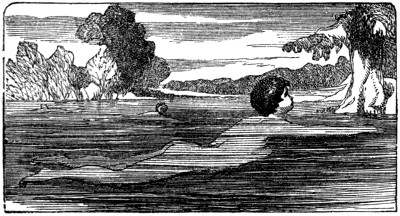
In striking off, the learner, having turned himself to the shore, as before recommended, should fall towards the water gently, keeping his head and neck perfectly upright, his breast advancing forward, his chest inflated; then, withdrawing the legs from the bottom, and stretching them out, strike the arms forward in unison with the legs. The back can scarcely be too much hollowed, or the head too much thrown back, as those who do otherwise will swim with their feet too near the surface, instead of allowing them to be about a foot-and-half deep in the water. The hands should be placed just in front of the breast, the fingers pointing forward and kept close together, with the[330] thumbs to the edge of the fore-fingers: the hands must be made rather concave on the inside, though not so much as to diminish the size. In the stroke of the hands, they should be carried forward to the utmost extent, taking care that they do not touch the surface of the water; they should next be swept to the side, at a distance from, but as low as, the hips; and should then be drawn up again, by bringing the arms towards the side, bending the elbows upwards and the wrists downwards, so as to let the hands hang down while the arms are raising them to the first attitude.
The legs, which should be moved alternately with the hands, must be drawn up with the knees inwards, and the soles of the feet inclined outwards; and they should then be thrown backwards, as widely apart from each other as possible. These motions of the hands and legs may be practised out of the water; and whilst exercising the legs, which can only be done one at a time, the learner may rest one hand on the back of a chair to steady himself, while he moves the opposite leg. When in the water, the learner must take care to draw in his breath at the instant that his hands, descending to his hips, cause his head to rise above the surface of the water; and he should exhale his breath at the moment his body is propelled forward through the action of the legs. If he does not attend precisely to these rules, he must invariably have a downward motion, and, as the boys say, swim furthest where it is deepest.
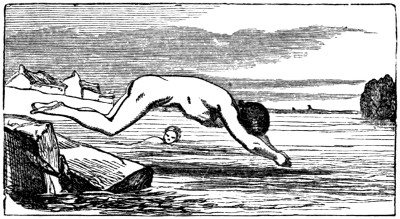
There are two kinds of plunging; that belonging to shallow, and that belonging to deep water. In shallow-water plunging, the learner should fling himself as far forward as possible into the stream at a very oblique angle; and when he touches the water, he should raise his head, keep his back hollow, and stretch his hands forward. In the deep-water plunge, his body is to descend at a greater angle; his[331] arms are to be stretched out, his hands closed and pointed, and his body bent, so that his nose almost touches his toes.
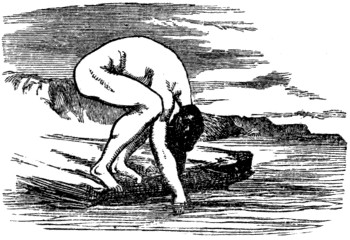
Diving is one of the greatest amusements connected with swimming. There are many kinds; the two most common and easiest and necessary modes of going below the surface, are—
In the first, the legs, arms, and head are to be kept perfectly rigid and stiff. The pupil must not allow fear, or the strange sensation felt in the bowels in leaping from considerable heights, to induce him to spread the arms or legs, or to bend his body.
In the second mode, or head-foremost plunge,—which is the safest mode for persons who are heavily built about the chest and shoulders, if they have to enter the water from heights,—the head is drawn down upon the chest, the arms stretched forward, and hands closed to a point; and as soon as the swimmer feels that he has left the bank, his knees, which till then were bent, are to be stiffened. The diver must avoid striking on the belly—the general consequence of fear; and turning over so as to come down on his back or side—the consequence of pushing with the feet. When he has gone as deep as he wishes, the arms are to be raised and pressed downwards.
When under the water, the swimmer may either move in the usual way, or keep his hands stretched before him, which will enable him to cut the water more easily, and greatly relieve his chest. If he observes that he approaches too near the surface of the water, he must press the palms of his hands upwards. If he wishes to dive to the bottom, he must turn the palms of his hands upwards, striking with them repeatedly and rapidly whilst the feet are reposing; and when he has obtained a perpendicular position, he should stretch out his hands like feelers, and make the usual movement with his feet,[332] then he will descend with great rapidity to the bottom. It is well to accustom the eyes to open themselves under the water, at least in those beds of water that admit the light, as it will enable the swimmer to ascertain the depth of water he is in.
In this, the body is turned either on the left or right side, while the feet perform their usual motions. The arm from under the shoulder stretches itself out quickly, at the same time that the feet are striking. The other arm strikes at the same time with the impelling of the feet. The hand of the latter arm begins its stroke on a level with the head. While the hand is again brought forward in a flat position, and the feet are contracted, the stretched-out hand is, while working, drawn back towards the breast, but not so much impelling as sustaining. As swimming on the side presents to the water a smaller surface than on the waist, when rapidity is required, the former is often preferable to the latter.

This is twofold: 1. In the direction of the feet. The body is placed in a horizontal position, the feet are stretched out stiffly, and the heels and toes are kept in contact; then the body is to be somewhat curved at the seat, the hands are to be stretched flatly forward over the body, and, slowly striking in small circles, the loins are somewhat drawn up at each stroke. 2. In the direction of the head. The body is placed horizontally, but somewhat curved in the seat, the head in its natural position, the arms are kept close to the body, with the elbows inclined inwards, and the hands describe small circles from the back to the front, at about a foot-and-half from the hips. These modes serve to exercise and strengthen the arms in an extraordinary degree without in the least fatiguing the breast.
The body is laid horizontally on the back, the head is bent backwards as much as possible, the arms are stretched out over the head in the direction of the body, the feet are left to their natural position; if they sink, the loins must be kept as low as possible. In this position, the person, who is specifically lighter than water, remains, and may float at pleasure. The lungs should be kept inflated, that the breast may be distended and the circumference of the body augmented. In order not to sink while in the act of taking breath, which the greater specific weight of the body would effect, the breath must be quickly expelled, and as quickly drawn in again, and then retained as long as possible; for, as the back is in a flat position, the sinking, on account of the resistance of the water, does not take place so rapidly but the quick respiration will restore the equilibrium before the water reaches the nose.
This is a perpendicular position of the swimmer, and is of great use to enable him to save a person from drowning. It is in general thought to be extremely difficult, but it is very easy. There are two ways of performing the action: in the first the hands are compressed against the hips, and the feet describe their usual circle; the other mode consists in not contracting both legs at the same time, but one after the other, so that while the one remains contracted the other describes a circle. In this mode, however, the legs must not be stretched out, but the thighs are placed in a distended position, and curved as if in a half-sitting posture.
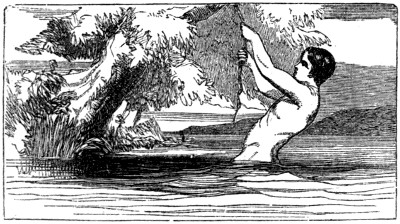
The swimmer lays himself flat upon his waist, draws his feet as close as possible under the body, stretches his hands forwards, and, with both feet and hands beating the water violently at the same time, raises himself out of the water. In this manner one may succeed in[334] throwing oneself out of the water as high as the hips. This exercise is very useful, for saving oneself by catching a rope or any other object that hangs from above the surface of the water, or from any perpendicular height.
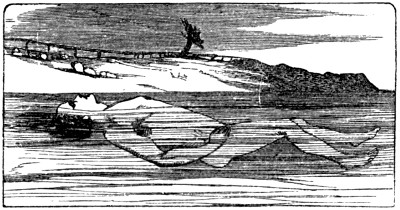
In this the swimmer turns upon his back in the water by the combined motion of the arm and leg, and extending his body, his head being in a line with it, so that the back and upper part of the head may be immersed, while the face and breast are out of the water. The hands should be placed on the thighs straight down, and the legs moved as in forward swimming, taking care that the knees do not rise above the surface in striking them out. Sometimes the hands are used after the motion of a wing or fan, by which a slight progression is also made at the same time that the surface of the body is well lifted out of the water.
In the thrust the swimmer lies horizontally upon his waist, and makes the common motions in swimming. He then simply stretches one arm forwards, as in swimming on the side, but remains lying upon the waist, and, in a widely described circle, he carries the other hand, which is working under the breast, towards the hip. As soon as the arm has completed this motion, it is lifted from the water in a stretched position, and thrown forward in the greatest horizontal level, and is then sunk with the hand flat into the water; while the swimmer thus stretches forth the arm, he, with the other hand stretched as wide as possible, describes a small circle in order to sustain the body; after this he brings his hand in a largely described circle rapidly to the hip, lifts the arm out of the water, and thrusts it forward. During the describing of the larger circle the feet make their movements. To make the thrust beautifully, a considerable degree of practice is required. This mode of swimming is useful where a great degree of rapidity is required for a short distance.
In the performance of this the arm is thrust forwards, backwards, and again forwards without dipping into the water; in the meantime the stretched-forth arm describes two circles before it begins the larger one.

In this motion each hand and foot is used alternately as a dog uses them when swimming, as the term implies. The hands are alternately drawn towards the chin in a compressed form, and then expanded and slightly hollowed, with fingers close, and as they strike the water the feet are likewise drawn towards the belly, and struck backwards with a kind of kick. This mode of swimming is of use to relieve the swimmer from time to time when going a distance.
The swimmer lays himself on his back and contracts himself so that the knees are brought almost to the chin, and while one of the hands keeps the equilibrium by describing circles, the other continues working. Thus the body is kept turning round more or less rapidly.
In the forward wheel the hands are put as far backwards as possible, and so pressed against the water that the head is impelled under the surface, and the feet, by a pressure of the hands in a contrary direction, are rapidly flung above the head, which in this manner is rapidly brought again to the surface.
In the backward wheel the swimmer lies upon his back, he contracts himself, the hands, stretched forward as far as possible, describe rapidly small circles, the feet rise, and as the point of equilibrium has been brought as near as possible to the feet, the head sinks and the feet are thrown over.
The learner to do this swims on one side, keeps his feet somewhat deeply sunk, while the arm which in the meantime ought to work is kept quiet—and might even be taken out of the water. It is a good practice of strength to carry, first under and then over the water, a weight of four or eight pounds.
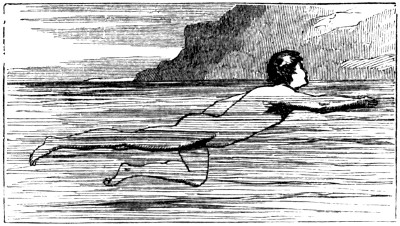
In this process, the right hand is lifted out of the water from behind, swung forwards through the air with a kind of circular sweep to the extent of its reach forward, then dropped into the water edgeways, and immediately turned, with the palm a little hollowed, downwards, the body being at the same time thrown a little on one side, and the right leg struck out backwards to its full extent. The hand descends towards the thigh, and then passes upwards through the water in a kind of curve towards the surface. The left hand and leg perform a similar movement alternately with the right, and the measure of progression attained by these combined similar movements is very considerable.
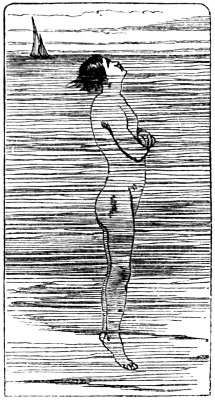
When the swimmer has obtained ease and confidence in the water, he will find many things easy which before he deemed impossible. Balancing is one of these. To perform it he has only, when out of his depth, to fall gently back with his chin elevated to a line passing exactly[337] through the centre of his body from the chin to the toes, then, folding his arms and remaining perfectly motionless, he may suspend himself perpendicularly: but if he should extend his arms backwards, and pass them gradually beyond his head, his toes, tips of his knees, abdomen, and part of his chest, with the whole of his face will appear, and he will be balanced and float horizontally without the slightest motion.
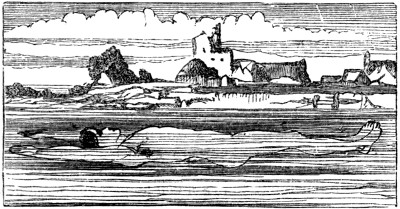
The cramp generally proceeds from acidity of the bowels, arising from a bad state of the stomach, or from the effects of the cold water on the muscular system. Some persons are very subject to it on slight occasions, and such persons will do well never to go out of their depth. But should a tolerable swimmer be seized with the cramp, he should not be frightened, but the moment the cramp is felt in the foot or leg, strike out that foot or leg with the heel elongated, and the toes drawn upwards towards the shin-bone, never minding any little pain it may occasion, as he need not fear breaking a bone, muscle, or tendon. Should this not succeed, he should throw himself on his back, and float quietly, and paddle himself gently to the shore. He may also swim with his hands like a dog, and practise any of the motions of the upper part of the body for keeping his head above water till assistance arrives.
Above all things the good swimmer should be anxious to save life, and to rescue those who are in danger, without himself becoming the victim, as it often happens. The following rules are highly important to be observed. The swimmer must avoid approaching the drowning person in front, in order that he may not be grasped by him; for whatever a drowning person seizes, he holds with convulsive force, and it is no easy matter to get disentangled from his grasp; therefore he should seize him from behind, and let go of him immediately[338] if the other turns towards him. His best way is to impel him before him to the shore, or to draw him behind; if the space to be passed be too great, he should seize him by the foot and drag him, turning him on his back. If the drowning person should seize him, there is no alternative for the swimmer than to drop him at once to the bottom of the water, and there to wrestle with his antagonist; the drowning man, by a kind of instinct to regain the surface, when drawn down to the bottom, usually quits his prey, particularly if the diver attacks him there with all his power.
For two swimmers the labour is easier, because they can mutually relieve each other. If the drowning person has still some presence of mind remaining, they will then seize him one under one arm, and the other under the other, and without any great effort in treading water, bring him along with his head above water, while they enjoin him to keep himself stretched out and as much as possible without motion.
1. The Float.—In this sport one swimmer lays himself horizontally on the back, with the feet stretched out, the hands pressed close to the body, and the head raised forward. The other swimmer takes hold of him by the extremity of the feet, and, swimming with one hand, impels him forward. The first remains motionless.
2. The Plank.—One swimmer lays himself horizontally as before, another lays hold of him with both his hands, immediately above the ancle, and pulls him obliquely into the water, while he extends himself and impels himself forward; thus both the swimmers drop rapidly the one over the other.
3. The Pickaback Spring.—One swimmer treads the water, the other swims near him behind, places his hands upon the shoulders of the first, and presses him down. He then leaves his hold, and puts his feet upon his shoulders, and, flinging himself out of the water, pushes the first towards the bottom. Now he treads water, and the first performs the part of the second, and so on.
4. The Shove.—Two swimmers place themselves horizontally on their backs, the legs are strongly extended, and the soles of the feet bear against each other; each impels forward with all his power, and he who succeeds in pushing back the other is the conqueror.
5. The Wrestle.—Two swimmers place themselves opposite to each other, tread water and hold their right hands in the air; the question is, who shall first force his opponent under the water by pressure. Only the head of the adversary is to be touched, and that only by pressure.
This system has been introduced into many of the naval and military colleges on the Continent, and has for its distinguishing characteristic the swimming in an upright position. The first object[339] is to teach the pupil how to float in an upright posture. He is taught the use of his legs and arms for balancing the body in water, and then to imitate as much as possible the movement of the limbs upon land. He then pays great attention to the movements of the head, the smallest inclination of which on either side instantly operates on the whole body. He next learns the method of using his arms and legs; and for this purpose is directed to stretch his arms laterally on each side, and then, by placing one foot forward and the other backward, he is enabled to float easily and progress slowly. The same circular sweep of the hands and the action of the legs are next practised, and the feet should be struck downwards and a little forwards, when the movement of the arms is the reverse of the old methods of swimming. The young swimmer who has gone through the various courses laid down by us, will easily comprehend the principle of Bernardi’s system, and as easily carry it out if he will take the trouble. It is much less fatiguing than the old plan, and can be carried on for a longer period, and is of invaluable service to troops who may have to cross rivers or dykes, and to all who may be exposed to the various accidents of flood and field.
The best of all methods for teaching swimming is that originally introduced by General Pfuel into the Prussian swimming-schools. By this method a person may be made a very good swimmer in a very short time. The apparatus for teaching consists of a hempen girdle five inches in width, of a rope from five to six fathoms in length, of a pole eight feet long, and a horizontal rail fixed about three-and-a-half feet above the platform, on which the teacher stands, to rest the pole on.
The depth of the water in the place chosen for swimming should, if possible, be not less than eight feet, and the clearest and calmest water should be selected. The pupil wears drawers, fastened by a band above the hips and covering about half the thighs. He is now placed near the horizontal rail, his hands resting upon it, while the teacher shows him the motion which he will have to make with his legs in the water. This he does by guiding the motion of one leg while the pupil rests, on the other. This motion we shall explain presently.
The swimming girdle, about five inches wide, is now placed round the pupil’s breast, so that its upper edge rests on the chest, without getting tight. The teacher takes the rope, which is fastened to the ring of the girdle, in his hand, and directs the pupil to leap into the water, keeping the legs straight and close together, and the arms close to the body, and, what is very important, to breathe out through the nose as soon as his head rises above the water, instead of breathing in first, as every man naturally does after a suspension of breath. The object of this is to prevent the water from getting into the throat,[340] which produces an unpleasant feeling of choking and headache. This expiration soon becomes perfectly natural to the swimmers.
The pupil is next invited to leap. He is drawn up immediately by the rope, pulled to the ladder, and allowed to gain confidence gradually. The rope is now fastened by a noose to the end of the pole, the other end of it being kept in the hand of the teacher; the pole is rested on the horizontal rail, and the pupil stretches himself horizontally on the water, where he remains, supported by the pole. Next the arms are extended stiffly forward, the hands clasped, the chin touches the water; the legs are also stiffly stretched out, the heels being together, the feet turned out, and the toes drawn up. This horizontal position is important, and must be executed correctly. No limb is permitted to be relaxed.
The movement of the limbs is now taught; that of the legs is taught first. The teacher first says, loudly and slowly, “One;” when the legs are slowly drawn under the body; at the same time the knees are separated to the greatest possible distance, the spine is bent downwards, and the toe kept outwards. The teacher then says briskly, “Two;” upon which the legs are stiffly stretched out with a moderate degree of quickness, while the heels are separated, and the legs describe the widest possible angle, the toes being contracted and kept outwards. The teacher then says quickly, “Three;” upon which the legs, with the knees held stiffly, are quickly brought together, and thus the original position is again obtained.
The point at which the motions “two” and “three” join are the most important, because it is the object to receive as large and compact a wedge of water between the legs as possible; so that when the legs are brought together their action upon this wedge may urge the body forward. In ordinary cases of swimming, the hands are not used to propel, but merely to assist in keeping on the surface. By degrees, therefore, “two” and “three” are counted in quick succession, and the pupil is taught to extend the legs as widely as possible. After some time, what was done under the heads “two” and “three” is done when “two” is called out. When the teacher sees that the pupil is able to propel himself with ease, which he frequently acquires the power of doing in the first lesson, and that he performs the motions already mentioned with regularity, he teaches the motions of the hands, which must not be allowed to sink, as they are much disposed to do while the motion of the legs is practised.
The motion of the hands consists of two parts. When the teacher says “One,” the hands, which were held with the palms together, are opened, laid horizontally an inch or two under water, and the arms are extended till they form an angle of 90°; then the elbow is bent, and the hands are brought up to the chin, having described an arch downward and upward; the lower part of the thumb touches the chin, the palms being together. When the teacher says “Two,” the arms are quickly stretched forward, and thus the original horizontal position is[341] regained. The legs remain stiffly extended during the motion of the hands. If the motion of the hands is carefully and correctly performed, the legs and arms are moved together; so that while the teacher says “One,” the pupil performs the first motion of the hands and legs; when he says “Two,” the second and third motions of the feet, and the second of the hands.
As soon as the teacher perceives that the pupil begins to support himself, he slackens the rope a little, and instantly straightens it if the pupil is about to sink. When the pupil can swim about ten strokes in succession, he is released from the pole, but not from the rope. When he can swim about fifty strokes, he is released from the rope too; but the teacher remains near him with a long pole until he can swim 150 strokes in succession, so that, should he sink, the pole is immediately held out to him. After this he may swim in the area of the school, under the superintendence of the teacher, until he proves that he can swim half-an-hour in succession, so that, should he sink, the pole is immediately held out to him; he is then considered fit to be left to himself.
Such are the outlines of the German plan of swimming; and, much as we dislike the German educational quackery, we are still obliged to confess that schools for swimming might be, and ought to be, established in this country in unison with the above system. No well-conducted boarding-school ought to be without a swimming-school; and the hints above given will be exceedingly useful to the swimmer who has to teach himself, as well as to the gymnastic tutor who has to teach others the art; and we conclude by earnestly recommending the accomplishment of swimming to our young readers.
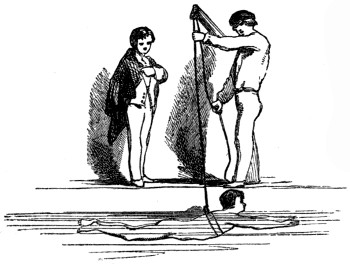
It is impossible that any one can indulge to any extent either in pedestrianism or rowing without going into some sort of training, however slight it may be. Before either can be thoroughly enjoyed, it is essential that the body should be brought into condition, and the constitution prepared for the severe tests to which it is sure to be put. Until this has been satisfactorily accomplished (and it cannot be done without much perseverance and self-denial) success at regattas or in athletic sports is quite out of the question, and the most serious results will attend any attempt to take part in such proceedings. Courage and determination to win a race, whether on land or water, are qualities very much to be admired, yet they are entirely after considerations; the first and chief endeavour must be to reduce the superfluous fat without weakening the system, to secure soundness in wind and limb—in short, thoroughly to prepare the body, so that it may be equal to the emergencies that may hereafter present themselves.
Training should not, however, be begun hastily. Before it is commenced, care should be taken to get the stomach into condition for the dieting it will have to undergo. These preliminary proceedings will be more or less prolonged, according to the habits of life of the patient. If a boy has been given to drinking large quantities of beer, eating indigestible things, or smoking, he does not commence under such favourable circumstances as those who have not so indulged themselves. Probably he has injured his digestion and interfered, however slightly, with his liver; a state of things that he can readily appreciate by the restlessness of his night’s rest, and a furred tongue, and unpleasant taste in his mouth in the morning. The first thing he must do is gradually to lessen his quantity of beer daily, till he can leave it off altogether if necessary, to eschew the pastry-cook’s and fruiterer’s, and consign his pipe to the dust-hole. When once he has made up his mind to go in for a system of training, he should commence by taking a mild aperient dose, such as some salts and senna, or a rhubarb pill, the latter followed in the morning, if necessary, by a black dose. He must avoid going to the extreme, and purging himself too violently—the medicine is solely intended to clear the stomach preparatory to its new treatment—and having gone thus far he may, without any fear, put himself upon the diet which shall presently be set out. He who has been wise enough to satisfy himself with very little beer, and still less of raspberry[343] puff or unripe greengages, and has refrained altogether from tobacco, which to young people is simply poison, may, unless of weak or sickly constitution, begin to train without any preliminary preparations. If his heart and soul are really in the contest for which he desires to get himself into condition, and he possesses a small amount of strength of mind, he will soon become accustomed to the daily routine of food and exercise. It is no use beginning, and then yielding to the temptation for this or that nice thing; when once the ordeal has been commenced, it must be carried out strictly and accurately, or it may as well be abandoned altogether. For the desired state of body can only be arrived at by one means, namely, a large amount of self-denial and close adherence to the prescribed diet.
There is of course some slight difference in the systems of training to be pursued for rowing and pedestrianism; at the same time, in the chief and important points precisely the same course has to be taken. If a boy has a walking or running race in view, he must remember this, that he has to suit his daily exercise according to the distance of the competition in which he is going to take part. For short races he need do little more than keep his digestion and wind in good order, taking care to have say a couple of hours’ good exercise in the course of the day. We would here venture to correct a grave mistake made very often by young runners, who think that by continual practising and “spurting” they learn to improve their pace. They can adopt no better means for defeating their own end than this, as it will tend far more to diminish their pace than to improve it. On the other hand, if they have a long course of several miles to get over, speed is not so much a matter of importance as endurance, and this latter quality can only be obtained by accustoming the body to long and severe exercise. For young persons, however, it is extremely injudicious to attempt too great distances, and we would advise that two miles, and no more, be made the outside limit. Longer spins than this are seldom, if ever, tried in ordinary amateur races.
Accordingly as the match that is to be contested is in running or walking, so must the day’s exercise be regulated. Avoid, if for the former, taking too much running practice, and that never for a greater distance than that of the race in which you are to take part. Good sharp, brisk walking is more serviceable than anything else in getting the body into order. And now, presuming that a boy is in sound health, with good lungs and no unpleasant thumpings about his heart, let us see how he should regulate his training. Six o’clock to get out of bed and commence the day. No one who intends to train himself really seriously will wish to lie longer. Then a cold tub with a big sponge and lots of water, followed by a severe rubbing with a rough Turkish towel, that leaves you all a-glow. Dress as quickly as you can, and go out for half an hour’s walk, or run, as you feel inclined. Be sure, however, not to fatigue yourself, and see that you come in to breakfast, say at half-past seven, with a good[344] appetite. Those who can eat porridge will find it a capital thing to commence breakfast with, followed by the lean portion of a broiled chop or steak, with bread at least two days old. Tea we believe to be undesirable, and a pint of really sound bitter beer will be found to agree much better.
There is no need to bind yourself down to a stipulated quantity of food; eat what you feel to require, and no more. After breakfast get as much rest as you can, say for a couple of hours; then take yourself off for a couple of hours’ walking or running, getting back to dinner by about two o’clock. The programme for this meal is simple enough: a joint of roast meat, either mutton or beef, a potato, and sometimes a little cauliflower, or brocoli, just to make a change, bread as before, and another pint of bitter beer. The liquids are the things in which the strictest care must be taken, and the daily quantity regulated. Poultry is sometimes introduced, but we hardly think it good—in fact, as far as you can, stick to the good plain joint, or chop, or steak, with bread and beer, and you will be astonished how you will find your condition improved. After dinner rest again for two or three hours, and then about six o’clock take yourself off for another hour’s exercise, on your return from which you will no doubt be fully prepared with an appetite for supper. This meal should always be a light one, as it is bad at all times, and especially in training, to go to bed on a full stomach. Unless you feel you absolutely require it, do not take any meat; otherwise, a chop is the least objectionable, and a half-pint of beer. Never, under any circumstances, exceed three pints of beer a day. Butter, spices, peppers, and sauces should on no account be taken, and, as we said before, so we again repeat, smoking must be abjured. If the directions given are followed out, defeat will not be occasioned through any error in the system of preparation.
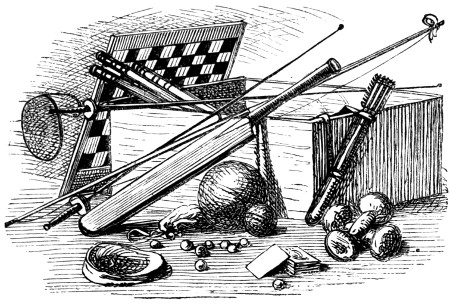
INCLUDING
Acoustics is the science relating to sound and hearing. Sound is heard when any shock or impulse is given to the air, or to any other body which is in contact directly or indirectly with the ear.
Noises are made by the cracks of whips, the beating of hammers, the creak of a file or saw, or the hubbub of a multitude. But when a bell is struck, the bow of a violin drawn across the strings, or the wetted finger turned round a musical glass, we have what are properly called sounds.
Sounds are propagated on all bodies much after the manner that waves are in water, with a velocity of 1,142 feet in a second. Sounds in liquids and in solids are more rapid than in air. Two stones rubbed together may be heard in water at half a mile; solid bodies convey sounds to great distances, and pipes may be made to convey the voice over every part of the house.
Take a long piece of wood, such as the handle of a hair broom, and placing a watch at one end, apply your ear to the other, and the tickings will be distinctly heard.
Touch a bell when it is sounding, and the noise ceases; the same may be done to a musical string with the same results. Hold a musical pitch-fork to the lips, when it is made to sound, and a quivering motion will be felt from its vibrations. These experiments show that sound is produced by the quick motions and vibrations of different bodies.
Cover the mouth of a wine glass, having a foot-stalk, with a thin sheet of membrane, over which scatter a layer of fine sand. The vibrations excited in the air by the sound of a musical instrument, held within a few inches of the membrane, will cause the sand on its surface to form regular lines and figures with astonishing celerity, which vary with the sound produced.
This instrument consists of a long narrow box of very thin deal, about six inches deep, with a circle in the middle of the upper side of an inch and a half in diameter, in which are to be drilled small holes. On this side seven, ten, or more strings of very fine catgut are stretched over bridges at each end like the bridges of a fiddle, and screwed up or relaxed with screw pins. The strings must all be tuned to one and the same note,[5] and the instrument should be placed in a window partly open, in which the width is exactly equal to the length of the harp, with the sash just raised to give the air admission. When the air blows upon these strings with different degrees of force, it will excite different tones of sound. Sometimes the blast brings out all the tones in full concert, and sometimes it sinks them to the softest murmurs.
[5] D is a good note for it. The upper string may be tuned to the upper D, and the two lower to the lower D and D D. The “harmonics” are the sounds produced.
A colossal imitation of the instrument just described was invented at Milan in 1786, by the Abbate Gattoni. He stretched seven strong iron wires, tuned to the notes of the gamut, from the top of a tower sixty feet high, to the house of a Signor Moscate, who was interested in the success of the experiment; and this apparatus, called the “giant’s harp,” in blowing weather yielded lengthened peals of harmonious music. In a storm this music was heard at a greater distance.
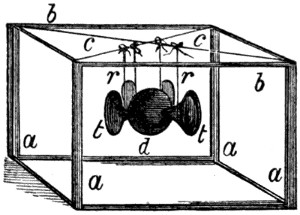
The facility with which the voice circulates through tubes was known to the ancients, and no doubt has afforded the priests of all religions means of deception to the ignorant and credulous. But of late days the light of science dispels all such wicked deceptions. A very clever machine was produced at Paris several years ago, and afterwards exhibited in London under the name of the “Invisible Girl,” since the apparatus was so constructed that the voice of a female at a distance was heard as if it originated from a hollow globe, not more than a foot in diameter. It consisted of a wooden frame something like a tent bedstead, formed by four pillars a a a a, connected by upper cross rails b b, and similar rails below, while it terminated above in four bent wires c c, proceeding at right angles of the frame, and meeting in a central point. The hollow copper ball[349] d, with four trumpets t t, crossing from it at right angles, hung in the centre of the frame, being connected with the wires alone by four narrow ribbons r r. The questions were proposed close to the open mouth of one of these trumpets, and the reply was returned from the same orifice. The means used in the deception were as follow: a pipe or tube was attached to one of the hollow pillars, and carried into another apartment, in which a female was placed; and this tube having been carried up the leg or pillar of the instrument to the cross-rails, had an aperture exactly opposite two of the trumpet mouths; so that what was spoken was immediately answered through a very simple mode of communication.
This is an art by no means very difficult of acquirement, if the young reader will take the pains. It is produced by a reflection of sound within the mouth, the voice being brought to the lowest possible place in the larynx. When the art is acquired by practice, the voice may be made to appear as if coming from any part of a room, from up a chimney, or from the depths of a cellar. The celebrated Dr. Wolcott, better known as Peter Pindar, used to amuse his friends in a remarkable manner with this art. He would represent his landlady as demanding payment of her rent, and hold a colloquy with her, which would at last rise to terms of reproach and fury, and end by a noise as if the landlady had been kicked down stairs. The marvellous powers of Matthews, Le Lagg, Alexander, and, lastly, Mr. Love, are familiar to most persons. To learn the art, the young practitioner must have the power of enunciating well, and that without motion of the lips,—of disguising the voice, so as to imitate other sounds,—and of adapting the degree to the apparent source of the sound. By practice this art is attainable by any person whose organs of speech are completely and fully developed.
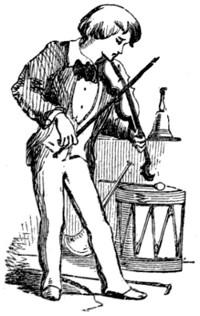
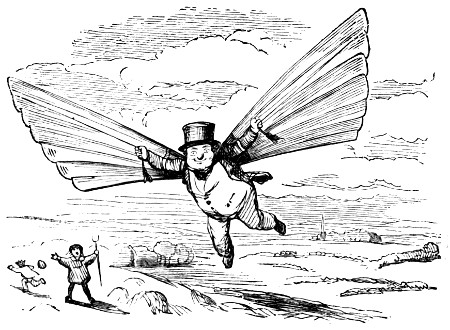
The art of sailing or navigating a body through the air is called aëronautics. In remote ages, Icarus is said to have risen so high in the air that the sun melted his wings, and he fell into the Ægean sea, and was drowned; and there is reason to believe, from some figures that have recently been discovered on Egyptian and Assyrian monuments, that the ancients possessed means of rising in the air with which we are not now acquainted.
The air-balloon, as now constructed, is a bag of silk of large dimensions, usually cut in gores, and is, when expanded by gas, of a pear-shape. It ascends in the atmosphere because its whole bulk is much lighter than the air would be in the space it occupies. It is, in fact, a vessel filled with a fluid which will float on another fluid lighter than itself.
The best shape for an air-balloon, or rather a gas-balloon, is that of a pegtop. And in preparing the gores proceed as follows: Get some close texture silk, and cut it into a form resembling a narrow pear with a very thin stalk. Fourteen of these pieces will be found to be the best number; and, of course, the breadths of each piece must be measured accordingly. When sewing them together, it will be of advantage to coat the parts that overlap with a layer of varnish, as this will save much trouble afterwards, and hold the silk firmer in its place during the stitching. The threads must be placed very regularly, or the balloon will be drawn out of shape, and it will be found useful if the gores are covered with an interior coating of varnish before they are finally sewn together. Take care not to have the varnish too thick. To the upper part of the balloon there should be a valve opening inwards, to which a string should be fastened, passing through a hole made in a small piece of wood fixed in the lower part of the balloon, so that the aeronaut may open the valve when he wishes to descend; and this should be imitated on a small scale, so that the young aëronaut may be perfectly familiar with the construction of a balloon. The gores are to be covered with a varnish of India-rubber dissolved in a mixture of turpentine and naphtha. Over the whole of the upper part should be a net-work, which should come down to the middle with various cords, proceeding from it to the circumference of a circle about two feet below the balloon. The circle may be made of wood, or of several pieces of slender cane bound together. The meshes should be small at top, against which part of the balloon the inflammable air exerts the greatest force, and increase in size as they recede from the top.
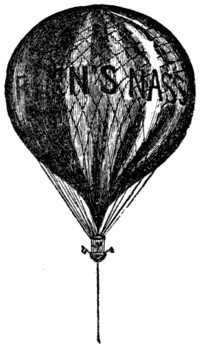
The car is made of wicker-work; it is usually covered with leather, and is well varnished or painted. It is suspended by ropes proceeding from the net which goes over the[352] balloon. Balloons of this kind cannot be made smaller than six feet in diameter, of oiled silk, as the weight of the material is too great for the air to buoy it up. They may be made smaller of thin slips of bladder, or other membrane glued together, or of thin gutta-percha cloth, which is now extensively used for this purpose; with this they may be made a foot in diameter, and will rise beautifully.
Procure a large stone bottle which will hold a gallon of water, into this put a pound of iron filings, or granulated zinc, with two quarts of water, and add to this by degrees one pint of sulphuric acid. Then take a tube, either of glass or metal, and introduce one end of it through a cork, which place in the bottle, then put the other end into the neck of the balloon, and the gas will rise into the body of it. When quite full withdraw the tube, and tie the neck of the balloon with strong cord very tightly. If freed it will now rise in the air.
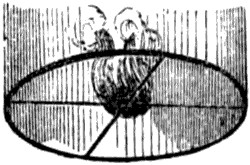
Cut the gores, according to the forms already given, from well-woven tissue paper, paste the gores nicely together, and look well over the surface of the paper for any small hole or slit, over which paste a piece of paper, and let it dry. Pass a wire round the neck of the balloon, and have two cross pieces at its diameter a little bent, so that a piece of soft cotton dipped in spirits of wine may be laid on them. When all is prepared let some one hold the balloon from its top by means of a stick, while you dip the cotton in spirits of wine till it is thoroughly saturated, place it under the balloon and set fire to it, but be very careful you do not set fire to the balloon. When the air is sufficiently heated within, the balloon will indicate a desire to rise, and when it pulls very hard, let it go, and it will ascend to a great height in the air, and at night present a very beautiful appearance.
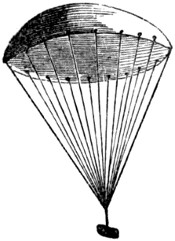
These are easily made by cutting a piece of paper in a circular form, and placing threads round the edges, which may be made to converge to a point, at which a cork may be placed as a balance. They ascend by the air getting under them, and are frequently blown to a great distance.
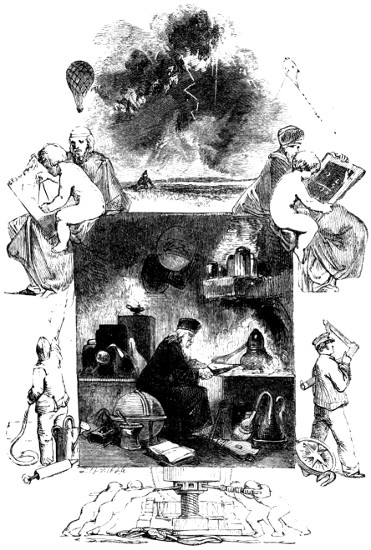
SCIENTIFIC PURSUITS.
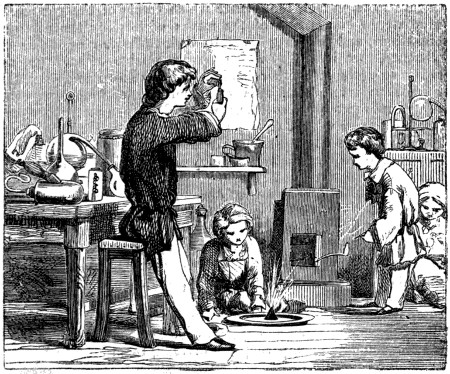
In the eleventh century, and during the reign of King Henry the First, surnamed Beauclerk, or the fine scholar, there appeared for the first time in certain books, professing to teach the art making of gold, the words chemistry, chemist, derived from the Greek χημεία. Seven hundred years and more have passed away, and that which was only the pursuit of a shadow called alchemy, has resulted in the acquisition of a great and noble science, now and again called chemistry. When we go to the French Exposition, we shall doubtless pass by much that is worthy of notice, and bring away with us only a general impression of the wonders it contains. So it is with the great edifice Chemistry; we may, in these brief pages, peep in at the open door, but should we desire to go beyond the threshold, there are numerous guides, such as Roscoe, Wilson, and Fownes, who will conduct us through the mazes of the interior, and explain in elementary language the beautiful processes which have become so useful to mankind.
Chemistry is one of the most comprehensive of all the sciences, and at the same time one which comes home to us in the most ordinary of our daily avocations. Most of the arts of life are indebted to it for their very existence, and nearly all have been, from time to time, improved by the application of its principles.
Chemistry is, in fact, the science which treats of the composition of all material bodies, and of the means of forming them into new combinations, and reducing them to their ultimate elements, as they are termed, that is, bodies which we are unable to split up, as it were, or separate into other bodies. To take a common substance as an illustration; water, by a great number of processes, can be separated into two other substances, called oxygen and hydrogen, in the proportion by weight of 8 parts of the first to 1 of the second; but no power that we at present possess can separate the oxygen and hydrogen into any other bodies; they are therefore called ultimate elements, or undecomposable bodies.
Again, sulphate of magnesia (common Epsom salts) can be very easily separated into two other substances,—sulphuric acid and magnesia; and in this instance, both these substances can again be sub-divided—the acid into sulphur and oxygen, and the magnesia into a metallic body called magnesium and oxygen; but sulphur, oxygen, and magnesium are incapable of further division, and are therefore called ultimate elements.
These ultimate elements amount to 64 in number, according to the present state of our knowledge, and may be arranged in various ways; the simplest plan, perhaps, is dividing them into Non-metallic and Metallic elements.
The Non-metallic elements are:—1. Oxygen. 2. Hydrogen. 3. Nitrogen. 4. Chlorine. 5. Iodine. 6. Bromine. 7. Fluorine. 8. Carbon. 9. Sulphur. 10. Selenium. 11. Tellurium. 12. Silicon. 13. Boron. 14. Phosphorus. The last-named element is the connecting link with the metals through arsenic, which phosphorus closely resembles in its chemical properties.
The Metallic elements may be sub-divided into the metals of the alkalies, the metals of the alkaline earths, the metals of the earths, and the other metals sometimes called metals proper.
1st. The metallic bases of the alkalies:—potassium, sodium, lithium, ammonium, cæsium, rubidium.
2d. The metallic bases of the alkaline earths:—calcium, strontium, barium.
3d. The metallic bases of the earths:—aluminium, glucinum, zirconium, thorium, yttrium, erbium, cerium, lanthanum, didymium.
4th. The metals proper, the most important of which are:—platinum, gold, silver, mercury, copper, iron, tin, lead, nickel, zinc, bismuth, antimony, manganese, cobalt, arsenic.
Now, from these elementary bodies, united together in various proportions, is formed the infinite variety of substances around us,[355] whether animal, vegetable, or mineral; in fact, a few only are generally employed;—in the case of animals and vegetables, oxygen, hydrogen, carbon, nitrogen, with occasionally some sulphur, calcium, phosphorus, and silicon, suffice for building up the beautiful forms of animated nature; while the fabric of our globe itself consists for the most part of the earths; silex, i. e. flint or crystal; lime, in the shape of chalk, marble, or limestone, such as our flagstones are composed of; slate and granite, which are compounds of aluminium, silica, and small quantities of oxide of iron, and sometimes a little potash, &c.; and through their masses are projected irregular streams—veins as they are termed—of the metals, either in a pure state, as is the case sometimes with gold, silver, platinum, mercury, and perhaps one or two others; or combined with one of the non-metallic elements, or with one another.
Late calculations have determined the composition of the earth’s solid crust in 100 parts by weight to be
| Oxygen | 44· | 0 | to | 48· | 7 |
| Silicon | 22· | 8 | „ | 36· | 2 |
| Aluminium | 9· | 9 | „ | 6· | 1 |
| Iron | 9· | 9 | „ | 2· | 4 |
| Calcium | 6· | 6 | „ | 0· | 9 |
| Magnesium | 2· | 7 | „ | 0· | 1 |
| Sodium | 2· | 4 | „ | 2· | 5 |
| Potassium | 1· | 7 | „ | 3· | 1 |
| 100· | 100· |
All these combinations are effected by certain powers, termed forces; those which cause the union of the elements are called the forces of attraction; those causing their separation, the forces of repulsion.
The force of attraction when exerted between masses of matter, is termed gravitation; when it unites particles of matter of a similar kind and produces masses, it is called the attraction of cohesion; when the particles united are of a dissimilar character, it is then termed chemical or elective affinity. For example, the crystals of Epsom salts are formed from minute particles of the salt, united into a larger or smaller mass by the attraction of cohesion, while the elements of which each particle consists, namely, the sulphur, oxygen, and magnesium, are united by the attraction of chemical affinity.
Cohesion thus unites particles of a similar kind; chemical affinity, of a dissimilar nature. It is to cohesion that the existence of masses of matter is owing, and its power increases as the squares of the distances diminish, in an inverse ratio to the squares of the distances of the particles on which it acts.
The power exerted by cohesion may be exhibited in various ways.[356] This is one: Procure two discs of glass about three inches in diameter, their surfaces being ground extremely smooth; fix each into a square piece of wood, taking care that they are placed accurately in the centre; then put them together, by sliding their edges very carefully over each other, so as to avoid any air getting between them, and you will find a great force necessary to separate them. A hook should be fixed into the centre of each piece of wood, so that they may be suspended, and a weight hung to the lower one. It is almost impossible for any one to separate them by merely pulling them with both hands; a weight of many pounds is required for that purpose. In like manner two freshly-cut surfaces of caoutchouc will, on being squeezed together, cohere so perfectly, that it is difficult to tear them asunder, and it is in this way that tubes of caoutchouc may be rapidly prepared for experiments, where little or no pressure is exerted.
Chemical affinity is sometimes called elective, or the effect of choice, as if one substance exerted a kind of preference for another, and chose to be united to it rather than to that with which it was previously combined; thus, if you pour some vinegar, which is a weak acetic acid, upon some pearlash (a combination of potash and carbonic acid), or some carbonate of soda (a combination of the same acid with soda), a violent effervescence will take place, occasioned by the escape of the carbonic acid, displaced in consequence of the potash or soda preferring the acetic acid, and forming a compound called an acetate. Then, if some sulphuric acid be poured on this new compound, the acetic acid will in its turn be displaced by the greater attachment of either of the bases, as they are termed, for the sulphuric acid. Again, if into a solution of blue vitriol (a combination of sulphuric acid with oxide of copper) the bright blade of a knife be introduced, the knife will speedily be covered with a coat of copper, deposited in consequence of the acid preferring the iron, of which the knife is made, a quantity of it being dissolved in exact proportion to the quantity of copper deposited.
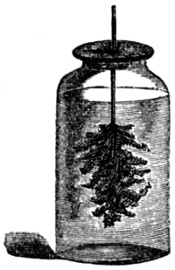
It is on the same principle that a very beautiful preparation, called a silver-tree, or a lead-tree, may be formed thus:—Fill a wide bottle, capable of holding from half a pint to a pint, with a tolerably strong solution of nitrate of silver (lunar caustic), or acetate of lead, in pure distilled water; then attach a small piece of zinc by a string to the cork or stopper of the bottle, so that the zinc shall hang about the middle of the bottle, and set it by where it may be quite undisturbed; in a short time, brilliant plates of silver or lead, as the case may be, will be seen to collect around the piece of zinc, assuming more or[357] less of the crystalline form. This at first is a case of elective affinity; the acid with which the silver or lead was united prefers the zinc to either of those metals and in consequence discards them in order to attach the zinc to itself, subsequently a voltaic current is set up between the two metals, and the process will continue until almost the whole of the zinc is taken up, or nearly the whole of the silver or lead deposited.
Again, many animal and vegetable substances consist for the most part of carbon or charcoal, united with oxygen and hydrogen in the proportion which forms water. Now oil of vitriol (strong sulphuric acid) has so powerful an affinity, or so great a thirst for water, that it will abstract it from almost any body in which it exists; if you then pour some of this acid on a lump of sugar, or place a chip of wood in it, the sugar or wood will speedily become quite black, or be charred, as it is called, in consequence of the oxygen and hydrogen being removed by the sulphuric acid, and only the carbon, or charcoal, left.
When Cleopatra dissolved pearls of wondrous value in vinegar, she was exhibiting unwittingly an instance of chemical elective affinity; the pearl being simply carbonate of lime, which was decomposed by the greater affinity or fondness of lime for its new acquaintance (the acetic acid of the vinegar) than for the carbonic acid, with which it had been united all its life,—an example of inconstancy in strong contrast with the conduct of its owner, who chose death rather than become the mistress of her lover’s conqueror.
The three permanent gaseous elements are oxygen, hydrogen, and nitrogen.
The compound gases are very numerous, some being combustible, and others supporters of combustion.
Gases are for the most part transparent and colourless, with a few exceptions, and of course, like the air of the atmosphere, invisible. They are little affected by the attraction of cohesion, but rather, on the contrary, the particles composing them have a constant tendency to separate from each other, so that their force of expansion is only limited by the pressure under which they may be kept, and the temperature they may be exposed to. They have a tendency to penetrate each other, as it were; for instance, if you take a jar of heavy gas, such as carbonic gas, set it with its mouth upwards, then invert over it another jar containing hydrogen, a gas nearly twenty-two times lighter; in a very short time the two gases will have become thoroughly mixed, the heavy carbonic acid having risen, and the light hydrogen fallen, until the gases are thoroughly mixed, each jar containing an equal quantity of each gas.
This gas, so named from two Greek words signifying the maker of acid, was discovered by Dr. Priestly in 1774. He obtained it by heating the red oxide of mercury in a glass retort, when the gas escaped in considerable quantities. In the ensuing year Scheele obtained it by a variety of methods, and a few years afterwards Lavoisier discovered that it was contained in atmospheric air, where it exists in the proportion of about one-fifth, the remaining four-fifths being almost entirely nitrogen.
Oxygen gas may be obtained for the purpose of experiment, by heating to redness the black oxide of manganese in an iron bottle, to the mouth of which a flexible tube is attached to convey away the gas as fast as it is liberated from the manganese. The first portions should be allowed to escape, being mixed with the air in the tubes and bottle, and the remainder may be collected in a gasometer, or in glass jars inverted over water.
Another method to obtain the gas, and one to be used only in the absence of other ingredients, is to mix in a retort some of this same oxide of manganese with about half its weight of strong sulphuric acid, and apply heat to the retort, when the gas will come over in considerable quantities; the first portions must be allowed to escape as before.[6] If the gas is required very pure, a small quantity of the salt called chlorate of potassa may be heated in a retort, and oxygen gas will be evolved, and may be collected as before. If you have an iron bottle, the first mode is by far the cheapest, as the heat of a bright fire is sufficient for the operation, and a large quantity of gas is obtained in a short time from a very inexpensive material. The most rapid and convenient process of all is to heat a mixture of two parts chlorate of potash, and one of powdered black oxide of manganese, in a common clean oil flask, to which a cork and bent tube has been adapted. Care must be taken not to mistake sulphide of antimony for black oxide of manganese, as very serious accidents have arisen from this cause.
[6] Some boiling water should be added to the mass left in the retort directly the gas has ceased to come away, or it will adhere to the glass so firmly, that the retort will certainly be spoilt.
Oxygen is largely distributed over our globe, both in its uncombined state, and in union with other substances. Besides forming one-fifth of the atmosphere, it forms eight-ninths by weight of all the water in the ocean, rivers, and springs on the face of the whole earth. It also, in combination with various metals, forms the various earths and minerals of which the crust of the earth consists, so that it is the most abundant and widely distributed substance in nature, and in combination with other elements, forms nearly half the weight of the solid earth.
In its uncombined state it is a colourless gas, somewhat heavier[359] than atmospheric air, without taste or smell. It is a powerful supporter of combustion, and is absolutely necessary for the support of animal life, which cannot exist for any time without a free supply of this gas, which is constantly consumed in the act of breathing, and is replaced by an equivalent portion of carbonic acid gas. The want of oxygen is partly the cause of the oppression felt in crowded rooms, where the air cannot be renewed so fast as is required for the number of persons who are constantly consuming the oxygen; and if an animal be confined under a glass jar inverted over water, it will presently die, just for the same reason that burning tapers are extinguished under similar circumstances.
If a jet of this gas be thrown upon a piece of charcoal, sulphur, or almost any combustible body in a state of ignition, it will make it burn with great vividness and rapidity. For a complete series of experiments with oxygen see “The Boy’s Play-book of Science.”

But by far the most intense heat, and most brilliant light, may be produced by introducing a piece of phosphorus into a jar of oxygen. The phosphorus may be placed in a small copper cup, with a long handle of thick wire passing through a hole in a cork that fits the jar. The phosphorus must first be ignited; and, as soon as it is introduced into the oxygen, it gives out a light so brilliant that no eye can bear it, and the whole jar appears filled with an intensely luminous atmosphere. It is well to dilute the oxygen with about one-fourth part of common air to moderate the intense heat which is nearly certain to break the jar if pure oxygen is used.
If a piece of charcoal, which is pure carbon or nearly so, be ignited, and introduced into a jar containing oxygen or common atmospheric air, the product will be carbonic gas only, of which we shall speak presently. As most combustible bodies contain both carbon and hydrogen, the result of their combination is carbonic acid and water. This is the case with the gas used for illumination; and in order to prevent the water so produced from spoiling goods in shops, various plans have been devised for carrying off the water when in the state of steam. This is generally accomplished by suspending over the burners glass bells, communicating with tubes opening into the chimney, or passing outside the house.
To show that oxygen, or some equivalent, is necessary for the support[360] of combustion, fix two or three pieces of wax-taper on flat pieces of cork, and set them floating on water in a soup-plate, light them, and invert over them a glass jar; as they burn, the heat produced may perhaps at first expand the air so as to force a small quantity out of the jar, but the water will soon rise in the jar, and continue to do so until the tapers expire, when you will find that a considerable portion of the air has disappeared, and what remains will no longer support flame; that is, the oxygen has been converted partly into water, and partly into carbonic acid gas, by uniting with the carbon and hydrogen, of which the taper consists, and the remaining air is principally nitrogen, with some carbonic acid; the presence of the latter may be proved by decanting some of the remaining air into a bottle, and then shaking some lime-water with it, which will absorb the carbonic acid and form chalk, rendering the water quite turbid.
This gas is, as its name implies, the producer of nitre, or at least forms a portion of the nitric acid contained in nitre. It is rather lighter than atmospheric air, colourless, transparent, incapable of supporting animal life, on which account it is sometimes called azote—an objectionable name, as it is not a poison like many other gases, but destroys life only in the absence of oxygen. This gas extinguishes all burning bodies plunged into it, and does not itself burn. It exists largely in nature, for four-fifths of the atmosphere consists of nitrogen gas. It is also an important constituent of animal bodies, and is found in the vegetable world.
Nitrogen may be most easily obtained for experiment by setting fire to some phosphorus contained in a porcelain or metallic cup, placed under a gas jar full of air, and resting on the shelf of the pneumatic trough, or in a soup-plate filled with water.
Nitrogen combines in five different proportions with oxygen, producing five distinct chemical compounds, named respectively nitrous oxide, nitric oxide, nitric tri-oxide, nitric tetr-oxide, nitric pent-oxide, which last, united with water, forms nitric acid, now called hydric nitrate, as nitrous acid is termed hydric nitrite.
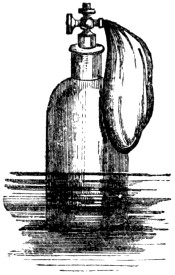
Nitrous oxide gas is generally known by the name of “laughing gas,” from the jolly sensations experienced on inhaling it. It may be procured by distilling in a glass retort a salt called nitrate of ammonia, which yields the gas in considerable quantities, and it should be kept standing in jars over water for some hours before it is used. It should be transferred into a[361] silk air-tight bag, furnished with a stopcock and mouthpiece, from which the gas may be breathed; a little practice is required to do this easily, and more resolution to desist when the gas begins to produce its effects, as it appears to fascinate the experimenter, and actual force is often necessary to remove the bag from the mouth. The effects produced vary according to the temperament of the person inhaling it; they are, however, always of a highly pleasurable nature, muscular action being generally greatly exalted, compelling the individual to race round the apartment and execute leaps and pirouettes perfectly astounding. Some persons shout and sing, and I have seen one expend his superfluous animation in twisting his features into such ludicrous grimaces as would be the envy of the candidates at a grinning match, and beat them all out of the field. Sir H. Davy was the discoverer of this gas, and of its peculiar effects on the nervous system, and a full account of it may be found in his “Researches on Nitrous Oxide Gas.”
This gas is heavier than air, and supports combustion nearly as energetically as oxygen, as may be shown by introducing a piece of ignited phosphorus into a jar of this gas. It will not, however, support the life of small animals, such as mice, which introduced into it die very quickly.

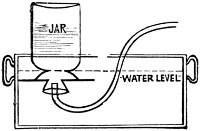
PLAN OF PNEUMATIC TROUGH.
SECTION OF PNEUMATIC TROUGH.

PLAN OF PNEUMATIC TROUGH.

SECTION OF PNEUMATIC TROUGH.
The next compound of nitrogen with oxygen, when one proportion of nitrogen unites with two of oxygen, is termed nitric oxide gas. It may be easily procured by heating in a retort some copper turnings in dilute nitric acid. It is colourless and transparent, and has the property of combining with oxygen to form other compounds.
Into a jar of this gas standing over water pass some oxygen gas. The jar will be filled with red fumes, which will be rapidly absorbed by the water. If atmospheric air be used instead of oxygen, there will remain in the jar the nitrogen of the air, amounting to four-fifths of the air employed.
This gas is destructive to animal life, in consequence of its property of uniting with the oxygen in the lungs, and producing the highly corrosive nitrous acid gas. It will, however, support the combustion of a few substances, phosphorus for instance, provided it is sufficiently heated before being plunged into the gas.
We pass over the third and fourth compounds of nitrogen with oxygen, as they are not calculated for amusing experiments. Nitric acid is easily prepared on the small scale, by gradually heating equal parts by weight of nitric and sulphuric acid in a retort to which a receiver has been adapted. The receiver, which may be a clean oil flask, should be kept cool with wetted blotting paper.
Nitrogen combines with chlorine and iodine, forming detonating compounds, the former being so extremely dangerous that it will be better to pass it by.
The compound with iodine, called iodide of nitrogen, may very easily be made by pouring strong solution of ammonia (a compound of nitrogen and hydrogen) upon some iodine in a phial, shaking them well together, and after letting them stand for a few hours, pouring off the fluid; the black powder remaining in the phial is the explosive compound, the iodide of nitrogen. When dry, it is very apt to detonate spontaneously; it should therefore be shaken out of the phial while wet, and spread in very small quantities on separate pieces of blotting paper, which should be kept apart from each other. When thoroughly dry, the slightest touch with the point of a feather, shaking the paper on which it rests, or even opening too rapidly the door of a closet where it has been put to dry, will cause it to explode, producing a quantity of violet-coloured fumes. The explosion is somewhat violent, producing a sharp cracking noise; and the greatest care should be taken in experimenting with it.
As has been already mentioned, nitrogen is the principal constituent of the air of the atmosphere which surrounds our globe, extending to a height of about forty-five miles above it, and playing a most important part in the economy of nature, inorganic as well as organic.
This atmospheric air consists by volume of nearly four-fifths of nitrogen, and rather more than one-fifth of oxygen, viz. seventy-nine of the former to twenty-one of the latter, or twenty-three parts by weight of oxygen and seventy-seven of nitrogen; it generally contains also a variable proportion of the vapour of water, and a very small quantity of carbonic acid gas, being only about four volumes to 10,000 of air. Its constituent parts are easily separated, as it is a mechanical mixture and not a chemical compound, though the mixture by diffusion is so complete that chemists have not been able to ascertain any difference in the composition of air taken from all parts[363] of the world, and from different heights, up to the highest point which has to this time been attained.
The atmosphere presses on the surface of the globe, and every being on it, with a force of about fifteen pounds to every square inch of surface, but as it presses equally in all directions, upwards as well as downwards, its weight cannot be perceived unless the pressure be removed from one surface by some artificial means.
Atmospheric air contains, besides the oxygen and nitrogen, its principal constituents, a small proportion of carbonic acid gas, as has been mentioned, and this may be shown by filling a tube about half full of lime-water, and shaking it with the air contained in the other half, when it will become slightly turbid from the insoluble carbonate of lime formed.
When we consider that every living animal is constantly consuming oxygen, and replacing it by carbonic acid gas, and that all burning bodies, fires in our dwellings, furnaces, artificial lights of all kinds, act in the same way in abstracting the oxygen from the air, and replacing it by immense quantities of carbonic acid gas, which is a poison to all animals who breathe, or attempt to breathe it, we must wonder what becomes of this irrespirable gas, as it is found to exist in the air in quantities so minute, and by what means the oxygen is restored, and the air again made fit for respiration. This is effected by one of those laws which the wisdom of the Creator has impressed upon matter, by which one part of creation as it were balances another, and all proceeds in an endless circle of change. This carbonic acid, which is so poisonous to animal life, is the food of the vegetable world, plants having the power of taking up the carbonic acid into their pores; converting the carbon into their own substance, and rejecting the oxygen, which is again respired by animals, &c. In the same way, all animal refuse is the food of vegetables, and is used under the name of manures.
The atmosphere contains also a variable quantity of vapour of water, invisible as long as it is in the state of vapour, but it may be rendered obvious by bringing any very cold body into warm air, when the vapour will condense on the cold body in the form of small drops of water. A tumbler of fresh-pumped water brought into a crowded room, is almost immediately covered with moisture, and it may also be seen on bottles of wine which have been put into ice before coming to table. Fogs are occasioned by the condensation of vapour produced by mixing a current of warm air with a colder air. The banks of Newfoundland are notorious for dense fogs, occasioned by the warm air brought from the south by the great Gulf stream, mixing with the cold air from the Arctic regions, and thus precipitating the vapour in a visible form, rendering everything but itself invisible. The famous London fogs depend upon the same precipitation of the vapour of water, with the addition of the smoke from[364] the numerous sea-coal fires, which give it that interesting yellow tinge for which it is so remarkable.
Aqueous vapour appears to impart a transparency to air, and permits objects to be seen more distinctly in proportion to its quantity; hence, when distant hills appear nearer, and objects upon them more distinct than usual, rain may be expected, the air being fully charged with vapour ready to be deposited on the slightest cause.
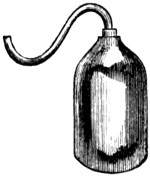
Hydrogen gas is the lightest substance known, being fifteen times lighter than atmospheric air. It is colourless and transparent, incapable of supporting combustion or respiration, but is itself combustible. Hydrogen, as its name implies (being derived from two Greek words, signifying the generator of water), is a constituent of water in the proportion of one-ninth by weight, and is always obtained by decomposing that fluid, by presenting to it some body to take up its other ingredient, oxygen, and so set the hydrogen at liberty. If the steam of water be passed through a red-hot gun barrel, containing iron filings, the water is decomposed, the iron taking the oxygen, and the hydrogen comes over in torrents; but as every one has not a gun barrel and furnace to heat it, the usual mode is to employ dilute sulphuric acid, and iron filings, or zinc, in small pieces, and it may be collected over water by means of a bent tube issuing from the bottle in which it is formed. It is so light that it was used to fill balloons before coal gas was to be had, and if you procure a light air-tight bag of silk, or thin membrane such as a turkey’s crop, and fill it with the gas, it will ascend rapidly, and dance about the ceiling of a room.
1. Attach a tobacco-pipe to a bladder filled with this gas, and blow some soap-bubbles with it; they will rise very rapidly, and if a lighted taper be applied to them they burn.
If you mix in a soda water bottle one-third of oxygen with two-thirds of hydrogen, and apply flame, the mixture will explode with a sharp report. Great care must be taken in all experiments with the mixed gases. To avoid danger the gases are placed in separate india-rubber bags, and are only brought together at the jet. This is[365] an expensive apparatus, and should only be used by experienced persons.
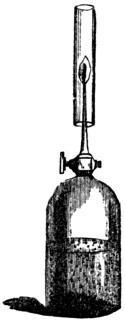
2. If a jar of this gas be held with its mouth downwards, and a lighted taper passed up well into the jar, the taper will be extinguished, and the gas take fire, and burn quietly at the mouth of the jar; if mixed with oxygen or atmospheric air, it will explode.
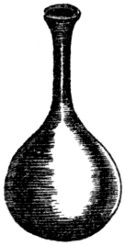
Hold over the jet of hydrogen issuing from a small tube, hollow cylinders of glass or earthenware, Florence flasks, or hollow glass balls, and musical sounds will be produced, which were supposed to depend on some peculiar property of hydrogen gas, until Mr. Faraday tried flame from coal gas, olefiant gas, and even the vapour of ether, when the sounds were still produced, and he attributed them to a continuous explosion, or series of explosions, produced by the union of oxygen with the hydrogen of the flames.
With oxygen, hydrogen unites to form the important compound water, which exists not only in the obvious form of oceans, rivers, lakes, rains, dews, &c. &c. but is found intimately combined with many substances, giving them some of their peculiar properties. Many crystals have a definite proportion of water combined with them, and on losing this water they lose their crystalline form. Many acids also cannot exist as acids without water. The slaking of lime depends upon the union of water with the lime, the dry powder resulting from the process being a hydrate of lime, the water having become solidified, and in passing from the fluid to the solid state gives out its latent caloric, producing the heat observed during[366] the process. When a large quantity of lime, a barge-load for instance, has got wetted by accident, the heat evolved has been sufficient to set fire to the barge.
At the temperature of 32° of Fahrenheit’s thermometer, water loses its fluid form, and becomes ice. As it solidifies, it starts into beautiful crystals, which unite and cross each other at determinate angles. Ice is lighter than the water on which it floats, forming a protection to the water beneath, and preventing it from being frozen so rapidly; else, if the ice were heavier than water, and consequently sank as soon as formed, each portion of water would be frozen in its turn, until rivers became solid throughout, and every living creature in them must be destroyed. Now, the temperature of the water under the ice is seldom much below 40°, and if care be taken to break holes at intervals to allow access to the air, the fish and other aquatic animals seldom suffer even in our coldest winters.
Although it is impossible to raise ice even one degree above 32° without thawing, it is not difficult to reduce water many degrees below that point without freezing it.
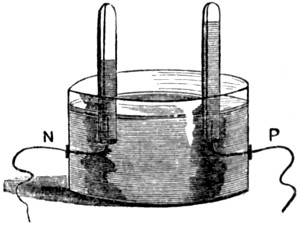
In order to obtain both the constituents of water in a separate state, it must be decomposed by galvanism, each pole of a battery terminating in a separate tube containing water, when the result will be that at the positive pole oxygen gas will be evolved, and hydrogen at the negative, the latter being double the quantity of the former. Now, if you mix the gases thus obtained, introduce them into a vessel called a “Eudiometer,” and pass an electric spark through them from a Leyden phial, a sudden flash will be seen, and the gases will entirely disappear, being again converted into water. If you have a mercurial trough, and perform this experiment over mercury, the inside of the eudiometer will exhibit minute drops of water. Thus you have proved both by analysis and synthesis, that water consists of oxygen and hydrogen, in the proportion of one volume of the former to two of the latter.
Take some perfectly pure distilled water, filter it, surround it with a mixture of light snow, or powdered ice, and salt, taking care to keep it perfectly still, a thermometer having been previously placed in it. The mercury will gradually sink many degrees below the freezing point 32° (it has been reduced as low as 4°), the water still remaining fluid; when all at once, either from shaking the table, or[367] simply because the reduction can be carried no further, it suddenly starts into ice, and the thermometer jumps up at once to 32°, where it remains until the whole is frozen, when the temperature gradually sinks to that of the surrounding medium.
Now if you remove the glass of ice from the freezing mixture into the apartment, and watch the thermometer, you will find it gradually rise to 32°, and there remain until all the ice is melted, when it will gradually acquire the temperature of the room. The reason of this is, that the water in passing from the solid to the fluid form absorbs, and in passing from the fluid to the solid form gives out caloric, so maintaining the temperature at 32°, the point at which the change of form takes place, until it is completed.
Between the temperature of 32° and 212°, water exists in a fluid form, under ordinary circumstances; but at the latter point it assumes the form of vapour or steam, and acquires many of the properties of gases, being indefinitely expansible by heat, the force increasing as the temperature is raised, provided the steam be confined, until it becomes irresistible,—witness the frequent explosions of steam-engines even in this country; and in America, where the engines are worked at a high pressure, accidents are of daily occurrence.
The temperature at which water boils is modified by the pressure applied to it. Thus, as you ascend a mountain, and so pass through a portion of the atmosphere, water boils at a lower temperature, until at great heights it boils at so low a heat, that good tea cannot be made because it is impossible to heat the water sufficiently. Under the exhausted receiver of an air-pump, water boils at about 140°.
Another gaseous element, sometimes called a supporter of combustion, is named chlorine, from a Greek word signifying yellowish green.
This gas was formerly called “oxymuriatic acid,” being supposed to be a compound of oxygen and muriatic acid gases, until Sir H. Davy, in a series of masterly experiments carried on during the years 1808-9-10 and 11, proved that it contained no oxygen or muriatic acid, and that it was in fact a simple or undecompounded substance, and changed its name to chlorine, which name was, after some discussion, accepted by the scientific world, and is still in use.
This gas may be obtained for experiment, by gently heating in a retort a mixture of muriatic or hydrochloric acid, hydrochloride, as it is now called, with some black oxide of manganese: the muriatic acid, a compound of chlorine and hydrogen, is decomposed, and so is the oxide of manganese, giving out some of its oxygen, which takes the hydrogen from the muriatic acid to form water, while the chlorine[368] gas, with which the hydrogen had been united, is set at liberty, and may be collected in jars over water.

Chlorine gas is transparent, of a greenish yellow colour, has a peculiar disagreeable taste and smell, and if breathed even in small quantities, occasions a sensation of suffocation, of tightness in the chest, and violent coughing, attended with great prostration. I have been compelled to retire to bed from having upset a bottle containing some of this gas. It destroys most vegetable colours when moist, and is in fact the agent now universally employed for bleaching purposes.
It has also the power of combining with and destroying all noxious smells, and is invaluable as a purifier of foul rooms, and destroyer of infection. For these latter purposes it is used in combination with lime, either in substance or solution, under the name of “Chloride of Lime.”
Sir W. Burnett has lately discovered that the chloride of zinc answers the same purposes as the chloride of lime, and has the advantage of being itself destitute of smell, and his fluid is frequently substituted for the other.
Chlorine gas is a powerful supporter of combustion, many of the metals taking fire spontaneously when introduced in a fine state of division into the gas.
1. Into a jar of chlorine gas introduce a few sheets of copper leaf, sold under the name of Dutch foil, when it will burn with a dull red light.
2. If some metallic antimony in a state of powder be poured into a jar of this gas, it will take fire as it falls, and burn with a bright white light.
3. A small piece of the metal potassium may be introduced, and will also take fire.
4. A piece of phosphorus will also generally take fire spontaneously[369] when introduced into this gas. In all these cases direct compounds of the substances with chlorine are produced, called chlorides.
5. If a lighted taper be plunged quickly into the gas, it will continue to burn with a dull light, giving off a very large quantity of smoke, being in fact the carbon of the wax taper, with which the chlorine does not unite; while the other constituent of the taper, the hydrogen, forms muriatic acid by union with the chlorine.
6. This substance has the property of destroying most vegetable colours, and is used in large quantities for bleaching calico, linen, and the rags of which paper is made. It is a curious fact that it shows this property only when water is present, for if a piece of coloured cloth is introduced dry into a jar of the gas, also dry, no effect will be produced—wet the cloth, and reintroduce it, and in a very short time its colour will be discharged.
7. Introduce a quantity of the infusion of the common red cabbage, which is of a beautiful blue colour, into a jar of this gas, and it will instantly become nearly as pale as water, retaining a slight tinge of yellow. A solution of sulphate of indigo can always be obtained, and answers well for this experiment.
With chlorine, hydrogen forms a compound called muriatic, or hydrochloric acid gas. It cannot easily be formed by the direct union of its elements, but is procured from some compound in which it exists ready formed. Common salt (chloride of sodium) is generally employed; and when acted on by strong sulphuric acid (or oil of vitriol), the gas is disengaged in abundance. It must be collected over mercury, for water absorbs it, forming the liquid muriatic, or hydrochloric acid.
A lighted taper plunged into this gas is instantly extinguished. It is very dangerous to animal life if respired. It has the property of destroying animal effluvia, and was once employed to purify the cathedral of Dijon, which was so filled with putrid emanations from the bodies buried in it, that it had been closed for some time. It perfectly succeeded, but it is so destructive to all metallic substances that it is not used now, for the chlorides of lime and zinc have since been discovered to act more effectually than the muriatic acid gas, without its inconvenience.
The compounds of hydrogen with iodine are passed over.
With nitrogen, hydrogen unites and forms one of the most extraordinary compounds in the whole range of chemistry,—the gas called ammonia. This is the only gas possessing what are called alkaline properties; i. e. it changes the blue colour of certain vegetables to green, yellow to deep brown, and unites with the acids to form neutral compounds, just as the other alkalies, potash and soda, which are oxides of metals. It may be procured in abundance by heating the hydrochlorate of ammonia, or sal ammoniac, as it is usually[370] called, with quick-lime, which takes the hydrochloric acid, and sets free this remarkable gas. It must be received over mercury, as it is absorbed to almost any extent by water, forming the fluid sold as “spirits of hartshorn” in the shops.
This gas is colourless and transparent, lighter than atmospheric air, and will not support combustion; it has a very pungent but not disagreeable smell. Under certain circumstances it is combustible.
1. Take a bottle containing chlorine gas, and invert over its mouth another filled with ammoniacal gas; then if the bottles be held in the hand (guarded by a pair of gloves), and suddenly turned, so that the chlorine be uppermost, the two gases will unite so rapidly that a white flame fills the bottles for an instant.
2. Substitute for the chlorine of the last experiment a bottle of carbonic or hydrochloric acid gas; in either case the gases disappear, and a light white powder settles on the sides of the bottles, being the carbonate or hydrochlorate of ammonia, according to the acid used.
Carbonate of ammonia is the substance sold for “smelling salts;” and the hydrochlorate, or muriate of ammonia, is the salt called “sal ammoniac,” whence the alkaline gas was first obtained, and from which it got its name of ammonia. The salt itself was so called, because it was formerly brought from the deserts near the ruins of the temple of Jupiter Ammon.
This salt is, as has been shown, a compound of muriatic acid gas and ammoniacal gas, containing therefore only three simple elements—hydrogen, chlorine, and nitrogen, all gases, and known only in the gaseous state, its symbol being NH4C2; yet they by union form a solid body, resembling in all essential qualities the salts of potash and soda, which are oxides of known metals. Moreover, if some mercury be placed in a solution of this salt, and subjected to the action of galvanism, the negative pole being applied to the mercury, and the positive to the sal ammoniac, the mercury presently loses its fluidity, increases greatly in size, and in fact presents the same appearance as when it is mixed with some metal, forming what is called an “amalgam.” When the battery ceases to act, a succession of white films forms on the surface of the amalgam, and the mercury soon returns to its original state. How is this to be explained? Some chemists have supposed that there must be a base united to the mercury, and have named this hypothetical substance “ammonium,” to correspond to potassium and sodium, the bases of potash and soda, which resemble ammonia in so many properties. But what is this ammonium? and how is it formed? for hydrogen and nitrogen are simple elementary bodies. Are all metals compounds of gases? and are there but a few elements instead of the 64 now enumerated? This, however, is a difficult question, not fitted for discussion here.
Carbonate of ammonia may be obtained by mixing together powdered chalk (which is a carbonate of lime) and muriate of ammonia, and heating the mixture in close vessels, when the salt in question will rise in fumes, and be condensed in a mass in the upper part of the vessel. It is, however, so largely produced in other manufactures, particularly in gas-works, that there is no necessity to resort to the more expensive and direct method. It is the well-known “smelling salts.”
The only other salt of ammonia worth our notice here is the nitrate, from the destructive distillation of which is obtained the nitrous oxide, or laughing gas, already mentioned.
On the coasts of certain islands belonging to the Duke of Argyll, vast quantities of sea-weed are occasionally torn up from their ocean beds and deposited on the shores. This weed, after being partially dried by exposure to the sun and air, is burnt in a shallow pit; the ashes are then collected, and form the commercial raw material called kelp, from which iodine is procured by a gradual series of processes.
Iodine has a beautiful metallic lustre, with a bluish black colour, and should be kept in a well-stoppered bottle. A small quantity placed in a clear flask and heated, affords a magnificent violet vapour, which may be poured from the flask into another glass vessel, when it condenses again into crystalline plates. The colour of the vapour originates the name of this element, so called from the Greek ὶώδης, violet-coloured. If a little iodine be placed in contact with a thin slice of phosphorus, the latter takes fire almost immediately.
So called from the Greek βρόμος, a bad odour, is most intimately allied with chlorine and iodine; like these elements it belongs to the sea, and is a constituent of sea-water. Bromine is a very heavy fluid, and should be preserved by keeping it covered with water in a stoppered-bottle.
Experiments with liquid bromine are not recommended, as all the most interesting ones can be performed with the vapour, which is easily procured by letting fall a few drops of bromine into a warm dry bottle.
Pounded antimony sprinkled into the vapour takes fire immediately.
A thin slice of phosphorus placed in a deflagrating ladle and placed into the vapour of bromine ignites very quickly.
A solution of sulphate of indigo, or an infusion of red cabbage, are easily bleached by being shaken violently with the vapour of bromine.
In many parts of England, especially in Devonshire, Cornwall, and above all in Derbyshire, is found a very beautiful mineral, known by the name of Fluor Spar, Derbyshire Spar, and called by the miners Blue John, to distinguish it from another mineral found, in the same locality, called Black Jack. It occurs in very regular and frequently large crystals in the form of cubes, and occasionally in octoëdra. It is a compound of calcium with fluorine, and is very abundant in certain fossil bones. This element, in combination with hydrogen and called hydrofluoric acid, acts so energetically upon all substances containing silica, that it cannot be preserved in vessels of glass or porcelain—very few of the metals are capable of resisting its action, lead being nearly the only common metal possessed of this power. Gutta percha may also be employed for vessels to hold it.
This property of dissolving silica, has caused this acid to be used for engraving on glass.
Mix one part of powdered fluor-spar, quite pure, with two parts of oil of vitriol, in a saucer, and apply a gentle heat, when the acid will be disengaged in the form of vapour. Prepare a piece of glass after the manner of engraving on copper, by coating it with a thin covering of wax, placing a paper over the wax, and then drawing any design with a sharp-pointed instrument, when, on removing the paper, the wax-coating will be found to be removed wherever the instrument has passed over it. Now invert, this glass over the fumes of the acid for half an hour or so, and then heat the glass so as to soften the coating, and wipe it off; the design will then appear “bitten in” as the term is, that is, the acid will have dissolved the glass wherever it was not protected by the wax, and will exhibit the design indelibly fixed on the glass.
This acid requires the greatest care in handling, for it is extremely corrosive, producing very troublesome ulcers if it comes in contact with the skin; even the fumes will produce smarting if the skin is long exposed to them.
The next substance in our list of elementary bodies is named carbon.
The purest form of carbon is the precious stone called diamond, which consists entirely of carbon in a crystallized form. The French chemist Lavoisier was the first who proved the combustibility of the diamond; and Sir H. Davy found that when once set on fire it would continue to burn in oxygen gas air, and that the product of the combustion was carbonic acid gas, exactly equal in quantity to the gas produced by burning an equal weight of pure charcoal, the most common form of carbon.
Plumbago, or “black-lead,” as it is very improperly called, is also nearly pure carbon, a very small quantity of iron being united with it.
By far the greater part of all vegetable, and a very large portion of animal bodies consists of carbon; and in the state of carbonic acid in combination with lime and some other earths, it forms nearly the half of all the chalk, marble, and limestone of our hills; so that it is, in one shape or other, one of the most widely diffused bodies in nature.
Carbon forms two gaseous compounds with oxygen; the first, called carbonic oxide, is easily obtained by boiling oxalic acid with its own bulk of sulphuric acid, in a flask to which a cork and bent tube is attached. The gas comes over in large quantities, and must be collected in a gas jar, or the pneumatic trough. It is inflammable, and burns with a lambent blue flame.
The other compound, carbonic acid, is transparent, colourless, much heavier than atmospheric air, has an agreeable taste, has the power of irritating the mucous membrane of the nose, (as any one can tell who has drunk soda-water), without possessing any particular odour, is absorbed by water, does not support respiration, and extinguishes flame.
Carbonic acid gas may be obtained with the greatest facility by pouring some muriatic or sulphuric acid, diluted with about six parts of water, upon some pieces of marble or limestone in a bottle with a tube attached, when the gas comes over in torrents. It may be collected over water.
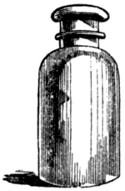
STOPPERED BOTTLE FOR HOLDING GAS.
1. To show the great comparative weight of this gas, place a lighted taper at the bottom of a tall glass jar, then take a jar full of carbonic acid gas, and pour it as you would pour water into the jar containing the lighted taper; you will soon find the taper will be extinguished as effectually as if you had poured water on it, and the smoke of the taper will float on the surface of the gas in very beautiful wavy forms.
2. Heat a piece of the metal potassium in a metal spoon (platinum is best), and if introduced in a state of ignition into the gas, it will continue burning brilliantly, producing a quantity of dense smoke, which is the carbon from the carbonic acid, the potassium having seized the oxygen and being converted by it into potash.
3. If a mouse, bird, or other small animal, be placed in a jar of this gas, it becomes insensible almost immediately, but if speedily removed it will occasionally recover.
4. Shake up some water with some of this gas in a bottle; the greater part of the gas will be absorbed by the water,[374] which acquires a sparkling appearance and a pleasant sharp taste; with the addition of a little soda this becomes the well-known beverage called soda-water, so famous for removing the morning headaches caused by “that salmon” having disagreed at yesterday’s dinner.
It is the presence of this gas which renders it so dangerous to descend into deep wells, for by its great weight it collects at the bottom, and instantly suffocates any unfortunate person who incautiously subjects himself to it. Hence it is prudent always to let down a lighted candle before any one descends into a well, or other deep excavation, and if the candle is extinguished, it is necessary to throw down several pails of water, lime-water if possible, and again to try the candle, which must burn freely before it is safe for any one to descend.
It is this same gas under the name of “choke-damp,” which proves so dangerous to miners, particularly after an explosion of “fire-damp,” for it is the principal product of the explosion, and it is by no means an easy matter to dislodge it.
Carbonic acid gas has been condensed into the fluid form by causing it to be disengaged under great pressure; the fluid acid has the appearance of water. When the pressure is removed, as by allowing some of the fluid acid to escape from the vessel in which it has been condensed, it instantly reassumes the gaseous form, and in so doing absorbs so much latent caloric that a portion of the acid is actually solidified, and appears in the shape of snow, which may be collected and preserved for a short time. After a lecture by Mr. Addams before the Ashmolean Society of Oxford, I carried a kind of snowball of carbonic acid for a distance of 500 or 600 yards, and placed it in a saucer in a room. It evaporated very rapidly, and left no residue, not even a mark where it had lain. It was too cold to be touched by the naked hand without pain.
Carbonic acid and lime are mutually tests for each other. If a jar containing a little lime-water be put into a jar of this gas, it speedily becomes turbid, the gas uniting with the lime, and producing chalk (the carbonate of lime), which is insoluble in water.
This gas is produced in large quantities by the respiration of animals, as may be proved by respiring through a tube immersed in lime-water, when the water will be instantly rendered turbid from the formation of chalk.
To the combination of these elements in various proportions, and with the occasional addition of other substances, we are indebted for all, or nearly all, our means of obtaining light and heat. Coal, wood, spirit, oil, and all the varieties of fats, are composed principally of carbon and hydrogen, and may easily be converted into the gas with[375] which our houses and streets are lighted, which is nearly pure carburetted hydrogen.
The two chief definite gaseous compounds of these two elements are the light carburetted hydrogen, and the heavy carburetted hydrogen, or olefiant gas. The first is easily procured by stirring the bottom of stagnant water on a hot summer’s day, and collecting the bubbles in a bottle filled with water and inverted over the place where the bubbles rise. This gas burns with a yellowish flame, and when mixed with a certain proportion of air, or oxygen gas, explodes with great violence on the application of a flame. It is the much dreaded fire-damp generated so profusely in some coal-mines, and causing such fearful destruction to life and property when accidentally inflamed.
The other compound, the heavy carburetted hydrogen, forms part of the gas used for illumination; and, in fact, whatever substance is employed for artificial light, whether oil, tallow, wax, &c. &c. it is converted into this gas by heat, and then furnishes the light by its own combustion.
This gas has some very curious properties, and may be obtained nearly pure by mixing in a retort, very carefully, one part of spirits of wine and four of sulphuric acid. A lamp must be placed under the retort, when the gas will be speedily disengaged, and come over in great abundance; it may be collected over water.
This gas is transparent, colourless, will not support combustion, but is itself inflammable, burning with a brilliant white light, and being converted into carbonic acid and water. If mixed with three or four times its bulk of oxygen, or with common atmospheric air in much larger proportions, it explodes with great violence.
This gas is sometimes called “olefiant gas,” from the property it has of forming an oily substance when mixed with chlorine.
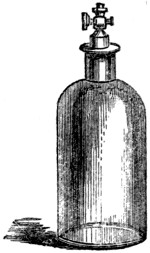
JAR FOR COLLECTING GASES.
Into a jar standing over water half full of this gas, pass an equal quantity of chlorine gas. The gases will speedily unite and form an oily-looking liquid, which may be collected from the sides of the jar as it trickles down. By continually supplying the jar with the two gases as they combine, a considerable quantity of this substance may be collected. Care should be taken that the olefiant gas is rather in excess.
The substance produced is insoluble in water, with which it should be washed by shaking them together in a tube, and has a pleasant sweetish taste and aromatic smell, somewhat resembling ether.
The gas so universally employed for the purposes of illumination is a mixture of the carburetted and the bi-carburetted hydrogen, with minute portions of other gases scarcely worth mentioning. It is procured by submitting coals to a red heat in iron retorts, having a tube passing from one end, along which passes all the fluid and gaseous matter separated from the coal, namely, gas tar, ammoniacal liquor, and various gases, carburetted hydrogen, carbonic acid, sulphuretted hydrogen, &c. &c. The tar and ammoniacal liquor remain in the vessel in which the tubes from the retorts terminate, and the gaseous productions are conveyed through water and lime to separate the impurities; the remaining gas, now fit for use, passes into large iron vessels, called gasometers, inverted over water (like the jars in a pneumatic trough), whence it is sent through pipes and distributed where required. What remains in the retorts is called coke. It consists principally of charcoal, mixed with the earthy and metallic particles contained in the coal.
If you possess an iron bottle, fill it with powdered coal, and attach a flexible tube to it, and put it in the fire: as soon as it becomes red hot, large quantities of smoke will escape from the end of the tube, being the gas mixed with all its impurities. By passing it through water (if mixed with lime it will be better), the gas may be collected in jars standing over water, and submitted to experiment. If you do not possess a bottle, take a tobacco-pipe with a large bowl, (a “churchwarden” for example); fill the bowl with small coal, cover it with clay or putty, and when dry put it into the fire, and the gas will soon appear at the other end of the pipe, when it may be lighted, or the gas may be collected over water, as in the former experiment.
The light carburetted hydrogen contained in this gas is given off spontaneously in some coal-mines, and as it forms explosive mixtures with atmospheric air, the mines where it abounds could not be worked except at the greatest risk until about the beginning of the present century, when Sir H. Davy, while prosecuting some researches on the nature of flame, found that flame would not pass through metallic tubes, and he gradually reduced the length of the tubes, until he found fine iron wire gauze formed an effectual barrier against the passage of flame. He then thought that if the light in a lantern were surrounded with this gauze, it might safely be used in an inflammable atmosphere, where a naked light would instantly cause an explosion. Upon submitting the lamp to experiment, he found that by passing coal gas by degrees into a vessel in which one of his lamps was suspended, the flame first became much larger, and then was extinguished, the cylinder of gauze being filled with a pale flame, and though the gauze sometimes became red-hot, it did not ignite[377] the gas outside. As the supply of coal gas was diminished, the wick of the lamp was rekindled, and all went on as at first. A coil of platinum wire was afterwards suspended in the lamps, which becomes intensely heated by the burning gas, and gives out sufficient light to enable the miner to see to work. As long as the gauze is perfect it is almost impossible for the external air to be kindled by the wick of the lamp, but the miners are so careless that they will often remove the gauze to get a better light, to look for a tool, or some cause equally trivial, and many lives have been lost in consequence of such carelessness.
The effect of fine wire gauze in preventing the passage of flame may be shown by bringing a piece of the gauze gradually over the flame of a spirit-lamp, until it nearly touches the wick, when the flame will be nearly extinguished, but the vapour of the spirit passes through, and may be lighted on the upper side of the gauze, which will thus have a flame on either side, though totally unconnected with each other. The flame from a gas-burner will answer as well as the spirit-lamp.
Nearly all the fluids, and solids also, used for procuring artificial light, such as naphtha, various oils, tallow, wax, spermaceti, spirits of wine, ether, &c. &c. are compounds of carbon and hydrogen in different proportions, with the occasional addition of some other elements, especially oxygen and hydrogen, in the proportions to form water; as a general rule, those bodies containing the greatest proportion of carbon give the most light, though not necessarily the most heat.
The next body we have to notice is phosphorus, a most remarkable substance, procured from the earthy part of bones by a process not worth detailing here. It should be always kept under water, and the naked fingers should not be allowed even to touch it, for the smallest piece getting under the nail will inflame the first time the hand comes near the fire, and produce a sore very painful and difficult to heal. It should be cut under water by a knife or scissors, and removed with a pair of forceps. Its combustible properties have been frequently mentioned. It has also the property of shining in the dark, so that if you write on a wall with a solution of phosphorus in oil, the letters will appear luminous in the dark—there is no danger, excepting from the greasiness of the oil.
Of the compounds of phosphorus with oxygen we have nothing to do here, but it forms with hydrogen a very curious gaseous compound, which takes fire spontaneously on the contact of air, or almost any gas containing oxygen.
It may be procured in either of two ways, according to the purpose for which it is wanted. The simplest way is to put a lump or two[378] of phosphuret of lime into a saucer, about two inches in depth, containing some very diluted hydrochloric acid; bubbles of gas will speedily arise, and bursting on the surface of the fluid will burn with a slight explosion, and a circular wreath of smoke will rise into the atmosphere, enlarging as it rises, and wreathing itself round and round in the most elegant forms. Care must be taken that the phosphuret is fresh, and has been kept in a well-closed bottle, or the experiment will fail. The apartment must be free from draughts. If you desire to collect the gas, another method must be employed.
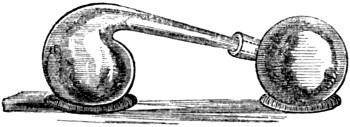
Fill a small retort quite full, neck and all, of a solution of caustic potash, drop five or six pieces of phosphorus into it, place the finger on the end of the retort, and immerse it in a basin also containing a hot solution of potash, remove the finger, and on applying the heat of a lamp to the retort, the gas will soon be disengaged rapidly, and drive out the fluid in the retort; it then escapes into the air, when it inflames with the same appearances as before described. Or it may be collected in gas jars filled with the potash solution, and held over the mouth of the retort. The object in using hot solution of potash in the basin is, that when the gas ceases to be given off, and the heat of the lamp is withdrawn, the hot fluid may gradually fill the vacuum which will form in the retort, and so prevent its being broken.
This gas is transparent and invisible, like most other gases. It is very poisonous if inhaled. If kept for any time, it loses its property of spontaneous inflammation, and must therefore be made at the time it is required.
Sulphur, or brimstone, as it is frequently called, is sold in the form of sticks, or roll brimstone, or in fine powder called flowers of brimstone.
It is capable of showing electric phenomena when rubbed, giving out slight sparks, and first attracting and then repelling light bodies, such as small pieces of paper, &c. It is so bad a conductor of heat, that if grasped suddenly in a hot hand, it will crack and split into pieces just as glass does when suddenly heated or cooled—of course I am speaking of the roll brimstone. Water has no effect on it, as may be seen in the pans placed for pet dogs to drink out of, where[379] the same piece of brimstone lies for years entirely unaltered, though it is supposed to prevent the dogs from having the mange!
Sulphur is largely used in the arts, principally in the manufacture of gunpowder, and fireworks of various kinds.
It combines with hydrogen, and forms a gaseous compound called sulphuretted hydrogen, which is almost the most poisonous of all the gases. It fortunately has so abominable smell, that due notice is given of its presence. Rotten eggs, a dirty gun-barrel, cabbage water, putrid animal and vegetable matter, &c. are indebted to this gas for their inviting odour; and it is found in certain mineral springs, as at Harrogate, where the water contains a considerable quantity of this gas, and is found useful in many diseases of the skin. It is also given off in a gaseous form by some volcanoes.
This gas may be obtained by pouring dilute hydrochloric acid upon a metallic sulphuret, such as that called crude antimony, being a native sulphuret of that metal. The gas may be kept for a short time over water. It is colourless and transparent, inflammable, but quite irrespirable, a small bird dying instantly when placed in air containing only 1⁄1500th of this gas. Its most remarkable property perhaps is the effect it has on certain metallic oxides, and other metallic salts, blackening them instantly. White paint is easily stained by this gas, and it will darken the colour of a metal in a solution, especially of lead, even when diluted with 20,000 times its weight of water. By way of experiment, slips of riband, silk, or even paper, may be wetted with various metallic solutions, such as silver, mercury, lead, &c. or words may be written with the solutions, and on holding them over a stream of this gas they will be instantly darkened.
If this gas be collected in the pneumatic trough, which is usually painted white, you will have the pleasure of seeing the colour changed to a very dark brown, when your experiments are finished. With this very limited description of some of the non-metallic elements and their combinations, we must, for want of space, take leave of this division of chemistry; “the beginning of which is pleasure, its progress knowledge, its objects truth and utility.”—(Davy.)
We have a few words to say about a class of bodies called metals, which are of the utmost importance to mankind, and indeed without some of them, especially iron, few of the arts of civilized life could exist.
Fifty substances are now included in the list of metals; some of them, however, are only supposed to exist, such as ammonium, the supposed base of ammonia; and very many are to be viewed rather in the light of chemical curiosities, as from their great rarity they are too expensive for use, even if possessed of valuable properties of which others might be destitute.
Several metals have been known from the earliest period of which we have any record; such were iron, gold, silver, copper, lead, tin, mercury, and probably zinc, or at least its ores; for brass, which is an alloy of copper and zinc, is frequently mentioned in the early part of the Old Testament. In the sixteenth century others were discovered, such as antimony and bismuth. In the last century, cobalt, arsenic, platinum, nickel, manganese, and chromium, together with several unimportant metals, were discovered by various philosophers; while in the present century, Dr. Wollaston discovered rhodium, the hardest and nearly the most indestructible of all the metals; and a few years later, Sir Humphry Davy found that the alkalies, potash, and soda, with many of the earths as they were called, had each a metal for its base, to which he gave the Latin name of the alkali or earth, with the termination um, as potassium, the base of potassa, sodium of soda, calcium of calx (lime), &c.
Until Sir H. Davy’s discovery of the metals of the alkalies, great specific gravity was regarded as one of the most striking characteristics of a metal, the lightest of them being much heavier than the heaviest earth; but potassium is very much lighter than water, and not much heavier than spirits of wine. The other metals vary from a specific gravity of nearly twenty-one—or twenty-one times heavier than an equal bulk of water—that of platinum, to somewhat less than seven, which is the specific gravity of antimony.
When pure, they all have a lustre, differing indeed among themselves, but so peculiar that it is called the metallic lustre, for instance, gold and copper are yellow and red—nearly all the others white, but of a different shade; still there is no mistaking their metallic character, no other substances at all equalling them in this respect. They are also opaque, although some, like gold, when reduced to thin films, allow light to pass through them. They are all good conductors of heat and electricity, though some possess that property to a greater extent than others.
Many of them are what is called malleable, that is, may be extended or spread out by rolling, or beating them with a hammer; and ductile, or have the property of being drawn out into wire. Gold, silver, copper, and iron, are the most remarkable in this respect.
All the metals are fusible, but some require very different degrees of heat to render them fluid,—platinum requiring the heat of the oxy-hydrogen blowpipe, while tin melts in the flame of a candle, and mercury is fluid at all temperatures in this climate, but becomes solid at 40° Fahr. below 0,—a temperature occasionally experienced in the Arctic regions, where the mercurial thermometer is useless, the mercury becoming solid.
They are all excellent conductors of heat and electricity, and have the property of reflecting light and forming mirrors; for looking-glasses owe their power of reflecting objects principally to what is[381] called the “silvering;” that is, a mixture of mercury and tin spread over the back of the glass, which being transparent, allows the image reflected from the metal to pass through it.
The following classification is most instructive, because it suggests to the young student that there must be identical properties in the metals thus placed together:—
Class 1. Ammonium, cæsium, lithium, potassium, sodium.
Class 2. Calcium, barium, strontium.
Class 3. Aluminium, cerium, didymium, erbium, glucinium, lanthanum, thorium, yttrium, zirconium.
Class 4. Zinc class: cadmium, magnesium, zinc.
Class 5. Iron class: cobalt, chromium, indium, iron, manganese, nickel, uranium.
Class 6. Tin class: niobium, tantalum, tin, titanium.
Class 7. Tungsten class: molybdenum, tungsten, vanadium.
Class 8. Arsenic class: antimony, arsenic, bismuth.
Class 9. Lead class: lead, thallium.
Class 10. Silver class: copper, mercury, silver.
Class 11. Gold class: gold, iridium, osmium, palladium, platinum, rhodium, ruthenium.
Potassium was discovered by Sir H. Davy in the beginning of the present century, while acting upon potash with the enormous galvanic battery of the Royal Institution, consisting of 2,000 pairs of 4-inch plates. It is a brilliant white metal, so soft as to be easily cut with a penknife, and so light as to swim upon water, on which it acts with great energy, uniting with the oxygen, and liberating the hydrogen, which takes fire as it escapes.
Trace some continuous lines on paper with a camel’s-hair brush dipped in water, and place a piece of potassium about the size of a pea on one of the lines, and it will follow the course of the pencil, taking fire as it runs, and burning with a purplish light. The paper will be found covered with a solution of ordinary potash. If turmeric paper be used, the course of the potassium will be marked with a deep brown colour.—Corollary. Hence, if you touch potassium with wet fingers you will burn them!
If a small piece of the metal be placed on a piece of ice, it will instantly take fire, and form a deep hole, which will be found to contain a solution of potash.
In consequence of its great affinity for oxygen, potassium must be kept in some fluid destitute of that element, such as naphtha.
Caution!—As the globules of potassium after conversion into potash, when thrown on ice or water burst, strewing small particles of caustic hot potash in every direction, the greatest care should be[382] taken to keep at a sufficient distance whilst performing the above experiment.
Saltpetre, or nitre, is a compound of this metal (or rather its oxide) with nitric acid. It is one of the ingredients of gunpowder, and has the property of quickening the combustion of all combustible bodies.
Mix some chlorate of potash with lump sugar, both being powdered, and drop on the mixture a little strong sulphuric acid, and it will instantly burst into flame. This experiment also requires caution.
Want of space precludes us from considering the individual metals and their compounds in detail; it must suffice to describe some experiments showing some of their properties.
The different affinities of the metals for oxygen may be exhibited in various ways. The silver or zinc tree has already been described, page 357.
1. Into a solution of nitrate of silver in distilled water immerse a clean plate or slip of copper. The solution, which was colourless, will soon begin to assume a greenish tint, and the piece of copper will be covered with a coating of a light grey colour, which is the silver formerly united to the nitric acid, which has been displaced by the greater affinity or liking of the oxygen and acid for the copper.
2. When the copper is no longer coated, but remains clean and bright when immersed in the fluid, all the silver has been deposited, and the glass now contains a solution of copper.
Place a piece of clean iron in the solution, and it will almost instantly be coated with a film of copper, and this will continue until the whole of that metal is removed, and its place filled by an equivalent quantity of iron, so that nitrate of iron is found in the liquid. The oxygen and nitric acid remain unaltered in quantity or quality during these changes, being merely transferred from one metal to another.
A piece of zinc will displace the iron in like manner, leaving a solution of nitrate of zinc.
Nearly all the colours used in the arts are produced by metals and their combinations; indeed, one is named chromium, from a Greek word signifying colour, on account of the beautiful tints obtained from its various combinations with oxygen and the other metals. All the various tints of green, orange, yellow, and red, are obtained from this metal.
Solutions of most of the metallic salts give precipitates with solutions of alkalies and their salts, as well as with many other substances, such as what are usually called prussiate of potash, hydro-sulphuret of ammonia, &c.; and the colours differ according to the metal employed, and so small a quantity is required to produce the colour that the solutions before mixing may be nearly colourless.
1. To a solution of sulphate of iron add a drop or two of a solution of prussiate of potash, and a blue colour will be produced.
2. Substitute sulphate of copper for iron, and the colour will be a rich brown.
3. Another blue, of quite a different tint, may be produced by letting a few drops of a solution of ammonia fall into one of sulphate of copper—a precipitate of a light blue falls down, which is dissolved by an additional quantity of the ammonia, and forms a transparent solution of the most splendid rich blue colour.
4. Into a solution of sulphate of iron let fall a few drops of a strong infusion of galls, and the colour will become a bluish-black—in fact, ink. A little tea will answer as well as the infusion of galls. This is the reason why certain stuffs formerly in general use for dressing gowns for gentlemen were so objectionable; for as they were indebted to a salt of iron for their colour, buff as it was called, a drop of tea accidentally spilt produced all the effect of a drop of ink.
5. Put into a largish test tube two or three small pieces of granulated zinc, fill it about one-third full of water, put in a few grains of iodine and boil the water, which will at first acquire a dark purple colour, gradually fading as the iodine combines with the zinc. Add a little more iodine from time to time, until the zinc is nearly all dissolved. If a few drops of this solution be added to an equally colourless solution of corrosive sublimate (a salt of mercury) a precipitate will take place of a splendid scarlet colour, brighter if possible than vermilion, which is also a preparation of mercury.
Some of the metals assume certain definite forms in returning from the fluid to the solid state. Bismuth shows this property more readily than most others.
Melt a pound or two of bismuth in an iron ladle over the fire; remove it as soon as the whole is fluid; and when the surface has become solid break a hole in it, and pour out the still fluid metal from the interior; what remains will exhibit beautifully formed crystals of a cubic shape.
Sulphur may be crystallized in the same manner, but its fumes when heated are so very unpleasant that few would wish to encounter them.
One of the most remarkable facts in chemistry, a science abounding in wonders, is the circumstance, that the mere contact of hydrogen, the lightest body known, with the metal platinum, the heaviest, when in a state of minute division, called spongy platinum, produces an intense heat, sufficient to inflame the hydrogen: of course this[384] experiment must be made in the presence of atmospheric air or oxygen.
Time and space (or rather the want of them) compel us to conclude with a few experiments of a miscellaneous character.
Prepare separately, saturated solutions of sulphate of magnesia (Epsom salts) and carbonate of potash. On mixing them the result will be nearly solid.
[7] Saturated solutions are made by adding the salt to boiling water until it will take up no more, letting it stand till cold and then pouring off the liquid.
Solutions of muriate of lime and carbonate of potash will answer as well.
Rub together in a Wedgewood mortar a small quantity of sulphate of soda and acetate of lead, and as they mix they will become liquid.
Carbonate of ammonia and sulphate of copper, previously reduced to powder separately, will also, when mixed, become liquid, and acquire a most splendid blue colour.
The greater number of salts have a tendency to assume regular forms, or become crystallised, when passing from the fluid to the solid state; and the size and regularity of the crystals depends in a great measure on the slow or rapid escape of the fluid in which they were dissolved. Sugar is a capital example of this property; the ordinary loaf-sugar being rapidly boiled down, as it is called: while to make sugar-candy, which is nothing but sugar in a crystallized form, the solution is allowed to evaporate slowly, and as it cools it forms into those beautiful crystals termed sugar-candy. The threads found in the centre of some of the crystals are merely placed for the purpose of hastening the formation of the crystals.
1. Make a strong solution of alum, or of sulphate of copper, or blue vitriol, and place in them rough and irregular pieces of clinker from stoves, or wire-baskets, and set them by in a cool place, where they will be free from dust, and in a few days crystals of the several salts will deposit themselves on the baskets, &c.; they should then be taken out of the solutions, and dried, when they form very pretty ornaments for a room.
2. Fill a Florence flask up to the neck with a strong solution of sulphate of soda, or Glauber’s salt, boil it, and tie the mouth over with a piece of moistened bladder while boiling, and set it by in a place where it cannot be disturbed. After twenty-four hours it will probably still remain fluid. Pierce the bladder covering with a penknife, and the entrance of the air will cause the whole mass instantly to[385] crystallize, and the flask will become quite warm from the latent caloric, of which we have spoken before, given out by the salt in passing from the fluid to the solid state. It is better to prepare two or three flasks at the same time, to provide against accidents, for the least shake will often cause crystallization to take place before the proper time.
Make a strong infusion of the leaves of the red cabbage, which will be of a beautiful blue colour; drop into it a few drops of dilute sulphuric acid, and the colour will change to a bright red; add some solution of carbonate of potash, or soda, and the red colour will gradually give way to the original blue; continue adding the alkaline solution, and the fluid will assume a bright green colour. Now resume the acid, and as it is dropped in, the colour will again change from green to blue, and from blue to red. Now this simple experiment illustrates three points: first, that acids change the colour of most vegetable blues and greens to red; second, that alkalies change most blues and reds to green; and third, that when the acid and alkali are united together, they both lose their property of changing colour, and become what is called a neutral salt, i. e. a compound possessing the properties of neither of its constituents.
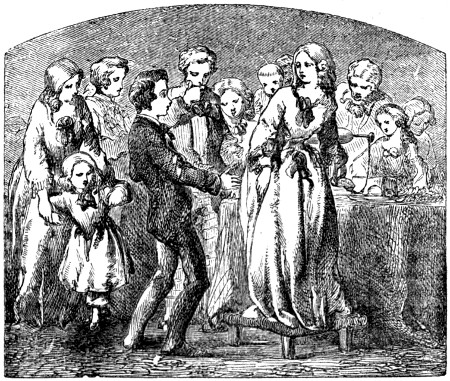
No branch of science is more capable of affording amusement, combined with instruction, than electricity, and there are few sciences in which the experiments are more easily performed. We would therefore especially recommend it to our young friends.
The term electricity is derived from the Greek word electron, signifying amber, because electrical attraction was first discovered from its being noticed that when amber was rubbed into a certain degree of warmth, it had the power of attracting small bodies to itself.
Electricity therefore primarily treats of the phenomena and effects produced by the friction or rubbing together of certain bodies called electrics. These consist of glass, amber, resinous matters, silks, hair, wool, feathers, various vegetable substances, and atmospheric air, and the electricity so obtained is usually called Frictional Electricity, to distinguish it from that produced by chemical action, and called Voltaic Electricity.
To show the nature of electrical action, rub a piece of sealing-wax or amber upon the coat-sleeve, and it will attract light bodies, such as[387] straws or small pieces of paper. If a clean glass tube be rubbed several times through a silken or leather cloth, and presented to any small substances, it will immediately attract and then repel them; and if a poker suspended by a dry silk string be presented to its upper end, then the lower end of the poker will exhibit the same phenomena as the tube itself, which shows that the opposite electrical condition may be induced upon other bodies by the mere neighbourhood and approach of another electrified body, and the effect so produced is called induced electricity.

When an electrified conductor is supported by non-conductors, so that the electric fluid cannot pass from the conductor to the earth, it is said to be insulated: thus the human body is a conductor of electricity—but if a person standing on a glass stool (as represented in the drawing) be charged with electricity, the electric fluid cannot pass from him to the earth, and he is said to be insulated; and if he be touched by another person standing on the ground, sparks will be exhibited at the point of contact, where also the person touching will feel a pricking sensation.
In order to illustrate certain remarkable facts in this science of an amusing character, attention must be directed to the figure A B, which is a metal stand; C is a small piece of cork or pith, which is suspended from the hook by a dry silken thread. Having rubbed an electric, as a dry rod of glass, and presented it to C, the ball will be instantaneously attracted to the glass and will adhere to it. After they remain in contact for a few seconds, if the glass be withdrawn without being touched by the fingers, and again presented to the ball, the latter will be repelled instead of attracted, as in the first instance. By being touched with the finger, the ball can be deprived of its electricity, and if after this has been done we present a piece of sealing-wax in the place of the glass formerly employed, the very same phenomena will take place. On[388] the first application the ball will be attracted, and on the second repelled.[8]
[8] For a more complete account of this interesting science we would refer the young reader to “The Boy’s Playbook on Science,” or, if more advanced, to “Noad’s Manual of Electricity.”
Before the young reader can perform any very important experiments with electricity, he must become possessed of an ELECTRICAL MACHINE, which is an instrument contrived for the purpose of rubbing together the surfaces of glass and leather. They generally consist of a cylinder, or plate of glass, and a piece of silk or leather for it to rub against, covered with an amalgam, the method of preparing which we shall hereafter describe.
It is very easy to make a glass machine of the cylindrical form, if the maker cannot afford to buy one. First procure a common wine bottle of good dimensions, and thickish glass. Drill a hole through its bottom, with a file moistened with dilute sulphuric acid. A blacksmith, if supplied with the acid, would undertake to do this part of the work. Through this hole and the mouth pass a spindle, as represented in the cut. The end of B should be squared to fix a handle on, and the spindle should be fixed firmly in the bottle. The bottle is then to be fixed in a frame in the following manner: the end of the spindle C passes through a hole at B; and the other end at C has the handle for turning the machine.
Next make a cushion of wash-leather stuffed with wool, and fastened to the top of a frame of the following figure. This frame is to be of such a height that the cushion shall press against the sides of the bottle, and a piece of black silk is sewn on to the top of the cushion, and hangs over the bottle D. The cushion should be[389] smeared with an amalgam, formed by melting together in the bowl of a tobacco-pipe one part of tin with two of zinc; to which, while fluid, should be added six parts of mercury. These should be stirred about till quite cold, and then reduced to a fine powder in a mortar, and mixed with a sufficient quantity of lard to form a thickish paste. When all is done, the machine is complete.
The electricity being generated by the friction produced between the rubber and the bottle from the motion imparted by the handle, it is necessary to draw it off for use. This is performed by what is called a conductor. This is made by covering a cylinder of turned wood six inches long and two and a half inches in diameter, and nicely rounded at the ends, with tinfoil, which is then mounted on a stand on a glass rod. When used, it is to be placed in the direction of the length. In it some pins are inserted, with the points outside, in a line even with, and about half an inch from, the bottle, and it should be of such a height as to come just below the silk apron. When it is wished to charge a Leyden jar, it is to be placed at the round end of the conductor. By these simple means a great variety of pleasing experiments may be performed; but to show the various phenomena connected with this interesting study, we shall now describe an electrical machine of the newest construction, and perform our experiments with it.
Formerly the electrical machine was made in the form of a cylinder, but now it consists of a plate A, as seen in the engraving. The plate is turned by the handle F through the rubber B B, which diffuses the excitement over the glass. The points or balls at each side of the plate carry off a constant stream of positive electricity to the prime conductor C. Negative electricity is generated by insulating the conductor to which the cushion is attached, and continuing the prime conductor with the ground, so as to carry off the fluid collected from the plate.
If the person who works the machine be supported on a stool having glass legs, and connected with the conductor by means of a[390] glass rod, the electricity will pass from the conductor to him, and as it cannot get away, owing to the glass on which he stands being a non-conductor, any person on touching him can draw the electricity from him, which will exhibit itself in small sparks as it passes to the person who touches him. If touched on the nose, sparks of fire will issue from it.
A most useful piece of electrical apparatus is called the Leyden jar, here represented. It is employed for the purpose of obtaining a quantity of electricity, which may be applied to any substance. It consists of a glass jar, coated both inside and without, four-fifths of the way up, with tinfoil. A knob rises through a wooden top communicating with the inside of the jar. When it is wished to charge the jar, this knob is applied to the prime conductor of the electrical machine when in action, and a quantity of electricity being given off, the jar will remain charged with it till a connexion is made, by some good conductor of electricity, between the knob and the outside tinfoil. A piece of brass chain must hang from the stem that carries the knob, and connect it with the interior of the jar.
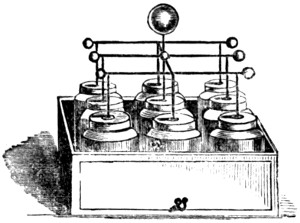
If several of these jars be united, a large quantity of electricity can be collected; but, in arranging them, all the interior coatings must be made to communicate by metallic rods, and a similar union must be effected among the exterior coatings. When thus arranged, the whole series may be charged as if they formed but one jar.
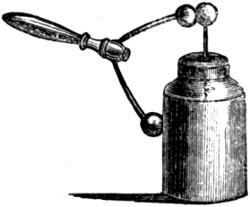
For the purpose of making a direct communication between the inner or outer coatings of a jar or battery, by which a discharge is effected, an instrument called a discharging rod is employed. It consists of two bent metallic rods, terminating at one end by brass balls, and connected at another by a joint which is fixed to the end of[391] a glass handle, and which, acting like a pair of compasses, allows of the balls being separated at certain distances. When opened to the proper degree, one of the balls is made to touch the exterior coating, and the other ball is then brought into contact with the knob of the jar, when a discharge is effected; while the glass handle secures the person holding it from the effects of the shock.
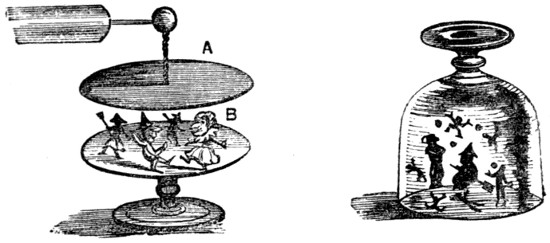
Get two round pieces of wood, A B, and coat them with tinfoil; or two pieces of metal plate; attach one of them to the prime conductor by a chain, and let it hang about two or three inches from the knob. Place some pith-balls upon the bottom piece of wood B, and bring it under the other. Immediately this is done, and the upper piece is charged with electricity from the machine, the pith-balls will jump up and down, and from one to the other with great rapidity. If some of the pith be formed into little figures, they will also dance and leap about in the most grotesque manner. The same may be made to dance by merely holding the inside of a dry glass tumbler to the prime conductor for a few minutes, while the machine is in action, and then if this be placed over them they will jump about, to the astonishment of the spectators, as the cause of their motions is not quite so apparent.
This amusing experiment is performed by means of the electrical stool. Let any lady challenge a gentleman not acquainted with the experiment to favour her with a salute. The lady thereupon mounts the glass stool, and takes hold of a chain connected with the prime conductor. The machine being then put in motion the gentleman approaches the lady, and immediately he attempts to imprint the seal of soft affection upon her coral lips, a spark will fly in his face, which generally deters him from his rash and wicked intention.
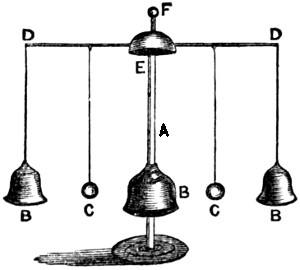
Bells may be made to ring by electricity in the following manner. Let three small bells be suspended from a brass wire, D D, and[392] supported by a glass pillar A, passing through bell B to the bell E. The electrical apparatus being attached to the knob F, the electricity passes down the wires D D to the bells, which are then positively electrified and attract the clappers C C, that are negatively so, in consequence of being insulated by the silken strings, which are not conductors. The bells therefore attract the clappers till they are charged, when they strike against the centre bell to discharge themselves, and thus a peal is rung on the bells until the electricity is driven off.
This may be shown in a variety of ways. The subjoined machine will exhibit the principle upon which many ingenious toys may be made by the young philosopher. In the figure A is a wooden board or stand, B B B B, four pillars of glass, gutta-percha, or sealing-wax, having fine wires, C C, stretched above. On these rest the rotatory wire or wheel F, having its points turned the reverse ways. By means of a chain attached to the conductor, and to the instrument at B, the electricity passes over the pillar B, up the wire C into the wheel, and off at the points, which causes it to be turned round on an inclined plane till it reaches the top.
While a person is on the electrical stool, if he be charged with much electricity,
A wooden head—not your own, but a real wooden head—with a wig of streaming hair, and a handsome face to correspond, may be made in the following form, with a wire in the neck to support it by, and fixed in the conductor of an electrical machine. When this is put in motion the hair will rise up, as in the figure, in a manner to astonish even the “big-wigs.”
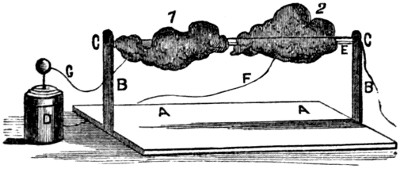
To show the manner in which thunderclouds perform their operations in the air, A A is a wooden stand, on which are erected two uprights, B B; C C are two small pulleys, over which a silken cord can pull easily; E is another silken line stretched across from one upright to another; on these silken cords two pieces of thin cardboard covered with tinfoil, and cut so as to represent clouds, are to be fixed horizontally, and made to communicate, by means of thin wires F and G, one with the inside, and the other with the outside, of a charged jar, D. Now, by pulling the loop of the silk line, the clouds will be brought near the cloud 2; continue this slowly, until the clouds (which are furnished with two small brass balls) are within an inch of each other, when a beautiful flash, strongly resembling lightning in miniature, will pass from one cloud to the other, restoring electrical equilibrium.
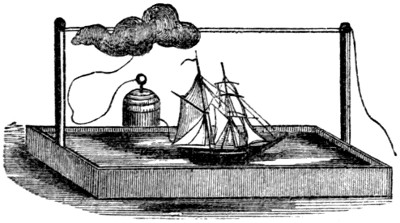
If the jar D be put behind the stand, and the cloud 2 removed, a vessel communicating by means of a wire with the outside of the jar may be swum in water under the remaining cloud; the mast being made of two pieces, and but slightly joined together, with a hollow space in one half of the mast, into which the ends of the conductor pass, but do not touch, leaving an interval of about a quarter of an[394] inch between them. The hollow is then filled with gun-cotton, and closed with cork. When the cloud is passed over the vessel, the mast will be struck and shattered to pieces. A strip of tinfoil, arranged with pins over the hollow part of the mast, will show how a continuous conductor will convey the discharge safely away.
This apparatus is capable of affording much amusement. A is a stand of wood, B is a common Leyden jar, out of which proceed the wires H H—one terminating in ball F, the other in the ball D—to which are attached a number of pith birds by silken strings; E is a shelf for the birds to rest upon; C is the sportsman; G his gun.
To put this operation in motion the Leyden jar is to be charged with electricity by affixing a chain to the bottom part of it, and connecting it with an electrical machine in the usual manner, or by applying it to a prime conductor, when the birds will fly off the knob to which they are fixed in consequence of their being repelled. If the sportsman and gun be then turned, so that the end of his gun shall touch the knob F, an electric spark will pass from one to the other, a report will be heard, and the birds will fall down as if shot, in consequence of the electricity having been taken from the Leyden jar. There should be a communication between the sportsman and the jar formed of tinfoil, or some metal, as shown by the dotted line on the stand.
Such are a few of many numerous experiments which may be made by the young experimenter, who is fond of science and has any ingenuity; but should he like to amuse himself with an electrifying machine of little cost, he may warm a sheet of brown paper, and then rub it briskly on a teatray with india-rubber; on raising the paper in a dark room, he will see many pretty electrical sparks.
The back of a black tom cat is sometimes recommended as a cheap electrical machine; but as the wishes of the animal have to be consulted, perhaps it is wiser to leave the cat alone.
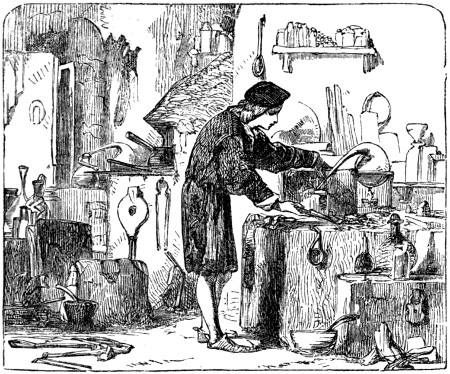
Galvanism, or electricity of quantity, in contradistinction to frictional electricity, called electricity of intensity, owes its name to the experiments on animal irritability made in 1790 by M. Galvani, a professor of anatomy at Bologna. These experiments were suggested by the following circumstances.
It happened that the wife of Galvani, who was consumptive, was advised to take as an article of food some soup made of the flesh of frogs. Several of these creatures were killed and skinned, and were lying on the table in the laboratory close to an electrical machine, with which a pupil of the professor was making experiments. While the machine was in action, he chanced to touch the bare nerve of[396] the leg of one of the frogs with the blade of the knife that he had in his hand, when suddenly the whole limb was thrown into violent convulsions. Galvani was not present when this occurred; but being informed of it, he immediately set himself to investigate the cause. He found that it was only when a spark was drawn from the prime conductor, and when the knife or any other good conductor was in contact with the nerve, that the contracting took place; and after a time he discovered that the effect was independent of the electrical machine, and might be equally well produced by making a metallic communication between the outside muscle and the crural nerve.
If the young experimenter will obtain a piece of zinc of the size of half a crown and place it on the top of his tongue, and place a half-crown underneath it, and bring the edges of the half-crown and zinc in contact in front of his tongue, he will notice a peculiar sensation in the nerves of this organ, and some taste will be imparted to his mouth at the moment of contact.
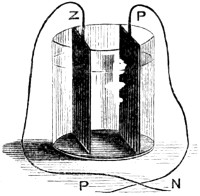
If we take two plates of different kinds of metal, platinum (or copper) and zinc, for example, and immerse them in pure water, having wires attached to them above, then if the wire of each is brought into contact in another vessel of water, a galvanic circle will be formed, the water will be slowly decomposed, its oxygen will be fixed on the zinc wire, and at the same time a current of electricity will be transmitted through the liquid to the platina or copper wire, on the end of which the other element of water, namely, the hydrogen, will make its appearance in the form of minute gas bubbles. The electrical current passes back again into the zinc at the points of its contact with the platina, and thus a continued current is kept up, and hence it is called a galvanic circle. The moment the circuit is broken by separating the wires the current ceases, but is again renewed by making them touch either in or out of the water. If a small quantity of sulphuric acid be added to the water, the phenomenon will be more apparent. The end of the wire attached to the piece of platinum or copper is called the positive pole of the battery, and that of the wire attached to the zinc the negative pole.
The current of electricity here generated will be extremely feeble; but this can be easily increased by multiplying the glasses and the[397] number of the pieces of metal. If we take six such glasses instead of one, partially fill them with dilute sulphuric acid, and put a piece of zinc and copper into each, connecting them by means of copper wire from glass to glass through the whole series, a stronger current of electricity will be the result. The experimenter must be careful not to let the wire and zinc touch each other at the bottom of the tumblers, and must also remember that the copper of glass 1 is connected with the zinc of glass 2, and so on.

To effect this, make a connexion between the poles of the above or any excited battery with the two ends of a wire formed into a spiral coil, by bending common bonnet-wire closely round a cylinder, or tube, of about an inch in diameter; into this coil introduce a needle or piece of steel wire, laying it lengthways down the circles of the coil. In a few minutes after the electric fluid has passed through the spiral wire, and consequently round the needle or wire, the latter will be found to be strongly magnetized, and to possess all the properties of a magnet.
If a galvanic current, or any electric current, be made to pass along a wire under which, and in a line with it, a compass is placed, it will be found that the needle will no longer point north and south, but will take a direction nearly across the current, and point almost east and west.
Put a teaspoonful of sulphate of soda into a cup, and dissolve it in hot water; pour a little cabbage blue into the solution, and put a portion into two glasses, connecting them by a piece of linen or cotton cloth previously moistened in the same solution. On putting one of the wires of the galvanic pole into each glass, the acid accumulates in the one, turning the blue to a red, and the alkali in the other, rendering it green. If the wires be now reversed, the acid accumulates eventually in the glass where the alkali appeared, while the alkali passes to the glass where the acid was.
If the ends of the wires of a small galvanic battery are connected with a proper electro-magnetic coil, which may now be purchased at a very cheap rate, and the wires from the coil be placed in separate basins of water, then, on dipping the fingers of each hand in the basin, a smart shock will be felt, with a particular aching accompanied with trembling. With a strong battery and larger coil this effect is felt as high as the shoulders. The shock will also be felt by simply holding the wires of a powerful galvanic battery, one in each hand, provided the hands be moistened with salt and water. Several persons may receive the shock from the battery and coil together by joining hands.
The electro-galvanic current has in no case been more interestingly employed than in the process of electrotyping. It consists of a mode of obtaining the copy of coins, medals, engraved plates, and other objects, which may be easily illustrated.
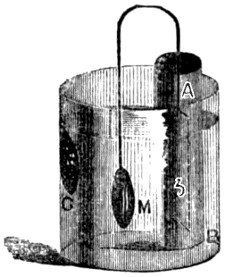
Take an earthen jar and a porous tube; fill the tube with ten parts of water and one of sulphuric acid; put it into the jar, into which pour as much of a solution of sulphate of copper (blue vitriol) as will fill three parts of it; place in the tube a piece of zinc, to which a copper wire is soldered and bent round, so that one end be immersed in the sulphate of copper; and a deposit of the copper will be immediately formed upon the wire. If there be plenty of acid and water, so as to allow of the action enduring for a long time, this process will go on till it has deposited all the copper. This is the principle upon which electrotyping proceeds,—a principle referable to electro-chemical decomposition.
The diagram represents an outer vessel of wood, glass, or earthenware, capable of holding a pint of liquid, within which there is suspended a short lamp-glass A, the one end being open, and the other, B, closed with a diaphragm of plaster of Paris; C is a small bag of crystals of sulphate of copper, to keep up the strength of the solution; Z is the zinc, and M the metal.
Never place the original medal in the apparatus, or the deposited copper may adhere so tightly to it that the removal destroys the beauty of the medal. Having taken an impression in sealing-wax, cover the latter with black-lead, and attach a wire so that it is in contact with the black-lead. To the wire and cast thus arranged a piece of sheet or cast zinc, amalgamated with mercury, must be attached, and we are at once furnished with the materials for the battery, as the object to be copied supplies the place of the copper. The medal must always be placed horizontally. Now let the apparatus be charged with the solution, by pouring into the outer vessel a portion of the coppery solution, so that it will stand about an inch above the medal; then pour in the glass the dilute acid to the same height as the former; now introduce the zinc into the acid, and the object to be copied into the solution of copper, which will immediately be deposited on the medal, and when of a sufficient thickness may be taken off.
The chief agent in causing the repulsion or separation of the particles of bodies from each other is heat, or more correctly caloric, by which is understood the unknown cause of the effect called heat. Philosophers are not agreed upon the nature of this wonderful agent. It pervades all nature, is the cause of nearly all the changes that take place both in organic and inorganic matter, and has great influence in the meteorological phenomena which we observe in the atmosphere that surrounds our planet. It appears to be intimately connected with light, electricity, and magnetism,—subjects which the genius of Faraday and others have investigated, and by their discoveries brought us nearer to the knowledge of the real nature of these most wonderful forces.
Caloric, then, exists in all bodies, and has a constant tendency to equalize itself, as far at least as its outward manifestation, called temperature,[400] is concerned; for if a hot body be brought near colder ones, it will give up heat to them, until by its loss and their gain they all become of the same temperature; and this proceeds more or less rapidly, according as the original difference of temperature was greater or less. Some other circumstances also influence this equalization. The converse will take place on introducing a cold body among warmer ones, when heat will be abstracted from all the bodies within reach of its influence, until it has absorbed sufficient caloric to bring its own temperature to an equality with theirs. This is the true explanation of the apparent production of cold. When, for instance, an iceberg comes across a ship’s course, it appears to give out cold, whereas, it has abstracted the heat from the air and sea in its neighbourhood, and they in turn act upon the ship and everything in it, until one common temperature is produced in all the neighbouring bodies.
It does not follow that the bodies thus equalized in temperature contain equal quantities of caloric; far from it. Each body requires a particular quantity of caloric to raise its temperature through a certain number of degrees; and such quantity is called its specific caloric. A pound of water, for instance, will take just twice as much caloric as a pound of olive oil, to raise its temperature through the same number of degrees; the specific caloric of water is therefore double that of oil. Mix any quantity of oil at 60° of temperature with an equal weight of water at 90°, and you will find the temperature of the mixture to be nearly 80°, instead of only 74° or 75°, showing that while the water has lost only 10° of caloric, the mixture has risen 20°. If the oil be at 90°, and the water at 60°, the resulting temperature will be only 70°, or thereabouts, instead of 75°, the mean; thus, here the hot oil has lost 20°, while the mixture has risen only 10°; the water, then, contains at the same temperature twice as much caloric as the oil; its specific caloric is double that of the oil. This mean temperature does result when equal weights of the same body at different temperatures are mixed together.
The sensations called heat and cold are by no means accurate measures of the real temperature of any substances, for many causes influence these sensations, some belonging to the substances themselves, others to the state of our organs at the time. Every one has remarked that metals in a warm room feel warmer, and in a cold room colder than wooden articles, and these again than woollen or cotton articles of dress or furniture; this arises from metals being what is termed better conductors of heat than wood, and this better than wool, &c., that is, they give out or absorb caloric more rapidly than these last. Some philosophers, wishing to ascertain how much heat the human body could endure, had a room heated with stoves, every crevice being carefully stopped, until the temperature rose so high that a beefsteak placed on the table was sufficiently cooked to be eaten. They were dressed in flannel, and could with impunity touch[401] the carpets, curtains, &c., in the room; but the iron handles, fire-irons, and all metallic substances, burnt their fingers; and one who wore silver spectacles was obliged to remove them to save his nose. The fallacy of our sensations may be easily shown by taking two basins, placing in one some water at 100°, in another some water at as low a temperature as can easily be procured—hold the right hand in one, the left in the other, for a few minutes, and then mix them, and place both hands in the mixture; it will feel quite cold to the hand that had been in the hotter water, and hot to the other.
In order to arrive at a correct estimate of the temperature of bodies, instruments are made use of called thermometers, or measurers of heat, which show increase or diminution of temperature by the rising or falling of a column of some fluid in a tube of glass, one end of which is expanded into a bulb, and the other hermetically sealed. This effect is produced by the expansion or swelling of the fluid as caloric is added to, and its contraction when caloric is abstracted from it. Coloured spirits of wine, or quicksilver, are the most usual thermometric fluids, and the tube containing them is fixed to a wooden or metallic frame, on which certain divisions are marked, called degrees.
That in general use in England is called Fahrenheit’s, from the name of the person who first introduced that particular scale. In this thermometer, the point at which the mercury in the tube stands when plunged into melting ice, is marked 32°, and the distance between that point, and the point to which the mercury rises in boiling water, is divided into 180 equal parts, called degrees; so that water is said to boil at 212° = 180° + 32°. There are two other scales of temperature used in different parts of the world, but it is not worth while to notice them here.
Not only do different bodies at the same degree of temperature contain very different quantities of caloric, but this also is the case with the same body in different forms. Ice, water, and steam, are three forms of the same body, but ice at 32° contains much less caloric than water at the same temperature, and water at 212° contains much less caloric than steam (or water in a state of vapour) at that temperature.
Place in a jar any given quantity of snow, or small pieces of ice, at 32°, and in another the same weight of water at 32°, pour on each an equal weight of water at 172°, and you will find that in the first case the ice will be melted, but the temperature will remain at 32° or thereabouts, while the temperature of the water in the other vessel will have risen to 100° or thereabouts, being as near as possible the half of the excess of the temperature of the hot water, 140° over that of the cold, namely 70° added to 32°, the original temperature. Now, what has become of the heat which was added to the ice, and is apparently lost?—it is absorbed by the ice in its passage to the fluid state; so that water may be said to be a compound of ice and caloric.
Again, take 10 ounces of water at about 50°, and add 1 oz. of water at 212°, and the temperature of the mixture will be about 66°; then condense some steam at 212°, into another 10 oz. of water until it has become 11 oz., and you will find the temperature will be nearly 212°. Why does the ounce of steam at 212° raise the temperature of the water so much higher than the ounce of water at the same temperature? Obviously because it contains hidden in its substance a vast quantity of caloric, not to be detected by the thermometer; in fact, that steam is a compound of water and caloric, as water is a compound of ice and caloric; and this caloric which exists, more or less, in all bodies without producing any obvious effect, is called latent caloric, from the Latin verb lateo, to lie hid. The quantity of caloric thus absorbed as it were by various bodies, differs for each body, and for the same body in different forms, as mentioned above.
As a general rule, all bodies, whether solid, liquid, or gaseous, are expanded by caloric. This may be shown by experiments in each form of matter.
Have a small iron rod made, which when cold just passes through a hole in a plate of metal; heat it, and it will no longer pass; after a time the rod will return to its former temperature, and then will go through the hole as before. The rod increases in length as well as width; if you have a gauge divided into 1/100 of an inch, and place the rod in it when cold, noting its position, on heating it will extend to a greater length in the gauge, returning to its former place when cool.
The effect of caloric in causing fluids to expand is actually employed as a measure of quantity in the thermometer, the rise of the fluid in the tube when heated depending on the increased bulk of the fluid occasioned by the addition of caloric. The same fact is to be noticed every day when the cook fills the kettle, and places it on the fire. As the water becomes warmer it expands, that is, takes up more room than it did before, and the water escapes by slow degrees, increasing as the heat increases, up to the point of boiling, when a sudden commotion takes place from the condensation of a portion of the water into steam.
But it is in the form of vapour or gas, (which by the bye is not the same thing,[9]) that the expansive force of caloric is most obvious. The gigantic powers of the steam-engine depend entirely on the tendency of vapour to expand on the addition of caloric; and this force of[403] expansion appears to have no limit; boilers made of iron plates an inch or even more in thickness, and the buildings or ships containing them, having been torn to pieces and scattered in all directions by the expansive power of steam. Take a bladder, and fill it about half full of air, and tie the neck securely; upon holding it to the fire it will swell out, and become quite tense from the expansion of the contained air.
[9] It may be well to state here, that by vapour is generally understood the aërial form of a substance usually existing in a solid or fluid form at ordinary temperatures; as the vapour of iodine, a solid; of mercury, water, spirits, and other fluids: while the term gas is applied to those bodies usually known in the aërial state; thus oxygen, nitrogen, carbonic acid, hydrogen, &c. &c., are called gases. It is, however, but an arbitrary distinction; for many of these gases have, by the combined influence of cold and powerful pressure, been converted into fluids, and even solids—carbonic acid gas for instance!
The principal source of caloric is the sun, whose beams, diffused through all nature by the refractive property of the atmosphere, are the source of vitality both to vegetables and animals, and when concentrated by a large convex lens, produce the most intense heat, sufficient to light a piece of diamond, and melt platinum. Caloric is also produced or evolved by combustion, by friction, percussion, chemical combination, electricity, and galvanism.
The evolution of heat by friction may be witnessed daily in a thousand instances. Lucifer matches are lighted by rubbing the highly inflammable substances with which they are tipped against a piece of sand-paper. Nearly all savage people procure fire by rubbing a piece of hard wood violently against a softer piece. The axle-trees of steam-engines, and even of carriages, have been known to be so heated by friction as to endanger burning the carriage; and it is very usual to be obliged to pour a quantity of cold water on the iron axle of the carriages of an express train after an hour of constant and rapid work. If you merely rub the blade of a knife rapidly on a piece of wood, it will become hot enough to burn your hand.
Percussion is merely a more energetic kind of friction, and is often resorted to by the blacksmith to light his furnace. He places a nail or other piece of soft iron on his anvil, and beats it rapidly with the hammer, when it becomes actually red hot. The production of sparks by striking flint against steel, or two pieces of flint one against the other, are familiar instances of heat produced by percussion.
One of the most powerful means of producing heat is the process of combustion.
Combustion, as the word imports, is the burning together of two or more substances, a chemical union of oxygen generally with carbon and hydrogen in some shape or other. In our ordinary fires we burn coal, a hydro-carbon as it is called; and the gas which is now so universally used for the purpose of illumination, is a compound of the same bodies—so wax, tallow, oil of various kinds, both of animal and vegetable origin, are all hydro-carbons.
On the application of a sufficient heat, and a free access of atmospheric air, or of some other gas containing oxygen in a certain state of combination, these bodies take fire, and continue to burn either with flame, or a red or even white heat without flame, until they are consumed; that is, until they have entered into new combinations with the oxygen, and are converted into carbonic acid and water, the carbon forming the first product, the hydrogen the other.
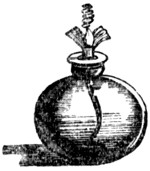
The following experiment shows the production of heat by chemical action alone. Bruise some fresh prepared crystals of nitrate of copper, spread them over a piece of tin-foil, sprinkle them with a little water; then fold up the foil tightly as rapidly as possible, and in a minute or two it will become red-hot, the tin apparently burning away. This heat is produced by the energetic action of the tin on the nitrate of copper, taking away its oxygen in order to unite with the nitric acid, for which, as well as for the oxygen, the tin has a much greater affinity than the copper has.
Combustion without flame may be shown in a very elegant and agreeable manner, by making a coil of platinum wire by twisting it round the stem of a tobacco-pipe, or any cylindrical body, for a dozen times or so, leaving about an inch straight, which should be inserted into the wick of a spirit-lamp; light the lamp, and after it has burnt for a minute or two extinguish the flame quickly; the wire will soon become red hot, and, if kept from draughts of air, will continue to burn until all the spirit is consumed. Spongy platinum, as it is called, answers rather better than wire, and has been employed in the formation of fumigators for the drawing-room, in which, instead of pure spirit, some perfume, such as lavender water, is used; by its combustion an agreeable odour is diffused through the apartment. These little lamps were much in vogue a few years ago, but are now nearly out of fashion.
Experiments on combustion might be multiplied almost to any amount, but the above will be sufficient for the present. When we come to treat of the properties of the gases and some other substances, we shall have occasion to recur to this subject.
The production of caloric by chemical combination may be exhibited by mixing carefully one part of oil of vitriol with two of water, when sufficient heat will be produced to boil some water in a thin and narrow tube, which may be used as a rod to stir the mixture.
The production of heat by electric and galvanic agency belongs to another subject. I will content myself with saying here, that these forces afford the most powerful aid in decomposing and uniting various bodies, and that it was by the immense power of a battery of 2,000 pairs of plates, belonging to the Royal Institution in London, that Sir H. Davy discovered the metallic bases of the alkalies and earths.
The science of Hydraulics comprehends the laws which regulate non-elastic fluids in motion, and especially water, &c.
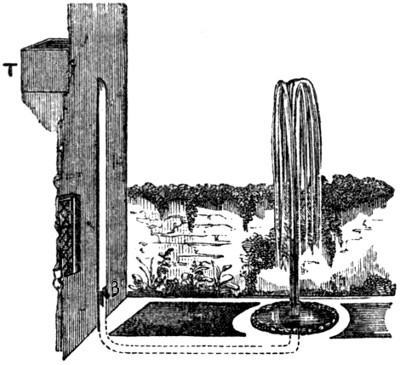
Water can only be set in motion by two causes—the pressure of[405] the atmosphere, or its own gravity. The principal law concerning fluids is, that they always preserve their own level. Hence water can be distributed over a town from any reservoir that is higher than the houses to be supplied; and the same principle will enable us to form fountains in a garden, or other place. Should any of our young friends wish to form a fountain, or jet d’eau, they may, by bringing a pipe from T, a water-tank, which should be at the upper part of the house, convey the water down to the garden. Then by leading it through the earth, underneath the path or grass-plot, and turning it to a perpendicular position, the water will spring out, and rise nearly as high as the level of that in the tank. The part of the pipe at B should have a turnkey, so that the water may be let on or shut off at pleasure.
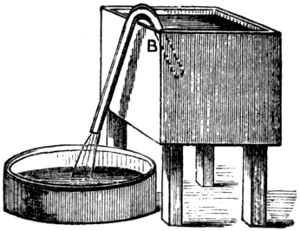
The syphon B is a bent tube, having one leg shorter than the other. It acts by the pressure of the atmosphere. In order to make a syphon act, it is necessary first to fill both legs quite full of the fluid; and then the shorter leg must be placed in the vessel to be emptied. Immediately upon withdrawing the finger from the longer leg, the liquor will flow. Any young person may form a syphon by a small piece of leaden pipe, bent into the form above.
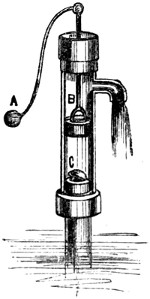
The action of the common pump is as follows: When the handle A is raised, the piston-rod B descends, and brings the piston-valve, called the sucker, or bucket, to another valve, C, which is fixed, and[406] opens inwards towards the piston. When the handle is drawn down, the piston is raised, and, as it is air-tight, a vacuum is produced between the two valves; the air in the barrel of the pump, betwixt the lower valve and the water, then forces open the lower valve, and rushes through to fill up this vacuum; and the air in the pump being less dense than the external atmosphere, the water is forced a short way up the barrel. When the piston again descends to the lower valve, the air between them is again forced out by forcing open the upper valve; and when the piston is raised, a vacuum is again produced, and the air below the lower valve rushes up, and the water in consequence is again raised a little further. This operation continues until the water rises above the lower valve; at every stroke afterwards, the water passes through the valve of the descending piston, and is raised by it, on its ascent, until it issues out of the spout.

Make a little figure of cork, in the shape of a dancing mountebank, sailor, &c. In this figure place a small hollow cone, made of thin leaf brass. When this figure is placed upon any jet d’eau, such as that of the fountain recommended to be constructed, it will be suspended on the top of the water, and perform a great variety of amusing motions. If a hollow ball of very thin copper, of an inch in diameter, be placed on a similar jet, it[407] will remain suspended, turning round and spreading the water all about it.
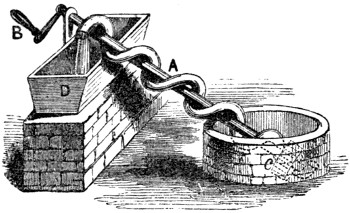
may easily be constructed. Purchase a yard of small leaden pipe, and twist it round a pole, as in the following figure, A; place a handle at its upper end, B, and let its lower end rest in the water. Between the last turn of the pipe and the orifice place a paddle-wheel, C. Now, should the water be that of a running stream, the force of the stream will turn the pipe, and the water will rise in it till it empties itself into the trough at D. Should the water have no motion, the turning of the handle at B will elevate the water from the lower to the higher level.

The attractive power of the loadstone has been known from a very remote period. The natural magnet appears native in a grey iron ore in octahedral crystals, composed of 168 parts of iron, and 64 parts of oxygen, Fe3O4. Its properties seem to have been studied in Europe during the dark ages, and a directive power is alluded to by Cardinal James de Vitri, who flourished about the year 1200, who observed, that it was indispensable to those who travel much by sea.
In modern times, the history as well as the nature of the magnet has engaged remarkable attention; and it has been determined beyond all dispute that the magnet was used by the Chinese under the name of the tche-chy (directing-stone) about 2604 years before Christ. It passed from them to the Arabs, and was first used in Europe after the Crusades; and Ludi Vestomanus asserts, that about the year 1500 he saw a pilot in the East Indies direct his course by a magnetic needle like those now in use.
The most remarkable theories have been invented to account for the phenomena of magnetism. Halley imagined magnetic globes to be moving to and fro in the interior of the earth. Barlow’s theory,[409] which refers the whole to electrical currents, is the most rational. Dr. Faraday, for whose kindness to us in early days we always feel grateful, in a series of very curious experiments, has succeeded in identifying magnetism with galvanism, by directing galvanic currents at right angles to the direction of powerful magnets. And its connexion with this and the common species of electricity has deprived it of all its conjuring powers, and reduced it to the well-defined action of electrical bodies.
It is not for us to write either a history of this interesting subject, or to treat it as a science to be acquired; but as it embodies a great number of most instructive and amusing experiments, we think it proper to introduce it here.
This may be done by stroking a piece of hard steel with a natural or artificial magnet. Take a common sewing-needle and pass the north pole of a magnet from the eye to the point, pressing it gently in so doing. After reaching the end of the needle the magnet must not be passed back again towards the eye, but must be lifted up and applied again to that end, the friction being always in the same direction. After repeating this for a few times the needle will become magnetised, and attract iron filings, &c.
Hold it in the left hand in a position slightly inclined from the perpendicular, the lower end pointing to the north, and then strike it smartly several times with a large iron hammer, and it will be found to possess the powers of a magnet, although but slightly.
Suspend two short pieces of iron wire, N S, N S, so that they will hang in contact in a vertical position. If the north pole of a magnet N be now brought to a moderate distance between the wires, they will recede from each other, as in figure 1.
The ends S S being made south poles by induction from the north[410] pole N, will repel each other, and so will the north poles N N. This separation of the wires will increase as the magnet approaches them, but there will be a particular distance at which the attractive force of N overcomes the repulsive force of the poles S S, and causes the wires to converge, as in figure 2; the north poles N N still exhibiting their mutual repulsion.
Each magnet has its poles, north and south—the north or south poles of one magnet, repel the north and south pole of another. If a magnet, as in the following figure, be dipped in some iron filings, they will be immediately attracted to one end. Supposing this to be the north pole, each of the ends of the filings, not in contact with the magnet, will become north poles, while the ends in contact will by induction become south poles. Both will have a tendency to repel each other, and the filings will stand on the magnet as in the figure.
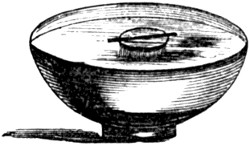
The best method of proving this is to take a magnet or a piece of steel rendered magnetic, and to place it on a piece of cork by laying it in a groove cut to receive it. If the cork be placed in the centre of a basin of water, and allowed to swim freely on its surface, so that it is not attracted by the sides of the basin, it will be found to turn its north pole to the north, and its south pole to the south, the same as the mariner’s compass. If you fix two magnets in two pieces of cork, and place them also in a basin of water, and they are in a parallel position with the same poles together, that is, north to north, and south to south, they will mutually repel each other; but if the contrary poles point to one another, as north to south, they will be attracted.
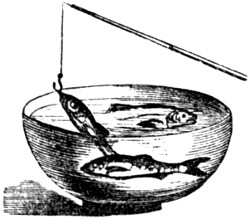
Fish are to be purchased at the toy-shops, by which the young “magnétique” may perform this experiment; they are made hollow, and will float on the water. In the mouth of each should be inserted a piece of magnetic wire. The angling rod is like any other rod, and has a silken thread for a line, and an iron hook also strongly magnetised. To catch the fish it is only necessary to put[411] the hook in contact with the noses of the fish, and they will be taken without any of the baits mentioned in the former part of this work.
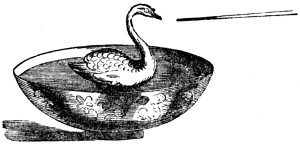
The figure of a swan should be cut in cork, and within its beak a small strongly magnetised piece of steel should be placed. The swan should then be covered with a coating of white wax, and fashioned further into the shape of a swan, and glass beads may be placed in its head for eyes. This should be placed in a small tub or large basin of water, and to make it swim about, you should place in a white stick about nine inches long a magnetic bar, on which the north and south poles are marked. If you wish to bring the swan towards you, present to him the north pole of the wand, if you wish it to retire, present the south pole, and thus you may direct the swan to any part you desire.
Place a magnet on a stand to raise it a little above the table; then bring a small sewing-needle containing a thread, within a little of the magnet, keeping hold of the thread to prevent the needle from attaching itself to the magnet. The needle in endeavouring to fly to the magnet, and being prevented by the thread, will remain curiously suspended in the air, reminding us of the fable of Mahomed’s coffin.

Take an iron poker and tongs, or two bars of iron, the larger and the older the better, and fixing the poker upright, hold to it with the left hand near the top P by a silk thread, a bar of soft steel about three inches long, one fourth of an inch broad, and one twentieth thick; mark one end, and let this end be downwards. Then grasping the tongs T with the right hand a little below the middle, and keeping them nearly in a vertical line, let the bar B be rubbed with the lower end L of the tongs, from the marked end of the bar to its upper end about ten times of each side of it. By this means the bar B will[412] receive as much magnetism as will enable it to lift a small key at the marked end; and this end of the bar being suspended by its middle, or made to rest on a joint, will turn to the north, and is called its north pole, the unmarked end being the south pole. This is the method recommended by Mr. Caxton, in his process, which he regarded superior to those in former use, and of which a more detailed account will be found in his interesting volume.
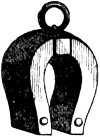
The form of a horse-shoe is generally given to magnetised bars, when both poles are wanted to act together, which frequently happens in various experiments, such as for lifting weights by the force of magnetic attraction, and for magnetising steel bars by the process of double touch, for which they are exceedingly convenient. The following is the method of making a powerful magnetic battery of the horse-shoe form. Twelve bars or plates of steel are to be taken, and having been previously bent to the required form, that is, the horse-shoe shape, they are then bound together by means of rivets at their ends; before being finally fastened they are each separately magnetised, and afterwards finally united.
Horse-shoe magnets should have a short bar of soft iron adapted to connect the two poles, and should never be laid by without such a piece of iron adhering to them. Bar magnets should be kept in pairs with their poles turned in contrary directions, and they should be kept from rust. Both kinds of magnets have their power not only preserved but increased, by keeping them surrounded with a mass of dry filings of soft iron, each particle of which will re-act by its induced magnetism upon the point of the magnet to which it adheres, and maintain in that point its primitive magnetic state.
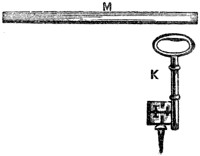
Let M be a magnet and K a key, held horizontally near one of its poles, or near its lower edge. Then if another piece of iron, such as a small nail, be applied to the other end of the key, the nail will hang from the key, and will continue to do so while the magnet is slowly withdrawn; but when it has been removed beyond a certain distance, the nail will drop from the key, because the magnetism induced in[413] the key becomes at that distance too weak to support the weight of the nail. That this is the real cause of its falling off may be proved by taking a still lighter fragment of iron, such as a piece of very slender wire, and applying it to the key. The magnetism of the key will still be sufficiently strong to support the wire, though it cannot the nail, and it will continue to support it even when the magnet is yet further removed; at length, however, it drops off.
The identity of magnetism with electricity alluded to in a former paragraph, has led to the formation of a new science under the above name, and to some of the interesting experiments connected with it, we shall briefly allude for the amusement of the young reader.
The same influence which affects the magnetic needle already described, will also communicate magnetism to soft iron. If a bar of that metal bent, as in the drawing, be surrounded with a common bonnet wire, or a copper wire prevented from touching the iron by a winding of cotton or thread, and then if a current of voltaic electricity be sent through the wire, the bar becomes a powerful magnet, and will continue so as long as the connexion with the battery is preserved. On breaking the contact, the magnetism disappears. This experiment may be easily made by the young reader with a horse-shoe magnet, surrounded by several coils of wire. P is the positive, and N the negative pole.
The mariner’s compass is an artificial magnet fitted in a proper box, and consists of three parts—1, the box; 2, the card or fly; and 3, the needle. The box is suspended in a square wooden case, by means of two concentric brass circles called gimbals, so fixed by brazen axes to the two boxes, that the inner one, or compass-box, retains a horizontal position in all motions of the ship. The card is a circular piece of paper which is fastened upon the needle, and moves with it.[414] The outer edge of the card is divided into thirty-two points, as shown in the engraving, called points of the compass. The needle is a slender bar of hardened steel, having a hollow agate cup in the centre, which moves upon the point of a pivot made of brass.
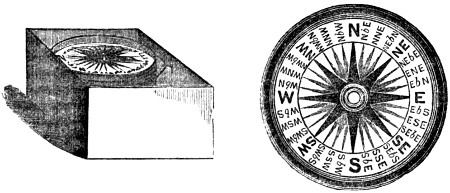
The magnetic needle does not point exactly north and south, but the north pole of the needle takes a direction to the west of the true north. It is constantly changing, and varies at different parts of the earth, and at different times of the day.
Another remarkable and evident manifestation of the influence of the magnetism of the earth upon the needle is the inclination or dip of the latter, which is a deviation from its horizontal place in a downward direction in northern regions of its north, and in southern regions of its south pole. In balancing the needle on the card, on account of this dipping, a small weight or moveable piece of brass is placed on one end of the needle, by the shifting of which either nearer to or further from the centre, the needle will always be balanced.
Pocket compasses are to be bought for five or six shillings, and may be used in many ways. In travelling over mountains or a wide extended moor, they are indispensably necessary; and no one should go a tour into Wales, Scotland, or the lakes without such a companion, and it will be a very useful and amusing exercise for any young person to take the bearings of his own or some particular locality, and make out what may be called a bearing card. This he may easily do in the following manner. Supposing he wishes, for instance, to take the bearings of his own house, he has nothing to do but to set his pocket compass upon a map of the district,—a county map will do very[415] well, unless his house stands on the verge of a county, then two county maps will be necessary. He must make the north of the map exactly coincide with the north, as indicated by his compass, and having fixed his map in this situation, he should take a ruler and piece of paper, and dot down the exact bearings of each important town, or place, or village, around him. Let him suppose himself, for instance, in the town of Cambridge, and laying down his map as indicated by the compass, north to north and south to south, he will find the following places due north, Wilberton, Wentworth; Little Wilbraham, Teversham, due east; Duxford and Chesterfield, south; Coton and St. Neots in Huntingdonshire, west. The other points of the compass may be filled up in the same manner. Should therefore our young friend be upon any elevated situation near his own dwelling, or upon any other elevated spot from which the bearings have been taken, he will be able to inform his young friends that such and such a place lies in such a direction, that this place lies due north, the other north-west, a third south-east, the fourth south-west, &c. &c.
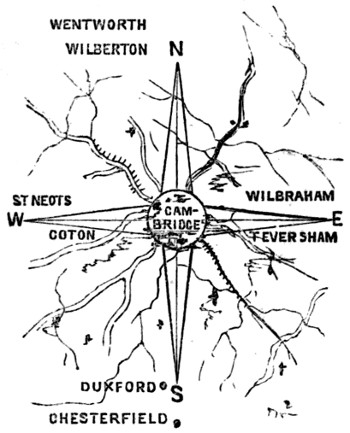
Fire-irons which have rested in an upright position in a room during the summer months are often highly magnetic.
Iron bars standing erect, such as the gratings of a prison cell, or the iron railings before houses, are often magnetic.
The great iron-clad ships, which have now replaced the wooden walls of Old England, are powerfully magnetic, and therefore affect the compass by which the vessel is steered; ingenious arrangements are therefore made to correct the effect of the local attraction, so that the man-of-war may be steered correctly.
Magnetism may be made to pass through a deal board; to exhibit which, lay a needle on the smooth part above, and run a magnet along the under side, and the needle will be found to follow the course of the magnet. A magnet dipped into boiling water loses part of its magnetism, which however returns upon its cooling.
A sudden blow given to a magnet often destroys its magnetic power.
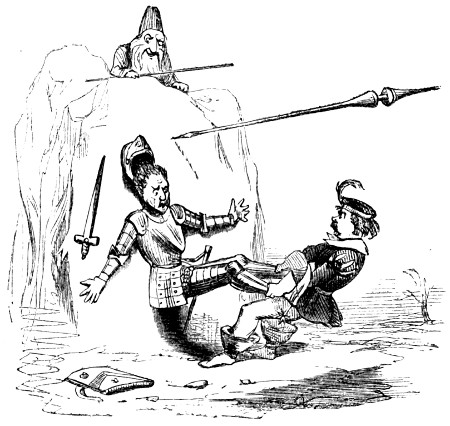
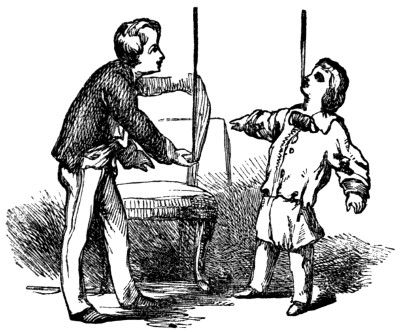
There is no subject of such importance as Mechanics, as its principles are founded upon the properties of matter and the laws of motion; and in knowing something of these, the tyro will lay the foundation of all substantial knowledge.
The properties of matter are the following: Solidity (or Impenetrability), Divisibility, Mobility, Elasticity, Brittleness, Malleability, Ductility, and Tenacity.
The laws of motion are as follow:—
1. Every body continues in a state of rest or of uniform rectilineal motion, unless affected by some extraneous force.
2. The change of motion is always proportionate to the impelling force.
3. Action and reaction are always equal and contrary.
In shooting at “taw,” if the marble be struck “plump,” as it is called, it moves forward exactly in the same line of direction; but if struck sideways, it will move in an oblique direction, and its course will be in a line situated between the direction of its former motion and that of the force impressed. This is called the resolution of forces.
The centre of gravity in a body is that part about which all the other parts equally balance each other. In balancing a stick upon the finger, or upon the chin, it is necessary only to keep the chin or finger exactly under the point which is called the centre of gravity.
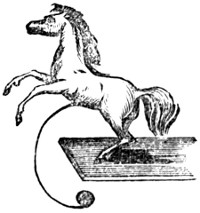
Cut out the figure of a horse, and having fixed a curved iron wire to the under part of its body, place a small ball of lead upon it. Place the hind legs of the horse on the table, and it will rock to and fro. If the ball be removed, the horse would immediately tumble, because unsupported, the centre of gravity being in the front of the prop; but upon the ball being replaced, the centre of gravity immediately changes its position, and is brought under the prop, and the horse is again in equilibrio.
The feet of the figure rest on a curved pivot, which is sustained by two loaded balls below; for the weight of these balls being much greater than that of the figure, their effect is to bring the centre of gravity of the whole beneath the point on which it rests; consequently the equilibrium will resist any slight force to disturb it.
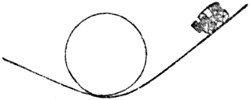
It is pretty well known to most boys, that if a tumbler of water be placed within a broad wooden hoop, the whole may be whirled round without falling, owing to the centrifugal force. On the same principle, if a small carriage be placed on an iron band or rail, it will ascend the curve, become inverted, and descend again, without falling.

Procure a coffee-canister, and loading it at F with a piece of lead, which may be fixed in with solder, the position of the centre of gravity is thus altered. If a cylinder so constructed be placed on an[419] inclined plane, and the loaded part above, it will roll up-hill without assistance.
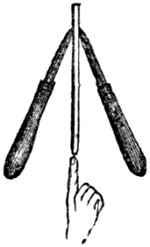
Procure a piece of wood, about nine inches in length and about half an inch in thickness, and thrust into its upper end the blades of two penknives, on either side one. Place the other end upon the tip of the fore-finger, and it will keep its place without falling.
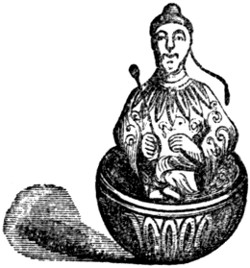
Construct out of the pith of the elder a little mandarin; then provide a base for it to sit in, like a kettle-drum. Into this put some heavy substance, such as half a leaden bullet; fasten the figure to this, and in whatever position it may be placed, it will, when left to itself, immediately return to its upright position.
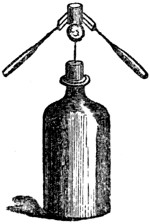
Take a bottle, with a cork in its neck, and place in it, in a perpendicular position, a middle-sized needle. Fix a shilling into another cork, by cutting a nick in it; and stick into the same cork two small table-forks, opposite each other, with the handles inclining outwards and downwards. If the rim of the shilling be now poised on the point of the needle, it may easily be made to spin round without falling, as the centre of gravity is below the centre of suspension.
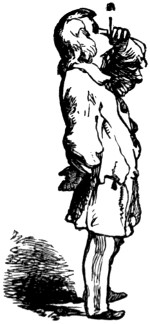
If you stick through a pea, or small ball of pith, two pins at right angles, and defend the points with pieces of sealingwax, it may be kept in equilibrio at a short distance from the end of a straight tube, by means of a current of breath from the mouth, which imparts a rotatory motion to the pea.[10]
[10] The pins are only used to hold the pea steady before it is blown from the pipe, as the pea alone will dance quite as well.
Cut a piece of pasteboard into the following shape, and describe[421] on it a spiral line; cut this out with a penknife, and then suspend it on a large skewer or pin, as seen in the engraving. If the whole be now placed on a warm stove, or over the flame of a candle or lamp, it will revolve with considerable velocity. The card, after being cut into the spiral, may be made to represent a snake or dragon, and when in motion will produce a very pleasing effect.
Place three glasses, A A A, in the form of a triangle, and arrange three knives upon them, as shown in the figure,—the blade of No. 1 over that of No. 2, and that over No. 3, which rests on No. 1. The bridge so made will be self-supported.
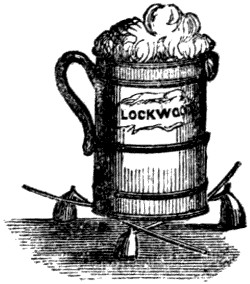
Place three tobacco-pipes in the position shown in the engraving, the mouth of the bowls downwards, and the lower end of the stems upon the stem just by the bowls. This tripod, if carefully put together, will support considerably more than a pot of “Lockwood’s home-brewed,” equally celebrated with the trick.
At any time of the year or hour of the day there are few pursuits more interesting, and at the same time instructive, than the study of Nature by means of the microscope.
This instrument has revolutionized science, solved many problems that had wearied the souls of older naturalists, and even in its simplest form is beyond all value to those who love Nature and the objects which they see around them. The microscope opens a new world to us. When the first telescope was directed to the heavens, and unlocked the mysteries of the skies, when it crumbled into dust all the theories of the past centuries, and told mankind that the planets were not merely instruments of fortune-telling, whose voices were intelligible to a chosen few, but orbs far vaster than our own; even then the new world of thought into which man entered was no wider than that which is displayed by the poorest lens that possesses the power of magnifying.
All of us must admire the more than awful grandeur of that universe whereof we form so infinitesimal a part, wherein the stars are scattered as the sand on the sea-shore, and every star a sun, the centre of a system of orbs too distant for the eye of man to perceive. Looking at our nearest planet, and observing on her face vast mountain-chains, ravines into which the light of the sun can never penetrate, and volcanoes whose craters are so wide that they would take in the whole of London, the whole of Birmingham, and all the country between them, we can judge by analogy of the unseen wonders which must exist in the world beyond our ken.
But to him who can read Nature rightly, the microscope is a teacher as grand as its sister instrument, and the awful magnificence of Nature is as evident in a midge’s wing as in the more patent glories of the sun, moon, and stars. In the following pages we hope to put the readers of this book in the way to read their microscope rightly—possibly to make it—and to show that much can be done with small means when “there’s a will,” and to indicate to them that objects of no small interest can be found without stirring from the room in which we sit, or even from the table on which our microscope is placed.
Some of our readers may say, when they read the heading of this paper, that they should like a microscope very much, but that they have no money to buy it, and that their parents cannot afford one.
This is just the feeling which we used to have when a boy, for in those days microscopes were microscopes indeed, and you had your choice between a little instrument, with a series of brass cups, having glasses in them, which magnified slightly but defined clearly, or a great composition of brass and iron, looking like a rocket-tube, with an eye-piece at one end and a glass shot at the other. In was very costly, very imposing, and magnified very highly; but it strained the eyes painfully, had no defining capacities, and made all the objects look as if they were seen through a thick fog. Practically, therefore, the former was the only instrument that was available.
A still more useful instrument, however, was that which can always be obtained for a few shillings, and which is now made wonderfully cheap and wonderfully good; we mean the double or treble pocket-lens. So we say, if you cannot afford a really good microscope, do not waste your money upon inferior and pretentious instruments, but get a sound pocket-lens.
It has a thousand advantages. It is portable, and is even more useful in the fields than in the house. It defines very clearly, and needs little trouble in manipulation. We need not say how difficult is the task of getting a complicated instrument to define properly, how impossible with a bad one. The object and the glass can be held in any light,—a matter of no small consideration when examining anything new, and trying to make out its structure. It is not easily put out of order, and if treated with the most ordinary care, will last for a lifetime.
You can push it under water, and it will magnify as well as in the air; and if you are wandering on the river-side, you can lie down on the bank, dip the upper part of your head into the water, together with the glass, and watch carefully the subaquatic objects without removing them. The water will not hurt the eye in the least, though a non-swimmer may perhaps find a little difficulty in his first attempt. It makes a good burning-glass, should fire be needed, and no other means of procuring a spark be at hand. It can be used so as to show the principle of a camera obscura, and to illustrate the manner in which photographic portraits are taken. It can be made into an admirable dissecting microscope, and needs scarcely any practice in the manipulation. These are some of its advantages, and there are many others which need not be mentioned.
Even if you should be able to procure a good microscope, get a pocket-lens as well, for you will want them both, and we may say that the most practised microscopists, and those who are possessors of the most elaborate instruments, are the very men who are most certain to have a pocket-lens about them, and to use it most frequently. Practise well with the pocket-lens before you meddle with the compound microscope. You will waste no time, but will rather gain by it; for you will be learning the rudiments of a new science, and laying a solid foundation on which to build. Whenever we see a lad take[424] out his pocket-lens in a business-like way, use it skilfully, and put it back with a mechanical facility that tells of constant practice, we know that there is a lad who has learned the chief lesson of a naturalist,—namely, the art of observing. We speak highly of the pocket-lens, because we think highly of it and owe much to it.
One or two practical remarks on the proper handling of the pocket-lens may be of use. Do not always employ the same eye in looking through the lens, but use the eyes alternately. There is always a temptation to employ the same eye, which thus receives a kind of training in vision; but it is a temptation always to be resisted. With some persons the right eye is most in favour, and with others the left; and when the favourite eye gets all the work, it too frequently suffers. Whether you look with the right or the left eye, keep both eyes open.
It is a pitiful sight to see a human face all screwed up into a corner, the lids of the unused eye convulsively squeezed together, and the mouth slanting upwards, as if in sympathy with the eye. Not only does the human face become repulsively mean and portentously ugly by such action, but the sight of the eye is seriously strained, and sometimes impaired for life. At first the beginner will find a little difficulty in restricting his vision to one eye while the other remains open, just as a beginner on the pianoforte feels himself puzzled when he tries to make his right hand go one way and his left hand another; but in either case a little practice and plenty of perseverance are sure to overcome all obstacles, and in a wonderfully short time the difficulty will not only be overcome, but forgotten.
We speak here with some feeling, because, while engaged on a work on the microscope, we were necessarily obliged to work much at night, and inadvertently employed the left eye more than the right; the consequence of which imprudence was that we have been obliged ever since that time to give the left eye perfect rest, as far as artificial vision goes, and, except when looking through a binocular instrument, we have not ventured to use it either to a microscope or telescope. The vision accommodates itself to circumstances with wonderful ease, and the observer learns the curious art of cutting off all communication between the unused eye and the brain; so that, although the objects around may imprint themselves upon the retina, the mind is as totally unconscious of them as if they had no existence.
If possible, always examine an object without removing it, as thereby you see it as it is, without altering any of the conditions with which it is surrounded. Should this not be practicable, take the object to be viewed in the left hand and the lens in the right. Place the wrists of the two hands together, and then you will find that one supports the other, and that the lens can be held in the proper focus without the least difficulty. After you have used the lens for some little time, you will learn to hit upon the right focus[425] almost to a hair’s breadth,—so as to lose no time, a matter of some importance when a living creature is to be examined, especially if it be in motion.
As to the selection of objects, none is necessary. Look at everything; and the uglier and more unpromising it is, let it be the closer examined. We do not merely use our aids to vision for the sake of seeing beautiful things, though the microscopist sees more beauty in a day than others will see in a year. We want to see how the world and its constituent parts are made; and though admiration will not be wanting, yet it does not, or ought not, to hold the first place. Always have a motive for looking at every object, and if you have none, try to make one. One of our friends, known by name at least to most of my readers, struck out, some years ago, a most curious train of thought while looking at an object which is seen daily by thousands of human beings, and will probably soon give the public the benefit of it. We have seen the object hundreds of times, but the ideas which it suggested did not happen to occur to us.
We are now about to suggest a very simple piece of mechanism, by which the pocket-lens can be converted into a microscope that will serve for dissection and many other purposes. The accompanying sketch is taken from an instrument of our own manufacture. It is of very rough make, and by an old Indian officer would be contemptuously termed “cutcha.” Measured, however, by its performance, it is quite as satisfactory as those instruments which are made by professed opticians, and which the same old Indian would class under the honoured title of “pucka.”
Melt three or four pounds of lead in an iron ladle, and make a mould, consisting of a hollow hemisphere of paper or cardboard, through the centre of which an iron rod has been passed. The hollow of the paper should resemble an ordinary saucer. Pour the lead into the saucer, and let it cool. The paper mould will be scorched by the heat and rendered useless, but an outer coating of lead will be cool and hard before the paper is quite destroyed. The rod and leaden stand will now appear as in the illustration. Next take a piece of stout brass wire and a wine-cork; twist the wire round the cork several times; cut off one end close to the cork; sharpen the other, and turn it up as seen in the engraving.
Bore a hole through the cork, just large enough to allow the upright rod to slip through it, and there is the “stand” of your microscope. Now take your pocket-lens, and get an optician to bore a hole through one end of it, just large enough to receive the[426] upturned end of the wire; slip the lens on the wire, and the microscope is complete.
The cork, though grasping the upright stem with tolerable firmness, can be slid up and down so as to insure the correct focus, and can be pushed aside whenever the object has to be viewed with the naked eye and must not be removed from its place. This instrument is a capital one for dissecting purposes, and will answer quite as well as those expensive affairs that are to be purchased in the shops. If, however, our readers would like to possess a real and well-made instrument, he cannot do better than get one of Ross’s Dissecting Microscopes, which are very steady, and, as may be seen, can be adjusted to almost any position. A rack-and-pinion movement for elevating or lowering the sliding pillar would be useful.
If the object be transparent, and requires to be seen by transmitted light, the following plan will answer:—Take a thin piece of wood, cut or punch a round hole out of the middle, and support it on four legs. Wires or wooden pegs fixed in corks will answer the purpose well, and if the corks be glued to the corners of the board, the legs can be inserted or removed at pleasure. The wood of which cigar-boxes are made will answer the purpose very well. Its dimensions should be about three inches in length by two in width. Now buy one of the doll’s looking-glasses that are sold for a penny, and put it under the stand. Lay a flat piece of glass over the hole, place the object upon it, and direct the light through it by means of the mirror below. If such a mirror cannot be obtained, it is easy enough to make one, by mounting a piece of looking-glass in a cork frame, and making it swing on pivots, like the glasses of our dressing-rooms.
The young microscopist must remember that when he is examining[427] any object by transmitted light, he must arrange it as flatly as possible on the glass. In many cases, a still neater manipulation is required,—as, for example, when the petals of flowers are under examination. Thin glass is to be purchased at any optician’s, and if cut in squares, instead of circles, is very much cheaper, and quite as useful for all practical purposes. Lay the petal on the glass plate, place a piece of the thin glass upon it, and press it gently while examining it. If it still remains thick and dull, put a drop of pure water on the petal, and replace the thin glass, when the structure will almost invariably be detected.
Everything depends on the proper management of the object and the arrangement of the light. Some opaque objects can be seen best by direct light, and others by transmitted light. If a leaf be examined, particularly if it be a thick and heavy one, like that of the ivy, the upper and lower membranes must be stripped apart,—a task which is easily performed by tearing a small slit, and then ripping it smartly across. A pair of forceps will be required for this and other delicate work, and may be obtained at a cheap rate. Care must be taken to keep the points exactly even, and if at any time one of them appears to be shorter than the other, they should be rubbed on a hone until they are brought perfectly level.

These should be made of steel; but the young microscopist will find that a second pair made of brass, and much rougher in finish, are invaluable aids as he takes his walks into the country. By their aid he can pick up minute objects, draw insects out of crevices without damaging them, and pluck the tiniest flowers without harming their petals. They can be carried in the waistcoat pocket, and the cost is sixpence. Any lad who knows how to handle solder can make a pair for himself in a few minutes.
A penknife with one blade kept scrupulously sharp is essential, and we have found an old lancet of the greatest service. Lancets have gone so much out of fashion, that the second-hand instrument shops abound with them. We did not allow our own lancet to be shut up, but removed the blade from the tortoise-shell handle, and fixed it upon a wooden handle, about four inches in length, so that it looked very clumsy, but was extremely useful.
Two pairs of scissors are needful,—one very fine, and the other moderately strong. Both pairs, however, must have very short blades and very long handles, and the scissors such as ladies use are of very little use, the short handles causing the fingers of the right hand to shade the object. As to the fine pair, it is hardly possible to have[428] the handles too long or the blades too short; for if the points can be separated a quarter of an inch, nothing more is needed. If a pair of bent scissors can also be obtained, they are extremely pleasant to work with, and save much trouble.
For arranging the objects under the microscope, there are no instruments equal to those which are here engraved. They are nothing more than ordinary needles stuck into the handles of camel’s-hair brushes. The uppermost is made of the largest-sized darning-needle, and is useful for making little holes, and similar purposes. The two next instruments are the most generally useful, and several of each should be always at hand. Nos. 4 and 5 are for special purposes; the former for holding tissues aside, and the latter for lifting them up. The needles must not be longer than those in the illustration, as they would otherwise be too springy, and apt to tear the object instead of pulling or pushing it.
The bending is readily done in the flame of a spirit-lamp, or even of a common candle; but in the latter case the needle is always covered with soot, which must be wiped off before its shape can be seen. The elasticity of the needles is lost by the operation, but is easily restored by heating them red-hot, and plunging them immediately into cold water. The end of the handle should be wrapped with thread, in order to prevent it from splitting.
Pill-boxes of various sizes are of very great service to the microscopist. We always have them arranged in “nests,” i. e. six or seven inside each other, so that space is greatly economized, as long as they are not in absolute use. All delicate objects should be placed in separate boxes, and the predaceous insects must be treated in the same manner, or they will certainly destroy one another, or, at all events, inflict such injuries as will make them useless for microscopic purposes.
When the insects are to be killed on the spot, we employ another and a very simple plan.
We take one of the old-fashioned wooden lucifer-match boxes, bore a hole in the lid, and push through the hole a swan-quill or the barrel of one of the swan-quill steel pens. A glass tube is still better, but is too fragile. Beeswax is tightly worked into the junction of the tube with the wood, so as to make it as nearly air-tight as possible. A cork stopper is then cut to fit the tube. The accompanying illustration will show the box completed. When this is finished, we take the smallest-sized pill-box,[429] bore a number of holes in it with a red-hot needle, place a little piece of solid ammonia within it, and inclose it in the lucifer-box. Its effects are almost instantaneous; for scarcely has the insect touched the bottom of the box before it is helpless, and in a very few moments it is quite dead, so powerful is ammonia towards insects. The reader will of course understand that the pill-boxes must never have been used for pills, and that the match-box must be carefully cleaned before employing it in the microscopic service. Moreover, any boxes that have been used for lepidopterous insects become useless, inasmuch as the scales always fall from the wings, and cling to the sides of the box, so as to mix with succeeding objects, and very much puzzle the observer.
Aquatic and marine objects require bottles, and, as a general rule, these bottles ought always to have wide mouths. Indeed, if there be no shoulder at all, their purpose will be better served, as a small object is very apt to be caught under the shoulder, and to give much trouble before it can be removed without injury. Wide and short test-tubes answer admirably for collecting; and it will always be advisable to have a few small test-tubes ready fitted with corks, for the purpose of isolating those specimens which might receive or cause injury by being mixed with others.
To remove minute objects from one vessel into another is a very easy process. Take a glass tube, mark off a portion about eight inches in length, cut a little notch with a file, and bend it smartly, when it will break neatly across, without leaving points or having the regularity of its ends injured by gaps. Turn each end round and round in the flame of the spirit-lamp, and you have an ordinary “pipette.” The object of placing the ends of the tube in the flame is to render the edges quite smooth and rounded.
Now mark off the same length of tube, and place the marked portion in the flame, taking care to warm it well first, lest the sudden heat should crack the glass. Keep it continually turning between the fingers, and when it is quite soft, and of a fine red heat, draw the hands smartly apart, and you will produce a couple of tubes tapering to very fine points. Break off the tapering portions at any convenient point, round the edges as before, and you will then have pipettes suitable for small objects. As there are many specimens, especially the smaller animalculæ, which have a habit of retiring into the remotest corner, it is necessary to bend another pipette, so as to follow them. For our own part, we prefer the pipette to be bent nearly to a right angle.
The mode of using these simple instruments is as follows:—Place the forefinger or thumb firmly on the large end, and push the point under water. When the opening is close to the sought-for object, lift the finger suddenly, and admit the air into the tube. The water will immediately rush in at the lower end, and if the orifice has been properly directed, will carry the object into the tube. The finger is[430] again applied to the mouth of the tube, and the object can be then carried off.
As with the pocket-lens almost every object is to be viewed by means of direct light, the young observer will find himself much aided by a suitable background. Any small object, such as a minute insect, a seed, or a hair, becomes very indistinct if held up against the light, or even when viewed against a broken background of trees, houses, or herbage. The simplest plan of securing a proper background is to take a disc of ivory, bone, or even of white cardboard, and to blacken one side of it. The black paint which is used for this purpose must be without gloss, and have what is called a “dead” surface. Ink answers very well for the purpose, and so does ivory-black; but Indian ink is too glossy to be serviceable.
To procure specimens from the water is a matter of some difficulty if managed badly, but easy enough when the collector knows his business. It is of course needful to attach the collecting vessel to the end of a rod, and to plunge it into the spots which look most favourable. Now even so simple a matter as this requires some little care, if the young microscopist really wishes to obtain the best specimens. A common walking-stick will answer most purposes; but the most efficient rod for the purpose is one of the common walking-stick fishing-rods without the top joint, as it can be carried without attracting attention, and can be lengthened at will by adding the different joints.
Many methods have been proposed by which the vessel is to be attached to the rod; but that which I am about to describe is certainly the simplest and most effective that I have tried. Get a piece of gutta-percha tubing, just large enough to be slipped on the end of the rod or stick; mark off an inch or so, and cut the tube[431] nearly through, as at a in Fig. 1. Now cut it away longitudinally, so that a long tongue of gutta-percha is left, as at b, and the instrument is completed.
Its application is as simple as its structure. Bend the tongue over, so as to form a loop, and push the end through the short tube. Slip the neck of the bottle into the loop, and draw the tongue until it is tolerably tight. Push the end of the stick into the tube, taking care to hold the tongue firmly in its place, and the vessel will then be fastened at right angles to the stick.
The whole arrangement can be seen in Fig. 2, where a represents the gutta-percha tube, b the tongue, c the stick, and d the vessel.
The method of collecting by means of this instrument is as follows:—Immerse the vessel in the water, with the mouth downwards, so that no water may enter. Push it gently towards the spot which is to be investigated, move it about a little, so as to cause a disturbance, and then turn the vessel with its mouth upwards. Water will instantly rush in, carrying with it the objects which are to be examined. The contents of the vessel may then be transferred to the large bottle, and another dip made. Confervoid growths, especially those which accumulate in a kind of scum on the surface, should be obtained very quietly, without previous disturbance of the water.
After the pond or stream or ditch has been well searched, the bottle should be roughly examined, by means of a pocket-lens, and the contents sorted into the smaller tubes, as has already been mentioned. This precaution is especially needful when any of the minute crustacea called Entomostraca are captured, as they are most voracious beings, and will make sad havoc among other specimens, unless they are placed in separate bottles. They are mostly large enough to be detected with the naked eye, and look something like little fleas, as they move along.
As the Entomostraca cast their shells repeatedly during their lives, some species performing this operation every two days, a beautiful series of objects can be obtained by gathering the cast shells, and preparing them for the microscope, according to the directions that will be found in the following pages. These shells are peculiarly valuable, as they retain the chief external characteristics of the creature to which they belonged, the limbs, plumes, and even the delicate bristles being preserved entire. It is in the power of the microscopist to retard or hasten the change of shell, heat and light aiding development, and cold and darkness retarding it. The remarkable “ephippium,” or saddle, which is found on the backs of the Daphnia, the Moina, and other Entomostraca, and which is used as a receptacle for eggs, should be searched for and preserved.
A very thin and very flat bottle is a most useful assistance in detecting the character of any unknown object, especially if it be living. Such a bottle may easily be made by heating one of the[432] small test-tubes in the spirit-lamp until it is of a glowing red heat, and then pressing the sides together. Some little neatness is required in this process, as an unskilful operator is apt to press the sides unequally, and to leave a bulging projection at the end.
Should a higher power be required than is furnished by the pocket-lens, a “Coddington” lens is the very best that can be obtained. In general shape it resembles the well-known “Stanhope” lens; but the latter is so very inferior an article, that it ought never to be purchased. The two glasses can easily be distinguished by the shape of the ends; those of the Coddington being alike, while in the Stanhope one is much more convex than the other.
At first the young observer generally finds some difficulty in arranging this lens, so as to hit off the focus exactly; but if he adopts the following plan, he will soon handle a Coddington as easily as an ordinary pocket-lens. The object should be held in the left hand and the glass in the right. Let the wrists be placed firmly against each other, and the lens brought as close as possible to the object, without quite touching it. Now bring the eye to the lens, taking care not to disturb the arrangement, and then gradually draw the object away from the lens. The moment that the proper focus is obtained the object will be seen with beautiful clearness, and by drawing the object from the lens, instead of approaching the lens to the object, there is no danger of injuring the one or the other by contact.
The great advantages of the Coddington are the exceeding clearness with which it shows the object, the perfect definition of every line, its achromatic character, and its freedom from colours, and the flatness of the “field;” so that the circumference is defined as perfectly as the centre. It can now be obtained very cheaply at any of our microscopical opticians, and should always be mounted on a tolerably long handle.
We have already described the simpler forms of magnifying instruments, together with the best method of using them. We now purpose to describe the more complicated instrument called the compound microscope, and hints will be given as to the best method of making preparations for it.
The great distinction between the simple and compound microscope is, that whereas the former instrument magnifies the object, the latter magnifies the magnified image of the object. In the least elaborate form of this instrument there are two glasses, one at each end of a tube, the small glass magnifying the object, and being therefore called the “object glass,” while the other, which magnifies the image of the object, is placed next to the eye, and is therefore termed the “eye-glass.” In practice, however, this arrangement is found to be so[433] extremely defective, that the instrument was quite useless, except as an experimental toy; for the two enemies of the optician, chromatic and spherical aberration, prevailed so exceedingly, that every object appeared as if surrounded with prismatic colours, and every line was blurred and indistinct.
In this uncertain state the compound microscope remained for many years, its superb capabilities being scarcely recognised. The chief fault was thought to be in the material of which the object-glass was made, and for a long series of years all experiments were conducted with a view to an improvement in this respect. When, however, the diamond had been employed as an object-glass, and had failed equally with those of less costly material, attention was directed to the right point—namely, the arrangement of the different glasses,—and at length opticians succeeded in obtaining a pitch of excellence which can be almost termed perfection. It would be impossible to describe the method which is employed for this purpose, and it must suffice to say that the principle is that of playing off one defect against another, and so making them mutually correct their errors.
The magnifying powers of the compound microscope can be very great, and it is therefore necessary that extreme care should be taken in its manipulation. It will be possible for a clumsy person to do more damage to a good instrument in three minutes than can be repaired in as many weeks.
Before proceeding to the management of the microscope and the construction of the “slides,” we will briefly describe one or two chief forms of the compound microscope.
The accompanying illustration represents the simplest form of the compound microscope as at present made. It consists of a stand and a sliding tube, in which are set the glasses which magnify the object and its image. At the top is the tube, which is capable of being slid up and down in the shoulder of the stand, so as to obtain the proper focus. Above is seen the eye-glass; and the object-glass is shown at the bottom of the tube. Below the object-glass is the “stage” on which the object to be magnified is laid; and lowest of all is a mirror, which serves to reflect the light upwards through the object, and which can be turned by means of the knobs at the sides. The object-glass is composed of two pieces, which can readily be separated. If both are used, sufficient magnifying power is gained to show the scales on a butterfly’s wing and similar minute objects; while, if one is removed, the object is not magnified to so great an extent, but a larger[434] portion can be seen, and the definition is clearer. The cost of this instrument, together with a few accessories, is half-a-guinea.
There is another microscope constructed on the same principle, which is a very superior instrument, though it does not at first sight present any remarkable difference. It possesses, however, four times the magnifying power of that which has just been mentioned. Instead of two magnifiers, there are four, and several subsidiary articles are sent with it,—such as a condenser, a live box, an aquatic box, and half a dozen slides ready prepared. This instrument costs one sovereign.
But if the reader can by any possibility afford it, let us advise him in the strongest terms to devote three guineas to the purpose, and get a really good instrument. For this small sum a microscope may now be obtained which could not have been purchased for twenty times three guineas only a few years ago. One of these beautiful instruments is seen in the accompanying illustration; in which may be seen the tube, with its eye-piece and object-glass, and the stand, containing the stage and the mirror. The arrangement, however, is very different; for the focus is not obtained by sliding the tube up and down, but by turning the large milled heads which we see on a level with the stage, and which raise or depress the tube by means of a rack and pinion. As an extremely high power can be used with this instrument, a still finer adjustment is required, so as to obtain a very accurate focus. This is seen on the front of the tube. The reader will notice that the microscope can be inclined backwards, for it is so made that it can be set to any angle which may best suit the observer. The value of this arrangement is very great, as it permits the observer to sit at his ease in a chair, without being forced to crane his neck over the microscope, and look perpendicularly down. Another advantage attending this arrangement is that the secretions which lubricate the eye do not interrupt the vision, as is apt to be the case when looking directly downwards.
The mirror, too, can be turned in any direction, and its distance from the stage lessened or increased by means of a draw-tube. Three different powers are supplied with this microscope, together with a live-box, dissecting and stage forceps, &c.; and the whole is made so as to admit of additional apparatus. The microscope fits into a neat square box, in which is plenty of room for various articles which will presently be described. These three microscopes can be obtained from Messrs. Baker, 244, High Holborn; and we mention them, not because we wish to make any invidious distinctions between the many excellent opticians who now make microscopes, but because we happen to have used Messrs. Baker’s instruments for some years, and can bear practical testimony to their performance.
Another three-guinea microscope ought, however, to be mentioned. It is the Society of Arts microscope, which is made by Messrs. Field, opticians, of Birmingham. In form it closely resembles the instrument which has just been mentioned, but differs in some of the details, as it possesses a “diaphragm-plate” under the stage for regulating the admission of light, and, instead of three object-glasses and one eye-piece, has two object-glasses and two eye-pieces. Dr. Carpenter mentions that, up to 1861, no less than eighteen hundred of these microscopes had been sold. To this instrument the medal of the Society of Arts was awarded.
Either of these microscopes affords all that an ordinary observer is likely to need; and if he adds a few articles of supplementary apparatus, he will find himself possessed of a microscope that will serve all purposes except scientific controversy.
Presuming that the reader has supplied himself with one or other of the compound microscopes, we will proceed to show the method of using them.
The manipulation of a compound microscope is not so easy as it looks. The possessor of a really good instrument may fail hopelessly in his attempts to see a single object. Now, there are three essential points which a microscopist must attend to,—namely, the correct focus, the proper light, and the preparation of the object. Of these the focus is of course the most important, and can be best obtained as follows:—
Lay the object on the stage of the microscope, so as to get its centre exactly under the centre of the object-glass, and illuminate it as you best can. Put on the lowest power, and, without looking through the tube, lower the object-glass until it nearly touches the object. Now look through the tube, and raise the object-glass gradually from the object, until the right focus is obtained. The reason for taking these precautions is, that if you look through the tube and lower it upon the object, you will in all probability push the glass against the object, and damage either the one or the other. When you have thus learned the focus of the lowest power, add another, and repeat the process; and so on until you have made out the focus[436] of each object-glass. If you have more than one eye-piece, try them both with each object-glass.
The proper light is our next point, and upon it rests the chief beauty of the effect. The light which will suit one object will not suit another, and even the same object should be examined under every variety of light. Some objects are best shown when the light is thrown upon them from above, and others when it is thrown through them from below. Again, the direction of the light is of vast importance; for it will easily be seen that an oblique light will exhibit minute projections by throwing a shadow on one side and brilliancy on the other, while a vertical illumination would fail to show them. On the same principle, one object will be shown better with the light in front, and another when it is on one side.
One of the most effective means of attaining this object is by using the “bull’s-eye condenser,” which is sometimes fixed to the stage, but is usually detached, as represented in the illustration. As the upright stem is telescopic, the glass can be raised to a considerable height, while the joint and sliding-rod permit the lens to be applied at any angle which promises the most brilliant light.
As for the kind of light that is employed, there is nothing which equals that of a white cloud; but as such clouds are rare, and are at the best extremely transient, and can only be seen by day, various artificial methods of illumination have been invented. Novices generally think that when the sky is bright and blue they will be very successful in their illumination, and feel grievously disappointed at finding that they obtained much more light from the clouds, whose disappearance they had anxiously been watching. Finding that the blue sky gives scarcely any light at all, they rush to the other extreme, turn the mirror towards the sun, and pour such a blaze of light upon the object, that the eye is blinded by the scintillating refulgence, and the object is often injured, because the mirror is capable of reflecting heat as well as light.
In the daytime there is nothing better than the “white-cloud illuminator,” which is made easily enough by means of plaster of Paris. A sheet of thin white paper fastened against a window-pane is also useful; and the simple plan of dabbing the glass with putty will have a beneficial effect in softening the light, when the window has a southern aspect. In default of these conveniences, it will be often sufficient to fix a piece of white letter-paper over the mirror, or even to dull its surface with wax. At all events, he who aspires to be a true microscopist must be ready with expedients, and if he finds himself in a difficulty, he must summarily invent a method of obviating it.
At night a lamp is necessary; candles are useless, because they have two faults—they flicker, and they become lower as they burn. The latter defect can be cured by using a candle-lamp, but no arrangement will cure the flame of flickering; it is peculiarly trying to the eyes, and destructive of accurate definition. An ordinary moderator lamp answers pretty well, and a small one is even better for the microscopist than one of large dimensions. The chief drawback to the moderator lamp is, that the flame cannot be elevated or lowered, so that the only way to procure a light at a higher elevation, is to stand the lamp on a block of wood or a book. Small lamps are, however, made expressly for the microscope, and, if possible, should be procured, and used for no other purpose, and intrusted to no other hands.
If you want a really brilliant, clear, white light, you must trim the lamp yourself. A small piece of pale blue or neutral-tint glass, interposed between the lamp and the microscope, has a wonderful effect in diminishing the yellow hue which belongs more or less to all artificial lights which are produced by the combustion of oil or fat. We have no doubt but that in a few years we shall be rid of the clumsy and dirty machines that we call lamps, and have substituted for them the pure brilliancy of the electric light.
Whatever lamp you use, a shade is absolutely necessary, in order to defend the eyes. Let me here warn my young readers, that they cannot be too careful of their eyes. In the exuberance of youthful strength and health we are too apt to treat our eyes as unceremoniously as our digestion, and in later years we awake to unavailing repentance.
Many shades can be purchased; but it is far better to make your own after the shape here exhibited. They are not pretty to look[438] at, but they save the eyes better than any other form, and whether for reading, writing, or microscopic work, you should use no other. The peculiar merit of them consists in the fact that the light is thrown on the spot where it is wanted, and is cut off from everything except that spot.
Another point which calls for extreme attention is the perfect cleanliness of the glasses. It is astonishing how a tiny dust-mote, or the least condensation of damp, will diminish the powers of the microscope, and how often the instrument is blamed for indistinctness, when the real fault lies in the carelessness of the operator. Even when the greatest care is taken, dust is sure to settle on the glasses, especially on the eye-piece, and before using the microscope the glasses ought to be carefully examined. Never wipe them with an ordinary handkerchief, but get a piece of new wash-leather; beat it well until no dust issues from it, and then put it into a box, with a tightly-fitting cover. Use this, and nothing else, for cleaning the glasses, and you will avoid those horrid scratches with which the eye-glass and object-glass of careless operators are always disfigured.
Moisture is very apt to condense on the glasses and to ruin their clearness. If the microscope be brought from a cold into a warm room, the glasses will be instantly covered with moisture, just as the outside of a tumbler of cold water is always covered with fine dew when brought into a warm room. The microscope should therefore be kept at least an hour in the room wherein it is to be used, so that the instrument and the atmosphere may be of the same temperature. You should make the microscope a trifle warmer than the surrounding atmosphere, and so avoid all danger of condensation. When changing the object-glass or eye-piece, always keep the hand as far away from the glass as possible, and manipulate with the tip of the forefinger and thumb. The human skin always gives out so much exhalation, that even when the hand is cold the glasses will be dimmed; and it is a peculiarity of such moisture, that it adheres to the glasses with great pertinacity, and does not evaporate like the dew which is condensed from the atmosphere.
In order to insure perfect success in this important particular, the young microscopist will do well to get the optician from whom he purchased his instrument to explain its construction, and to give him a lesson or two in the art of taking it to pieces and putting it together again; for unless each glass can be separately cleaned, no one can be quite sure that the instrument will perform as it ought to do. The best method of ascertaining whether it is quite clean is to throw the light upwards by means of the mirror, and then to turn the eye-piece slowly round. If any dust or moisture has collected either upon the eye-glass or the “field-glass,” which forms the second lens of the eye-piece, it will be immediately detected. Turning the object-glass will in a similar manner detect impurities upon its surface.
We will now proceed to the manner in which objects are examined.[439] Suppose, for example, that we take a buttercup-leaf, because it can be found at almost any time of the year. Place a piece of glass on the stage, lay the leaf on it, put on the lowest power, set the focus, and then look at the leaf. You will probably be disappointed, and see nothing but a confused mass of undulating dark green, like a green carpet thrown carelessly on the ground, and seen in the dim twilight.
Two points are now needed; the first being to get the leaf flat, so as to avoid the undulation, and the second being to throw a proper light upon it.
Take out the leaf, and, instead of laying it entire under the microscope, select the flattest part, and cut it out with scissors. A piece the size of a silver penny will be amply large enough. Lay this piece on the glass, get the focus afresh, and then look through the microscope. The leaf will now appear much more regular, and will be seen as a rough surface, mottled with white and traversed by pink and green ridges, which are the large and small nervures. By means of a mirror or the condenser throw a brighter light upon it, and it will be seen to be covered with a slight roughness, the nature of which cannot be clearly ascertained; then add the next highest power, and try if the structure of that roughness can be made out. Curiously enough, although the magnifying power has been more than doubled, the roughness has much the same appearance as before; so that we must try another plan, and look at the leaf edgeways.
Take the piece of leaf in the stage-forceps, but do not touch it with your hand; fix the forceps on the stage and turn the leaf so that it presents its edge to the object glass. Get your focus, and you will now see the cut edge of the leaf, and will at once distinguish its structure. On either side may be seen the upper and lower cuticle, and in the centre the soft green substance, or “parenchyma,” as it is called. From the cuticle project a number of short hairs, and when the focus is accurately obtained, the cause of the roughness will be seen in a vast number of minute projections, which are, in fact, identical in structure with the hairs, though not so well developed. The under-cuticle of the leaf is much more interesting than the upper.

Now change the illumination, and, instead of throwing the light upon the object from above, turn the mirror so as to direct it through the object from below. No apparent result will follow, because the leaf is so thick and opaque that the light cannot pass through it.[440] Hold the leaf horizontally, and, by means of the stage-forceps, rip it smartly across, and if you do this rightly, you will find that the two cuticles are partly separated, so as to allow either to be examined separately. At first the leaf will most probably be torn along one of the large nervures, so that the cuticles are not perfectly separated. Never mind failure, but try again; and you are sure, after a few efforts, to hit upon the right method of tearing the leaf.
One of the most useful capabilities of the “live-box” is now shown. As may be seen by the figure and section, it consists of an inner tube with a thick glass, and an outer tube with a thin glass. The outer tube can be taken off, water or any other substance laid on the thick glass, and then the outer tube or cover is slid down upon it until the object is pressed flatly between the two glasses. When you have succeeded in getting a convenient slip of the leaf, lay it on the thick glass of the inner tube, and put a drop of water on it. Put on the cover, and push it down until the piece of leaf is pressed flat, without being squeezed. Now look through the microscope, and you will see a beautiful sight, showing how much there is in a despised leaf, which we daily tread under foot.

The cells of which the cuticle is chiefly composed are seen in many a waving outline, while at their points of junction are placed the remarkable contrivances called “stomata,” or mouths, which are the apertures through which the atmosphere is enabled to penetrate into the interior of the leaf. The two semilunar cells at the sides of the opening may be considered as lips, which open and close according as the plant needs the air or not. The numerous dots which are seen upon the leaf are of a vivid green colour, and it is to their presence that the leaf owes its hue.
We have given these details because they are applicable to the[441] examination of all leaves and petals, and show the young observer the method which is to be adopted when looking for the first time at a strange object.
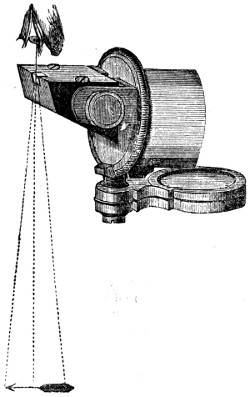
If the microscopist should follow up his work properly, and make sketches of every object which he places under the microscope, he cannot do better than use the camera-lucida, a neat little instrument, which is fitted into the eye-piece of the microscope. Dr. Beale’s neutral glass is as efficacious in careful hands, and only costs a fourth of the sum. This instrument cannot be applied to the ten and twenty shilling microscopes, as it requires that the tube should be perfectly horizontal. The method of using it is simple enough.
After fixing the object and getting the right focus, set the instrument horizontally, and arrange the light so that the object is well illuminated, and its lines quite clear and well defined. Now remove the cap of the eye-piece, and fix the camera-lucida in its stead. Lay a drawing-pad on the table under the camera-lucida, look through the square opening (or, if you use Mr. Beale’s glass, look through the neutral glass), and you will see the object apparently projected on the paper. We say apparently, because in reality the image is not thrown on the paper at all, but on the camera, and the eye refers it to the paper, as being the nearest object. In fact, the principle on which this camera-lucida is arranged is exactly that of the Polytechnic ghost, which appears to be in one place, whereas it is in another.
Now take a pencil, cut it to a very fine point, and trace the outline of the object on the paper. At first you will think this to be an impracticable task, for the point of the pencil will totally vanish. Soon, however, the eye will so adjust itself as to see the pencil and[442] the object perfectly well, and by a little practice the observer will be able to sketch every object as rapidly and firmly as if he were copying a drawing, by means of tracing-paper. The neutral glass is perhaps to be preferred to the camera-lucida, as it is learned more easily, and gives less trouble than that instrument. Its cost is five shillings.
After you have practised yourself well in the handling of the microscope, your ambition will take another step, and lead you to the preparation of permanent objects. In order to set yourself up with the needful apparatus, you will have to disburse about five shillings. A small spirit-lamp will cost eighteenpence, and a small bottle of Canada balsam, another of asphalte varnish, and another of Dean’s gelatine, will make about eighteenpence or two shillings more. A few pence will purchase a sheet or two of ornamental paper, and a few more a flat plate of brass or copper, about five inches by three. The rest of the five shillings may be expended in “slides” and thin glass, cut square.
Slides are merely slips of glass, three inches in length by one in width, and the thin glass is used for laying upon the objects and defending them from dust. We advise the square glass, because it scarcely costs one quarter as much as the round glass, and is equally effective when properly managed. There are several methods of “putting up” preparations—namely, dry, in Canada balsam, in gelatine, and in cells. We will take them in their order.
The simplest plan is, of course, the “dry” mode. Suppose that you want to preserve a tiny piece of down, or the scales from a butterfly’s wing. First wash all the slides and glasses well, by dipping them into a strong solution of soda, and then into hot water, in order to get rid of grease, taking care never to touch them with the hand, but to take them out of the water with the forceps. This can be done at any time, and the glasses carefully wrapped up and placed in a box ready for use.
You now select one of the slides, and lay the object exactly in its centre. If very minute objects are used, they must be examined in order to see whether they are properly disposed. The next process is, to take one of the thin glasses with the microscope, and lay it very carefully over the object. Then cut a piece of ornamental paper, about two inches long and seven-eighths of an inch in width; cut or punch a circular piece out of its centre, damp it well, and cover the wrong side slightly, but completely, with paste. Lay it on the slide, so that the centre of the hole shall coincide with that of the object, work it down neatly with the fingers, and it will hold the square piece of thin glass, which is technically called the “cover,” in its place. Watch it occasionally as it dries, and be ready to press down any part of the paper that may start up. Write, with ink, the name of the object on the end of the slide.
When you have made a dozen or two of these preparations, it will[443] be time to letter and index them. On each slide paste a slip of white paper, and on the paper write a brief notice of the object, thus—

Then scratch with a bit of flint, or with a writing-diamond, if you have one, a number on the end of the slide, and have a note-book with a corresponding number opposite to which you enter the description at a fuller length, thus:—
18—Scales of Death’s Head Moth (Acherontia Atropos), from centre of
under-surface of right fore wing. Dry. June 4, 1864. +
The cross signifies that you prepared the object yourself, and the reason for adding the date is, that in after years you will have a valuable guide as to the durability of your preparations. If the specimen has been purchased or presented, always add the name of the seller or donor, as well as the date. These precautions may seem to be needlessly minute, but we have so often seen whole sets of valuable preparations rendered useless for want of ticketing, that we cannot too strongly impress on our readers the necessity for the note-book as well as the label, the one acting as a check upon the other. When the label has been affixed, and the details transferred to the note-book, the ink may be washed off the end of the slide.
There is another convenient method of putting up the elytra of beetles, parts of various insects, mosses, minute shells, and similar objects. Take a common pill-box of the smallest size, and cut a little cylinder of cork, that will nearly, but not quite, equal the height of the box, and fasten one end to the bottom of the box with glue. Now blacken the interior of the box and the cork cylinder. Put a little drop of Canada balsam, Arabian cement, or gum Arabic on the top of the cylinder; put the object on it, press it into its place, and, when the cement is hard, the preparation is complete. The cover of the box serves to keep the object from dust.
Now we come to the Canada balsam, a substance which produces beautiful effects when rightly handled, but is most aggravating to the learner, causing alternate irascibility and depression of spirits. Many objects, such as the antennæ and feet of insects, will not show their full beauty unless they are mounted in Canada balsam. The method of doing so is as follows:—A week or two beforehand put the objects into ether or spirits of turpentine, and allow them to remain there until wanted. Pile up some old books, or take a couple of convenient wooden blocks; lay your brass plate upon them; light the spirit-lamp, and put it under the plate so as to heat it. Lay two or three slides on the plate, and all then can be heated at the same time.
Warm the bottle of Canada balsam, and with a glass rod take out a very little drop, and put it exactly in the middle of the slide. In order to insure this point, I always put a dot of ink on the wrong side of the slide. Stir it about with one of the needles mentioned on page 428, and if any bubbles rise, break them. When the balsam is quite soft and liquid, take one of the objects out of the bottle and put it into the balsam, exactly over the black dot. Now add a little more balsam, so as to cover it, and let it lie for a few moments. Take one of the glass covers, put a very little balsam on its centre, and lay it neatly over the object, pressing it down gradually and equally. Unless this be done, the object will not remain in the centre, but will shoot out on one side, and the whole operation must be begun de novo. Remove it from the hot plate and lay it on a cool surface, still continuing the pressure until the balsam has begun to harden. Lay a little leaden weight—a pistol-bullet partly flattened is excellent for the purpose—and on the cover write the name of the object, as already mentioned, and then proceed to prepare another slide.
Twenty such slides may be prepared in the course of a morning, and when they are finished they should be laid carefully in a cold place, where they will be free from dust. In a week or so the balsam will be quite hard, and then the slide may be completed. Take an old knife, which should be kept for this special purpose; heat the blade in the spirit-lamp, and then run it along the edges of the slide, so as to take off the superfluous balsam which has escaped from beneath the cover. This must be done very quickly, or the balsam inside the cover will be heated by the knife, and the preparation spoiled. When this is done, cut the ornamental paper, as already described, number and label the slide, wash off the ink, and then the preparation is complete. Some objects are very troublesome to prepare, and require to be soaked in turpentine and boiled repeatedly in the balsam before they are completely penetrated with it.
Objects which are put up in Deane’s gelatine are managed after a similar fashion, save that the gelatine is to be heated by placing the bottle in hot water, and that the turpentine is not needed. Vegetable structures show beautifully when thus prepared. To remove the superfluous gelatine use a wet and not a hot knife.
Cells are very difficult to manage, and the novice had better not attempt to make them, but is hereby advised to purchase them ready made. Suppose that the young microscopist has dissected the digestive organs of a bee, and wishes to preserve it in spirit; his best plan will be to use a cell for the purpose. Let him buy a cell of sufficient depth, float the preparation into it, fill it up with spirit, put the cover loosely on, and leave it for a week, occasionally raising the cover and stirring the preparation with a needle, in order to get rid of any air-bubbles that may have been entangled in the tissues.
Then let him wipe the edges of the cell very dry, put on a slight layer of gold-size or asphalte varnish—the former is preferable—fill up the cell a “bumper,” and lay the cover very gently upon it, beginning at one end and gently lowering it. With blotting-paper the liquid that escapes must be removed, the edges dried afresh, a flattened bullet placed on the cover, and with a very small camel’s-hair brush the slightest possible coating of size painted round the edge of the cell. When it has hardened another may be given, and so on, until a thick hard wall of size has been built up round the edges and made the cover completely air-tight.
We presume that the reader does not intend to use his microscope merely as a toy, but that he desires to gain some insight into the works of Nature, and is therefore willing to set to work in a systematic manner.
It is now known that both animal and vegetable structures are built up by means of certain minute particles, technically called CELLS, and that in every part of a plant or of an animal can be recognised the constituents of which it is formed. We will, therefore, begin with the vegetables.
Some of the lowest plants, such as the minute algæ that inhabit the water, afford excellent examples of the simple vegetable cell; but as these plants are not readily procured by a beginner, we will select some familiar object wherein the cells may be found. If any soft and pulpy fruit be taken when it is quite ripe, and submitted to the microscope, the vegetable cell will be seen in a tolerably perfect form. The three rounded objects shown in the accompanying illustration are cells from the strawberry, specimens of which can easily be seen, if a very thin slice be cut with a razor or lancet, the latter being the preferable instrument. Be careful to dip the blade in water before cutting the fruit, and to float the slice from the blade to the glass slide by placing them both under water. Unless this precaution be taken, the section will not be flat, but will be crumpled up, and the cells will not be properly seen.
Within each of these cells may be seen a small rounded object, which is technically called the “nucleus;” and in some cases a smaller nucleus, called the “nucleolus,” may be observed within the nucleus itself. The increase of cells mostly takes place by a process of division. A line passes across the nucleus, which presently separates into two distinct parts, each of which recedes from the other, causing the cell to enlarge and alter its shape. Presently a line is seen across the cell itself, and in due time the cell is also divided into two parts, each having its own nucleus.
In the present instance the cell is totally spherical, because the fruit from which it was taken was soft, and allowed the constituent cells to expand. When, however, the vegetable substance becomes hard,[446] the cells are pressed closely together, and their shapes are very much altered. Sometimes, when the cells are of nearly the same size, and the pressure is equal on every side, the cells form regular twelve-sided figures, called “dodecahedra,” which, when that occurs, show a six-sided outline. A very thin slice of raw potato will show the twelve-sided cells beautifully, and has the further advantage of exhibiting the starch globules with which the cells are filled. Here is a figure of a potato cell, which presents a six-sided outline, just like that of a bee’s waxen dwelling, and which is crowded with the beautiful globules of starch. If the reader likes to make a few dozen balls of clay, and to squeeze them together in a mass, he will find that the central balls will have lost their globular shape, and assumed a more or less regular twelve-sided form, very much like that of the potato cells.
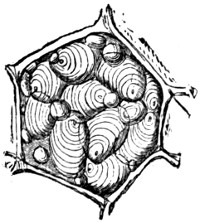
CELL, POTATO.

STELLATE TISSUE.
Sometimes the cells run out longitudinally into cylinders, and attain the really enormous length of three inches; sometimes they become flattened, as the skin or epidermis of many plants; and oftentimes they push out their sides into arms or rays, like stars, and form the tissue which is technically called “stellate.” Here is a specimen of stellate tissue taken from the pith of the common rush, wherein the rays are seen to be very regular: generally, however, the rays are extremely irregular, and require some little practice to detect them. Stellate tissue may be seen in the white portion of orange-peel, in the thick fleshy substance of many aquatic plants, in certain leaf-stalks, and in many similar objects.
We will now see how the soft cells which form the pulpy fruit of the strawberry can be changed into the hard timber of the oak or iron-wood tree.
Wherever a cell is destined to form part of a permanent tissue, it is strengthened by receiving certain additions to its walls. These additions are technically known as “secondary deposit,” and are made in various ways. Sometimes they extend in a thin layer over the whole cell-wall, leaving a number of little holes, which are called “pits,” and earning the name of “pitted structures.” Very frequently the secondary deposit is arranged in a series of rings, an example of which is given in the accompanying illustration. This object is taken from the mistletoe. Good examples of the ringed structures may[447] be seen in the anthers of many plants, and in the leaf-stem of the common rhubarb, an example of which is shown in the next illustration. Another very common form of secondary deposit is the spiral, which is generally used where strength and elasticity are united. Two examples of the spiral form are given in the illustration; the first taken from the lily, and the second from the “rhizome,” or subterranean stem of the water-lily.
Another beautiful form of secondary deposit is seen in the fern root. If the root be cut longitudinally, and the dark hard fibre dissolved carefully out with nitric acid, the deposit will seem to have assumed the shape of a winding staircase, and is then called “scalariform,” or ladder-shaped. Similar structures may be found in asparagus.
The reader will see that the hardness of the structure depends entirely on the amount of secondary deposit, and we accordingly find that when the wood is hard and fit to be worked with tools the cells are almost wholly filled with the secondary deposit. In this state they are called “wood-cells.” Examples of these cells may be seen in the accompanying illustration. In the first example, which is taken from the elder-tree, four cells are shown in order to display the manner in which their pointed ends are arranged. (The reader must remember that in all wood-cells the ends are pointed.) In the next example, which is taken from the chrysanthemum, the pitted structure is still retained; but in the last figure, which is drawn[448] from the lime-tree, the entire cell is filled with secondary structure. The reader must understand that we can only give the veriest outline of the subject, and profess to do nothing more than indicate the method of observation, leaving the pupil to work out the details by himself.
Another curious development of the plant-cells is the formation of HAIRS. These objects alone afford an inexhaustible field for the microscopist, and any one who chooses to work out the subject will find himself repaid if he makes a good series of preparations. In their primary forms the hairs are seen merely as little projections on the epidermis, whether of the stem, leaf, or petal, and by degrees assume their varied and beautiful forms. In order to show the singular forms which hairs sometimes assume, an illustration is here given of the hairs of the lavender leaf. This is one of the hairs that give the leaf its silvery gloss. It consists of an upright stem, from the top of which a number of forked branches shoot out horizontally, much like an open umbrella held upright. The object of this remarkable form is, that the delicate vessels in which the perfume is held should escape injury. If the reader will refer to the second figure, which represents a much magnified view of the edge of the leaf, he will see the globular perfume-gland standing under the shelter of the branching hairs.
The following plants afford valuable examples of hair:—Arabis, marvel of Peru, sowthistle, tobacco, southernwood, hollyhock, snapdragon, pansy (in throat of flower), deutzia (under-side of leaf), verbena, alyssum, tradescantia, borage, cowhage, and many others. The beautiful effect produced by the petals of flowers is caused by the imperfect hairs with which their surfaces are studded.
The POLLEN of plants is always worth observing, and some specimens are of remarkably beautiful shapes. Take that of althæa, crocus, cactus, heath, violet, daisy, lily, snowdrop, wallflower, willow-herb (a very beautiful form), hollyhock, periwinkle, primrose, &c. Put some up in Deane’s gelatine, and dry some, besides examining them all when fresh.
The microscopist ought to examine the structures of WOOD by making sections in the directions transverse and longitudinal. A razor will answer very well for the purpose, and the wood should[449] always be soaked inside, and the razor wetted before the section is made. It is often useful to make diagonal sections of several woods, especially those of the pine and juniper. All the forest trees should be examined, and their roots and bark should not be omitted. Cut sections of coconut-shell, vegetable ivory, sugar-cane (a most beautiful object when mounted opaque), bamboo, butcher’s broom, &c.
Mosses are beautiful objects, and can always be found. Examine particularly the fruit or seed-vessel, and note the structure of its different parts. Put these on a slide, and breathe on them, noting at the same time any change which may take place.
The SPORE CASES of ferns are extremely beautiful, and should be carefully examined. The little brown dots or streaks that are seen on the under surface of the fronds are called “sori,” and contain a large but variable number of the sporanges. These consist of stalked sacs or cases, and differ much in shape, according to the species of fern. If the fern be fresh from which the sorus is taken, the sporanges may be seen writhing and twisting like so many serpents, and sometimes it happens that one of the sporanges bursts, and suddenly covers the field of the microscope with minute black dots. These dots are the spores or seeds of the fern, and when magnified with a very high power, they are seen to be variously shaped. One of the most remarkable spores is that of the equisetum, or mare’s tail of the water. This spore looks like a ball with something coiled round it. As soon as the spore is discharged from its case, four threads are seen to uncoil themselves from around it, and by their elasticity to cause the spore to jump about as if alive. These fibres are technically named elasters, and are prolongations of the outer coat of the spore.
Fungi of all kinds should be examined. There is never any difficulty in finding fungi, though the autumn is the best time of year for this purpose. “Mould,” as it is popularly called, is a form assumed by many species of fungus, which, though objectionable to the careful housewife, are full of interest to the microscopist. The well-known mushroom and toadstools are the highest of the fungi. The black spots on leaves are fungi, mostly belonging to the genus puccinia, and the best specimens are generally found on the wild rose or bramble. The black “smut” of wheat is another fungus, very pretty under the microscope, but very obnoxious to the farmer; and the “bunt” also belongs to the same vast tribe of plants, four thousand species of which are now known to exist.
The young observer should also look for the beautiful crystals which exist in many vegetable cells. The RAPHIDES, as these crystals are called, are of various forms, mostly shaped like curved needles, but often assuming very pretty and regular outlines. Raphides are plentifully found in the bulb of the onion, in the rhubarb, the lily, the iris, &c. They are best mounted as opaque objects and, if the reader can procure a binocular microscope, he[450] will see the form of the raphides better than with the single-tube instrument.
Seeds of different plants should be carefully examined, especially those of small dimensions, which often exhibit some wonderful beauties of structure. The winged seed of various plants, such as the thistle, the dandelion, the valerian, and the willow-herb, are extremely interesting objects; while those of the yellow snapdragon, the mullein, the Robin Hood, and the bur-seed, are remarkably beautiful in form, though they have no parachute, as the feathery appendage is called.
Leaving dry land, we will devote a short time to the water. Let the reader take with him the simple collecting apparatus mentioned on page 430, and secure specimens of the water from different ponds, ditches, and streams. For collecting the larger objects a little net, which can be purchased cheap, is of very great use. It is easily made by any tinman, and if the young microscopist knows the use of solder, as all experimental philosophers ought to do, he can put it together in a few minutes. It is formed of a strip of zinc bent into the requisite form, and with a socket, to which a handle can be attached. A piece of coarse muslin, or, rather, fine “net,” is then stretched over the bottom, and the apparatus is complete.
In the water is sure to be found one of the lowest forms of vegetable life—namely, the “confervoid algæ.” Look for these in bright, clear pools, placing the collecting bottle near any greenish film collected around the stems of plants, or spread over the stones on the bed of the pool. If this film be very carefully taken up, it will produce many interesting forms of vegetable life. One of the most remarkable of these vegetables is that which is called “volvox globator,” a figure of which is here given.
This wonderful object is about as large as the head of a very small pin, so that it is visible to the naked eye, and looks like a tiny globule passing through the water. When it is placed under a lens of moderate power, say of an inch focus, it exhibits some very strange peculiarities. It continually revolves, and by its revolution is able to enjoy a moderate degree of locomotion, though without any apparent object. Small dark spots are also seen upon it.
If a half-inch lens be now used, the structure of the volvox begins to be exhibited. The whole surface is covered with a network of very fine fibres, having a spot at the intersection of each mesh. On applying a still higher power, say the four-tenths of an inch, the structure is further elucidated, and the dots on the surface are seen to consist of greenish bodies, each furnished with a pair of delicate fibres, technically named cilia, which are constantly vibrating, and cause the revolution of the general mass. The dark spots are now seen to be the young plants in different stages of progress. From six to ten of these are inclosed within the parent, and when the latter has reached its full age, the membrane bursts asunder, and the little volvoces are liberated.

CLOSTERIUM.
Another interesting form is the closterium, a genus which is sure to produce several good examples. We may mention that the ponds in Blackheath are very rich in these curious vegetables, and a very considerable series of confervoids may be obtained from them. The closteria are easily recognised by their resemblance to the Australian “boomerang.”
As our space is rapidly waning, we must leave the vegetable, and proceed to the animal kingdom.
As is the case with vegetables, the animal structure is composed of cells, though they cannot be so easily traced as in the examples which we have already noticed. The young observer may readily perceive the animal cell, in its largest and simplest form, by placing a little of the yolk of egg under the microscope. CARTILAGE, or gristle, is easily seen to be composed of cells. The nails of the fingers afford good objects for the microscopist in search of animal cells. If a thin section be placed under the microscope, none but an experienced observer will be able to make out the presence of cells at all; but if the section be soaked in “liquor potassæ,” the cells immediately swell up, and their shape is at once made plain. Take the BONE of a young chicken or rabbit, and make a thin section that embraces both the bone and cartilage, and there will then be a beautiful object for the microscopist, showing how the cartilage is changed by degrees into bone.
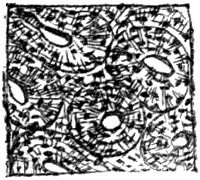
BONE, TRANSVERSE.
Sections of bone should also be made, both transverse and longitudinal.
The BLOOD is another object which must be carefully examined. The “corpuscles” which give the colouring matter to the blood are cells of different size, according to the creature from which they are taken. The dimensions of the animal exercise no apparent influence on the corpuscles, for those of “proteus anguinus,” a little creature not larger than a lamprey, are many times larger than those of the ox. In the accompanying illustration is shown a series[452] of specimens, in order to show the great difference in their shape and size, all being drawn to scale and magnified by the same lens. The circular corpuscles in the left-hand upper corner are those of man; immediately below is a single corpuscle from the pigeon. The great central corpuscle is taken from the proteus; the two in the lower right-hand corner are from the frog, one of these being viewed edgeways; and of the remaining two, that on the left hand belongs to the tortoise, and that on the right to a fish.
The insect tribes are an inexhaustible source of objects for the microscopist, who may find that even a single fly will give him employment for many months. The scales from the butterfly’s wing, the wonderful compound eyes with which insects are gifted, the structure of their feet, and their entire anatomy, are always at the service of any microscopist who really cares for his work. It would, of course, be impossible to give even a list of the interesting portions of the different insects; so one or two examples must suffice us.
Take the ANTENNÆ of the insect tribes, and see how beautifully they are formed, how graceful is the shape, and how elaborate the structure. A low power will be useful for exhibiting their general shape and outline, but it is not until we know how to use the higher powers that the real beauty of these curious organs is seen. In the accompanying illustration is given part of an antenna of the common blue-bottle fly, in order to show the remarkable cavities which exist within the antennæ, and which are thought by some anatomists to be organs of hearing, and by others to be organs of smell.
The WINGS of insects are also most remarkable, and possess many peculiarities of structure which cannot be detected without the aid of a microscope. Take, for example, the wings of any hymenopterous[453] insect, say those of a humble-bee, and see how beautiful is the structure which causes the four wings to be united into two when the insect is about to fly. In the illustration may be seen a pair of these wings, together with the row of hooks which bind them together. A still more magnified representation of the hooks is placed near the wings.
It is now ascertained that the wings of insects are connected with the breathing apparatus, and that the respiration of the insect extends even to the very tips of these singular organs, which are not modifications of existing limbs, as in the birds, but additional structures. The circulation of insects may often be seen by placing a portion of a transparent wing under a moderately high power. We have often seen it in the wing of the great water-beetle. A series of very beautiful preparations may be made in order to show the distinction between the wings of different insects; and as the orders of insects are founded upon their wings, there ought to be at least one example of each order. The proboscis of insects is always worthy of careful examination.
As to the breathing apparatus itself, the best mode of examining it is to open a caterpillar, remove a part of the large breathing tube which runs along each side, and place it under the microscope. It should always be taken so as to include one of the spiracles, or breathing-holes. An example of a breathing-tube, taken from a silk-worm, is given in the illustration.
Hairs of animals are very curious and interesting objects. They should be mounted in three modes—namely, dry transparent, dry opaque, and in Canada balsam, transparent. Be sure to procure some hair of the bat, the sheep, the mouse, the deer, the mole, and any of the weasel tribe. Many insects have very beautiful hair, but the most lovely hair in the animal kingdom is that which is obtained from the sea-mouse. Fish scales should also be procured, and specimens should be taken from the lateral line.
Molluscs of all kinds afford many beautiful objects, and the observer should be very careful to examine the wonderful tongue-ribbon of the snail, the slug, the periwinkle, the whelk, and other similar molluscs. If meant to be examined by polarized light, the tongue-ribbon should be mounted in Canada balsam.
Crystals should always form part of a collection. Take those of common salt, nitre, sugar, chlorate of potash, salicine, &c.; indeed, anything that will crystallize should be prepared and mounted, as such objects will often be most useful when examining unknown substances.
 |
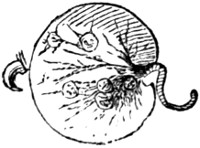 |
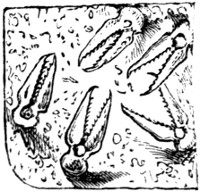 |
| BIRD’S-HEAD PROCESS. | NOCTILUCA. | PEDICILLARIÆ. |

BIRD’S-HEAD PROCESS.

NOCTILUCA.

PEDICILLARIÆ.
Zoophytes must of course find a place in the cabinet, and the young microscopist ought to put up a few specimens of the “bird’s-head” processes which are found in the bugularia and other inhabitants of the sea. The pretty noctiluca, to which is mostly owing the phosphorescence of the sea, should be preserved, and the extraordinary appendages to the skin of certain star-fish and sea urchins should be examined. These are called pedicillariæ, and a sketch of them is given in the illustration.
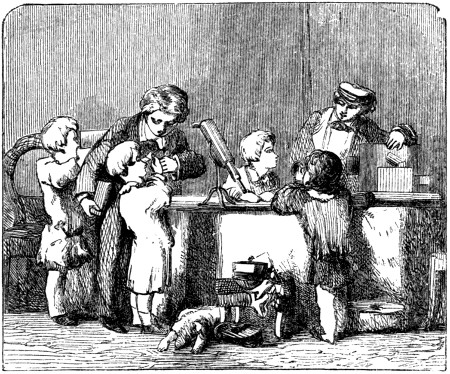
Optics is the science of light and vision. Concerning the nature of light, two theories are at present very ably maintained by their respective advocates. One is termed the Newtonian theory, and the other the Huygenean. The Newtonian theory considers light to consist of inconceivably small bodies emanating from the sun, or any other luminous body. The Huygenean conceives it to consist in the undulations of a highly elastic and subtle fluid, propagated round luminous centres in spherical waves, like those arising in a placid lake when a stone is dropped into the water.
Light follows the same laws as gravity, and its intensity or degree decreases as the square of the distance from the luminous body increases. Thus, at the distance of two yards from a candle we shall[456] have four times less light than we should have, were it only one yard from it, and so on in the same proportion.
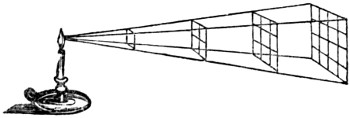
Bodies which suffer the rays of light to pass through them, such as air, water, or glass, are called refracting media. When rays of light enter these, they do not proceed in straight lines, but are said to be refracted, or bent out of their course, as seen in the drawing. The ray of light proceeding from B through the glass L G is bent from the point C, instead of passing in the direction of the dotted line. But if the ray F C falls perpendicularly on the glass, there is no refraction, and it proceeds in a direct line to K; hence refraction only takes place when rays fall obliquely or aslant on the media.
If a coin be placed in a basin, so that on standing at a certain distance it be just hid from the eye of an observer by the rim or edge of the basin, and then water be poured in by a second person, the first keeping his position; as the water rises the coin will become visible, and will appear to have moved from the side to the middle of the basin.
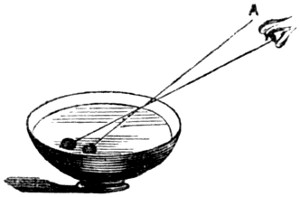
The multiplying glass is a semicircular piece of glass cut into facets or distinct surfaces; and in looking through it we have an illustration of the laws of refraction, for if a small object, such as a fly, be placed at D, an eye at E will see as many flies as there are surfaces or facets on the glass.
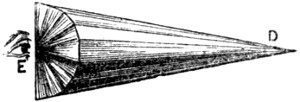
Transparent bodies, such as glass, may be made of such form as to cause all the rays which pass through them from any given point to meet in any other given point beyond them, or which will disperse them from the given point. These are called lenses, and have different names according to their form. 1. Is called the plano-convex lens. 2. Plano-concave. 3. Double convex. 4. Double concave. 5. A meniscus, so called from its resembling the crescent moon.

The prism is a triangular solid of glass, and by it the young optician may decompose a ray of light into its primitive and supplementary colours, for a ray of light is of a compound nature. By the prism the ray A is divided into its three primitive colours, blue, red, and yellow; and their four supplementary ones, violet, indigo, green, and orange. The best way to perform this experiment is to cut a small slit in a window-shutter, on which the sun shines at some period of the day, and directly opposite the hole place a prism P; a beam of light in passing through it will then be decomposed, and if let fall upon a sheet of white paper, or against a white wall, the seven colours of the rainbow will be observed.
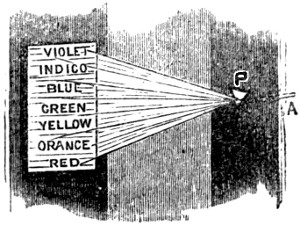
The beam of light passing through the prism is decomposed, and the spaces occupied by the colours are in the following proportions:—red, 6; orange, 4; yellow, 7; green, 8; blue, 8; indigo, 6; violet, 11. Now, if you paste a sheet of white paper on a circular piece of[458] board about six inches in diameter, and divide it with a pencil into fifty parts, and paint colours in them in the proportions given above, painting them dark in the centre parts, and gradually fainter at the edges, till they blend with the one adjoining. If the board be then fixed to an axle, and made to revolve quickly, the colours will no longer appear separate and distinct, but becoming gradually less visible they will ultimately appear white, giving this appearance to the whole surface of the paper.
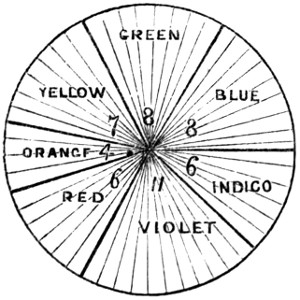
The human eye is a camera obscura, for on the back of it on the retina every object in a landscape is beautifully depicted in miniature. This may be proved by the
Procure a fresh bullock’s eye from the butcher, and carefully thin the outer coat of it behind: take care not to cut it, for if this should be done the vitreous humour will escape, and the experiment cannot be performed. Having so prepared the eye, if the pupil of it be directed to any bright objects, they will appear distinctly delineated on the back part precisely as objects appear in the instrument we are about to describe. The effect will be heightened if the eye is viewed in a dark room with a small hole in the shutter, but in every case the appearance will be very striking.
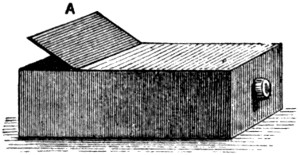
This is a very pleasing and instructive optical apparatus, and may be purchased for four or five shillings. But it may be easily made by the young optician. Procure an oblong box, about two feet long, twelve inches wide, and eight high. In one end of this a tube must be fitted containing a lens, and be made to slide backwards and forwards so as to suit the focus. Within the box should be a plain mirror reclining backwards from the tube at an angle of forty-five degrees. At the top of the box is a square of unpolished glass, upon which from beneath the picture will be thrown, and may be seen by raising the lid A. To use the camera place the tube with the lens on it opposite to the object, and having adjusted the focus, the image[459] will be thrown upon the ground-glass as above stated, where it may be easily copied by a pencil or in colours.

The form of a camera obscura used in a public exhibition is as follows:—D D is a large wooden box stained black in the inside, and capable of containing from one to eight persons. A B is a sliding piece, having a sloping mirror C, and a double convex lens F, which may with the mirror C be slid up or down so as to accommodate the lens to near and distant objects. When the rays proceeding from an object without fall upon the mirror, they are reflected upon the lens F, and brought to fall on the bottom of the box, or upon a table placed horizontally to receive them, which may be seen by the spectator whose eye is at E.
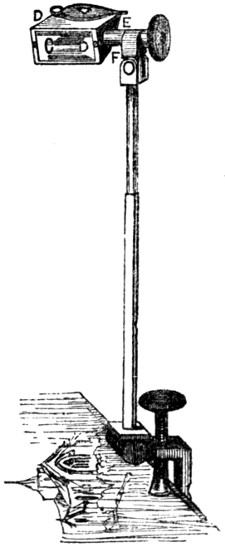
This instrument consists of a glass prism, C, D, D, E, having four sides covered. The sides C, D, being exposed to the object to be delineated, rays pass through the glass and fall on the sloping side D, E; from this they are reflected to the top, and finally pass out of the prism to the eye;[11] now from the direction at which the rays enter the eye, it receives them as if coming from an image at A, B, and if a sheet of paper be placed below the instrument, a perfect delineation of the object may be traced with a pencil. This is a very useful instrument to young draughtsmen.
[11] The eye is to be applied to the little circular hole seen on the upper surface.
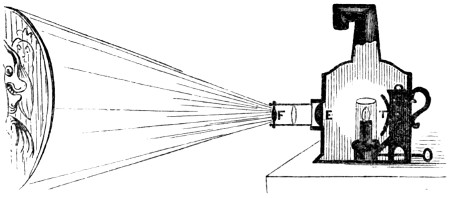
This is one of the most pleasing of all optical instruments, and it is used to produce enlarged pictures of objects, which being painted on a glass in various colours are thrown upon a screen or white sheet placed against the wall of a large room. It consists of a sort of tin-box, within which is a lamp, the light of which (strongly reflected by the reflector T,) passes through a great plano-convex lens E fixed in the front. This strongly illuminates the objects which are painted on the slides or slips of glass, and placed before the lens in an inverted position, and the rays passing through them and the lens F, fall on a sheet, or other white surface, placed to receive the image. The glasses on which the figures are drawn are inverted, in order that the images of them may be erect.
The slides containing the objects usually shown in a magic lantern, are to be bought at opticians with the lantern, and can be procured cheaper and better in this way than by any attempt at manufacturing them. Should, however, the young optician wish to make a few slides of objects of particular interest to himself, he may proceed as follows:—

Draw first on paper the figures you wish to paint, lay it on the table, and cover it over with a piece of glass of the above shape; now draw the outlines with a fine camel’s hair pencil in black paint mixed with varnish, and when this is dry, fill up the other parts with the proper colours, shading with bistre also mixed with varnish. The transparent colours are alone to be used in this kind of painting.
The room for the exhibition ought to be large, and of an oblong shape. At one end of it suspend a large sheet so as to cover the whole of the wall. The company being all seated, darken the room, and placing the lantern with its tube in the direction of the sheet, introduce one of the slides into the slit, taking care to invert the figures; then adjust the focus of the glasses in the tube by drawing it in or out as required, and a perfect representation of the object will appear.
Most extraordinary effects may be produced by means of the magic lantern; one of the most effective of which is a
This is effected by having two slides painted, one with the tempest as approaching on one side, and continuing in intensity till it reaches the other. Another slide has ships painted on it, and while the lantern is in use, that containing the ships is dexterously drawn before the other, and represents ships in the storm.

The effects of sunrise, moonlight, starlight, &c., may be imitated, also by means of double slides, and figures may be introduced sometimes of fearful proportions.

Heads may be made to nod, faces to laugh; eyes may be made to roll, teeth to gnash; crocodiles may be made to swallow tigers; combats may be represented; but one of the most instructive uses of the slides is to make them illustrative of astronomy, and to show the rotation of the seasons, the cause of eclipses, the mountains in the moon, spots on the sun, and the various motions of the planetary bodies, and their satellites.
Between the phantasmagoria and the magic lantern there is this difference: in common magic lanterns the figures are painted on transparent glass, consequently the image on the screen is a circle of light having figures upon it; but in the phantasmagoria all the glass is made opaque, except the figures, which, being painted in transparent colours, the light shines through them, and no light can come upon the screen except that which passes through the figure, as is here represented.
There is no sheet to receive the picture, but the representation is thrown on a thin screen of silk or muslin placed between the spectators and the lantern. The images are made to appear approaching and receding by removing it further from the screen, or bringing it nearer to it. This is a great advantage over the ordinary arrangements of the magic lantern, and by it the most astonishing effects are often produced.
The dissolving views, by which one landscape or scene appears to pass into the other while the scene is changing, are produced by using two magic lanterns placed side by side, and that can be a little inclined towards each other when necessary, so as to mix together the rays of light proceeding from the lenses of each, which produces that confusion of images, in which one view melts as it were into the other, which gradually becomes clear and distinct; the principle being the gradual extinction of one picture, and the production of another.
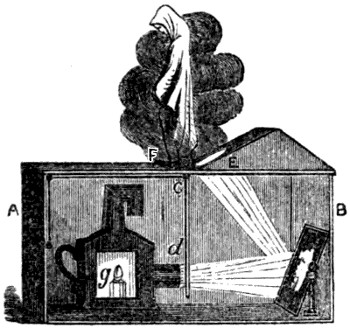
The magic lantern, or phantasmagoria, may be used in a number of marvellous ways, but in none more striking than in raising an apparent spectre. Let an open box, A B, about three feet long, a foot and a half broad, and two feet high, be prepared. At one end of this place a small swing dressing-glass, and at the other let a magic lantern be fixed with its lenses in a direction towards the glass. A glass should now be made to slide up and down in the groove C D, to which a cord and pulley should be attached, the end of the cord coming to the part of the box marked A. On this glass the most[463] hideous spectre that can be imagined may be painted, but in a squat or contracted position, and when all is done, the lid of the box must be prepared by raising a kind of gable at the end of the box B, and in its lower part at E an oval hole should be cut sufficiently large to suffer the rays of light reflected from the glass to pass through them. On the top of the box at F place a chafing-dish, upon which put some burning charcoal. Now light the lamp G in the lantern, sprinkle some powdered camphor or white incense on the charcoal, adjust the slide on which the spectre is painted, and the image will be thrown upon the smoke. In performing this feat the room must be darkened, and the box should be placed on a high table, that the hole through which the light comes may not be noticed.
This word is derived from two Greek words, one of which signifies wonder, and the other to turn. It is a very pretty philosophical toy, and is founded upon the principle in optics, that an impression made upon the retina of the eye lasts for a short interval after the object which produced it has been withdrawn. The impression which the mind receives lasts for about the eighth part of a second, as may be easily shown by whirling round a lighted stick, which if made to complete the circle within that period, will exhibit not a fiery point, but a fiery circle in the air.
Cut a piece of cardboard of the size of a penny piece, and paint on one side a bird, and on the other a cage; fasten two pieces of thread one on each side at opposite points of the card, so that the card can be made to revolve by twirling the threads with the finger and thumb: while the toy is in its revolution, the bird will be seen within the cage. A bat may in the same manner be painted on one side of the[464] card, and a cricketer upon the other, which will exhibit the same phenomenon, arising from the same principle.

The above-named figure is a Thaumatrope, as much as the one we are about to describe, although the term Phantasmascope is generally applied to the latter instrument; which consists of a disc of darkened tin-plate, with a slit or narrow opening in it, about two inches in length. It is fixed upon a stand, and the slit placed upwards, so that it may easily be looked through. Another disc of pasteboard, about a foot in diameter, is now prepared and fixed on a similar stand, but with this difference, that it is made to revolve round an axis in the centre. On this pasteboard disc, paint in colours a number of frogs in relative and progressive positions of leaping; make between each figure a slit of about a quarter of an inch deep: and when this second disc is made to revolve at a foot distance behind the first, and the eye is placed near the slit, the whole of the figures, instead of appearing to revolve with the disc, will all appear in the attitudes of leaping up and down, increasing in agility as the velocity of the motion is increased. It is necessary, when trying the effect of this instrument, to stand before a looking-glass, and to present the painted face of the machine towards the glass.
A very great number of figures may be prepared to produce similar effects—horses with riders in various attitudes of leaping, toads crawling, snakes twisting and writhing, faces laughing and crying, men dancing, jugglers throwing up balls, &c.; all of which, by the peculiar arrangement above detailed, will seem to be in motion. A little ingenuity displayed in the construction and painting of the figures upon the pasteboard disc will afford a great fund of amusement.
One of the most curious facts relating to the science of vision is the absolute insensibility of a certain portion of the retina to the impression of light, so that the image of any object falling on that point would be invisible. When we look with the right eye, this point will be about fifteen degrees to the right of the object observed, or to the right of the axis of the eye, or the point of most distinct vision. When looking with the left eye, the point will be as far to[465] the left. The point in question is the basis of the optic nerve, and its insensibility to light was first observed by the French philosopher, Mariotte. This remarkable phenomenon may be experimentally proved in the following manner:—
Place on a sheet of writing-paper, at the distance of about three inches apart, two coloured wafers; then, on looking at the left-hand wafer with the right eye, at the distance of about a foot, keeping the eye straight above the wafer, and both eyes parallel with the line which forms the wafers, the left eye being closed, the right-hand wafer will become invisible; and a similar effect will take place if we close the right eye, and look with the left.
Cut a circular piece of white paper, about two inches in diameter, and affix it to a dark wall. At the distance of two feet on each side, but a little lower, make two marks; then place yourself directly opposite the paper, and hold the end of your finger before your face, so that when the right eye is open it shall conceal the mark on your left, and when the left eye is open the mark on your right. If you then look with both eyes at the end of your finger, the paper disc will be invisible.
Fix a similar disc of paper, two inches in diameter, at the height of your eye on a dark wall; a little lower than this, at the distance of two feet on the right hand, fix another of about three inches in diameter; now place yourself opposite the first sheet of paper, and, shutting the left eye, keep the right eye still fixed on the first object, and when at the distance of about ten feet, the second piece of paper will be invisible.
One of the numerous optical illusions which have from time to time been evolved by scientific minds, is that of making an image or picture appear in the air. This is produced by means of a mirror, and an object in relief, upon which a strong light is thrown,—the mirror being set at such an angle as to throw up the reflection of the image to a certain point in the view of the spectator. This illusion is produced as follows: Let a screen be constructed in which is an arched aperture, the centre of which may be five feet from the floor: behind the screen is placed a large mirror of an elliptical form. An object is now placed behind the screen, upon which the light of a strong lamp is thrown from a point above the mirror, and is received by the mirror and reflected to the centre of the arched cavity in the screen, where it will appear to the spectator. Care should be taken to place the image in an inverted position, and the light, which must be very powerful, should be so placed that none of it may reach the opening.

The following experiment, if performed with care, is exceedingly striking. Let S be a candle, whose light falls at an angle of 56° 45′ upon two plate glasses, A B, placed close to each other; and let the reflected rays, A C, B D, fall at the same angle upon two similar plates, C D, but so placed that the plane of reflection from the latter is at right angles to the plane of reflection from the former. An eye placed at E, and looking at the same time on the two plates, C and D, will see very faint images of the candle, S; which by a slight adjustment of the plates, may be made to disappear almost wholly, allowing the plate C to remain where it is. Change the position of D, till its inclination to the ray, B D, is diminished about 3°, or made nearly 53° 11′. The distance may be easily found by a little practice. When this is done, the image that had disappeared on looking into D will be restored, so that the spectator at E, upon looking into the two mirrors, C D, will see no light in C, because the candle has nearly disappeared, while the candle is distinctly seen in D. If, while, the spectator is looking into these two mirrors, either he or another person breathes upon them gently and quickly, the breath will revive the extinguished image in C, and will extinguish the visible image in D.[12]
[12] Explanation.—The light A, C, B, D is polarized by reflection from the plates A B, because it is incident at the polarizing angle 56° 45′ for glass. When we breathe upon the plates C D, we form upon their surface a thin film of water, whose polarizing angle is 53° 11′, so that if the polarized rays A, C, B, D fall upon the plates C, D, at an angle of 53° 11′, the candle from which they proceeded would not be visible, or they would not suffer reflection from the plates C D. At all the other angles the light would be reflected, and the candle visible. Now the plate D is placed at an angle of 53° 11′, and C at an angle of 56° 45′, so that when a film of water is breathed upon them, the light will be reflected from the latter, and none from the former; that is, the act of breathing upon the glass plates will restore the invisible, and extinguish the visible image.
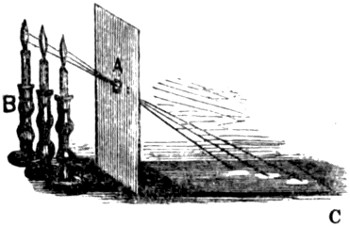
Make a small hole in a sheet of pasteboard, A, and placing it upright before three candles, B, placed closely together, it will be found that the images of all the candle flames will be formed separately on a piece of paper, C, laid on the table to receive them. This proves that the rays of light do not obstruct each other in their progress, although all cross in passing through the hole.
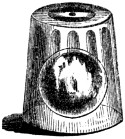
If a soap-bubble be blown up, and set under a glass, so that the motion of air may not affect it, as the water glides down the sides and the top grows thinner, several colours will successively appear at the top, and spread themselves from thence down the sides of the bubble, till they vanish in the same order in which they appeared. At length, a black spot appears at the top, and spreads till the bubble bursts.[13]
[13] The thinnest substance ever observed is the aqueous film of the soap-bubble previous to bursting; yet it is capable of reflecting a faint image of a candle, or the sun. Hence its thickness must correspond with what Sir Isaac Newton calls the beginning of black, which appears in water at the thickness of the seven hundred and fifty thousandth part of an inch.

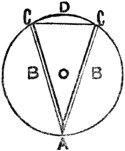
If any object be placed between two plane mirrors, inclined towards each other at an angle of thirty degrees, three several images will be perceived in the circumference of a circle. On this principle is formed the kaleidoscope, invented by Sir David Brewster, and by means of which the reflected images viewed from a particular point exhibit symmetrical figures, under an infinite arrangement of beautiful forms and colours. The kaleidoscope may be bought at any toy-shop, but it is requisite that every young person should be able to construct one for himself. He must, therefore, procure a tube of tin or paper, of about ten inches in length, and two and a half or three inches in diameter. One end of this should be stopped up with tin or paper, securely fastened, in which is to be made a hole, about the size of a small pea, for the eye to look through. Two pieces of well-silvered looking-glass, B B, are now to be procured; they must be not quite so long as the tube, and they should be placed in it lengthways, at an angle of 60 degrees, meeting together in a point at A, and separating to the points C C, the polished surfaces looking inwards. A circular piece of the glass is now to be laid on the top of the edges of the reflectors, B B; which, by their not being quite so long as the tube, will allow room for its falling in, and it will be supported by the edges of the tube, which may be slightly bent over, to prevent the glass from falling out. This having been done, now[468] proceed to make the “cap” of the instrument. A rim of tin or pasteboard must be cut, so as to fit over the glass end of the tube; and in this, on the outer side, a piece of ground glass must be fastened, so that the whole may fit on the tube like the lid of a pill-box. Then, before putting it on, obtain some small pieces of broken glass of various colours, beads, little strips of wire, or any other object, and place them in the cap; and by passing it over the end, so that the broken glass, &c. has free motion, the instrument is complete. To use it, apply the eye to the small hole, and, on turning it, the most beautiful forms will appear, in the most wonderful combinations.
The following curious calculation has been made of the number of changes this instrument will admit of. Supposing it to contain 20 small pieces of glass, and that you make 10 changes in a minute, it will take an inconceivable space of time, i. e. 462,880,899,576 years, and 360 days, to go through the immense number of changes of which it is capable.
Having made a circular hole in a window-shutter, about three inches in diameter, place in it a glass lens of about twelve inches focal distance. To the inside of the hole adapt a tube, having at a small distance from the lens a slit, capable of receiving one or two very thin plates of glass, to which the object to be viewed must be affixed by means of a little gum-water exceedingly transparent. Into this tube fit another, furnished at its extremity with a lens half-an-inch focal distance. Place a mirror before the hole of the window-shutter on the outside, in such a manner as to throw the light of the sun into the tube, and you will have a solar magic lanthorn.
The method of employing this arrangement of lenses for microscopic purposes is as follows:—Having darkened the room, and by means of the mirror reflected the sun’s rays on the glasses in a direction parallel to the axis, place some small object between the two moveable plates of glass, or affix it to one of them with very transparent gum-water, and bring it exactly into the axis of the tube; if the moveable tube be then pushed out or drawn in, till the object be a little beyond the focus, it will be seen painted very distinctly on a card, or piece of white paper, held at a proper distance, and will appear to be greatly magnified. A small insect will appear as a large animal, a hair as big as a walking-stick, and the almost invisible eels in paste or vinegar as large as common eels.
This is a very curious optical effect, producing a distorted and grotesque figure from a regular one. The term is derived from two Greek words, signifying a distortion of figure, and by its means many optical puzzles may be produced geometrically.
Take any subject, such as the portrait of a head; divide it vertically[469] and horizontally with parallel lines, of which the outer sides shall form the boundary, A, B, C, D, and the whole shall be equidistant. Then, on a separate piece of paper, or cardboard, prepare a drawing similar to Fig. 2 by the following means:—
1. Draw a horizontal line, a b, equal to A B, and divide it into as many equal parts as the latter is divided.
2. Let fall a perpendicular line, e v, from the middle of a b, and then draw s v parallel to a b.
3. Both e v and s v may be any length at pleasure, but the longer the first is, and the shorter the other, so will the anamorphoses be more and more deformed. The proportions in our figures are sufficiently different.
4. After having drawn from the point v right lines, v 1, v 2, v 3, v 4, to the divisions of a b, draw the line s b, and through each point where s b intersects the divergent lines draw other horizontal lines parallel to a b. We now have a trapezium, a b c d divided into as many cells as the square in Fig. 1.
The next step is to fill up all the cells of Fig. 2 with portions of the device, proportionate to their position in Fig. 1. For instance, in Fig. 1 the nose is in the second vertical division from the left, and in the third and fourth horizontal divisions from the top, and that portion of the face must accordingly be placed in a corresponding part of Fig. 2.
By these means we procure the anamorphosis seen in Fig. 2, which when viewed from a particular position, will lose all its distortion, and assume an appearance resembling that in Fig. 1. This position lies immediately over the point v, and at a height above it equal to the length of the line s v; and the means of determining it are as follows.
Place the drawing horizontally before a window; take a slip of card, and rest its lower edge on the line s v, the card being accurately vertical; pierce a small hole in the card vertically over the point v, and at a height from it equal to the length of the line s v, then with the eye placed immediately behind the card, look through the orifice at the anamorphosis, and it will be found that as soon as it has become accustomed to the novelty of the experiment, the anamorphosis will lose its distortion, and appear almost exactly like the symmetrical figure.
It would be very difficult, and would require geometrical reasoning of a lengthened kind, to show why this particular form of construction should lead to such results.
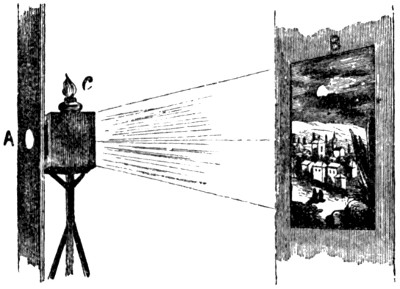
The principle upon which the cosmorama is formed is so simple, that any person may easily fit up one in a small summer house, &c. Nothing more is necessary than to fix in a hole a double convex lens of about three feet focus, A, and at rather less than this distance a picture, B, is to be hung. To absorb all the rays of light but those necessary for seeing the picture, a squared frame of wood blackened on the inside is placed between the lens and the picture. The picture may be hung in a large box having a light coming in upon it from above, or in a small closet illuminated in the same manner. Should it be wished to show it by candle-light, a lamp, c, may be placed on the top of the wooden frame, and if the light of this be converged by a lens to a moderate radius, it will be more effective.
Landscapes or other matters may be drawn so as to produce curious optical illusions by the following method. Take a piece of smooth white pasteboard and sketch the design upon it. Prick the outlines in every part with a fine pin or needle, then place the pricked[471] drawing in a perpendicular position, and put a lighted candle behind it. Place before it another piece of pasteboard, and follow with a pencil the lines given by the light, and you have produced a distorted landscape. Now take away the candle and the pricked drawing, and place your eye where the light was, and the drawing will assume the regular form. To get your eye in the proper position, it will be advisable to cut out a piece of card according to the accompanying pattern, and raising it on its base, B, look through the hole at A, when the object will appear in its proper proportions.
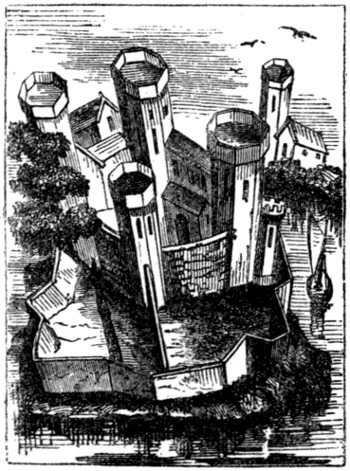
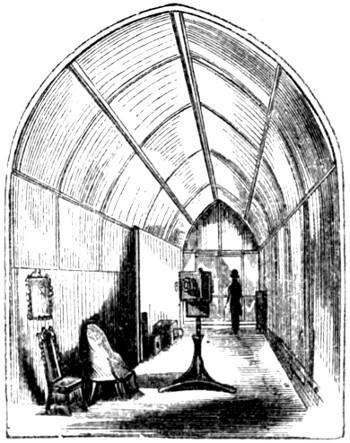
Associated with the use of iodine and bromine is an art which every intelligent boy may practise, if he will attend to the following precise details kindly furnished by Mr. Richard Thomas, of 10, Pall Mall, who has devoted many years to the careful study of all the processes connected with it, and from whom all the best apparatus and purest chemicals required may be obtained.
1. The edges of the glass should be ground all round, also slightly on the surface of the edges. This prevents contraction of the film, enabling it to resist the action of a heavy stream of water. Mark one side in the corner with a diamond, and upon this side bestow the greatest care.
2. To clean the glass, if new.—Make a mixture of spirits of wine and solution of ammonia, equal parts; render it as thick as cream with tripoli; with a piece of cotton-wool kept for this purpose rub a small quantity over that side marked as described, wash well under a tap of water, and wipe dry with a piece of old linen, washed without soap, and kept scrupulously clean for this purpose. Plates should not, however, be cleaned in the operating room with the above[473] mixture; the vapour of ammonia might prove injurious to the chemicals.
3. Now polish with an old white silk handkerchief. If this latter precaution be not taken, small particles of linen will be left upon the plate: these are perhaps only seen when draining off the collodion; they form nuclei and eddies, checking the collodion in its course. Some of these minute fibres are washed off, and contaminate the next picture. To all lovers of clean pictures our advice therefore is, having well dried the plate with old linen, lay it, clean side upwards, upon a few sheets of common glazed demy paper (not blotting), and rub it hard with the silk until sensibly warm: this has the double advantage of dispersing fibres and moisture, for all glass plates are slightly in a hygrometric condition. Double the silk rubber up to form a pad, and with this the glass must be firmly dusted down just before pouring on the collodion, which will then run most evenly: if the coated plate is now viewed by transmitted light, not a speck or blemish will be seen upon it. When a plate cleaned as above described is breathed upon, the moisture does not evaporate slowly, but flies off. Do not be afraid of putting the glass into an electrical condition with the silk rubber: on this account objections have been raised to the use of silk: practically, however, I find it a most valuable auxiliary in this starting-point of the process, the perfect manipulation of which makes an important difference in the value of the finished picture. What can be more inartistic and annoying to an educated eye than spots, patches, stars, and sky rockets, the forms and shapes of which rival, in numberless variety, a display of fireworks? Let us not, therefore, be contented with pictures, however good in other respects, presenting these deformities—so many blots on the photographic escutcheon.
To clean a glass after having used it, when not varnished.—Wash off the collodion film with water, then clean the marked side with plain tripoli and water, and dry as above.
To coat the plate.—First remove all the particles of dried collodion from the mouth of the bottle. Now pour upon the centre of the cleaned glass as much collodion as it will hold. Do not perform this operation hurriedly, take time, and systematically incline the plate in such a manner that the collodion may run into each corner in succession; when perfectly covered, pour off gently the excess into the bottle at one of the corners nearest to you: with observation and practice dexterity is easily acquired. There are many ways of coating the plate; each person will adopt that which practice teaches him is best. The pneumatic plate-holder is a convenient little instrument to use for holding the plate whilst pouring on the collodion: it may be used for both small and large plates.
Keep the corner of the glass plate in contact with the neck of the bottle whilst pouring off the collodion; otherwise the film will be wavy in places.
4. As soon as the collodion ceases to run, plunge the prepared glass gently, without stopping, into the nitrate of silver bath, which is prepared as follows. Into a 20-oz. stoppered bottle put nitrate of silver, 11⁄4 ozs.; distilled water, 4 ozs.: dissolve. To this solution add iodide of potassium, 4 grs., dissolved in 1 drachm of distilled water. Mix these two solutions: the precipitate (iodide of silver) thus formed is by shaking entirely dissolved. Add 16 ozs. of distilled water, when the excess of iodide of silver is again thrown down, but in such a finely divided state as to render the saturation of the bath with iodide of silver perfect. Now drop in sufficient of the oxide of silver to turn the turbid yellow solution a dirty brown colour; so long as this effect is produced the quantity of oxide of silver, however much in excess, is of no consequence; shake the bottle well for ten minutes or so at intervals; then add alcohol, 30 minims, and filter; to the filtered solution add dilute nitric acid of the strength stated, 5 minims. The bath is now ready for use, and should be quite neutral.
5. Allow the prepared glass to remain in this bath from five to ten minutes, according to the temperature. Move it up and down three or four times whilst in the bath, in order to get rid of the greasy appearance on the surface: drain it, but not too closely. When in the frame, place upon the back a piece of common blotting-paper, to absorb moisture, and the two lower silver wires should also be covered with slips of blotting-paper; after which the sooner it is placed in the camera the better.
6. The time of exposure can only be ascertained by practice—no rules can be laid down; and I am unacquainted with any royal road, but that of experience, leading to constant success in this most important point.
7. The plate having been taken from the camera, and placed upon a levelled stand, or held in the hand, develop immediately the latent image with the following solution:—
Iron developing solution.—Protosulphate of iron, 1⁄4 oz.; glacial acetic acid, 1⁄4 oz.; spirits of wine, 1⁄2 oz.; distilled water, 8 ozs.: mix. Pour on of this solution only enough to cover the plate easily, commencing at that edge of the negative which stood uppermost in the camera; move the solution to and fro until it has become intimately mixed with the silver on the plate; then pour off into the developing glass, and at once return it on to the plate. When as much intensity has been obtained as possible with the iron developer, it should be thoroughly removed by washing with water. Any intensity may be obtained afterwards by using either of the following solutions:—
8. Intensifying solution.—Pyrogallic acid, 6 grs.; glacial acetic acid, 1⁄4 oz.; distilled water, 6 ozs.: mix. A few drops of a 30-gr. solution of nitrate of silver, the quantity to be regulated according to the intensity required, to be added, at the moment of using, to as much of the pyrogallic solution as may be necessary.
Intensifying solution (another form).—1. Pyrogallic acid, 8 grs.; citric acid, 20 grs.; distilled water, 2 ozs. 2. Nitrate of silver, 8 grs.; distilled water, 2 ozs. Mix small quantities of the solutions 1 and 2, in equal portions, the moment before using.
The pyrogallic solution, made with good acetic acid, may be kept for a month or more in a cool place. Nevertheless, if the conditions of light and situation are unfavourable, I should prefer this solution just made. The iron solutions act best when freshly prepared.
It is supposed by some that a prolonged action of the iron developer produces fogginess. This may be the case when impure or improperly prepared collodion is used, but certainly not when the preparation is pure and of the proper quality.
When the image is sufficiently intense, wash freely with common filtered water; then pour on a saturated solution of hyposulphate of soda, which should immediately remove the iodide of silver: wash again well with water; allow as much as the plate will hold to soak in for at least a quarter of an hour, changing the water occasionally, to remove all traces of hyposulphate; lastly, wash the plate with a little distilled water, stand up to dry, and, if required, varnish either with spirit or amber varnish.
The following solution is also very commonly used for fixing the negative:—Cyanide of potassium, 1⁄4 oz.; water, 12 ozs.
Attention to the following rules and cautions will assist the operator in the production of perfect pictures:—
1. Do not disturb the deposit which will occasionally be found at the bottom of the bottle containing the collodion.
2. Remove all particles of dried film from the neck of the bottle before pouring the collodion on the plate.
3. Never use damp cloths, leathers, or buffs, for giving the final polish to the plate. Negatives with an indistinct and muddy surface are frequently produced from this cause.
4. Let the film set properly before immersion in the nitrate of silver bath: its condition can be ascertained by gently touching the lower part of the coated plate with the end of the finger.
5. Never omit to pass a broad camel-hair brush over the plate just before pouring on the collodion.
6. Bear in mind that, as light is the producing agent, so will it prove a destructive one: not less than four folds of yellow calico should be used to obstruct white light; and in that case the aperture covered should be no larger than is necessary to admit sufficient light for working by. Examine occasionally the yellow calico: when this material is used to exclude white light, it becomes bleached by constant exposure. Do not trust alone to any coloured glass; no glass yet made is anti-actinic under all aspects of light and conditions of exposure.
7. When the negative requires intensifying, carefully wash off all traces of the first developing solution before proceeding to intensify.[476] This operation may be performed either before or after the iodide is removed by fixing.
8. Glass baths are preferable to porcelain, ebonite, or gutta-percha baths for solution of nitrate of silver.
9. In using either spirit or amber varnish, before pouring it off, keep the plate horizontal a few seconds. This gives time for soaking in, and prevents the formation of a dull surface arising from too thin a coating.
10. Rub the lenses occasionally with a soft and clean wash-leather; the rapidity of action is much influenced by the brightness of the lenses: their surfaces are constantly affected by moisture in the atmosphere, which condensing, destroys the brilliancy of the image.
11. The white blotting-paper used for some photographic purposes is not suitable for filtering solutions; that only should be employed which is made for this purpose, and is sold under the name of filtering-paper.
12. Hyposulphate of soda.—A great deal of rubbish is sold under the name of this salt. As a test of its quality, 11⁄2 drachms should entirely dissolve in 1 drachm of water, and this solution should dissolve rather more than 41⁄2 grains of iodide of silver.
13. Chemicals.—The purity of photographic chemicals cannot be too strongly urged; the cheapest are not always the most economical. The commercial preparations are generally not to be depended upon, as these, though perhaps unadulterated, are, strictly speaking, not chemically pure. It is best to procure them from well-known chemists, who understand the purpose for which they are intended, and make the preparation of these substances peculiarly a branch of their business.
14. Never leave chemical solutions exposed in dishes: when done with, pour them back into glass-stoppered bottles, and decant for use from any deposit, or filter if necessary.
15. In all photographic processes it is absolutely necessary to be chemically clean; and this sometimes is not easy. As a rule, never be satisfied with cleanly appearances only, but take such measures as shall insure the absence of all extraneous matter in preparing the solutions, cleaning the glasses, dishes, &c.
16. All stains on the hands, linen, &c. may be removed by means of cyanogen soap or cyanide of potassium, which should be applied without water at first, then thoroughly washed off. To assist the operation, the hands may be now gently rubbed with a fine piece of pumice-stone, when the stains quickly disappear.
For more perfect and complete directions the reader is referred to a most excellent work, “The Modern Practice of Photography,” by R. W. Thomas, F.C.S.
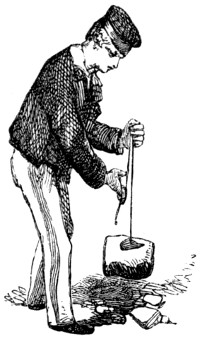
The branch of the physical sciences which relates to the air and its various phenomena is called Pneumatics. By it we learn many curious particulars. By it we find that the air has weight and pressure, colour, density, elasticity, compressibility, and some other properties with which we shall endeavour to make the young reader acquainted by many pleasing experiments, earnestly impressing upon him to lose no opportunity of making physical science his study.
The common leather sucker by which boys raise stones will show the pressure of the atmosphere. It consists of a piece of soft but firm leather, having a piece of string drawn through its centre. The leather is made quite wet and pliable, and then its under part is placed on the stone and stamped down by the foot. This pressing excludes the air from between the leather and the stone, and by pulling the string a vacuum is left underneath its centre; consequently the leather is firmly attached to the stone, which enables you to lift it.
Shut the nozzle and valve-hole of a pair of bellows, and after having squeezed the air out of them, if they are perfectly air-tight, we shall find that a very great force, even some hundreds of pounds, is necessary for separating the boards. They are kept together by[478] the weight of the air which surrounds them in the same manner as if they were surrounded by water.
Place a card on a wine-glass filled with water, then invert the glass: the water will not escape, the pressure of the atmosphere on the outside of the card being sufficient to support the water.

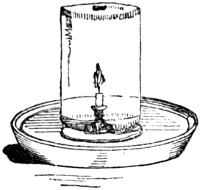
Invert a tall glass jar in a dish of water, and place a lighted taper under it; as the taper consumes the air in the jar, the water, from the pressure without, rises up to supply the place of the oxygen removed by the combustion. In the operation of cupping the operator holds the flame of a lamp under a bell-shaped glass. The air within this being rarefied and expanded, a considerable portion is given off. In this state the glass is placed upon the flesh, and as the air within it cools it contracts, and the glass adheres to the flesh by the difference of the pressure of the internal and external air.
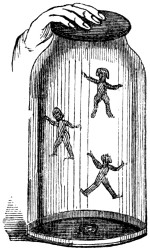
This can be shown by a beautiful philosophical toy, which may easily be constructed. Procure a glass jar such as is here represented, and put water into it. Then mould three or four little figures in wax, and make them hollow within, and having each a minute[479] opening at the heel, by which water may pass in and out. Place them in the jar, as seen in the figure, and adjust them by the quantity of water admitted to them, so that in specific gravity they differ a little from each other. The mouth of the jar should now be covered with a piece of skin or india-rubber, and then, if the hand be pressed upon the top or mouth of the jar, the figures will be seen to rise or descend as the pressure is gentle or heavy; rising and falling, or standing still, according to the pressure made.
The reason of this is, that the pressure on the top of the jar condenses the air between the cover and the water surface; this condensation then presses on the water below, and influences it through its whole extent, compressing also the air in the figures, forcing as much more water into them as to render them heavier than water, and therefore heavy enough to sink.
The time was, and that not very long ago, when the air-pump was only obtainable by the philosophical professor or by persons of enlarged means. But now, owing to our “cheap way of doing things,” a small air-pump may be obtained for about a guinea, and we would strongly advise our young friends to procure one, as it will be a source of endless amusement to them; and, supposing that they take our advice, we suggest the following experiments.
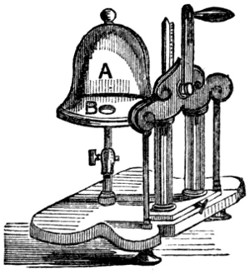
The air-pump consists of a bell glass, called the receiver, A, and a stand, upon which is a perforated plate, B. The hole in this plate is connected with two pistons, the rods of which are moved by a wheel handle backwards and forwards, and thus pump the air out of the receiver. When the air is thus taken out, a stop-cock is turned, and then the experiments may be performed.
Under the receiver of an air-pump, when the air has been thoroughly exhausted, light and heavy bodies fall with the same swiftness. Animals quickly die for want of air, combustion ceases, a bell sounds faint, and water and other fluids change to vapour.
Take a florence flask, fitted up with a screw and fine oiled silk valve. Screw the flask on the plate of the air-pump, exhaust the air,[480] take it off the plate, and weigh it. Then let in the air, and again weigh the whole, and it will be found to have increased by several grains.
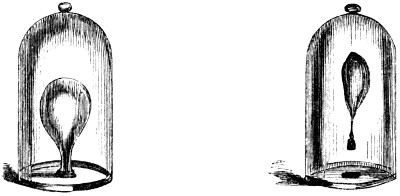
Place a bladder out of which all the air has apparently been squeezed under the receiver, upon it lay a weight, exhaust the air, and it will be seen that the small quantity of air left within the bladder will so expand itself as to lift the weight. Put a corked bottle into the receiver, exhaust the air, and the cork will fly out.
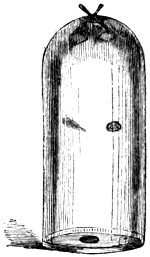
Place a nicely-adjusted pair of forceps at the top of the receiver, communicating with the top of the outside through a hole, so that they may be opened by the fingers. Then place on each of the little plates a sovereign and a feather. Exhaust the air from the receiver; and having done so, detach the objects, so that they may fall. In the open air the sovereign will fall long before the feather, but in vacuo, as in the receiver now exhausted of its air, they will fall both together, and reach the bottom of the glass at the same instant.
Take a fresh egg, and cut off a little of the shell and film from its smaller end; then put the egg under a receiver, and pump out the air; upon which all the contents of the egg will be forced out by the expansion of the small bubble of air contained in the great end between the shell and the film.
Set a lighted candle on the plate, and cover it with a tall receiver. The candle will continue to burn while the air remains, but when[481] exhausted will go out, and the smoke from the wick, instead of rising, will descend in dense clouds towards the bottom of the glass, because the air which would have supported it has been withdrawn.

AIR IN THE EGG.
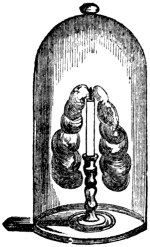
DESCENDING SMOKE.

AIR IN THE EGG.

DESCENDING SMOKE.
Set a bell on the pump-plate, having a contrivance so as to ring it at pleasure, and cover it with a receiver; then make the clapper sound against the bell, and it will be heard to sound very well; now exhaust the receiver of air, and then when the clapper strikes against the sides of the bell the sound can be scarcely heard.
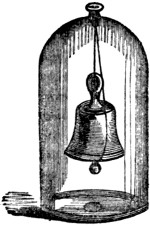
SOUNDLESS BELL.

FLOATING FISH.

SOUNDLESS BELL.

FLOATING FISH.
If a glass vessel containing water, in which a couple of fish are put, be placed under the receiver, upon exhausting the air the fish will be unable to keep at the bottom of the glass, owing to the[482] expansion of the air within their bodies, contained in the air bladder. They will consequently rise and float, belly upwards, upon the surface of the water.
The diving bell is a pneumatic engine, by means of which persons can descend to great depths in the sea, and recover from it valuable portions of wrecks and other things. Its principle may be well illustrated by the following experiment. Take a glass tumbler, and plunge it into the water with the mouth downwards, and it will be found that the water will not rise much more than half way in the tumbler. This may be made very evident if a piece of cork be suffered to float inside the glass on the surface of the water. The air within the tumbler does not entirely exclude the water, because air is elastic, and consequently compressible, and hence the air in the tumbler is what is called condensed. The diving bell is formed upon the above principle; but instead of being of glass, it is a wooden or metal vessel, of very large dimensions, so as to hold three or four persons, who are supplied with air from above by means of powerful pumps, whilst the excess of air escapes at the bottom of the bell, as may be seen any day at the Royal Polytechnic Institution.

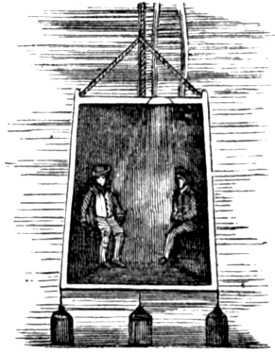
1. Place a cylinder of strong glass, open at both ends, on the plate of the air-pump, and put your hand on the other end, and you will of course be able to remove it at pleasure. Now exhaust the air from the interior of the cylinder, and at each stroke of the pump you will feel your hand pressed tighter and tighter on the cylinder, until you will not be able to remove it: as soon as the air is again admitted to the interior of the cylinder, the pressure within will be restored, and the hand again be at liberty.
2. Tie a piece of moistened bladder very firmly over one end of a similar glass cylinder, and place the open end on the plate of the pump. As soon as you begin to exhaust the air from the interior, the bladder, which was previously quite horizontal, will begin to bulge[483] inwards, the concavity increasing as the exhaustion proceeds, until the bladder, no longer able to bear the weight of the superincumbent air, breaks with a loud report.
3. The elasticity of air, or indeed of any gaseous body, may be shown by introducing under the air-pump receiver a bladder containing a very small quantity of air, its mouth being closely tied. As you exhaust the air from the receiver, that portion contained in the bladder being no longer pressed upon by the atmosphere, will gradually expand, distending the bladder until it appears nearly full: on readmitting the air into the receiver, the bladder will at once shrink to its former dimensions.
A shrivelled apple placed under the same conditions will appear plump when the air is removed from the receiver, and resume its former appearance on the readmission of the air.
4. There is a very pretty apparatus made for the purpose of showing the pressure of the atmosphere, consisting of a hollow globe of brass, about three inches in diameter, divided into two equal parts, which fit very accurately together. It is furnished with two handles; one of them screwed into a hollow stem, communicating with the interior of the globe, and fitting on to the air-pump: the other is attached to a short stem on the opposite side of the globe. In the natural state the globe may easily be separated into its two hemispheres by one person pulling the handles, but after the air has been exhausted from the interior it requires two very strong men to separate the parts, and they will often fail to do so. By turning the stopcock, and readmitting the air into the interior of the globe, it will come asunder as easily as at first.
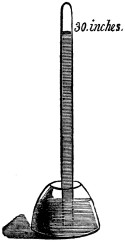
We are indebted to the weight of the atmosphere for the power we possess of raising water by the common pump; for the piston of the pump withdrawing the air from the interior of the pipe, which terminates in water, the pressure of the atmosphere forces the water up the pipe to supply the place of the air withdrawn. It was soon found, however, that when the column of water in the pipe was more than thirty feet high, the pump became useless, for the water refused to rise higher. Why? It was found that a column of water about thirty feet high exerted a pressure equal to the weight of the atmosphere, thus establishing an equilibrium between the water in the pipe and the atmospheric pressure.
This is the principle on which the barometer, or measurer of weight, as its name imports, is constructed. The metal Mercury is about thirteen and a half times heavier than water; consequently, if a column of water[484] thirty feet high balances the pressure of the atmosphere, a column of mercury thirty inches high ought to do so also—and this is in fact the case. If you take a glass tube nearly three feet long, and closed at one end, and fill it with mercury; then, placing your finger on the open end, invert the tube into a basin or saucer containing some of the same metal; upon removing your finger (which must be done carefully, while the mouth of the tube is completely covered by the mercury,) it will be seen that the fluid will fall a few inches, leaving the upper part of the tube empty. Such a tube with a graduated scale attached is in truth a barometer, and as the weight of the atmosphere increases or decreases, so the mercury rises or falls in the tube. This instrument is of the greatest value to the seaman, for a sudden fall of the barometer will often give notice of an impending storm when all is fine and calm, and thus enable the mariner to make the preparations necessary to meet the danger.
It was discovered by an Italian philosopher named Torricelli, and from him the vacuum formed in the upper end of the tube above the surface of the mercury has been called the Torricellian vacuum. It is by far the most perfect vacuum that can be obtained, containing necessarily nothing but a minute quantity of the vapour of mercury.
Pass a little ether through the mercury in the tube, and as soon as it reaches the empty space it will boil violently, depressing the mercury, until the pressure of its own vapour is sufficient to prevent its ebullition. If you now cool the upper part of the tube, so as to condense the vapour, the pressure being thus removed, the ether will again begin to boil, and so alternately, as often as you please, in order to show this fact with effect, the bore of the tube should not be less than half an inch in diameter.
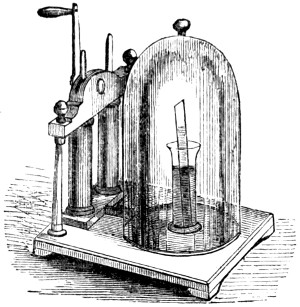
To show that the heat abstracted by the boiling of one liquid will freeze another, fill a tall narrow glass about half full of cold water (the colder the better), and place in it a thin glass tube containing some ether. Put them under the receiver of an air-pump. As you exhaust the air, the ether will begin to boil, until at length, by continuing the exhaustion, the[485] water immediately surrounding the tube of ether will freeze, and a tolerably large piece of ice may thus be obtained.
Ether evaporates so rapidly even under the pressure of the atmosphere, that a small animal, such as a mouse, may be actually frozen to death by constantly dropping ether upon it. If poured on the hand, it produces a degree of cold that soon becomes, to say the least, unpleasant.
Place a flat saucer containing about a pound of oil of vitriol under the receiver of the air-pump, and set in it a watch glass containing a little water, supported on a stand with glass legs. Exhaust the receiver, when the water will evaporate, but without boiling; and the vapour being absorbed as it forms by the oil of vitriol, the vacuum is preserved, and the evaporation continues, until the vapour has abstracted so much caloric from the remainder of the water that it is all at once converted into ice.
In most elementary works on chemistry may be found a long table of freezing mixtures, as they are called, some with and others without ice or snow. We have selected a few from each division.
| WITH ICE OR SNOW. | ||||
| - | Snow or powdered ice | 2 | parts. | |
| Powdered common salt | 1 | „ | ||
| - | Snow | 5 | „ | |
| Powdered common salt | 2 | „ | ||
| Powdered sal ammoniac | 1 | „ | ||
| - | Snow | 3 | „ | |
| Dilute sulphuric acid | 2 | „ | ||
| - | Snow | 2 | „ | |
| Crystallized muriate of lime | 3 | „ | ||
| WITHOUT SNOW OR ICE. | ||||
| - | Sulphate of soda | 3 | parts. | |
| Dilute nitric acid | 2 | „ | ||
| - | Nitrate of ammonia | 1 | „ | |
| Water | 1 | „ | ||
| - | Phosphate of soda | 2 | „ | |
| Dilute nitric acid | 1 | „ | ||
| - | Sulphate of soda | 2 | „ | |
| Muriatic acid | 1 | „ | ||
The effects of most of these mixtures may be considerably increased by previously cooling the ingredients separately in other freezing mixtures.
In connexion with this branch of science, and especially with chemistry, the youthful philosopher should practise the art of decanting[486] air from one jar to another standing over water, beginning by passing it from a small to a larger jar, then with two of equal size; and when he can accomplish the transfer without permitting even one bubble to escape, he may essay the much more difficult task of transferring the air from a large to a smaller jar.

He should also practise using the blowpipe until he can keep up a steady and uninterrupted flame for ten minutes or a quarter of an hour, without stopping for breath. It is quite possible to replenish wind in the mouth, which alone ought to be used, without interrupting the breathing for an instant, but it requires some practice.

(1) Box blowpipe, A, the stem; B, the mouthpiece; C, the box, in which is placed a piece of sponge to absorb the moisture of the breath; D, the extremity (this is moveable, and each blowpipe has several, with different apertures); E, the hollow pivot, in which the extremity and its arm turn. The box is opened by the milled ring seen at the bottom.
If the youthful student wishes to occupy his leisure in a most amusing and instructive manner, and at the same time to acquire a ready method of testing for the presence of the various metals, he cannot do better than purchase from Mr. John Browning, of 111, Minories, the Amateur’s Spectroscope, price two guineas; or, if sufficiently ingenious, a prism and lenses may be purchased for sixteen shillings, and fitted up in paper tubes. Indeed, it is always better to buy some complete set or portion of a set of apparatus, instead of the trashy so-called “Boys’ Cabinets,” which contain very much that is useless and very little for instructive experiments.[487] The instrument enables the observer to examine the properties of metallic salts when in the state of a glowing or incandescent gas. Common light affords a continuous spectrum or band of colours, red at one end and violet at the other, the intermediate colours being orange, yellow, green, blue, and indigo. The spectra of the metals in the state of luminous vapour are not continuous, but are represented by distinct bands or lines of light.
Solar Spectrum, and Spectra of the Alkanes and Alkaline Earths. Copied from the Original Drawings of G. Kirchhoff and R. Bunsen.
 |
|
| Ka | |
| Na | |
| Li | |
| Sr | |
| Ca | |
| Ba | |
| Spectrum of the Metal discovered by Professor Bunsen. |
Solar Spectrum, and Spectra of the Alkanes and Alkaline Earths.
Copied from the Original Drawings of G. Kirchhoff and R.
Bunsen.
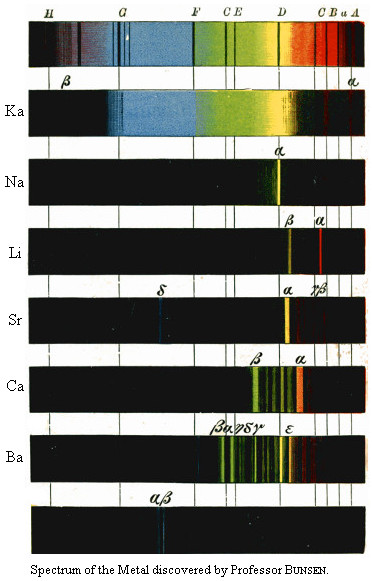
Every element, metallic or otherwise, when converted into a luminous gas, produces lines which are always found in the same part of the spectrum, and are therefore unalterable in position. The instrument (Fig. 1) is called the Spectroscope.
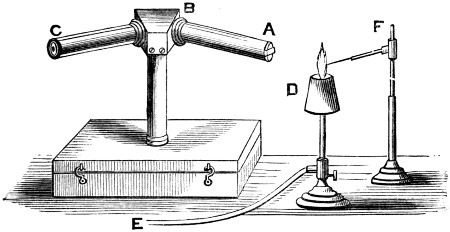
Fig. 1.—THE AMATEUR’S SPECTROSCOPE.
A, Tube with knife edges; B, the prism; C, the telescope; D, the lamp, supplied with gas by pipe E; F, stand carrying the platinum wire. The wire may be held in the hand, but is more convenient when attached to a stand.
The instrument (Fig. 2) will exhibit the dark fixed lines in the solar spectrum, and also the bright lines in the spectra of incandescent metals.
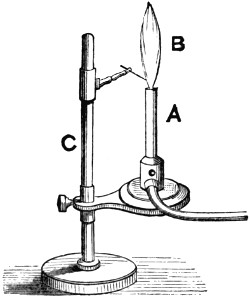
Fig. 3.
A, another form of gas lamp; B, the flame; C, adjusting stand to carry the platinum wire and the lamp.
Screw the tube carrying the knife edges at the small end into the prism bore, and the telescope into its proper ring. Now place any common bright light exactly in front of the knife edges, and while looking through the telescope arrange the knife edges until a bright and continuous spectrum is visible.
Remove the bright flame from the front of the knife edges, and substitute in its place the flame of a common spirit lamp or, still better, a gas-jet known as a Bunsen’s Burner. Take a piece of platinum wire about the substance of a fine sewing needle; bend the end into a small loop about the eighth of an inch in diameter; fuse a small bead of the substance, or salt, to be experimented on into the loop of the platinum wire, and attaching it to any sort of light stand or support, bring the bead into the front edge of the flame, a little below the level of the knife edges. If the flame be opposite the knife edges, on looking through the eye-piece of the telescope the fixed lines due to the substance will be plainly visible. When minute quantities have to be examined, the substance should be dissolved, and a drop of the solution, instead of a solid bead, be used on the platinum wire.
The delicacy of this method of analysis is very great. Swan found, in 1857 (Ed. Phil. Trans., vol. xxi. p. 411), that the lines of[489] sodium are visible when a quantity of solution is employed which does not contain more than 1⁄2,500,000 of a grain of sodium.
To view Fraunhofer’s lines on the solar spectrum it is only necessary to turn the knife edges towards a white cloud, and make the slit formed by the knife edges very narrow by turning the screw at the side of them. In every instance the focus of the telescope must be adjusted in the ordinary way, by sliding the draw tube until it suits the observer’s sight, and distinct vision is obtained.
It should be noted that lines at various parts of the spectrum require a different adjustment in focussing the telescope.
The small prism turning on a joint in front of the knife edges is for the purpose of showing two spectra in the field of view at the same time. To do this it must be brought close to the front of the knife edges. Then one flame must be placed in the position in which the flame of the candle is shown in the small figure, and the other directly in front of the slit. On looking through the telescope, as before described, the spectra due to the two substances will be seen one above the other.
When the slit is turned towards a bright cloud, and a light is used in the position of the candle flame, the spectrum of any substance may be seen compared with the solar spectrum. In this manner Kirchhoff determined in the solar spectrum the presence of the lines of the greater number of the elements which are believed to exist in the sun.
This instrument is expressly adapted to the prismatic analysis of organic bodies, according to the method recommended by Professor Stokes in his lecture at the Chemical Society, printed in the Chemical News.
To observe these bands it is only necessary to place a very dilute solution of the substance in a test-tube, then fix the test-tube in the small clip attached to a ring which slips on in front of the knife edges. Upon bringing any bright light in front of the tube, on looking through the telescope, if the instrument has been properly adjusted, a bright spectrum will be seen, interrupted by the dark bands due to the substance in solution.
One of the simplest and most interesting experiments of this kind can be made by preparing dilute solutions of madder, port wine, and blood.
In these very dilute solutions no difference can be detected by the unassisted eye, but on submitting them in the manner already described to the test of spectrum analysis, very different appearances will be presented.
The absorption bands may, however, be most conveniently examined and accurately investigated by means of Sorby and Browning’s new Micro-Spectroscope.
Place the eye-piece with cross wires in the telescope, with the cross in the shape of an X. Then move the telescope so that the point where the wires cross comes successively in contact with the various lines, noting the readings of the nonius on the arc. From these readings, by the help of any mechanical scale of equal parts, a map may be easily constructed.
By the assistance of spectrum analysis four new metals have been discovered, viz. Cæsium, Rubidium, Thallium, Norium. It is often a cause of grumbling with young beginners in chemistry that there is so much washing of glasses and slopping required to obtain proper results from tests; but here is a most refined mode of testing, which may be carried on in the drawing-room, and so delicate that a portion of sodium salt even less than 1⁄180,000,000th part of a grain can be easily detected.
Formerly the metal Lithium was considered to be a very rare one, but since the use of the spectroscope, quantities less than the 1⁄6,000,000th of a grain have been detected; it now appears that lithium is a very common metal, and exists in the human body, the sea, and may be obtained from many other common sources. Lithium has been found in the ashes of marine plants, the ashes of tobacco—in milk, coffee, tea, human blood, and in muscular tissue; it has also been found in meteoric stones.
The coloured plate is a faithful copy of Kirchhoff’s Diagram, and shows the solar spectrum, also the spectra of potassium, sodium, lithium, strontium, calcium, barium, rubidium.
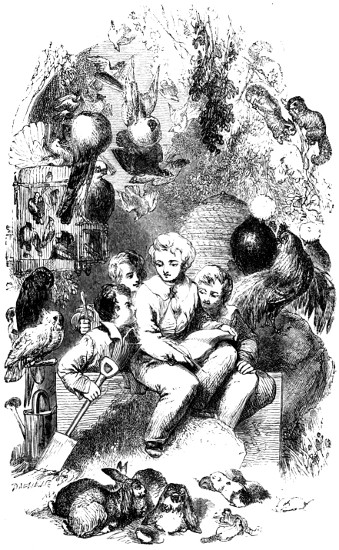
OUR DOMESTIC PETS.
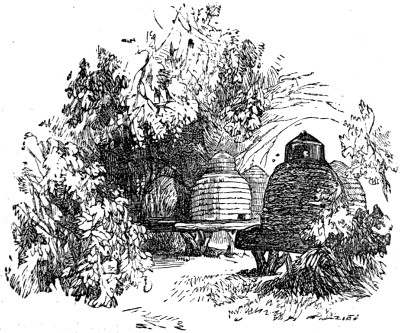
In treating of that useful insect the honey-bee, we will first explain briefly the domestic economy of the hive, and the distinction between the different individuals composing the entire colony, and then pass on to the more practical details of bee-keeping.
A beehive contains three kinds of individuals—a queen, drones, and workers. The queen is a female, and is the mother of the community. The drones are males, and the working bees neuters, being neither males nor females. During the warmer part of the year the queen seems to be incessantly employed in laying eggs. She is slow and majestic in her motions, and differs from the workers in having a larger and longer body, shorter wings, and a curved sting.
The drones are males; though much more bulky, they are not so long as the queen, but much larger than the working bees. They live on honey, but bring none home. When the season for swarming has passed, the workers expel them from the hive, and none make their appearance till the following spring.
The working bees are the smallest in the hive and by far the most numerous; and they do the entire work of the community—they build the cells, guard the hive and the queen, collect[494] and store the honey, elaborate the wax, feed the young, and expel the drones. The average number of these three kinds of bees in a hive is one queen, two thousand drones, and ten to twenty thousand workers, the numbers varying with the strength of the hive and the season.
For the greater part of the year the queen lays only workers’ eggs; but during the spring she also lays those which produce drones. As soon as this takes place, the workers begin to construct royal cells, in which, without discontinuing to lay the drone eggs, the queen deposits eggs which are destined to produce queens.
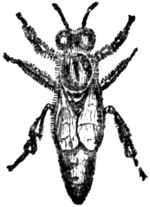 |
 |
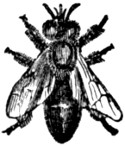 |
| QUEEN BEE. | THE DRONE. | WORKING BEE. |

QUEEN BEE.

THE DRONE.

WORKING BEE.
The workers’ eggs hatch in a few days, and produce little white maggots, which immediately open their mouths to be fed; these the workers attend to with the greatest care. In six days each maggot fills up its cell; it is then roofed in by the workers, spins a silken cocoon and becomes a chrysalis, and on the twenty-first day it comes forth a perfect bee. The drones emerge on the twenty-fifth day, and the queens on the sixteenth.
The combs of a beehive comprise a number of hexagonal cells, built by the bees as receptacles for honey and for the nurseries of their young. Each comb in a hive is composed of two ranges of cells, backed against each other. There is a continued series of these double cells in every well-filled hive, the spaces between them being just sufficient to allow two bees, one on the surface of each comb, to pass without touching. Each cell is six-sided, the six sides being perfectly equal. This is one of the geometrical figures that ensures the greatest economy of material and the largest space. The construction of several combs is usually going on at the same time, until the hive is filled. The cells of the drones are larger than those designed for the workers; and those designed for the hatching of the young queens pear-shaped, with the small end downwards. The finest honey is stored in new cells constructed for the purpose of receiving it.
The usual modes of establishing an apiary are, either by the purchase of stock or of swarms. When intending to purchase a stock, do not buy upon recommendation, but learn to judge for yourself.[495] If you observe the bees crowding in and out of the hive during the middle of the day, a considerable number of them having little yellow pellets or balls on their hinder legs, a very favourable opinion may be formed of the health and condition of the interior, and especially of the prolific state of the queen. If the bees appear savage, and bold in their attacks, it is a good sign.
In the purchase of swarms the young bee-keeper must beware of imposition; for it very often happens that, instead of having the first swarm, he is cheated by having a second thrust upon him. This is seldom so large; but it has the advantage of a young queen, as the old queen always goes off with the first swarm. A good swarm generally numbers about twenty thousand bees, and may in country places be obtained for from half-a-guinea to a guinea.
There are several distinct systems of bee-keeping, each of which requires a short notice. First, the old-fashioned plan of keeping the bees in a common bell-shaped straw hive, or skep. When this method is followed, the hives are usually allowed to stand for two summers; at the end of the second season the bees are destroyed by the fumes of burning sulphur, and the honey taken. The plan is a very bad one, as the honey obtained is mixed with bee bread, is rank in flavour, and dark in colour, and is never worth more than about sixpence per pound.
A great improvement is to have the hives made with flat tops, like the straw hive shown at the right hand of the engraving. When the bees are first hived, this is closed by a straw mat. In the spring of next year, when the bees become numerous and cluster round the entrance, this mat is removed, and a small hive, termed a “super,” or a box or glass, neatly furnished with a piece or two of clear empty comb, is put over; the bees ascend into this, build combs, which they store with pure virgin honey, without brood or bee bread; and this, when full, is removed, leaving the stock below undisturbed for the next season. In our engraving the artist has drawn this hive too small; it should have been as large as the common skeps which are shown on the left-hand side.
Flat-topped hives, that are able to be supered, may be made of wood, like a common box. One of these is shown on the ground, and two, placed one over the other, are shown behind the flat-topped straw hive. In Ayrshire, where they are very skilled in bee-management, they use eight-sided boxes, with narrow slides to close the openings in the top. These boxes are placed one over the other, and large tops of pure virgin honey, twenty to thirty pounds in weight, are not unfrequently taken off. The back hive in our group is one with side boxes, or, as it is sometimes called, a collateral hive. These are the most expensive in first cost, and the least productive of all the varieties. The cottage hives, with three little glasses, instead of one large one, are only playthings, and not at all productive.
Frame hives, in which each comb is placed in a separate frame, so that it can be taken out and examined, are very useful for making observations on the natural history of the bees, but are not so well suited for profitable purposes as the hives that we have described that are arranged in storey or with large supers.
In removing a super of honey, it should be first loosened from the hive by drawing a thin string between the two; and then, when the bees have become quiet, taken quietly away, and covered over, until those remaining in it have discovered that they are away from the queen, when they will rapidly fly back to the hive, on being uncovered. But the honey must not be left exposed, or it would attract all the bees in the neighbourhood, and would rapidly be stored up in the hives.
In taking off the supers, it is best to be protected from the stings of the bees. This is readily done by making a bag of leno, open at top and bottom; in use, the top is tied round the hat, the bag encircles the head and face, and the bottom is tucked under the collar of the coat, which is buttoned closely round the neck. In this manner the face is perfectly protected from stings; but with the knowledge, quietness, and confidence acquired by practice, almost anything can be done to bees by a skilled bee-master, even without a veil.
The canary is a justly favoured pet among boys, for it is a hardy bird that requires a very small amount of trouble. It is a pleasant, fascinating little being, full of quaint ways and sprightly attitudes, and, better than all, the cage is its native element.
Though an ardent admirer of all birds, and indeed of everything which draws the breath of life, we can never pass the cage wherein is confined a lark, a nightingale, a bullfinch, or any other of our indigenous birds, without a feeling of sadness and regret.
They are not cage birds, and never ought to be confined within the narrow limits of wood and wire. Their attitudes show their uneasiness. The mellow, exultant tone of the skylark sounds as joyously when the bird is imprisoned within a cage as when it soars high in air, its wings quivering in the breeze, its frame rejoicing in the glory of the sunbeams, and its ken surveying the wide panorama which lies spread beneath its gaze. But the gestures of the bird are full of eloquent misery, and speak volumes to him who will stop and look with his eyes as well as listen with his ears.
See how the bird flings itself upwards from the little patch of turf, which is but a shallow mockery of the green sward to which the skylark is accustomed—how it dashes itself against the roof of green baize, which represents so feebly the expanse of azure sky—and how it learns at last the lessons of experience, and stands helplessly in the bay window of the cage, its wings shivering restlessly, and its feet trampling impatiently, in lieu of the the upward leap and soaring flight which it longs to undertake, but which it will never more be permitted to experience. No more will it roam through the wide expanse of air, no more will it seek for its mate, and know all the joys of nest and children. Henceforth it is but a prisoner in solitary confinement, without hope of escape, and its very individuality destroyed by surrounding circumstances.
So with the generality of our cage birds. The man who would imprison the nightingale, who would limit to one spot the bird that loves to wander, and who would condemn to solitary confinement the creature which is peculiarly destined for conjugal affection, which finds expression in liquid melody, ought to be imprisoned for a month or two, just to see how he likes it. “I can’t get out,” is the lament uttered in silent gesture by all birds[498] that ought to roam in wild freedom, and have been imprisoned in a cage. We always wish to open the cage door, and set free the prisoner; at all events, to remove it to some spot where it might be liberated without danger to itself.
But with the canary the case is different. The pretty little bird never has known wider freedom than that of the cage, and a humane bird-keeper will endow it with increased freedom by enlarging the size of its dwelling. The free use of wings has never been known to the bird, nor even to its parents; and the perch is to the canary more familiar than the bough. Release an imprisoned lark, and after the first few moments of surprise it will speed away exulting in its freedom. Release a nightingale or a thrush, and it will dart swiftly to the well-known shelter of the woods. But release a canary, and you have committed an act of positive cruelty. The poor bird knows not where to go or how to procure its food. Throughout all its little life it has been accustomed to reside within the narrow limits of its cage, and to find its food and water prepared without any expenditure of labour. Consequently, it has no idea of searching for food, but sits bewildered on a branch of some tree, and would perish with hunger simply because it does not know how to procure food.
Ignorance is ever the parent of fear, and a canary-bird has been known to perish of hunger when removed to a large from a small cage, simply because it dared not fly down from the comparatively lofty perch on which it had settled when first introduced, and to which it clung with the tenacity of fear. Even the genuine British soldier can hardly be more helpless when deprived of ordinary military routine than is a canary-bird when set free and forced to fly alone into the world.
The very colour of the bird prevents it from obtaining food like others of the same tribe. All the small birds are absurdly jealous of novelty, and will mob and worry any feathered being to which they are not accustomed. You may assemble a crowd of them at any time by fixing a comb of scarlet cloth on the head of a sparrow, and glueing a few scarlet hackles into its tail. The little birds will always gather round an owl that has made its appearance in the daytime, and will scold the intruder until one would think that their throats would be hoarse. Their anger towards the owl is, however, mitigated by a wholesome dread of its beak and talons, and it may therefore be imagined that when they find a little yellow bird sitting all alone on a branch, and looking bewildered at the position in which it finds itself, they are not very likely to lose so excellent an opportunity of bullying a foreigner without danger to themselves. Successive generations of captivity have rendered the canary unfit for freedom, and therefore the young naturalist need not think himself cruel because he keeps the bird in a cage.
As to cages, the simple form which has already been described in vol. i. p. 21 of “Every Boy’s Magazine” will be found amply sufficient for all purposes. The wires, however, should be closer together than is required for squirrels, so that the cat may not be able to dart her lithe paw between them and hook out the inmates. The size of the cage is of little consequence, except that you can never make it too large. If a whole room can be given up to the birds, the better they will be pleased and the brighter they will look; and, if possible, it should be lighted from above.
Wherever the birds may be placed, ventilation is of the greatest consequence. We remember being once summoned to give our opinion upon the continued illness of some canaries of which every care was taken. They had fresh water daily, were plentifully supplied with sand, and were fed with the proper seeds, and cresses, groundsel, and other green meat, and yet they drooped and moped, and never seemed well. No fault could be found with the arrangements, and therefore we looked for the cause of illness in another direction. The air of the room seemed very close when I entered it, and on examination we found that there was no outlet whatever, the chimney having been blocked up and the windows carefully shut, in order to prevent the birds from escaping. We at once recommended that a pane of glass should be removed at the top of the window, and a piece of perforated zinc inserted instead; and when this was done the birds recovered themselves, and resumed their normal aspect.
The two secrets—if secrets they can be called—in bird-keeping are a good supply of fresh food and water and perfect cleanliness. The former necessaries can be easily insured in a very simple manner, and should be made after the pattern of the accompanying figures. Both are founded on the same principle—namely, that of self-feeding from a reservoir.
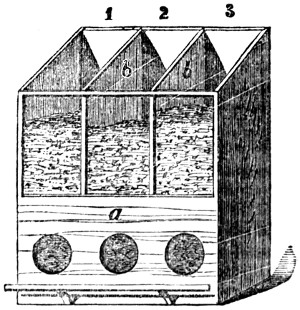
Fig. 1.
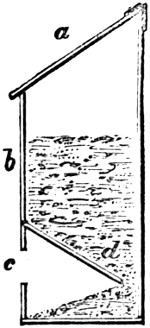
Fig. 2.
The seed-box is thus constructed. Get an old cigar-box, from which the aroma of tobacco has been removed by long airing, and take off the lid and the whole of one side; cut off two-thirds of the lid-piece, bore three holes in it, and fix it where the lid was, as at a; cut the rest of the lid in two, and fix the pieces in the box, so as to separate it into three compartments, fixing them with glue and a few very tiny brads. You should use pieces of slender brass wire for the purpose. If you left the box in this condition all the seed would run out at the round holes, and you must therefore correct that error.
How this is done will be seen in fig. 2, which gives a section of the seed-box.
Cut a squared piece of wood, which will just slide into the partition, so as to make a flat flooring to it. But, instead of laying it flat, place it in a sloping direction, as seen at d, so that a small space is left between the end of the floor and the back of the box.[500] The reader will see that when the seed is poured into the partition it will drop through the open space at the back, and fall into the bottom of the box. The birds put their heads through the holes to eat the seeds, and as fast as they peck them away below, more fall from above and supply the deficiency.
In the front, and above the holes, fix a piece of glass, which is represented by b in fig. 2, and which is seen in its place in fig. 1. The object of the glass is to permit the bird-keeper to see when there is a sufficiency of seed. The sloping top is also of glass, which is fixed by a strip of American leather, acting as a hinge. It is made of glass, and set at a sharp angle, in order to prevent the birds from perching on it, which they are certain to do if they can find the least foothold. It will be found that the best cement wherewith to fix the glass is gold-size, and that a coat or two of black sealing-wax varnish makes a nice finish to the job.
The holes through which the birds feed should not be much larger than the size of their heads. The reason of this arrangement is that the canaries are apt to shell the seeds while their heads are over the vessel in which the food is contained, so that the husks fall among the seed, and it is not easy to discover when the supply is exhausted. But no diurnal bird will feed in the dark, and as the canary effectually darkens each hole by introducing its head, it will not crack and eat the seed until it has withdrawn its head and restored itself to light.
The object of the partitions is that the birds can be supplied with different kinds of seed, each of which can be restricted to its own division. The receptacles should be of different sizes—the largest for canary-seed, the next in size for rape, and the least for millet, among which a little hemp may be shaken. In front of the[501] holes, and about three-quarters of an inch from them, should be fixed a perch, upon which the birds can sit while they feed.
At the back of the seed-box are fastened a couple of stout hooks—those which milliners call “stay-hooks” answer admirably—so that the box may be hung on the wires at any convenient height. It should not be placed on the ground, because in that case the canaries will stuff all the refuse stems of the green-meat into the feeding-holes, and will probably mix sand and husks with the seeds. They are as mischievous as monkeys, and quite as ready at discovering and taking advantage of the slightest opportunities of doing something which they know is forbidden.
The “fountain” from which they drink is made on a similar principle. Fountains can be purchased at any bird-dealer’s; but as it is preferable that boys should use their hands rather than drain their pockets, we offer simple directions for making a fountain as efficacious, though not quite so elegant, as those which are purchased in the shops.
The materials required for the purpose are very simple, and consist of some wire, both stout and fine, of an empty Florence-oil flask, a saucer, and some wood. The mode of employing them is shown by the illustration (fig. 3).
Make three rings of stout wire, each diminishing in diameter, and arrange them as seen at b, the smallest being uppermost. Four pieces of stout wire are then firmly attached, so as to make a kind of conical stand. Were not the birds so mischievous, this would be sufficient for all purposes; but as they are sure to go and bathe in the water, they must be kept out by intermediate wires, so as to make a kind of cage, through which the birds can put their heads, but which will not permit the passage of their bodies.
Then take your oil-flask, strip off all the rushen covering, and[502] wash the interior with strong soda until every trace of the oil is removed. Place it in the wire frame, as shown at c, and try whether it stands upright. If the wire ring should be too large, and allow of its slipping through too far, cut a round hole of the proper size in a piece of pasteboard or very thin wood, lay it on the ring, and then introduce the flask.
Make a round stool or table, such as is seen in the illustration, and fix the turned-up ends of the wires to it with small staples. If the fountain were on the ground, the birds would fill the saucer with sand and husks; and if it were not firmly fastened, it would be knocked over by the fluttering wings of a passing bird. The stool must be wide and strong, or the whole affair will be upset.
The mode of preparing the fountain is very simple. Fill the flask with water, and stop up the mouth with a shallow cork. Place a saucer (like a) under the wire frame, insert the flask, hold its mouth in the saucer with one hand, and remove the cork with the other. The water will immediately rush into the saucer, and will half fill it, but owing to the pressure of the atmosphere no more water will descend. When, however, the birds have drunk enough to bring the level of the water below the mouth of the flask, air immediately rushes up in great bubbles, down comes a corresponding amount of water, and a fresh supply is thus afforded.
In canary-keeping much depends upon the kind of bird. We presume that a good singer will be required, as well as a strong and healthy bird. If you are not learned in canary lore, try to induce an experienced friend to choose a bird for you; but if you are not fortunate enough to possess such assistance, the following concise directions may aid you. Look at the birds for sale, and note those that stand straightest on their perches, and that hop quickly and smartly about the little apologies for cages in which they are mostly confined. Next hear them sing before deciding on your purchase, and select the one that possesses the sweetest and fullest tone. The dealer can always make the bird sing when he likes, and if any bird refuses to sing, do not buy it, however handsome it may look. If possible, procure one that possesses the nightingale’s song; you will have to pay rather heavily for it, but any one who can afford such a bird will be amply repaid by the very great superiority of the song, which is divested of that ear-piercing shrillness so unpleasant in most canaries.
When you are satisfied with the song, look the bird well over to see that it has no defects; and if you prefer the variegated breed, take care of three principal points—namely, the top of the head, technically called the “cap;” the markings on the back, called “spangles;” and the number of quill feathers in the wings and tail. The cap must be uniform and rich in colour, the spangles bold and well defined, and the quill feathers not less than eighteen in each wing and twelve in the tail. Imperfect or damaged feathers can[503] easily be replaced by pulling them out, for their places will soon be filled with new and perfect feathers.
Some persons prefer the yellow varieties, and many are fond of the crested canaries.
We intentionally omit all mention of “fancy” canaries, for the fashion changes with them as fast as it does with tulips or dress. The fashion in canaries seldom outlives a year, and the prize bird of one year will possibly be despised in the next season. Do not, therefore, be persuaded to attempt the purchase of costly fancy canaries. They may certainly be of great value when you happen to buy them, but in a few years no one will think anything of them. Choose strong, sweet-voiced, and healthy birds, with colours that please your eye, and leave the fancy canaries to professional breeders.
As to the general management of the canary, it may be summed up by saying that it chiefly consists in judiciously letting alone. Don’t meddle with the birds more than is absolutely needed, and do not worry them with medicines whenever they seem to be unwell. As, however, all canaries are liable to certain ailments, in which a knowledge of the proper treatment is highly useful, we will just give a few plain directions.
One pest is vigorous throughout the year, and always ready to seize on the birds, and that is the “red-mite,” a parasite known to all bird-keepers.
If you find your birds restless, especially at night, and see them continually pecking among the roots of the feathers, and especially if they lose appetite, and become fretful and ill-tempered to their companions, look out for the red-mite. You can always detect the tiny but formidable foe by placing the bird in a dark room, and, after a few hours, holding a bright lamp close by the cage. If there are any mites about, you will soon see them crawling upon the perches, the wires, and even showing themselves among the feathers. They are not larger than the dot over the letter i, but their numbers are often very considerable, and the injury they inflict is great.
Let not one escape, for it may be the parent of hundreds more. When the red-mites have once obtained possession of a cage, their extirpation is a task of very great difficulty to those who do not understand the constitution of the creatures. So difficult, indeed, is the business, that many fanciers will not even attempt it, but burn the cage and buy another. The metal cages, which are now so common, are preferable to those made of wood and wire, inasmuch as they present very few spots wherein the red-mite can find a hiding-place, and for that reason metal is to be preferred to wood. Even if they have gained admission to an ordinary cage, they can be extirpated without very much trouble. We have succeeded in doing so in several instances, and think that in a fortnight any cage can be freed of its troublesome parasites.
First place the cage in the sun for a short time, so as to induce the light-hating mites to leave the bird and hide themselves in the crevices of the cage. Remove the bird, and transfer it to another cage, or even a box, and let it wait. Take the cage and examine it well, introducing a heated needle or thin blade of iron into every crevice. Next take some insect-destroying powder, force it into a hollow paper cylinder, light the paper, put it into the cage, and envelop the whole in a newspaper. Leave it there for an hour, and when you remove it you will see dozens of the red-mites, of all sizes, lying dead on the floor, or clinging half-stupefied by the fumes of the powder. Scrape them all into boiling water, and dust the whole of the cage with the powder.
By this time every mite will be dead; but there is a goodly store of eggs which will be hatched in due time, and infest the cage anew. These are destroyed by means of oil. Take a camel’s hair brush and some salad-oil, and with the brush apply the oil to every crevice. If there should be the tiniest scratch on the wood, touch it with the oil. Let oil be applied to every spot where the wires enter the wood, where they cross each other, and where the hinges of the door are fixed. Every egg will thus be destroyed, and the cage freed.
About half an hour before you restore the bird to the cage hold it in the left hand, and dust it well with the powder, blowing up the feathers, so as to get it well to the roots. Scatter some of the powder upon a piece of soft rag, and roll the bird in it, carefully binding down its legs and wings, under each of which a pinch of powder must be sprinkled. You can now attend to the head, which requires rather neat handling, as the powder is very apt to settle upon the eyes and to worry the bird. Let your feathered pet lie for half an hour in this beneficial bondage, and then replace it in the cage, scattering some powder upon the floor. The bird will shake its plumage sharply, and send a cloud of dust flying, and in a minute or two will begin to peck among the feathers and settle the plumage. The different aspect of the bird is then quite remarkable, for it exchanges the fussy, anxious, fretful moments for quiet ease, and even when it does peck among the feathers, it does so gently and deliberately, and seems quite another bird.
Moulting is a disorder to which the canary is annually subject, and which requires some little attention. Some time in the autumn all the canaries exchange the feathers which have endured the wear and tear of a twelvemonth for a completely new suit. Feathers are subject to damage in many ways, and just before the moult takes place the bird is quite ragged and disreputable in dress. Meanwhile the germs of new feathers have been growing in the sockets which held the old suit, and in the course of a few weeks all the feathers are shed and replaced by others. It may easily be[505] imagined that such an operation is not achieved without much physical disturbance, and it is accordingly found that all birds are more or less indisposed during the time of the moult.
Scarcely any two birds are affected in precisely the same manner, and the “moulting sickness” tells with especial severity upon the young. Quiet and nourishing food are the best remedies for the curious mixture of languor and fever which is always visible among the birds; and the most accomplished canary-breeders are in the habit of giving the yolk of hard-boiled eggs, and even a little raw meat, scraped and cut very fine. Sometimes, in their desire for animal food, the birds pluck the newly-formed feathers from the bodies of their companions, and nibble the still vascular and bleeding ends. Wine is recommended by some fanciers, but we cannot agree with them. The moult is a natural ailment, and the remedies which are best calculated to modify its effects upon the health are those to which the natural instincts of the birds would lead them.
Frequently the claws and bill of the canary become overgrown, and produce very unpleasant results; the latter causing much difficulty in taking food, and the former entangling the foot in the wires of the cage. The remedy in either case is the same. Take the bird in the left hand, and hold it against the light; the overgrown portions of the claws will then be easily distinguished, inasmuch as a delicate scarlet line runs along the centre of each claw and nearly reaches its extremity. Taking this line as your guide, you carefully cut off the overgrown parts with a sharp pair of scissors, and cause thereby immediate relief to your feathered patient. The bill must be cut in the same way, but requires a little more care and some neatness in trimming. No pain is given to the bird when the operation is rightly conducted, for neither bill nor claw possesses sensation.
Dysentery and diarrhœa are very common among cage birds, and should be treated, the former with a drop or two of castor-oil, and the latter with a lump of chalk to peck at, and a rusty nail in the water.
Sometimes the bird loses the feathers of the head and neck, and presents a most ungainly appearance. In such cases rub the head with almond-oil, and feed the bird for a few days on a mixture of lettuce, scalded bread, olive-oil, and a sprinkling of maw seed. Health will soon return, and at the next moult the bird will recover its lost plumage.
Broken legs are of frequent occurrence, and mostly happen by the bird entangling itself in the wires and then struggling to free itself. Overgrown claws are a fertile cause of this misfortune. Do not try to bandage or in any way to meddle with the leg; but put the bird in a separate cage, take away the perches, place the food and water within reach, so that the patient may partake of[506] them without needing to stand, and wait until the limb is healed. The bones unite very rapidly, and in a week or ten days the limb will be nearly as strong as before the accident, and will betray no sign of the recent misfortune.
It is to be supposed that each reader of these pages is either the possessor of a dog, or desires to obtain that privilege, and that he will wish to learn in a few lines the best way of managing and training his favourite.
There are many works which treat of the Dog; but all those which are trustworthy are of very large dimensions, necessarily costly, and contain a vast amount of information which is very valuable to the owner of hounds, to the sportsman, or to the game-keeper, but is not required by the generality of those to whom these words are addressed. We have, therefore, endeavoured to condense into the few pages which can be allotted to a single subject all the information which is absolutely needed by those who keep dogs merely for amusement and the love of their society.
Firstly, we may answer here a question that is often asked—namely, which is the best breed of dogs for ordinary purposes? We of course exclude all the strictly sporting dogs, such as the foxhound and harrier, the greyhound, and perhaps the bull-dog, though there is something to be said in favour of the last-mentioned, and somewhat maligned, animal.
The tasks that we wish to impose on the dog are light and simple. We want him to be watchful at night, to alarm the house at the sound of a strange step on the premises; if possible, we want him to be courageous enough to attack an intruder. We want him to be a pleasant companion in our daily walks, to hunt after anything at which we may set him, to swim after any object that we may point out, and to retrieve anything for which we may send him. At the same time, we want him to be completely under command, and to be obedient at the least word or sign.
Lastly, we want him to be cleanly and comfortable in the house, to know how to keep out of the way when he is not wanted, and to be sufficiently clever to learn all kinds of amusing performances.
Where, then, shall we find an animal that is capable of fulfilling all these conditions?
There are several varieties of dogs which are well suited for general purposes. There is the spaniel for example, faithful, affectionate, clever, and docile. There is the poodle, perhaps the[507] best “trick” dog in the world, with his funny curly coat and his soft brown eye, full of intelligence almost human. There is the Newfoundland dog, who is perhaps almost too big to be a dweller within the house. There is the terrier, an amusing, bright-eyed, agile-limbed, fussy animal. There is the Italian greyhound, one of the most beautiful animals in the world, but too delicate to please the taste of a boy. There is the Scotch terrier, that odd, wiry-haired, clever creature, which has so often been immortalised by affectionate owners.

THE SPANIEL.
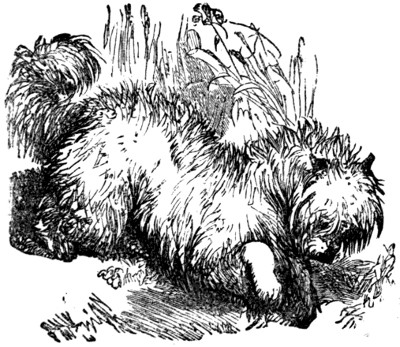
THE TERRIER.
All these varieties are delightful animals, and we like them all. But had we the choice of a dog, we should take neither of them, preferring a mixture between the terrier and the bull-dog, provided, of course, that each were of good breed. Many people fancy that a bull-terrier is a dangerous dog to have about the house, and imagine that it is given to biting without due cause, and is too savage to be turned into a pet.
But much of this misapprehension may be traced to the long-established and popular error regarding the bull-dog. It is seldom that a favourable account of this animal is given, and it is thought to be brutal, stupid, vindictive, and irreclaimably ferocious. It is impossible to deny that too many bull-dogs agree with this description; but it is equally impossible to deny that whenever they possess such bad characters the fault lies almost entirely with their master. “Like master, like dog,” is an old and true saying, which has been based on the experience of many years.
If the bull-dog is properly treated, if the owner makes the animal his companion, and if he carefully studies its character, as every pet owner ought to do, encouraging the good qualities, and gently reproving the bad, it will be as gentle and much more quiet than a King Charles or a toy terrier. Looks are certainly against the animal. There is, perhaps, no creature with a more fell aspect than a thorough-bred bull-dog. Its underhung jaw, its glittering teeth, its sunken eyes, its tremendous chest, and lowering countenance are calculated to inspire terror rather than interest.
Yet, when a bull-dog is managed with a due appreciation of canine nature, its aspect thoroughly belies its true nature. We know a thorough-bred bull-dog belonging to a friend, one of the fiercest and most sullen-looking beasts imaginable. Every one gives the animal a very wide berth; and we confess that when we first saw it we thought that its owner was not acting very wisely in permitting it to walk about unmuzzled. Yet this creature is playful and harmless as a kitten. Its great jaws look positively awful as it opens its mouth, and until its real qualities are known, it requires some little presence of mind to withstand its playful rush.
For a pet, however, the bull-dog is scarcely suited, not being sufficiently active or lively. The purely-bred English terrier, on the other hand, is as mercurial a beast as one can wish to see; but it has little steadiness of purpose, is apt to run riot, and is a rank coward, not daring to face a rat, and having serious doubts before it can make up its mind to attack a mouse; therefore the skilful dog-fancier contrives a judicious mixture of the two breeds, and engrafts the tenacity, endurance, and dauntless courage of the bull-dog upon the more agile and frivolous terrier. Thus he obtains a dog that can do almost anything, and though perhaps it may not surpass, it certainly rivals, almost every other variety of the canine species in its accomplishments. In the capacity for[509] learning tricks it scarcely yields, if it does yield at all, to the poodle. It can retrieve as well as the dog which is especially bred for that purpose. It can hunt the fox with the regular hounds. It can swim and dive as well as the Newfoundland dog. In the house it is one of the wariest and most intelligent of dogs, permitting no unaccustomed footstep to enter the domain without giving warning. It will chase rabbits, weasels, rats, or, indeed, any game, with unextinguishable ardour, and will fight any foe at which its master may set it.

THE BULL DOG.
One fault indeed it has. It is just a trifle too quarrelsome with other dogs, and when it meets a strange individual of its own species, and has gone through all the preliminaries of back-arching, bristle-setting, sotto voce growling, and the various performances with which two strange dogs greet each other, it is a little too apt to cut matters short by challenging the other to instant combat. Even this fault, however, is easily overcome by a kind but firm master, who can impress upon his pupil that it is not to fight anything at which he has not set it.
And here let us make a few remarks upon the management of dogs.
Severity is not at all needed, but firmness of purpose is indispensable. Patience and good temper are also two requisites, without which no one should attempt to manage a dog. The animal must be made to feel that when an order is given it has to obey at once, and not even the very slightest act of disobedience should be passed unnoticed. He will soon learn that lesson, and the rest is easy.
If you can procure a dog in his early puppyhood, it is certainly the very best method, and you will not require a whip; but should the animal have attained maturity, you may employ this instrument, but must use it with the greatest discretion. If the dog is worthy of the name, you can punish him in a far more effectual way by appealing to his sense of shame than by flogging him; but if you once lose your temper, and begin to inflict a beating on the animal, half your influence will vanish.
If the dog wilfully disobeys you, as will often be the case when he is full-grown and is trying your mettle, take him by the neck, tell him how wicked he has been, and give him one very sharp blow; not more than one,—because if you do so he gets so frightened that he forgets all about the scolding. Then let him have another chance, repeat the order, and if he disobeys again, inflict another stroke. He is not likely to offend a third time; and when he obeys the order, speak kindly to him, praise him, and make much of him,—for you can do more with a dog by praise than by rating.
With a dog which you have possessed from puppyhood there is seldom the least necessity for severity. The creature is so accustomed to do what his master desires, that he hardly conceives the possibility of disobedience. Gentle firmness is all that is necessary in such a case; indeed, we are always opposed to the infliction of pain, except in rare instances, where it is the only means by which the animal can be taught the necessity for obedience.
We cannot bear to see a dog look up to its master with the half-frightened, half-shrinking expression which is observable in one that has been accustomed to the whip. The animal ought to consider its master as its best friend, and to run to him when it is in distress, rather than to fear his presence and tremble at his voice.
The Rev. J. G. Wood, writing on this subject, says:—
“My dear old Rory used to be most abjectly miserable when he had offended me. His frisky tail and pretentious ears would droop on such occasions, his easy assured carriage would sink into a listless, spiritless gait, he would hide his head like a naughty child, he would not leave or enter the room openly, but would make the transit of the apartment by slinking under the chairs and tables, so[511] as to keep himself out of sight as much as possible. He would crawl under my chair, and after waiting some time in hopes that I should notice him, would just push his nose against my heel, and then retreat again to his hiding-place. He would not eat, nor drink, nor sleep, nor be comforted by any one until I had spoken the desired words of forgiveness.
“And then, when the first words of reconciliation were spoken, how he would advance with hope beaming in his countenance, still mixed with diffidence, lest he should have mistaken the tone of voice. And when he was quite certain that he was pardoned, when he felt my hand upon his head, how wild he was with delight! How he would jump about, and run from one person to another on his hind legs, and roll over on his back, and pretend to bite every one in turn, and knock the cat over, and bark until he had to be turned out of the room for the sake of preserving the drums of our ears.
“Then how he would get out of the house, dash down the street at full speed, come pelting back again, jump on the window sill, bang with his tail for admission, and then walk quite soberly to his usual place, and lie on the hearthrug just as if nothing had happened.
“There certainly are dogs whose feelings are quite beyond the reach of human sympathies; but it is more than probable that their callousness is attributable to the bad treatment of their owner, and not to any inherent defect in the animal’s nature. In my little book, ‘Glimpses into Petland,’ the reader may see an account of a ridiculous dog who fairly got the better of me by simple vacuity and selfishness. I never saw such a dog in my life, and I really do not want to see such another.
“Nothing could be made of him. He did not care for kindness; he could not be influenced by the whip; he never thought of obeying orders; he got into every scrape in which a dog could by any possibility fall; and was altogether a hopeless subject. Had I been a novice in the management of animals, I should have thought myself in fault; but being tolerably experienced in such matters, I was at no loss to set the failure down to its right source.
“Just before commencing this account, I received a letter from a correspondent who had read the account of ‘Roughie,’ and wrote a vindication of the Skye terrier, to which variety the dog belonged. My correspondent stated that if the Skye terrier were obtained when young, and well treated, it was one of the most affectionate and faithful animals that could be found; but that if it were bandied about from one master to another, it lost all its loving qualities, and became a reckless, selfish beast. Such had evidently been the case with ‘Roughie,’ and thus his peculiar disposition was accounted for.”
We will now just run through the list of the dogs which are best suited for pets. Of the bull-dog we have already spoken, as also of the terrier, which, as we have said, should be, if possible, a mixture of the two varieties. If you can secure a good healthy puppy from well-bred parents, think yourself fortunate, and make much of the dog.
Do not crop his ears. If you have any sporting friends, they will advise you to do so, tell you that it spoils the dog, and give you all kinds of advice about it. Now, in the first place, it is reasonable to think that the dog’s Maker knows best the kind of ear that is most suitable for the dog, and frames it accordingly. If the short, cropped form had really been the best, it would have been made after that pattern, and not left to the scissors of the dog-doctor to complete the work.
So we say to our readers, defy the ridiculous prevailing fashion, and oppose common sense to it. In a few more years this cropping process will be pronounced obsolete and unnatural; so be amongst those who lead opinion, and save your dogs the pain of that cruel and unnecessary process. Not long ago worming was all the fashion. No dog was considered safe unless it had been wormed; that is, unless the under side of the tongue had been cut open, and the central tendon pulled out. Of course, when a tendon is drawn from the living body and laid in the cold air, it contracts and twists about. Therefore it was held to be a worm, and everywhere believed to be the cause of hydrophobia.
Horses, again, were cropped in a most atrocious manner. Their ears were clipped close to their head, and their tails were cut quite short, leaving only a few inches of hair on the stump; so that the French satirist was quite justified in his sneer against the English as a people, who, he said, cut off the tails of their horses and the heads of their kings. The French did both afterwards, with the addition of a queen and a few princes. Nor was this all. The under side of the tail was cut across in several places—nicking, the operation was called—and then the tail was forcibly bent upwards, and tied in that position until the wounds healed, and the member left immovable. Fancy the torture the poor animals must have undergone, the fresh wounds being torn open and exposed to the air!
Mr. Waterton, the venerable naturalist, remarks that in former days he tried to aid the cause of humanity by his example, and rode a horse with a proper allowance of tail and with uncropped ears. The experiment failed. The “arbitrium popularis auræ” was pleased to declare itself against ears and tails. There was such a commotion whenever the humane rider ventured to show himself abroad on a horse which possessed the abominations of ears and a tail—he was so mobbed, and his horse was so reft of his tail by the urchins who wanted fishing-lines—that, for the sake of the beast[513] as well as himself, Mr. Waterton was obliged to conform to the popular verdict, and dock the tail of his horse as a compromise for his ears.
Now, however, the verdict of popular opinion has undergone a change, and horses are permitted to wear their ears and tails; and the time will come before very long when a dog will be thought as much disfigured by having cropped ears as he is now thought to be when he is allowed to wear those members in their natural proportions.
The only rational excuse that can be put forward for adopting such a practice is that which is employed by the owners of game-cocks, when they clip the combs of their feathered protégés. It is, that the length of the ear affords a hold for an antagonist. But as it is not to be supposed that any of my readers are likely to belong to that brutal class of human beings who keep dogs for the purpose of making them fight each other, we may pronounce that not one single valid reason can be urged for depriving a dog of his ears.
There is the poodle, a delightful dog for a pet. They are docile in no ordinary degree, and can learn all kinds of tricks without seeming to take much trouble. Performing dogs mostly belong to this variety, and very amusing are the tricks which they will learn. They will dance a polka with easy skill. They will imitate a ball-room company with such ludicrous burlesque that no one can resist the temptation of laughing. They will walk about on their hind legs, on their fore legs, and have even been seen to walk with the two legs of one side, the other legs being held up in the air.
It was difficult to imagine how they could have been taught such a feat; but it had been done by setting a board on edge, hitching the two legs of the left side over the board, and making the dog walk along in this attitude. After passing along the board three or four times, the dogs found that they could lighten the labour by holding their upper legs clear of the board, and so they soon learned to dispense with its presence.
If you do have a poodle, you must wash him often and carefully, because these long, curly-headed dogs are apt to give out a disagreeable odour unless they are kept very clean. But do not on any account clip his hair in the stupid and ugly fashion that is so often adopted, and which was first imported from France.
In that country they shave all kinds of dogs in the same manner, leaving only a ruff round the neck, a tuft on each leg, and a tuft on the end of the tail. There are men and women who make the clipping of dogs a profession. They have carts with pictures of dogs undergoing the process, and they perambulate the streets in search of patients, just as knife-grinders do in search of work.
When they have collected a goodly assemblage of dogs, they set off to the river side, and take up their station under one of the bridges. The poor dogs, which have been trailing behind the cart at the end of cords, are now bound and muzzled, and miserable objects they look as they lie on their sides awaiting the shears of the operator. The hair that is removed is put into sacks, and sold, it is said, for manure; and the dogs are returned to their owners, metamorphosed out of all knowledge, and shivering at the slightest breeze.
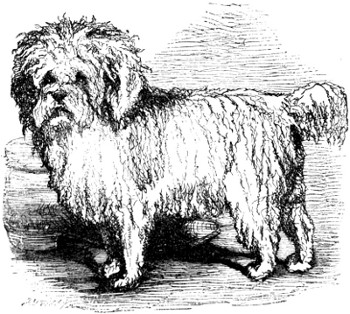
THE POODLE.
If your dog should be ever troubled with ticks and fleas, you may free him from his foes in ten minutes. First tie up his mouth with a piece of broad tape, to prevent him from licking off the substance which is to be applied; and if he is not very well under command, tie his legs also. Then lay him on a cloth, sprinkle him over with the insect-powder, which may be procured in small quantities at No. 33, Newgate Street, and rub the powder well into his fur from his nose to the tip of his tail. When you have done this, roll the cloth round him, and pin it well together, so as to envelop him entirely in its folds.
You may let him lie as long as you like, but ten minutes will mostly be sufficient; then with a hard brush go all over him, and brush out all the powder into the cloth. You will be surprised at the multitude of parasites which will be lying dead and dying in the cloth. The powder, insects, and all should be carefully shot into the fire, and your doggie will be grateful to you for the relief which you have afforded him.
Perhaps next to the bull-terrier ought to come the Scotch terrier, a dog that will hunt anything, and is always a quaint, independent beast, with something of the lawless Highlander about him, but a capital companion for any one who values dogs and knows how to treat them. Spaniels are all beautiful creatures, very affectionate, and often very clever; but their long, silky hair gets sadly bedabbled with mud and wet, and they cannot be admitted into the house until they have undergone a careful purification.
Whatever dog you may have, do not tie him up in a kennel, or, at all events, allow the animal to enjoy human society for some hours daily. Dogs are made savage by this too frequent procedure, especially those whose blood is purest and whose spirits are highest. A dog that is chained to one spot is sure to be irritable and captious, just as would be the case with a man who is tied to one spot. Even the kingly spirit of Napoleon lost its grandeur and became peevish and fretful when that restless and ambitious nature was confined within the narrow limits of a rocky island; and we cannot expect that the mind of a dog should be superior to that of an autocrat.
As to the food of the dog, there is one simple rule,—do not overfeed him; and, above all, never let him have scraps at meal times. It is a very tempting practice, for the dog is so insinuating in the manner of his request, and his thanks are expressed so warmly, that some little strength of mind is required to refuse his demands. Still it is one of the occasions on which the dog’s owner must show his firmness, for there are few more miserable beings than a fat, over-fed dog. His life is a positive burden to him, and the only remedy is to starve him down to his proper dimensions. Give the animal but little meat and plenty of biscuit, feed it once only per diem, and you will be repaid by the healthy and active condition of your pet.
Lastly, as it is likely that the dog may fall into one of those canine ailments which are to dogs what measles and chicken-pox and whooping-cough are to children, we will just give a brief piece of advice.
Distemper is the most common and most annoying of those ailments; and if the services of a professional dog-doctor can be had, let the animal be placed under his care. If no such assistance can be obtained, the best plan is to give the dog no solid food, but to administer gruel or weak broth, to prohibit every kind of exercise,[516] and see that the ventilation and cleanliness of his house are as perfect as possible. Leave the rest to nature; and when the patient is recovering, let it be led about to exercise, so as to avoid over-fatigue, which would, as a matter of course, throw him back again.
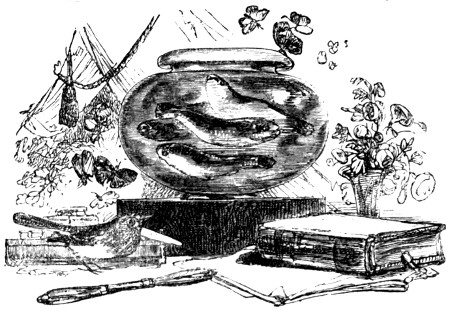
These are of the carp family, and have been known in this country from the year 1691. They abound in the fresh-water ponds, lakes, and rivers of China; nor are they, indeed, at the present time quite uncommon in our own climate, being now naturalised in ponds, and breeding freely in pure waters. At Hampton Court are to be seen some of the finest specimens of the family, originally placed there by Mr. Jesse, to whom the frequenters of that place of public resort are so much indebted. They have increased to several hundreds, and many of them are of prodigious size and very fat, being to fish what royal porters are to men.
The colours of gold-fish are liable to the greatest variation: some are nearly all gold, mingled with red; some are marked with a fine blue, brown, or bright silver hue; but the usually predominant colour is that of a brilliant gold. As an article of food, they are not used; and are only valued for their beauty and gentleness. It is a curious fact in the history of the gold-fish, that it will bear without injury the extremes of heat and cold; as it will live equally well in a tank, in a glass vase, and in a pond in the open air.[517] Instances have been known of gold-fish having been frozen hard and stiff in the water, but yet, upon being gradually thawed, becoming perfectly healthy and well.
Although many preserves of gold and silver fish exist in this country, the supply was principally from Portugal, where they abound. They are brought over in large numbers about spring time; and then numerous perambulatory gentlemen, having purchased a few small glasses of the most inferior description, and fish at twopence each, very moderately ask, and often receive, for a couple of fish, glass, and water the sum of five shillings; but our young friends must beware of such persons, for the fish they sell usually die in a few days or weeks.
The silver-fish differs from the gold-fish only in colour, which is similar to silver tissue: it generally has scarlet fins, and is curiously marked in different parts of the body. Both varieties are also subject to variations in the fins, which are occasionally double; and specimens have been seen with triple tails.
The glasses, or globes, should be moderately large, with wide mouths, and three-fourths filled with water. For two fish the globe should be at least a foot in diameter; and for three or four fish, sixteen inches. They should be kept in a cool place—never exposed to a burning sun, or the heat of a fire. Too many should never be crowded into one glass. A few branches of box should be kept in the globe, for them to rub against, which should be changed once a week.
Some persons fancy that gold and silver fish need no food. It is true that they will subsist for a long time with nothing but water, when it is pure and frequently changed. They are best pleased with such jejune diet as bread or biscuit; but these should be given sparingly, lest, turning sour, they corrupt the water. They will also feed on the aquatic plant called lemna, or duck’s-weed, and also on small fry. Hawkins, the editor of Walton, says that fine gravel should be strewed at the bottom of the vessel that contains the fish; and he directs them to be fed on bread and gentles, and to have their water frequently changed.
You can easily tell when a fish is falling off in his health by observing him frequently coming up to the surface of the water for air. This shows he has not sufficient power in his gills to extract the air from the water. He also looks dull, and his motions are languid; a hazy or cobwebby appearance likewise seems to envelop[518] his body, and perhaps some of the scales will drop off. When a fish gets into this unhealthy state, he should be immediately removed from the others, who should have fresh water given them several days in succession. The best remedy for diseased fish is to put them into a pond for a few weeks; and it is especially necessary for female fish, which, if not so treated, frequently die for want of spawning. A fish is sometimes saved by being placed in a little artificial dam, made from some running stream in a garden, for two or three days; but their diseases are at all times very difficult to remedy. The best way is to prevent them by the precautionary measures—plenty of room and pure water.
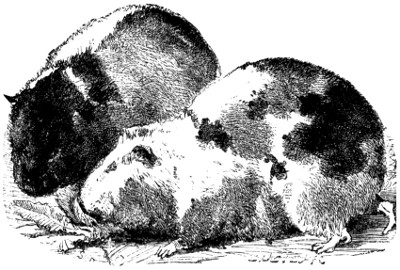
The guinea-pig, or restless cavy, is a prettily-marked, stupid, little animal, which came originally from South America, and has long been a favourite with most little boys, for when a boy becomes a youth he aspires to keeping something more interesting than these senseless little squeakers. Still it is a pretty sight to see the old ones followed by two or three litters, and to watch their antics when pleased, which consist of a squeak and a peculiar sharp turn,[519] as if they tried to jump out of their skins, but could not, for they are fitted in too tightly for that. As for the use they are, why, they eat and sleep—
It is, however, a pretty, harmless, little animal; but as a pet is far inferior to others that are more commonly kept. Though gentle and inoffensive in its manners, it seems incapable of feeling the slightest attachment for those who feed and caress it—even for its own offspring it evinces little or no affection: it will not only suffer them to be destroyed before its face, without making the smallest efforts to defend them, but will even at times devour them itself. For all useful purposes guinea-pigs are utterly valueless, though their flesh is used as an article of food in their native country; and their skins, notwithstanding the beautiful sleekness of their appearance, have as yet been turned to no account by the furrier. Their only recommendations, therefore, are the gentleness of their disposition, the cleanliness of their habits, and the beautiful colouring of their coats. In this latter respect they are very varied; black, white, bright reddish brown, and a mixture of the three, called tortoiseshell, being the principal varieties. The latter are the most prized, particularly where the dark colours predominate.
In their native country they are generally of a pure white, with pink eyes, and it is nothing unusual to have one out of a litter white with pink eyes in this country.
Rats are supposed by many people to have a great antipathy to guinea-pigs, carefully avoiding the place where they are confined. Under this impression—which, however, is an erroneous one—they are frequently kept by fanciers in their rabbit-houses and pigeon-lofts, as a means of protecting their stock against the depredations of those rapacious vermin. They are allowed to run almost anywhere, and to shift for themselves: no attention whatever need be paid to the feeding of them, the mere refuse scattered about the floor being sufficient for their subsistence.
When, however, they are kept for amusement, their cages are generally made precisely similar to the rabbit’s hutch, only of rather smaller dimensions: their treatment, too, in most respects, is much the same as that pursued with regard to that animal. Their ordinary food should be oats given twice a day, and not too many at a time. They are also very fond of bran, which is a cheap diet; and they will fatten upon it, and keep healthy, if allowed plenty of exercise. Green meat should also form a portion of their usual diet, particularly the wild sorts, such as dandelions, sowthistle, plantain, &c.; tea-leaves they are remarkably fond of, but these should only be given them now and then by way of a treat; bread, also, they are very partial to, dipped in milk or water.
They are sold by all bird-fanciers; the prices varying from sixpence to half-a-crown, according to their age, colour, &c.: as before remarked, the dark rich-coloured tortoiseshell ones are considered the most valuable.
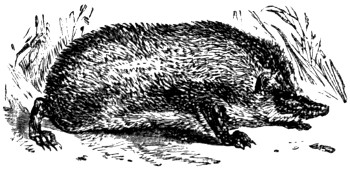
This, though a rough and prickly customer to handle, is a clean little animal, and a great pet with country boys. If you have ever seen one—and they are commonly sold at the shops kept by men who call themselves bird-fanciers, or even hawked about the streets of London by countrymen—if you have seen one, you are aware that, saving the belly, they are covered with sharp spikes, and that when alarmed, or whenever they please, they have the power of rolling themselves up into a tight round ball, which shows nothing but spikes, and may be rolled along, like a cricket-ball, without causing the little animal to uncoil itself, while every spike is firm and erect as a needle, and almost as sharp. While in this shape very few dogs can worry the hedgehog; and as for the fox, who is rather partial to him, true to his wily nature, he rolls the poor hedgehog along with his paws until he comes to a pool of water, when the hedgehog unrolls himself, exclaiming, no doubt, “Hey! why, what’s this? I can’t breathe!” and trying to peep about and see what’s the matter, the fox, on the look-out, seizes him by the belly, and eats him all up, saving the spines. Were you to thrust a dozen pins with large heads through a piece of parchment, you would have an exact representation of the spines of the hedgehog, every one of which is retained inside the skin by the large pin-like head.
Some say that it sucks the cows, and draws off their milk; but this is absurd, as its mouth is not adapted for sucking. Its favourite food are insects and snails: it also feeds on frogs and mice, and will even kill a snake, and eat it all up, beginning at the tail. The way it kills a snake is very curious. It gives the snake a bite on the[521] back, then rolls itself up like a ball, remaining still as a stone for some time, while the snake lashes and writhes about in agony; as soon as the snake is a little quiet the hedgehog gives him another sharp bite on the spine, and so continues until the snake is killed; then he begins at the tail, as the Rev. J. G. Wood tells us in his “Illustrated Natural History,” and eats him up “as one would a radish.” In a natural state it sleeps all the winter, rolled up in a hole which it has filled with grass, moss, or leaves; and when domesticated, it will hide itself in some dark corner for weeks, and never once make its appearance, unless it chances to awake and feel hungry; then some day you will see it come creeping towards the fire, and be very glad to see it too. Hedgehogs are great destroyers of beetles, eating them up as quickly as you would a handful of raisins, and seeming fond of them. They need no looking after at all, but will take care of themselves, though it is as well to have a little hutch to put them into now and then. Their feeding-time is in the night; and if there are black-beetles in the kitchen, the best plan is to leave the hedgehog there, and let him devour all he can catch. They have four or five young ones at a litter, which are born blind. It is no uncommon sight to see a countryman with both old and young ones to sell. You can buy a young hedgehog for sixpence, and an old one for a shilling, or less than that even. We know of no animal that is less trouble to keep, and in time it becomes so tame as to come out of its hiding-place when called.
To procure a raven, an order to a dealer is almost necessary; but every boy should be ashamed if he cannot catch a young jackdaw for himself. These quaint birds make their nests in all kinds of places, especially affecting old buildings, such as church towers, ruins, or colleges. There is hardly an ancient church throughout the kingdom where a basketful of young jackdaws could not be obtained within half an hour, and old ruins positively swarm with them. It is curious to see how birds of such different habits as jackdaws, owls, pigeons, and starlings will roost amicably in the same locality, not appearing to have the least distrust of each other, or making half the fuss about their dwelling-places that is created nightly by the sparrows when settling to rest.
Failing ruins and towers, he will take possession of deserted rook-nests; and in cases of great distress, when the country is wide, where men will not build towers, where rooks and crows will not build nests, he is forced to fly for succour to the sea-shore and the warren, and make his home with the gannets and the rabbits.
Many a person has been surprised, on looking into a deserted rabbit burrow, to find it choked up with a strange mass of sticks and twigs, and still more surprised when he has brought to view a couple of jackdaw’s eggs, or hears the hungry cries of the young birds. This seeming alliance of the rabbit and the jackdaw is not unique, for it is observed in the Coquimbo owl, or burrowing owl, as it is sometimes called, and the prairie dog of North America, both of which reside within the same warren, and seem perfectly satisfied with each other’s company.
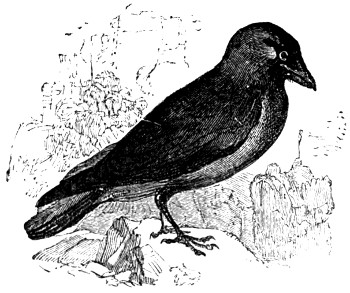
The sea-birds, too, receive the jackdaw into alliance, and whole colonies of these grey-hooded birds may be seen hovering about the lofty cliffs that bound our coasts, crying “Jack! Jack!” in inharmonious chorus with the sea-birds’ wail.
Sometimes a young and too artless bird leaves its nest before it is rightly able to use its wings, and is unable to ascend to the summit of the cliffs, flapping idly about the shore, driven nearer and nearer to the rocks by the advancing tide. The whole colony is roused by the misfortune. They wheel about in the air over the unfortunate bird with cries of distress; they do their best to encourage it to ascend; but their endeavours are all in vain. Time after time it aims at gaining the summit of the cliff, but strikes against the rock, and falls again to the sands.
In some spots it contrives to gain an elevated perch, and then waits the ebb of the tide; but in those places where the rocks afford no resting-place within a moderate distance of the water’s edge the fate of the poor bird is sealed.
Jackdaws are very easily tamed, and become very talkative, after their fashion. Their vocabulary is, however, limited, and is[523] mostly restricted to the word “Jack,” which is uttered on every imaginable occasion. If the bird sees its master coming, it calls “Jack!” in order to express its joy; if it does not see him, it calls “Jack!” in order to induce him to come. If it hears a strange noise, it uses the same remark by way of giving notice; and if it hears its own name, it thinks itself bound to repeat the word as a polite recognition.
It is a very vigilant bird, and is quite as useful as a watch-dog to those who wish to gain early intelligence of strange visitors. It is not nearly so mischievous as many of its compeers, but sits for the greater part of the day on some chosen perch, and thence surveys the objects around. A passing bee or beetle, however, immediately arouses its energies: it pounces on them with unfailing certainty, batters them to a shapeless pulp against a stone, and swallows them leisurely. It will also catch mice, kill them by severe blows of the beak upon the head, pull them to pieces, and eat them systematically, rejecting the skin as indigestible and unsavoury.
As a general rule, it should be left out of the way of water; for it is a positive slave to the bath, and would bathe so frequently that it would not even give itself time to become dry. It may be fed on bread and milk, oats, mice, small birds, insects, meat, or, indeed, upon almost anything that can be eaten by the rapacious or frugivorous birds. It is of an affectionate nature, and will attach itself firmly to those who extend their sympathy towards it.
The jay is a truly handsome bird, and will bear comparison with any of the exotic species of the same genus. Although it does not possess the exuberance of plumage nor the vivid brilliancy of colour that distinguish many of the jays which inhabit the hotter parts of the world, there is great beauty in the softly-toned hues of the general plumage and the boldly-contrasted bars of azure and black upon the wings. The moveable crest upon the head imparts a wonderful intelligence to the expression, and when the bird ruffles up and displays these ornamental plumes, a fresh charm is added to its appearance.
The jay is not nearly so common a pet as the magpie or jackdaw, probably because it is a rare bird, and seems yearly to be diminishing in numbers. It is not so impatient of captivity as the magpie, and will bear confinement in a large cage with tolerable hardiness.
In its native state the jay seems to be rather more of a vegetarian than the previously mentioned examples of the corvine birds. Still it will eat meat, small birds, mice, insects, worms, &c., and has[524] been known to attack and devastate the nests of the thrush and other birds, and devour the half-fledged young. But if any proprietor of a jay is desirous of giving his pet an especial treat, he should supply him with a fresh egg. Any egg will answer the purpose, but if the jay seems to have a preference, the gaily-coloured egg of the thrush, perhaps, is most attractive.
Like the magpie, he will soon learn to talk, and displays powers of imitation scarcely, if at all, inferior to those enjoyed by that lively bird. Even such sounds as the lowing of cattle, the grunting of pigs, the bleating of sheep, or the neighing of horses, are reproduced with marvellous fidelity by the jay, although its ordinary note is a soft and rather pleasing cry.

But what are we to say of the magpie, the very Mercury of the feathered tribes,—light, active, eloquent, and the most accomplished thief in the world? He wears all his bad qualities in the face, is not the least of a hypocrite, and carries off his delinquencies with so impudent an air that no one can help admiring him, however they may object to his principles.
Not being so plentiful in England as the jackdaw, and building his nest on the summits of lofty trees, he is not so readily procured as that bird. He is, however, so extremely amusing in his manners, that most persons would rather expend a little more money in procuring a healthy magpie than give a much less sum for the more[525] phlegmatic jackdaw. His mischievous propensities are proverbial, and anybody who keeps one of these birds must be prepared for the commission of every imaginable delinquency. Nor must he blame the bird if it should happen to steal his watch-chain, peck a hole through his best boots, fill his bed with sticks and pebbles, upset his ink-bottle, tear his papers, put his kid gloves into the dirtiest procurable puddle, or play practical jokes of a similar kind; he has only himself to thank for his carelessness in allowing it access to his domains.
But if he makes up his mind that under such provoking circumstances the blame rests with himself, and that he will not be angry with the bird for following the dictates of its instinct, he will find his magpie a most entertaining companion, as full of odd tricks as a monkey, and as playful as a kitten. It requires very little attention, and provided that he be regularly fed, and furnished with a shelter in case of inclement weather, he will live to a venerable old age.
The fertility of invention that characterises a magpie’s mind is perfectly astonishing, and the anecdotes that are related by every one who has watched his habits are as varied as they are wonderful. There is an amount of self-reliance in the creature which betrays itself in every gesture, as well as in the knowing twist of the head; and the triumphant “carrack” that accompanies a successful piece of mischief and the impudent flirt of the tail afford unmistakeable evidence of the bird’s true character.
None of the corvine birds should be kept in cages. The jackdaw perhaps suffers least from such captivity, and the magpie perhaps the most. It has such a restless nature, that it is ever on the move, and if confined, in a cage, may be seen hopping from perch to floor, and from floor to perch, in miserable monotony of movement. Moreover, his beautiful tail always suffers severely from contact with the bars of the cage; and even if it is not rubbed down to a mere stump, as is frequently the case, it is always rendered ragged and disreputable at the tip.
As a general fact, the ordinary wicker cages are of small use. A lively, active magpie, with all its senses developed, will make little of such a cage. Sometimes he will direct his attention to the door, and never rest until he has pulled it off the hinges. Sometimes he will set deliberately to work, and peck so fiercely and continuously at the bars, that he will break them away in splinters, and make his way out. However, the best plan is to avoid cages; or if the bird really must be placed in confinement, let the cage be roomy, and made of wire.
Perhaps the chief charm of the magpie is his great capability for learning to talk, and his exceeding readiness to display that accomplishment. Some individuals are more eloquent than others, have a clearer articulation and a better memory,—just as is the case among human beings. But though all magpies may not be[526] peculiarly excellent in their powers of conversation, they can all be taught to talk after a fashion, and are seldom chary of exhibiting their powers.
A magpie has been known to imitate the human voice so perfectly that he has induced his dupe to answer his queries, believing them to have been made by the lad whose peculiar voice was so well simulated. Very little trouble is needful to teach a magpie to talk, for his imitative instincts are very largely developed, and he is sure to reproduce with marvellous fidelity the various sounds which he may hear. He can bark like a dog, mew like a cat, cry like a child, scream like a costermonger, and occasionally swear like a trooper. But he means no harm, and may be pardoned for the unrefined language he is sometimes in the habit of using.
Magpies require plenty of water—not so much for drinking, although they are always thirsty birds, but for washing. They are extremely fond of bathing, and a plentiful supply of water is needful to keep their beautiful plumage in proper condition. The food of the magpie is the same as that of the jackdaw.
There are worse pets to be found than owls. They are not so immediately engaging as many creatures that have already been mentioned, but by proper management they can be made into very companionable birds, quaint, grotesque, and affectionate withal.
The chief drawback to the owl as a pet is its nocturnal habits, which cause the bird to sleep during the day and to be awake during the night. To a certain degree this custom may be corrected. The chief reason why the owl wakes at night is, that it preys upon mice and other nocturnal creatures, whether mammals or insects, and must in consequence be able to pounce upon them as they rove abroad.
Now, although at first to wake the owl will be found rather a tedious business, and to keep it awake still more difficult, a present of a mouse, or a small bird, or a large beetle, will generally rouse it, and cause it to remain awake for some little time.
To change the creature into a wholly diurnal bird is impossible, inasmuch as the entire bodily structure, as well as the temperament, is that of a nocturnal being. The eyes, for example, are formed for vision in a very dim light, being of very great size, and with pupils so large that the ordinary light of day is painful to the bird, and dazzles it so much that it cannot see sufficiently to direct its flight. Exceptional cases have occurred, in which owls have been seen abroad in the daytime, and been observed in the act of catching mice at mid-day; but such an event occurs very seldom.
Even when the bird is placed in a comparatively dark room, where the rays of the sun cannot beat upon it, the eyes are continually blinking as long as they are open, and the large nictitating membrane is ever and anon drawn over them. It may here be mentioned that the nictitating membrane is a kind of inner eyelid, made of very elastic membrane, which is gathered up in one corner of the socket, can be drawn over the eye by means of special muscles, and returns by its own elasticity when the tension is removed. It is peculiarly strong in birds of prey, and the best examples of this curious structure are to be found in the owls.
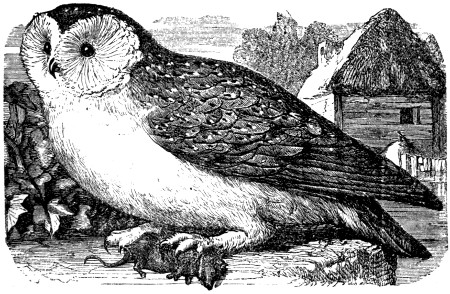
WHITE, OR BARN, OWL
In general, the owl sits, or rather stands, during the daytime, fast asleep, having a very quaint aspect, the eyes being reduced to a mere pair of lines, sloping towards the bill, and surrounded by the round discs of stiff feathers which form a “splayed” window in the dense plumage, and allow the bird a wider scope of vision than it would enjoy if the aperture in the feathers were no larger than the eye itself. Altogether the bird looks wonderfully like a Chinese mandarin of very high rank, and consequently of great obesity; the sloping linear eyelids being just as oblique as those of the Chinamen, and the two feather discs representing the huge round spectacles with which the Chinese are accustomed to aid their vision.
The position of the owl when at rest is rather curious. Instead of sitting with its head reposing on the shoulder, its legs bent, and[528] its claws firmly grasping the perch, the bird stands stiffly upright, with its legs perfectly straight and its head upright. Here we ought to mention the popular error that birds sleep with their heads under their wings. Not only is this mistake impressed upon the young, and fostered by such familiar nursery-rhymes as that of “The north wind doth blow,” but it is in force even among educated persons, who have learned to observe as well as to think. In a recent controversy about fresh air and human lungs some of the advocates for stuffiness and closed windows employed as an argument the imagined fact that, when birds go to sleep, they exclude fresh air by tucking their heads under their wings. The force of their arguments and the accuracy of their facts were about on a par. Many birds compose themselves to sleep, but no one ever yet saw a bird put its head under its wing when going to roost. The real process is simple enough, as any one can prove who will take the trouble to watch a parrot or canary. The bird first settles itself in a comfortable attitude, which varies according to the species, and then turns its head round, and puts its beak among the loose feathers of the shoulder, the wings being kept closed and held firmly against the body.
Owls may be procured in various methods. If the reader should happen to possess proper premises, he will find that to attract owls will be as easy as to buy them, and will give him better opportunities of studying their habits. All that is required is the command of a retired spot, where the birds will not be annoyed. A little ingenuity and the expenditure of a few shillings will do the rest.
It is impossible to have a better or more complete plan of attracting the owls than that which is employed by Mr. Waterton at Walton Hall. He can, and does, attract all kinds of birds to his domain by the simple plan of affording them a secure shelter and the prospect of food. In the case of the owls the first precaution is the only one that is needful, the birds being perfectly capable of finding food for themselves. Possibly a few mice thrown on the ground might assist in attracting the birds; but as they will come when no such precaution is taken, such bait may be omitted.
There is a popular idea that neither the lion, the eagle, or the owl will eat game which they have not killed. Nothing can be more opposed to fact than such a notion: for the lion is generally killed by laying in his haunts a dead animal, which he is sure to eat; the eagle is only too glad to pick up a dead lamb; and the owl will carry off almost any number of dead mice that are placed in its way.
If the reader wishes to attract owls to his premises, he must prepare habitations for them. Knowing that the common barn owl, or white owl, as it is sometimes called, is fond of resting in buildings, Mr. Waterton has taken great pains to erect certain domiciles of which the owls are likely to approve. A large hole[529] made in an old ruin is sure to attract the barn owl, especially if it be well sheltered with ivy, and a stout perch across the cavity may be useful. There are owl-houses in different parts of the domain, all tenanted by some bird, and most of them by the inhabitant for whose use they were made.
The jackdaw is the most pertinacious usurper that can be imagined. Any house that will suit an owl will suit a jackdaw, and the daw is so keen at discovery and so quick at utilizing his faculties, that he takes possession, and fills the hole with sticks, before the owls have a chance of securing their home.
If the brown owl is wanted, there are few places like a hollow tree, an article which can often be purchased very cheaply, set up in the grounds, and its interior arranged for the reception of the birds.
A writer in the Field newspaper has mentioned that he has been very successful in attracting the brown owl by means of an empty eighteen-gallon cask, made very clean, and fastened in a tree. A perch was placed inside, a convenient entrance-hole cut, and a quantity of very dry touchwood placed within. On this touchwood much of the success seemed to depend, for wherever it was omitted the owls declined to take possession of the cask. In order to fit it for its purpose, it was carefully dried in an oven. The exterior of the cask was painted so as to harmonize with the colours of the tree.
Should the reader be unable to fit up such a residence, he may always purchase young owls at a cheap rate, and can train them after his own fashion. In order to show how much amusement may be given by so despised a bird as the owl, the following extract from a private letter is interesting:—
“I saw a curious sight yesterday, which I think quite worth communicating to you. Some folks about us have got a young owl just fledged, and one of the boys had given him for his supper a dead swift, rather high and gamey. While he was enjoying this dainty, a young tabby kitten, æt. about eight weeks, came on the scene, and walking up to the owl, deliberately invited herself to a share in the repast. Mr. Owl did not express any objection, save by expanding his wings over his food, more suo, whereupon pussy crept under the outstretched wing, and went in for her share. It was droll enough to see the two going halves, especially as every now and then the owl got pussy’s ear by mistake, and she in like manner began gnawing at his claw.
“But the scene reached its climax by the appearance of five young ducklings hatched on Thursday last” (the date of the letter shows that it was written on Friday, and consequently that the ducklings in question were just eight days old), “who surrounded the group, and did what they could to help. The smell of the dead bird attracted, as I suppose, many small flies, which hovered about and[530] settled, now on the owl, now on the cat, and now on the unfortunate swift. They had better have stayed away, however, for the ducklings snapped them up as fast as they alighted, while both the owl and the cat seemed quite to disregard the pokes and pecks which their bodies received from the sturdy bills of the ducklings.”
If the reader should keep owls in confinement, where they cannot procure food for themselves, he must remember that they are hungry beings, and give them plenty of food. They will eat almost any kind of meat, but are very fond of mice and small birds, the latter of which they will mostly contrive to swallow entire. There is no doubt that all the British owls feed upon small birds when they can procure them. They have been observed in the act of robbing the nests, in spite of the screams and attacks of the angry parents, and the skulls, feathers, and bones of the murdered birds have been seen in the pellets which all owls disgorge.
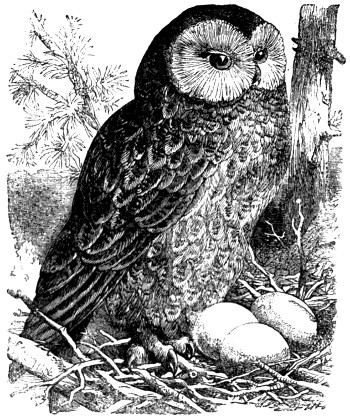
BROWN OWL.
In common with most raptorial birds, the owls disgorge the indigestible parts of their food, such as the bones, the feathers, and the skin; and as the owl eats its prey entire, the amount of such[531] substances is remarkable. They are formed into egg-shaped masses, and may be found in plenty in the nest or on the ground near the nest. In some parts of the country these castings are called “quids.” When they are first ejected, they are wet and rather tenacious; but they rapidly become dry, and can then be crumbled down into a soft flock-like substance, which forms the bed on which the eggs repose.
These eggs can easily be recognised by their peculiar shape and texture. In form they are very globular, their shells are very thin, and the surface is rough and chalk-like, as if some one had ground a piece of chalk into coarse powder, mixed it with gum, and painted the egg with the mixture. Any one who is experienced in such matters knows an owl’s egg as soon as he handles it, even though he cannot see the object which he touches.
Their method of eating mice is very curious, and that the owl should derive any gratification from the process seems to be rather remarkable. The owl catches the mouse with its foot—a member that is wonderfully fitted for the purpose—and then shifts the mouse to its beak; in this respect differing from the hawks, which hold the prey with the foot, and only use the beak for the purpose of tearing it to pieces. At the Zoological Gardens the falcons may be seen at feeding-time with the meat in their claws, never taking it in the beak when they move, but hobbling about with a lump of raw meat hanging to one foot, and presenting a very absurd spectacle.
When the owl has settled itself into a comfortable position, it gives a kind of snap and a gulp, and in a moment the head of the mouse is in its throat. Another gulp and a shake of the head, and the mouse has disappeared, with the exception of the tail, which hangs on one side of the beak. This part of the process seems to afford the owl the greatest satisfaction, for the bird remains for some time in this attitude, standing perfectly still, but giving the tail an occasional roll in the beak. Suddenly the head goes back with a jerk, the eyes close, there is a mighty gulp, and the tail has followed the mouse into the bird’s stomach. The whole process of swallowing the prey is very much like that which may be observed in the toad, the gulping effort to swallow appearing to be equally great in either case.
All owls can be treated in a similar manner, so that there is no need of mentioning them individually. If, however, either of the eared owls can be obtained, the young naturalist should not fail to do so. Owls kept in captivity should not be placed in cages, provided that other accommodation can be furnished, but should have a dark recess in which they can sit during the day, and where they can always be found. They are not easily seen by inexperienced eyes, as they have a habit of choosing perches in spots where their colour harmonizes with that of the locality.[532] When properly treated, the owl can be made quite tame; but unless it be taken when young, it is rather uncertain in temper, biting very sharply. If any one approaches the owl, and hears a quick, snapping sound, as if an elastic piece of wood were “flicked” against a table, he may take it as a warning that the bird does not approve of him, and that he had better not trust his hands too near the owl.
Any one can see how cat-like are the owls in their general physiognomy, as well as in their nocturnal and mouse-loving habits; and they even carry their feline propensities into peculiarities of diet. No animals are less aquatic than the cat, and yet none are more fond of fish. Even the best bred and most carefully-trained cat finds a difficulty in resisting her appetite when she sees fish on the table, and she can hardly have a greater treat than an occasional sprat, herring, or plaice. Angler-cats are not uncommon: several that were accustomed to haunt the water side have been known to catch the fish in shallow water, and would even plunge into deep water for their prey. In like manner the owl is a great fish-lover, and has been seen in the act of dropping into the water, and rising again in the air with a fish in its claws. Now it is an invariable rule with animals of all kinds, that these little aberrations, if we may so term them, are conducive to health: a very familiar instance is the occasional grass-eating propensities of the dog and cat. The young naturalist will therefore consult the health of his owl pets by giving them a fish now and then, as well as a few large insects, in addition to their ordinary diet.
Among the vast multitude of birds which inhabit all parts of the earth, or even among the many species which are found in our own country, it is no easy matter to make a first choice. We will, however, commence with the parrot; and before proceeding to describe the several species which are generally in vogue among English fanciers, we may remark that the parrots, paroquets, macaws, and cockatoos are found in almost every warm portion of the globe. Many of the largest and most magnificent species inhabit South America, while Australia is remarkable for possessing several examples of this beautiful group of bird that are most interesting to the young naturalist on account of their form, colour, and habits.
One species, the Long-billed Parrot, or Nestor, scientifically called Nestor productus, is now, as is feared, totally extinct, the last[533] known specimen having been shot some years ago. This curious bird was notable for a wonderfully long upper mandible, very like a pickaxe in shape, and employed in much the same service, being used for digging out of the ground the roots and other vegetable substances on which the bird was accustomed to feed. It is rather remarkable that, although this strange land is very rich in the parrot tribe, none of them except the cockatoo can be taught to speak, being apparently incapable of any imitation of the human voice, and rarely uttering any sound except a scream or a chuckle. Asia also possesses some very elegant species.
All the birds belonging to this tribe are furnished with rather big heads, very large and curved beaks, with the upper mandible hooked well over the lower, which is short and stout; and their toes are so formed that they are divided into two opposable sets, so as to permit the bird to grasp an object in its claws almost as if they were hands. In climbing, an exercise of which the parrots are very fond, the young naturalist will probably observe that the bird makes nearly as much use of its beak as of its feet; and even when tame and accustomed to perch on the hand of its owner, it aids itself in its movements by taking hold of the fingers with its beak, although too gently to cause any injury.
The species which is most celebrated for talking is the Grey Parrot, a well-known bird, living, when wild, in Western Africa, and being at once identified by its grey plumage and short red tail. There are several modes of obtaining this bird, such as requesting a naval friend to bring one home on his return, or going and fetching one for yourself. But as there are few who are so happy as to have an accommodating nautical friend or relative, and still fewer who are able to undergo the perils and hardships of a sea voyage, the best way is to go to a respectable dealer, and give him an order for a young healthy bird. We say a young bird, because the purchaser will then be able to teach it every word that it speaks, and will find his feathered pet become far more familiar than if it entered his possession when aged and with fixed habits. Moreover, an older bird is very apt to pick up all kinds of phrases employed by the sailors on board the ship in which it made its voyage; and although such a vocabulary excites no particular surprise at sea, it is rather too forcible and idiomatic for society.
The worst of the matter is, that the parrot is possessed of an iron memory, and never seems to forget anything it has once learned, however its acquirements may have been overlaid with fresh teachings. It has often happened that a parrot which has behaved for a long time in the most exemplary manner, and employed none but the most refined language, has suddenly met with a sound which recalled all its old associations, and induced the bird to pour forth a copious volley of language too loud to be disregarded, and too plain to be misunderstood.
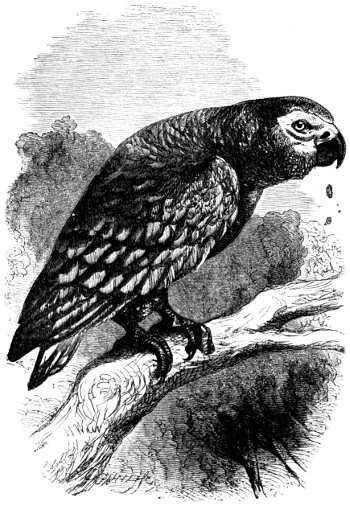
THE GREY PARROT.
And parrots are just like children in their propensities for saying the most dreadful things exactly at the most inconvenient[535] times and to the most fastidious persons, always choosing a dead silence for making some deeply reprehensible remark, and invariably addressing their observations to some lady or some staid ecclesiastical dignitary.
Parrots are marvellously nervous birds, and while young will often throw themselves into such paroxysms of fear at the mere sight of a stranger, that they will even endanger their lives. They have an odd and unpleasant habit of scolding on such occasions, uttering loud, rough, grating cries, as piercing to the ear as the sound of a file or a saw, and stretching out their necks with ruffled feathers and agitated gestures. Some birds retain this extreme timidity for a very long time, in spite of all attempts to conciliate them.
As the management of the different species is nearly, if not quite, identical, it is unnecessary to trouble the reader with a detailed description of each kind of parrot and the mode of treating it; it will be sufficient to tell him how to manage these birds generally, and give a brief account of the country, form, and colour of those species which are most commonly brought to this country. There are, indeed, so many, that it is impossible to mention more than five or six sorts; but if the reader desires to learn more about the parrot tribe, let him refer to the Rev. J. G. Wood’s “Illustrated Natural History,” vol. ii., where he will find the subject treated at length, and with large figures of all the most remarkable species.
The Amazon, or Green Parrot, is so called from its colour, which is mostly bright green, with some yellow and purple tints here and there. This species is brought to England under the title of the Green Parrot, the second species being more properly called the Festive Parrot. It is much larger than the common species, being about fifteen or sixteen inches in length, and having the feathers of the lower part of the back of a deep vermilion.
Teaching this bird to talk is by no means a difficult task,—not nearly so difficult, indeed, as hindering it from learning accomplishments which it is not desired to possess, or inducing it to refrain from producing objectionable sounds, whether articulate or otherwise.
In order to teach the parrot to imitate sounds, the best and simplest mode is to take the bird into a perfectly quiet room, where it can hear and see no one but the instructor, and will not have its attention distracted by surrounding objects.
Then, after taking every care to render the feathered pet familiar, speak the words, or produce the sounds, which the bird is required to imitate, and be careful to avoid varying them even by the fraction of a tone. You will soon see the pupil taking notice of the oft-repeated sound, and it will presently hold its head aside, as if to catch the tones more clearly. After a while it will try to[536] imitate them, and as soon as it makes an attempt, however imperfect, make much of the bird, and give it a small morsel of some special dainty.
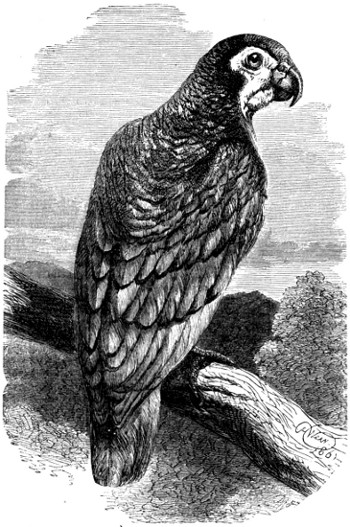
THE GREEN PARROT.
Parrots are largely gifted with the faculty called by phrenologists “love of praise,” and are in no slight degree incited by self-esteem; so that it is possible to induce the bird to perform the oddest feats by carefully working on these two propensities. They have an almost morbid love of being noticed, and crave for words of praise with as much appreciation as if they could understand their import. You can throw one parrot into a very passion of jealousy by pretending not to hear it, and talking to another bird.
One difficulty in the management of these birds is, that when you have taught them to exercise their powers of imitation, they are apt to pick up a kind of chance-medley of every sound they hear, instead of adhering to one lesson and learning it thoroughly before they begin another. Breaking them of the habit is a difficult task, but can be achieved with ordinary care.
The simplest plan is to pounce at once on the obnoxious sound, and, by never letting it pass unnoticed, give Polly an idea that it is not to be uttered. If she persist in her delinquency, the best way is to scold her, and put her at once into a dark closet, or throw a thick shawl over the cage, so as to exclude the light. Parrots detest being left in the dark, and it is surprising how soon the bird finds that her utterance of the forbidden sound is sure to be followed by condign punishment, and therefore ceases to be guilty of the offence.
Wherein shall our parrot live? This is a natural and a needful question, and requires a few lines in reply.
Assuming that, in any case, the bird is to have plenty of room, as is needful for a creature so restless and active, a cage is to be recommended, unless the parrot is very tame, and there is no fear of strange cats; we say strange cats, because Polly will generally contract an alliance with the cat and dog of the household, and be on the most friendly terms with them.
A good form of cage is here given. As the reader will observe, it is much wider across the top than is usually the case. This is to give the bird room to traverse the cage, or luxuriate in its swing, without the danger of rubbing its tail into a shabby and ragged condition. There is a metal hoop suspended by a chain, and it is found that parrots are very fond of getting into this hoop, and swinging about. The cage should be made of galvanized iron wire, very strong, and at least five feet high. We desire to dissuade our readers, in the strongest terms, from purchasing cages made of brass wire for their parrot, or indeed for any other bird. Brass is terribly apt to[538] produce verdigris, especially in London or in any other large town, and where gas is much used; and as birds, and parrots especially, are fond of nibbling the wires, they may be poisoned, and die a painful death.
Should, however, the bird be trustworthy, we would recommend one of the common crutch perches, to which the bird is secured by a chain, having one end fastened to a ring on its foot, and the other end affixed to the crutch. If the room in which the bird is kept will permit the arrangement, by far the best plan is to add a strong twisted wire to the crutch, and carry it to the ceiling, as is done in the Crystal Palace. The chain, instead of being fastened to the crutch, terminates in a ring, which slides upon the upright wire, and permits the bird to mount or descend at will.
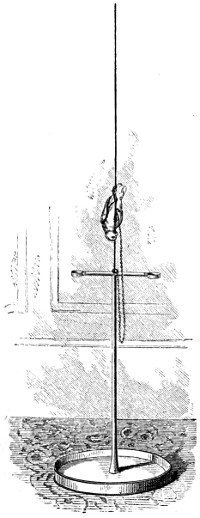
Polly will be charmed with this addition to her range of locomotion, and the sight of his pet bird enjoying herself cannot fail to repay the owner for the slight extra trouble he has taken.
Parrots are very fond of exercising their strong beaks, and are apt to gnaw their perches so incessantly, that they cut them in two, despite the hardness of the material. Prevention, they say, is better than cure; and if the young parrot-owner will take care to give his bird now and then a stout piece of elm wood, with the bark not removed, he will find that Polly will prefer to tear and rasp away at the elm[539] board to biting her hard perch, where there is no bark to be stripped off.

THE COCKATOO.
The pretty Cockatoos are always great favourites, their form being very elegant, their colour delicate, and their talkative powers very great. These birds are natives of Australia and the Indian Islands, and derive their name from the peculiar cry of some members of their kind, which exactly resembles the word cockatoo.
The two species generally found in captivity are the great Wide-crested Cockatoo, known by the crest of broad and slightly-hollowed feathers which decorate the head, and which can be raised and even thrown forward when the bird is excited with pleasure or anger. The colour of this bird is white, and the under surface of the crest is tinged with red. It comes from the Moluccas, and is deservedly in favour as a pet, being docile, affectionate, and very quaint in its habits.
The other species is the Lesser, or Sulphur-crested, Cockatoo, also from the Moluccas and Indian Islands. It is easily known by the pointed sulphur-yellow crest, which is continually being raised and thrown forward. Both kinds can learn to talk to some extent, though they are not such admirable linguists as their kinsmen the parrots.
The pretty Ring Paroquet is a native of the East Indies, and is a very familiar inhabitant of our aviaries and cages. It is a gentle creature, and most affectionate to a kind owner. It is mightily fond of walnuts, and the bird can be kept in a state of great good-humour for an hour or more by giving it half a one, and telling it to pick out the contents with its hooked bill. The bird seems perfectly happy, holding the nut in one claw, shifting it with great dexterity, so as to get it into the best position for extracting the kernel, and uttering the while a little, low chuckle of gratification. The colloquial powers of this bird are moderate; but it does not learn so readily, nor repeat so accurately, as the grey or green parrot.
The Macaws are notable for their very long tails, very big beaks, and very brilliant colouring. The two species usually seen in England are the Scarlet and the Blue-and-Yellow Macaw. They come from Southern America, and have a most magnificent appearance while flying from tree to tree, with the sunbeams flashing from their gorgeous plumage.
As a pet, the macaw is rather too noisy, and has a horribly loud and dissonant yell by way of a cry. It is, however, a magnificent bird, often measuring more than a yard in length. The colour of the plumage is almost entirely of a rich glowing scarlet, relieved here and there by a little blue, yellow, and green.
The Blue-and-Yellow Macaw is another native of tropical America, and though not so gorgeously resplendent a bird as its scarlet relation, is yet a remarkably handsome creature. As may be surmised from its popular appellation, the colour is chiefly of the two tints blue and yellow, mixing occasionally so as to produce green.
Without going too deeply into minute details, it will suffice to say that the upper part of the back, the wings, and the tail are azure blue, and the under part king’s yellow. On the forehead is a patch of green, the chin is black, and the cheeks are white and naked, with the exception of three narrow bands of very tiny feathers drawn successively beneath the eyes.
The parrot tribe may be fed upon various vegetable substances, such as grain of different kinds, seeds, nuts, Indian corn, and biscuits. The stones of peaches are great favourites with these birds, who derive much amusement from picking with their scoop-like tongues the soft fruit from the interstices of the rough stone.
They ought not to have any kind of animal food, not even milk, which is frequently recommended for their use, as their systems are apt to become heated, and then they pull away their feathers in their attempts to alleviate the irritation. Sometimes a parrot will pluck itself bare in every part where its bill can reach, and so injure itself materially. A capsicum pod now and then is, however, a treat, and may be given sparingly. Be careful to use glass or earthenware pans for their food, and see every morning that the cage and pans are quite clean and bright.
The practice of rearing pigeons for fancy or amusement has been for a long time prevalent in England. In ancient times the “dove-cote” was a general appendix to the family hall or farmer’s homestead; and at the present time it may still occasionally be observed peering above the trees in country districts; while in London the pigeon-loft, with its “dormers,” “area,” “traps,” and other appliances, may be frequently seen on the house-tops, more especially in the districts inhabited by the working classes.
Pigeons live together in pairs; and when a cock and hen once form an attachment, the union generally lasts during their lives. The pigeon in a wild state breeds only twice or thrice in the season, but the domestic birds will breed every six weeks, or during the greater part of the year.
Whatever number of broods a pair of pigeons may bring up in a year, the hen never lays but two eggs before she sits. She incubates for eighteen days after the laying of the second egg. Both the cock and hen assist in the hatching: the hen usually sits from the afternoon till about eleven o’clock on the following morning; the cock then takes her place, and sits while she goes out to feed[542] and exercise herself, and generally keeps on the nest until two or three o’clock in the afternoon.
When first hatched, the young are fed for about eight days with a milky secretion prepared in the crop of the parents, and regurgitated into the mouth of the young, and afterwards with grain and seeds the old ones have picked up in the fields and treasured in their crops. In this mode of supplying the young with food from the crop birds of the pigeon kind differ from those of any other family.
Formerly it was common to erect buildings as dove-cotes in the neighbourhood of great country mansions: many of these were of considerable size and elevation, as shown in the engraving. The custom, however, has fallen into disuse, and pigeon-houses of more moderate sizes are now generally employed.
A small one is very often formed from a wine-cask, which has holes cut in its sides, and a small platform made before each, to form a resting-place in front for the birds to alight upon. The interior is divided into chambers by the carpenter, or any boy of common carpentering ingenuity may readily do it himself. The cask is then elevated on a stout thick scaffolding pole or the trunk of a straight tree, and made perfectly secure. In arranging the internal chambers for the birds care should be taken that they are large enough for them to turn round in with ease. The cote should be fixed in a warmish spot, and not exposed to cold easterly and northerly winds. The top of the cask should be thatched or boarded, and this protection should come well over the holes and sides of the cote, so as to protect it from the heat of the sun in summer and the drifting of the rain in unseasonable weather.
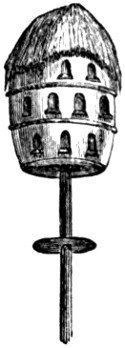
The young fancier may employ one after the fashion shown on the following page: this, with its compartments, may be fixed up against the south or south-west side of a stable, barn, or out-house. The outside should be well painted, and the alighting places slightly slanted, so that the water or rain may not lodge on them, but run off to the ground outside. The whole should be so placed that it can be approached by a ladder, which ought not to be permanently attached[543] to the cote, or it may be a means for the intrusion of cats and vermin.
It sometimes happens that a spare loft or room presents itself to the young pigeon-fancier, which may be made use of for a pigeon-house. When this is the case, it can easily be filled up with pigeon-boxes, which may be arranged round the sides, while holes are made on the outside of the building for the pigeons to fly in and out at. Broad flat perches may also be placed across the room, upon which the birds may rest. The boxes for the nests should be at least a foot square.
It is far more advantageous and profitable to keep pigeons in a spare room than to employ the dove-cotes on a pole, or those fixed against the side of a house, as double the number of young birds may be reared, the nests being sheltered from the inclemency of the weather.

As to the compartments, or nests, every one should be furnished with an earthenware nest-pan, of a size adapted to the pigeons for which they are intended. Sand or gravel should be sprinkled over the shelves and on the floor, as the small stones with which it abounds are useful to the birds in helping them to digest their food, and a little old mortar-rubbish or pounded burnt oyster-shells should be given, to supply the lime necessary for the shells of the eggs. Everything about them should be kept very clean, and the whole apparatus, of whatever kind it may be, should undergo a frequent and thorough purification, while the nest-pans or boxes should be well cleaned after every hatching.
There is a contrivance of great use which is employed for letting into the loft those birds who may not happen to come home before the areas are closed for the night. The object of this door, which is called the “bolting wire,” is to let the birds in without letting those in the loft pass out. It is made by placing before a square aperture cut in the pigeon-house a couple of wires about three inches apart from each other (as seen in the[544] drawing): these swing loosely upon a piece of wood, which turns on a wire, and their lower ends come over the lower ledge on the inside. By this arrangement, when a bird outside presses against the bars and tries to get in, the whole opens inwards, and he easily enters; but if one from within tries to get out, the wires press against the ledge at the bottom, and effectually prevent his egress.
Within the pigeon-house should be placed boxes for the grain, pulse, and beans that the birds feed upon.
Pigeons are great devourers of food, and will eat any kind of grain, such as wheat, barley, oats, peas, beans, vetches, Indian corn, tares, &c. Small beans, called pigeon’s beans, are the best general food for all pigeons. If possible, the peas, beans, or tares given to the birds should be old, as new pulse is apt to disagree, and purge them. Hempseed is very stimulating, and although pigeons are very fond of it, it should be sparingly given.
Pigeons are very fond of lime and salt, and to supply themselves peck out the mortar from between the tiles. To prevent this, it is best to make them what is called a “cat,” which will be exceedingly grateful to them, as it will tend to keep them in good health. This is done in the following manner:—
Mix some sifted gravel or earth with old mortar-rubbish, or pounded burnt shells, if this cannot be obtained; add a few handfuls of salt; and make the whole into a mass with water. Portions of this may be put into flower-pots, and placed in situations where the birds can get at them easily.
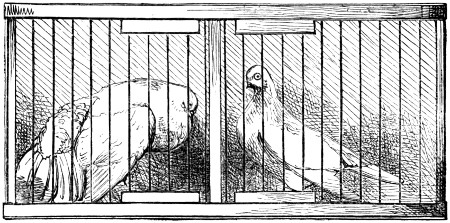
MATING CAGE.
Pigeons are often sadly annoyed by vermin. To prevent the increase of these intruders, the most scrupulous attention should be paid to cleanliness in every part of the houses, nests, and places of resort, and the birds should be provided with shallow pans of water to wash in.
Sometimes there is a little trouble attending the mating of pigeons, and it is of great importance that they should be properly matched, or the young will not be purely bred. The mating coops should have a thin lattice-work partition between them, so that the birds may make acquaintance with each other, and match together, when they may be placed in one pen. When they are properly mated, they may be left at liberty to arrange and build their nests, which they will do very readily. The illustration on the preceding page shows the construction of the mating cage.
The Columbidæ, or family of pigeons, are one of the most numerous and most widely distributed families of birds. They are all vegetable feeders; and many congregate in flocks. But notwithstanding their numbers, general distribution, and beauty, only two, out of a great number of species, have been brought into subjection by man: these are the common pigeon, or house pigeon, known as the Rock pigeon when in the wild state, and abundant in several parts of the cliffy and caverned shores of the British Islands, and the Collared, or Cream-coloured dove, with a narrow black collar round the neck. This latter is frequently kept in confinement: it breeds freely if in very large cages, and it may be reared in the open air in this country if protected during severe winters.
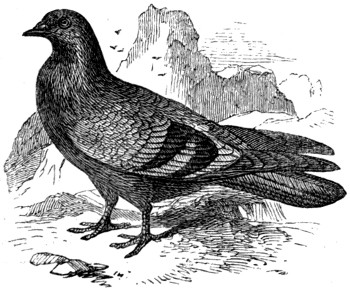
The Blue Rock dove is the undoubted origin of all the different varieties of domestic pigeons. It is a most beautiful bird; its general colour is blue, with two black bars across the wings. In some few of the large dove-cotes blue rocks still exist; but the[546] pure race, uncontaminated by intermixture with any of the numerous varieties of domestic pigeons, is scarcely to be obtained except in the distant islands of the Hebrides, or in remote districts unfrequented by man. It is a swift flyer, a good forager, and a prolific bird; but its comparative wildness renders it ill adapted for a domestic pet.
Smerles are the Flying Pigeons of Belgium. These extraordinary birds, that perform races of 500 miles, returning home to Brussels and the adjacent towns from the south of France, and even from Spain, closely resemble the blue rock in general form; but, as shown in the engraving, the feathers of the wings are rather broader, and the head and beak thicker and shorter. They are of various colours, as blue, checquered, red, mealy, &c. Their desire to return home is so great that it is useless to attempt to establish a stud of them, by liberating old birds, however long they may be shut up; the only plan is to rear young from them whilst confined in a room or loft, or to obtain young birds that have never flown at the place of their birth. These, from the peculiar noise they make, are termed “squeakers.”
We do not know any more delightful fancy for boys than Antwerps, as they are strong, hardy, fertile, and require no special trouble; good water and a little care in cleaning is all they ask; and they reward their owners by being always ready to convey to their home messages from any distance which they may have been trained to fly. The training is thus accomplished: the young birds, when they can fly round with the others, and dash about in the air in that vigorous style that characterises the breed, are taken a short distance from home and set free. They rise, and circling round and round, descry their home, and make straight for it.
Their next journey is longer, and so on; the distances are gradually increased, until the birds will return even for several hundred miles. When these birds are used to convey messages, the paper must be so attached as not to impede their flight. The proper mode of doing this is to write upon a strip of thin soft paper, about half an inch broad by three or four inches long: this is rolled round the leg, and secured by a thread. An ordinary letter, tied to the bird in the manner that is often represented in engravings, would entirely prevent its flight.
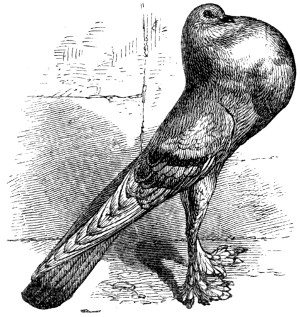
The breeds of pigeons that are most valued by fanciers are those that differ in the greatest degree from the blue rock doves and the common mongrel dove-house pigeons. Of these the Pouters, Carriers, and Tumblers are the most esteemed. The pouter is a remarkable bird, distinguished by the extraordinary power it possesses of inflating or blowing out the neck: it is also characterised by the extreme length of its legs, which should be feathered to the toes, and the length of the feathers of the wings and tail. Pouters are of various colours: some are purely white, but in general they are blue, or black, marked or pied with white upon the crop, and with white flight feathers in the wings; there are also red and yellow pied birds.
The properties for which a pouter is valued are usually stated as being five in number; viz. length of leg, length of feathers, slenderness of body, size of crop, and colour. Pouters possessing all these properties of the breed in a very perfect degree are rare, and consequently very valuable. Ten, or even twenty, pounds is no uncommon price for a pair of birds sufficiently good to win prizes in the[548] competitions at the exhibitions of poultry and pigeons; but very fair specimens may be bought at the dealer’s for a few shillings per pair.
Pouters are not such good nurses as many other pigeons, often neglecting their young before they can feed themselves, when they die, unless fed by being crammed with beans at least twice a day. For this reason we would not recommend the young fancier to begin with this breed.

The Carrier of the present day is not, as its name might seem to imply, ever used to carry messages, but is a high-class fancy variety, valued in proportion to the perfection of its properties. In a good carrier the beak is long, thick, and straight; the beak-wattle, or membrane at its base, well developed, and standing well up from the head. The eye-wattle, or membrane round the eye, should be large, flat, and circular; the skull narrow and long; the neck very slender and long; the plumage firm and glossy, the tail and flight feathers being long. The colour most valued in carriers is a brilliant jet black: many first-rate birds are what are called duns, a variety of brown. There are also white and blue carriers, and occasionally pied birds are seen. The blacks and duns are, however, the most perfect in properties; and they may be mated together without risk, as they will always produce either black or dun young birds, and not, as might be expected, a mixture of these colours, or a bird intermediate in colour between the two.
Carriers are very fair sitters and nurses, but they are subject to diseases of the eyes, and are not as well suited to young fanciers as some of the other breeds.
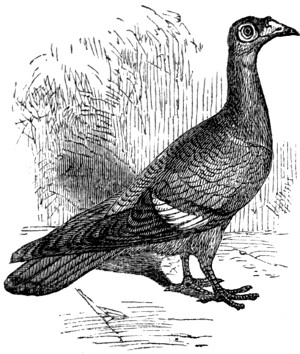
For grace, style, and beauty there are no pigeons superior to Dragons. They are almost everything a young fancier could desire—good homing birds, able to do 50 or 100 miles with ease; active on the wing, close sitters, good nurses, fertile breeders, requiring no special care; full-sized birds, good in a pie, and not expensive in first cost. Their general form is somewhat like that of the carrier, but they are much more active, and far quicker in flight. Some of the best dragons are blue; others are white, red, yellow, and black. They differ from the carrier in the size of the eye and beak-wattle, and in the beak.
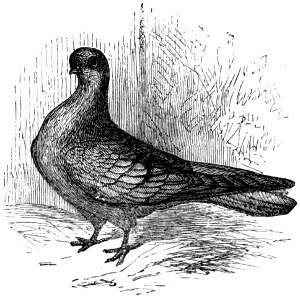
The Tumblers are the very opposite of the breeds last described. Small birds, with rounded heads, short beaks, and pretty little red prancing feet, they are the very pets of the pigeon fancy. In colour the tumblers vary very much. There are blues, blacks, and other self colours; then some have white heads—these are termed bald heads; others have a white mark below the under bill—so they are termed beards; but the variety most valued is that termed the almond tumbler. In this breed every feather of the plumage is variegated with black, yellow, and white, the yellow forming the ground colour. These almond birds are reared by experienced fanciers with beaks so short that they are hardly able to bring up their own young, and others have to be employed for the purpose. Birds of this extreme character are not suited to young fanciers; but the ordinary flying tumblers, which can be bought at any dealer’s for a few shillings per pair, are most pleasant pets—good[550] breeders, active and joyous on the wing, constantly turning somersaults in the air, good in a pie, and able to fly home, if trained, some thirty or forty miles with ease.
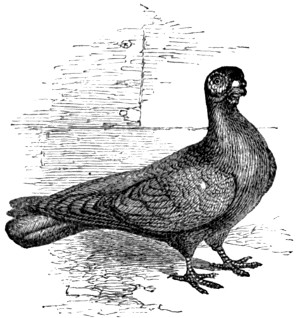
The Barb, or, as it used formerly to be called, the Barbary pigeon, from the country from where it was originally obtained, is regarded with great esteem by fanciers, and very good specimens cannot be obtained except at high prices. In size the barb is rather a small bird. The colours are usually black, dun, red, yellow, or white; blue barbs, strange to say, are not known. The eye of the barb is surrounded by a naked skin or wattle of a red colour; this should[551] be circular in form, and the larger it is the more the bird is valued: the skull should be broad, and the beak short and stout. Barbs are good sitters, and bring up their young ones very well. They are also striking in appearance, the red eye-wattle contrasting well with the colours of the plumage.
Like the barbs, the best Owl pigeons also come from the north of Africa. Formerly there was very common in this country an elegant, short-beaked bird of a beautiful blue or silvery colour, known as the owl: this was of medium size, and possessed rapid powers of flight. Beautiful as the breed was, it has almost entirely been superseded at the pigeon shows by a very petite, delicate, white breed, the first specimens of which were brought to this country from Tunis about a dozen years since. A very good specimen of this charming little variety is represented in our engraving. Since that true blue and black owls of the small size have also been introduced. The great drawback to this fairy-like little breed is its delicacy. The young fancier would do well to choose for his first favourites a hardier variety.
The Turbit is a pigeon somewhat resembling the owl, but its head is flatter, and it has a turned crown of feathers at the back of the neck. In colour it is peculiar. The wings, with the exception of the larger flight-feathers, are coloured, and the remainder of the body should be white. There are turbits of all varieties of colour, or, as they are termed, blue, black, red, yellow, and silver turbits.
There are a number of pigeons which are strikingly distinguished by remarkable peculiarities in the form of the plumage; such are[552] the Fantail, the Trumpeter, and the Jacobin. The fantail is perhaps the best known of these. The number of feathers in the tail of an ordinary pigeon is fourteen, but in this breed it is greatly increased; in some specimens even to three times that number, and thirty feathers are not uncommon in good birds.
The carriage of the tail is also greatly changed; instead of being borne behind, like that of an ordinary pigeon, it is held aloft, like the expanded tail of a peacock.
The engraving represents one of the best white fantails, the tail full, carried well over the back, and the long swan-like neck thrown back so as to touch the tail. Fantails are good hardy birds, and as they can be bought at all prices, very well suit the young fancier. Moreover, they soon become very tame, and may be reared almost everywhere.
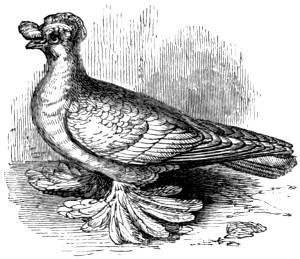
The Trumpeter is not as common a variety as the fan-tail, but is fully as remarkable. It derives its name from its peculiar voice, which is quite unlike the ordinary coo, coo, of a common pigeon; and it is also distinguished by the singular arrangement of the feathers on its head and feet: the latter are feathered to so great an extent that the bird appears to have four wings. Many of the[553] larger quills on the feet of a good trumpeter will exceed four inches in length if unbroken. Trumpeters have a tuft over the beak and a turn of feathers at the back of the head. They require to be kept most scrupulously clean; otherwise the elegant appendages on the feet become clogged with dirt, and the birds lose all their attractiveness and beauty.
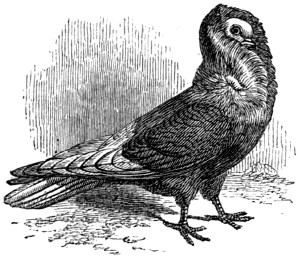
No variety of pigeon excels the little Jacobin in its quaint prettiness. The tiny little head is half concealed in a recurved cowl of feathers which runs down at the sides of the neck, and nearly meets in front.
The head, the flight feathers of the jacobin, and those of the tail, should be purely white, those of the rest of the plumage coloured. The most common colours are red or yellow; but there are also black jacks, as they are sometimes called for shortness, and also blues, and some that are entirely white. Jacks breed very freely, and we cannot recommend a prettier pigeon, or one better adapted to the juvenile fancier.
The foregoing breeds include all the best known varieties. It is true there are many others described in the works on pigeons, but none better fitted for the young and inexperienced fancier.
The breed known as Runts are characterised by their enormous size, sometimes weighing even as much as four pounds or even four and a half pounds a pair. But they do not fly well, and are more suited for pigeon pies than for a fancier’s loft.
There are also the breeds known as Nuns, Spots, and Helmets, which are white with more or less colour on the head, &c.; but for beauty of marking none surpass those blue breeds that possess the arrangement of colours in the plumage that characterises the original wild rock dove.
There are few occupations more attractive than the care and charge of domestic poultry. It is most interesting to behold a hen with her family, and to mark her care and tenderness for them; while to see the little chicks themselves, picking and scratching about, basking in the sun, or running hither and thither after the hen, or nestling under her wings, is a very pleasant sight.
Like the pigeons, fowls are all descended from a single species of wild bird, the common wild jungle fowl of India. This has been domesticated from a very early period, and carried to all habitable parts of the globe. A large number of different varieties exist in a domestic state, none of which are known in the wild condition. The chief breeds known in England at the present time are the Dorkings, Game, Spanish, Hamburghs, Polish, Cochins, Brahmas, Malays, Bantams, Silky fowls, and the common barn-door fowl, which is a very mongrel breed. The best known French varieties are very valuable for economical purposes: they are Houdans, Crève Cœurs, and the La Flèche breeds.
Fowls require both animal and vegetable food. When allowed to range at large their great search is for worms and insects, which they obtain for themselves. They must be supplied with grain, such as barley, oats, tail wheat, &c.; and they should also be well furnished with raw vegetables, grass, cabbage or lettuce leaves, unless they have a free range over the fields. Boiled potatoes and other vegetables are also very serviceable to them. The staple food should, however, be grain, and this may be mixed with boiled potatoes. The quantity of barley for each fowl is about a quart a week, if they are entirely fed by hand; but in barn or stable yards they require much less. They should also always have a plentiful supply of pure and clean water.
All fowls dependent upon man for food should be fed regularly twice or thrice a day in the same place. The food should be given to them at nearly the same hour—eight o’clock in the morning and four in the afternoon, as in the spring and autumn birds retire early to roost, and it is very bad management to call them from their perches for feeding. Young chickens should be fed much more frequently if it is wished that they should grow into fine, handsome birds.
When fowls are to be fattened for the table, they must be fed oftener, and with different descriptions of food, than when they are simply kept for rearing stock or laying eggs. They then require ground barley or oatmeal, which fattens them much quicker if mixed with milk. Indian corn is also a capital fattener, and, as it is now cheap, may be used. Gross food, made up of impure fat, grease, and flesh-food is very bad for fowls. When fattening for the table, they should have their food three times a day, at morning, noon, and evening; and they should be kept warm and comfortable during the night.
Fowl houses should be warm and dry, and have compact earthen floors, well raised, and littered down with gravel, from which the large stones have been taken and the small ones left.
Nests (baskets or boxes) must be made for the hen, in which a chalk egg or two should be put. The nests may be made of short straw. Some hens will lay one egg every day, and others one every other day.
The eggs ought to be taken from the nest every afternoon, when no more may be expected to be laid; for if left in the nest the heat of the hens, when laying the next day, will render them less fit for domestic use.
When the hen has laid her number of eggs, nature has provided for their being hatched by giving the bird an instinct to sit or incubate. This instinct is made known by a particular sort of cluck, and by the hen sitting steadily on the nest in which she has been in the habit of laying.
In selecting the eggs to be sat upon by the hen, choose such as have been recently laid, and not those of angular shape or extra size: the latter are often double yolked, and rarely produce chickens.
The number of eggs to be hatched by the hen must in some degree depend upon her size. A moderate-sized hen will very nicely cover eight or nine eggs in the cold spring months, and twelve or thirteen in April or May. An odd number is often chosen; but there is no advantage in so doing. The hen having received her eggs may be then left to herself; she should have water placed at a convenient distance, and her food may be given to her near the place of sitting.
The hen sits on her eggs twenty-one days, during which period she seems in a dozy state, and seems to require but little food or exercise. Some hens will feed every day; but others will go for several days without leaving the nest, or taking nourishment: these should be lifted off the nest, and fed daily.
When chickens are hatching, which usually takes place twenty-one days after the eggs are placed under the hen, it is best to leave them entirely to themselves.
As soon as the hen becomes a mother, a great change is seen in her character—all her former habits give way to maternal solicitude. A good hen attends to her brood with the most persevering fondness; she will attack the fiercest animal who dares to molest her progeny.
When the chickens are hatched, they require no food till the following day, when they may be fed with crumbs of bread slightly moistened with milk, and egg beaten up with an equal quantity of milk, and then heated so as to form a soft custard: this is the best food that can be given them. They should also have a few grits, and after a few days some small wheat.
If the weather is dry and warm, it is best not to coop the hens, as by scratching they obtain a supply of insect food and worms for the chicks, which is better than anything else that can be given them; but they should not be let out in damp weather in long grass before the dew has dried up. If cooped, the coop and hen should be placed in some nice dry and sunny spot in the lawn or garden, within sight of the dwelling-house, and where no cats are likely to prowl about. There should be a little pan of water set within reach of the hen, near the bars of the coop, and stones should be placed in it to prevent the young brood from drowning themselves, and this water should be frequently changed.

The changes of weather should be watched, and when it sets in wet or cold the young brood should be carefully protected by the removal of the coop into some warm sheltered place, such as a stable, coach-house, or outhouse; and so with care continue to be nursed, guarded, watched, and attended to, till they are about seven weeks old, when they will of themselves separate from their parent hen, take to the roost, and act independently.
There is a great choice of breeds in the different varieties, and we will state the advantages of each.
Dorkings are large heavy fowls, first-rate for the table, good sitters and mothers: but rather delicate, require a good grass range, and do not do well on damp soils.
Spanish are handsome fowls, lay numerous large eggs, do not sit; are not so good for the table as the Dorkings, being longer in the limbs, and not so fleshy.
Cochins and Brahmas are large domesticated fowls, very hardy; can be kept in by a low fence; they are good layers, good sitters, good mothers, and useful family fowls on the table.
Hamburghs are pretty, light, active, roaming fowls; they are called everlasting layers, as they never wish to sit, but lay on incessantly, except at moulting-time. They do not bear close confinement well, and are difficult to keep in enclosed places, as they fly like pheasants, and know not bounds.
The crested Polish, black, white, and spangled, are also non-sitters and good layers; but they are not so hardy as the spangled Hamburghs.
Game are hardy, very fair layers, good sitters, the best of mothers; plump on the table, though not very large; well able to take care both of themselves and their chickens.
Bantams are pretty little pets, that may be suffered to roam about a garden without doing any injury.
The French breeds—Houdans, Crève Cœurs, and La Flèche—are remarkable for their good qualities as table fowls.
The White Silky fowls are a very singular breed, with divided feathers, like wool or silk, black skins, and black bones. They have their good points, however: they are admirable sitters and nurses, and bring up young partridges and pheasants better than any other fowls. They are also very good to eat, though their black skin renders them rather unsightly on the table.
These varieties offer sufficient choice even to the most particular amateur, who should make his selection in accordance with his wants and his locality—according as he requires egg-producers or chickens for the table, and whether he can afford his fowls the advantages of a free range over green fields, or has to keep them in a confined space, near a suburban residence.
Guinea fowls associate readily with the common fowls in a poultry-yard; but they have this peculiarity, that the cocks and hens are so nearly alike that it is difficult to distinguish them, except by the voice, the hens only uttering the constantly-reiterated cry of “Go back! Go back!” The head is covered with a kind of casque, with wattles under the bill, and the whole plumage is either black or dark grey sprinkled with regular and uniform white spots. The pintado is a native of Africa.
These birds lay plenty of eggs, rather smaller than those of the common hen, and speckled. They may be reared by placing the eggs under a hen; but the chicks are extremely tender, and[558] very often a sudden change of the wind in March will sweep off a whole brood in a few hours. The young should be fed with custard, &c., as ordered for fowls.


The common wild duck, or mallard, is the original stock of the domesticated duck, and appears to have been reclaimed at a very early period. The mallards come from the north of Europe, at the end of autumn, and, migrating southward, arrive at the beginning[559] of winter, in large flocks, and spread themselves over all the loughs and marshy waters in the British Isles.
The tame duck is a larger bird, and varies greatly in colour. Tame ducks are easily reared: the best way to get them is to place duck’s eggs under a hen, for the tame duck is often a careless mother; the hen, on the contrary, generally hatches a duckling from every egg with which she is entrusted. She does not conduct her young to the water, and generally exhibits much anxiety when the young brood take to it; but she watches over them, and is ever ready to defend them from danger. “The village schoolboy,” as old Bewick says, “witnesses with delight the antic movements of the little brood under the charge of a foster-mother, who with anxious fears paddles upon the brink and utters her unavailing cries or calls, while the ducklings, regardless of her warnings, and rejoicing in the element so well adapted to their nature, are splashing over each other beneath the pendant foliage, and diving their heads beneath the water.”
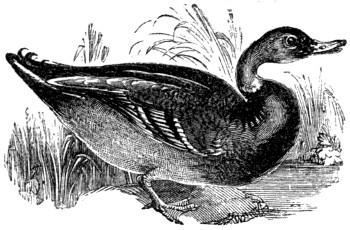
There are many varieties of the tame duck. One of those most in request is the dark-coloured Rouen, which is very prolific in eggs. The Aylesbury, or white variety, is large and profitable. The Muscovy duck is a distinct species, and not a mere variety, much larger than the common duck, and distinguished by a membrane of a red colour, covering the cheeks and extending behind the eyes. There are also several other foreign species, as the Mandarin and Carolina ducks, which are kept rather for ornament than use.
Ducks sit for thirty days. They begin to lay in February, and when not watched will lay abroad and conceal their eggs. They generally lay at night, or very early in the morning. While sitting, the duck requires a secluded and soft place. On hatching, she should be taken, with her brood, and put under a coop; a shallow pan of water should be placed near her for her drink and for that of the young ones, but it should be very shallow. In a few days she[560] may be let loose, when, with her brood, she will immediately take to the water.
Young ducks should be fed upon oatmeal or barleymeal, and kept in a warm place at night time, and not let out early in the morning. They should at first be kept from water to swim in, as it always does them harm. When the ducks grow large, they may be fed upon oats thrown into a pan of water.
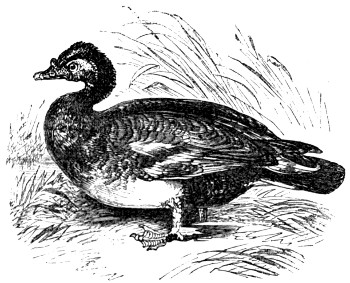
MUSCOVY DRAKE.
Of all domesticated animals dear to the British schoolboy’s heart the rabbit is, perhaps, the most general favourite.
Rabbits may be kept simply as pets or curiosities, or as a commercial speculation, and in either or all of these conditions they are sure to answer the expectations of the owner, provided only that ordinary pains be taken with them. As pets, they can be made tame, affectionate, and playful; as curiosities, they can be modified, by careful breeding, into the oddest shapes and most eccentric colouring; while, as a commercial speculation, they can, with proper care and forethought, be rendered extremely profitable, and will pay a heavy percentage on the original outlay.
As an example of this fact we may mention the case of a young carpenter, one of those steady, hardworking, intelligent[561] men who are sure to get on in the world, simply because they keep their eyes open to all that passes, always watch for opportunities, and always seize them when found. This man used to make a considerable addition to his income by his rabbits, fattening and selling a large number annually, besides steadily increasing his stock. He was ever watchful on their account, and never went to a house where he was employed in his trade without asking for the waste potatoes, crusts of bread, and similar substances, which he used to take home and convert, by judicious mixture, into nutritive diet for the rabbits.
As, however, there are but few boys who keep rabbits for the purpose of making money by them, we will treat at greater length on their general management than on the method of feeding them at the least cost and selling them at the highest price.
Before rabbit-keeping is attempted it is necessary to prepare, very carefully, a habitation for the future pet, and in the following pages will be found full instructions for that task. It is hardly possible to take too much trouble about the rabbit-house, and any abatement in this respect is sure to prove the truth of the old proverb, that penny wisdom is pound foolishness.
Two objects are to be considered in this matter; the first and most important being the comfort and happiness of the creature who is intended to live in the house, and the second the waste of time, money, and patience, which the constant sickness and ultimate death of the rabbit is sure to inflict upon a neglectful owner. So we advise the intending rabbit-keeper to expend plenty of trouble upon his house or hutch, and assure him that the healthy and thriving condition of his pets will more than repay the trouble, and their rapidly-increasing numbers more than defray the expenses originally incurred.
Should a single rabbit be at first kept—a good method, by the way, of experimenting before undertaking the more arduous and responsible task of setting up a regular establishment—a house or hutch like that which is represented in the accompanying illustration will be all that is needed.
Such a one as this may be easily made by any boy of ordinary ingenuity, as no great neatness in joints is needed, and the only requisites are strength[562] and compactness. Should not the young carpenter possess the wood and tools needed for the entire construction of the hutch, his best plan will be to purchase an old tea-chest or egg-box from the grocer’s, and modify it into the necessary form. The box will cost about fourpence, or sixpence at the most; the wire will cost a penny, and the nails another penny.
If no tools can be borrowed, a boy can set himself up for ordinary work at a very cheap rate, the following being all that is really needed:—
Saw, one shilling; hammer, eightpence; half-inch chisel, with handle, sixpence; small three-cornered file, twopence; two bradawls, one large, and the other rather small, twopence,—these will be without handles, and the best way is to drive the “tang” of the bradawl into the end of a stick of firewood, then cut the stick into a handle, shape it with a knife, and bind the end with string or wire to prevent it from splitting. These handles are just as useful as those which are purchased, and have the advantage of costing nothing but a few minutes’ labour. The whole set of tools need not cost more than half-a-crown or, at the most, three shillings.
As will be seen from the illustration, the hutch is divided into two portions, that on the left hand being much the larger, and employed by the rabbit as a day-room. That on the right is small, and is used as a sleeping apartment. These two chambers are separated by a partition of board, in which is cut a hole, through which the inmate can pass backwards and forwards.
As it is often necessary to confine the rabbit in either compartment while the other is being cleansed, the aperture must be closed by means of a sliding door drawn up and down through the roof, as seen at A. We have found by experience that the purpose was fully answered by substituting a strong iron wire for the wooden handle, and letting it pass through the hole bored in the roof. We mention this, because it is always best to know the simplest and easiest plan of proceeding. The wire is firmly secured, as seen in the engraving. After cutting the sliding door to the proper shape, bore a hole at a with the little bradawl. Sharpen one end of an iron wire (the same as that of which the open front is made) and push it firmly into the hole. Now bend the wire upwards, until it lies flat upon the wood, and then bend it over the edge, as seen at b. Cut off an inch of wire, sharpen both ends, bend them so as to form a staple, and drive the staple over the wire at b, so as to hold it firmly in its place. Two small holes should be made with the little bradawl in the proper direction, and the hammer must do the rest. Bend up the wire again, cut it off to the proper length, and all is ready for fixing, which is done as follows:—
Take the board which is to form the partition, and which is easiest made from the lid of the box, and cut out a round, arched, or square hole near the bottom, the hole being about an inch narrower every way than the sliding door. Lay the door over the hole, and place on each side of it a strip of wood a trifle thicker than the door. These slips are technically called guides, because they guide the door in the right direction: try whether the door will slide easily up and down them, and, if so, nail them firmly in their places. Then get a second pair of wooden slips, not so thick, but about half an inch wider than the first pair; lay them on the guides so that they overlap the door, and then nail them down. The door will then slide up and down when pulled or pushed by the wire.
To make this part of the proceedings quite clear a section of the door and slide is given below: g represents the guides; f the board and their slips which overlap the door; and the door itself is shown by the dotted lines b*. When fitted together the partition-board, with its door and slides, is shown in the engraving. a, a, a represents the board itself; b is the sliding door, and c the wire by which it is worked; d is the hole of communication, which is opened or closed as the door is moved up or down; which is here shown as half closed.
The dividing-board being thus completed, mark the place where the wire c is to come through the roof, and bore a hole about half as large again as the wire, so as to allow it to play freely. By the simple plan of making a large nail or waste bit of wire red hot, and charring this hole, the swelling by damp and consequent sticking of the wire will be prevented.
All being ready, slip the dividing-board into the box, taking care to insinuate the wire into its proper place, get it quite upright and square, make sure that the sliding door plays without hitching, and then nail it all tight. Bend the top of the wire into a loop, and the most troublesome part of the business is over. The young carpenter must remember that the dividing-board, with its sliding door, must be made and fixed before anything else is done, as it not only strengthens the box and keeps it in shape, but would demand twice as much trouble after the door and front have been made.
We now come to an easier and more ornamental part of the work.
In the engraving both doors open from the front, the one being wired and the other plain wood; but it is best to have the larger door open from behind, as the wire-work is then twice as strong, and all the trouble of making a hinged frame is dispensed with.
Put the box on the ground, and draw a line from one end to the other, just half an inch from the edge. Mark the line off in half-inches, and bore holes quite through the wood, one hole coming at every half-inch. Repeat the same process immediately below, but be careful only to bore the holes half through the wood, or the wire will of course fall through.
Then cut your wire into lengths, measuring them by the depth of the box, and cutting them about one-third of an inch shorter than the total depth. Laying them against the end is a simple method of getting the precise length. Sharpen one end of each piece of wire, push the sharpened end through the hole at the top, draw the wire down, insinuate the point into the hole below, and then, holding the middle of the wire with the fingers of the left hand, in order to keep it from bending, drive it down with the hammer until quite level with the top of the box. When all the wires are thus driven home, nail a strip of wood over them at the top, and they can never come out again.
It will be better to strengthen it further by passing a similar wire horizontally across the others, driving each end into the wood, and binding all together with fine wire. This will be a protection through which not even a rat could crawl, and which no cat could tear away with her hooked claws.
The door of the sleeping apartment is easily made of a single piece of board, cut to the requisite shape, affixed by leathern or metal hinges, and fastened by a simple hasp. The door of the day-room is made in a similar manner, but opens from behind. A row of deep notches should be cut at the bottom of this door, and corresponding holes bored through the back of the sleeping-room floor, in order to let all the wet drain away and keep the rabbit dry. The hutch should be made to slant a little backwards so as to aid in the drainage.
Slate floors have been suggested, in order to prevent the ill-drained moisture from soaking into the substance—a result which is sure to take place, sooner or later, with a wooden floor. Slate, however, is rather expensive, but it is easily cleaned, and can be thoroughly washed; so that the suggestion is worthy of notice.
Having completed the hutch, we must next see about a feeding-trough. The ordinary troughs are nothing more than long wooden boxes; those who use them generally find that the food is much wasted by being scraped out with the fore feet, and that the[565] rabbit contracts a habit of sitting in the trough, which, in course of time, renders it very offensive, and makes the food unwholesome. But by a little exercise of ingenuity both these annoyances can be prevented.
To check the scratching out of the food, run a strong wire from one end of the trough to the other, about half an inch below the edge, and one inch from the side. When the rabbit begins to scratch, the paws come against the wire, and get so jarred that the creature soon relinquishes the bad habit.
The habit of squatting in the trough is easily prevented by a very simple plan. A strong wire, about three or four inches long, according to the depth of the trough, is set upright in the centre. Another wire is arranged as seen in the illustration, the ends being driven firmly into the wood of the trough, and the middle passing through a loop at the end of the central wire. In the engraving, a represents the wire which prevents the animal from scratching, and b that which keeps it from getting into the trough. The edges, whether of the trough, the sliding door, or the guides, must be either bound with tin or edged with zinc wire, the latter being rather preferable.
The reader will observe that in the engraving of the hutch it is shown standing on a table, the top of which projects far beyond the legs. The object of this precaution is to keep off rats, which are the bane of all rabbit-owners, and can climb up almost anything. They, cannot, however, walk like a fly, in a reversed position, on a flat surface, and in consequence, a projecting board of five or six inches in width is an effectual protection against these pests.
The hutch is easily kept clean by attending to each apartment separately. First close the sliding door, so as to confine the rabbit in the apartment in which it happens to be, and with a hoe or similar implement scrape the floor quite clean, afterwards rubbing it with a wisp of straw. Take care that every scrap of refuse food has been removed. Then close the outer door, open the slide, drive the rabbit into the clean apartment, close the slide, and scrape and rub the second chamber.
The trough should be removed when the day-room is cleaned,[566] and carefully examined before it is replaced. The hutch being clean, the slide may be opened, and the animal allowed to run about. The hutch should be cleansed at least every day, and if a second cleaning be added it will not come amiss. This continual cleaning will involve some trouble; but no one ought to keep a rabbit who neglects this essential duty, or to undertake the charge of an animal unless he intends to make it as happy as it can be in a state of imprisonment. A supply of straw should be placed in the sleeping-room for a bed, and should be changed daily.
If possible, the rabbit should be allowed to take a half-hour’s run every day; but precautions must be taken against its burrowing habits and the chance of finding and eating something poisonous. In the wild state, a rabbit never eats anything that is injurious, but when domesticated many of its instincts are in abeyance, and it will eat many substances which it would reject when wild.
The best defence against burrowing is to have a brick floor for the animal to run about on. There is also a substance called, I believe, Parker’s cement, which, when laid down, becomes rapidly dry, and is so hard that not even the teeth of a rat, much less the claws of a rabbit, can work their way through it. This cement is mixed with water and sand to the consistency of thick cream, and while settling is “flatted” with boards, and makes an admirable level flooring, easily washed and as hard as stone. On this substance the rabbit can be allowed to amuse itself without danger, and when its time of recreation has expired it should be caught and replaced in its hutch.
We may here mention that the proper method of taking up a rabbit is to hold it by the ears with the right hand, and to support the body by placing the left hand under it.
Should a number of rabbits be kept, it is as well to allow each family to have a run in succession. It is very pretty to see the playful antics of the young rabbits, the races they run with each other, the scufflings they have in the corners, and the staid manner in which the mother sits and looks on, and when they become too noisy silences them by a stamp of her foot.
This gesture is used either as a signal of alarm or defiance, and the force of the rabbit’s hind foot is really astonishing. We have known a buck rabbit vanquish a large cat in a fair fight simply by jumping over her back and kicking fiercely as he passed. He struck out whole bunches of pussy’s fur, and the cat, unaccustomed to such treatment, ran away and left her antagonist victorious and triumphant.
It is necessary to separate the rabbits in their exercise, and not to permit two families to occupy the same ground at the same time, as they are very quarrelsome animals, and will fight desperately among themselves. In any case the buck rabbits should not be allowed to mix with the others, for they are terrible bullies,[567] and will assault and kill even their own children, without the least remorse. When properly tended, the rabbit becomes quite tame and familiar, and will come to its owner at the sound of its name.
The food of rabbits is easily obtained, and consists of bran, pollard, grain, and various vegetables. Parsley is an especial favourite, but cabbage leaves should be avoided as far as possible, as they are apt to have a bloating and puffy effect, and are often injurious, especially to young rabbits, giving them the disorder that is well known under the expressive term of “potbelly.”
The following is a list of vegetables which rabbits can always eat in safety:—
Grasses of the finer sorts—the coarse, large-bladed grasses are not to a rabbit’s taste—lettuce, parsley, carrots and their green tops, turnip-tops, green ears of corn, sow or milk thistles, clover, tares, vetches, beet-root and leaves, vine leaves occasionally, green furze tops, potatoes, and Jerusalem artichokes. Cow-parsley, as it is popularly called (Myrrhis temulenta), is a very favourite vegetable with the rabbit: but unless the gatherer is perfectly acquainted with its form and leafage, he will be wise to leave it standing; for it marvellously resembles the common hemlock (Conium maculatum), which is extremely poisonous; and unless the two plants be thoroughly known, the rabbit may be poisoned through the mistaken kindness of the owner.
As this plant is a really valuable one, we will give a few simple and plain directions for distinguishing it from hemlock.
Cow-parsley is about three feet in height, the leaves are greatly branched, and the stem is ribbed, spotted with purple, and covered with numerous short hairs slightly bent downwards. The hemlock in general shape resembles the cow-parsley, but it may be known by the smooth reddish purple spots and its unpleasant smell when the leaves are grasped in the hand.
Various dry grains, such as barley, oats, and Indian corn, are useful to the rabbit; and dry peas are also beneficial if sparingly given when the creature has been partaking largely of green food. Very little water is needed; but it is better to put into the hutch a small pan with a few spoonfuls of water in it. A very little oil-cake is useful in the winter. At first the rabbits do not like it, but they soon become accustomed to its taste, and are then very fond of it.
Before proceeding to the mode of breeding rabbits, we will glance at the varieties into which these creatures are modified by careful management.
The three chief points in a “fancy” rabbit are the ears, the dewlap, and the curve of the back.
The ears must in every case be exceedingly long, and must never stand upright, as in the common rabbit of the warren. The most perfect and valuable form is the Full, Flat, or Perfect Lop. In[568] this variety the ears lie as if hinged to the head at their bases, and bent downward, so that when the animal is reposing the tips should quite or nearly touch the ground. The convex part of the ear must be upwards, or the value of the creature is deteriorated.
The next valuable variety is termed the Oar-Lop, because the ears spread horizontally from the head, like the oars of a waterman’s boat. A really good Oar-Lop rabbit is seldom seen, and when found is thought by some to be equal to the Perfect Lop, of which, indeed, it seems to be the preliminary stage. In all cases the measurement across the ears from tip to tip ought never to be less than sixteen inches; the more they exceed that measurement, the more valuable is the animal.

PERFECT-LOP RABBIT.
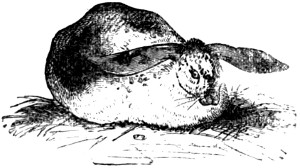
OAR-LOP RABBIT.

PERFECT-LOP RABBIT.

OAR-LOP RABBIT.
The Horn-Lop is another very curious variety, deriving its name from the position of the ears, which fall completely over the face, with their points directed to the front. In some specimens they fall so completely over the face that the edges pass over the eyes, and must act as a partial barrier to perfect sight, like the leather blinkers that are so absurdly attached to draught horses.
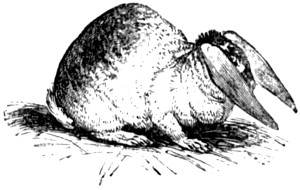
HORN RABBIT.
The lopped ears do not show themselves when the rabbit is young, and for the first month or two it is not easy to decide whether the little creatures belong to the straight or the lop-eared variety. Moreover, it often happens that one or two of each family retain the upright ears throughout their whole existence; and it is of not unfrequent occurrence that the “lop” is delayed for a very long time, and then suddenly makes its appearance. Sometimes one ear will exhibit the lop most perfectly, while the other remains upright or very slightly bent. Some fanciers attach a piece of lead to the recusant ear in order to make it coincide with the other, but we do not agree with the practice. The ear never looks quite natural, and as the rabbit will have or, as the phrase is, throw young ones with perfect lops, it may be kept for breeding if a doe; if a buck, it can be fattened for the table.
The second point of interest is the dewlap, the large double pouch which is seen under the chin and throat, and which is peculiar to the fancy rabbit. If the dewlap be not large and full, with its two lobes well developed, and sufficiently firm to form a cushion for the head while the animal reclines, the rabbit will be thought worthless by fanciers.
The shape of the fancy rabbit is very different from that of the common variety. It is altogether on a larger scale, and the back rises so much, that its summit ought to be two inches higher than the top of the head.
The colour, again, is very important. It may be white, black, mottled, tortoiseshell, blue, and in fact any colour except the plain grey. Whatever it be, it must be arranged after a special position. On each side of the nose must be a patch of the darker colour of the body, forming what is called the “butterfly smut.” A large patch on the back is called the “saddle,” and a row of spots termed the “chain” is drawn in front of the body and seems to hang over the shoulder. The legs must be white, and the tail and snout of the same colour.
Very few rabbits possess all these qualities; but even the combined excellences of smut, chain, and saddle will fail to gain a high rank for any rabbit which does not possess a good “carriage,” i. e. whose back is not at least two inches above its head, and whose nose and ear-tips do not nearly touch the ground. Some writers say that the fancy rabbits are more delicate of health and less easy to rear than the common variety; but we have bred many families of them, and never found any difficulty in rearing them. Their superior size renders them valuable for culinary purposes, and, as out of every family the greater number are deficient in the requisite marks of a fancy rabbit, the table can be well supplied with these fat and well-flavoured creatures.
The last variety we shall mention is the beautiful Angola rabbit, remarkable for its long silken hair, a speaking likeness of which may be seen in Landseer’s wonderful picture of Titania.
We will now devote a few words to the breeding of rabbits.
The rabbit will breed at a very early age, i. e. from eight months upwards; but those who want healthy young ought not to allow the rabbits to breed before they are one year old, or after they have completed their fourth year. The buck and doe should be always kept in different hutches, out of each other’s sight, and only allowed to remain together for a very short time. The rabbit usually breeds four times in the year, or even oftener; but as a general rule it is not advisable to allow more than three breeds in the year.
When the doe rabbit feels the time approaching for her young to be born, she begins to bite in little pieces the hay of her bed, and when she does so a supply of very fine soft hay should[570] be placed within her reach. She then pulls this together in her sleeping-chamber, and mixes it with downy fur plucked from her own body, ready for the reception of the expected family.
It is as well to put a pan of water within reach, as the animal generally thirsts after the young are born, and unless she can get at water, is apt to eat the young merely on account of the moisture. One of my own rabbits acted in a very odd manner. She called to one of her family, telling it to come to her. The disobedient child refused, and the mother accordingly seized it by one ear and dragged it along. Unfortunately, she pulled so hard in one direction, and the young one pulled so hard in the other, that the ear was fairly dragged from the head. The mother treated the matter very easily, ate the severed ear, caught hold of the other, and succeeded in reducing her offspring to obedience.
While engaged in maturing her young, the mother requires a very ample supply of food, eating nearly twice as much as at other times. She must have plenty of green food, and a mash of barley meal and milk will be found beneficial. For the first week or ten days the door of the sleeping-room should not be opened, as the mother-rabbit is very jealous of her young, and if they are handled, or even looked at, will sometimes eat them. This is a terrible habit, and if a rabbit once act in that manner, provided that she is well supplied with food and drink, the best plan is to fatten her for the table.
The young are suckled for about five weeks, when the mother weans them, and they learn to eat tender grass-blades, and other green food. If the family be very large, there is sure to be at least one small and weakly among the number. This should be removed and destroyed, so as to ensure that only the strong and healthy are reared.
There are several diseases to which domestic rabbits are liable, but these ailments are nearly all caused through negligence; and in a really well-appointed and carefully-tended rabbitry a sickly animal is hardly ever seen.
Except in the case of valuable fancy animals, the trouble and expense of attempting the cure of a diseased rabbit are so great, that few will find themselves repaid, even by the recovery of the invalid. Recovery, however, is so very dubious, that in almost every case it is cheaper and more humane to kill the animal at once, which is performed instantaneously and painlessly by holding the creature up by the hind legs, and with the edge of the right hand striking it a sharp blow behind the ears. Let the young rabbit-keeper rest assured, that if one of his pets should fall ill, the sickness will in ninety-nine cases out of a hundred be chargeable to some negligence of his own.
All the members of the Crow tribe have a decided family likeness; and, as a general fact, the relationship can be recognised as long as they belong to the British species. But as there are several foreign birds which bear a decided resemblance to this tribe, though really belonging to other families, it is needful to give a few hints as to the method by which these may be distinguished. The young observer must look first at the beak, then at the wings, and lastly at the legs. In all these birds the beak is strong and conical, arched on the keel, i. e. the ridge along the upper surface, with the sides rather flattened as far as the tip. The nostrils are set at the base of the beak, and hidden by plumes. The wings are never very large, and mostly pointed. The tarsi, i. e. the long, straight leg-bones, are of moderate length, and covered with strong, shield-like scales.
The British representatives of this large family are the carrion crow, the rook, the Royston or hooded or grey crow, the chough, the raven, the jackdaw, the jay, and the magpie.
The Raven, once so plentiful over England, is now nearly extinct, except in some of the wild uncultivated districts, where it still lingers, uttering its hoarse, loud cry, flapping its broad wings, and committing no small havoc among the young or feeble animals that have the misfortune to dwell in its neighbourhood.
To procure a raven is now a difficult task, and can seldom be accomplished except by giving an order to the regular dealers. We do not advise any of our young readers to possess themselves of a raven unless they have ample space for the bird, and are quite certain that it cannot get into any mischief. Either a magpie, a jay, or a jackdaw, seems to be possessed with an incessant spirit of mischief, but the raven seems to have enough for the three, and as it possesses enormous muscular power and irrepressible audacity, it is a peculiarly unsafe inmate of a house or garden.
For our own part, we have been for some months undecided whether we shall have a raven or not. We should greatly like to possess one of these birds, but then we know that he would pull up all our newly-sown seeds, bully our cat, peck the servants’ heels, get into the milk-pail, tear our papers to pieces, and, in short, spoil everything within his reach. We could, of course, chain him up, and clip his wings, or put him into a metal cage, but we think all such[572] proceedings to be needlessly cruel, especially in the case of a bird like the raven, whose instinct teaches it to roam far and wide, and whose opportunities of exercise ought never to be confined to the limited space comprehended by a chain or a cage.
When treated properly, the raven possesses a very mine of amusing and companionable qualities, at all events to those who treat it kindly, and whom it does not suspect of any intention to injure. It is a capital talker, equalling the parrot in that respect, except that the voice is very gruff and low, as if spoken from under a feather bed.
The raven is not long in taking the measure of its companions, and has a supreme contempt for those who display weakness of mind or resources. Nothing seems to make a raven so happy as frightening somebody. He likes to come quietly behind a nervous person, deliver a heavy dab at the ankle with his iron bill, and then walk away as if he knew nothing about the assault. He will frighten dogs half out of their senses, chase the cats, drive the fowls about, and as to the horses, he mostly takes a fancy to them, sitting on their backs, or walking calmly and deliberately among their legs. Indeed the raven always has a great affection for stable life. He likes to saunter in and out of the stalls, to flap his way from one horse to another, to peck at strangers, to patronise the helpers, to be on speaking terms with the grooms, and, we regret to say, has a strange talent for picking up all the evil language which is too often found in and about the stable-yard.
He encourages the presence of dogs and cats, because he always steals their dinners; and if he can find an opportunity of making a sly raid upon the luncheon of a groom, he is sure to seize it. He becomes the patriarch of the yard, and stands by his dignity as such. He won’t die, but lives on, year after year; sees successive generations of horses, grooms, and proprietors pass away, and seems to despise them for not living as long as himself. Time seems to have little power with him. His feathers take a greyer hue when he is a century or two old, but in disposition he remains ever young, malicious, crafty, active, quaint, and voracious.
He will eat anything, and can be taught to devour the most remarkable substances, provided that he thinks them very valuable, and not intended for food. Raw meat is perhaps his favourite diet, and he is greatly pleased with rats, mice, small birds, fat beetles, big grubs or worms, and similar delicacies. But he will eat bread when he cannot get meat; and if he can only be got to believe that the article is extremely valuable, he will make a breakfast on a newspaper or a shirt-collar.
He can be easily induced to swallow even a black-lead pencil or a pocket-handkerchief, by a very simple process. Drop the article as if accidentally, search for it anxiously, go away without seeming to see it, and hardly will your back be turned when the raven[573] will have snatched up the missing article and conveyed it to his storehouse.
If watched from a spot where the observer cannot be seen, he will be noticed to proceed in a very methodical manner. He will first pick up his prize, and walk about solemnly with it in his beak, as if displaying a captured trophy of war. He will then put his foot on it, seize one corner of the paper or handkerchief in his beak, and deliberately tear it into strips, which he will probably swallow. As to the pencil, he pegs at it with the point of his beak at a wonderful pace, making the splinters fly in all directions, and ever and anon looking round, to see that no one is watching him.
Clever as is the raven, and intelligent beyond the wont of birds, his very superiority in this respect often has the effect of rendering him a victim to superior powers. There is scarcely any bird that can be hoaxed more readily than a raven, or that can be “drawn out” with greater ease. Those who humour his ways can make a perfect puppet of him, and induce him to play most undignified antics, without giving him the least idea how thoroughly he is being imposed upon.
Our last advice is that, unless the reader can afford plentiful space for his bird, and assure it a kind treatment, he will act wisely not to attempt to procure a raven. Should, however, he be able to afford it these necessaries of existence, by all means let him procure one of these most amusing birds.
Ravens require scarcely any trouble, and when they have fairly established themselves, will not desert their homes under any circumstances. They ought to be fed once, and once only, per diem, for they will find plenty of insects, worms, and other little delicacies, without giving any trouble. They should always be furnished with a place of retreat into which they can retire whenever they feel tired of the world, and they like the hermitage to be deep, dark, and warm, sheltered from wind and rain, and out of the way of inquisitive eyes.
Finally, a raven is an excellent judge of character, and if he is really appreciated, he will become a firm and faithful friend.
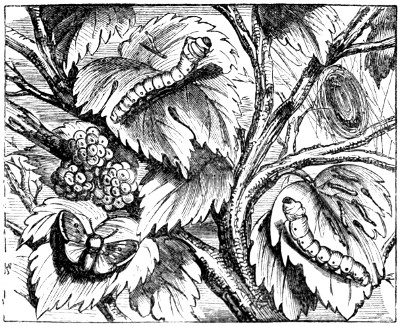
“The proudest king
May thank the silkworm for his robe of state.”—Akenside.
The rearing and management of silkworms is an innocent and agreeable pastime both to boys and girls, and it is very interesting in many points of view. One fact is, that while the caterpillars of all the other tribes of moths and butterflies, when they have arrived at a certain state of maturity, show a restless disposition, and wander about and hide themselves in a variety of places in order to spin their cocoons, the silkworm, on the contrary, is content to remain stationary in the open tray or box in which it may be placed. After consuming its immediate supply of mulberry leaves, it waits for a further quantity, and when the period arrives for spinning its cocoon, instead of showing any migratory disposition, it seems to place itself with confidence under the care of man to provide it with a suitable place for its convenience and protection.
The silkworm is systematically known under the name of the Bombyx Mori of Linnæus, or the Mulberry-tree Moth, which in the winged state is of a cream colour, with several transparent bands of a darker colour across the anterior wings and a crescent-shaped central mark. The caterpillar when full grown is nearly three inches in length, and is too well known to our young friends to need any particular description. The eggs when good are of a pale slate or dark lilac colour; they may be purchased in Covent Garden[575] market for about ten shillings per ounce; and care should be taken to obtain them of a proper colour, because those that are of a pale yellow are imperfect.
The silkworm when first hatched is black, and does not exceed in length one-fourth of an inch. The desire for food is the first symptom it exhibits of life, and at this period it is more active than at any other. When about eight days have elapsed after its hatching, its head becomes considerably enlarged, and it turns sick, refuses food, and remains in a state of lethargy for about three days. This sickness would appear to arise from the pressure of the animal’s skin, which has become too tight for the increased bulk of its body. Indeed, the very great difference in the size of the worm from the beginning to the end of the caterpillar state is so great, that Nature has furnished it with several skins, each of which it casts in succession.
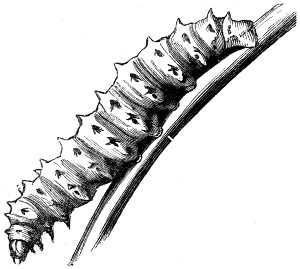
The body of the caterpillar is begirt by twelve rings, which approach to or recede from each other according to its motion; there are nine breathing-holes on each side of the body, seven eyes on each side of the head, and two small orifices below the jaws, through which the worm ejects its silken filament.
The art of using this filamentous substance seems to have originated with the Chinese, and to have been discovered at a very early period, and the raw material was purchased by the Persians, Tyrians, and Indians for a long time before it was introduced into Europe. For many ages silk bore an enormous price at Rome, but[576] about the middle of the sixth century two monks arrived at Constantinople from India, bringing with them the white mulberry and the eggs of the silkworm, which have since been reared in Italy, Spain, France, and other parts of Europe.
The silkworm feeds, as every one knows, on the leaves of the white mulberry; or, when these cannot be obtained, upon those of the black mulberry; or, in lieu of these, upon the leaves of the common garden lettuce. The white mulberry is especially cultivated for the value of its leaves, its fruit being insipid and very inferior to that of the common species, the leaves of which are equally good in this country for the food of the silkworm. There has been a variety lately introduced from the Philippine Isles (Morus multicaulis), which has larger leaves, and which is easily propagated by cuttings put into a cucumber frame in October, and transplanted in the following May; yet, still, to ensure success in the rearing of silkworms the young naturalist should stick to the old black mulberry, as such trees are to be found in various vicinities. To propagate this, a branch from another tree may be set in the earth, which will frequently grow. The amiable Sir John Philipport of Hammersmith, so celebrated for his “Elysian groves and fountains fair,” and for his sterling English qualities, has in his grounds a fine mulberry-tree, which he reared by placing a very loose branch in the ground in the autumn of 1850, which threw out roots, and started at once into a tree. The story of a gate-post made of a mulberry trunk becoming, and now remaining, a fruitful tree, is well authenticated. The leaves to be used should be those of a large and well-grown, prolific tree, and they should be gathered with care, so that the young buds of future leaves should in no way be injured; moreover, a tree should never be stripped twice in a year.
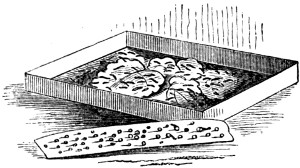
Having procured the eggs, which should be obtained about the latter end of April—they are generally bought on slips of paper just as they were laid by the moth—they should be placed in trays made of stout cartridge or thin pasteboard of the form seen in the cut, and there should be provided to go over the case some thin gauze. The trays may be placed in a window facing the south, where they are fully[577] exposed to the rays of the sun; there they should remain undisturbed till they begin to hatch; and as the young worms appear they should be removed into other trays, and fed with the mulberry leaves. The temperature should be regulated from sixty-six to seventy degrees, and the room ventilated, and preserved equally free from damp or too much dryness. They should be kept particularly clean, dead leaves and dung cleared carefully away, and in lifting them from one tray to another they should not be touched by the fingers, but removed by threads of cotton passed under their bodies, or with a camel’s-hair pencil.
The caterpillar has four moultings, which may be all accomplished in the period of four days each, if the heat of the room be increased to from ninety-five to one hundred degrees of Fahrenheit. When the heat is regulated to a lower standard, the first moulting takes place on the fourth or fifth day after hatching, the second in four days more, the third in five or six days more, and the last in about eight days. Ten days more are required after this moulting, so that in about thirty-two days after hatching the caterpillar has attained its full size. During all these changes of the worm it requires the nicest attention.
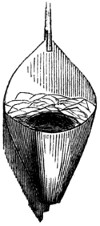
At the end of the time mentioned above the worms change to a clear pink or flesh colour, and look semi-transparent; they refuse their food, become restless, and prepare to spin or form their cocoon. At this time care should be taken to raise the walls of their tray habitation, or they will climb over them and be lost. What is called the cocoon nest should now be prepared by twisting the corners of a piece of writing-paper, and raising its edges into the form of the lower shell of an oyster. A number of these should be prepared and affixed to a piece of tape, with their pointed ends downwards; and into each one a single worm should be placed when it quits its food, and seems ready to spin: it will then dispose its web in such a manner as to leave a cavity within.
The cocoon consists of three distinct layers of silk: the first is loose and flossy, and is unserviceable for the silk manufacture; the second is closer, the silk crossing from side to side; and the third is still finer, and is glued strongly together, so as to form a compact inner coating.
When the cocoon is completed, the enclosed caterpillar again casts its skin, with the head and jaws attached to it, when it appears under the form of a conical chrysalis of the ordinary shape. At first the chrysalis, when opened, exhibits only a yellowish fluid, but by degrees the various parts of the future moth appear, and in about a fortnight or three weeks a slight swelling of the chrysalis indicates the approach of another change; a rupture down its back succeeds, and by degrees the moth bursts through its horny coating into the hollow chamber of the cocoon, and if left to itself would soon eat its way out.
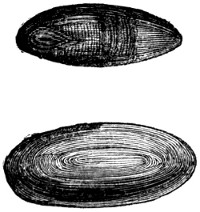
The chrysalis, however, must be prevented from eating through the cocoon; and previous to the egress of the moth from its aurelian state, the silk must be wound off. When, by taking up the cocoon, it is found that the caterpillar has passed into the aurelian state—which may easily be known by shaking it, as then the aurelia, from its harder texture and shrunken size, will be heard to rattle—then it is time to wind off the silk. The cocoon is placed in a cup of warm water, after the loose outward silk has been removed, and then, an end being taken, the whole continuous filament may be wound off on a piece of card. The length of the thread of a cocoon varies from 600 to 1,000 feet; yet the whole does not weigh more than three grains and a half. An ounce of eggs will produce about 40,000 caterpillars, which will consume 1,073 lbs. of leaves, and produce from 80 lbs. to 100 lbs. of cocoon, or about eight pounds of raw silk.
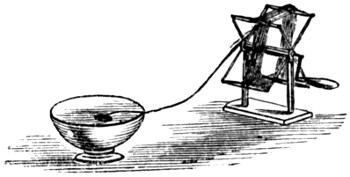
When the silk is wound off the aurelia presents itself, and being put in a separate case, it remains motionless for about twenty days, when suddenly it appears as a pale yellow moth, with wings which seem scarcely adapted for flight. It crawls heavily about the place where it has been hatched, having a slight tremor in its wings,[579] and eats nothing: the male speedily dies; the females hover about a while without flying, and lay their eggs on the slips of paper presented to them for that purpose. They then soon perish. The female moth generally produces about 300 or 400 eggs.
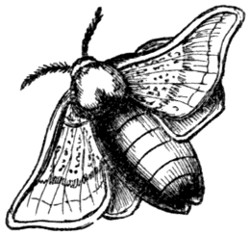
THE MOTH.
The place where silkworms are bred, should persons wish to pursue their rearing upon a larger scale, must be free from noisome smells, cattle, and all noises. Persons attending them must be scrupulously clean in their persons, and wash themselves after every meal. Great attention must also be paid to the temperature of the apartment in which they are kept, which must also be free from all dust or smoke; and the most thoughtful and tender care is requisite in everything connected with their treatment and management.

The pretty little squirrel has long held a high place in the affections of pet-lovers, and there are few who have not admired the brisk lively movements, the full intelligent eye, and the soft bushy tail of this creature. To possess a tame squirrel is often a legitimate object of boy ambition, not unfrequently shared by their elders. In order to give our readers a few hints as to the procuring, management, and taming of this pretty playmate, we offer the following suggestions.
The first care of every intending possessor of a squirrel should be to prepare a comfortable home for the expected guest, so that the little creature may find its first association with captive life as agreeable as it can be made. In point of fact, the young naturalist should try to give to the squirrel’s future home the greatest possible resemblance to the native domicile.
The very best house for a squirrel is an unused room, fitted up with strong tree-branches, and furnished with a cosy little box, filled with hay and dry mosses, by way of a bedchamber. As, however, such accommodation is not readily found, we will just describe the mode of making a very strong, sightly, and cleanly cage, at a comparatively small expense, and possessing the advantage[581] of coming to pieces when needed, and being packed flat like a portfolio for removal. It will be much cheaper than a purchased cage, quite as handsome, and more easily cleansed.
Make, or, if you are not a good workman, get a carpenter to make, a shallow wooden tray about two inches deep, lined with tin, which should be turned fairly over the edges, or sundry difficulties will appear in course of time. (See fig. 1.) Then go to a wire-worker’s, and order him to make two frames of galvanized iron wire, like fig. 2, and two more like fig. 3, each being about half an inch shorter than the interior length and width of the tray, into which they are intended to fit easily. Also have another piece of similar wire made large enough to bend over the arched tops of the end-pieces, so as to make a roof like the transepts of the Crystal Palace. The edges of the side and end-pieces should be very stout, but those of the roof only moderately strong, or it will not bend easily. It will be better to have a square opening at each end, which should be closed by a door of similar materials. As this wirework will be of coarse manufacture, and have tolerably wide intervals, the cost will be very moderate.
After these frames have been procured, fit them together, and fasten them by twisting bits of wire round the edges at intervals of three inches or so. Put this frame into the tray, and the cage is complete. The staples at the ends are useful for receiving the hooked end of a slight iron rod, looped at the other end to the edging-wire, as seen in fig. 4. These rods act as braces to keep the whole structure firm, and also hold it down to the tray. Some suitable sticks or branches should be fastened to the wires, as the squirrel is fond of playing about on them.
This is the day-room of the squirrel, and its bedroom is merely a proper-sized box, with wire-work substituted for the wooden[582] bottom, a hinged lid, and a hole cut in one end. This should be supported on four legs; a nail at each corner (not a brass-headed nail) will answer the purpose perfectly well. This box is simply placed in the tray at the back of the cage. If it can be managed, a duplicate tray will be exceedingly convenient, as the cage needs the extremest cleanliness, and can be simply purified by changing the tray every morning, washing very carefully the one just removed, and leaving it in the air till the next day. A duplicate sleeping-box will be equally serviceable. The box should be furnished with perfectly clean hay, mosses, lichens, &c.
The cage should never be less than two feet long, two high, and one foot wide. All should be thus particular about the size of the cage, because we hold it to be a cruel deed to take an active little creature like the squirrel from its fields and wide woods, where it can sport at will over unlimited space, and coop it up in a close, evil-smelling, little cage, where its only exercise can be obtained by driving a wheel round, and its wonderful faculty of leaping wholly checked. How much wheel-work would the squirrel do if it had the choice of a tree or a wheel for its exercise? Even in a cage, provided it be of a proper size, the little creature would not trouble itself to get into a wheel, but prefer clambering about the wires, and jumping from one side to another, in the exuberance of its activity.
Many persons assert that the squirrel is quite fond of the wheel, and delights in driving it; but they forget that the poor little creature is driven to that as its last resource for needful exercise; and it no more delights in pulling a wire wheel than the caged lion and tiger delight in their restless pacing of their dens.
The exercise of the powers with which it is so liberally gifted is essential to the health of the squirrel, and its health must suffer if it be not permitted to leap. Look at it in a tree, and just see what astonishing jumps the pretty creature takes; how it will spring fairly from the ground to the trunk of a tree, making a jump of some six or seven feet in length and four in height; how it gallops up the perpendicular stem, with its tail laid behind it, like a fox’s brush; how it scuttles up the branches, always contriving to keep the bough between itself and the spectator; and then how, when it has arrived at the topmost branch, and considers itself safe, it sits up in its own charmingly impertinent position, spreads its tail over its head, and looks down with a calmly supercilious contempt on the clumsy two-legged animal below, who cannot run up a tree, and has no bushy tail for a parasol.
No one who has once witnessed this sight could ever be guilty of such a cruel act as penning up a squirrel in a small cage, where it has no room to perform its pretty tricks; and if the reader cannot furnish his pet with a proper house, we earnestly dissuade him from keeping a squirrel at all.
Having prepared the house, the next business is to procure the inhabitant. Be ever wary of those wandering dealers who carry a squirrel about for sale in their arms, stroke its head, and put their fingers to its mouth to show its tameness. In almost every case the man is a cheat, and in many instances a cruel one.
The apparent tameness of some of these little creatures is caused by a small dose of strychnine, which renders the animal dull and spiritless, and is generally fatal in the course of a day or two; so that the disappointed purchaser finds his pet dead and stiff at the bottom of its cage before he has possessed it for many hours. Some of these men are said to employ a preparation of opium for the same purpose.
In cases where these impostors wish to sell an old and cross-grained squirrel as a gentle, young one, they pull out its front teeth, so that the poor creature not only cannot bite, but feels such pain in its jaws that it recoils whenever the cruel owner puts his finger to its mouth as a proof of its good education and gentle disposition. As all rodent animals depend solely on their beautifully-formed and chisel-shaped fore teeth for their subsistence, the unfortunate squirrel is unable to eat, and dies miserably of hunger.
Taking warning, therefore, of these hints, let every intending purchaser of a squirrel be very wary respecting the seller, and examine the squirrel’s eye, to see if it be bright and lively, and its mouth, to see if the teeth be perfect. The age of the squirrel may also be known by its teeth: if young, they are nearly white; if old, of a deep yellow. Squirrels when taken after they have reached their full age are nearly always vicious and ill-tempered.
The best way, therefore, to obtain a good squirrel is either to order it from a respectable dealer, who will be sure to supply a young and healthy animal, or to be independent of dealers, and take the creature out of the nest.
For this purpose the young naturalist should go into the woods about the middle of summer, and look carefully among the branches for the home of the squirrel, called either a “cage” or a “drey,” according to the locality. The nest is made on the exterior of leaves and fine twigs, and lined with moss, lichens, and similar soft substances. There are two kinds of nests, one used in summer and the other in winter. The winter nest is very carefully concealed, being placed at the junction of several large branches with the trunk, so as to shield it from prying eyes below, the blasts of the keen winter wind, and to support its large dimensions.
The summer cage, on the contrary, is not so carefully concealed, but is placed upon a considerable elevation, and often upon boughs so slender that they bend in a most alarming manner beneath the weight. Still, it often happens that a nest can be reached without danger, in which may be found one or two young squirrels of just the proper age.
When captured at an early age, the squirrel often becomes extremely tame and confiding, and will play with its owner as if they had both lived in the same nest. It is a pretty sight to witness the gambols of a squirrel with its human playfellow, to see the active little animal jump on the shoulders, run all over the body, perch on the head, poke its wise little head into a pocket, and then with a quick dive of the ready paw bring out a nut, which it straightway cracks and eats as merrily as if in its native woods. Such a sight is pleasant for many reasons; not the least being that it proves the kindly disposition of the boy with whom a squirrel, though naturally timid, will thus fearlessly play, and it gives promise of more extended sympathies when he attains to riper years and more matured faculties.
The squirrel when in confinement is best fed on the substances which it eats while in the wild state, such as nuts, acorns, corn, and similar substances. It will also eat bread-and-milk, and likes to nibble a biscuit by way of a treat. As the squirrel is known to be carnivorous to a certain degree, it may be useful to give it occasionally a young bird, or a few eggs of the thrush, sparrow, or any other common bird. We cannot, however, give personal testimony to the good effect of this diet. Hard shell-fruits, such as nuts, acorns, &c., are absolutely necessary to this animal, as the structure of the teeth compels it to be continually nibbling. In all the rodent animals the front teeth are four in number, flat, slightly curved, and edged like a chisel. They play against each other in such a manner that they mutually keep each other sharp; and in order to supply the constant wearing away to which they are subject, they[585] grow throughout the whole lifetime of the animal, being pushed forward by fresh growth at the base.
It sometimes happens that a rodent animal, such as a rat or a rabbit, loses one of its teeth, and the consequence is that the corresponding tooth in the jaw, finding nothing to check it, grows so long that it has been known to reach even the forehead, to form a complete ring, and sometimes to penetrate the other jaw. In all these cases the poor creature was miserably thin, and would probably have died from gradual starvation at no distant period.
The last-mentioned point in squirrel-keeping, though of course the most important, is the absolute necessity for the most scrupulous cleanliness. In their native state, all animals are clean to a degree that might shame many a human being, and their instinctive sanitary customs are most praiseworthy. Even the pig, for instance, so often cited as an example of filthy habits, is when wild a model of cleanliness, and when domesticated absolutely revels in a thorough scrubbing with soap and hot water. The squirrel, in like manner, though perfectly sweet and clean in a wild state, is sure to be most offensive in captivity, unless the cage be carefully purified daily.
It is for this reason that we are so particular in recommending galvanized iron for the materials of the cage, avoiding wood altogether, as an evil odour readily penetrates wood, and can never be totally expelled. The duplicate tray and sleeping-box will prove to be of the greatest service in keeping the cage clean, and will save much trouble to the proprietor and annoyance to the inhabitant.
Should the squirrel-rearer prefer to employ wood in any part of the cage, he must be sure to bind with sheet-tin every edge and angle of the woodwork, as the little creature will nibble at the exposed edges so continually with its chisels of teeth, that it will speedily render the article useless.
Before closing these remarks, let us enjoin on every intending rearer of a pet to consider well before he undertakes the sole guardianship of any creature, and to assure himself that he will perform with punctuality and completeness the many little offices required by animals when taken from their natural state of existence, debarred from the exercise of their ordinary capacities, and rendered incapable of procuring food or keeping themselves in that state of cleanliness which is the ordinary condition of creatures in a state of nature.
He must make up his mind that the task will be somewhat troublesome, and will now and then interfere with contemplated projects; but at the same time he must rigidly determine that nothing shall cause him to forget, or induce him to omit, one single duty towards the little creature under his care. It is dumb, and has no language to declare its wants or proclaim its injuries; and this very dumbness ought to incite in every right-feeling heart a strong compassion[586] for the helpless state in which the creature is placed, an unshakeable resolution to make it as happy as it can be under the circumstances.
It is possible to elevate the character of a kindly-treated pet to such a degree, that it will voluntarily forsake the society of its own kind for that of man, and even if granted its liberty, will refuse to avail itself of the gift, and return to the protection of the sheltering hand. By humane and sympathetic treatment a pet may be made happier than in its native state, and be saved many pangs of suffering by a kindly owner. All animals when wild have to pass through a sort of schooling, and get sadly knocked about and bullied by their elders before they attain maturity and strength to become bullies in their turn; but if reared in gracious captivity, they will escape the ordeal through which they must have passed.
Lastly, let the owner remember that his little favourite is wholly dependent on him for every necessary and comfort of life, and that it will be a piece of arrant cruelty—or, at all events, of inexcusable thoughtlessness—to permit the captive to feel the pangs of hunger or thirst, or to suffer the discomfort of an unclean home.
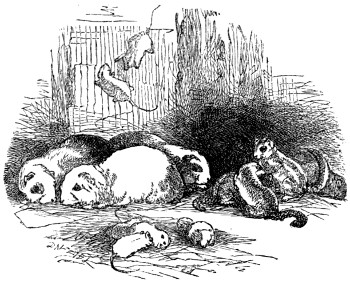
The mouse is a lively little animal, and one of the most timid, although he eats in the trap as soon as he is caught. The brown mouse can very rarely be tamed; but white mice are bred and brought up in a state of domestication, and the young fancier can obtain a pair for a shilling at any of the fanciers. The female has frequently six or eight broods in a year, but at these times she must be separated from the buck, who very frequently destroys the young ones.
Cages for white mice may be easily purchased by those who have the money—mark that—and you may indulge yourselves, my young friends, to any tune, from the sweet jingle of sixpence to the respectable clink of a golden sovereign. The best kind of cage is that like a squirrel’s, but on a small scale.
Some boys who have ingenuity will construct pretty little houses for their white mice. We remember seeing one on which there was a mill, by which the white mice, very much like millers in their looks, ground their own corn by means of a turnabout fixed on a post of the dormitory, and it was very amusing to see the little creatures come out of the chimney and look about as unlike chimney-sweeps as white is to black.
The principal food for white mice is bread-and-milk, oatmeal grits, and any other common food, except cheese, which is bad for them. They should be kept particularly clean, and their cages[588] ought to be arranged, and beds made up every day, or they will give out a most disagreeable smell.
Piebald mice are sometimes produced by a union of the common field-mouse with a white mouse: there are also some expensive varieties, such as the black mouse, and the black and white mouse, which the young gentlemen who have more money than wit may purchase for a few shillings each; but we say sixpence: sixpence apiece is enough for any pets of this kind.
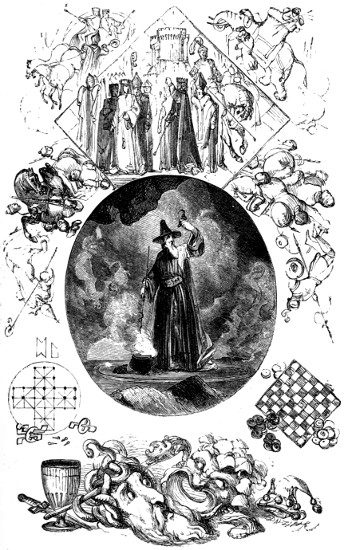
MISCELLANEOUS—CONJURING, CHESS, ETC.
INCLUDING
Whatever diversity of opinion there may be with respect to the skill required to excel at bagatelle, there can be none with regard to its popularity. The familiar long green table, with its round end and nine numbered cups let in level with the cloth, is found nearly everywhere. The games played on a bagatelle board are various, the principal of which are, English bagatelle (which is the ordinary game), French bagatelle, Sans Egal, Mississippi, Tron Madame, the Cannon game or Bagatelle versus Billiards. Many of the strokes at billiards will be found useful at bagatelle, but much less strength will be required.
May be played by any number of persons. The order of precedence is settled by each person striking a ball up the board, and whoever gets the highest number takes the lead and possession of the whole nine balls. He places his ball on the white spot nearest the striking point, and the black ball (which counts double) on the spot nearest the holes. The black ball must be struck at the commencement of every round, but afterwards the player can either play for the holes direct or by striking the other balls. The mace or cue may be used, as agreed upon. Any number of rounds may be played, and the score is counted from the marked holes into which the balls are driven. The sides of the table are filled with holes and pegs to mark the progress of the game.
Differs from the English in two or three essential particulars. It is generally played by two or four persons, who, instead of playing with the whole nine balls, take it in turn to strike, and score all they make until a hole is missed. The player forfeits one point if he misses the black ball, which counts double, as in the English game. A hundred up is the usual score, and occasionally different values are given to coloured balls, so that a black counts double, a red the same, or adds two to the score otherwise made.
Is a favourite game for two persons. The lead is decided as in the English game, and each player has four balls of different colours.[592] The black ball is placed as in the English game, and the players take alternate strokes. The one that holes the black ball counts it towards his game, as well as all he may hole of his own; but should he hole any of his adversary’s, the number is scored to the owner of them. The game is played 21 or 31 up, and the winner of one round takes the lead in the next.
This is also called “Billiards v. Bagatelle,” and is played by two persons,—101 up. Three balls of different colours are used—black, red, and white: the choice of the two last, and the lead, is determined as in the English game. The game is commenced by placing the black ball on the spot; but should the player miss it, his opponent scores five; and if the ball is holed at the same time, the number of the cup is also counted to his opponent, who then takes the turn. The black ball invariably counts double, and is taken out of the cup every time it is holed and placed on “the spot,” as at the commencement. If the player’s ball is holed after contact with the black ball, or after having made a cannon, it counts the number of the cup, and is returned to him, when he continues to play until he misses. A cannon scores two to the game, but the black ball must be struck first, or else five is added to the adversary’s score. There are a few other points to be observed. The player continues playing after making a cannon, or after holing his own or adversary’s ball, if he has struck the black ball first. Should any ball rebound beyond the centre of the table or be forced off the board, it must not be played that round, unless it is the black ball, which must be placed on “the spot,” as at the commencement of the game.
This is a variation of the game by means of a wooden perforated bridge, each arch of which bears a particular number. The bridge is placed close up to the circle, and each player strikes up one ball; he who gets the highest number takes the lead, and plays the nine balls successively. The balls must strike one of the cushions previous to entering the bridge, otherwise the number will be scored to the adversary. The game may be played 30, 60, or 100 up, as may be agreed on.
Of all indoor games, billiards ranks highest. It is without doubt the king, and reigns triumphant over chess, backgammon, parlour croquet; and since those delightful miniature billiard tables have been introduced, it is rapidly superseding bagatelle as a parlour game. These miniature tables possess all the advantages of the larger and more aristocratic tables. The same principles operate, the practice is similar, and the laws which govern the play are alike; need it be a matter of wonder that billiards is fast becoming as popular and universal as it is excellent?
When a boy first tries his hand at billiards, he is generally confounded by the apparently erratic conduct of the balls. They are apt to diverge into the strangest places, and somehow manage to remain precisely in those spots where a practised player can make a good break from them. This arises first from the want of a knowledge of the laws which regulate moving bodies, the general principles of billiards, and an acquaintance with the various “strokes,” and the effects they produce. Thus to become a good billiard-player requires a nicety of touch, a good eye, and sound judgment. These are to be acquired if the player attends to the following principles and points of the game.
Most boys are aware that billiards is played on an oblong table twelve feet long by six feet wide, inside the cushions: the smaller tables preserve these general proportions. In France, for instance, the table is some four feet by eight feet, and without pockets, it being used solely for the cannon game; but English tables have invariably six pockets, one at each corner and two at the sides. No good table is now made without a slate bed, perfectly level, and covered with fine green cloth. The old list cushions are now superseded by those made of vulcanized india-rubber, which not only resists the deteriorating influence of the weather, but increases the “speed” of the table. The surface of the cloth is marked with three “spots.” The first “spot” is placed about twelve inches from the upper end or top of the table, and is known as “the spot.” The second is placed two feet six inches from the top, and the third is in the centre of the table. Two feet six inches from the bottom of the table is the “baulk line,” on which is inscribed a semicircle, called the “striking point,” shown on figs. 4 to 7. The position of the semicircle is also marked by three spots, one at each end and one at the centre.
The moveable adjuncts to the table are cues, balls, butt, and a rest or jigger. With respect to these one or two words of advice. See that your cue is well balanced; beware of fancy cues; let the leathered tip be moderately broad, and keep it always well chalked. The balls are perfect spheres turned out of the centre of the tusk. It may be mentioned that the ordinary length of a cue is four feet nine inches, and the diameter of “match balls” is two inches and a sixteenth. The “butt” is a stiff, thick cue, well leathered at the butt end, and is used occasionally for pushing the ball when it is necessary to come off a cushion at an exact angle. The uses of the “rest” and long cues are obvious.
Ere touching on the game itself, there are a few essential points which claim the attention of a young player. They are these: 1. The attainment of a good position. 2. The making of a firm “bridge.” 3. The acquirement of a good, easy, but firm, stroke. The last two essentials depend in a great measure on the first. It is obvious that the billiard player requires an easy play for his right arm, and firmness in his left to give solidity to the “bridge.” To ensure this he must stand firmly on his right leg, so that it supports the weight of his body. The left leg should be placed slightly in advance, and pressed gently to balance the body only. This will throw additional weight on the left arm, which rests on the table, and leave the right arm free. If the position is a good one, the left leg may be lifted from the floor without disturbing the body. To form the “bridge,” the left hand must be first extended on the table, and the fingers drawn up straight towards the wrist, so as to elevate the knuckles. If well done, the tips of the fingers, the wrist, and ball of the thumb will touch the table. The point of the thumb must be then kept slightly apart from the fingers to form a groove, in which the cue can rest, as shown in fig. 1.
The bridge should be formed almost six inches from the ball. To strike well, surely, and firmly, the cue must be held in the grasp of the right hand. This is essential, for unless the cue is so held it will be impossible to make a good, and therefore a sure, stroke. All fancy modes of holding the cue by the tips of the fingers should be avoided. The cue may be laid on the groove of the bridge, and drawn back, and then firmly and steadily send it forward in a straight[595] line, keeping the right hand well down behind you, so that the force of the blow comes from the shoulder, not the elbow. The eye must be educated to guide the hand, and, hit or miss, the stroke should be given at once. There should be no hesitation, no see-sawing of the cue to and fro, and no violent motions whatever. The body should be so placed as to give firmness to the bridge, ease to the right arm—which should be kept straight, with the point of the cue slightly above the surface of the cloth—and a general freedom from constraint, which is highly essential to success.
The best method of practice for a young beginner is to place a ball before his cue and strike it firmly and gently into different pockets, or at different marked points of the cushion, until he can pocket the ball and hit a given point with freedom and precision. The ball must be fairly struck with the tip of the cue, not pushed or jerked forward; and hence it will be necessary to draw back the point of the cue five or six inches ere striking the ball. The stroke, though firm, must not be violent, lest the natural angles of the table should be destroyed. If the ball is watched carefully after it has struck the cushion, it will be found to return at an exactly equal angle to the one at which it was struck. In other words, “the angle of reflexion is equal to the angle of incidence.” This is the first and most important rule of billiards, and one that should never be forgotten. The variation of the strength and direction of the stroke will be found to materially affect this law, and enables the skilled player to make those formidable and seemingly impossible strokes which secure him his victory. This peculiarity of the angles is best illustrated, and the practice of the student advanced, by placing another ball at a little distance before the player, which we will call the object ball. If we place them in a line with one of the marked places on the cushion, and strike the first ball fair in the centre, and cause it to strike the object ball full,—if this is done, it will strike the marked spot, and come off at the same angle as your first ball would have done.
For the purposes of play the object ball is divided thus:—
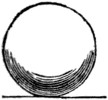 |
 |
 |
| 1. Full Ball. | 2. Three-quarter Ball. | 3. Half Ball. |
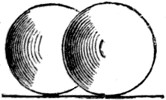 |
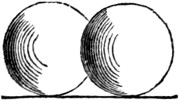 |
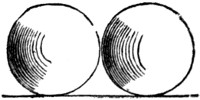 |
| 4. Quarter Ball. | 5. Eighth Ball. | 6. Very fine Ball. |
| Fig. 2.—Dividing the Object Ball. | ||

1. Full Ball.

2. Three-quarter Ball.

3. Half Ball.

4. Quarter Ball.

5. Eighth Ball.

6. Very fine Ball.
Fig. 2.—Dividing the Object Ball.
Fig. 2, No. 1, shows the object ball struck full, fig. 2, No. 2, the three-quarter ball, and so on. The half ball is the most important in practice, as by it the natural angle is made, an angle that is of the greatest importance at billiards, though each have their particular uses, which the young player should endeavour to understand. He will find that the balls diverge at different angles, more or less acute, according as the object ball is struck “full” or “fine;” the fine ball being precisely the reverse of the three-quarter ball.
There are many ordinary hazards and cannons which can be made by simply dividing the object ball, but the motion which the striking ball obtains after contact with the object ball will be modified by the position of the cue and the manner in which it is struck. First let us take the position of the cue. For the full centre stroke or straight hazard the ball must be struck well in the centre, and produce what is termed the retard, or stop ball, if the object ball is struck full likewise. If the striker’s ball is struck considerably above its centre, it produces the following stroke. To make the ball jump, it must be struck sharply on the top with a “downward, forward motion,” and this, if carefully done, will cause the ball to jump over a neighbouring and intervening ball. When the ball is struck low, it produces the recoil, and the striker’s ball will return from the object ball to[597] the player. This leads the beginner to the greatest of all modern improvements in the game, the side-stroke. It is found that it is much easier to divide the striker’s ball with accuracy than the object ball, but when both balls are divided with judgment the highest scientific play is obtained. The application of side and twist to the striker’s ball is often misapplied by beginners, and is frequently the cause of mischievous results; for all students should remember that “the harder you strike the balls the more rapidly they fly apart;” and frequently a modification of the strength of the stroke will achieve the desired result better than the application of “side,” which may fail. It should always be remembered that the ball must be struck on the side on which it is intended to go after contact with the object ball, and that the effect is not produced until after it has come in contact with another ball or the cushion. It is used for the same purpose as the division of the object ball, and accomplishes the same object. In order that it may be properly understood we give in fig. 3 the player’s ball divided for the side-stroke.
The student can only acquire a knowledge of the effect of the strokes given at these varied points by practice, or from the instruction of an expert teacher; all that a writer can do is to lay down well-defined and easily-understood axioms, rules, and cautions. Thus, if the ball is struck at c c, at the top, it becomes the following ball; at the bottom c c, a recoil; at f f it will give a strong side to the ball at the lower angles, the screw or twist, which causes the balls to twist back; the upper angles will give high right-hand side or left-hand side, according to the side they are struck.
Should never be forgotten. They change infinitely, and if the student has made good use of the hints given as to the elementary practice with one ball, he will have acquired some valuable information, and soon see the truth of the axiom, that the “angle of reflexion is equal to the angle of incidence;” and the advantage of a knowledge of the angles of the table will be best seen in making cannons, for many players will make them off one, two, three, and even four cushions.
Fig. 4 shows a series of very useful angles, which may be advantageously studied. The black lines represent the course of the ball before reverberation, the dotted lines its course after the first reflexion, and the faint lines its course after the second reflexion. In these examples the ball is supposed to be struck fairly in the centre with moderate force, except in case 1, where the effects of different strengths is shown. An ordinary, moderate stroke would bring the ball into the left-hand corner pocket, while a harder stroke would produce the angles a b: if played with greater strength the angles c d will result. “Bricole” angles are made across the table, and are of course proportionately more acute. The Bricole game is being obliged to strike a cushion, and make the ball reverberate or recoil[598] from it previous to hitting the adversary’s ball. This is a very great disadvantage, and is used principally in “cramp games,” where the advantage of one player is neutralized by this; or by playing cannons against cannons and hazards, or four pockets to two, or five to one, or cannons and winning hazards against the whole game.
All strokes at billiards are distinguished by the name of cannons or hazards. Cannon is a contraction of carambole, and is a stroke in which the player strikes both balls in succession with his own. The[599] “losing hazard” is when the player’s own ball is forced into either of the six pockets, after contact with the other ball. The “winning hazard” is made by forcing the ball played upon into either pocket after contact.
Here are a few examples of cannons made from the cushion, without the use of the side-stroke. They only indicate the infinite variety that can be made.
Some rather difficult, but useful, winning hazards are shown in fig. 6. The stroke A is termed the “spot stroke.” This stroke is sometimes made a score or more times in succession by a good player. It is one of the best of winning hazards. It requires a nearly full ball of moderate strength, and to repeat it from one side to the other you should slightly divide your own ball by putting on a little side (see D e in fig. 3); and you will find your ball in the right position to repeat the stroke. Sometimes it may be made by a slow hoist, which causes the ball to come back to the starting-point; or the ball may be stopped a little behind the object ball, and thus make a succession of hazards from the same pocket. The champion billiard-player, Roberts, makes tremendous breaks from the “spot stroke.” Get a good player to show the variety of ways in which it can be made, and practise it. Here are a few examples of the effect of dividing the object ball. Strokes 1 to 14 are made from the baulk into the top end pockets by dividing the object ball from a nearly full ball, as in 10, 11, 12, 13, 14, to an eighth in 1 and 9. Stroke 5 represents a half ball vulgarly called a pair of breeches. Stroke 11 should be made to hug the cushion. Strokes 15 and 16 must be played gently with a half ball, and 17 with a quarter ball. Strokes 18 to 33 show a variety of cuts made[601] by striking the ball in the direction shown by the line between the white ball and the red.
Now for a few losing hazards. They require a little different treatment. Here are a few.
The first eight strokes require a screw, and more or less side, according to their position; 9, 10, 11, and 12 require strong side, as shown; and in 13 the striker’s ball must first strike the cushion gently, rebound, hit the other ball, and fall into the corner pocket. Stroke 14 is an ugly position for a beginner, yet it frequently occurs. You must put on plenty of side to your own ball, which will remove the object ball, and your ball will then roll along the cushion into the pocket. Stroke 22 alone requires a word in explanation. It shows now the losing hazard is made from baulk off the red on the spot. Put on a strong-side twist, and practise it well. Remember that practice can alone make perfect. Be always decided, play steadily, and do not lose your temper.
Now for a few hints with respect to the games to be played. With every billiard table a set of rules is supplied, and these must be studied and obeyed, as regulating the game; but an endless variety of games may be extemporised to suit the various parties and skill of the professors.
Is played with four balls, a light red, or pink, and dark red. The balls are placed on the spots in the centre between the pockets. The baulk is not confined to the semicircle, but you can place your ball anywhere within the line which is extended level with the winning-hazard spot. The game is usually played 63 up, and consists of winning hazards and cannons. In this game “doubles” are of great advantage. Doubles are so called when a player strikes his own or an object ball at a certain angle of the cushion, so as to cause it to come off at an equal angle and go into a pocket at the opposite side of the table. It is called a “double double” if the ball returns and goes into a pocket on the side of the table it first struck; and there is a game in which no score is made unless the cushion is first struck with the ball.
Is played with fifteen red and one white ball. The red balls are arranged in a triangle, thus:—
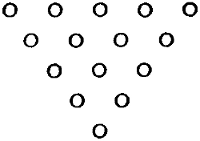
The first ball is placed on the winning-hazard spot. The white ball is placed in baulk. The game is placed by holing all the red balls. A great deal will depend in this on keeping the white ball safe, so that your adversary may have to play a cramp stroke. It is a pretty game to play with friends. Pyramids can be so modified as to suit a number of players, each striking in succession, and scoring according to the number of balls pocketed. A small stake is placed on each ball to give an interest in the game. When played in this manner, the winner who scores the greatest number takes the stakes.
Is played by either two or four persons. Winning and losing hazards, cannons, and forfeits, go to make the score, which is usually 50. If four players make a match, and play side against side, they play 63 up, and the partners may instruct each other. This plan is open to objection, and a far better one is for each to play his own game, and handicap the inferior players by giving them ten or fifteen points at the commencement. In this case, if either party gives a miss, it is far better that he should lose one point than the others should take one each. The white and spot white balls are then played alternately, as if only two were playing. The game commences by stringing for the lead and the choice of balls. The[603] player must place his ball within the striking ring, and stand within the limits of the corner of the table. He whose ball rests nearest to the cushion at the baulk end of the table wins the lead, and chooses his own ball. A few general hints respecting the rules only is necessary. The red ball is placed on the lower of the two spots at the bottom of the table, and replaced there when it is holed (i. e. pocketed) or forced over the edge of the table, or when the balls are broken or, in other words, placed as at the commencement of a game. Whoever breaks the balls leads off. With respect to scoring: if the striker holes the white ball (called a white winning hazard), or if he holes his own ball from the white ball (called a white losing hazard), he gains two points; if he does both, he gains four points. If he holes the red ball, he wins three; and if by the same stroke he holes his own from the red, he wins three more.
There are several ways of playing pool. There is the ordinary game, with as many balls as there are players, or with two balls only, the players playing in turns, and playing with alternate balls; playing with the nearest ball; playing at the last player; or the player playing at whichever ball he chooses. The most popular game is that in which the player plays at the last player. When coloured balls are used, they are played as the colours are placed on the marking board. Each player has three lives at starting. But there is this drawback to pool: if the player happens to lose all his lives in rapid succession, he is condemned to inglorious idleness until the pool is played out, and then the same thing may happen. This may be obviated by allowing the lives to be unlimited, and paying nothing into the general pool, so that if a player’s ball be pocketed, he has only to pay his stake and remain on hand until his turn comes round again. In this manner the players may continue their game for an unlimited period, and a new-comer may join the game at any time.
There is a cannon game which affords excellent practice. All the pool or pyramid balls are ranged in a line against the top and bottom cushion, having the plain white ball in the middle. A cue is then laid flat against them, and they are pushed along the table, so as to strike the opposite cushion. The object of the player is to take the white ball and make as many consecutive cannons as possible. Should his own ball run into a pocket, he is obliged to stop and let the next player in; and if any of the coloured balls run into a pocket, it must stay there, and of course decrease the chances of a long series of cannons. This is much more difficult than it looks.
There is a cannon game with one red and the two white balls. In this pocketing either of the white balls causes two to be deducted from the score, and pocketing the red ball loses three. The regular French game consists of cannons only; misses and pockets[604] do not count either way. It is usually played on a French table, without pockets, with two and a half inch balls, and a heavy one. The baulk is not confined to the semicircle. At the commencement the red is placed on the winning spot, and the non-striker’s ball on the centre spot in baulk.
Is an excellent game for boys. It is played thirty-one points up. Four balls are used, two being white, one red, and one blue; and five skittles are placed in the centre of the table. Each of the skittles is numbered in the following order:—The first opposite the baulk is numbered 1; the one to the right 2; the one opposite to the first 3; the opposite to the second, on the left, 4; and the one in the centre 5. The red ball is placed as in the cannon game, the blue one beneath it. The two white balls are kept by the two players who have to play first. There is a peculiarity in this game, from the fact that a number, from one to sixteen, is chosen by the player at random, and the marker secretly adds it to the score, and in order to win the pool the player must make between the points of the game and those on the hidden ball thirty-one points, neither more nor less: if he makes more he is technically dead, and out of the game. The first player has to strike the red ball, the second the blue one, while the following players may use either. The points are made by knocking down the skittles, each of which counts as many points as its number, and by whatever ball these skittles are knocked down they always count. If a ball is knocked out of the table, it destroys all the points made by the stroke. Any player reaching twenty-nine or thirty points has a right to stop on his declaring so, only the points he makes in his subsequent play count to the advantage or disadvantage, whichever it may be, of the previous player. The survivor from amongst all the players who have died by overstepping the thirty-one points wins the pool. He who knocks down the four outside skittles, leaving the centre one only standing, makes what is called the royal, and wins the pool. There are some minute rules about stopping, which must be declared immediately on reaching twenty-nine or thirty points, and only one person can stop. The advantage of stopping is the chance of being the survivor.
On a wet day, in a country house, the best round game is Penny Pot, played like pool, and for every ball pocketed the player receives a small stake, and plays until he ceases to score. After making a winning hazard, the nearest ball is played on. A life is forfeited for every miss, coup (i. e. playing a ball into a pocket without its touching another ball), or losing hazard, and paid to the owner of the ball played on.

This truly English amusement cannot be too highly extolled, as it is calculated to incite boys to emulate each other in acquiring proficiency in an art which exercises their ingenuity and taste, while it inculcates habits of patient industry. A good sailing ship is rather a troublesome thing to construct; but when a lad sees it “walk the waters like a thing of life” he experiences feelings which fully repay him for all his labour. Every boy ought to learn to swim, if only to prevent anxious parents including boat-sailing with dangerous pastimes that ought not to be encouraged. We are always pleased to see boys sailing their miniature vessels, and we cannot think that an occasional ducking ought to interfere with an occupation so befitting to the youth of a great maritime nation. As long as French boys amuse themselves with playing at soldiers, we trust English boys will continue to build and sail their model ships.
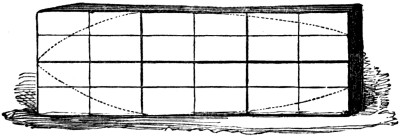
If you wish to possess a good ship, you must make it yourself, as the smartly-painted vessels of the toy-shops are usually made to sell, and not to sail. To form the hull you will require a few carpenter’s tools, such as a couple of chisels, a gouge, and a saw, in addition to that invaluable instrument, a good pocket-knife. Having procured a suitable piece of good white deal, with a straight grain, mark a line down the middle, on the upper and lower sides, and at both ends; then mark out with pencil the shape of the intended vessel, which should be broad in proportion to length, and deep in proportion to the[606] width. Most boys shape their vessels before scooping them out, but it is far better to reverse the process, and hollow out the wood before commencing the outside. The deck is to be made of a thin piece of deal, and must be fitted very accurately, so that no water may enter the hold. A flush deck, without a raised edge or gunwale, is to be preferred, as such a deck does not hold the water.
The mast should be made of strong, light wood; should be tapering, and rather long. The less rigging there is the better; two shrouds and a few stays will be enough. The best models for miniature ships are those vessels that are rigged “fore and aft,” such as cutters and schooners; square-rigged ships are unmanageable unless made very large.
Our first illustration shows a model cutter, with her sails set. The principal sail is termed the mainsail, the one above it the gaff topsail, and the triangular sail attached to the bowsprit the foresail or jib.
The blocks used in rigging a model ship are to be made of boxwood or alder. The latter is a softer wood than the former, and can be more readily fashioned into shape with a penknife. The holes for the cords should be bored through the pieces of wood before they are shaped into blocks, as it is not easy to drill the blocks without splitting them. The rudder should be attached to the keel by bent pins. The little staples on the keel, in which the bent pins work, are to be formed of brass wire. The stem of the rudder passes through a hole in the stern of the vessel, and is provided with a tiller. Before launching the ship, the tiller must be fixed so as to keep the rudder at the required angle. Many boys fear to launch their ships in large[607] ponds; but if a ship is properly rigged, and answers to her rudder, there need be no doubt as to her safe arrival at port.
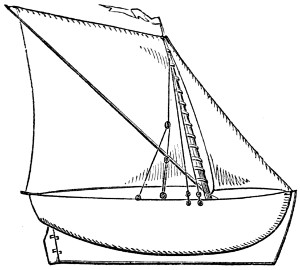
SMACK.
The smack is not so graceful as the cutter, but is a capital sailer. The large sail is called a spritsail, from the spar or sprit which crosses it diagonally from the mast to the upper aftmost corner.
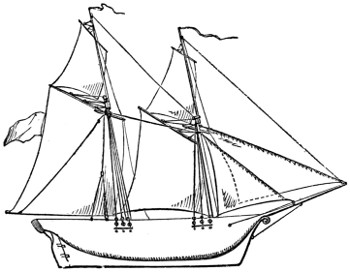
SCHOONER.
A schooner is a vessel with two masts, and fore-and-aft sails like[608] those of a cutter. The schooner-rig is not suited to very small boats.
The lugger is shown in the annexed engraving. The lug-sail which distinguishes this rig is a square sail fastened to a yard that hangs obliquely to the mast at one-third of its length. A lug-sail may be fitted to a single-masted boat. The lugger is an excellent boat for sailing, but it lacks the trim appearance of the cutter.
Cutters or schooners intended for fast sailing should have but one foresail, as a large balloon-jib rigged with a boom holds more wind than an ordinary jib and staysail. The ships should be well ballasted to prevent the wind capsizing them, and their topmasts should be made moveable, as in rough weather it will be found necessary to “strike” them. Each boat may have two sets of sails—one set large, for light winds, and the other considerably smaller, to be set up when the wind is high. The sails should be made of very light stuff—thin calico is best—and should have a line run round them, with loops for hooking them on to the spars. Beware of putting too many blocks and useless ropes about your boats, as the lighter the upper part of a vessel is the better she will sail. In conclusion, spare no pains in finishing your work neatly, so that your boats may bear witness to your skill and patience.
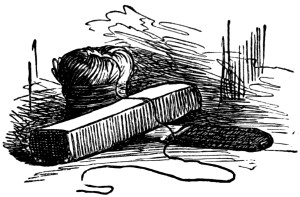
THE RAW MATERIAL.
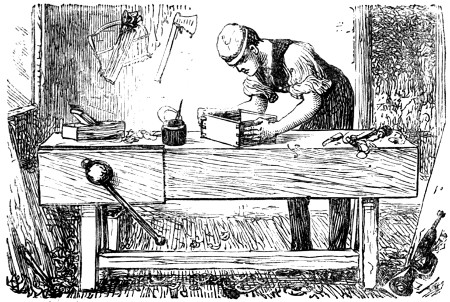
Nothing is more useful to a youth than to be able to do a little carpentering. To be handy with a chisel and saw, a nail and a hammer, saves many a pound in the course of the year. If you call in a carpenter for a little work he is sure to spin out a “regular job.” I remember once buying some oak saplings, which cost me eightpence a stick; and wanting to build a summer-house, I required eight of them to be sawn through, so I applied to a carpenter, and the sticks were cut, but to my astonishment, sixteen shillings was charged for this little “job,” although the wood cost me only five shillings and fourpence. I found out afterwards that the proper price for sawing would have amounted to about four shillings, so that twelve shillings profit was clapped on for the benefit of my experience. I just mention this to show my young friends, that if they wish to make summer-houses for their gardens, cages for their birds, fowl-houses, rabbit-hutches, or boxes for their books, they must learn to make them for themselves. I shall therefore offer them a little advice upon “carpentering.”
Endeavour to procure some small outhouse, in which you may erect what is called a carpenter’s or joiner’s bench. These may very[610] often be bought second-hand, or if not, can easily be procured at a reasonable rate. I am very particular in recommending a bench, as without it you will find many obstacles to your work. You must also provide yourself with a set of tools,—gimlets, hammers, planes, saws, gouges, files, nails, screws, and such articles of use.
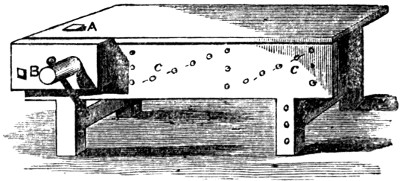
The bench is composed of a platform or top, supported by four stout legs; A is what is called the bench hook; this ought to be fitted in tight, so as to move up and down with a hammer only. The use of it is to keep any wood steady you may have to plane: B is the bench screw, used for keeping any wood firm and steady you may have to saw, which is to be put in the grip and screwed tight. Sometimes the edges of wood require to be planed, and then the wood is put in the grip or cheeks of the bench and held tight while you plane it. The holes in the side of the bench, C C, are for the insertion of a movable pin to support the end of the board you have to plane or saw, which is not in the screw. The height of your bench should be about 2 feet 8 inches. The common length is from 10 to 12 feet, and the breadth about 3 feet 6 inches.
C is what is called the jack plane, which is the first to be used. It is about 17 inches in length, and is used to take the rough parts from a piece of wood. It should be held steadily by fixing the right hand at the handle (h), and the left over the top and side at (s), and pushed forward on the wood, when the knife (k) will take off a shaving which runs through the hole (o), and falls on the side. In using the plane the endeavour should be to take off a clean shaving,[611] which is done by using the instrument uniformly and steadily over every surface to be planed.
D is another kind of plane, called the trying plane, having a double top or handle. It is used to regulate and smooth, to a higher degree, the surface of the wood that had previously been smoothed from the rough by the jack plane. Its length is about 22 inches, and it is broader than the jack plane. There is another plane called the long plane, which is used for facing a piece of stuff, which it does with the greatest exactness; its length is about 2 feet 4 inches. There is also the joiner’s plane, which is the longest of all the planes, being 30 inches long. But the most handy of the planes to the boy carpenter is the smoothing plane, E. It is the last plane used in joining, and gives the utmost degree of smoothness to the surface of a piece of finished work; it is about 7 inches in length, the sides of the stock are curved, and resemble in figure a coffin; it is used in a similar way to the other.

There are many kinds of saws, but the most useful one is what is called the “hand saw.” It has a blade or plate about 28 inches long; the teeth of which are so formed as to allow you to cut the wood crossways as well as lengthways. The handle of the saw is made so[612] as to allow a full yet free grasp of the hand, either for a pull or a thrust.
The panel saw. This saw has a plate nearly of the same size as a hand saw, and is used for cutting very thin boards, which the rough teeth of the hand saw would not cut through without breaking them.
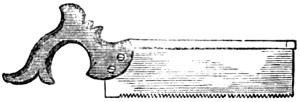
The tenon saw is of a different shape to the others, and is made to cut across the grain of the wood so as to leave the ends nicely even, that it may fit to the piece it is joined to, which is called a shoulder, being that part which comes in contact with the fibre of the wood thus:
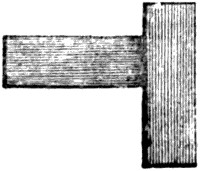
To do this it requires that the teeth should be much smaller, and they are therefore placed so close as eight or ten to the inch, according to the length of the blade.
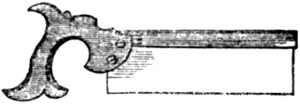
The dovetail saw. There is another most useful saw it would be of advantage for the young carpenter to have, namely, the dovetail saw. It is about 9 inches long, and contains at least fifteen teeth in the inch. It is used for cutting the dovetails of boxes. Its plate is very thin, and it requires some care in using. It has a back for the purpose of strength, formed of a thin piece of brass or iron, let in so as to give the blade the requisite firmness necessary in using it.


The compass saw. The plate of this kind of saw is very narrow, and not more than one inch wide at the broadest part, gradually[613] diminishing to about a quarter of an inch at the lower end. It is about 15 inches in length, and is used for cutting a piece of wood into a circular form, and the plate being narrow allows it to follow the foot of the compass to a very small diameter.
The keyhole saw. The keyhole saw is much smaller than the above. It is used for cutting short curves, small holes, &c., such as a keyhole. The handle is the same form as that of the chisel, a small slit being cut through from end to end. It has a screw on one side, in order that the blade may be set to any length, according to the circumference of the hole to be cut.
This is a very useful tool. It is employed for smoothing the edges of round pieces, or other ends requiring to be shaved down. It is a narrow plane made of boxwood, and has generally a steel blade let into it to cut; it is used by taking hold of each end with a hand, and moving it to and fro over the wood to be shaved down.

There are about thirty-six bits to a set, all of different shapes and sizes; but our young friends need not get quite so many: if they provide themselves with a couple of a medium size, this will be sufficient, such as the centre bit and the auger bit. The centre bit will cut holes varying from a quarter of an inch to three quarters of an inch in diameter, and is used by pressing the knob end against the chest, and twirling the centre part round with the hand. It cuts a hole very clean, leaving it quite smooth inside. The auger bit is for the same purpose, and is used in the same manner. Another bit, called the taper shell bit, is used for making holes wider, and is a very useful implement.
One of the handiest things in a garden is a wheelbarrow, and one of the prettiest for the young carpenter to exercise his ingenuity upon. To make one, take a wide plank or board about an inch and[614] a quarter thick. Proceed to your bench, and having fitted it to its proper position, take your jack plane and plane off the rough, next use your smoothing plane to make it smooth. Then take your pencil and draw upon its side the following figure, A. Then take your compass saw and cut round the marks you have made: to do this you will have to fix your board in the screw of your bench. When this is done take your spoke shave, and shave the edges all round till they are very smooth and even, and you have one side of your barrow. Lay this on another piece of board, and mark the shape of it with your pencil; cut and shave it exactly as you did the first side, so that when finished the two will exactly correspond; then cut a piece off another board for the back and front of the barrow, of the subjoined shape, by the same method you cut the sides, and plane and finish them up in a similar way. Cut some tenons at the end of each exactly to correspond with the mortices shown on the sides, D D; let them be a trifle larger than the mortices, so that they will drive in tight. Then cut the bottom out neatly, and nail it to the sides. Having proceeded thus far, cut out the legs of your barrow, B, and nail one on each side as shown in the figure. Give each leg a shoulder for the sides to rest upon.
To make the wheel. Take a piece of board, A, and strike a circle upon it the size you wish your wheel to be of, B, and with the compass saw cut close round to the stroke; cut out a square hole, C, in the centre for the nave to join. Then get the blacksmith to put an iron rim round the wheel to keep it from splitting, and a round pin in each side of the nave, and put a staple in each side of the barrow to keep the wheel in its place. Paint the whole of any colour you choose, and you will have
PUNCH’S COACH.
First ascertain the size you wish your box to be of. Then cut off
your stuff, but take care to cut it a quarter of an inch longer than the
size of your box from outside to outside. Should you want it deeper
or broader than the length of a deal, the widest of which is generally
only eleven inches; suppose, for instance, you wish your box to be
18 inches deep, and you have only 9-inch deal to make it with, you
will of course have to join two together, or make what is called in
carpentering a glue joint. First, then, after you have cut off your
stuff, take your jack plane and “scuffle the rough off;” then put
your board edgeways into the bench-screw, and take your trying
plane or long plane to get the edge of the deals that are to be glued
together perfectly straight and even; and lastly, use the joiner plane,
which will take off a nice uniform shaving of the whole length of the
board. Proceed exactly in the same manner with the other board
to be joined to the first. Then, after having made each thoroughly
smooth, clap the two together and see if they will lie close in every
part, if not, you must plane them till they do, taking care to plane
the edges perfectly square, or at right angles to the surface of the
board, for if you are not careful in this particular, when your boards
are glued together they will be of this form. ![]() When you have joined them properly for glueing,
let your glue be nicely hot and not too thick, and hold both edges
of the boards together so that you can with a brush put the glue on
both at one time, put the two together very quickly, let one of them
be in the bench-screw, and while there rub the other backwards and
forwards till the glue sets, which it will soon do if well joined. Let
the whole dry, and then the glued part will be as strong as any other
part of the board.
When you have joined them properly for glueing,
let your glue be nicely hot and not too thick, and hold both edges
of the boards together so that you can with a brush put the glue on
both at one time, put the two together very quickly, let one of them
be in the bench-screw, and while there rub the other backwards and
forwards till the glue sets, which it will soon do if well joined. Let
the whole dry, and then the glued part will be as strong as any other
part of the board.
After your sides, ends, bottom, and top are thus prepared, you must then plane them up nicely, so that they are perfectly smooth and straight. Use first the jack plane, then the trying plane. When this is done you have to proceed to a nice little job, namely, to dovetail the corners together, so as to form your box. In this process much depends upon the planing and squaring of the stuff, for if you have not done this nicely the dovetailing will be very imperfectly performed. Assuming that everything has been well done, then take the two ends of the box, and see that each is perfectly square and true to the other. Then allow one-eighth of an inch more than the thickness of your sides, and set out the ends, squaring it over on both sides, which when the dovetails are cut out will form the inside of the box.
Take one “end-piece” of the box and place it endways into the bench-screw, and mark out the dovetails on the edge of the board inside, thus:
then with your dovetail saw cut in into the marks down to the lines squared over on the flat side like this—
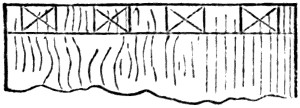
Then with a chisel cut out that part of the wood that is crossed, and leave the other part, this being the part which will form the pins or tails. Then take one side of your box and lay it flat on the bench, the inside uppermost; then place the end you have cut on it, keeping the edges flush, and mark round the shape of the pins, which will leave them after this form—
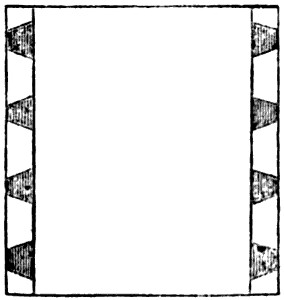
the black places being the mortices which are to be cut out. In cutting out these you must be careful to cut within side of the stroke, so that the mortices will be a little smaller than the pins, which will admit of their being driven in quite tight, and will allow the glue to adhere to them (for you have to glue these when you fix them). When you have thus put the ends and sides together let them stand till the glue gets dry, then take your planes and plane the quarter of an inch off the pins which you allowed to be a little longer than the length of the box, and you have then made the body of your box.

Cut your bottom the exact size of the box, nail the bottom on, and “get out” a piece of wood (by cutting and planing in the usual manner) to nail round so as to form a skirting to it, and at the same time hide the joints of the bottom; “get out” a similar piece of wood to nail round the top which will form the lid. Then get a pair of box joints and a lock, and having put them on by a stroke of your own ingenuity you will have a “box.”
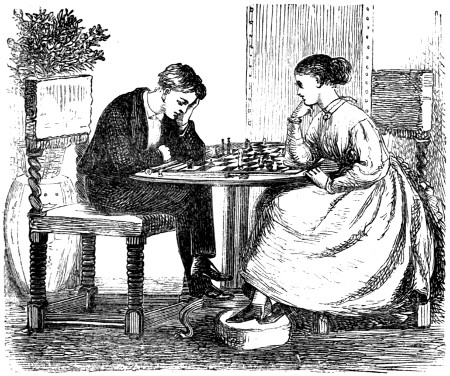
It is the principal aim of this little treatise to assist the young player in his examination of the theory of the openings in the game of chess—a branch of study that to the beginner generally appears to be of a most dull and uninviting character, but which, nevertheless, is of the highest importance to all those who are ambitious of attaining to any degree of proficiency in the game.
Before proceeding further, we would presume that the young player possesses at least an elementary knowledge of the game, such as the moves and value of the various pieces, the laws of checking, &c. Should he not be thus fortunate, we would strongly advise him to have recourse to the assistance of some chess-friend for an explanation of the elementary principles; for, thanks to the almost daily increasing knowledge of the game, there are few localities so remote that cannot produce a brother of the free-masonry of chess. Though, in compliance with the time-honoured custom of all writers on chess, we[618] subjoin a brief description of the various pieces and their moves, yet it is our firm conviction that no beginner has ever succeeded in mastering by the assistance of “the books” alone, the mere elementary principles of the game.
In the following pages we have endeavoured to give a brief synopsis of the most important of the openings, collected from the most approved authorities, and at the same time to present to the tyro as it were a passing glimpse of the chief modern discoveries.
If we have occasionally strayed from the beaten path, or insensibly diverged into any of the as yet unexplored regions of chess, we would fain crave the reader’s kind indulgence for any of those errors which almost invariably find their way into variations that have not undergone the “limæ labor,” or the test of actual play. Finally, should we have had the good fortune by the following pages to assist a single beginner in mastering any of the elementary difficulties which beset the rough road that only leads to proficiency in chess—should there, through our means, have been added but a single recruit to the ranks of Caissa, well will our labour have been repaid!
I.—The chess-board must be so placed that each player has a white corner square nearest his right-hand. If the board have been improperly placed, it must be adjusted, provided four moves on each side have not been played, but not afterwards.
II.—If a Piece or Pawn be misplaced at the beginning of the game, either player may insist upon the mistake being rectified, if he discover it before playing his fourth move, but not afterwards.
III.—Should a player, at the commencement of the game, omit to place all his men on the board, he may correct the omission before playing his fourth move, but not afterwards.
IV.—If a player, undertaking to give the odds of a Piece or Pawn, neglect to remove it from the board, his adversary, after four moves have been played on each side, has the choice of proceeding with or recommencing the game.
V.—When no odds are given, the players must take the first move of each game alternately, drawing lots to determine who shall begin the first game. If a game be drawn, the player who began it has the first move of the following one.
VI.—The player who gives the odds has the right of moving first in each game, unless otherwise agreed. Whenever a Pawn is given, it is understood to be always the King’s Bishop’s Pawn.
VII.—A Piece or Pawn touched must be played, unless at the moment of touching it the player say “J’adoube” or words to that effect; but if a Piece or Pawn be displaced or overturned by accident, it may be restored to its place.
VIII.—While a player holds the Piece or Pawn he has touched, he[619] may play it to any other than the square he took it from; but, having quitted it, he cannot recall the move.
IX.—Should a player take one of his adversary’s Pieces or Pawns, without saying “J’adoube” or words to that effect, his adversary may compel him to take it; but if it cannot be legally taken, he may oblige him to move the King; should his King, however, be so posted that he cannot be legally moved, no penalty can be inflicted.
X.—Should a player move one of his adversary’s men, his antagonist has the option of compelling him—1st, to replace the Piece or Pawn and move his King; 2d, to replace the Piece or Pawn and take it; 3d, to let the Piece or Pawn remain on the square to which it had been played, as if the move were correct.
XI.—If a player take one of his adversary’s men with one of his own that cannot take it without making a false move, his antagonist has the option of compelling him to take it with a Piece or Pawn that can legally take it, or to move his own Piece or Pawn which he touched.
XII.—Should a player take one of his own men with another, his adversary has the option of obliging him to move either.
XIII.—If a player make a false move, i. e. play a Piece or Pawn to any square to which it cannot legally be moved, his adversary has the choice of three penalties; viz., 1st, of compelling him to let the Piece or Pawn remain on the square to which he played it; 2d, to move correctly to another square; 3d, to replace the Piece or Pawn and move his King.
XIV.—Should a player move out of his turn, his adversary may choose whether both moves shall remain, or the second be retracted.
XV.—When a Pawn is first moved in a game, it may be played one or two squares; but in the latter case the opponent has the privilege of taking it en passant with any Pawn which could have taken it had it been played one square only. A Pawn cannot be taken en passant by a Piece.
XVI.—A player cannot castle in the following cases:—
1. If the King or Rook have been moved.
2. If the King be in check.
3. If there be any Piece between the King and Rook.
4. If the King pass over any square attacked by one of the adversary’s Pieces or Pawns.
Should a player castle in any of the above cases, his adversary has the choice of three penalties; viz., 1st, of insisting that the move remain; 2d, of compelling him to move the King; 3d, of compelling him to move the Rook.
XVII.—If a player touch a Piece or Pawn that cannot be moved without leaving the King in check, he must replace the Piece or Pawn and move his King; but if the King cannot be moved, no penalty can be inflicted.
XVIII.—If a player attack the adverse King without saying[620] “Check,” his adversary is not obliged to attend to it; but if the former, in playing his next move, were to say “Check,” each player must retract his last move, and he that is under check must obviate it.
XIX.—If the King has been in check for several moves, and it cannot be ascertained how it occurred, the player whose King is in check must retract his last move and free his King from the check; but if the moves made subsequent to the check be known, they must be retracted.
XX.—Should a player say “Check,” without giving it, and his adversary, in consequence, move his King, or touch a Piece or Pawn to interpose, he may retract such move, provided his adversary have not completed his last move.
XXI.—Every Pawn which has reached the eighth or last square of the chess-board, must be immediately exchanged for a Queen or any other Piece the player may think fit, even though all the Pieces remain on the board. It follows, therefore, that he may have two or more Queens, three or more Rooks, Bishops, or Knights.
XXII.—If a play remain, at the end of the game, with a Rook and Bishop against a Rook; with both Bishops only; with Knight and Bishop only, &c., he must checkmate his adversary in fifty moves on each side at most, or the game will be considered as drawn; the fifty moves commence from the time the adversary gives notice that he will count them. The law holds good for all other checkmates of Pieces only, such as Queen, or Rook only, Queen against a Rook, &c. &c.
XXIII.—If a player agree to checkmate with a particular Piece or Pawn, or on a particular square, or engage to force his adversary to stalemate or checkmate him, he is not restricted to any number of moves.
XXIV.—A stalemate is a drawn game.
XXV.—If a player make a false move, castle improperly, &c. &c., the adversary must take notice of such irregularity before he touches a Piece or Pawn, or he will not be allowed to inflict any penalty.
XXVI.—Should any question arise, respecting which there is no law, or in case of a dispute respecting any law, the players must refer the point to the most skilful disinterested bystanders, and their decision must be considered as conclusive.
| WHITE. | BLACK. | ||
|---|---|---|---|
| 1. | P. to K’s 4th. | 1. | P. to K’s 4th. |
| 2. | K’s Kt. to B’s 3d. | ||
Black has now only three satisfactory methods of defence; viz., 2. P. to Q’s 3d; 2. K’s Kt. to B’s 3d; 2. Q’s Kt. to B’s 3d. He may, however, adopt five other modes of play; viz., P. to K. B’s 3d;[621] Q. to K. B’s 3d; B. to Q’s 3d; P. to Q’s 4th; and P. to K. B’s 4th. Of these the first three are utterly untenable, and the last two are highly dangerous. Should he play 2. P. to K. B’s 3d, you reply with 3. Kt. takes K’s P., checking with Q. at K. R’s 5th, if the Kt. be taken. Should he play 2. Q. to K. B’s 3d, or B. to Q’s 3d, you equally reply with B. to Q. B’s 4th, with the advantage. If he adopt 2. P. to Q’s 4th, you play 3. P. takes P., following it up with Q’s Kt. to B’s 3d, if he retake with Queen. If he play 2. P. to K. B’s 4th, you reply 3. Kt. takes K’s P., or B. to Q. B’s 4th, and obtain the better game shortly. Having disposed of these unsafe defences, we will now return to the examination of the three satisfactory replies:—P. to Q’s 3d; K’s Kt. to B’s 3d; Q’s Kt. to B’s 3d. For the last two, see Games II. and III.
| WHITE. | BLACK. | ||
|---|---|---|---|
| 1. | P. to K’s 4th. | 1. | P. to K’s 4th. |
| 2. | K’s Kt. to B’s 3d. | 2. | P. to Q’s 3d. |
| 3. | P. to Q’s 4th. | ||
This is your best reply; if instead you play,—
| 3. B. to Q’s B’s 4th, he plays— | 3. B. to K’s 2d. (best.) | ||
| 3. | P. takes P. (best.) | ||
| 4. | Q. takes P. | 4. | Q’s Kt. to B’s 3d. |
If you play 4. Kt. takes P., probably his best reply is P. to Q’s 4th.
| 5. | B. to Q. Kt.’s 5th. | 5. | B. to Q’s 2d. |
| 6. | Q. to Q’s sq. | 6. | B. to K’s 2d, or K’s Kt. to K’s 2d. |
| 7. | Q’s Kt. to B’s 3d, with the better position. | ||
You may also, instead of 4. Q. takes P., try K’s B. to Q. B’s 4th. Black’s best reply seems to be Q’s Kt. to B’s 3d.
| WHITE. | BLACK. | ||
|---|---|---|---|
| 1. | P. to K’s 4th. | 1. | P. to K’s 4th. |
| 2. | K’s Kt. to B’s 3d. | 2. | K’s Kt. to B’s 3d. |
This defence was brought into notice by Petroff some years ago, and has been approved of by many of the leading players. It is an excellent defence when receiving the odds of a piece.
| 3. | Kt. takes K’s P. | 3. | P. to Q’s 3d. |
| 4. | Kt. to K. B’s 3d. | 4. | Kt. takes K’s P. |
| 5. | P. to Q’s 4th, (or Var. A.) | 5. | P. to Q’s 4th. |
| 6. | B. to Q’s 3d. | 6. | B. to K’s 2d, (not to Q’s 3d.) |
| 7. | Castles. | 7. | Q’s Kt. to B’s 3d. |
| 8. | P. to Q. B’s 4th. | 8. | Q’s B. to K’s 3d. |
| 9. | P. to Q. R’s. 3d. | 9. | Castles. |
| 10. | Q. to Q. B’s 2d, with a slightly better game. | ||
White has another move at this point, which seems at least as good as 5. P. to Q’s 4th; viz., Q’s Kt. to B’s 3d.
| 3. | Kt. takes K’s P. | 3. | P. to Q’s 3d. |
| 5. | Q’s Kt. to B’s 3d. | 5. | Kt. takes Kt. |
| 6. | Q’s P. takes Kt. | 6. | B. to K’s 2d. |
| 7. | B. to Q’s 3d. | ||
| White has the better opened game. | |||
| WHITE. | BLACK. | ||
|---|---|---|---|
| 1. | P. to K’s 4th. | 1. | P. to K’s 4th. |
| 2. | K’s Kt. to B’s 3d. | 2. | Q’s Kt. to B’s 3d. |
This is recommended by nearly all authors, as Black’s best reply. Of late, however, there has been an opinion prevalent among many of our best players, that it is inferior to K’s Kt. to B’s 3d, or even P. to Q’s 3d. For our own part, we incline to the old move of Q’s Kt. to B’s 3d, but doubt whether there is any defence by which Black can acquire a perfectly even game.
| 3. | B. to Q. B’s 4th. | 3. | B. to Q. B’s 4th. (best.) |
| 4. | P. to Q. B’s 3d. | 4. | K’s Kt. to B’s 3d. (best.) |
| 5. | P. to Q’s 4th. | 5. | P. takes P. |
| 6. | P. to K’s 5th, (or Var. A.) | 6. | P. to Q’s 4th. (best.) |
| 7. | K’s B. to Q. Kt.’s 5th. | 7. | K’s Kt. to K’s 5th. |
| 8. | P. takes P. | 8. | B. to Q. Kt.’s 3d. (best.) |
| 9. | Castles. | 9. | Q’s B. to K. Kt.’s 5th. |
| 10. | B. takes Kt. (ch.) | 10. | P. takes B. |
| 11. | Q’s B. to K’s 3d, or Q’s Kt. to B’s 3d. | 11. | Castles. |
These are the moves given in the Handbook, and the game is dismissed as equal. In actual play, however, we should take Black’s game for choice.
| WHITE. | BLACK. | ||
|---|---|---|---|
| 6. | P. takes P. | 6. | B. to Q. Kt.’s 5th (ch.) |
White’s 6th move is recommended by the German masters, and in our opinion is preferable to P. to K’s 5th; Black’s best reply is to check,—
| 7. | B. to Q’s 2d. | 7. | B. takes B. (ch.) |
| 8. | Q’s Kt. takes B. | 8. | P. to Q’s 4th. |
| 9. | P. takes P. | 9. | Kt. takes P. |
| 10. | Q. to Q. Kt.’s 3d. | 10. | Q’s Kt. to K’s 2d. |
| 11. | K’s R. to K’s sq. | ||
| We much prefer White’s game. | |||
It would be impossible, in the narrow limits assigned to our treatise, to enter into the merits of this opening; we shall therefore give one or two of the leading variations, and refer learners, who may be desirous of a more comprehensive analysis, to Mr. Walker’s excellent articles on this popular opening, in Vol. ix. of the “Chess Player’s Chronicle,” the “Handbook,” and Mr. Boden’s useful little work, entitled “A Popular Introduction to Chess.”
| WHITE. | BLACK. | ||
|---|---|---|---|
| 1. | P. to K’s 4th. | 1. | P. to K’s 4th. |
| 2. | K’s Kt. to B’s 3d. | 2. | Q’s Kt. to B’s 3d. |
| 3. | B. to Q. B’s 4th. | 3. | B. to Q. B’s 4th. |
| 4. | P. to Q. Kt.’s 4th. | 4. | B. takes Q. Kt.’s P. |
| 5. | P. to Q. B’s 3d. | 5. | B. to Q. B’s 4th. |
| 6. | Castles. | 6. | P. to Q’s 3d. (best.) |
| 7. | P. to Q’s 4th. | 7. | P. takes P. |
| 8. | P. takes P. | 8. | B. to Q. Kt.’s 3d. |
| 9. | B. to Q. Kt.’s 2d. | 9. | K’s Kt. to B’s 3d. |
Instead of 9. B. to Q. Kt.’s 2d, you may adopt several other modes of play; viz., 9. B. to Q. R’s 3d; 9. R. to K’s sq.; 9. P. to K. R’s 3d; 9. Q’s Kt. to B’s 3d. To the two first of these, Black equally replies with Q’s B. to K. Kt.’s 5th, with the better game. (For 9. P. to K. R’s 3d, and 9. Q’s Kt. to B’s 3d, see Variations A. and B.)
| 10. | P. to Q’s 5th. | 10. | Q’s Kt. to K’s 2d. (best.) |
| 11. | B. takes K’s Kt. | 11. | P. takes B. |
| 12. | K’s Kt. to Q’s 4th. | ||
| White has rather the better game. | |||
| WHITE. | BLACK. | ||
|---|---|---|---|
| 9. | P. to K. R’s 3d. | 9. | Kt. to Q. R’s 4th. |
This is the move usually recommended for the defence. Black may however adopt, 9. P. to K. R’s 3d, apparently with little disadvantage.
| 10. | B. to Q’s 3d. | 10. | K’s Kt. to K’s 2d. |
| 11. | P. to Q. R’s 4th. | 11. | Castles. |
| 12. | R. to Q. R’s 2d. | 12. | K. to R’s sq. |
| 13. | R. to K’s 2d. | 13. | P. to K. B’s 4th. |
| The game is about equal. | |||
| WHITE. | BLACK. | ||
|---|---|---|---|
| 9. | Q’s Kt. to B’s 3d. |
We have long suspected that the force of this form of the attack has been vastly underrated. The following variations are taken from an able analysis by Mr. G. B. Fraser, of Dundee, who has kindly presented the result of his labours in the investigation of this attack at our disposal:—
| 9. | B. to K. Kt.’s 5th. |
This move is considered by all the modern writers on Chess to be Black’s best reply.
| 10. | Q. to Q. R’s 4th. | 10. | B. takes Kt. |
In reply to White’s last move, Black may play either 10. Q. to Q’s 2d, or 10. B. to Q’s 2d, instead of the move in the text. If he adopt 10. Q. to Q’s 2d, White replies with B. to Q. Kt.’s 5th, apparently winning a piece. It has been suggested to us that perhaps Black’s best move is 10. K. to B’s sq., to which White might reply with K. Kt. to his 5th; and on Black’s moving K. Kt. to R’s 3d, advance the P. to Q’s 5th. (For B. to Q’s 2d, see Variation A.)
| 11. | P. to Q’s 5th. | 11. | B. to K. Kt.’s 5th. (best.) |
| 12. | P. takes Q’s Kt. | 12. | P. takes P. |
Black might play also Q’s R. to Q. Kt.’s sq., whereupon follows,—
| 13. P. takes P. (dis. ch.) | 13. B. to Q’s 2d. | ||
| 14. Q. to Q. Kt.’s 3d, and wins. | |||
| 13. | P. to K’s 5th. |
White might also with advantage take the Q. B’s P. checking, although the move in the text seems stronger.
| 13. | B. to K’s 3d. |
If he play,—
| 13. Q. to Q’s 2d. | |||
| 14.. P. takes P. | 14. P. takes P. | ||
| 15. Kt. to Q’s 5th, and wins. | |||
| 14. | B. takes B. | 14. | P. takes B. |
| 15. | Q. takes P. (ch.) | 15. | K. to B’s sq. |
| 16. | B. to Q. R’s 3d, with a winning game. | ||
| WHITE. | BLACK. | ||
|---|---|---|---|
| 10. | B. to Q’s 2d. | ||
| 11. | Q. to Q. Kt.’s 3d. | 11. | Kt. to Q. R’s 4th. (best.) |
| 12. | B. takes K. B’s P. | 12. | K. to B’s sq. |
| 13. | Q. to Q’s 5th. | 13. | Kt. to K. B’s 3d. |
| 14. | Q. to K. Kt.’s 5th. | 14. | K. takes B. |
| 15. | P. to K’s 5th. | 15. | P. to K. R’s 3d. |
This is Black’s best reply. If he retire the Kt. to his square, or to K’s square, or K. Kt.’s 5th, White will obtain a winning game, by 16. Q. to K. B’s 4th. (ch.)
| 16. | Q. to K. B’s 4th. | 16. | P. to K. Kt.’s 4th. (best.) |
| 17. | Q. to Q’s 2d. | ||
This seems White’s most promising move. He may also play 17. Q. takes Kt., upon which Black exchanges Queens with the better game.
| 17. | Kt. to K. R’s 2d. | ||
| 18. | P. to Q’s 5th. | 18. | B. to K. B’s 4th. |
Black might also take Pawn with Pawn, and the game would probably be continued thus:—
| 18. P takes P. | |||
| 19. Kt. takes P. (ch.) | 19. K. to Kt.’s 2d. | ||
| 20. B. to Q. Kt.’s 2d. | 20. Kt. to K. B’s 3d. | ||
| 21. K. to R’s sq. | 21. R. to K’s sq. | ||
| 22. P. to K. B’s 4th, and will win. | |||
| 19. | P. to K’s 6th. (ch.) | 19. | K. to K’s 2d. |
| 20. | Kt. to Q’s 4th. | 20. | B. to K. Kt.’s 3d. |
| 21. | P. to K. B’s 4th, with a fine attack. | ||
Instead of retiring his Bishop to Q. B’s 4th, as in Game IV., Black may, though apparently less advantageously, play him to Q. R’s 4th.
| WHITE. | BLACK. | ||
|---|---|---|---|
| 1. | P. to K’s 4th. | 1. | P. to K’s 4th. |
| 2. | K’s Kt. to B’s 3d. | 2. | Q’s Kt. to B’s 3d. |
| 3. | B. to Q. B’s 4th. | 3. | B. to Q. B’s 4th. |
| 4. | P. to Q. Kt.’s 4th. | 4. | B. takes P. |
| 5. | P. to Q. B’s 3d. | 5. | B. to Q. R’s 4th. |
| 6. | P. to Q’s 4th. (best.) | 6. | P. takes P. |
| 7. | Castles. | 7. | P. to Q’s 3d. |
| 8. | Q. to Q. Kt.’s 3d. | 8. | Q. to K. B’s 3d. (best.) |
| 9. | P. takes P., with a very fine game. | ||
N.B.—Should Black at his 7th move, instead of 7. P. to Q’s 3d, play P. to Q. B’s P., or K’s Kt. to B’s 3d, you, in reply, advance P. to K’s 5th, with a powerful attack.
We now come to consider the consequences of Black’s not accepting the gambit pawn at move 4.
| WHITE. | BLACK. | ||
|---|---|---|---|
| 1. | P. to K’s 4th. | 1. | P. to K’s 4th. |
| 2. | K’s Kt. to B’s 3d. | 2. | Q’s Kt. to B’s 3d. |
| 3. | B. to Q. B’s 4th. | 3. | B. to Q. B’s 4th. |
| 4. | P. to Q. Kt.’s 4th. | 4. | B. to Q. Kt.’s 3d |
| 5. | B. to Q. Kt.’s 2d. | 5. | P. to Q’s 3d. |
| 6. | P. to Q’S 4th. | ||
| We prefer White’s game. | |||
There is also another method of declining the Gambit, which, although hitherto unanalysed, seems to present some interesting features.
| WHITE. | BLACK. | ||
|---|---|---|---|
| 1. | P. to K’s 4th. | 1. | P. to K’s 4th. |
| 2. | K’s Kt. to B’s 3d. | 2. | Q’s Kt. to B’s 3d. |
| 3. | B. to Q. B’s 4th. | 3. | B. to Q. B’s 4th. |
| 4. | P. to Q. Kt.’s 4th. | 4. | P. to Q’s 4th. |
| 5. | P. takes Q’s P. | 5. | Kt. takes Q. Kt.’s P. |
| 6. | P. to Q. B’s 3d. | 6. | Kt. takes Q’s P. |
| 7. | Q. to Q. Kt.’s 3d. | 7. | P. to Q. B’s 3d. |
| 8. | B. takes Kt. | 8. | Q. takes B. (best.) |
| 9. | Q. takes Q. | 9. | Q. takes Q. |
| 10. | Kt. takes K’s P. | Even Game. |
It is very possible some of White’s moves may be improved upon, but the foregoing variation seems satisfactorily to demonstrate that Black can gain no advantage.
Before taking our leave of this beautiful opening, we would again remind the young player, that it is perfectly immaterial, whether Black at move 5 captures the gambit pawn with B. or Kt., if with the latter White equally replies with P. to Q. B’s 3d; and on Black’s retiring the Kt. to Q. B’s 3d (best), the position becomes the same as given in a previous variation.
We will now proceed to examine this, perhaps, the strongest and most embarrassing attack the board affords. It is through fear of this variation, that many of our best players have abandoned the usual defence of 2. Q’s Kt. to B’s 3d, and turned to the King’s Knight’s defence, or the old move of P. to Q’s 3d.
| WHITE. | BLACK. | ||
|---|---|---|---|
| 1. | P. to K’s 4th. | 1. | P. to K’s 4th. |
| 2. | K’s Kt. to B’s 3d. | 2. | Q’s Kt. to B’s 3d. |
| 3. | B. to Q. Kt.’s 5th. | 3. | K’s Kt. to B’s 3d. |
By playing your Bishop thus, you again threaten to win his K’s P. The move in the text, commonly known as the Berlin defence, is perhaps as good a reply as the position admits. He has, however, three other plausible moves; viz., B. to Q. B’s 4th; B. to K’s 2d; P. to Q’s 3d, which will be touched upon hereafter.
| 4. | P. to Q’s 4th. | 4. | P. takes P. |
This move (or perhaps still better, 4. Castles) appears to yield a far stronger attack than the old move of Q. K’s 2d. Black, instead of P. takes P., might either reply with 4. K’s Kt. takes K’s P., or 4. Q’s Kt. takes Q’s P. If the former, perhaps castling at once is your[627] best reply; if the latter, you take Kt. with K’s Kt., and then play P. to K’s 5th, as in the present variation.
| WHITE. | BLACK. | ||
|---|---|---|---|
| 5. | P. to K’s 5th. | 5. | Kt. to K’s 5th. |
| 6. | Castles. | 6. | B. to K’s 2d. (best.) |
| 7. | Kt. takes P. | 7. | Kt. takes Kt. (or Var. A.) |
| 8. | Q. takes Kt. | 8. | P. to K. B’s 4th. |
| 9. | P. takes P. en passant. | 9. | Kt. takes P. |
| 10. | Q’s Kt. to B’s 3d. | ||
| White has a very fine game. | |||
We will now turn our attention to the other modes of play Black may adopt at his 3d move, instead of K’s Kt. to B’s 3d; viz., B. to Q. B’s 4th; P. to Q’s 3d; B. to K’s 2d. (see Variations B. C.)
| WHITE. | BLACK. | ||
|---|---|---|---|
| 1. | P. to K’s 4th. | 1. | P. to K’s 4th. |
| 2. | K’s Kt. to B’s 3d. | 2. | Q’s Kt. to B’s 3d. |
| 3. | B. to Q. Kt.’s 5th. | 3. | B. to Q. B’s 4th. |
| 4. | P. to Q. B’s 3d. | 4. | K’s Kt. to K’s 2d. (best.) |
| 5. | Castles. | 5. | Castles. |
| 6. | P. to Q’s 4th. | 6. | P. takes P. |
| 7. | P. takes P. | 7. | B. to Q. Kt.’s 3d. |
| 8. | P. to Q’s 5th. | 8. | Q’s Kt. to his sq. |
| White may also play 8. Q’s Kt. to B’s 3d with advantage. | |||
| 9. | P. to Q’s 6th. | 9. | P. takes P. |
| 10. | Q. takes P. | 10. | B. to Q. B’s 2d. |
| 11. | Q. to Q. R’s 3d. | 11. | P. to Q’s 4th. |
| 12. | K’s R. to Q’s sq. | 12. | B. to Q’s 3d. |
The move 12. K. R. to Q’s sq. is recommended in the Handbook as giving White an advantage of position. The reply, however, in the text, which occurred to the writer in actual play, seems calculated to free Black from his embarrassment.
| WHITE. | BLACK. | ||
|---|---|---|---|
| 3. | P. to Q’s 3d. | ||
| 4. | P. to Q’s 4th. | 4. | B. to Q’s 2d. |
| 5. | Castles. | ||
| Black has a tolerably safe though constrained position. | |||
N.B.—For 3. B. to K’s 2d, see the games illustrative of this opening.
This opening derives its name from having been adopted in the great match by correspondence between the London and Edinburgh Chess Clubs. The attack consequent on this opening at one time[628] considerably embarrassed Mr. Cochrane, who considered there was no satisfactory defence to it. Major Jaenisch, however, with characteristic patience and analysis, has proved the contrary.
| WHITE. | BLACK. | ||
|---|---|---|---|
| 1. | P. to K’s 4th. | 1. | P. to K’s 4th. |
| 2. | K’s Kt. to B’s 3d. | 2. | Q’s Kt. to B’s 3d. |
| 3. | P. to Q’s 4th. | 3. | P. takes P. |
If he play 4. Kt. takes P., you reply with either Kt. takes Kt., or Kt. takes K’s P., and obtain the better position.
| 4. | B. to Q. B’s 4th. | 4. | B. to Q. B’s 4th. |
This is now acknowledged to be Black’s best move; for 4. B. to Q. Kt.’s 5th. (ch.) see Variation A.
| 5. | P. to Q. B’s 3d. | 5. | K’s Kt. to B’s 3d. (best.) |
And the position is the same as given in the leading variation of the Giuoco Piano, see page 622. Should Black instead play: P. takes Q. B’s P., you take his K. B’s P. with your B. (ch.); and if he takes the Bishop with King, play Q. to Q’s 5th (ch.), and then take his Bishop.
| WHITE. | BLACK. | ||
|---|---|---|---|
| 1. | P. to K’s 4th. | 1. | P. to K’s 4th. |
| 2. | K’s Kt. to B’s 3d. | 2. | Q’s Kt. to B’s 3d. |
| 3. | P. to Q’s 4th. | 3. | P. takes P. |
| 4. | B. to Q. B’s 4th. | 4. | B. to Q. Kt.’s 5th. (ch.) |
| 5. | P. to Q. B’s 3d. | 5. | P. takes P. |
| 6. | Castles. | 6. | P. to Q. B’s 7th. |
Instead of 6. Castles, you might adopt Mr. Cochrane’s method of continuing the attack, by 6. P. takes P.
N.B.—It would be very bad play of Black to take the Q. Kt.’s P., instead of the move in the text.
| 7. | Q. takes P. | 7. | P. to Q’s 3d. |
| 8. | P. to Q. R’s 4th. | 8. | B. to Q. R’s 4th. |
| 9. | P. to Q. Kt.’s 4th. | 9. | B. to Kt.’s 3d. |
| 10. | Q. to Q. Kt.’s 3d, with a fine game. | ||
There is another not uninteresting method of attack, which White might adopt at his fifth move, instead of 5. P. to Q. B’s 3d; viz., K’s Kt. to his 5th.
| 5. | K’s Kt. to his 5th. | 5. | K’s Kt. to R’s 3d. (best.) |
| 6. | Kt. takes K. B’s P. | 6. | Kt. takes Kt. |
| 7. | B. takes Kt. (ch.) | 7. | K. takes B. |
| 8. | Q. to R’s 5th. | 8. | P. to K. Kt.’s 3d. |
| 9. | Q. takes B. | 9. | P. to Q’s 4th. |
Black’s 9th move was first suggested in an able analysis on this variation by Messrs. Jaenisch and Schummoff, in the “Chess Player’s Chronicle” for July, 1850. It is far superior to the old move of P. to Q’s 3d, and without great care on your part will give him an irresistible attack.
| 10. | Castles. | 10. | P. takes P. |
This is your strongest move, and appears to have been overlooked by the talented authors of the article in question:—
| 10. | P. to Q. B’s 3d. (best.) | 10. | R. to K’s sq. |
If Black play 10. P. to Q’s 6th, you reply with Q. to Q. B’s 4th (ch.), winning the King’s Pawn.
| 11. | B. to K. Kt.’s 5th. | 11. | Q. to Q’s 3d. |
| 12. | Q. takes Q. | 12. | P. takes Q. |
| 13. | P. takes P. | 13. | Kt. takes P. |
| 14. | Q’s Kt. to B’s 3d. | ||
| And Black will have great difficulty in avoiding the loss of a Pawn. | |||
There is another variation of this opening hitherto, we believe, unanalysed, which, although it presents many points of interest, seems altogether unknown to the majority of amateurs.
| WHITE. | BLACK. | ||
|---|---|---|---|
| 1. | P. to K’s 4th. | 1. | P. to K’s 4th. |
| 2. | K’s Kt. to B’s 3d. | 2. | Q’s Kt. to B’s 3d. |
| 3. | P. to Q’s 4th. | 3. | P. takes P. |
| 4. | B. to Q. B’s 4th. | 4. | B. to Q. B’s 4th. |
| 5. | Castles. | 5. | P. to Q’s 3d. |
| 6. | K’s Kt. to his 5th. | 6. | K’s Kt. to R’s 3d. |
| 7. | P. to K. B’s 4th. | 7. | P. to Q’s 6th. (dis. ch.) |
If he play 7. B. to K. Kt.’s 5th, your best reply seems to be Q. to K’s sq., although you might obtain a strong but hazardous attack by playing Q. to her 3d, and afterwards, on his attacking her, with Q’s Kt. to Q. Kt.’s 3d.
| 8. | K. to R’s sq. | 8. | P. takes P. |
| 9. | Q. takes P. | 9. | Q’s Kt. to Q’s 5th. |
| 10. | Q. to Q. B’s 3d. | ||
And although minus a Pawn, you have a fine game. If he now play P. to K. B’s 3d, you reply with B. to K’s 3d.
| WHITE. | BLACK. | ||
|---|---|---|---|
| 1. | P. to K’s 4th. | 1. | P. to K’s 4th. |
| 2. | K. B. to Q. B’s 4th. | 2. | K. B. to Q. B’s 4th. |
By this move you attack his weakest point, viz. the K. B’s P. Most of the classical writers on Chess concur in recommending the same move as Black’s best reply. Major Jaenisch and the German authors unanimously recommend 2. K’s Kt. to B’s 3d in preference, the move generally adopted in actual play. (See Game III.)
White has now several methods of continuing the attack. He may play the move recommended by Philidor, viz. P. to Q. B’s 3d, to which Black may reply with either K’s Kt. to B’s 3d, or Q. to K. Kt.’s 4th, or P. to Q’s 4th, in every case with at least an equal game.
You may also play K’s Kt. to B’s 3d, and upon Black’s bringing out his Q’s Kt., the position is resolved into the Giuoco Piano.
If you play Q. to K. R’s 5th, (a move frequently adopted by young players,) Black will reply with Q. to K B’s 3d, or to K’s 2d, with no inferiority of position. Besides these moves you have two others at command, viz. Q. to K’s 2d, and P. to Q. Kt.’s 4th, which we will proceed to examine.
| WHITE. | BLACK. | ||
|---|---|---|---|
| 1. | P. to K’s 4th. | 1. | P. to K’s 4th. |
| 2. | K. B. to Q. B’s 4th. | 2. | K. B to Q. B’s 4th. |
| 3. | Q. to K’s 2d. | 3. | Q’s Kt. to B’s 3d. |
By playing thus you threaten at once to take his K. B’s P. (ch.), and if K. takes B, to win his Bishop in return by the check of the Q. The move in the text is Black’s best reply, any other move would leave you with at least an even position.
| 4. | P. to Q. B’s 3d. | 4. | K’s Kt. to B’s 3d. |
Instead of P. to Q. B’s 3d, you may take the adverse K. B’s P (ch.); see Variation A.
| 5. | P. to K. B’s 4th. | 5. | B. takes K’s Kt. |
| 6. | R. takes B. | 6. | Castles. |
| 7. | P. to Q’s 3d. | 7. | P. to Q’s 4th. |
| With a superior game. | |||
| WHITE. | BLACK. | ||
|---|---|---|---|
| 4. | B. takes K. B’s P. (ch.) | 4. | K. takes B. |
| 5. | Q. to Q. B’s 4th. (ch.) | 5. | P. to Q’s 4th. |
| 6. | Q. takes B. | 6. | P. takes K’s P. |
| 7. | Q. to Q. B’s 4th (ch.) | 7. | B. to K’s 3d. |
| 8. | Q. takes P. | 8. | K’s Kt. to B’s 3d. |
| Black has by far the better game. | |||
| WHITE. | BLACK. | ||
|---|---|---|---|
| 1. | P. to K’s 4th. | 1. | P. to K’s 4th. |
| 2. | K’s B. to Q. B’s 4th. | 2. | K’s B. to Q. B’s 4th. |
| 3. | P. to Q. Kt.’s 4th. | 3. | B. takes P. |
| 4. | P. to K. B’s 4th. | 4. | P. to Q’s 4th. |
His best move. If, in lieu of P. to Q’s 4th, he adopt P. takes K. B’s P., you reply with K’s Kt. to B’s 3d, and obtain a fine attack.
| 5. | P. takes Q’s P. | 5. | P. to K’s 5th. |
If you play B. takes P., Black replies with P. to Q. B’s 3d, with the better game.
| 6. | K’s Kt. to K’s 2d. | 6. | K’s Kt. to B’s 3d. |
| 7. | Castles. | 7. | Castles. |
| 8. | Q’s Kt. to B’s 3d. | 8. | P. to Q. B’s 3d. |
| 9. | P. takes P. | 9. | Q’s Kt. takes P. |
Black has the better game, thereby proving that the Double Gambit, if correctly met, is disadvantageous to the first player.
| WHITE. | BLACK. | ||
|---|---|---|---|
| 1. | P. to K’s 4th. | 1. | P. to K’s 4th. |
| 2. | K’s B. to Q. B’s 4th. | 2. | K’s Kt. to B’s 3d. |
| 3. | K’s Kt. to B’s 3d. | 3. | Kt. takes K’s P. (best.) |
Your third move is probably the best on the board; 3. P. to Q’s 4th, and 3. P. to Q’s 3d, seem much inferior, as Black immediately gains the attack.
| 4. | Q’s Kt. to B’s 3d. | 4. | K’s Kt. to B’s 3d. |
Your fourth move was introduced two or three years ago, and was first analysed by Mr. Boden, in his “Popular Introduction,” where Black’s reply, of 4. K’s Kt. to B’s 3d, is recommended as his best; we believe, however, he can at least as advantageously play[632] 4. Kt. takes Q’s Kt., or, as has been suggested to us, 4. P. to Q’s 4th.; see Variation A.
| 5. | Kt. takes K’s P. | 5. | P. to Q’s 4th. |
| 6. | B. to Q. Kt.’s 3d. | 6. | B. to Q’s 3d. |
| Equal game. | |||
| WHITE. | BLACK. | ||
|---|---|---|---|
| 4. | Kt. takes Q’s Kt. | ||
| 5. | Q’s P. takes Kt. | 5. | P. to Q. B’s 3d. |
He may also play 5. P. to K. B’s 3d, by which he preserves his Pawn, though with a somewhat inferior position.
| 6. | Kt. takes K’s P. | 6. | P. to Q’s 4th. |
| 7. | B. to Q’s 3d. | 7. | B. to Q’s 3d. |
| 8. | K’s Kt. to B’s 3d. | 8. | Castles. |
| 9. | Castles. | ||
| Black has no inferiority of position. | |||
This beautiful and brilliant début, which, as Mr. Staunton observes, gives birth to the most intricate and beautiful combinations the chess-men are susceptible of, has been a universal favourite with every class of players from the earliest stages of European Chess up to the present day. In order to facilitate the analysis of this opening, as far as our narrow limits will permit, we shall divide it into its three principal heads; viz., The King’s Knight’s Gambit, The Allgaier Gambit, and the King’s Bishop’s Gambit, and afterwards devote a few words to the Gambit Declined.
| WHITE. | BLACK. | ||
|---|---|---|---|
| 1. | P. to K’s 4th. | 1. | P. to K’s 4th. |
| 2. | P. to K. B’s 4th. | 2. | P. takes P. |
| 3. | K’s Kt. to B’s 3d. | 3. | P. to K. Kt.’s 4th. |
This is Black’s best move, indeed the only one to retain the gambit pawn. He, however, may obtain a nearly equal game by 3. P. to Q,’s 4th. If he play 3. B. to K’s 2d, commonly known as the Cunningham Gambit, White replies with B. to Q. B’s 4th, and on Black’s checking with B. at R’s 5th, plays K. to B’s sq., with a much better game.
| 4. | B. to Q. B’s 4th. | 4. | B. to K. Kt.’s 2d (best), or Var. A. |
| 5. | P. to Q B’s 3d. | 5. | P. to K. R’s 3d. (best.) |
Should Black play the obvious-looking move of 4. P. to Q’s 3d, White gains a striking advantage by the following mode of play:—
| 6. Q. to Q. Kt.’s 3d. | 6. Q. to K’s 2d. | ||
| 7. Q. to Q. Kt.’s 5th. (ch.) | 7. B. on P. interposes. | ||
| 8. Q. takes K. Kt.’s P., &c. | |||
| 6. | P. to Q’s 4th. | 6. | P. to Q’s 3d. |
| 7. | Castles. | 7. | Q’s Kt. to Q’s 2d. |
This is usually considered his best move, though Q’s Kt. to B’s 3d, or K’s Kt. to K’s 2d, are perhaps equally good.
| 8. | P. to K. Kt.’s 3d. | 8. | P. to K. Kt.’s 5th. |
If he takes P. with P., you get a fine attack by B. takes K. B’s P. (ch.)
| 9. | Kt. to K. R’s 4th, (or to K’s sq.) | 9. | Kt. to Q. Kt.’s 3d. |
| 10. | B. to Q. Kt.’s 3d. | 10. | P. to K. B’s 6th. |
He has a Pawn more, and a strong position.
N.B.—Instead of 5. P. to Q. B’s 3d, you may also play 5. P. to K. R’s 4th, with a good attack.
| WHITE. | BLACK. | ||
|---|---|---|---|
| 1. | P. to K’s 4th. | 1. | P. to K’s 4th. |
| 2. | P. to K. B’s 4th. | 2. | P. takes P. |
| 3. | K’s Kt. to B’s 3d. | 3. | P. to K. Kt.’s 4th. |
| 4. | B. to Q. B’s 4th. | 4. | P. to K. Kt.’s 5th. |
| 5. | Kt. to K’s 5th. | 5. | Q. to K. R’s 5th. (ch.) |
Instead of 5. Kt. to K’s 5th, you may castle, for which see Game II. (The Muzio Gambit.)
| 6. | K. to B’s sq. | 6. | K’s Kt. to R’s 3d. |
| 7. | P. to Q’s 4th. | 7. | P. to K. B’s 6th. |
| 8. | P. takes P. | 8. | P. to Q’s 3d. |
| 9. | B. takes K’s Kt. | 9. | Q’s P. takes Kt. |
| And Black has a fine Game. | |||
You seem to have no better move than 9. B. takes K’s Kt.; if you play Kt. to Q’s 3d, he replies with K. Kt.’s P. takes P., and your game is gone.
| WHITE. | BLACK. | ||
|---|---|---|---|
| 1. | P. to K’s 4th. | 1. | P. to K’s 4th. |
| 2. | P. to B’s 4th. | 2. | P. takes P. |
| 3. | K’s Kt. to B’s 3d. | 3. | P. to K. Kt.’s 4th. |
| 4. | B. to Q. B’s 4th. | 4. | P. to K. Kt.’s 5th. |
| 5. | Castles. | 5. | P. takes Kt. |
This sacrifice of the Kt., daring as it may appear at first sight, is, nevertheless, considered by modern analysis to be quite sound.
| 6. | Q. takes P. | 6. | Q. to K. B’s 3d. (best.) |
| 7. | P. to K’s 5th. | 7. | Q. takes K’s P. |
Your 7th move is given by most of “the books” as the best. We have found Q’s Kt. to B’s 3d at this point a strong move in actual play.
| 8. | P. to Q’s 3d. | 8. | K’s B. to R’s 3d. |
| 9. | Q’s B. to Q’s 2d. | 9. | K’s Kt. to K’s 2d. |
| 10. | Q’s Kt. to B’s 3d. | 10. | P. to Q. B’s 3d. |
Some authors recommend Q’s Kt. to B’s 3d as more attacking than the move in the text. It has however been proved untenable in the “Handbook” (page 281.)
| 11. | Q’s R. to K’s sq. | 11. | Q. to Q. B’s 4th. (ch.) |
| 12. | K. to R’s sq. | 12. | P. to Q’s 4th. |
Mr. Staunton recommends 12. R. to K. B’s 2d, instead of retiring the King to R’s sq. We have tried this move in actual play, following it up with Q’s R. to K. B’s sq., which seems to give White an overwhelming attack.
| 13. | Q. to K. R’s 5th. | 13. | Q. to Q’s 3d. |
| 14. | B. takes Q. P. | 14. | P. takes B. |
| 15. | Kt. takes Q’s P. | 15. | Q’s Kt. to B’s 3d. |
| 16. | Q’s B. to his 3d. | 16. | Q. to K. Kt.’s 3d. |
| 17. | R. takes Kt. (ch.) | 17. | K. to B’s sq. |
The moves up to this point, both for attack and defence, are given by Jaenisch and the “Handbook” as the best the board affords; with the best play, probably the game ought to be drawn.
We much regret that our space will not allow of a more elaborate analysis of this beautiful gambit; we trust, however, that the above variations will show the young player the difficulty and resource of this opening.
We cannot quit the subject without alluding to a defence lately introduced by Messrs. Kling and Horwitz, which consists in Black’s playing Q. to K’s 2d at his 5th move, instead of taking the Kt. With all deference and respect for the wonderful and almost inexhaustible power of analysis displayed by these two eminent players, we must confess that we have our doubts as to the soundness of the move in question. The young players, however, will find it full analysed in Kling and Horwitz’s “Chess Studies,” one of the most valuable and interesting works on Chess of modern days, which needs not our recommendation to find its way to the book-shelf of every lover of Chess.
This opening, the invention of which is erroneously ascribed to Allgaier, has of late years become a favourite with all classes of players, though we agree with Mr. Boden in considering that its resources have been considerably overrated, although not perhaps from the same reason as adduced in his “Popular Introduction.”
| WHITE. | BLACK. | ||
|---|---|---|---|
| 1. | P. to K’s 4th. | 1. | P. to K’s 4th. |
| 2. | P. to K. B’s 4th. | 2. | P. takes P. |
| 3. | K’s Kt. to B’s 3d. | 3. | P. to K. Kt.’s 4th. |
| 4. | P. to K. R’s 4th. | 4. | P. to K. Kt.’s 5th. |
You may here play your Kt. to K’s 5th, or to K. Kt.’s 5th. Modern authorities agree in recommending the former, as giving a more lasting attack. As, however, some very embarrassing positions may arise from playing the Kt. to his 5th, we will examine the consequences resulting from it at present, leaving the move of 5. Kt. to K’s 5th for after examination, (Game II.).
| 5. | Kt. to Kt.’s 5th. | 5. | P. to K. R’s 3d. (best.) |
| 6. | Kt. takes K. B’s P. | 6. | K. takes Kt. |
| 7. | B. to Q. B’s 4th. (ch.) | 7. | P. to Q’s 4th. |
Your 7th move gives a far more embarrassing attack than the old move of Q. takes K. Kt.’s P., to which Black replies, K’s Kt. to B’s 3d. with a winning position.
In the present game Black’s reply of P. to Q’s 4th is his only move. If he retire K. to Kt.’s sq., you must gain some advantage by Q. takes K. Kt.’s P., &c.
| 8. | B. takes P. (ch.) | 8. | K. to K’s sq. |
In our opinion the move of K. to K’s sq. is preferable to K. to Kt.’s 2d. At all events the defence seems much simpler, and at least as satisfactory.
| 9. | P. to Q’s 4th. | 9. | P. to K. B’s 6th. (best.) |
| 10. | P. takes P. | 10. | B. to K’s 2d. |
| With a winning game. | |||
| WHITE. | BLACK. | ||
|---|---|---|---|
| 1. | P. to K’s 4th. | 1. | P. to K’s 4th. |
| 2. | P. to K. B’s 4th. | 2. | P. takes P. |
| 3. | K. Kt.’s to B’s 3d. | 3. | P. to K. Kt.’s 4th. |
| 4. | P. to K. R’s 4th. | 4. | P. to K. Kt.’s 5th. |
| 6. | Kt. to K’s 5th. | 5. | P. to K. R’s 4th. |
Black’s 5th move has been recommended by almost all the authorities as the correct reply; although the moves 5. P. to Q’s 3d; 5. B. to K’s 2d; or 5. K’s Kt. to B’s 3d, seem, to say the least, equally advantageous for the second player.
| 6. | B. to Q. B’s 4th. | 6. | Kt. to K. R’s 3d. |
| 7. | P. to Q’s 4th. | 7. | P. to K. B’s 6th. |
| 8. | P. takes P. (best.) | 8. | P. to Q’s 3d. |
| 9. | Kt. to Q’s 3d. | 9. | B. to K’s 2d. |
| 10. | B. to K’s 3d. | ||
This is the move given by the “books;” B. to K. B’s 4th, however, appears at least as good.
| 10. | B. takes K. R’s P. (ch.) | ||
| 11. | K. to Q’s 2d. | 11. | P. takes P. |
| 12. | Q. takes P. | 12. | B. to K. Kt.’s 5th. |
| 13. | Q. to K. B’s 4th. | 13. | Q’s Kt. to B’s 3d. |
One of the advantages of the move 10. B. to K. B’s 4th, as suggested above, seems to be that the White Q. could not be played to K’s 3d, instead of the more assailable part of K. B’s 4th.
| 14. | Q’s Kt. to B’s 3d. |
And the game, in spite of the formidable appearance of the adverse Bishops, seems in White’s favour, from the disposition of his forces, so well calculated for a vigorous assault.
N.B.—It would be very unadvisable for Black to reply to White’s move of Kt. to Q. B’s 3d. with Kt. takes Q’s P.
| 14. | Kt. takes Q’s P. | ||
| 15. | B. takes Kt. | 15. | B. to K. Kt.’s 4th. |
| 16. | B. takes K’s R. | 16. | B. takes Q. (ch.) |
| 17. | Kt. takes B. | ||
And White has a more than ample equivalent for his lost Queen, and a considerable superiority of position.
| WHITE. | BLACK. | ||
|---|---|---|---|
| 1. | P. to K’s 4th. | 1. | P. to K’s 4th. |
| 2. | P. to K. B’s 4th. | 2. | P. takes P. |
| 3. | B. to Q. B’s 4th. | 3. | Q. to K. R’s 5th. (ch.) |
Black’s 3d move is the one generally recommended at this point. He has, however, the option of several other moves, the most important of which seems to be P. to Q’s 4th. (See Game II.)
| 4. | K. to B’s sq. | 4. | P. to K. Kt.’s 4th. (best.) |
If Black, instead of the move in the text, play B. to Q. B’s 4th, a move frequently adopted by young players, you reply with P. to Q.’s 4th and K’s Kt. to B’s 3d, with a fine position.
| 5. | Q’s Kt. to B’s 3d. | 5. | B. to K. Kt.’s 2d. (best.) |
| 6. | P. to Q’s 4th. | 6. | P. to Q’s 3d. |
| 7. | K’s Kt. to B’s 3d. | 7. | Q. to K. R’s 4th. |
| 8. | P. to K. R’s 4th. | 8. | P. to K. R’s 3d. |
| 9. | P. to K’s 5th. | 9. | P. takes P. |
Major Jaenisch, to whom we owe almost all our knowledge of this fine opening, at one time we believe recommended 9. B. to K. Kt.’s 5th for Black, instead of P. takes P., but has we believe qualified his opinion in favour of the move in the text.
| 10. | Q’s Kt. to Q’s 5th. | 10. | K. to Q’s sq. |
| 11. | P. takes P. | 11. | B. to Q’s 2d. |
| 12. | K. to Kt.’s sq. | 12. | Q. to K. Kt.’s 3d. |
| 13. | P. takes P. | 13. | P. takes P. |
| 14. | R. takes R. | 14. | B. takes R. |
| 15. | K’s Kt. takes P. | 15. | Q. takes K’s Kt. |
This sacrifice is the invention of Petroff, the great Russian master; and without the greatest care in the defence, will give you an overpowering attack.
| 16. | Q’s B. takes P. | 16. | Q. to K. Kt.’s 3d. (best.) |
| 17. | P. to K’s 6th. | 17. | P. takes P. |
| 18. | Kt. takes Q. B’s P. | 18. | P. to K’s 4th. |
| 19. | Kt. to K’s 6th. (ch.) | ||
| WHITE. | BLACK. | ||
|---|---|---|---|
| 1. | P. to K’s 4th. | 1. | P. to K’s 4th. |
| 2. | P. to K. B’s 4th. | 2. | P. takes P. |
| 3. | B. to Q. B’s 4th. | 3. | P. to Q’s 4th. |
We would recommend this defence to the young player, (especially when receiving the odds of a piece,) as it leads at once to at least an even game, and avoids an intricate and difficult series of moves, the least error in which would be fatal.
| 4. | B. takes P. | 4. | K’s Kt. to B’s 3d. |
| 5. | Q. to K’s 2d. | 5. | Kt. takes B. |
This is probably your best move, though Kt. to Q. B’s 3d, may be played without danger.
| 6. | P. takes Kt. (dis. ch.) | 6. | B. to K’s 2d. |
| 7. | Q. to K. B’s 3d. (best.) | 7. | B. to K. R’s 5th. (ch.) |
| 8. | P. to K. Kt’s 3d. | 8. | P. takes P. |
| 9. | P. takes P. | 9. | B. to K. Kt.’s 4th. |
| 10. | Q’s Kt. to B’s 3d. | ||
| The game is about even. | |||
Instead of Black’s 8th move of P. takes P., Mr. Staunton suggests the highly ingenious move of castling; and the game would probably be continued thus:—
| 8. | Castles. | ||
| 9. | Kt. to K’s 2d. (best.) | 9. | R. to K’s sq. |
This is your best reply, if you capture either B. or P. you lose in a few moves. (See the “Handbook,” p. 335.)
| 10. | Q’s Kt. to B’s 3d. | 10. | B. to K. B’s 3d. |
| We do not see that Black has anything better. | |||
| 11. | Q’s Kt. to K’s 4th. | ||
And White has some little advantage. It is worth while remarking, that if Black now adopt the tempting move of B. to K. Kt.’s 5th, White will win at least a pawn. We leave the “modus operandi” for the investigation of the young player.
We cannot take our leave of this inexhaustible opening, without once more recommending the amateur who is ambitious of becoming initiated into the mysteries of the Bishop’s Gambit, to study the admirable articles on this début, published by Major Jaenisch, in the late volumes of the “Chess-Player’s Chronicle,” which exhibit, perhaps, the most patient and profound analysis the annals of Chess have ever produced.
The refusal of the gambit, though it may be done with perfect safety, generally leads to a dull and uninteresting game; we would therefore advise the young player to accept the proffered pawn, more especially when receiving the odds of a piece, as he will gain more knowledge of the game by observing the manner in which a fine player pursues his attack, than can be obtained from all the works that have ever been written on the subject.
| WHITE. | BLACK. | ||
|---|---|---|---|
| 1. | P. to K’s 4th. | 1. | P. to K’s 4th. |
| 2. | P. to K. B’s 4th. | 2. | B. to Q. B’s 4th. |
This has usually been received as the best method of declining the gambit, though a preference has sprung up lately in favour of P. to Q’s 4th (See Game II.). Major Jaenisch recommends K’s Kt. to B’s 3d, to which you reply with P. takes P.; and upon his taking K’s P. with Kt., you play K’s Kt. to B’s 3d.
| 3. | K’s Kt. to B’s 3d. | 3. | P. to Q’s 3d. |
| 4. | P. to Q. B’s 3d. | 4. | B. to K. Kt.’s 5th. |
| 5. | P. to K. R’s 3d. | 5. | B. takes Kt. |
We believe your 5th move is now more generally preferred to B.[639] to K’s 2d. You may also play 5. P. to Q’s 4th., though it is somewhat hazardous.
| 6. | Q. takes B. | 6. | Q’s Kt. to B’s 3d. |
| 7. | B. to Q. B’s 4th, or Kt.’s 5th. | ||
| And the game is about even. | |||
| WHITE. | BLACK. | ||
|---|---|---|---|
| 1. | P. to K’s 4th. | 1. | P. to K’s 4th. |
| 2. | P. to K. B’s 4th | 2. | P. to Q’s 4th. |
| 3. | P. takes Q’s P. | 3. | P. to K’s 5th. (best.) |
You may also play 3. K’s Kt. to B’s 3d., apparently without danger.
| 4. | P. to Q’s 4th. | 4. | Q. takes Q’s P. |
Your 4th move seems far stronger than the usually received play of B. to Q. Kt.’s 5th. (ch.)
| 5. | P. to Q. B’s 4th. | 5. | Q. to Q’s sq. |
| 6. | B. to Q. B’s 4th. | ||
| You have the better game. | |||
This opening, though passed over by many of the books, frequently gives birth to many beautiful and critical positions, and unless properly opposed, is very embarrassing.
| WHITE. | BLACK. | ||
|---|---|---|---|
| 1. | P. to K’s 4th. | 1. | P. to K’s 4th. |
| 2. | P. to Q’s 4th. | 2. | P. takes P. |
| 3. | B. to Q. B’s 4th. | 3. | K’s Kt. to B’s 3d. |
You may also play here P. to K. B’s 4th, a move as yet, we believe, unanalysed. (See Game II.) Black’s reply is the correct one, whereby he reduces the game to a position similar to one in the K. Kt.’s defence to the King’s Bishop’s game. (For B. to Q. Kt.’s 5th. (ch.) see Variation A.)
| 4. | P. to K’s 5th. | 4. | P. to Q’s 4th. |
| 5. | B. to Q. Kt.’s 3d. | 5. | Kt. to K’s 5th. |
Retiring the Bishop thus is far better than taking the Kt. with K’s P. (See the Giuoco Piano for a similar position.)
| 6. | K’s Kt. to K’s 2d. | 6. | P. to Q. B’s 4th. |
If you play 6. K’s Kt. to B’s 3d., Black will gain some advantage by B. to Q. Kt.’s 5th. (ch.)
| 7. | P. to K. B’s 3d. | 7. | Kt. to K. Kt.’s 4th. |
| 8. | Kt. to K. B’s 4th. | 8. | P. to Q. B’s 5th. |
| 9. | B. to Q. R’s 4th. (ch.) | 9. | Kt. to Q. B’s 3d. |
| 10. | B. takes Kt. (ch.) | 10. | P. takes B. |
| 11. | Q. takes P. | ||
| Even game. | |||
These are the moves given by Jaenisch, who seems to consider the position in Black’s favour.
| WHITE. | BLACK. | ||
|---|---|---|---|
| 1. | P. to K’s 4th. | 1. | P. to K’s 4th. |
| 2. | P. to Q’s 4th. | 2. | P. takes P. |
| 3. | B. to Q. B’s 4th. | 3. | B. to Q. Kt’s 5th. (ch.) |
| 4. | P. to Q. B’s 3d. | 4. | P. takes P. |
| 5. | P. takes P. | 5. | Q. to K. B’s 3d. |
| 6. | P. takes B. | 6. | Q. takes Q’s R. |
Perhaps your soundest move at this point is 6. Q. to Q. Kt.’s 3d, as recommended in the German Handbook, although, by the mode of play in the text, you get an attack that amply compensates for the loss of the “exchange.”
| 7. | Q. to Q. Kt’s 3d. | 7. | Q. to K. B’s 3d. |
| 8. | Q’s Kt. to B’s 3d. | ||
| Afterwards playing Kt. to K’s 2d, with a fine position. | |||
| WHITE. | BLACK. | ||
|---|---|---|---|
| 1. | P. to K’s 4th. | 1. | P. to K’s 4th. |
| 2. | P. to Q’s 4th. | 2. | P. takes P. |
| 3. | P. to K. B’s 4th. | 3. | B. to Q. B’s 4th. |
| This appears to be his best reply. | |||
| 4. | B. to Q. B’s 4th. | 4. | P. to Q’s 3d. |
By your last move you threatened to take his K. B’s P. (checking) and if he took your Bishop with King, to play Q. to K. R’s 5th. (ch.) &c. If Black, instead of P. to Q’s 3d, play K’s Kt. to B’s 3d, you reply with P. to K’s 5th; and upon his playing P. to Q’s 4th, you must gain some advantage by capturing his Kt. with K’s P.—a mode of play not feasible in a similar position in the Giuoco Piano.
| 5. | K’s Kt. to B’s 3d. | 5. | Q’s Kt. to B’s 3d. |
If he play B. to K. Kt.’s 5th, you reply with P. to K’s 5th, and should he take P. with P. you get a winning position by B. takes K. B’s P. (ch.)
| 6. | Castles. | 6. | P. to Q’s 6th. |
| 7. | K. to R’s sq. | 7. | P. takes P. (dis. ch.) |
| 8. | Q. takes P. | ||
And though minus a pawn, you have an ample equivalent in the attack. It is highly probable that many moves, both of attack and defence, in this somewhat novel variation may be improved upon. I only regret that I am precluded, both by want of time and space, from going further into the variations.
| WHITE. | BLACK. | ||
|---|---|---|---|
| 1. | P. to Q’s 4th. | 1. | P. to Q’s 4th. |
| 2. | P. to Q. B’s 4th. | 2. | P. takes P. |
It is considered more advisable to decline the gambit. (See Game II.) By taking the Pawn, Black generally subjects himself to some slight inferiority of position.
| 3. | P. to K’s 3d. | 3. | P. to K’s 4th. |
Your move of P. to K’s 3d, appears somewhat preferable to P. to K’s 4th, as recommended by the “classical” writers on Chess, to which Black would equally reply with P. to K’s 4th, with an even game. It is worth while remarking, that if he attempt to sustain the gambit pawn by P. to Q. Kt.’s 4th, you gain the advantage. (See Variation A.)
| 4. | K’s B. takes P. | 4. | P. takes Q’s P. |
| 5. | P. takes P. | 5. | K’s Kt. to B’s 3d. |
| 6. | Q’s Kt. to B’s 3d. | 6. | B. to Q’s 3d. |
| 7. | K’s Kt. to B’s 3d. | 7. | Q’s Kt. to B’s 3d. |
| 8. | Castles. | 8. | Castles. |
| 9. | P. to K. R’s 3d. | 9. | P. to K. R’s 3d. |
| White has perhaps a slightly better position. | |||
| WHITE. | BLACK. | ||
|---|---|---|---|
| 1. | P. to Q’s 4th. | 1. | P. to Q’s 4th. |
| 2. | P. to Q. B’s 4th. | 2. | P. takes P. |
| 3. | P. to K’s 3d. | 3. | P. to Q. Kt.’s 4th. |
| 4. | P. to Q. R’s 4th. | 4. | B. to Q’s 2d. |
If he play P. to Q. B’s 3d, you take Pawn with Pawn, and on his retaking, win a piece by Q. to K. B’s 3d.
| 5. | P. takes P. | 5. | B. takes P. |
| 6. | P. to Q. Kt.’s 3d. | 6. | Q. to Q’s 4th. |
| 7. | P. takes P. | 7. | B. takes P. |
| 8. | Q. to Q. R’s 4th. (ch.) winning a piece. | ||
| These moves are from Mr. Staunton’s Handbook. | |||
| WHITE. | BLACK. | ||
|---|---|---|---|
| 1. | P. to Q’s 4th. | 1. | P. to Q’s 4th. |
| 1. | P. to Q. B’s 4th. | 2. | P. to K’s 3d. |
| This is now acknowledged to be his best method of declining the gambit. | |||
| 3. | Q’s Kt. to B’s 3d. | 3. | K’s Kt. to B’s 3d. |
| 4. | P. to K’s 3d. | 4. | P. to Q. B’s 4th. |
Your 4th move is the one given by all “the books.” In the late match between Messrs. Löwenthal and Harrwitz, the latter several times adopted the move of 4. Q’s B. to K. B’s 4th, at this juncture, with advantage, a sortie hitherto denounced by most of the modern writers on Chess.
| 5. | K’s Kt. to B’s 3d. | 5. | Q’s Kt. to B’s 3d. |
| 6. | P. to Q. R’s 3d. | 6. | P. to Q. R’s 3d. |
| There is no advantage on either side. | |||
We will now briefly examine those other methods of opening a game, which either player may adopt in lieu of 1. P. to K’s 4th, or 1. P. to Q’s 4th.
The most important of these the second player has at his command to reply to 1. P. to K’s 4th, are, 1. P. to Q. B’s 4th, and 1. P. to K’s 3d. It is true there are other moves, such as 1. P. to Q’s 4th; 1. P. to K. Kt.’s 3d.; 1. P. to Q. Kt.’s 3d.; 1. P. to Q’s 3d.; but they are of so rare occurrence in actual play, we shall hardly be justified in our narrow limits for entering into an analysis of them.
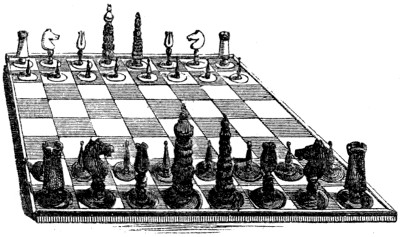
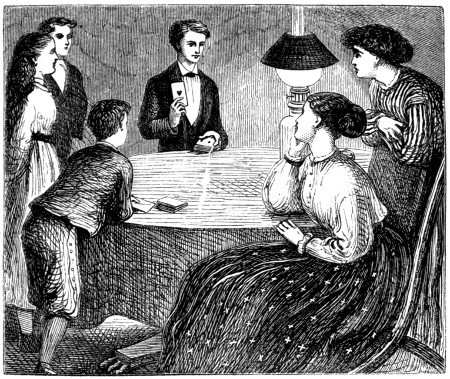
From the very early ages of the world the art of legerdemain, commonly called conjuring, has been known and practised. In some of the old heathen ceremonies the priests made use of skilful deceptions, in order to impose upon the people; and in ancient Egypt, in Greece, and in Rome, the worship of the gods was frequently associated with mere tricks, which were used for the purpose of obtaining an influence by a pretence of extraordinary and supernatural powers. Among the Eastern nations juggling was a profession, and to this day the jugglers of Hindustan and other Oriental nations are so skilful that they are able to deceive even the most acute observers. In our own country, after the Norman Conquest, the juggler (who was called jongleur, or joculator) was a minstrel as well as a conjurer, a reader of the stars or astrologer, and at the same time a jester, a merry-andrew, and a teller of droll stories. These jongleurs travelled from place to place, and exhibited at fairs,[644] feasts, and merrymakings, as well as in the houses of noblemen, where they diverted the company in the great halls. In the fourteenth century they gave more attention to tricks and feats of skill, and became known as tregetours. The performances of some of these gentry were so marvellous, that the common people believed them to be the result of witchcraft, and classed the tregetour with the warlock and the sorcerer. Chaucer, who no doubt had frequently an opportunity of seeing the tricks exhibited by the tregetours of his time, says, “There I sawe playenge jogelours, magyciens, tragetours, phetonysses, charmeresses, old witches, and sorceresses;” and the old poet goes on to say of them, “Sometimes they will bring on the similitude of a grim lion, or make flowers spring up as in a meadow; sometimes they cause a vine to flourish, bearing white and red grapes, or show a castle built with stone, and when they please they cause the whole to disappear:” and in another part of his works he says:—
Our learned monarch James I. was perfectly convinced that these and other inferior feats exhibited by the tregetours of his day could only be performed by diabolical agency. The profession had already fallen very low, and at the close of the reign of Queen Elizabeth the performers were ranked by the moral writers of that time not only with ruffians, blasphemers, thieves, and vagabonds, but also with Jews, Turks, heretics, pagans, and sorcerers; and in more modern times, by way of derision, the juggler was called a mocus-pocus, or hokus-pokus, a term applicable to a pickpocket or a common cheat.
The following pages are not intended to make the young reader either a cheat or a trickster; there is nothing perhaps so utterly contemptible in every-day life as trickery and deceit, and we would caution our young friends not to cultivate a love of deception, which is only allowable in such feats of amusement, because it is in fact not deception at all, when everybody expects to be puzzled, and is only left to find out the mystery the best way he can.
With this sage advice we shall present a collection of amusing conjuring tricks, premising that a considerable number of tricks usually embodied in this division will be found in that part of our work relating to Scientific Experiments and Amusements, as they more properly belong to “Natural Magic,” and are to be referred to the various operations of nature in the several departments of art, science, and philosophy.
It is intended in the following pages to lay more stress upon those tricks which require no apparatus than upon those for which special apparatus or the assistance of a confederate is required. No one is nearly so well pleased by a trick whose essence evidently lies in the machinery, while every one feels pleasure at seeing a sleight of hand trick neatly executed. The audience often despise all the numerous boxes, bottles, variegated covers, and other gimcracks which are generally seen on a conjuror’s table; and are seldom so pleased with any performer as with one who does not even require a table, but presses into his service articles borrowed from his audience. The spectators should never be able to say, “Ah! the trick lies in the box: he dares not show it to us!”
The following tricks have almost all been successfully performed, and have caused some reputation in the magic art. Some of them are the invention of one of the most eminent “conjurors” of modern times.
This trick must be frequently practised before it is produced in public.
Borrow two coloured silk handkerchiefs from the company, and have three shillings in your hand, but only show two, keeping the other one firmly fixed against the first joint of the second and third fingers. You must also have a fine needle and thread stuck inside the cuff of your coat. Then take one of the handkerchiefs, and put in both shillings, but pretend that only one is in the handkerchief; then put the handkerchief into a hat, leaving one corner hanging out. Now hold up the third shilling (which the spectators imagine is the second), and ask one of the company to lay the second handkerchief over it. You then ask him to hold the shilling tight between his finger and thumb, while you twist up the handkerchief. While doing so, with both hands concealed under the handkerchief, you pass a few stitches under the shilling, and replace the needle. This being done, spread one corner of the handkerchief over the hand of the person who is still holding the shilling, and, taking hold of another corner, tell him to drop the shilling when you have counted three. At the word “three” he lets go the shilling, and you whisk the handkerchief into the air, when the shilling appears to have vanished, but is really held in the handkerchief. You then tell the astonished individual to draw the other handkerchief out of the hat by the corner that is hanging out. The two shillings are heard to fall into the hat, and every one is persuaded that you have conjured one of the shillings out of the person’s hand, and sent it into the hat.
Perhaps the spectators may ask to see it again, or demand to mark the shilling. In this case, vary it as follows. Ask some one (always choose the most incredulous of the party) to mark a shilling of his own and give it you. Take the same handkerchief and give him the shilling to hold that is already enclosed in it, as in the last trick, dropping the marked shilling into the palm of your hand. Twist it up as before, and then leave it entirely in his hands. Direct him to place it on a table, and cover it with a basin or saucer. Ask him to give you a cup or tumbler, and hold it under the table, beneath the place where the saucer is. Then tell him to knock three times on the saucer, and at the third knock let the marked shilling fall into the tumbler. Hand him the tumbler, and while he is examining the shilling to see if it is the same one that he marked, take up the saucer, and shake out the handkerchief that is lying under it, as in the last trick. You must then return the handkerchief, and while you pretend to be searching for the marks, draw out the thread that held the shilling and drop the coin into the palm of your hand, taking care to rub between your finger and thumb the spot where the threads had been, in order to eradicate the marks. This variation seldom fails to confuse the company.
You must remember to keep talking the whole time, and always try to make a joke, or otherwise to distract the attention of the audience, while you are executing the necessary changes.
Ask some lady to lend you the beads off her bracelet, or have by you five or six beads, which you may hand round for examination. Then get some one to cut two pieces of thin string of equal length, and twist them about your fingers, appearing to lay them side by side, but in reality placing them as in the figure, and then, by twisting them together with apparent carelessness, the manner in which they are arranged will not be seen, particularly if you keep the point of junction hidden either by a finger, or by throwing the shade of your hand upon it.
When the beads are returned, thread them all, taking care to pass the centre bead over the point of juncture. You then bring the ends of the string 1 and 2 together and tie them so, doing the same with 3 and 4. Now give the tied ends to two persons, directing them to hold them tight. You need not fear that the beads will come off, even if they pull hard. Then grasp the beads with both hands, directing the holders to slacken the strings. You then, under cover of the left hand, which is placed above the beads, slip the centre bead[647] to one side, and draw out the two loops which have been hidden in it. The beads will then easily come off into your right hand. Tell the holders to pull hard, which they will do, and the same moment remove your hands, showing the empty strings and all the beads in your right hand. Then hand round the beads and strings as before. Remember to rub out the marks in the strings caused by the loops before you remove your hands.
Bend a piece of gold wire into the form of a ring, having previously sharpened both ends. You have a real ring made of the same piece of wire, and concealing the false ring in the palm of your hand, offer the real one to be inspected. When it is returned, borrow a handkerchief, and, while taking it from the lender, slip the real ring into your left hand, and take the false one at its point of junction. Throw the handkerchief over the ring, and give it to some one to hold between his finger and thumb. Let the handkerchief fall over it, and give a piece of string to a second spectator, directing him to tie it round the handkerchief, about two inches below the ring, so as to enclose it in a bag, and tell him to do so as tightly as he can. While he is doing this, take up your conjuring wand, a rod of some hard wood, about eighteen inches long, and when the knot is tied, step forward, passing the rod into your left hand, taking care to slip over it the real ring, which has lain concealed there. Slip your left hand to the centre of the rod, and direct each of the two persons to hold one end of it in his right hand. Then tell the one who has the ring and handkerchief, to lay them on your left hand, which you immediately cover with your right. Then tell them to spread another handkerchief over your hands, and to say after you any nonsense that you like to invent.
While they are so doing, unbend the false ring, and draw it through the handkerchief by one of its points, carefully rubbing between the thumb and finger the place where it came through. Hang the empty handkerchief over the ring which is on the rod, and take away your hands, which you exhibit empty, as you have stuck the false ring inside your cuff. Take away the upper handkerchief, and let a third person come to examine, when he will find the ring gone out of the handkerchief, and hung upon the rod.
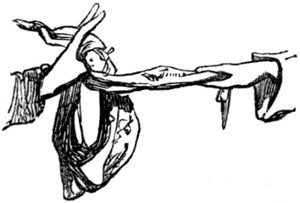
Cast an ordinary knot on a handkerchief, and give the end out of your right hand to some spectator, and tell him to pull hard and sharp when you count three. Just as he pulls, slip[648] your left thumb under the handkerchief, as drawn in the cut, and it will be pulled out quite straight without any knot at all. You must let go the end that hangs over the left hand, and grasp the handkerchief between the thumb and forefinger.
This is an admirable delusion, but requires very careful management, and should be practised repeatedly before it is exhibited publicly. You get three tin cups, of the shape shown in the cut. They should have two or three ridges running round them at the mouth, in order to give a better hold. Four balls should now be made of cork, and carefully blackened. One of the balls is held concealed between the roots of the third and fourth fingers, while the other three are handed round for examination, together with the cups. When they are returned, the young conjuror begins by placing each ball under a cup, or, if he chooses, asks one of the spectators to do so for him. While this is being done, he slips the fourth ball to the tips of the second and third fingers. He then lifts up cup No. 1, replacing it on the table a few inches from its first position, and at the same time slips the fourth ball under it. He takes up ball No. 1, and pretends to throw it away, but in reality he slips it into the place which the fourth ball had occupied. He does the same with the three cups, and then commences a sham search after the lost balls, in which he accidentally (!) knocks over one of the cups, and, to his pretended astonishment, finds a ball under it. He then knocks over both the other cups, and finds in them the two missing balls.
He again places the balls under the cups, taking care to slip the fourth ball under cup No. 3. He then takes up cup No. 1 and pretends to throw the ball into No. 3, but hides it as before. As there are already two balls in No. 3, the spectators imagine that he really has thrown the ball into it. He replaces cup No. 3 over both balls, and slips among them ball No. 1. He then takes up cup No. 2, and goes through the same process, and on knocking over cup No. 3, all three balls are found together under it, and while the spectators are being astonished, ball No. 2 can be quickly got rid of.
A rather startling termination to this trick can be managed by taking up one of the cups with its mouth upwards, holding the finger and thumb close to its mouth. Then by throwing another cup into it, letting go the first and catching the second, you appear to have thrown the second cup through the first.
Hold the handkerchief by both ends, lay the centre of the handkerchief on your knee, and pass the two ends below, appearing to[649] cross them, but in reality hitching them within each other, as represented in the engraving, which shows the manner in which this is managed. Draw this loop tight, and bring back the ends to the same side on which they were originally, and tie them above. If the loop is properly made, it will stand a good pull. Then, after showing the spectators how firmly it is tied, put your hand under the knot, and by giving it a sharp pull, it will come off.
The engraving represents the manner in which the loop is made, but it must be made considerably smaller than it is shown, or it will be seen. In fact, it ought not to be a loop at all, as it should be almost concealed under the fold of the handkerchief. Do not show this in public until you can tie it with rapidity and precision.
Take a piece of string, and tie the two ends together with a weaver’s knot, as that holds the best, and arrange it over the fingers as represented in the engraving. Having done so, let the long loop hang loose, lift both loops off the thumb, draw them forward until the string is quite tight, and then put them behind the hand, by passing them between the second and third fingers. Then pull the part of the string that is across the roots of the fingers, and the whole affair will come off.
Take the same piece of string as in the last trick, hold your left hand with the palm uppermost, and hang the string over the palm. Spread all the fingers, and with the right hand bring forward the loop that hangs behind, by passing it over the second and third fingers. Loose the loop, take hold of the part of the string that crosses the hand, and pull it forwards. When tight, pass it to the back of the hand, the reversal of the movement that brought it forwards. Loose the loop, insert the fore-finger and little finger of the right hand under the string that encircles the left fore-finger and little-finger, and pass the two loops to the back of the hand, as shown in the cut, Fig. 1. Tuck both loops under the cross-string at the back, and your preliminaries are completed. Then begin your story: “There was once[650] upon a time an old man, who stole a pound of candles. Here they are.” You then hold your left hand as at the commencement, hook the right fore-finger under the cross-piece at the back, and draw it downward until it is long enough to be passed over the second and third fingers to the front. Pass it over, and draw it slowly upwards, when the similitude of a pound of candles hanging by their string will be seen. (See Fig. 2.) “The old man, being tired, hung up his candles,” you then hang the long loop over your thumb, “and sat down in his high-backed chair, which you see here.” You then hitch the right fore-finger and middle finger under the two loops that will be found hanging behind the left hand, bring them to the front, raise them perpendicularly, and the chair will be seen as in Fig. 3. The thumb must be raised perpendicularly, and brought as much as possible into the centre of the hand, or the chair will be all aside.
“When the old man was rested, it began to become dark, and he took a pair of scissors to cut down a candle for himself. Here are the scissors.” While you are saying this, you slip the loop off the thumb, and you get Fig. 4. Move the blades and handles of the scissors, as if cutting something with them. “Just as he had lighted it, in came a policeman, and produced his staff, with the Queen’s crown at the top.” Now let go the little finger of the left hand, and the loop will run up the string towards the right hand, producing Fig. 5. “The old man in vain tried to resist, for the policeman called a comrade to his assistance, and they tied a cord round the old man’s arms in a tight knot, like this,”—slip the right middle-finger out of its loop, and you will obtain Fig. 6,—“and carried him off to prison.”
| 1. Fore-finger of left hand. 2. Little finger of left hand. |
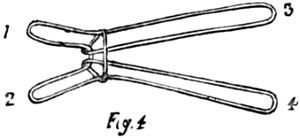 |
3. Fore-finger of right hand. 4. Middle finger of right hand. |
| 1. Right fore-finger. | 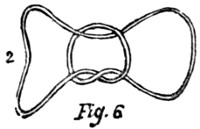 |
2. Left hand. |
Take a piece of thick pliant string by each end, and with a quick jerk of the right hand cast a loop on it as in Fig. 1. The jerk must be given upwards and towards the left hand, and its impetus will cause the loop to run up the string until it falls over the left wrist, as in Fig. 2. The moment that the forward jerk is given the right hand should be drawn back, so that the loop is drawn tight directly it has settled on the wrist. Both ends should be let fall when the knot is firm. This is a very nice little sleight of hand to practice in the intervals between more showy tricks, and, although rather difficult to learn, is soon acquired.
Let two persons, A and B, have their hands tied together with string, so that the strings cross, as represented in the engraving. The object is, to free themselves from each other without untying the knot. It is executed in the following manner.
Let B gather up the string that joins his hands, pass the loop under the string that binds either of A’s wrists, slip it over A’s hand, and both will be free. By a reversal of the same process, the string may be replaced.
Take a piece of string about two feet in length, and tie the ends together. Pass it through a button-hole of your coat; hitch one thumb at each end, hook the little fingers into the upper strings of the opposite hand. Then draw the hands well outward, and the string will look very complicated, as in the engraving.
To get out the string, loose the hold of the right thumb and left little finger, and separate the hands smartly, when the string will appear to have been pulled out through the substance of your coat.
It is an improvement of the trick, if, immediately on loosing the hold of the right thumb, you change the string from the right little finger on to the thumb.
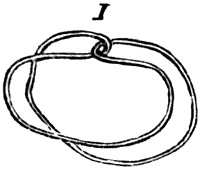
1. The twisted string.
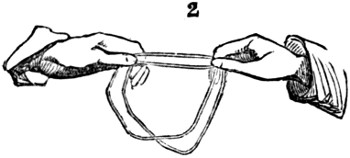
2. The manner of holding it.
Tie together the ends of a piece of string, pass one hand through each end, twist it once round, and put both ends into the left hand. Draw the right hand rapidly along the double strings until you come to the place where the strings have crossed each other, as seen in the engraving. Conceal the junction with the thumb and finger of the right hand; hold the strings in a similar manner with the left hand, and tell some one to cut the string between them. You show that the string has been divided into two pieces, and say that you will join them with your teeth. Put all four ends into your mouth, and remove with your tongue the little loop that has been cut off. When you take the string out of your mouth, the spectators will not notice the absence of so small a portion of its length, and will fancy that you really have joined them.
Take a silk handkerchief, and lay it on a table. Take each of the corners, and lay them across each other in the middle of the handkerchief, which will then be square, as in the cut, Fig. 1. Do the same with the new corners, and go on until the handkerchief is reduced to the size of your hand. Then with your left finger and thumb take hold of the centre, taking care to grasp all the four corners that lie there, and with the right finger and thumb take hold of the outer layer of silk, and pull it towards you as far as it will come. Then turn it a little on your left hand, and repeat the operation until it is all screwed up into a tight ball, as is represented in the engraving, Fig. 2. No ends will be then perceptible, and a person who is unacquainted with the mode will never be able to untie it. Of course you must prepare it previously. When the person to whom you give it has failed to untie it, you take the ball in your hand, and holding it behind your back, you reverse the method by which it was tied, and when it is loose a good shake will release it.
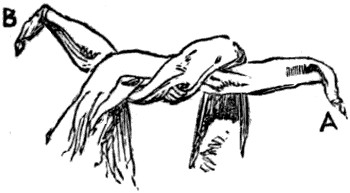
This is a very amusing deception. You ask any one for a handkerchief, and tie the ends firmly together in a double knot, allowing him to feel it, or pull the ends as tight as he pleases. You then throw the centre of the handkerchief over the knot, and ask the person to hold it tight between his finger and thumb. You ask him if the knot is still there, to which he will answer in the affirmative. You then take hold of any part of the handkerchief, and direct the holder to drop the handkerchief at the word “three.” You count, “one, two, three,” at which word he looses his hold of the handkerchief, and there is no vestige left of the knot.
The method of managing this trick is as follows:—Take the handkerchief and tie the ends in a simple knot, keeping one end tight, and the other end loose. We will call the tight end A, and the loose one B. Keep A always in the right hand, and on the stretch horizontally, and the handkerchief will look as in the cut. Do this when you tie it the second time, and draw B tight, which will then form a double tie round A, but will not hold it firm. When you throw the handkerchief over the knot, you draw out A with the finger and thumb of[654] the left hand, and the knot will apparently remain firm, although in reality it is nothing but a double twist of silk, which of course falls loose when the handkerchief is dropped.
Take three nuts in the left hand, show them, and take out one of them between your right finger and thumb, and another between the first and third finger. This latter is not seen by the company. You then put one of them in your mouth and retain it there, unknown to the spectators, while you exhibit the second as the one that you put into your mouth. This second one you carry to your ear, as if you meant to insert it there, and on replacing it in your left hand, only two nuts will be left instead of three, the third of which appears to have gone into your ear.
Conceal a very strong walnut in your right hand, and take two other walnuts out of the dish. Place one of them on the joint of your arm, and say that you are going to break it by the power of your muscles. You will now have one walnut in your arm and two in your right hand. Close your left arm, and strike it an apparently violent blow with the right hand, at the same time clenching the right hand violently, which will smash the second walnut in it, and the spectators hearing the crash will be sure to fancy that it is caused by the demolition of the walnut in your arm. Then open you arm very gently (for fear of dropping any of the fragments, you must say), and, when pretending to take out the walnut which you had placed there, you substitute for it the broken one from your right hand.
Procure at the military clothier’s four or five large plumes, such as are worn by officers. Take off your coat, and lay the plumes along your arms, the stem being toward your hand. Now put on your coat again, and the feathers will lie quite smoothly and unsuspected. Borrow a handkerchief from one of the spectators, and wave it about to show that it is empty. Throw it over your left hand, and with the right draw out one of the plumes from up the coat-sleeve, at the same time giving it a flourish in the air, which will loosen all the fibres of the feather, and make it appear much too large to have been concealed about the person. Wave the handkerchief again, and repeat the operation until all the plumes are gone. You can carry enough plumes under the sleeve to cover a table with, and if you prepare a board or an ornamental vase full of holes, you can place the plumes upright as you take them out.
None of the following tricks are wholly managed by the apparatus, as such performances are unworthy of notice. Therefore, every trick[655] mentioned in the following pages must be carefully practised in private before it is produced in public. The apparatus, of course, cannot be inspected by the audience, and for that reason it is better to mix them with those tricks which have been already mentioned, in order that suspicious persons may be quieted by an occasional permission to inspect the objects used in the performances.
The young conjuror should always vary the mode of performance in the non-essentials, and should study combinations of one trick with another, by which means he will produce more astonishing results than if he restricted himself to the methods mentioned in this work. He should also invariably make a little speech, acknowledging that he is only deceiving the eye and not the mind, and should therefore request the company not to ask any questions, or to demand inspection of any of his apparatus.
Get a wooden die about two inches and a half square (1), and a hollow tin die exactly the size of the wooden one, but without one of the sides (2). Then paint them both exactly alike, as in the engraving. It will be better to let an accidental flaw appear on the same side of each. Then get a tin cover (4) that exactly fits the dies. Now for the trick itself.
Borrow two hats, and while you turn your back upon the audience as you go to your table, slip into one of them the false die. Place both hats on the table, and send round the real die and cover for inspection. When they are returned, say, “Now, ladies and gentlemen, it is my intention to place these hats one above another, thus.” You then place the two hats as in No. 3, the hollow die being in the bottom hat. “I shall then cover the die thus,” which you do, “and after I have knocked on the cover, I shall take it off, and you will find that the die is not under the cover, as it is now,” taking it off, “but inside the hat, like this.” You then put the real die into the hat. “You do not believe me, ladies and gentlemen, but I will soon convince you.” You then take out the false die, and replacing the upper hat, put the die on the upper hat (of course, with the open side downward) and place the cover over it. Pick up your conjuring wand, give it a few flourishes, and bring it down on the cover. Grasp the cover tightly near the bottom, when both cover and false die will come up together; put the end of your wand into them, and give them a good rattle. Then knock off the upper hat with a blow of the wand, and push the lower one off the table, so that the die tumbles out of it. Always use plenty of gesture about your tricks.
Get a brazier to cut out all the interior of five pence, only leaving the rims. He must then bore out nearly all the interior of a sixth penny, merely leaving a shell of copper at the top. A long rivet must then be let into the rim as shown in Fig. 1, No. 2, and a hole must be drilled in each of the five rings, as in No. 3. The rivet is to be passed through the holes in the rings, and fastened below, so that all the rings can play easily upon it. Fig. 1, No. 1, is a section of the entire apparatus, the dotted lines representing the rivet. They can then be placed as shown in Fig. 2, No. 1, and no one will imagine that they are only shams, as you can rattle them or move them about upon each other. A leathern cover, Fig. 2, No. 2, is then made, which passes easily over the heap of pence, but being pliable, is capable of picking up the hollow pence with it, when it is held firmly. To the under surface of the table you fasten a little shelf, Fig. 2, No. 3, which moves on a hinge, and is let fall by placing the foot on the pedal, Fig. 2, No. 4, which draws the catch.
To perform the trick, place six real pence on the little shelf, and have the sham pence on the table. Take them up and rattle them, and put them down as in Fig. 2, No. 1. Keep a sixpence in the palm of your hand, pick up the sham pence, and as you put them down, slip the sixpence under them, as you do the ball in trick 6. Take the cover, and put it over the sham pence, make a short speech, and knock the cover with your wand, at the same time pressing the pedal with your foot, which will cause all the six real pence to tumble down with a great crash. Take up the cover and false pence together, put the end of your wand into them and hold them up triumphantly, showing the spectators that the six pence have been replaced by a silver sixpence. While you are picking up the pence, slip the sham ones out of the cover into your left hand, and take some opportunity of letting the empty cover roll towards the audience, one of whom you ask to pick it up and bring it you. This manœuvre generally disarms all suspicion, for the picker-up is sure to examine it very closely.
I have only given mere outlines of this really excellent trick, which may be varied in a hundred ways, and is capable of combination with other tricks to a large extent. It will add to its complicity, if a set of six half-pence is also made like the pence. For the pedal may be substituted a lever running immediately under the surface of the table, if the performer prefers to have a short cloth on it. There[657] should be always two cloths on the table,—the lower one thick and soft, to prevent jingling of objects, and the upper one white, as it displays everything better than a coloured one. The ingenuity of the young conjuror will easily find methods of varying this trick.
Get a comical looking doll, and cut off his head diagonally, taking care to do it very neatly. Drive a peg into the neck, and bore a hole in the body, into which the peg fits, as in the cut. Paint his body and head carefully, and if you put a gold chain or two round his neck, it will conceal the line of junction. Make also a coat of silk, and sew a pocket inside the edge of the skirt.
Take up the doll, and say, “Now, ladies and gentlemen, here is a very learned man. Observe the development of his forehead, the sagacity of his nose, the eloquence of his lips, the dignity of his spectacles, and the philosophy of his pigtail. He is professor of astronomy at Timbuctoo, and here is his gown of office. See how handsome he looks in it. He is going to Amsterdam to see the eclipse of the last new comet. He has the honour to wish you all farewell before starting on his journey. Now, professor, we are waiting to see you go. Oh! you want funds, do you? I beg your pardon; here is a shilling for you.” So saying, you take your right hand from under the gown, taking with it the body, and put the body into your pocket, while you jingle some silver. The head is now supported by your left hand. Pretend to give him some money, and then say, “What! you won’t go unless you have more! Get along!” Hit the head a hard rap with your right hand, which drives it into the pocket, which you hold open for it with your left thumb and little finger. “Oh dear! the doctor is dead, and cannot be found.” Saying this, you grasp the gown by the place where the head is, and shake it about to show that it is empty. If you like, you can make another oration and hold a dialogue, making the doctor resuscitate himself, which is of course done by taking the head out of the pocket with the left hand, and working it about by the peg.
Take two sovereigns, or rather brass imitations, and grind them down until they are reduced to half their thickness. Do the same with two shillings, and fasten them accurately together, so that you will have two coins, each having one silver face, and one brass face. Take one of them in each hand, showing the silver side of one and the brass side of another, and offer to change them without moving[658] your arms. Shut your hands, and the coins will turn over. Then, on opening them again, they will appear to have changed from one hand into the other.
Put a little wax on the nail of the middle finger of the right hand, and take a fourpenny piece into the palm of the same hand. Close the hand, pressing the wax on the coin. Then rapidly open it, and the silver piece will adhere to the wax, and be quite concealed behind the finger when you hold your hand up.
Make a memorandum book, and line the cover with paper which has been previously rubbed with a mixture of lamp-black and oil. The paper must be loosely affixed, so that it can be raised up, and a leaf from the memorandum book placed under it. You must also make a flat box, having a double opening.
You now take a leaf out of the memorandum book, and ask some one to write a sentence, at the same time offering him the book to write upon. The pencil with which you furnish him is very hard, and he is forced to press upon the paper in order to mark. In so doing, the black is transferred by the pressure of the pencil from the blackened paper to the white leaf that has been placed under it, and of course makes an exact copy of the writing. You then give the man his document, put the memorandum book in your pocket, and go out of the room to fetch your box, which you have forgotten. While you are out of the room, you take out the leaf from under the black paper, and put it into one side of the flat box, and shut down the cover that hides it. You bring in the box, apologising for your absence, and give the box, open at the other side, into the writer’s hands. Tell him to burn his writing in a candle, and to place the ashes in the box. He does so, and closing the box, returns it to you. You then flourish about a little with the box, wave it in the air, bring it down with a bang on the table, strike it with your wand, and then, opening it as at first, you produce the duplicate leaf, which the writer acknowledges to be his own hand-writing. If the lamp-black should have come off and smeared the paper, you can account for it by observing that it is very difficult to get rid of all traces of the burning.
Get a blacksmith to make a number of rings, about six or seven inches in diameter, as in the cut. A is made with a spring opening on one side, B is a set of two rings forged permanently within each other, C is a set of three rings formed in the same manner, and D D are two simple rings. The rings should be about the thickness of a rather large blacklead pencil.
Lay the rings on one another, and they will all appear to be separate and distinct; D D should be the uppermost rings, then B, then A, and then C. Hand round D for inspection, and if any more are desired, hand round the other D. When returned, you hang them over your left arm, or grasp them in your hand, and tell the company that you are going to weave all the rings together. You clash them together, and after going through some complicated movements, bring out B, which the spectators will think you have just fastened together. Hand them round. When they are returned, mix them all up, and bring out C. Then take A in your hand, and passing one of the outer rings of C through the opening, you have four rings together. Then add D and you have five. Take off D and substitute B, which will give you six. So you go on, weaving them into all kinds of fantastic shapes. You must always conceal the joint in A with your thumb, and contrive as often as you can to have one at least of the rings D at liberty. This is a capital trick, and may be diversified to any extent, especially if the number of rings is increased.
This is really a first-rate delusion. You bring before the spectators a glass vase, full of ink. You dip a ladle into it, and pour out some of the ink upon a plate, in order to convince the audience that the substance in the vase is really ink. You then throw a handkerchief over the vase and instantly withdraw it, when the vase is found to be filled with pure water, in which a couple of gold fish are swimming.
This apparent impossibility is performed as follows. To the interior of the vessel is fitted a black silk lining, which adheres closely to the sides when pressed by the water, and which is withdrawn inside the handkerchief during the performance of the trick. The ladle has a hollow handle with an opening into the bowl. In the handle is a spoonful or so of ink, which runs into the bowl when it is held downwards during the act of dipping it into the vase.
The performer of this trick borrows a number of hats, and places them on the table. He then returns each person his hat, and on turning it over, a thirty-two pounder cannon ball rolls out.
The method of performing this delusion is as follows. Get a turner to make a number of wooden balls, each the size of a thirty-two pounder cannon ball, and let a hole be bored in each which will admit[660] the middle finger. The balls are arranged hole upwards on a shelf on your table on the side opposite to the audience, so that the balls are nearly level with the top of the table. When you take a hat off the table, you slip your fore or middle finger into the ball just as you would into a thimble, and by bending the finger, bring the ball into the hat.
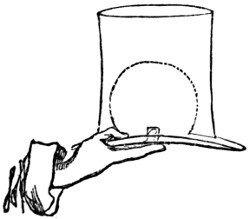
Any object may be brought into a hat in this manner, a great cabbage, for instance, having a hole cut in the stalk.
Get a tinman to make a flat tin tube, which will just allow a shilling to pass through it. Wind a quantity of worsted round it, so as to make it into a ball.
These preliminaries having been accomplished, perform any trick that will get a shilling out of sight, such as No. 1 or 2. Then tell the spectators that you will bring the marked shilling into the middle of a ball of worsted. Take down the ball from the place where it is lying, drop the shilling into the tube, and withdraw the tube, leaving the shilling in the ball. A good squeeze or two will hold it tight, and obliterate every mark of the tube. Place the ball in a tumbler, take the end of the worsted, and give it to some one to unwind. This being done, the shilling will be found in the very centre of the ball, with the end of the worsted wrapped tightly round it.
Get a chintz or cloth bag made double, and between the two bags make six or seven pockets, each of which will hold an egg, and having an opening into the bag. Fill the pockets with eggs, and you are ready for the performance.
Hold the bag by the place where the eggs are, shake it, turn it inside out and show that there is nothing in it. Then tell the spectators that you are sure that there is a hen in the bag. Put your head near the mouth of the bag, and make a clucking like a hen. You then say, “I knew I was right, and she has laid an egg.” So saying, you put your hand into the bag and take out one of the eggs, taking care to pretend to grope in one of the corners for it.
This is repeated until all the eggs but one are gone. You then, after taking out the last egg, say that some people think that the eggs are not real, but you will convince them by ocular inspection. Saying this, you break the egg in a saucer with your right hand, and while the people are occupied with it, you drop the bag behind your table, or hang it on a hook out of sight, and take up another exactly like it, into which you have put a hen. “These are real eggs,” you then say, “and if any one doubts their reality, they cannot doubt that[661] this is a real hen.” You then turn the bag upside down, and shake out the hen. If any one wishes to inspect that bag, he can do so without being much wiser for it.
Send for some eggs, and take care to place among them one which has been emptied of its contents, and to which is fastened a long hair, at the other end of which is tied a crooked pin. Borrow a small stick from one of the spectators, and as you go behind your table contrive to hook the bent pin into your coat, passing it over the stick. Then place the egg on an inverted hat, and ask for some music, and directly it begins to sound, a slight and imperceptible depression or elevation of the stick will cause the egg to twist and roll about upon it as if it had life. You must be careful to turn gently round now and then, so as apparently to vary the distance of the egg from the body.
Get a wooden bell made, so thick that there is a considerable space between the outer and inner surfaces, especially on the upper part of the bell. A hollow must be cut in this, and the handle so made, that when it is at rest, it is forced upwards by a spring, and draws up the round piece of wood to which the clapper chain is attached, and closes the aperture, as shown in the engraving.
You have a cardboard measure, which is of precisely the same capacity as the cavity in the bell, and just wide enough to hold a farthing. Into this you privately put a farthing, and then fill up the measure with shot, heaping it a little, to compensate for the farthing. You make up a tale about a man going out shooting, and ringing the bell of the gunmaker’s shop. (You then ring your wooden bell.) How the man bought a measure full of shot for a farthing, (you pour the shot into the bell and back again two or three times,) but was so long haggling over three shots, that the gunmaker took away the shot, (here you again pour the shot into the bell, and by pressing on the handle, allow them all to run into the hollow,) and kept the farthing for his trouble. The man went out of the shop, but soon came in again, and rang furiously. (Here you again ring the bell, which is now apparently empty, and invert the measure on the table. The farthing not being held by the finger and thumb will now fall on the tablecloth.) Then finish the story with an account of the manner in which the man got back his farthing. When you have finished, invert the bell over the empty measure, and on pressing the handle, the shots[662] will refill it. Do not touch, it until you have done another trick or two, and then, when you put the bell aside, ring it again, and remark that the purchaser was a silly fellow after all, for here are his shots in his measure.
Get a tinman to make a double canister, such as is shown in the cut, with an opening at each end. This must so slide within a tin tube, that either end can be concealed within it alternately, as seen in the engraving, where the end A is shown, and B is concealed. In this position it looks like an ordinary canister. The interior is divided into two parts. Into B put a piece of cambric made to look like a handkerchief.
Borrow a cambric handkerchief, and say, “Now, ladies and gentlemen, I shall burn this handkerchief to ashes, place them in this canister” (so saying, you put it into A), “and when I have uttered a spell, it will be restored perfectly whole. Will the owner say what mark it has?” While the audience are looking towards the owner, you turn the canister over, and push up the canister until the shoulder of B is on a level with the top of the tube. When the mark has been declared, you open B, take out the cambric, and pretend to verify the mark. You then put it into a candle flame, and when it has burnt entirely to ashes, put the ashes into B, shut it up, and rapidly reverse it as you turn round to your audience, so that A is uppermost again. Then, utter any nonsense you like, open A and take out the handkerchief uninjured. It rather adds to the trick if you drop a little eau de cologne into A before commencing.
If the young conjuror is desirous of appearing in the character of a fire-eater, it is very easily managed. He must prepare a piece of thick string, by soaking it in a solution of nitre, and then drying it. He cuts off a piece about an inch in length, lights one end, and wraps it up in a piece of tow which he holds in his left hand. The trifling smoke will be concealed by a huge bundle of loose tow also carried in the left hand.
He takes a handful of tow in his right hand, puts it into his mouth, chews it up, and appears to swallow it. He then takes another handful, and with it the piece in which is the string. As he puts this into his mouth, he takes out the piece which he has already chewed. By taking breath through the nostrils, and breathing it out through the mouth, smoke begins to issue forth, and the whole interior of the mouth is soon lighted up with a glow. When the mouth is shut, and the tow pressed together, the fire goes out, except the piece of[663] prepared string. More tow is then taken into the mouth, and treated in the same manner.
In this short account of conjuring, I have purposely avoided such tricks as require expensive apparatus. Such apparatus is either entirely beyond a boy’s reach, or at all events he ought not to be encouraged in the notion of spending much money on objects of no real use. A boy of any ingenuity will make the greater part of the apparatus himself, or at least he can do the painting and polishing of his machinery. I have mentioned no machinery that need cost more than two or three shillings at the outside, and not that, if a boy is acquainted with the use of tools.
In accordance with the previous rule, the principal stress is laid on card tricks that require no apparatus, and may be performed with ordinary cards.
This is a necessary beginning for card tricks. “Making the pass” is the technical term for shifting either the top or the bottom card to any place in the pack that you like. It is almost impossible to describe it, and I can only say that it will be learnt better in five minutes from a friend, than in as many hours from a book. As, however, a friend is not always to be found who can perform the pass, I will endeavour to describe it.
The cards are held in both hands, right hand underneath and left above, as in the engraving, where, as the bottom card is to be raised to the top, the little finger is seen between that card and those above it. By a quick movement of the right hand, the bottom card is slipped away towards the left, and is placed upon the top card, under[664] shadow of the left hand, which is raised for the moment to allow of its passage.
This movement must be assiduously practised before it is exhibited in public, as nothing looks more awkward than to see it clumsily performed, in which case two or three cards generally tumble on the floor.
While shuffling the pack, cast a glance at the bottom card, make the pass, and bring it to the top. Continue to shuffle, and lay upon it by degrees as many cards as you like, say six. Then lay the pack on the table, face downwards, and divide it into seven heaps, beginning at the bottom, and leave the seventh heap larger than any of the others.
When you have done this, take one card from the top of the seventh heap, appear to calculate, and lay it, face upwards, on one of the other heaps. Do so with five more cards, thus leaving your slipped card at the top of the seventh heap. You then announce that by the aid of the six cards you will name the seventh. You name it accordingly, after carefully studying the other cards, and on asking a spectator to take it up, it will be seen that you are right.
If you place five cards above the slipped card, you will lay out six heaps, and if eight cards, there will of course be nine heaps.
As in the last trick, cast a glance at the bottom card, say the ace of spades. Lay out the pack in as many heaps as you like, noting where that one is laid which contains that bottom card. Ask any one to take up the top card of any heap, look at it, and replace it. You then gather up the heaps apparently by chance, but you take care to put the heap containing the bottom card upon the card which has been chosen. You then give any one the cards to cut, and on counting them over, the card that immediately follows the ace of spades is the card chosen.
If by any accident the two cards should be separated when cut, the upper card of the pack is the chosen one, and can be picked out with seeming care.
Make out a table, such as is given on the next page, Fig. 1, and place it in an opera-glass, so that the figures will be visible when you look through it. For convenience, I have made mine as seen in Fig. 2, the numbers 1, 2, 3 in each series being understood. The best plan is to write the numbers, or cut them out of a book, and paste them on a circular piece of cardboard, which must then be soaked in oil, so as to make it semi-transparent. The light will then easily pierce through it, and the figures will be better visible than if it were opaque.
It will be seen that Fig. 2 contains as much matter as Fig. 1, and that two-thirds of the figures are saved by it.
| 1. | 131. | 10. | 132. | 19. | 133. |
| 2. | 231. | 11. | 232. | 20. | 233. |
| 3. | 331. | 18. | 332. | 21. | 333. |
| 4. | 121. | 13. | 122. | 22. | 123. |
| 5. | 221. | 14. | 222. | 23. | 223. |
| 6. | 321. | 15. | 322. | 24. | 323. |
| 7. | 111. | 16. | 112. | 25. | 113. |
| 8. | 211. | 17. | 212. | 26. | 213. |
| 9. | 311. | 18. | 312. | 27. | 313. |
| Fig. 1. | |||||
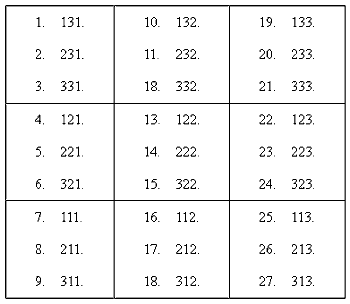
Fig. 1.
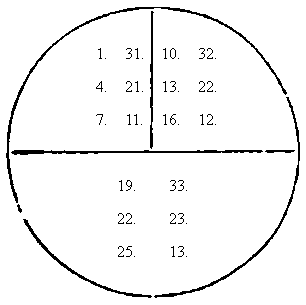
Fig. 2.
These preliminaries being arranged, tell any one to take any twenty-seven cards out of a pack, and to think of any one of them. Deal them into three heaps, and ask him in which heap it is, and what number from the top he would like it to come after the third deal.[666] Suppose he chooses it to be the twenty-sixth card, you take up your opera-glass, and look for the number 26. This you will find last but one, arranged thus,—26. 213. The meaning is, that if the chosen card is to be the twenty-sixth, the heap in which it was found must be for the first time placed second, the second time first, and the last time third. So you pick up the cards, taking care to keep that heap number two. You again deal them in three heaps, and this time you place the heap in which is the chosen card at the top, being number one. Deal them a third time, and on gathering up the heaps, place it at the bottom.
Then, on counting from the top, the chosen card will be found to be the twenty-sixth.
Take the four kings out of a pack of cards, and also two other court cards, which are not to be shown. Spread out the kings before the spectators, but conceal the two court cards between the third and fourth kings. Lay the cards face downwards on the table. Take off the bottom card, which is of course one of the kings; show it as if by accident, and place it on the top. Take the next card, (which is one of the court cards,) and place that in the middle of the pack. Take the third card, (i. e. the second court card,) and place that also near the middle of the pack. There will then be one king at the top and three at the bottom. Ask any one to cut the cards, and to examine them when he will find all four kings together in the middle of the pack.
It is better to use court cards to place between the third and fourth kings, because if the cards should slip aside, they would not be so readily distinguished as common cards.
Several tricks may be successfully played by sheer audacity. A whole party has been astonished by the performer holding a pack of cards over his head, and naming each. The fact was, that he was standing exactly opposite a large mirror, in which the cards were reflected, while the spectators, having their backs to the mirror, suspected nothing.
Here are one or two tricks that depend on audacity for success.
Offer the cards to any one, and let him draw one. You then hold the cards behind your back, and tell him to place his card on the top. Pretend to make a great shuffling, but only turn that card with its back to the others, still keeping it at the top. Then hold up the cards with their faces towards the spectator, and ask him if the bottom card is his. While doing so, you inspect his card at your leisure. He of course denies it, and you begin shuffling again furiously. “Let me do that,” he will probably say; so, as you are perfectly acquainted with his card, you let him shuffle as much as he likes, and then, when you get the cards back again, shuffle until his[667] card is at the bottom. Then pass them behind your back, make a ruffling noise with them, and show him his own card at the bottom.
Have a needle stuck just inside your sleeve. Hand the cards, &c. just as in the preceding trick, and tell the taker to put the card on the top. Take out the needle, and prick a hole nearly through the top left-hand corner. Replace the needle, shuffle the cards, or let any one shuffle them. Place the pack on the table, cover them with a hat, and the marked card will be known by a little raised knob on the right-hand top corner. Draw out card by card, saying whether it is that card or not, until you come to the marked one, which you throw on the table carelessly, and when you are about taking out another card, stop suddenly, and pretend to find, by some magic process, that it is the chosen card.
Tell the spectators that you will call six cards out of the pack. Secure a card,—say the ace of spades,—in the palm of your hand. Throw the pack on the table, face downwards, spread out the cards, give one of the spectators your conjuring wand, and tell him, when you name a card, to touch one, which you will take up.
First name the ace of spades. He touches a card, which you take up without showing the face of it. This card may be, say the eight of diamonds. Put it into your left hand, and place it upon the ace of spades which is already there, so that the two look like one card. Then call for the eight of diamonds. Another card is touched, say the queen of clubs. This you put with the others, and, after pretending to calculate, call for the queen of clubs.
Proceed in this manner until six cards have been drawn. Then substitute the last card drawn (which is of course a wrong one) for the ace of spades, and conceal it in the palm of your hand. Then strew the others on the table, and while the eyes of the spectators are fixed upon them, get rid of the card in your left hand.
It is a good plan to ask some one to write down the names of the cards as they are called, and then to have the list called over, in order that every one may see that there has been no mistake.
While you are shuffling the cards, contrive to arrange quietly all their heads one way, or as many as possible, rejecting all the diamonds except the king, queen, knave, and seven, and passing them to the bottom. Put the pack upon the table, take off a number of the upper cards, and offer them for some one to choose a card from. While he is looking at it, turn the cards round, and offer them to him, in order that he may replace it. Shuffle the cards, and on looking them over, the chosen card will be standing with its head one way, while the others are reversed.
When you have discovered a card, the following plan will make a striking termination to the trick. Get the card to the bottom of the pack, and tell one of the spectators to hold the cards by one corner as tightly as he can. Give them a sharp rap with your finger,—not with your hand,—and all the cards will be struck out of his hold, and fall on the floor, except the bottom card, which will remain between his finger and thumb. It has a rather more dashing effect, if you put the chosen card at the top, and strike them upwards, when the whole pack will fly about the room, like a flock of butterflies, only leaving the top card in the person’s grasp.
Another neat way of finishing a trick is as follows. Get the card to the top of the pack; and taking care that all the cards are even, drop the pack on the floor, taking care just as you let go, to slip the top card a little off the rest of the pack. In falling, the resistance of the air will turn the card over, and it will rest with its face upwards on the top of the pack.
Ascertain the bottom card of the pack; hold the cards in your left hand, with their faces downwards. Place your right hand upon them, and with your right fore-finger slide them slowly over each other, asking some one to stop any card he chooses, by putting his finger upon it. When he has done so, open the pack at that card, but while opening it, make the pass, and bring the bottom card under the one touched. Hold up the cards, and ask the chooser to be sure of his card; hand all the cards to him, and let him shuffle as much as he chooses. Afterwards discover the card in any manner that you prefer. The following is a good plan.
Take a flat-headed nail, and file it down until its point is as sharp as a needle, and the head quite flat. The nail should be about half an inch long, or even shorter if anything. Pass the nail through the centre of any card,—say the ace of spades,—and conceal it in your left hand.
Take another pack of cards, get the ace of spades to the bottom, and perform the preceding trick. When the cards are returned, shuffle them about, and exchange the pierced card for the other. Put the pierced card at the bottom of the pack, and throw the cards violently against a door, when the nail will be driven in by the pressure of the other cards against its head, and the chosen card will be seen nailed to the door. The nail should be put through the face of card, so that when the others fall on the floor, it remains facing the spectators.
In this amusement the ace counts eleven, the court cards ten each, and the others according to the number of their spots.
Ask any one to choose any three cards, and lay them on the table, with their faces downwards. On each of these he must place as many as with the number of the card will make fifteen. He gives you the remaining cards, and when you have them in your hand, you count them over on the pretence of shuffling them, and by adding sixteen, you will have the number of points on the three cards.
For example, the spectator chooses a four, an eight, and a king. On the four he places eleven cards, on the eight seven, and on the king five. There will be then six cards left. Add to these six sixteen, and the result will be twenty-two, which is the number of points on the three cards, the king counting ten, added to the eight and the four.
As in the preceding trick, the ace counts eleven, and the court cards ten each. Let the person who chooses the two cards lay them on the table with their faces downward, and place on each as many as will make their number twenty-five.
Take the remaining cards and count them, when they will be found to be just as many as the points in the two cards. For example, take an ace and a queen, i. e. eleven and ten, and lay them on the table. On the ace you must put fourteen cards, and on the queen fifteen. There will be then fifteen cards in one heap and sixteen in the other: these added together make thirty-one cards: these subtracted from the number of cards in the pack, i. e. fifty-two, leave twenty-one, the joint number of the ace and the queen.
Tell out twenty cards in pairs, and ask ten people to take a pair each, and remember them. Take up the pairs in their order, and lay them on the table in order, according to the accompanying table, which forms a memoria technica, and may be construed. Mutus gave a name to the Coci, (a people who have yet to be discovered.)
| M | U | T | U | S[14] |
| 1 | 2 | 3 | 2 | 4 |
| D | E | D | I | T |
| 5 | 6 | 5 | 7 | 3 |
| N | O | M | E | N |
| 8 | 9 | 1 | 6 | 8 |
| C | O | C | I | S |
| 10 | 9 | 10 | 7 | 4 |
[14] The figures represent the pairs, i. e. the 1 under M signifies that M belongs to the first pair.
Arranging these words in your mind on the table, take the first card of the first pair, lay it on M in Mutus, and the second on the M in Nomen. The next pair goes entirely in Mutus, being two U’s. The first card of the second pair goes on T in Mutus, and the second on T in Dedit; and so on until all the cards are laid in their places.
Ask each person in succession in which rows his cards are, and you can immediately point them out. For example, if he says the second and third row, you point out the second and fourth cards in those rows, because they both represent the letter E. If another says the first and last rows, you point out the last card in each, because the cards represent S in Mutus and S in Cocis. It will be seen that the whole table consists of ten letters, each repeated.
Select from a pack the aces, kings, queens, and knaves, together with four common cards of each suit. Lay down the four queens in a row, and say, “Here are four queens going to dig for diamonds. (Lay a common diamond over each queen.) They each took a spade with them (place a common spade on each diamond) and dug until they were nearly tired. Their four kings, thinking that they might be attacked by robbers, sent four soldiers to keep guard. (Lay an ace on each spade.) Evening came, and the queens had not returned, so the kings, fearing that they might have come to harm, became uneasy and set off themselves. (Place a king on each ace.) They were only just in time, for as they came along, they met their queens being carried off by four villains (lay a knave on each king), who, although only armed with clubs (place a common club on each knave), had overpowered the guards and driven them off. But the four kings, being possessed of bold hearts (lay a common heart over each king), soon vanquished the villains, and bound them.” Gather up the cards, place the heaps upon each other and direct some one to cut them. Have them cut four or five times, and continue to do so until a common heart appears at the bottom. Then continue the tale, and say, “The party then returned home in the following order. First the queen (lay down the top card) with the diamonds which she had found (lay down the second card, which will be a diamond) in one hand, and her spade (the third card will be a spade) in the other, &c. &c.” You continue dealing out the cards in that manner, and it will be found that they will be in precisely the same order as when they were taken up.
Take any twenty-one cards, and ask some to choose one from them. Lay them out in three heaps, and ask the person who took the card in which heap it is. You may turn your back while he searches. Gather them up and put that heap between the other two. Do this twice more, and the chosen card will always be the eleventh from the top.
This is a variation of the preceding. Take twenty-four cards, and lay them in four heaps. Act as in No. 18, putting the heap in which is the chosen card second. The tenth card will be the one thought of.
One or two of these tricks must suffice, because, in general, the apparatus required for cards is exceedingly expensive. Those that are here given require but little apparatus, and any boy with the use of his hands can make it.
Make a vase with five divisions, two of which hold an entire pack of cards, and the remaining three are only large enough just to admit one card each, as in the figure. A strong silk thread is fastened at A, passes over the three little compartments, through the bottom of the vase, and running over two pulleys, terminates in the weight at B.
Take three cards, say the ace of spades, the ten of diamonds, and the king of hearts, out of a pack of cards, and put one into each of the little divisions, pressing the thread down into the bottom of each division. If the cards are left, the weight will descend, and the string being tightened, will push the cards upwards. So a kind of trigger shelf is made, on which the weight rests. The remainder of the pack you put into division 2.
When you show the trick, you take another pack of cards exactly like that which is already in the vase, and handing it to three persons successively, compel them to choose the ace of spades, the ten of diamonds, and the king of hearts.[15] Let some one shuffle the cards, and when this is done, put the pack into division 1. Tell the spectators that when you have struck three times on the table, the cards[672] will come out of the vase. At the third stroke, loosen the catch on which the weight stands, by means of a string that communicates with your table, and the three cards will rise slowly up. In order to show that the cards have really vanished from the pack, take the pack out of division 2 and let any one examine it.
[15] This may be done by making the pass.
If you prefer, you can draw the thread yourself, by having a kind of pedal under your table, to which the other end of the string is attached, instead of being fastened to the weight B. If you prefer the weight, you must have a small shelf for the weight to rest upon, when it has descended sufficiently low, or the cards will be forced entirely out by the thread. C is a representation of one of the divisions, showing the semi-circular cut that is made in them for the convenience of taking out the cards.
In this most excellent trick you choose from the pack the four eights and the two of diamonds; you put the four eights in the left hand and the two on the table; you take in the two, placing an eight on the table, and they are all two’s. You exchange the two for the eight, and they all become black cards; you again exchange the eight for the two, and they all turn red; and after again exchanging, you have, as before, the four eights and the two of diamonds.
The method of accomplishing this trick is as follows: Get three plain white cards, exactly like playing cards, and paint them as in the engraving. Mix them with an ordinary pack, and when you are searching for the four eights, with which you say you are going to perform a trick, take them from the pack, and with them an ordinary eight of clubs and a two of diamonds.
Show the cards as in Fig. 2, making the spectators observe that there are the four eights. Put the two of diamonds behind the eight of clubs, and lay the eight on the table. The two must be inserted before the eight is removed, or the mystery of the marking will be apparent. Close the cards, turn them over, and spread them out,[673] when they will appear as in Fig. 3. Take in the eight and lay the two on the table; close the cards, and while shuffling them, turn card No. 2 the other way upwards. The cards will then all appear black, as in Fig. 4. Take in the two and remove the eight, turn them over, and spread them out, when they will appear all red, as in Fig 5. Finally, take in the eight, replacing the two on the table, reverse No. 2, and you will have the four eights and the two of diamonds just as they were at first. You must invent plenty of talk during your changes. If the spectators say that the cards are double, spread them out, and hold them up to the light, (for the light cannot penetrate through the places where the cards are placed over each other,) and if they are still sceptical, hand them the two of diamonds to look at, and in a moment or two hand them the eight of clubs, asking them whether they would like to examine a black card also. This will effectually disarm suspicion.

Fig. 2
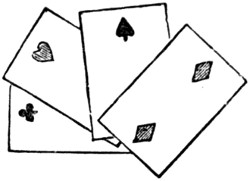
Fig. 3
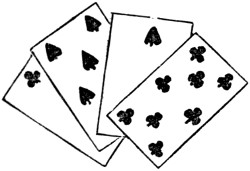
Fig. 4
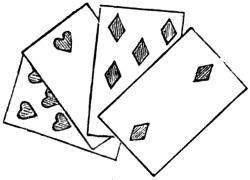
Fig. 5
Cut very neatly the spots from a three of spades. Lay the pierced card on an ace of diamonds, and rub pomatum on the ace of diamonds through the places which the spades occupied. Remove the pierced card, and sprinkle the ace of diamonds with jet powder, which adhering to the pomatum, will transform the card into a three of spades.
Place the transformed card at the bottom of the pack, and show a[674] person what card it is. Make him declare it that every one may hear, then place it on the table, face downwards, and push it over the cloth to the spectator, which action will rub off all the jet powder. Tell him to place his hand on the card. Let a three of spades be at the top of the pack, and an ace of diamonds the second from the bottom. Show another person the ace of diamonds, and ask him to tell the name of the card openly. Put the pack down, face downwards, And in so doing, make the pass, and bring the three of spades to the bottom.
Tap the hand of the person who is guarding the card, and then tell him to take up the card and show it to the spectators, when it will be seen to be the ace of diamonds. Simultaneously, you take up the pack, and show the three of spades at the bottom.
The meaning of the word “Cryptography” is, as is well known, “hidden or secret writings,” and was used in ancient times, when conspiracies were common, and murders an every-day occurrence, as the means of communicating from one person to another in such a manner that it could not be read by any one save those who were admitted into the secret of its construction.
A widespread conspiracy, or, as it would be more properly termed, rebellion, could not be carried on between persons at a distance from each other unless they resorted to cryptography; in fact, the means of correspondence was in those times of so slow and dangerous a nature, that without the utmost care and secrecy in the arrangement of the cipher it would certainly have been discovered, and then death would be the consequence.
In order to mature their designs in safety, and to throw off all suspicion, men were obliged to put their wits to work and invent some way of informing each other of everything that did transpire, so that no one else should be the wiser for it: thus was cryptography discovered; and wonderful cunning and ingenuity were displayed in its construction, as will be seen by the examples that are given.
It was also used in former times in transacting affairs of state, in communicating messages from one general to another in time of war, and in many other ways of a more innocent nature, too numerous to mention.
Now, at the present time, when all is peace and prosperity, and news is brought to our very doors by post and telegraph, cryptography is only interesting as a curious study, or to amuse ourselves in an idle hour by finding out its hidden mysteries.
The first and most common form of cryptograph we read of was by the transposition of letters, and is, as we may see, capable of great[675] improvement; indeed, it is the basis on which most of the letter ciphers are formed at the present day.
We give the following as an example:—
| For— | a | b | c | d | e | f | g | h | i | j | k | l | m | n | o | p | q | r | s | t | u | v | w | x | y | z. |
| Use— | d | e | f | g | h | i | j | k | l | m | n | o | p | q | r | s | t | u | v | w | x | y | z | a | b | c. |
The sentence, “We meet to-night,” in this cipher would become, “Zh phhw wr-qljkw.”
The next is formed on the principle of the above, but is rather more intricate: for instance, if we wanted to inform some one that, “All going on well, send supplies as soon as possible,” we should put it down in the following order:—
| a | g | s | p | s | o |
| l | o | e | l | o | s |
| l | n | n | i | o | s |
| g | w | d | e | n | i |
| o | e | s | s | a | b |
| i | l | u | a | s | l |
| n | l | p | s | p | e |
You must read it down the first perpendicular column, then down the second, and so on. You must then form the letters in the horizontal columns into imaginary words, and place them down on paper as you would a common sentence, thus:—“Ag spso loelos lnn iosgwden ioes sab iluas lnlp spe.”
You must arrange with your correspondent beforehand that the width of the horizontal column should consist of six letters (or more, if you like); so by placing the letters six in a line, one under the other, without regard to words, the puzzle is easy to solve.
Another good cipher is by using the figures 1 and 2 differently arranged for every letter in the alphabet, as will be seen by the following key:—
| a | b | c | d | e | f | g | h | i |
| 11111 | 11112 | 11121 | 11122 | 11211 | 11212 | 11221 | 11222 | 12111 |
| j | k | l | m | n | o | p | q | r |
| 12112 | 12122 | 12211 | 12212 | 12221 | 12222 | 21111 | 21112 | 21121 |
| s | t | u | v | w | x | y | z | |
| 21122 | 21211 | 21212 | 21221 | 22222 | 22212 | 22221 | 22122 |
Now if we wanted to write the words “Come now,” we should do it in this way, knowing that there are five figures to every letter, and when a word is formed there is a comma:—
11121122221221211211, 122211222222222.
The next was a favourite of that unfortunate king, Charles I.:—
| a | b | c | d | e | f | g | h | i & j | k |
| l | m | n | o | p | q | r | s | t | u & v |
 |
 |
 |
 |
||||||
| w | x | y | z | ||||||
The next is rather good and somewhat difficult:—
Divide a piece of cardboard into twenty-six departments, and in each place a letter; then take another piece (small enough that the letters on the first piece can be seen), and fit it into the centre of the first, dividing this into the same number of departments; then put a piece of thread through the centre of both, so that you can turn the smallest card round, filling the spaces up with letters in any way you like. Thus:
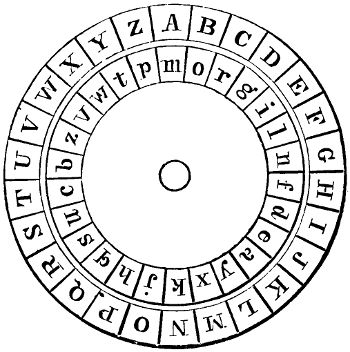
In using the dial, turn it round until, say, the letter m in the middle card comes under the letter A in the outer circle; next take what you want to write, and find it letter by letter in the outer circle, putting down on paper what appears directly under it in the inner circle.
Now if you want to write “I shall come soon,” first write the letters A m, so as to enable your correspondent to fix his dial like your own, as the A is in the outer circle and the m under it in the inner—“Am d ufmyy rjxi ujjk.”
You may arrange your dial in any way you like, but must be sure to place what letter is under the A at the beginning of your cipher.
The next is something like the last:—

Now if you want to tell some one that “They are all coming over,” you must write it down and place the figures 5, 4, 3 over every letter in succession. Thus:—
| 5 | 4 | 3 | 5 | 4 | 3 | 5 | 4 | 3 | 5 | 4 | 3 | 5 | 4 | 3 | 5 | 4 | 3 | 5 | 4. | ||||
| T | h | e | y | a | r | e | a | l | l | c | o | m | i | n | g | o | v | e | r. |
Then look for the letter T in the dial; the figure 5 being over it, you must look for the fifth letter from it, which is O: put it down, and go on to the next letter in the message, H; find H in the circle, and as 4 is over it, put down the fourth letter from it, D: for E, with the 3 over it, we must write down the third letter from E; and for the next letter, Y, 5 being over it, the fifth letter; and so on, always counting in the direction of the arrows. The cipher will run eventually: “Odbt woz wig ylhekb kszn.”
The way to read this cipher is to put 543 down the same as before, and to count them on the circle in the opposite way to which the arrows are pointing.
The most famous and complex cipher perhaps ever written was by Lord Bacon. It was arranged in the following manner:—
| aaaaa | stands for | a |
| aaaab | „ | b |
| aaaba | „ | c |
| aaabb | „ | d |
| aabaa | „ | e |
| aabab | „ | f |
| aabba | „ | g |
| aabbb | „ | h |
| abaaa | „ | i & j |
| abaab | „ | k |
| ababa | „ | l |
| ababb | „ | m |
| abbaa | „ | n |
| abbab | „ | o |
| abbba | „ | p |
| abbbb | „ | q |
| baaaa | „ | r |
| baaab | „ | s |
| baaba | „ | t |
| baabb | „ | u & v |
| babaa | „ | w |
| babab | „ | x |
| babba | „ | y |
| babbb | „ | z |
Now, suppose you want to inform some one that “All is well;” first place down the letters separately according to the above alphabet—
aaaaa ababa ababa abaaa baaab babaa aabaa ababa ababa.
Then take a sentence five times the length in letters of “All is well,”—say it is, “We were sorry to have heard that you have been so unwell.”
Then fit this sentence to the cipher shown above, like this—
| a | a | a | a | a | a | b | a | b | a | a | b | a | b | a | a | b | a | a | a | b | a | a | a | b | b | a | b | a |
| W | e | w | e | r | e | s | o | r | r | y | t | o | h | a | v | e | h | e | a | r | d | t | h | a | t | y | o | u |
| a | a | a | b | a | a | a | b | a | b | a | a | b | a | b | a. | |||||||||||||
| h | a | v | e | b | e | e | n | s | o | u | n | w | e | l | l. | |||||||||||||
Marking with a dash every letter that comes under a B. Then put the sentence down on your paper, printing all marked letters in italics, and the others in the ordinary way, thus—
“We were sorry to have heard that you have been so unwell.”
The person who receives the cipher puts it down and writes an A under every letter except those in italics; these he puts a B under; he then divides the cipher obtained into periods of five letters, looks at his alphabet, and finds the meaning to be, “All is well.”
Here is a specimen of a music cryptograph:—

The next is good, but rather lengthy:—
| a | b | c | d | e | f | g | h |
| . : . . . | : . . . : | . : : . . | . . . : . | . . . . : | . : . : : | . . : . . | : . . . . |
| i | j | k | l | m | n | o | p |
| : : . . . | . . : : . | . : . : . | : . : . . | . . . : : | . . : . : | : : : . . | . : : : . |
| q | r | s | t | u | v | w | x |
| : : : : : | : : . : : | : . : . : | : : . . : | : . : : . | : : : : . | . : : : : | : : : . : |
| y | z | ||||||
| : . : : : | . : : . : | ||||||
Here is the key of another:—
| 1 | 2 | 3 | 4 | 5 |
| a | b | e | d | e—1 |
| f | g | h | i | k—2 |
| l | m | n | o | p—3 |
| q | r | s | t | u—4 |
| v | w | x | y | z—5 |
In picking out the letter you want, you must see under what number it stands, then see what number is at the end of the line, then put those two figures together, and they will represent the letter: thus, 15 represents V; 23, M; 43, O; and 55, Z.
The sentence, “We meet to-night,” would be—2551, 23515144, 4443, 3342223244.
The next is a very difficult and complex cryptograph to decipher.
Draw a table of four columns, like the figure below. In the first column place the six different arrangements of the figures 1, 2, 3, and number the other columns 1st, 2d, and 3d respectively:—
| 1st. | 2d. | 3d. | ||||||||||
|---|---|---|---|---|---|---|---|---|---|---|---|---|
| 123 | t | y | c | n | h | r | e | m | e | a | o | i |
| 132 | b | e | f | s | y | h | i | s | g | t | r | t |
| 213 | e | r | e | e | t | m | x | w | a | e | n | t |
| 231 | e | r | m | c | k | m | a | r | a | h | h | y |
| 321 | l | m | r | t | i | c | i | h | l | o | e | g |
You must agree with your correspondent how many letters wide each of the three columns shall be—we will say four. Then take your sentence—say it is, “They are coming by the first steamer next week from America; we hope they will come right.[680]” You must then place every letter down separately, writing the figures in the first column in succession over them, thus—
| 1 | 2 | 3 | 1 | 3 | 2 | 2 | 1 | 3 | 2 | 3 | 1 | 3 | 1 | 2 | 3 | 2 | 1 | 1 | 2 | 3 | 1 | 3 | 2 | 2 | 1 | 3 | 2 | ||
| T | h | e | y | a | r | e | c | o | m | i | n | g | b | y | t | h | e | f | i | r | s | t | s | t | e | a | m | ||
| 3 | 1 | 3 | 1 | 2 | 3 | 2 | 1 | 1 | 2 | 3 | 1 | 3 | 2 | 2 | 1 | 3 | 2 | 3 | 1 | 3 | 1 | 2 | 3 | 2 | 1 | 1 | 2 | 3 | 1 |
| e | r | n | e | x | t | w | e | e | k | f | r | o | m | A | m | e | r | i | c | a | w | e | h | o | p | e | t | h | e |
| 3 | 2 | 2 | 1 | 3 | 2 | 3 | 1 | 3 | 1 | 2 | 3 | 2 | 1. | ||||||||||||||||
| y | w | i | l | l | c | o | m | e | r | i | g | h | t. | ||||||||||||||||
Over the first letter, “t,” stands “1,” therefore write “t” in the column marked first; over “h” is “2,” therefore write “h” in the second column; over “e” is “3,” then put “e” in the third column, and so on; but when four letters are written abreast you must begin a new line.
After doing the above, you must take the letters in each column separately (beginning with the first), and form them into imaginary words, putting a dot under the last letter of each column to show your correspondent that the column ends there; thus—
Tycnb efse ree ermc w pee lmrt hrem yhistmx wk mar eot wi
ciheaoi gtrtae ntfoei ah hyl oegg.
Tycnb efse ree ermc w pee lmr• hrem yhistmx wk mar eot wi
ci•eaoi gtrtae ntfoei ah hyl oeg•
The person receiving the message knows the width of the column (four letters), the arrangement of the figures 1, 2, 3, and the use of the dots, and reconstructs his table directly; he then puts the letters in order by a backward process to the one we have gone through, and reads the message.
The next is a cipher of a different kind:—
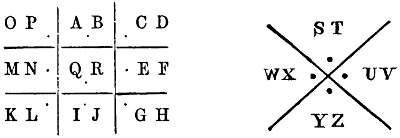
The dots stand for the last letter in each square: thus O would be , and P the same with a dot put in the middle, thus • . A and B •
The sentence, “Routledge’s Magazine for Boys,” would be

In finding out the meaning of a cryptograph, you must first settle in your mind to what class of cipher it belongs, whether it is written by means of letters, figures, or signs; having done so, you must go to work with patience, and try to find out, by means of perseverance and study, what each figure, sign, or letter represents; as even the above specimens of cryptography can be so altered and improved upon, yet continuing in their original form to some extent, that it would be impossible to give positive rules to enable any one to decipher any kind of cryptograph; in fact, it can only be done by those who have made it their study for years, and consequently have had great experience in the matter.
Most of the examples given will only enable one to decipher the most simple kinds, such as are generally found in magazines, &c.; for if that intricate cipher of Lord Bacon’s were put in a book for boys, it would be a waste of paper, as we will venture to say that not one in a thousand would be able to find it out.
There is another class of cryptographs which we have not yet noticed, and which are done by means of sympathetic inks, a list of which will consequently be interesting.
Inks which appear when heated, and become invisible when cooled:—
Solution of nitro-muriate of cobalt; when heated turns green.
Solution of acetate of cobalt, with a little nitre; rose-colour when
warm.
Inks which remain visible when heated, but do not disappear when
cooled:—
Onion-juice, yellow; equal parts of copper and sal-ammoniac in
water, yellow; aquafortis, spirits of salt, oil of vitriol, and salt and
water, yellow or brown.
Inks which appear when exposed to light:—
Diluted solution of nitrate of silver.
Diluted solution of terchloride of gold.
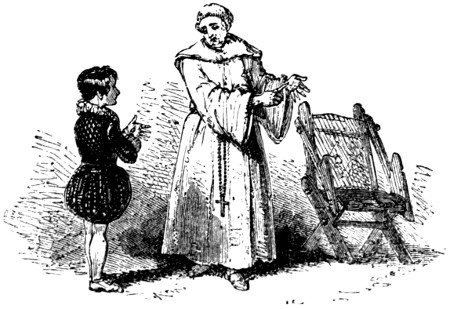
PETER POUNCE, THE FIRST TEACHER OF THE DEAF AND DUMB, INSTRUCTING A BOY.
Amongst the many useful inventions which have been planned for the solace of individuals deprived of some portion of their senses, the art by which deaf and dumb persons are taught to express their own thoughts, and to comprehend those of others, is one of the most noble. The earliest attempt at a method of teaching the deaf and dumb was made in Spain, towards the end of the sixteenth century, by a Benedictine monk named Peter Pounce; and without doubt he must have formed his idea from observing the natural propensity of the dumb to supply the want of the organs of speech by making signs. After the essay of Peter Pounce many successful trials were made, and in 1692 John Conrad Amman, a Swiss physician, reduced the plans to a fixed method, or art, and published the scheme of it at Amstelod. The first asylum for the deaf and dumb in London was founded in the year 1792.
 |
 |
 |
| A | B | C |
A is expressed by touching the top of the thumb of the left hand with the forefinger of the right.
B. Join the forefinger and thumb of each hand, and place the backs of the forefinger nails together.
C. Bend the fingers and thumb of the left hand, so as to form three parts of a circle.
 |
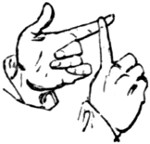 |
 |
 |
| D | E | F | G |
D. Bend the fingers and thumb of the right hand into a semicircle, and then join them to the forefinger of the left, which keep in a straight line.
E. Touch the top of the forefinger of the left hand with the forefinger of the right.
F. Place the forefinger of the right hand across the backs of the first and second fingers of the left.
G. Clench both hands, and put one fist upon the other.
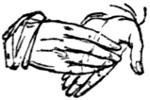 |
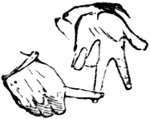 |
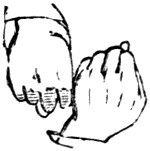 |
| H | I | J |
H. Pass the palm of the right hand across that of the left, sweeping it along to the tips of the fingers, as if brushing something off.
I. Touch the top of the second finger of the left hand with the forefinger of the right.
J. Clench the hands together, as directed for the letter G.
 |
 |
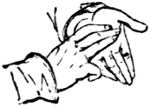 |
| K | L | M |
K. Form a semicircle with the thumb and forefinger of the right hand, and join it to the forefinger of the left, which must be kept straight out; both forefingers must meet at the second joints.
L. Place the forefinger of the right hand across the centre of the palm of the left, so that the top of the finger may be exactly in the middle of the palm.
M. Place three fingers of the right hand flat upon the palm of the left.
N. Place two fingers of the right hand flat upon the palm of the left.
O. Touch the top of the third finger of the left hand with the forefinger of the right.
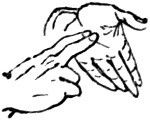 |
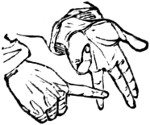 |
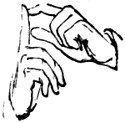 |
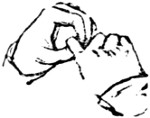 |
| N | O | P | Q |
P. Place the tips of the forefinger and thumb of the left hand in a semicircular form against the first and second joints of the forefinger of the right, which should be kept straight.
Q. Form a circle with the forefinger and thumb of the left hand, and then curve the forefinger of the right into the shape of a hook, and place it exactly where the other fingers join.
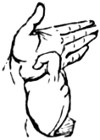 |
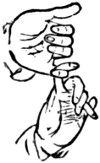 |
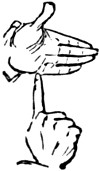 |
| R | S | T |
R. Bend the forefinger of the right hand and rest it on the palm of the left.
S. Bend the little finger of each hand and lock them together.
T. Fix the tip of the forefinger of the right hand against the middle of the lower edge of the left.
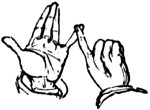 |
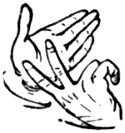 |
 |
| U | V | W |
 |
 |
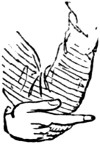 |
| X | Y | Z |
U. Touch the top of the little finger of the left hand with the forefinger of the right.
V. Place the first and second fingers of the right hand, apart, upon the palm of the left.
W. Lock the fingers of one hand between those of the other.
X. Cross the forefingers at the second joints.
Y. Extend the thumb and forefinger of the left hand, and at the lower part of the fork so made place the forefinger of the right hand.
Z. Elevate one hand towards the face, and rest the elbow upon the palm of the other.
The end of every sentence is indicated by snapping the second finger and thumb of the right hand. This result is requisite to avoid the confusion which might result from running the sentences into each other.
Are denoted by holding up one finger to signify 1, two fingers for 2, the open hand for 5, both hands for 10, and so on.
There was a time when dominoes was a much more favourite game than at present. In many old houses beautifully finished sets of dominoes are yet kept, a memento of the favour in which the game was once, and still deserves to be, held. For boys it is second to none, as it improves their power of calculation, exercises their judgment, and leads them to acquire a habit of estimating chances in connexion with numbers, which is exceedingly useful in after-life.
The ordinary game of dominoes is played with twenty-eight pieces, which include every combination of numbers, from double-blank to double-6; but boxes of dominoes are not uncommon which have fifty-two pieces, or even eighty-five pieces, one including double-9’s, and the latter double-12’s. These are more used in the north than the south. The dominoes are usually made of oblong pieces of ivory, frequently cemented to an ebony back; whilst on the front they are divided into two parts by a fine line across the middle, and marked with round black spots. These are 1 and 1, 1 and 2, and so on to 6; then 2 and blank, 2 and 1, and so on. Where a set of dominoes is not handy, a pack of what printers call third-large cards may be made available, if they are marked with a pen, and the backs kept perfectly clean. These may be shuffled and dealt in a similar manner to playing cards; but the dominoes must be placed face downwards on the table and “shuffled” by being well mixed together.
The turn to commence is called “the pose,” and is the same in all games of dominoes. After the players have drawn from the bulk the number of dominoes each requires, double-6 is called for, and he[686] who has it plays first. If it is not in hand, then the highest double plays; if no doubles are out, then the call is from the highest domino to the lowest, as 6—5, 6—4, and so on.
Is played in two modes. The first is called the French game. After the dominoes are well shuffled, each player (usually two) draws from the bulk the number of dominoes agreed upon. Seven is the common number, and this leaves fourteen dominoes on the table. The dominoes are either held in the hand, or set on their sides on the table, so that the pips are visible to the player only. In the north of England a small tin, angular frame is used to hold the dominoes. The player holding the highest double then plays first, and then each plays in turn by placing a domino of the same number of pips to the domino played at either end when you both have played. If your opponent cannot do this it is called “a go,” and you can then play for him, until he can play. If you can play to both ends, do not do so until you have exhausted your hand at one end, and be sure to get out your doubles at the earliest opportunity, unless by so doing you close both ends against yourself. By pursuing this plan you can, when pressed, play at the ends closed against your adversary the domino you have reserved for that purpose. When you have played all your dominoes out, you win the game; or when neither can play, he that has the lowest number of pips, not pieces, wins the game. It is best, however, to play a definite number up, such as 30, 50, or 100. In these cases the game is better played by the
Second mode, which is commenced in the same manner; but when you play a double, and it is your turn, you can play it out and still keep your turn. When your adversary cannot play, you play for him, and for yourself too, before he can play again. The game is counted thus:—When one has played all his dominoes out, he counts the number of pips in his adversary’s hand, and scores them in his favour; if neither can play, the one who has the fewest left counts the other’s numbers, and subtracts the number of his own, and scores the balance in his own favour. Formerly the whole number was scored, but this is dispiriting to the loser. In this game it is better to try to play so that neither can go on again than to play out all the dominoes. By a little practice it will be seen that heavy dominoes do not always lose, or light ones win. In playing these and any game at dominoes it should be understood that a domino once played should not be recalled, as it frequently destroys all interest in the game. Sometimes it is understood that if the domino is not placed on the table you may recall it; but it is better to play it at once, as a skilful player can easily calculate the chances in his favour.
There are two or three variations on the first method. In one the winner of the game scores all the points left in his own hand (if any), as well as those in his opponent’s. Another method is, when[687] one player cannot go, the other is not bound to proceed, even if able, but can at once shut the game and count, if he likes to do so. Another variation is to permit the second player, if he chooses, to take all the dominoes but two left on the board. If he does not choose, the next player may draw as many as he chooses (always excepting two); and if one cannot play, he must draw until he can do so. The pose in this game is alternate, or is taken by the winner.
Is a game played by four persons, two against two, each player taking five dominoes. It may, however, be played by two persons only, when seven dominoes are given to each, and none are afterwards added. The score seldom exceeds 31, or any smaller number, and is marked on a cribbage-board. The object of this game is to play so that the two ends of the dominoes, after you have played, are a multiple of five. Thus the first player endeavours to make a point by putting down a 5 and blank, 4 and 1, 3 and 2, each of which counts 5: if he has the double-5 it counts 2. The other players follow on in the same way, endeavouring to make 5, 10, 15, or 20, for which they score 1, 2, 3, or 4 respectively. This game requires great caution, so as to prevent your opponent from scoring, if you cannot do so yourself. 20 is the largest number that can be made: thus, if there is a 4 at one end and a 6 at the other end, the next player, having the double-6, plays it to the 6, and the following player, having the double-4, plays it to the 4; doubles in this, as in all other games of dominoes, being laid across, there are 12 at one end and 8 at the other, making 20, or four fives. When one hand is played out, or neither can go, the lowest number counts one towards game. This is peculiarly a game of stratagems, and when one holds the double-5, he generally tries to keep it until there is a 5 at each end, when he plays it and scores 3, and generally, in that case, 1 for game as well.
Is on an entirely different principle. You do not fit the same numbers together, as in other games at dominoes, but you must add a number which, when joined to one already there, makes seven. The double-blank, the 4—3, 6—1, and 5—2, are termed matadores, and can be played at any stage, and either end turned outward at will, for your opponent to play to. Three dominoes only are taken at the outset, and if one of the players cannot “go,” he must draw until he can do so, unless the number of dominoes left on the board is reduced to two. The game is played 30, 50, or 100 up, and the winner counts to his score his opponent’s pips.
Is a capital game for boys, and exercises the players in the four rules of arithmetic. It is played similarly to the All Fives, only 3 is the[688] multiple instead of 5: thus, 3, 6, 9, 12, 15, and 18 points count 1, 2, 3, 4, 5, and 6, respectively.
Is a good round game. Any number can play, so long as there are two or more dominoes left on the board, after three dominoes each have been taken. The pose is settled as before; but the leader has the privilege of playing to his double, if he can do so, and any person having a double in his turn can play to it, if he can. The game runs round, and the first person who plays out pronounces himself “Tidley-Wink,” and is the winner.
When four persons are playing, this will be found one of the most amusing of games. It is sometimes called “Sebastopol.” All the dominoes are divided equally amongst the players. The double-6 is played first, and then every person must play a 6 to the double, and thus form a cross. The person who has not a 6 loses his turn. The play then proceeds in the usual way, only that the player can choose which corner he likes to play at. The result is a curious irregular figure resembling the ground-plan of a fortress, with bastions, &c.; hence its name.
Is also played by four persons, seven dominoes being given to each. The persons in this case are partners, and sit opposite to each other. This game is led off as all others, but requires considerable powers of memory to play it properly, for it is necessary to remember not only the numbers played, but who played it, and under what circumstances, so as to help your partner’s hand and checkmate your opponent’s. Several other games of dominoes may be played; but the foregoing, with their numberless variations, will enable any one to master the principles of any other introduced.
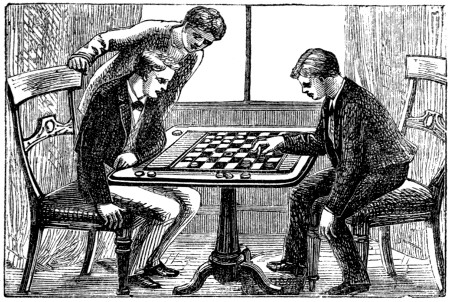
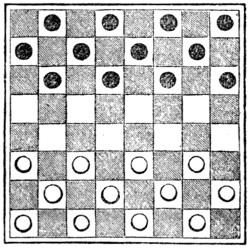
Draughts is a modern invention, and is a good preliminary to chess. It is not so intricate a game, for the pieces are of equal value till they become kings, and can only move one way; but like chess, success depends entirely upon skill, and one false move frequently occasions the loss of the game. Draughts seems to have come into vogue in Europe about the middle of the fourteenth century, and for a long time there were two methods of playing it; the one commonly used in England being the French game, which is played upon a chess-board, and the other the Polish game, which requires a board with ten squares or chequers in each row, and twenty men. The men in the Polish game can only move forwards as they do in the French game, but they have the privilege of taking backwards and forwards, and the king, when made, if not opposed by two men close together, can move from one corner of the board to the other[690] The Polish game admits of most variety, and is in our opinion infinitely the best, but it is little played in this country, except by foreigners, many of whom during the Great Exhibition year proved themselves adepts at the game.
The draughtboard consists of sixty-four squares, black and white, and there are twelve men, or pieces, of a white colour, and twelve of a black colour to be used. The board should be placed with an upper white corner towards the right hand. The players select each twelve men of the colour they prefer. The pieces, or men, are to be thus placed on the board: the black pieces on the first twelve white squares, and the white on the last twelve white squares. When they are thus placed the game begins.
The pieces move forward diagonally, and it is the object of the players to take all each other’s men; the player who has the black pieces taking the white, and the player who has the white men taking the black. The first player—say Black—moves his piece angularly to the first white square, and then, if nothing intervenes between his piece and that of his opponent, and there is a vacant square in his line left behind him, the white can pass his piece over him to the space so unoccupied, and take his man, which is withdrawn from the board. The same may be repeated by the adversary; and thus the players go on taking each other’s pieces till one or the other cannot move, or all the pieces are taken. When a piece, however, arrives at the last row of the enemy’s ground, it becomes what is called a king, and is crowned by another piece being placed on it. It may then be moved backwards and forwards at pleasure, and can take both ways. When a player neglects to take a piece, he is what is called huffed, that is, he loses the piece that ought to have been moved.
1. The moves are alternate, the first move being determined by lot.
2. The choice of men to be also decided by lot, but they should be changed every three games.
3. Whichever piece is touched must be played.
4. No player can remain more than five minutes without playing. He may be warned at the end of five minutes.
5. Neither player must leave the room without permission of his adversary.
6. In case of huff, the opponent, in lieu of taking a piece for the omission, can insist on his being taken.
7. Each party must sit free so as not to obstruct a view of the board, and no pointing at pieces is allowed.
8. When a false move is made, the piece must be moved to whatever square the opponent dictates.
9. All disputes between players to be referred to a third party.
10. Bystanders must make no remarks during the game.
Playing draughts is a game which is best learned by experience and repeated defeats. It requires circumspection and caution, and especially demands calculation of the effects of the different moves upon the fortune of the game. The moves should be calculated mentally. The men should be kept as much in the centre of the board as possible; and the gentlemanly player will consider all drawn games as won by his opponent, and never triumph over the vanquished. The following games will give the young player a good general idea of draughts, but his success as a player will depend entirely upon his own application and habit of thought:—
| No. | Colour. | from | to |
|---|---|---|---|
| 1. | B. | 11 | 15 |
| 2. | W. | 22 | 18 |
| 3. | B. | 15 | 22 |
| 4. | W. | 25 | 18 |
| 5. | B. | 8 | 11 |
| 6. | W. | 29 | 25 |
| 7. | B. | 4 | 8 |
| 8. | W. | 25 | 22 |
| 9. | B. | 12 | 16 |
| 10. | W. | 24 | 20 |
| 11. | B. | 10 | 15 |
| 12. | W. | 27 | 24 |
| 13. | B. | 16 | 19 |
| 14. | W. | 23 | 16 |
| 15. | B. | 15 | 19 |
| 16. | W. | 24 | 15 |
| 17. | B. | 9 | 14 |
| 18. | W. | 18 | 9 |
| 19. | B. | 11 | 25 |
| 20. | W. | 32 | 27 |
| 21. | B. | 5 | 14 |
| 22. | W. | 27 | 23 |
| 23. | B. | 6 | 10 |
| 24. | W. | 16 | 12 |
| 25. | B. | 8 | 11 |
| 26. | W. | 28 | 24 |
| 27. | B. | 25 | 29 |
| 28. | W. | 30 | 25 |
| 29. | B. | 29 | 22 |
| 30. | W. | 26 | 17 |
| 31. | B. | 11 | 15 |
| 32. | W. | 20 | 16 |
| 33. | B. | 15 | 18 |
| 34. | W. | 24 | 20 |
| 35. | B. | 18 | 27 |
| 36. | W. | 31 | 24 |
| 37. | B. | 14 | 18 |
| 38. | W. | 16 | 11 |
| 39. | B. | 7 | 16 |
| 40. | W. | 20 | 11 |
| 41. | B. | 18 | 23 |
| 42. | W. | 11 | 8 |
| 43. | B. | 23 | 27 |
| 44. | W. | 8 | 4 |
| 45. | B. | 27 | 31 |
| 46. | W. | 4 | 8 |
| 47. | B. | 31 | 27 |
| 48. | W. | 24 | 20 |
| 49. | B. | 27 | 23 |
| 50. | W. | 8 | 11 |
| 51. | B. | 23 | 18 |
| 52. | W. | 11 | 8 |
| 53. | B. | 18 | 15 |
| &c. | |||
| White loses. | |||
| No. | Colour. | from | to |
|---|---|---|---|
| 1. | B. | 11 | 15 |
| 2. | W. | 22 | 18 |
| 3. | B. | 15 | 22 |
| 4. | W. | 25 | 18 |
| 5. | B. | 8 | 11 |
| 6. | W. | 29 | 25 |
| 7. | B. | 4 | 8 |
| 8. | W. | 25 | 22 |
| 9. | B. | 12 | 16 |
| 10. | W. | 24 | 20 |
| 11. | B. | 10 | 15 |
| 12. | W. | 21 | 17 |
| 13. | B. | 7 | 10 |
| 14. | W. | 27 | 24 |
| 15. | B. | 8 | 12 |
| 16. | W. | 17 | 13 |
| 17. | B. | 9 | 14 |
| 18. | W. | 18 | 9 |
| 19. | B. | 5 | 14 |
| 20. | W. | 24 | 19 |
| 21. | B. | 15 | 24 |
| 22. | W. | 28 | 19 |
| 23. | B. | 14 | 17 |
| 24. | W. | 32 | 27 |
| 25. | B. | 10 | 14 |
| 26. | W. | 27 | 24 |
| 27. | B. | 3 | 7 |
| 28. | W. | 30 | 25 |
| 29. | B. | 6 | 9 |
| 30. | W. | 13 | 6 |
| 31. | B. | 1 | 10 |
| 32. | W. | 22 | 13 |
| 33. | B. | 14 | 18 |
| 34. | W. | 23 | 14 |
| 35. | B. | 16 | 30 |
| 36. | W. | 25 | 21 |
| 37. | B. | 10 | 17 |
| 38. | W. | 21 | 14 |
| 39. | B. | 30 | 25 |
| 40. | W. | 14 | 9 |
| 41. | B. | 11 | 15 |
| 42. | W. | 9 | 6 |
| 43. | B. | 2 | 9 |
| 44. | W. | 13 | 6 |
| 45. | B. | 15 | 18 |
| 46. | W. | 6 | 2 |
| 47. | B. | 7 | 10 |
| 48. | W. | 2 | 6 |
| 49. | B. | 10 | 14 |
| 50. | W. | 6 | 9 |
| 51. | B. | 25 | 21 |
| 52. | W. | 31 | 26 |
| 53. | B. | 14 | 17 |
| &c. | |||
| Drawn. | |||
Our book is intended for the gratification of boys. We know full well the intense delight taken by boys in risking their limbs or their lives, especially when such risk is accompanied with noise. Boys always have done so, and always will do so in spite of the very best of advice or precautions. As, therefore, it is impossible to keep them from making noises and endangering themselves, we have in the following pages endeavoured to show them how to make as much noise as possible with as little danger as possible.
What is there that makes the most noise and is most dangerous? Gunpowder, of course. Therefore, we have given descriptions of the best methods of employing this material, feeling quite sure that of accidents with gunpowder nine out of every ten are caused by ignorance. We knew a boy who lost the use of a thumb, and took all the skin off the palm of his right hand, by ignorant management of powder. He had read of blasting rocks, and nothing would satisfy him but blasting a bank. So he bored a deep hole in it with a stick, filled the hole with gunpowder, and then poked a lighted lucifer into the powder. The consequence was, that his face was so scorched as not to be recognised, all his eyebrows and eyelashes and most of his hair were burned off, while his right hand was injured as has been already mentioned. Now that boy had been studiously kept out of the way of powder by female relatives, and was naturally profoundly ignorant of its effects. Had he been taught to handle it, he would not now be forced to keep his right hand closed, or to write by holding the pen between the fingers of his clenched hand.
It will not be very advisable for the firework boy to make his own powder, but still it will not be amiss that he should know how it is prepared. Pulverise separately 5 drams of nitrate of potass, 1 dram of sulphur, and 1 dram of newly burnt charcoal, mix them together in a mortar with a little water, so as to make the compound into a dough, which roll out into round pieces of the thickness of a pin upon a slab. This must be done by moving a board backwards and forwards until the dough is of a proper size. When three or four of these pieces are ready put them together thus,—

and cut them off into small grains. Place these grains on a sheet of paper in a warm place where they will soon dry, but away from a fire. During granulation the dough must be prevented from sticking by using a little of the dry compound powder. This mode of granulation, though tedious, is the only one to be used for so small a quantity for the sake of experiment. In making powder in a large way it is granulated by passing the composition through sieves.
Dissolve in a little spirits of wine or vinegar a little saltpetre, then take some purple or blue paper, and wet it with the above liquor and it will be fit for use. When pasting paper on any of the following works take care that the paste does not touch that part which is to burn. The method of using this paper is to cut it into slips long enough to go once round the mouth of a serpent, cracker, &c.
Procure a hard wooden cylinder, or, if possible, one made of metal, whose diameter corresponds with that of the interior of the proposed case. Roll round it several folds of cartridge paper, and paste the edges well, so that it may be held securely. Tie it round until dry.
When the cases are thus made they will require to be tied at the lower end. This is called choking them, and as much force is required it is necessary. Fix a wire into a small solid cylinder (d). Take another short piece (b) an inch or two long, with a hole up it to admit the other end of the wire, fit it on and pass it up the case. Then having fastened a piece of whipcord to a post, wind it round the part left hollow by the wire, which should be about half an inch from the end; pull it tight with the right hand and work the case round with the left. Cut out a piece of touch paper two inches long and an inch and a half broad, wind it round the choke, and tie it on with a piece of fine string—twist it to a point. The cases are best choked while damp.
Gunpowder half a pound, charcoal 1 ounce, brimstone 1 ounce, or in like proportion; grind them in a muller or pound them in a mortar. Or you may take 1 part steel filings, 1 charcoal, 1 sulphur, and 4 powder, which is a very good mixture, and can be rubbed together in a mortar.
Your cases must be very dry when ready, and should be put into an iron or wooden mould; first put in a thimble full of your powder, and ram it down very hard with your ruler, then put in a little more till the case is full, ramming it down hard every time. If you have no mould, hold the case in your left hand with the twisted touch-paper downwards, and fill it after the same manner. When you have filled within an inch of the top, fill up this with loose powder not rammed, for a bang, and fold in the ends; after filling a dozen or two melt some pitch in a small ladle, and smear the ends of the case with it by means of a small brush.
Cut some stout cartridge-paper into pieces three inches and a half broad and one foot long, fold down one edge of these pieces lengthwise about three quarters of an inch broad, then fold the double edge down a quarter of an inch, and turn the single edge back half over the double fold. Open it, and lay all along the channel which is formed by the folding of the paper some meal powder, then fold it over and over till the paper is doubled up, rubbing it down at every turn; this being done bend it backwards and forwards two inches and a half, or thereabouts, at a time, as often as the paper will allow. Hold all these folds flat and close, and with a small pinching cord give one turn round the middle of the cracker and pinch it close; bind it with packthread as tight as you can, then in the place where it was pinched prime one end and cap it with touch-paper.
When these crackers are fired they will give a loud report at every turn of the paper; if you want a great number of these, you have only to cut the paper longer, or join it on to a greater length; but if they are made very long you must have a piece of wood with a groove in it deep enough to let in half the cracker, which will hold it straight while you are pinching it.
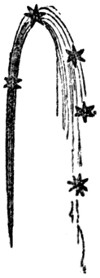
These are best made with the following ingredients: 1 ounce of powder, 1 ounce of sulphur, and 2 ounces of nitre. Some persons, however, prefer 1 part sulphur, 1 charcoal, 1 iron filings, 4 of powder, and 8 of nitre. The composition being made, in filling the cases fill the contrary way to a squib—stop up the choke by driving down a piece of paper. Put in 1 quill of gunpowder loose and 1 star made in the following manner: 1 ounce of camphor, 1 of sulphur, 2 of meal powder, 1 ounce of the coloured fires, moisten them with oil of turpentine, and work them into little round balls. Having placed a star within the case, put in above it 3 quills of the composition, ram down, then powder, star, and composition[696] alternately, till the case is full. Paste touch-paper round the top and twist to a point.
There are several recipes for making rockets, the best of which is 3 ounces of charcoal, 6 of sulphur, 8 of nitre, 32 of meal powder. Another very good one is, 3 ounces of iron filings, 4 of powdered charcoal, 8 of sulphur, 16 of nitre, and 64 of meal powder. If a smaller quantity is wanted divide each proportion by 2, if a still smaller divide by 4. In this cut s is the loose gunpowder with eight or ten stars upon it; c is that part of the rocket in which the composition is to be rammed hard, p the priming or quick match, t the touch paper. The cases are to be put into a mould and the composition must be well rammed. The cases should be four times the thickness of those for squibs.
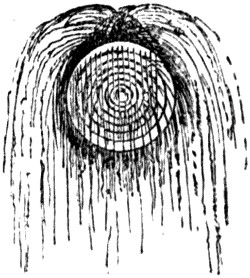
Sometimes gold or silver rains are added to rockets, which give them a very beautiful appearance. A gold rain is made of 2 parts sawdust, 4 sulphur, 4 meal powder, 6 glass dust, 16 nitre, in all 32 parts. A silver rain may be made of 2 parts salt prunella, 8 sulphuret of antimony, 8 sulphur, 8 meal powder, and 14 nitre, in all 32 parts.
These are very pretty fireworks, and are made to turn on a pivot. There are many recipes for the composition of which they are formed; 1 part camphor, 1 sulphur, 1 nitre, 2 meal powder. Another is, 3 parts iron filings, 4 sulphur, 12 nitre, 16 meal powder. This composition is to be rammed into small cases, and bound round a small wheel, having a hole for a pivot in the centre.
The following recipes will give the young firework maker a great variety of the most beautiful fires. They should never be fired in a room, however, and always away from a dwelling.
The principal ingredient in this is nitrate of strontium, of which 40 parts are taken, with 13 of sulphur, 15 of chlorate of potass, 4 of sulphuret of antimony, and 2 of lamp-black. These, as all the ingredients[697] for the other fires, should be rubbed in a ladle, and they may be used in a ladle or iron dish set on the ground.
The ingredients of blue fire are 20 parts; 12 of nitre, 4 of sulphur, 2 of sulphuret of antimony, and 2 of lamp-black.
The ingredients for green fire are in 54 parts; 42 of nitrate of barytes, 8 of sulphur, 3 of chlorate of potass, and 1 of lamp-black.
The best recipe for purple fire is of 60 parts; 25 of nitre, 25 of nitrate of strontium, 7 of sulphur, 2 of realgor, and 1 of lamp-black.
The best and purest white fire is made of 24 parts of nitre, 7 of sulphur, 2 of red arsenic, and 1 of lamp-black.
9 parts of nitre, 4 of sulphur, and 3 of lamp-black, well rubbed together.
These are made of 4 parts of sulphur, 2 of nitre, and 1 of powder, and are rammed into squib-cases the contrary way.
Saltpetre 4 parts, meal powder 6 parts, and sulphur 3 parts. The composition to be moistened with linseed oil.
Saltpetre 4 parts, sulphur 2 parts, and meal powder 2 parts.
Saltpetre 5 parts, sulphur 1 part, lapis calaminaris 1 part, and antimony 1 part.
Such are the principles and methods by which fireworks may be made; but we would advise our young friends to be very cautious, and never to attempt making any fireworks by candle-light; always to select some outhouse for their operations; to see that no iron or steel implements are about the place in which their fireworks are being manufactured, or they may go off before they wish it; to use wooden or brass implements in the bruising, grinding, and sifting of their mixtures; and never to bring the fireworks, or any of their ingredients, into the dwelling-house, or they may suddenly receive a
“Heavy blow and great discouragement.”
Procure a circular horizontal wheel two feet in diameter with a hole quite through the nave, then take four thin pieces of deal three feet long each, and three-quarters of an inch broad each. One end of each of these pieces is to be nailed to the felloe of the wheel at an equal distance from one another; and the other end nailed to a block with a hole in its bottom, which must be perpendicular with that in the block of the wheel, but not so large. The wheel being thus made, a hoop planed down very thin must be nailed to the felloe of the wheel, and wound round the four sticks in a spiral line from the wheel to the block at the top; on the top of this block a case of Chinese fire must be fixed, and on the wheel any number of cases, which must incline downwards and burn two at a time. The axis of the wheel must be a little longer than the cone, and made very smooth at the top, on which the upper block is to turn and the whole weight of the wheel to rest. The entire framing of the wheel, with its connecting tubes, is shown in the above cut.
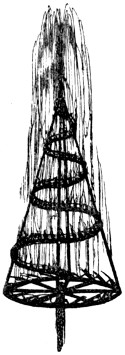
Should my young friends wish to prepare a grand volute illuminated with a revolving wheel; the first step is to procure a large circular wheel, and on its rim lay as many four-ounce cases as will complete the circle, only allowing a sufficient distance between the cases that the fire may pass free, which may be done by cutting the upper part of the end of each a little shelving. On each spoke fix a four-ounce case about three inches from the rim of the wheel. These[699] cases are to burn one at a time. On the front of the wheel form a spiral line with strong wire, on which tie port-fires, placing them on a slant with their mouths to face the same way as the cases on the wheel; all these port fires must be fired with the second cases of the wheel. Let there be a series of wooden spokes all made to screw into a block into the centre. When the large wheel begins to discharge the fireworks, the spiral wheel will of course revolve and produce a very beautiful illuminated cone.
To prepare a brilliant yew-tree, a frame like the one represented in the drawing must be firmly attached to the ground. When the branches are fixed, place illuminating port-fires on the top of each, as many as is convenient; behind the top of the stem fasten a gerb or white fountain, which must be fired at the beginning of the illumination on the tree. A series of these, varying in the angular directions taken by the boughs, produce a very fine effect.
Such are a few general directions respecting the making of fireworks; but we have again to advise our young friends to be cautious of the gunpowder, and to keep away from the fire, or from a light, or from flames, steel, iron, or any other matter likely to cause a spark.
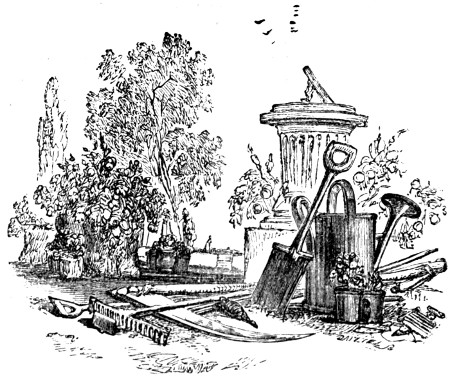
Gardening is one of the most delightful occupations for young persons. It combines innocent amusement, exercise of the healthiest kind, skill, forethought, method, taste, and is full of instruction,—leading the mind, not only to the wonderful operations of nature, but to the great Originator and Preserver of all things.
Gardening was the first of the arts. Before man had fallen from his “high estate,” and lost his heirship of heaven, he was placed by his Creator in a garden, and ordered to dress it and to keep it. The sustenance of man in all countries is derived, directly or indirectly, from the vegetable kingdom: it is supposed that he first made his appearance in that fertile and fruitful land from whence we get our best grasses. It was natural, then, that some rude kind of gardening should first occupy the attention of primitive man. In a[701] savage state, now, in many countries, plants supply all the wants of man to an extent greater even than we are apt to suppose, from the necessity and possibility of a greater variety of animal food in our own climate.
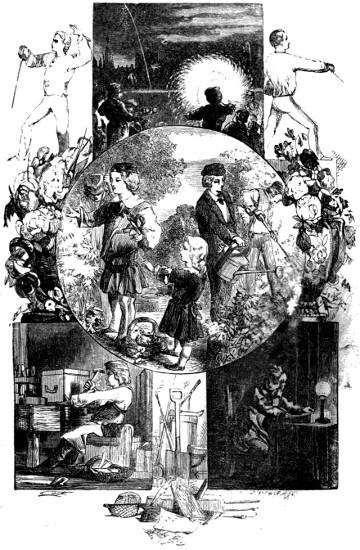
MISCELLANEOUS.—GARDENING, FENCING, ETC.
From the earliest times of profane history, gardens are alluded to. The gardens of the Hesperides abounded with fruit of the most delicious kind, and the hanging gardens of Babylon were among the wonders of the world. The gardens of the Persians are called by Xenophon, “delightful places, fertile and beautiful;” and the gardens of Alcinous abounded with fruits, grapes, and various horticultural wonders. The philosophers of Athens walked in ornamental gardens, among shady groves, statues, and fountains.
There are many so-called styles of gardening, but these are readily divisable into two varieties—the geometrical and natural style. In the first may be comprised all gardens laid out with straight or geometrical lines. In the second, which is often called the English style, we include gardens and parks where the irregularity that we observe in pretty wild places, or in Nature’s own gardens, are preserved more or less judiciously and tastefully. On the one hand, we take Nature for a model; on the other, we merely apply geometrical lines to the garden and its contents. As the geometrical garden is merely a thing of straight lines, it is very much easier to dispose than the natural, with which a great many people make sad mistakes, and then blame the style instead of their own taste. It is very much easier to make straight walks, and circles, and figures of all kinds in a garden, than to imitate on a small scale the variety, and indefinite, ever-pleasing character exhibited by Nature where she most attracts us with floral beauty.
However, to see some specimens of the various styles of gardens will give a better idea of their worth, and main features, than any reading. We will indicate a few of the places where good examples are to be seen. The Crystal Palace is perhaps the best place to observe their differences, particularly as most boys visit that attractive place. The great terraces and fountains are, of course, in the geometrical style; while the more remote, or outer parts of the grounds, are a good example of the natural or English style of laying out grounds. The irregular “lakes,” surrounded by vegetation, the rock cropping out here and there, the natural-looking grouping of fine trees, and the freely rolling beautiful green grass mounds, &c. are, though perhaps not the most frequented, certainly among the best features of the Crystal Palace. The Royal Botanic Gardens in the Regent’s Park is also a good, a very good example of the best method of laying out gardens in the English style. It is disfigured, however, by a small, mean kind of geometrical garden, which we must not be supposed to praise. On the other hand, the garden of the Royal Horticultural Society at South Kensington is a capital example of a completely opposite style—the Italian and geometrical;[702] and once having seen these, any boy can at once distinguish between the two, and probably say which he most admires.
In France, during the reign of Louis XV., the bad and artificial method was carried to excess;—clipped hedges, always laid out in straight lines—flower-beds tortured into fantastic shapes—trees cut into the form of pyramid haystacks, animals, &c. The gardens were like the manners and dress of that period, in which scarcely anything natural was left. The Dutch imitated the French: and this kind of gardening continued to prevail till attacked by Addison, in the “Spectator,” and Pope, in his Fourth Moral Epistle.

A GARDEN IN THE TIME OF LOUIS XV.
However, the boy’s garden is so small as a rule, that to attempt any kind of ambitious “laying out” would be nonsense; and having thus explained what is meant by different “styles” in gardening, we proceed to show how the boy’s garden should be laid out.
The size of a piece of ground which we should recommend to the young gardener ought to be about 33 yards long, and about 25 broad. It should be divided into four portions, as in the diagram. A B C D are four paths, 5 feet wide, which might be gravelled, and the edges should be planted with box, or some neat and tiny flowering plant. The borders should be about 2 feet in width; and this, with the breadth of the path, will take 9 feet, or 3 yards, from the 25 yards of width; which will leave 11 yards, or 11 yards broad, for each of the four compartments. The length of the four compartments—reduced by[703] 9 feet, or 3 yards, as before, for the cross-path and two borders—will allow each of the four compartments to be 15 yards in length; so that each quarter of the garden would contain 15 yards multiplied by 11 yards, and would equal 165 square yards, which again multiplied by 4, would give 660 square yards of surface, which would be amply sufficient for a young person to obtain something like an idea of gardening, and at the same time be a profitable advantage. This will be found too large, however, except for those who wish to work at gardening in earnest, and have, moreover, plenty of time and thought to give to the matter. One half the size will be found to suit a greater number. In such, the same plan and proportioning may be carried out.
In the foregoing diagram, the borders are for flowers, and the other parts of the compartments for the raising of vegetables; but here and there a space should be left for the planting of fruit-trees, rose-trees, currants, gooseberries, raspberries, &c. The places marked by dots (*) are where fruit-trees may be planted, which should consist of some of the best sorts of apple, cherry, pear, and plum-trees, which ought to be planted from four to five yards apart. In the borders, rose-trees, both of the standard and common kind, might be planted, as indicated by the dots (*); and at the four corners, where the paths intersect, climbing-roses should be placed, having strong poles upon which their tendrils and branches may run. The spaces in the border may be appropriated to the various kinds of flowers, at the choice of the young gardener.
There is one kind of gardening the results of which will afford a higher satisfaction to boys, when they become men, than any other pastime or exercise they can possibly engage in, and that is the planting of fine hardy trees. These will not require much attention, or any beyond the planting. They will grow freely and vigorously when you are at school or asleep, soon find their own supply of moisture by striking their roots deeply into the ground, and are able to withstand our cold and cloudy climate at all seasons. Nearly all intelligent and educated men are admirers of fine trees. Many who care nothing about our ordinary low-lying plants, take the highest interest in fine hardy trees—the late Prince Consort and the present Emperor of the French, for instance. Generally we display this interest in trees by planting them extensively when we come to be men; but how much would many lovers of trees not give to have commenced their tree-planting at an early age, so that they might walk under giant groves of their own planting! The Indian says, “He has not lived in vain who has planted a tree;” and certainly it is a noble thing to embellish the earth with its finest ornaments, and[704] plant tiny shoots that will in time become great trees, and shed leaves over the graves of our children for ages. And it is well to observe in the beginning, that a tree of thoroughly hardy and vigorous disposition is one of the most lasting things on earth. Though a living thing, susceptible, like ourselves, of almost every change of atmosphere, cold or heat, it often survives great monuments of stone, and may live and see extinguished not only many generations of men but even the lives of nations.
The age of many trees has been computed upon fair proof to be greater than that of the Pyramids of Egypt. There are trees in America which were of colossal development ere that country was discovered, so that the growth of a mighty nation may require but little time compared to that witnessed by the giant Wellingtonia, whose bark you may have seen at the Crystal Palace. In our own country the age of many oaks and yews is proverbial. But apart altogether from the mighty age which our finest trees attain, let us venerate them for their beauty, dignity, and utility. What so full of life and change, so inexhaustive in their well-built and subtle ramifications, as the branches and branchlets of a fine tree! “The pillars of the valleys, the fringes of the hills,” as an eloquent writer calls them, “so stately, so eternal” are, while the most useful of all things to man, at the same time the most beautiful natural objects which he can contemplate. Nothing adds so much to the beauty of park, pleasure ground, or garden, as the planting of handsome and suitable trees: in fact, they are the only true and pleasing ornaments of such. What constitutes the difference between the aspect of naked, blast-swept, and desolate-looking heaths, or lowland—monotonous ground of any kind, in fact—and one of those grand parks of old England, say Goodwood, or Richmond, or indeed any pleasure ground such as you may see in almost every parish, with every shady ferny corner, or lane opening, or tree-fringed sloping grass mound, a picture of fresh and changeful loveliness? Why, simply the presence of trees. With them you may impart every charm to the wildest heath or flattest prairie—with them the highest and grandest beauty may be imparted to the charmingly undulated surface of a great part of the British Isles.
So much for the trees and their attractions. What is next to be done? It is to be hoped that every boy fond of gardening has already made up his mind to plant a tree, or several. We have seen a great many little boys’ gardens, but it was the fate of most of them to become disused and neglected, dug up or forgotten, when the little gardeners had arrived at the “big boy,” or manhood stage. The inmates being small and fleeting, of course every trace soon departed. But by adopting the kind of gardening here recommended, a pleasing and stately souvenir of pleasant early days will be the result. It must not, however, be attempted in the ordinary little boy’s garden, which is usually a small patch under a wall, or in some obscure spot totally unfit for trees. If you once make up your mind to plant a tree, the[705] first thing to do is to choose a good position for it. It should be one in which it will grow well, and in which the tree will not be in the way of anything else. This will save it from being disturbed after it gets to some size, and your hopes from being disappointed in a way you least expected. And lastly, it will be very desirable to so place the tree that its effect when grown up may be a good and beautiful one. It is, for instance, very bad management to plant the noble Wellingtonia, or Cedar of Lebanon, near a house. This is very often done in suburban and villa gardens, but if the trees attain their natural size they spoil the house, or must be cut down. The finest cedar of Lebanon we know of is planted within twenty feet of a house, and completely overshadows it; yet so noble is the tree that the owner would not touch it on any account: he would give a great deal, however, to have it in a proper position. The planting of a large kind of tree where it may, when grown up, stop a pleasant view, is also a great mistake.
From these instances it will be seen that the position is a subject of the highest importance in tree-planting. Now, as of course every boy cannot be a judge of tree-planting, it will be found the best plan to consult papa or the gardener about it. They will be so well pleased at the idea of your planting a tree instead of a geranium or a wallflower, that you are sure to be encouraged with advice and assistance. To plant it in the ordinary boys’ garden would be a great mistake. It should be at once put in a position in which it might flourish undisturbed for ages. Generally, hardy trees are not fastidious as to soil. Mere planting is all the noble hardy ash, the graceful birch—the lady of the woods—the spreading beech, and others of our native trees require. But when we come to plant the grandest of all trees—the Wellingtonia and the Cedar of Lebanon, with many of the nobler pines of North America—if the soil be not naturally very good, we must make a preparation for the young plant. This is to be done by digging out a hole and taking the bad soil out at the bottom, leaving the top spit at one side, and then filling in the opening, say six feet wide or so, with good soil taken from a pasture and chopped up with a spade. This should be raised above the surface to allow for subsequent sinking, and also to keep the neck of the young tree a little above the level ground. The part meant by the neck, is the base of the stem, or, in other words, the part where root begins and stem terminates.
As most gardens or pleasure grounds are well drained, the little planter is not likely to have much to contend with on that score, but where the bottom or lower soil is of a disagreeable nature, gardeners very often place a quantity of broken bricks or rough stones in the bottom of the hole, and over them place turf to prevent the top soil from falling down.
The best time for planting is in the autumn—say September, October, or November; but any time through the autumn, winter,[706] or early spring will do, provided the ground be not saturated with rain, and all other circumstances be favourable. The choosing of a good young tree is an important point. Do not have anything to do with those grown in pots; the roots of such are usually contorted round the ball, and in a very bad condition to make good trees. Nice symmetrical plants growing in a nursery, say at about from two to four feet high, are the best. The price of even the best of such will not amount to more than that of an ordinary toy, while in the case of the common native trees, and such things as the willows, that grow freely from a sucker, it is a mere trifle. Indeed, in the case of boys who live where there is anything like an extensive garden or grounds, most probably good young trees will be at hand ready to plant. It will be well to have the assistance of the gardener in planting a rare thing like the Wellingtonia, though after a little practice an intelligent boy can do it easily. The main points are, to place the roots of the tree on soil made pretty firm, to spread the roots out carefully before covering them, and finally, if the weather or soil should happen to be very dry, to give the ground a thorough soaking of water. This will refresh the little root fibres, make them “take kindly to the earth,” and, in short, put the little tree in a fair way for its long life. And as boys may frequently have occasion to water their gardens, as well as other people, we may assure them that one thorough good watering is better than a dozen bad ones. A bad watering is one in which the surface of the soil is merely wetted, and if you poke down a little way you find the soil quite dry: a good watering is one in which the water descends deep and far into the soil, as deep or deeper than the roots go, in fact. The dragging about of water in pots is a very laborious and awkward affair. If the little gardener can secure the loan of the water-barrel on wheels, and have it filled quite full, and the contents gently supplied to the root of his tree, he will save himself much trouble, and probably have no further attention to pay to it in that way during the course of his life. By the way, have you ever heard the little story about the famous Jean Jacques Rousseau and his little tree? If not, here it is.
When he was a little pupil about ten years of age, his master planted a walnut-tree to give a grateful shade to a place immediately outside the house. The planting of this walnut-tree was attended with some ceremony, little Rousseau and his friend, a fellow-boarder, acting as godfathers, singing songs of triumph around it. The master and his assistants formed a kind of basin around the tree, or, in other words, made a little embankment of earth around it, so that the water could not escape. Jean Jacques and his companion saw and were much interested in all this, made up their minds that it was a nobler thing to plant trees than to plant colours on a breach, and at once became very anxious to plant. This they soon did by cutting a slip of willow, and planting it with due ceremony on the terrace near the august walnut-tree that had been planted by the[707] master. They made a basin of earth round it in imitation of the bigger one, and then came their grand difficulty—how to water it. They were not permitted to fetch any, or they would have gladly done so, though it was at a distance. The tree was safe for a short time from some cause or other, and began to put forth a few leaves, which they hoped would in due time afford them shelter and shade; but hot days came, and it was apparent that unless the little tree had water it would surely die. What was to be done? Well, it is pretty evident that either of them could think a little, even at that age, for the little rogues made up their minds to make a tiny grass-covered canal between the large basin and their little one, so that when the master came to water his big tree, the water might run from his basin to theirs! Their first essay failed; the earth fell in, and they were miserable for a moment, but soon set to work again. This time they cut an old box into narrow planks, and lined the furrow with them, made the slope so that the water would be sure to run as desired, and covered the trench over so that nobody could see it, putting a grating of twigs over the upper end, so as to hide appearances and keep out rubbish, and waited in hope and fear for the result. The master and his men came and poured in the water, which soon ran through the furrow to the little tree. This was too much for our otherwise sagacious little gardeners. They roared with delight at the success of their plan, and betrayed it to the master, who immediately sent for a pick-axe, and cut up their little trench, shouting at the same time, “An aqueduct! an aqueduct!” They were of course sorry, but soon took heart, and planted another tree, which lived to be a big one. To have set this slip in competition with a large one, Rousseau tells, gave him a degree of glory he had not known before, and says that he had a juster idea of it at that age than Cæsar had at thirty.
We will next turn to the selection of trees, and to the various wants of those who are likely to plant. The most popular trees in England at present are those noble evergreen pines. They are not all suited for town gardening, but very much so for most parts of the country. Around the beautiful mausoleum raised to contain the remains of the late Prince Consort at Frogmore, there is a row of these trees, mostly tapering and slender in habit, and very dark green. They have been planted by the various members of the Royal family in memoriam. The late Prince was very fond of these pine-trees, and many country gentlemen take the greatest interest in their planting. We merely tell you this to point out that the planting of trees is an object of ambition with many of the best and the highest in the land. When Her Majesty, and many other distinguished persons, visit a nobleman’s place or a public park, one of the most graceful acts they can do is to plant a tree; and the custom is very general. Let us hope, then, that many boys will imitate the example of Rousseau, and say, why should not we too plant trees? But to[708] return to our pines, or conifers, as they are called. The race is a wonderfully beautiful one—so much so, that you must take care, or you may plant things that will do very well for a few years, perhaps, but get quite killed by the first very severe frost. It is a sad sight to see a tree which has perhaps grown to considerable size and beauty killed to the very ground by a frost such as we had in January, 1866—some of our noblest pines perished then; and therefore a list of the most thoroughly hardy kinds must prove useful. The giant Wellingtonia of California is fortunately hardy in all parts of these islands. So is the great arbor-vitæ of Nootka Sound (Thuja gigantea), a specimen of which obtained the first prize for trees of this kind at the great Paris Exhibition. One of the most beautiful of all pines, one which has its “leaves,” or little branchlets rather, as graceful as those of a fern, is Thujiopsis borealis, and it too is perfectly hardy. We regret that hard names must be used, but then, as thousands of our plants are not natives of England, they have of course no recognised English name, and to translate the scientific one would simply produce an awkward barbarism. In addition to the above, the following trees of this fine family may be planted with the confidence that we shall not see them perish in the vigour and beauty of youth:—Lawson’s cypress (we give you the English name where possible). Nearly all kinds of juniper. Picea Pinsapo, nobilis, and Nordmanniana, all noble trees—also amabilis and cephalonica. Abies Albertii, Morinda, Menziesii, the Cedar of Lebanon, and the Deodar cedar—these are hurt now and then, but on the whole are hardy enough generally. The common spruce fir; the Scotch fir, always a picturesque tree. The deciduous cypress, a fine tree for the margins of water, where after a time its roots send up most curious knobs, in many cases nearly as big as a beehive, above the ground. It is quite extraordinary to see the specimens of this noble tree in the pleasure grounds at Syon, the Duke of Northumberland’s fine place near Brentford. The new Japanese larch (L. Kæmpferi), the Austrian pine, the Swiss nut pine (P. Cembra), the Corsican pine. The youthful gardener, who lives near a large nursery, park, or place like Kew, Glasnevin Botanic Gardens, near Dublin, the Botanic Gardens at Edinburgh, the gardens of the Crystal Palace, at Sydenham, or many places of this kind, would do well to examine specimens of the kinds named, or indeed any others, so that he may take his choice; making sure to inquire, however, that the particular kind he selects is perfectly hardy: a tree may be quite hardy in one part of the country, and quite tender in another. The curious and fine monkey puzzle (Araucaria imbricata), for instance, has been killed in some parts by severe frosts, in others it has always escaped with impunity. It is always easy to ascertain facts of this kind in a neighbourhood, and of course we should make a point of cultivating the things that are best suited to our climate and soil.
So much for coniferous trees. We will next turn to a far nobler[709] group, so far as regards our wants—deciduous trees, or those that lose their leaves in winter. These are generally quite hardy, and make large and long-lived trees. They may be grown in many places where the pines would not live, and are therefore admirably suited for places in and near towns. They should be preferred by all boys who live in suburban gardens, as in such the leaves of pines and evergreens are sure to be soiled and disfigured, if not half-killed, by smut. Many of these deciduous trees flower beautifully, and in not a few the leaves, even in our dull clime, assume rich and varied tints in autumn. The following list includes the noblest, best, and hardiest known:—The great Columbian maple, the silvery maple (A. eriocarpum), the red maple (A. colchicum rubrum), the Norway maple, the purple-leaved sycamore, and the variegated negundo; the double horse chesnut (the flower of this lasts very much longer than the single kind), the red chesnut, the Hungarian lime-tree, and the Mississippi lime, the tree of heaven (Ailanthus glandulosa), the tulip-tree, the Japanese sophora (a noble tree, fine for dry soils), the Kentucky coffee-tree (not a large tree, but with very graceful leaves), the hawthorns in variety, both red and white. Some of the hawthorns bear handsome fruit, and of such the most distinct is Aronia, Layi, Celsiana and Douglasii. The flowering ash, the showy Chinese Pyrus spectabilis, the American ash, the Canadian ash or lancewood; the Cornish, Chichester, and Irish elms (the last being a tree of large growth) and also most particularly the weeping variety of the wych elm; the black walnut, and the yellow-twigged willow; the silver-leaved poplar, the Carolina poplar, and of course the Lombardy poplar; the splendid western plane, which does so well in towns, the Eastern plane, and the Spanish plane. Lastly, we will name the noble oaks, both the American and our own. The American oaks are among the finest trees of the world. The best of them are Q. ambigua, Prinus, the champion oak, the scarlet oak, the black oak, and the willow oak. Any of these will form long-lived and noble trees.
The preceding remarks and instructions generally apply to the wants of boys whose parents have gardens of some size. But a very large class are not so fortunate—have not sufficient space to develop a good tree, and perhaps live in or near towns, where it may be difficult to grow a good one. For convenience sake, we will divide these into two classes—those who have small gardens in the country, and those who have small gardens in or near towns or cities. In the former, it will be better to pay full attention to subjects of a comparatively dwarf though hardy and long-lived habit, and to fine hardy shrubs like the hollies, &c. Except on the very margins of a small country place, it is a mistake to plant great trees, as at some time they are pretty sure to become an overshadowing nuisance, too near the house to be seen to advantage, and also too near to be agreeable or healthful. Of beautiful dwarf evergreen trees suited for such, there is nothing better than the comparatively new Retinosporas,[710] which are at once graceful, hardy, and beautiful. They are natives of Japan, and in any large nursery various handsome and comparatively dwarf pines may be selected suitable for the same purpose. For the town or suburban garden the best things are decidedly beautiful dwarf and free-flowering deciduous trees, like the almond, the various finely coloured double peaches, the beautiful double cherries, the Chinese crab, the silvery eleagnus, the better kinds of hawthorn, and if there be room for a large tree, the plane is the best. Of course there is great difference in the climate and atmosphere of what are called suburbs. Thus, in many of the suburbs of London it is nearly impossible to get a pine-tree to live, while in the suburbs of many other towns and cities the choicest trees flourish freely. But ten or twelve years’ increase of smoke and increase of houses may make a sad difference to the pleasantest of suburbs, and things that flourished healthfully at one time may gradually perish from increasing smut and vileness of atmosphere. The best trees of the pine tribe for town planting are the dwarf and beautiful Thuja aurea, well suited, from its dwarf size, for the pleasure ground or flower garden; the Austrian pine, the common arbor-vitæ, and perhaps a few others; but as a rule, it is better not to plant pines where they will be exposed to the evil effects of a city atmosphere. On the other hand, all trees that lose their leaves in winter are likely to do well in such places, because they are leafless and quite at rest in the winter, when every chimney is vomiting forth poison, and the air is thick with filth. Then, when the atmosphere begins to clear, and the spring returns, they put forth their leaves and expose them during the best of the year, while the poor pine or evergreen has to stand exposed at all seasons.
Of course every boy who cares about gardening will have a little flower garden. That is the first thing he is likely to attempt, and, perhaps, on the whole, that which he may attempt with the greatest certainty of success. A nice little varied flower garden is a source of interest and pleasant exercise for a boy nine months out of twelve. But it is not by imitating the common style of flower garden that a boy can make his little piece pretty and interesting for the length of time we have named. Nothing can be more bald and awkward-looking, more miserable in aspect, than most flower gardens he is likely to see at the present day; and therefore he must not attempt to imitate them, but follow the instructions to be presently given. The reason why the greater number of flower gardens of the present time are bad and miserably vulgar-looking, is that those who arrange them simply use a few sorts of plants, and many of them in great excess, so that an oppressive kind of monotony is produced, which is anything but agreeable in the flower garden; and, besides, nearly every flower garden you enter is very like every other—no life or interest to be[711] seen in them as a rule; but, on the other hand, a great deal of mere gaudiness.
In addition to these demerits, the ordinary type of flower garden is usually filled with tender plants—plants which must be put out in the ground when the frosts are quite gone, in the beginning of June, and taken up again as soon as they reappear in autumn—leaving the ground bare for the winter and long spring. Now, even if this were the most beautiful way of managing a flower garden, it would not suit the boy gardener. He has, as a rule, no time to attend to tender plants, and if he once plants his garden, keeps it clean, and adds a new member to it now and then, it is perhaps as much as can be expected, considering how many other things he has to do. Besides, he goes away to school now and then, and what is to become of his tender plants then? Most boys will be proud to take care of their own things, and will be much better satisfied with a hardy little plant, which cannot suffer when they go away for six weeks at a time, than with one that may go off with the first frost. Clearly the best thing for the young gardener to do is to cultivate the most interesting and pretty of the hardy flowers of all seasons. Usually these are infinitely more interesting than the tender exotics of the grand flower garden. Many of them are English plants, notably the beautiful lily of the valley, the pink, the carnation, the graceful Solomon’s seal, the various lovely primroses and polyanthuses, and a host of others. Yes, you will do most wisely by adopting all those charming old inmates of our gardens, which, independently of their associations, are not to be surpassed for their beauty by any tenderlings. It will be our pleasant duty to point out to you the kind that you may grow with the greatest ease, and pick out for you the most beautiful kinds known. It is most essential to be very careful about the plants you put in your little flower garden, for your space is generally small, and there is in consequence the greater necessity to take care that every spot of it is occupied with a “good thing,” as gardeners are wont to say. There are hundreds of plants mentioned in garden books, and sold in nurseries, that are little better than weeds, and which would, therefore, sadly disfigure your garden. Presently we shall write you a list, which may be implicitly depended upon—every plant being beautiful, hardy, and in all respects suited to your wants.
As boys are usually allotted but a small portion of border for their flower garden, it is better to adopt the mixed border system, that is, a mixture of different kinds, tastefully arranged, and have nothing to do with what is called “bedding-out,” or planting great masses of one thing. By the mixed system, you will be enabled to enjoy a little of everything, and at all seasons, from the time that the crocus opens its brightly-burnished golden blossoms in early spring, till the Christmas rose ventures to show its large white flowers in the depth of winter. Do you like exquisitely coloured little flowers in the[712] dawn of spring—little brightly blue things that “come before the swallow dares?” You can grow such without expense or trouble in your little parterre. The charming bushes of dwarf shrubs, and large border flowers, which bloom in May, must have charms for you as for all of us, and these too you may have in perfection; while the roses of June and July, the lilies of August, and the grand gladiolus of the autumn, will all be perfectly at home in your borders, as will every good and beautiful flower garden plant. In laying out your small patch of flower garden, it is best to confine yourself to a central bed (which may be square, round, or oval), and borders around that, and not to attempt anything elaborate in the way of laying. Attempts to lay out small bits of ground in a geometrically elaborate or Lilliputian imitation of the natural style, is almost sure to end in the production of something ridiculous or cockneyfied. Confine your attention chiefly to the plants, laying out the ground in a convenient manner. Let the design be subordinate altogether to the plants. All trivial artificial ornaments, in the way of shells, coloured gravel, statuettes, sundials, &c. should be left out of the plan altogether. The most beautiful gardens are those in which plant-beauty, and that alone, is conspicuous. If you can make the visitor forget all about design—forget everything but the fact that he is in a beautiful and varied garden, with nature’s own gems, free and healthy, on every side, you will attain the highest success of which the ancient art of gardening is capable.
We will suppose, then, that you have selected your little bit of ground. The next thing to do is to prepare it thoroughly. Now, in ordinary cases this is not half done. We are going to recommend you to plant permanent things, plants which will not require removal for many years, and you will not have a thorough opportunity of preparing the ground after you once plant. Therefore, the preparation of the ground is of tenfold greater importance in your case than in that of the ordinary gardener, whose beds of geraniums, or suchlike, are empty in winter, so that he has an opportunity of dressing and digging them every year.
Before marking the walks or anything of the kind, when, in fact, your little piece of ground comes into your hands at first, remove all matters from its surface, add manure to it in abundance, and have the whole dug as deep as you can go, without bringing up the bad subsoil at the bottom. If the ground be sandy, so much the better; then all you have do is to give it plenty of cow, or any other rich manure that comes to hand. If, on the other hand, it be of a clayey, stiff, tenacious nature, like much of the ground to the north side of London, you must act quite differently. Most pretty border plants like a light, warm, free or sandy soil, and abhor a heavy, wet one. The way to cure, if we may so speak, or, in other words, improve the very stiff soil, is to add plenty of sand, leaf-mould, horse manure, or gritty scrapings from roads, or any other loosening material of this kind that you can[713] obtain. Dig it in deep, and dig the ground over again, so that it may be thoroughly incorporated with the soil. All this should be done in autumn, if you have the time—in early autumn, if possible. When well done, and the ground levelled, then you may mark your little walks—with a line—and your central bed; and if in this operation you can get the gardener to assist you, do so by all means. In many cases the gardener gets ready the boys’ garden, and presents it to him ready for planting, and that is the best way; for the planting and attention required afterwards will be as much as you can do, if you do it well. A word or two as to edgings for the borders and the bed. Don’t have anything to do with those nasty stone edgings, so much advertised of late, as they look very ugly and out of place in a garden. The neat little edging of box is, perhaps, the prettiest as well as the oldest in existence. But we are inclined to think that little edgings of plants that flower are the best for your case. Try to be original with your edging as with everything else, if possible, and whatever may be used as an edging near your garden, avoid, and have something distinct. We know of about one hundred pretty plants for making edgings, but can only mention such here as you are likely to be able to obtain without difficulty. The best are the rosy thrift (Armeria vulgaris rubra), a lovely spring plant; the pretty little white and blue campanula pumila, and its white variety; the large blue gentian of the Alps (G. aculis), this is plentiful in Scotland, but not about London; the pretty little blue aubrietia, to be obtained everywhere; the variegated cocksfoot grass (Dactylis glomerata variegata;—what a pity it is that we are obliged to use such names); and the double daisy in various colours. Should you make a box edging, use the dwarfest and best kind; and if you happen to notice any other dwarf hardy plants that make tasteful edgings, use any you fancy, by all means. The more variety we have the better, and the only thing that it is particularly desirable you should avoid is any forms of those crockery wares, or artificial stone edgings, as they are all as bad and ugly as need be.
We will now follow with a list of the most suitable plants for your garden. To each plant a figure will be attached, to indicate the position it should occupy in your beds or borders. We will, for convenience sake, throw the various heights of the plants used into three classes—1, for the smallest plants, or those fitted for the front of the border; 2, for the medium-sized, or those suitable for the middle parts; and finally, 3, for the taller kinds, which require to be placed at the back, or near the back of the border. Doubtless you will make a point of growing the rose; that is deservedly everybody’s favourite. You may plant the rose either in the back part of your border, as a standard in the middle, as a dwarf bush, or on the front edge, pegged down close to the earth—not a bad way of growing it, by the way. But avoid the standard rose, if you can; it is ugly, awkward, and by no means so satisfactory as a rose “growing upon[714] its own roots:” that means, a kind not grafted upon another, but quite on its own resources. Roses generally are grafted upon free growing common kinds, known as stocks. The most pleasing in the end, and by far the most satisfactory, are the roses upon their own roots. They make dwarf but long-lived and vigorous bushes—the very best things you can employ in the middle parts of your borders. If there be sufficient room, have a dozen kinds of roses, each different. Every spring, from deaths during the winter, and changes of one kind or another, you will have to look over your borders to fill up vacancies. It is best done about the end of May, when you may exactly see the state of the plants in the border, by filling up the majority of these vacancies with the better kinds of bedding plants, &c. By doing so you may enjoy both phases of gardening—the beautiful and interesting hardy flowers, to be presently named, and the brilliant and common flowers of the summer parterre, the pretty kinds of verbenas, the dwarf and neat lobelias, the variegated and other geraniums, and in fact, any kind of bedding plant that comes to hand.
Next, for the selection of the more valuable and more uncommon hardy flowers, leaving out all such as are difficult to obtain. Among all the flowers of spring, few are better known than some of the anemones—apennina (1), fulgens (1), coronata (1), sylvestris (1), and Honorine Iobert (2), are the very best. Among them we have the sweetest blue, the brightest scarlet, and the purest white. Of the columbines (Aquilegias), the best for your purposes are the common border varieties. They are mostly fitted for the central line of the border. Of the magnificent delphiniums, so richly blue, tall, and stately, there are many beautiful new kinds—so many that I need not enumerate them, but most nurserymen are pretty sure to have varieties of them. Being tall, they are mostly suited for the back, or nearly the back portions of the borders: if you have a central bed, they will also look very well towards the middle of it. By the way, the middle of such bed might well be devoted to a choice shrub or two, say a good rhododendron or kalmia—that is, if the soil would suit such. The peony is almost too big for such little gardens; but a plant or two may be ventured in some unimportant spot. The yellow bachelor’s button (Ranunculus acris, fl. pl. 2), is very pretty, and so exceedingly is Dielytra spectabilis (2). Baptisia australis (3). Coronilla varia (2). Galega officinalis alba (3). Lathyrus grandiflorus (3), a climbing plant, very fine for going up a low trellis. The white and red everlasting peas (3), also climbers. Orobus vernus (2). The perennial Lupin (3). Achillea ægyptiacum (2), A. aurea (1), A. Eupatorium (3), and A. millefolium roseum (2)—all fine and free. Of Michaelmas daisies (Asters), A. versicolor (1), elegans (3), turbinellus (2), Amellus (2), will be found highly beautiful. The Pyrethum in fine variety of beautiful colour and size: they have been raised of late years in great quantity by Mr. Salter of the Hammersmith[715] nurseries, and are admirably suited to the middle line of borders, therefore the figure 2 will indicate their position to a T; their colour is rich and distinct in the extreme. The fine autumnal flowering Phlox (3) is also sold in great and beautiful variety, and should have a place in every good collection. Six or eight of the best kinds should be in the boy’s garden. Nearly every nurseryman supplies them cheap. In the harebell family (Campanulas) we will find some very fine, particularly pumila (1), carpatica (1), persicifolia (3), and P. alba (3), grandis (2), macrantha (3), rotundifolia (2). The fleur-de-lis, or Iris, has some beautiful varieties, of which the best are germanica (2), florentina (2), pallida (2), De Bergii (2), pumila (1). Tritoma grandis (3), and glaucescens (3), are noble things for the back of a border. The double wallflowers (2), the alpine wallflower (1) (Cheiranthus alpinus). The Potentillas (2). Veronica amethystina (2), and corymbosa (2). The Virginian tradescantia (2); the crimson loose-strife (3); Lythrum roseum superbum. I give you the hard names so that you may have the less difficulty in procuring the plants, for many may know them by their Latin name, who would not know them by their common one, and vice versâ. The American cowslip (1): this being a very chaste and pretty plant, have as much as you can of it. Salvia argentea (2). This plant has grand silvery leaves, and should be in every collection. Perennial candy tuft, 1 (Iberis). There are three kinds of this—corræafolia, saxatilis, and Garrexiana, all good, hardy, and beautiful. Arabis alpina (1); Aubrietia purpurea (1); Alyssum saxatile (1): all three very easy to grow, and very common. The beautiful little Hepaticas in various colours, blue, white, and red. You must secure a stock of these, above all things; they are among the prettiest of spring flowers, and will “set off” charmingly the front parts of your borders. There is a fine new kind of hepatica (H. angulosa), a noble kind, which you will also do well to obtain: give it a rather shady position in light soil. One or two tufts of the Christmas rose will be quite enough. When this begins to show its flowers, a few weeks before Christmas, you will do well to cover the plant with a hand-glass, leaving a little air at the top. This will prevent the flowers from being injured or hurt by rain; they will grow very much larger and whiter than if left exposed. Of Pentstemons (2), a good variety should be grown, especially if the soil be light and good, such as they delight in. Sedum fabaria (2), is a fine autumnal flowering plant, which must not be forgotten. Rudbeckia Newmannii (3), a very fine autumnal bloomer. Lithospermum fruticosum (1), a wonderfully pretty plant for the fronts of borders. Any kind of pink (1) that you can conveniently obtain, should be grown; they are sweet, hardy, neat, and, in a word, perfect for your purposes. They are considerably varied of late years, and highly useful for cutting for bouquets, &c. The front of the border is the best place for them. Immediately behind them, and scarcely so far back as the line of the second row, is the place for the carnations and picotees, which of course you[716] will be sure to cultivate. There is nothing more beautiful in our gardens than many of these, so beautifully and richly coloured, and so delicately and exquisitely margined and striped. Linum narbonense (2), and Perenne album (2), noble kinds of hardy flax, are also good. The Œnothera tribe will furnish some beauty: notably the sweetly coloured Œ. acaulis (1), which opens its very large flowers in the evening, and keeps them open till nearly breakfast-time in the morning; the noble yellow macrocarpa; and the large evening primrose (Œ. Lamarkiana). Some dwarf tiny shrubs, that flower freely, will look beautiful in your border, and of such you cannot find one more beautiful than the early spring flowering heath, 1 (Erica carnea); it is a mass of handsome bloom, and very hardy and neat in habit. Other capital little shrubs are Daphne Cneorum, sweet and pretty—various dwarf kinds of native heaths, and Genista tinctoria (1), and sagittalis (1).
In addition to the above, it need hardly be added, that such universally esteemed plants as the lily of the valley (1), the primrose (1), and the polyanthus, should be well represented. Latterly there have been raised considerably varied kinds of primrose and polyanthus, and nothing can be more charming than mixed masses of such. From a packet of seed of each (ask for that of the ordinary mixed kinds), you may raise a considerable variety of beautiful kinds. Double daisies (1), too, in various colours, will be found very pretty in the spring, as will the numerous kinds of pansy (1), the gentian, and the forget-me-not. By the way, you must not forget some tufts of the common forget-me-not; it does very well as a border plant in all but the driest soils. At Trentham it is tastefully employed to form a margin round some pretty little gardens, dedicated to the various younger members of the family; and we have known people to be so full of gratitude to a departed dog, as to plant a ring of it round the little monumental slab which indicated his place of burial in the garden border. The various pretty and very dwarf kinds of saxifrage (1), and Sedum (1), too, you will find neat and distinct for the very front of your border, in which you will of course arrange the dwarfest plants.
One word more. It would be a pity to confine you to this or any other selection. The more varied your garden is, and the more distinct from that of your friends or neighbours, the better. The selection above given is as good as can be made, and may save you from getting a lot of ugly weeds in your garden, under the name of flowers; but in addition to these, you would do well to add any other pretty plant met with in your rambles, and which seems to you worthy of a place; while with friends who cultivate plants, you may exchange any that you have plenty of, for new varieties, or anything that you may fancy.
There are few boys who cannot appreciate the virtues of a delicious melting pear or good apple; and our object in writing this paper is to tell them how to grow such in a comparatively short space of time. In old times, and, indeed, generally at present, people plant for those who come after them—“plant for their heirs,” in fact,—plant trees that will come into bearing in twelve years or so; and therefore some may say, why offer the boys such a far-off treat? But times change, and the system which produces the finest fruits now in our markets, happens to be exactly suited to the boy’s garden. Large and beautiful apples have been sold in Paris during the past spring for as much as three francs a-piece! These were in many, or in nearly all cases, grown upon little trees not more than a foot from the ground, and several of them not more than two or three years old! The French are the best growers of apples and pears in existence; and in France originated this dwarf method of growing them. The way they do it is as follows:—The best kinds of apples are grafted on a variety known as the Paradise, which induces a very dwarf growth and early fertility in the kinds grown upon it. We have seen these fruiting, this year, at two years of age, bearing fine fruit, much better than you see on trees developed to full size. They are grown in two ways, generally as cordons, and occasionally as little standards. The “cordon” is simply a single plant of apple, trained along a wire, supported about a foot from the ground. The little standard, or bush, is simply a diminutive Lilliputian kind of tree—just such as a boy would wish for in his garden. Not taller, if as tall as himself, he can shorten the shoots and gather the fruit with the greatest ease. The culture of these little trees is so simple that no boy need fail with them. A sunny spot should in the first instance be chosen, that is, if the young gardener can get it; and it is not often that he is allowed any but a bye nook of some kind or other; and no wonder, because hitherto boys’ gardens have simply been short-lived little exhibitions of untidiness, never yielding any result and very little beauty. But the young gardener who manages well his fairy part of fruit garden, will soon produce a little feature that any place might be proud of. Next, as to how to do it.
Very little ground is required. A small patch will afford space for a great number of little trees. A sunny open spot should be selected, where the trees will have all the advantages of sun and air to perfect their fruit, and render their shoots short, firm, and fertile, instead of sappy, gross, and useless. The soil should be of a slightly sandy or loamy nature, and not wet. If the ground be badly drained, and water lies in it much, it is almost hopeless to attempt fruit-growing,[718] and the little gardener had in that case better turn his attention to something with which his soil and circumstances are likely to agree. One of the chief points in gardening is to choose the course most suited for your own soil, climate, and position. Thus the boy who lives in a great city, or the suburb of one, and who has to contend with the smoke and other evils incident to such, must pursue a very different plan of gardening to the boy who lives in the country, and has all the advantages of pure, sweet air for his plants. The best of all soils for our little fruit-trees, is one moderately sandy, yet not too loose and free, with what we may term a free bottom, that is, a sandy or other subsoil beneath, which will permit the water to pass off freely from the fertile or upper earth. But although this is the best soil, there are few others that we need reject—the worst, perhaps, being deep, stiff, soap-like clay. The best time to plant is in the autumn. Be sure you ask for the young apple-trees grafted on the “Paradise,” and the pears on the Quince stock. Both apples and pears may be grown as little standard trees or as cordons. In planting, do not put the roots deep, and spread them out even, forming first a rather firm and slightly convex surface, on which to place the little plant. This will be found to suit very much better than making a loose sort of hole into which to put the roots.
It should be borne in mind that when fruit-trees send their roots deep into rich or cold ground, they produce a lot of coarse, useless wood, barren of fruit, or nearly so. To counteract this tendency, what is called root-pruning has been resorted to. It simply consists in taking up the trees once in two years or so, and replanting them—at least, this is the way with our little trees. It may not be necessary on many soils; but where it is, it may be readily done during pleasant dry weather in autumn. The check given to the tree by the disturbance, causes it to form fertile buds and a stubby habit. It is well that the young amateur gardener should know this, so that he may apply a remedy if his fruit-trees grow too strong and prove barren. But generally they are fertile enough, and even sometimes produce a successful crop the first year after planting; the second year they should bear well. The accident of a severe frost while the trees are in flower, will of course always do mischief, and may ruin a crop; but all are liable to this, as well as our Lilliputians. It is best to plant the erect little trees in a small square—pears and apples separate, for uniformity sake—and to place the cordons around this, just as the French make a sort of edging of them in their gardens. Indeed, if the boy cannot obtain a neat little sunny square for his tiny trees, he will hardly fail to succeed in getting permission to arrange a few in cordon fashion along the edge of some border. It is simply done by either driving down a strong wooden post, or an iron one, so as to support a wire at about ten inches or a foot from the ground. Beneath that, the[719] trees are to be planted, say at a distance of six or eight feet, and tied along the wire. When once this is done there is no further trouble, except to pinch back the shoots in summer so as to keep them close and compact. This operation requires a little attention. The main stem, which is of course tied carefully but not too tightly to the wire sends out side shoots in the summer. When these are about four, or say from three to five inches long, they are to be pinched back, or in other words, nipped off, within about an inch of the base of the young shoot, in the case of apple-trees—in the case of pear-trees it should be left somewhat longer. This is for the summer pruning; in winter it may be necessary to go over the trees with a knife, and remove or shorten awkward spurs, or cut out dead bits here and there; but the summer pinching is the chief thing to be done in the matter. When the trees produce too plentiful a crop of fruit, these should be thinned when very young, so that those left may assume the splendid flavour and size which makes fruit grown in this way superior to that grown in the old and large tree system. I will now give you a list of the best kinds to use in this way, and which can be bought in any respectable nursery. Of apples the very best are Colville Blanche and Reinette de Canada, Cox’s orange pippin, Hawthornden, Herefordshire Pearmain, Greaves’ pippin, or any other first-class kind of apple. Of pears, Marie Louise, Winter Nelis, Beurré Diel, Jargonelle, Beurré d’Amanlis, and Joséphine de Malines, will be found very suitable for the dwarf bush or cordon style, as will most first-class pears.
When land is first brought under the spade it should be well dug, and it ought to be trenched up; that is, a full spit or spadeful should be taken and thrown somewhat higher than the general level of the ground, and turned, so that the under part of the soil is brought to the surface; in doing this effectually a sort of trench will be left at the part where the spade goes in, and at the end of digging a piece of ground in this manner this trench will be required to be filled up. It is usual for gardeners to provide for this at the onset by bringing a barrow full of the mould from the part at which the spade is first put in, and filling up the trench so left at the end of the process. Common digging, when the ground is not to be trenched, consists in turning it over regularly and evenly with the spade. When manure is necessary, it is either hoed over the ground and dug in as the digger proceeds, or in trenching it may be laid in each[720] successive trench as it is made, which will of course be covered by the next line of digging. Flower-beds are best turned up with a small three-pronged spade-fork; and it is often necessary to use the same instrument when digging between strawberry and other roots, which is technically called forking. The earth in this process is not turned over, but only broken up and loosened, and the handle of the fork not turned in the process, but drawn gently backwards with a kind of knock, which can be easily acquired by practice.
The hoe is of very great use in a garden. There are generally three kinds of hoes: 1st, the narrow; 2d, the broad; and 3d, the Dutch hoe. The small hoe is used for hoeing in flower-beds; the broad one for earthing up peas, potatoes, &c., and the Dutch hoe is of service in dry weather in clearing the ground quickly of weeds. The two former hoes are used by drawing the handle to you, and hence called draw hoes; but the Dutch hoe is used by thrusting forward, when the weeds cut up by it fall through the hollow portion at (a) clear of the operation. In hoeing the hoer should be particularly careful to go quite to the roots of the weeds, and clear of the roots of the plants. In hoeing up peas he should be careful to draw the earth nicely among the haulms; and in hoeing up cabbages not to sprinkle the dirt among the tender leaves forming the heart of the plant.
There are two kinds of rakes,—the broad and narrow. The broad rake is for raking over seed beds, and the narrow one for raking borders among flowers, &c. In the use of the rake the gardener should first lightly drag off all the weeds and stones from the soil. In holding the handle of the rake high, all the loose stones, weeds, &c., will be easily drawn from the ground without the mould; when the handle is held low, the teeth of the rake enter the ground and scratch it up, which is sometimes necessary to be done; but the little gardener should be careful not to rake away his soil; and the little hard balls of earth that come over with the stones, &c. should be pulverised by the back of the rake.
The garden should always be kept perfectly clear of weeds; a weed in a garden is a disgrace to the gardener, and unless a young person[721] makes up his mind to be very particular in this he had better never think of gardening. Chickweed, dandelion, plantain, bindweed, and every other description of extraneous growth should be quickly removed, and that worst of all weeds, called the gardener’s plague, “couchgrass,” should be extirpated entirely, as should all suckers from the roots of trees. Weeds, if not in seed, should be thrown into the manure pit, but sticks or stones should never be mixed with them.

DIBBER.
The ground having been dug and raked, and otherwise prepared, is fit for the reception of the seed. Radishes, carrots, parsnips, are sown by the hand broadcast; the way of sowing carrot seed is to mix it with the earth in a large flower-pot, and then to scatter it very thinly over the bed: at least, that way is suited to the boy’s garden; in the open garden and the field they sow carrots and parsnips in drills. Peas are sown in drills about three inches deep and four feet apart. Broad beans are put in with a dibber in straight lines about five inches apart, the rows being four feet from each other. French beans are sown thinly in drills about four feet apart. Scarlet runners are put in by the dibber singly about three inches apart, and should have bean sticks placed near them as soon as they appear, upon which to climb. Cabbage-plants should be put in by the dibber about nine inches apart, in rows about four feet distant from each other. Cauliflowers should be planted eighteen inches apart either way, as should Scotch kale and sprouting brocoli. Spinach may be sown thinly in drills three feet apart, or broadcast in beds. Lettuce-seed, cabbage-seed, cauliflower-seed, and all kinds of flower-seeds should be first sown in warm situations in good mould very thinly, and then the plants should be transplanted as they grow of sufficient size. Potatoes should be planted with the dibber nine inches apart, in rows three feet apart, as should Jerusalem artichokes. Onions should be sown broadcast, in beds about six feet wide and fifteen or twenty long. The beds for parsnips and carrots may be six feet wide and thirty long.
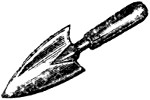
TROWEL.
This is a most important operation, and is indispensable in the art of gardening. A vast number of seeds must be sown in beds, and afterwards transplanted into their final situations; this is particularly the case with regard to flowers. The instrument with which transplanting is performed is called a trowel, of which there are both small and large. In using it the principal thing to be attended to, is to take the best and most vigorous of the plants raised in the seedbed, without injuring their roots, and with the earth around them,[722] and placing them, with as little disturbance of their roots as possible, in their new situations. In transplanting shrubs, &c. from pots, the planter should very slightly break the earth round the roots of the plant, so that its fibres may have free play in the new earth. In transplanting shrubs, &c. particular care should be taken in digging them up, so that the young fibres of the roots are not injured. When shrubs, &c. are first transplanted, they should be moderately watered, and of course it is bad management to plant shrubs at a time when they are likely to suffer from sun. The right time to transplant is in the autumn and spring, when the ground is nice and dry, and “in good working order,” as gardeners term it.
Nature is the best waterer of plants, and it is good policy to leave the matter as much as possible in her hands; but we must assist her now and then by applying it ourselves. In watering, pond water is much better than pump water; and in warm weather, if no pond water can be procured, it is well to pump the water into some large tank or tub, and let it stand for some hours exposed to the sun and air before using it. Morning and evening are the proper times for watering; the middle of the day, or during a hot sunshine, is a very improper time for using the watering-pot in summer-time, although it is the best time for using it in the winter. In watering plants in flower-pots the finger should be first passed round the pot where the mould joins the sides of the pot, so as to close up the little crack or crevice between them, otherwise the water will pass down this crack, and go out at the hole at the bottom of the pot without affording it any benefit. In watering, never let the water pass from the watering-pot close to the stem, but rather turn up the earth in a little circular space for a few inches round the plant, so that the water may soak down to the extremities of the roots, where the spongelets are which draw up the nutriment from the earth to support the plant. When you water, water well and thoroughly, and then there will be little need to do it often. To water frequently, and give a little at a time, is very bad gardening.
Plants are reproduced or propagated in various ways; some by seeds, some by offsets, as tulips and hyacinths; some by dividing the root, some by layers, some by cuttings. Currant and gooseberry-trees, as well as rose-trees, and also the vine, are propagated by cuttings; i. e. pieces of the young last-year branches are cut off about six inches in length, and, the top being taken off, are placed with the thickest end in the ground. Strawberries are reproduced by dividing the root, or by taking the runner which the plant has itself fixed in the ground as the nucleus of a new plant, and putting it in a proper situation. Raspberries give out suckers from the parent root, which may be taken off and replanted, like the lilac, the rose, and many other plants; but in taking them off, which is generally done by a spade, they should be taken pretty near to the parent stem, and should have fibrous roots attached. In taking offsets, such as those of bulbous roots, it is only necessary to take those which nature herself separates from the parent bulb; in tubers, such as the artichoke and potato, the tubers of middle size are to be taken and planted; or in regard to the latter root, the eyes or shoots only are sometimes planted, the root being cut into various portions.
If we observe the strawberry plant, we find that at a certain season of the year it throws out offsets, and at certain distances a knob or knot arises, from which roots shoot into the earth, while from its upper centre a bud appears, and then a new plant is formed. The process of layering is to artificially produce this, and similar operations of nature. Some plants throw out roots whenever their stump or branches come in contact with the soil, but others require the assistance of art. The art of layering, therefore, consists in taking the shoot of a growing plant as near the root as possible; this is first to be cut half through, and then a slit is made in an upward direction, and, a piece of twig being placed in the divided part, the shoot is pegged down with the joint buried in the ground. After a time this joint begins to throw out roots, and when these are firmly established and begin to draw nutriment from the earth, the shoot may be detached from its parent stem, and it then becomes a new plant. Layers may be made in the spring months, and also in the month of July.
Are cuttings of carnations, pinks, &c. They are tubular stems, having joints at certain distances, and they are pulled asunder by the fingers at these joints; the lower leaves are then pulled off, and the pipe is placed in some nicely prepared soil, leaving its upper portion, consisting of the sprouting leaf bud, to grow, while the lower pipe shoots into a root.
Grafting, inarching, and budding, are generally performed in the month of March. The operation of inarching is sometimes performed by nature. When two branches of a tree lie in contact, the rough winds of winter often cause them to rub against each other, so that a wound is produced in one or both, and the juices that flow from the wounded parts gradually cause an incorporation of the substances, so that the two branches become united into one. This is not to be wondered at in branches of the same tree, or in those of the same kind, but it is a matter of some surprise to find that a tree bearing small and unpalatable fruit may be cut down, and the remaining part grafted with a scion from a species bearing large and delicious fruit, instead of the small sour fruit of the stalk. Thus it is then that by grafting, we preserve and multiply a favoured variety of trees which could not be propagated from seeds with any certainty of success.
In order to the full success of this operation, grafting must be performed according to the rules that experience has laid down. The first is to graft or unite only such species as have a relationship subsisting between them. The operation never succeeds unless this union of nature is attended to, and the plants belong to the same genus. The next rule requires that the inner bark of the scion, and the inner bark of the stalk, be exactly united together, in order to facilitate the free course of the sap.
The most common method of grafting is whip-grafting, or tongue-grafting. The name of whip-grafting is given from the method of cutting the stock and the scion sloping on one side so as to fit each other, and then tying them together in the manner of a whip-thong to the shaft or handle. The scion and stock are cut obliquely, and as nearly as possible at corresponding angles. The top of the stock is then cut off nearly horizontally, and a slit is made near the centre of it downwards, and a similar one in the scion upwards. The tongue, or wedge-like process forming the upper part of the sloping face of the scion, is then inserted downwards in the cleft of the stock, the inner barks being brought closely to unite on one side so as not to be displaced by tying, which ought to be done immediately with a riband, or matting, or bass, brought in a neat manner several times round the stock. The next operation is to clay the whole over an inch thick all round, for about half an inch or more below the bottom of the graft to an inch over the top of the stock, finishing the coat of clay in a kind of oval form, closing it effectually, so that no light, wet, nor wind, may penetrate.
Tongue-grafting is not very different to whip-grafting, and is performed as follows. The stock being ready, cut it off at three or four inches from the ground, and, with a very sharp, straight, and narrow-bladed[725] knife, cut a thin slip of wood and bark upwards from about two inches below the top of the shortened stock. Make this cut at one pull of the knife, inserting the edge rather horizontally, and when it has gone through the bark and into the wood a little short of the middle, pull straight upwards. Then at less than half-way down this cut a thin tongue, not more than three-eighths of an inch long. Proceed in the same way with the thick part of the scion, making a sloping cut of about the same length as the cut of the stock, and make a tongue to correspond with that in the stock. Bring the four edges of the bark, that is, the two edges of the cut in the top of the stock and the two corresponding edges of the cut in the bottom of the scion, to meet precisely, which can never be the case unless the first cut in the stock and that in the scion is even as a die, and performed with a knife as sharp as a razor. The two parts thus formed, the tongues and the stock clasping one another must be bound up as before.
Budding is the art of taking a bud from one tree and making it grow on another. A bud can only be planted upon a tree of the same kind as itself, and the operation is generally performed in the month of August. The bud should be taken from a shoot of the same year’s growth, and, in taking it, should be neatly cut out by incisions made above it, below it, and longitudinally on either side, and the piece taken should include the bud, without injury to the bark, and a small piece of wood of an oblong form pointed at its extremity. A place is now cut to receive the bud in the shoot of a stock, and the best place is near the fork of a branch; the method of cutting is similar to that adopted for taking out the bud, and the bark is open on both sides of the slit, and the piece of bark to which the bud is attached is then filled in, and the bark of the stock closed over it; the two parts are then bound together with strips of fresh matting tied in bows and ends, for the purpose of being easily loosened as the bud increases in growth. The operation of budding requires the aid of a budding-knife, which may be readily purchased, and the success of the operation depends upon the care and nicety with which it is performed.
We have already mentioned how nature performs what is called inarching. The gardener’s art consists simply in bending a branch partly cut through, and inserting the belt thus formed into a slit made downwards in the stock to receive it. The parts being nicely fitted are bound with matting. In five or six months the head of the stock may be cut off, and the plant removed.
Most of the operations of grafting require clay to be put round the parts. This is made of three parts of stiff yellow clay to one of horse-dung fresh as it falls, with a little cut hay, well mixed together; another kind of clay is made of a pound of pitch and a pound of yellow wax, mixed with two pounds of cow-dung. The use of them in covering the grafting posts is to keep them moist and cool till a proper union has taken place.
The proper time for pruning trees is in December or January, for then the sap is down, and no injury can be done; and the art in pruning consists in cutting away the “water shoots,” or non-bearing wood, “dead wood,” and “superfluous wood.” The water shoots, as they are called, appear to be strong growing branches, but generally produce neither flowers nor fruit; the superfluous wood are those shoots which grow in the way of each other, or cross each other, which should always be removed. The great principle in pruning a fruit tree is to leave all the tree free and open, so that the air and sunshine may pass through it, and to preserve the buds of the bearing wood. The shoots should be cut off as near to the stem or branch as possible, and all growths or suckers which appear below the crown of the tree should be taken off. The present practice of thumb-pruning is very excellent; by this means the superfluous shoots, &c., are removed by the thumb nail as soon as they appear, and thus the tree does not exhaust itself by the growth of useless wood. The young pruner should be very careful in cutting away, and recollect that what he cuts off he cannot put on again.
The training of trees applies principally to those that are fastened to wooden trellises, to poles, or to walls. The principle of the art is to extend the bearing branches of a tree or plant, so as to improve its growth, its beauty, and its produce. Peaches, nectarines, apricots, vines, &c., are trained against walls by shreds of cloth being placed round the branches, and the two ends nailed to the wall. In doing this, care should be taken to give the branch room to play, and yet to confine it, not to hurt the tender fruit-shoots in the operation, and to let all the branches be free of each other. Roses and jasmines are often trained round verandahs by their different parts being tied with ropes’ end or tarred twine to different parts of the trelliswork. Sometimes flowers are trained by being tied to stakes or long poles, and others are brought to pass through the round of an ornamental ladder, or through the meshes of wirework of different forms. But in every kind of training the principle is the same, namely that of keeping the branches clear of each other, and of preserving the flowering and bearing shoots. Neatness and taste are also indispensable[727] requisites to the training and management of trees and flowers, whether for use or ornament.
There are various kinds of depredators which find their way into gardens;—worms, slugs, caterpillars, moles, ants, birds, butterflies, snails, &c. These must be got rid of, or kept down, otherwise the gardening labours are soon at an end. In wild nature all the above “vermin,” as some people designate them, are of the greatest service in some way or other; even worms and moles, which are very destructive in gardens, are of great service on commons, and therefore in destroying them we should always do so with as little pain as possible to the individuals; and, as prevention is better than cure, the young gardener should look out in winter for the eggs of various moths and butterflies, which may be often seen encircling the twigs of trees, or under the eaves of paling, &c., and destroy them. Caterpillars are best got rid of by picking them from the plants; and slugs, and snails, and worms, are often eradicated by turning a brood of young ducks into the ground for a short time, where they can do no injury to the beds. They may also be entrapped by laying cabbage leaves in different parts of the garden, under which they will creep in the night time. Moles must be caught with a mole-trap set in the line of their march. It consists simply of a bent stick, and a wire formed into a noose, slightly attached to the neck of a peg, into which the animal runs his head and gets strangled, by the elasticity of the rod drawing up the noose when the peg is disturbed. Ants are best got rid of by destroying their nest and eggs, the latter of which are excellent food for young chickens, pheasants, &c. The most destructive insect is the aphis, which attacks the rose, and this is best destroyed by the fumigation of tobacco-smoke, either through a pair of common bellows, or by means of the whirl-fumigator, which may be purchased for a few shillings; but the most certain mode of destruction is to obtain a few “golden beetles,” and put near the plants infected by aphides; these are their natural enemies, and where they are placed the aphides will soon become extinct.
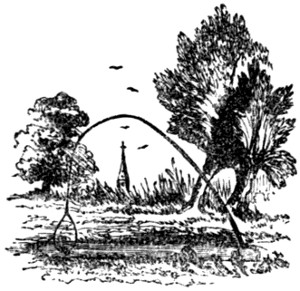
The common trees and fruits of the garden require but little care as regards frost in our comparatively mild winters, but many plants, trees, and shrubs, coming originally from warmer climates, require much attention during winter to keep them alive. It is useless to[728] attempt preserving geraniums, myrtles, and a great many of our common summer plants, without keeping them through the winter in a greenhouse of some kind or other. A small greenhouse may now be cheaply erected, but for the preservation of a small number of plants the greenhouse pit is the cheapest and most convenient substitute. It consists only of a hole twelve feet by four dug in the ground to the depth of six feet, having at the top a skylight. It should if possible be dug in a sheltered situation, open to the south and well backed behind, and the glass-top, which should merely consist of one frame laid in a slanting position to the south over the top of the hole, the back of which is raised to support it, the front being slightly lowered. The entrance to the pit is at the side, to which a stout wooden door nailed over with straw bands should be attached, and two or three steps should lead to the interior of the pit, where a few shelves may be arranged upon which to place the flowers, &c. In this pit flowers, cuttings, bulbs, and a variety of other things, may be preserved through the winter, with very little cost or trouble, and it will be of a great deal of use in many other respects.
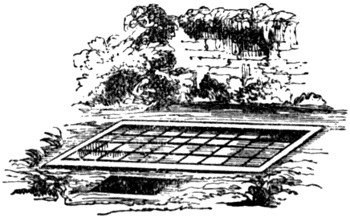
In January, if the weather will permit, manure the ground, and dig the manure in. Plant out some strong early cabbage in warm situations: plant early kinds of Windsor beans. Sow peas, early Warwick, in drills two feet and a-half asunder; sow a first early crop of spinach; sow early radishes, and cover them with straw two inches thick, then uncover every mild day, and cover again in the evening. Plant in the flower border the various bulbs, such as snowdrops, crocuses, daffodils, jonquils, &c., and also their offsets. Plant also the hardy herbaceous plants, such as asters, golden rods, campanulas, Canterbury bells, &c. Keep gravel walks clean.
Peas, beans, spinach, lettuce, carrots, parsnips, beet, &c., may now be sown; and in hotbeds cucumbers, small salading, melons, lettuce, &c. Give air to plants under frames in the natural ground. Dig and prepare the compartments of beds and borders; sow many sorts of hardy annual flower seeds; the tender sorts in hotbeds, such as larkspurs, candy-tuft, yellow lupines, pansies, virgin stock, sweet scabious mignonette, ten-weeks stock, &c. And for edgings of border, plant box, thrift, daisies, parsley, strawberries, &c.
Still continue to prepare an appropriate ground by digging and manuring, sow again peas, beans, &c., if necessary, and especially a bed of turnips. Now is the time also to sow small herbs, as thyme, savory; you may also now plant various slips or cuttings of rosemary, rue, wormwood, and lavender. These should be the outward shoots produced last year, five or six inches long, and should be planted in a shady border, six inches apart. Now also may be sown nasturtiums, which may be sown in patches, dibbed in six inches apart, or in drills, near a rail or running fence. Potatoes may also be now planted in open weather. In planting them, take care to get the best sorts, and pick out some of the finest of a moderately large size, and then divide the tubers into two or three parts, leaving an eye or two to each; plant the pieces in rows about eighteen inches from each other, and about four inches deep. Now also is the time for pruning the various fruit trees, planting fresh sets of raspberries, strawberries, &c. In the flower garden the tender annuals are to be sown in hotbeds, such as cockscomb, balsam, china-aster, tobacco, convolvulus, &c. Ranunculuses, anemones, and the hardy annuals, may be sown in the open ground, and transplanting of all kinds of plants, shrubs, &c., may now be performed.
This is a transplanting month, particularly for cabbages and cauliflowers, all which should be now taken and put out for summer use. Celery should also now be pricked out. Continue to plant, if necessary, pot herbs and sweet herbs, such as rooted slips of balm, penny royal, and camomile. It is a good time also to plant out slips of mint from the roots; other crops of peas may also now be sown, as also a late crop of beans. Now also you may sow gourds and pumpkins in a frame. All pruning must be finished. Insects must be looked after on fruit trees. Vines may be laid down in layers; wall-fruit thinned; strawberry beds weeded, and kept very clean; new-budded and new-grafted trees well examined to see if the clay keeps close to the grafts. In the flower garden or borders some of the tender annuals may now be pricked out, and some of the others sown[730] in the frame, such as Prince’s feather, capsicum, love-apples, Indian corn, gourds, sweet balsam, marvel of Peru; stocks, and the hardy annuals, may now be sown in the open ground, as Adonis poppy, sweet peas, catch-fly, annual sunflower, larkspur, lupines, Venus’s looking-glass. The best way to sow sweet peas is in pots, and protect them well from the birds, who will otherwise not leave one. Inarching may now be performed on evergreens and other plants, which you may wish to propagate this way.
Lettuces will now want tying up. Peas will require sticking. Do not tie your lettuces up too tightly, and when you stick your peas put in the stick in a slanting direction. Clear and thin carrots and parsnips, leaving the largest plants at least four inches from each other; thin also onions; plant out cauliflowers. Sow brocoli seeds for the crop to come in on the following winter and early spring. Sow and plant savoys; top the broad beans that are now in blossom, which will make the pods set sooner and swell faster. Plant the various kinds of French beans, such as the white speckled, in drills about three feet apart, and sow them thin. Prick out and plant celery; continue to sow radishes and small salading for daily use. Water new planted crops, and now let more than common care be taken to destroy weeds amongst crops of every kind; and now is the time for using your Dutch hoe freely among the rows of peas, beans, and spinach; but do not leave your weeds about in the drills or borders; clear all carefully away, and keep the garden clean and neat.
Look after your melons, pumpkins, gourds, and cucumbers, in frames; let them be well supplied with fresh air and water. To save cauliflower seed, mark some of the best and earliest plants, with the largest and whitest and closest flower heads, which should not be cut, but left to run to seed. Peas may still be sown, and French beans also, as may cabbage and colewort seed. Gather mint, balm, and other aromatic herbs, towards the end of this month, for drying. Examine any new planted trees, see that they are not too dry, and that they are well secured. Water should be given to those that show any symptoms of flagging; water them well, but not frequently. Take care that your strawberry beds are also well watered. Hang up nets before early cherry-trees against walls, and over small trees, to protect them from the birds. Most of the tender annuals may be now finally planted out, and now is the time to take up the roots of tulips, crown imperials, jonquils, &c., and to take away the offsets. Continue to support with sticks all the tall growing flowering plants. Cut box-edgings, and regulate your flower borders, keeping your plants well watered if the weather should be very dry.
You may now sow a batch of turnips for winter or autumn use, and also some carrot seed to raise young carrots for use later in the autumn. Celery may be transplanted, winter spinach may be sown, lettuces may be planted out, coleworts may be sown. Gather your cucumbers as they appear, and gather all sorts of seeds as they ripen in dry weather, pulling up the stems with the seed where it can be done. Bring out the cockscombs, double balsams, and all other curious annuals kept till this time in frames. Transplant annuals into the borders. Lay carnations and sweetwilliams; propagate pinks by pipings; transplant perennial plants. Take up bulbous roots, cut box-edgings, regulate your flower borders. Plant cuttings and slips of succulent plants; shift geraniums and other plants into larger pots, if necessary.
Cauliflower seed must be sown between the 18th and the 24th. Celery should now be transplanted into trenches, and lettuce planted out. In the end of the month the dry flower stems of aromatic plants, such as hyssop, sage, lavender, should be cut down. Now look well out for various seeds as they ripen, which gather by cutting or pulling off the seed-stalks, then place them in the full sun against a hedge or wall to get them thoroughly dry. All flowers should now be carefully attended, and watered when necessary. The pink pipings should now be planted out in beds, and the seeds of many bulbous flowers, such as tulips, hyacinths, lilies, may be sown to obtain new varieties. Flower borders should occasionally be gone over with a sharp hoe, after which they should be raked over neatly, and all weeds and litter cleared away.
Lettuces may now be planted in frames, or in very warm borders, for winter use. Brocoli, cabbage and savoy plants may also be planted out, and young plants pricked out into nursery beds. Celery should be earthed up, and you should tie up the leaves of endive to blanch the plants white. The spinach sown in August should be thinned and cleared out, and small salading should be sown once a-week or fortnight. Gather ripe seeds as before, and see that the birds do not devour them. Now is a good time to plant the strong runner plants into separate beds, and at about fifteen inches asunder either way. Towards the end of the month hyacinth and tulip roots may be planted, as well as any other bulbous root. Anemone and ranunculus seed may be sown, and perennial plants transplanted. Continue to keep the flower borders always very clean, and begin digging vacant beds and borders for future planting.
Now the apples and pears begin to ripen. Seeds are still to be looked for and preserved, vacant spaces of ground are to be dug up and manured. Fruit trees may now be transplanted, and currant and gooseberry-trees may be planted. Recollect that the currant-trees may be cut close down to the fruit buds, but the gooseberry only half way down the last year’s wood. Cut out irregular growths and suckers, and keep them trained to a single stem below. Strawberry beds should this month have their winter dressing of manure, and all the runners cleared away close to the head of the main plants. Raspberry plants may be pruned, the old stems cut away, and the last year’s suckers’ stems selected for the next year’s bearings, and each of them shortened one-third in height. In the flower-garden the borders should be nicely dressed, and all kinds of plants may be transplanted, or their roots divided, and bulbs not yet planted may be put into the earth. Plant all kinds of shrubs and evergreen trees.
Now is the time for digging up potatoes, and taking up carrots, parsnips, onions, &c., and storing them for winter use. Winter spinach should be weeded, and the red beet-root dug up. Onions may be pricked out to come in early in the spring. Trees may be pruned; all sorts of fruit trees and bulbous roots planted. Now tender plants should be removed to the pit or greenhouse.
Peas may be sown in a warm sheltered spot to come in early in the spring, as may Windsor and broad beans. Celery should be well earthed up, and all vacant ground manured, dug, or trenched. Secure the roots of newly planted trees from the frost by laying dungy litter round them, and the same may be done to the spots in which hyacinths, tulips, anemones, and ranunculuses are planted. Small young tender seedling flower plants also require care at this season. The borders may now be finally cleared and laid nice and smooth, the remainder of pot plants removed to the greenhouse or pit, which should be closed during the night, and only opened in fine mild weather; as the frost comes on place mats above the glass during the night, which should be removed in the morning. All leaves from trees, &c., should be collected in a pit for manure, free from sticks or stones, and the whole garden put into order for the frost.
“How can I become a ventriloquist?” is the frequent thought of a boy; and he is told, probably, that it is an exceptional faculty, and cannot possibly be acquired. This is not so; perseverance and practice are alone necessary to produce those wonderful results which never fail to captivate the public, if the student has a fair musical ear, and a talent for imitation which few boys are without. The deceptive nature of the sounds are the result of certain natural principles, which are called in to aid the experimenter. Those who have seen any professors of the ventriloquial art now living must have been struck by the apparent ease with which the effects are produced. This is not only the result of practice, but the careful attention to certain acoustic principles which regulate the direction of sounds. A sudden change in the direction of sound is oftentimes very perplexing to the ear, even when the eye can assist the other organs. The change of direction of the sound of a peal of bells, which is often interrupted by intervening buildings, is a familiar instance of this, their sound appearing to come from different places as the hearer changes his position. We can easily imagine that when the hearer is still, and the source of the sound moves, the deception becomes much greater, if skilfully applied to the purpose.
The first great secret is to take a full and deep inspiration, so that the lungs may be well filled, to be used as a Highlander uses the windbag of his bagpipes, as required. If we remember that the larynx, which is the cavity in the throat behind the tongue, is capable of considerable flexibility, as well as the trachea or windpipe, we have good materials for ventriloquial effect; thus the mouth and tongue have really, but not apparently, a great deal to do with the modifications of the assumed voice. A clever ventriloquist recommends the mouth to be kept closed, and the tongue rolled back, so as to regulate, as it were, the sound which is formed in the larynx. This may be done by strengthening the abdominal muscles; and it is probably from this being so frequently done, that the name of “belly-speaking” arose. The highest perfection of ventriloquism is speaking with the lips closed, and apparently without an effort of any kind. Some old and some modern professors had this marvellous power in perfection.
It has been recently observed that by constant practice the veil of the palate can be so exercised that it can be raised or depressed at will, so as to dilate or contract the inner nostrils. The effect of this contraction is the same as Mr. Hardy’s rolled tongue; it muffles, as it were, the sound, renders it weak and dull, as if coming from a distance. On the other hand, if the nostrils are dilated to any extent, the sound gradually becomes apparently closer and closer, because it is more distinct.
The uncertainty of the direction of sound greatly aids the ventriloquist. If a man and a woman are placed at either end of a tolerably large room, and each imitates with tolerable success the voice of the other, the confusion between the eye and the ear is so great that it becomes next to impossible to know which it was that spoke. It is thus necessary that the ventriloquist should either by word or gesture direct the attention of his hearers to the spot from whence they expect the sound to proceed. Really, in practice, there is little difference between the sound of a muffled voice, whether it is outside the door, above the ceiling, or down in the cellar. It is possible to acquire such a knowledge of the modifications of sound by distance, obstructions, or other causes, as to imitate them with wonderful accuracy. The late Mr. Love used to carry on a dialogue with a person in a box, and by a masterly modulation of his voice he gave it a muffled tone when he sat upon the box, and different degrees of sharpness as he gradually opened the lid.
The best practice is to begin with imitations only of different voices, until some progress is made. Then commence to practise the muffled voice until the audience are satisfied that it is done tolerably well, for the operator cannot judge of the effect it is producing save by experience. The voice may now be changed until the second voice is marked by some distinguishing characteristic, such as bass, alto, gruff, or speaking. Then the distant voice may be tried, to be modulated as before as success is attained.
A well-known ventriloquist used to make some excellent effects by speaking with a closed mouth when drawing an inspiration, instead of the usual method of speaking during the expiration of the breath.
We will suppose a ventriloquist about to give an illustration of his art. He first takes care that none of his audience are between the line of his mouth and the spot from which the sound appears to proceed. Thus the simplest cause of ventriloquial effect is produced by standing with your back to the audience and your face to the door. With closed jaws you direct a muffled voice against the door. The sound which reaches the ears of the audience is a voice apparently outside the door, but in reality it is an echo of the artificial voice only. Take a simple example. You knock at the door, and in your natural voice you inquire if anyone is there. Assuming the muffled tone, you say that “it’s a friend,” and then inquire his[735] name and business. The answers being given, you slightly open the door and the corner of your lips at the same time, and then the voice loses its muffled tone, and appears more distinct as it comes closer. The deception is more difficult to maintain, and the ventriloquist suddenly turns round and shows that the voice is in reality a mere shade.
If we try the ceiling voice, or the familiar “man on the roof,” we should use the upper notes, and reserve the lower notes for the “man in the cellar.” In either of these illusions the lips should not be opened at all. The modulation of tones should be managed in the larynx, by the action of the tongue only, unless the voice is supposed to come down the chimney into the room. In either case the mouth should be turned to the place from whence the sound is supposed to proceed; and when speaking in his natural tones, the performer should address himself directly to the audience; always using appropriate gestures to signify the ascent or descent of the owner of the fictitious voice.
These two voices are in reality the only true ventriloquial voices. The variation of tone and accent depends more on the organs of imitation than on true ventriloquism, though when both arts are combined the effect is so much enhanced as to become perfectly marvellous. One of the simplest sounds to produce is that of the humming-bee, wasp, or bluebottle fly. The first sound is produced in the chest, the latter by the lips. It is always well to attempt to catch the insect after it has indicated its presence. This enables the sound to be raised in tone, and occasionally muffled when the offending suppositious insect is inclosed in the handkerchief.
The imitation of a knife-grinder is easily done, the grinding being produced by a sharp hissing sound through the teeth, and the “buffing” or polishing, by gently closing the lips and drawing the breath through them until they vibrate—a not uncommon schoolboy accomplishment. The sawing of wood, the frying of a pancake, the uncorking of a bottle, and the gurgling noise of pouring out the liquid, may all be successfully imitated; but these are much less striking and ingenious than true ventriloquism.

A person let his house to several inmates, who occupied different floors, and having a garden attached to the house, he was desirous of dividing it among them. There were ten trees in the garden, and he was desirous of dividing it so that each of the five inmates should have an equal share of garden and two trees. How did he do it?
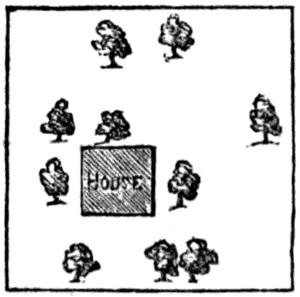
Draw six vertical lines, as below, and, by adding five other lines to them, let the whole form nine.
Take a piece of cardboard or leather, of the shape and measurement indicated by the diagram, cut it in such a manner that you yourself may pass through it, still keeping it in one piece.
In the centre of a piece of leather make two parallel cuts with a penknife, and just below a small hole of the same width; then pass a[737] piece of string under the slit and through the hole, as in the figure, and tie two buttons much larger than the hole to the ends of the string. The puzzle is, to get the string out again without taking off the buttons.
Get a piece of cardboard, the size and shape of the diagram, and punch in it twelve circles or holes in the position shown. The puzzle is, to cut the cardboard into four pieces of equal size, each piece to be of the same shape, and to contain three circles, without cutting into any of them.
Cut three pieces of paper to the shape of No. 1, one to the shape of No. 2, and one to that of No. 3. Let them be of proportional sizes. Then place the pieces together so as to form a cross.
Cut seventeen slips of cardboard of equal lengths, and place them on a table to form six squares, as in the diagram. It is now required to take away five of the pieces, yet to leave but three perfect squares.
Cut a piece of cardboard about four inches long, of the shape of the diagram, and make three holes in it as represented. The puzzle is, to make[738] one piece of wood pass through, and also exactly to fill, each of the three holes.
Twenty-four nuns were arranged in a convent by night by a sister, to count nine each way, as in the diagram. Four of them went out for a walk by moonlight. How were the remainder placed in the square so as still to count nine each way? The four who went out returned, bringing with them four friends; how were they all placed still to count nine each way, and thus to deceive the sister, as to whether there were 20, 24, 28, or 32, in the square?
The dogs are, by placing two lines upon them, to be suddenly aroused to life and made to run. Query, How and where should these lines be placed, and what should be the forms of them?
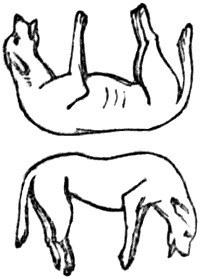
How can be cut out of a single piece of paper, and with one cut of the scissors, a perfect cross, and all the other forms as shown in the cuts?
With three pieces of cardboard of the shape and size of No. 1, and one each of No. 2 and 3, to form a cross.
A is a wall, B C D three houses, and E F G three fountains or canals[739] It is required to bring the water from E to D, from G to B, and from F to C, without one crossing the other, or passing outside of the wall A.
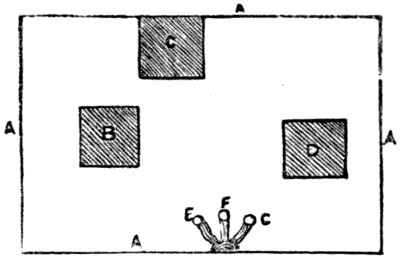
A cabinet-maker had a circular piece of veneering, with which he has to veneer the tops of two oval stools; but it so happens that the area of the stools, exclusive of the hand-holes in the centre, and the circular piece, are the same, (as that of the circle.) How must he cut his stuff so as to be exactly sufficient for his purpose?
Get an oblong strip of wood or ivory, and bore three holes in it, as shown in the cut. Then take a piece of twine, passing the two ends through the holes at the extremities, fastening them with a knot, and thread upon it two beads or rings, as depicted above. The puzzle is to get both beads on the same side, without removing the string from the holes, or untying the knots.
Cut a circular piece of wood as in the cut No. 1, and four others, like No. 2. The puzzle consists in getting them all into the cross-shaped slit, until they look like Fig. 3.
Place ten halfpence in a row on the table. Then take up one of them and place it on another, never in any case passing over more than a penny (that is to say, two halfpence). Repeat the operation until no halfpenny remains by itself in the row.
You are to read the following directions:—
If your B m t put :
When your IS . putting :
A well-known miser once invited his tenants to dinner at an inn, and to the surprise of the landlord, asked him to join the party. When the bill was brought in, the miser proposed that they should cast lots who should pay the whole score for the twenty-one persons who had dined. It was agreed that they should be counted by the days of the week, and that every time the counter called “Saturday,” the person so named should leave the room until there was only one man left, and he should be paymaster. How did the miser contrive to throw the expense on the landlord?
An old country squire planted a number of oaks when his son was born, and on the twenty-seventh birthday of the young man there was a tree for every year, and yet though there were only 27 trees, there were ten rows and six trees in each row, which made sixty, the age of the squire himself. How did he manage it?
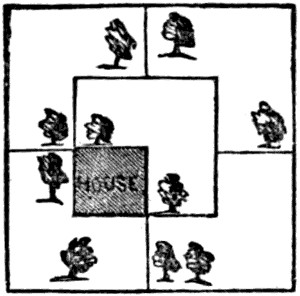

Double the cardboard or leather lengthways down the middle, and then cut first to the right, nearly to the end (the narrow way), and then to the left, and so on to the end of the card; then open it and cut down the middle, except the two ends. The diagram shows the proper cuttings. By opening the card or leather, a person may pass through it. A laurel leaf may be treated in the same manner.
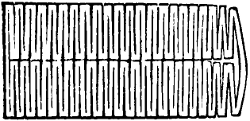
Draw the narrow slip of the leather through the hole, and the string and buttons may be easily released.

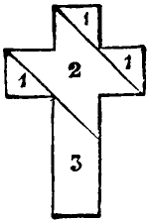
Take away the pieces numbered 8, 10, 1, 3, 13, and three squares only will remain.

Take a round cylinder of the diameter of the circular hole, and of the height of the square hole. Having drawn a straight line across the end, dividing it into two equal parts, cut an equal section from either side to the edge of the circular base, a figure like that represented by the woodcut in the margin would then be produced, which would fulfil the required conditions.

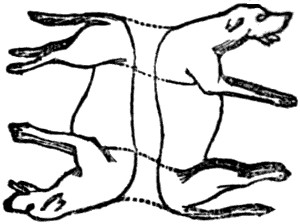
Take a piece of writing paper about three times as long as it is broad, say six inches long and two wide. Fold the upper corner down, as shown in Fig. 1; then fold the other upper corner over the first, and it will appear as in Fig. 2; you next fold the paper in half lengthwise, and it will appear as in Fig. 3. Then the last fold is made lengthwise also, in the middle of the paper, and it will exhibit the form of Fig. 4, which, when cut through with the scissors in the direction of the dotted line, will give all the forms mentioned.
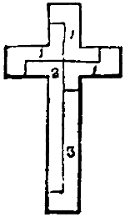
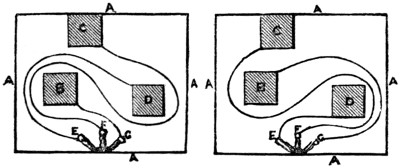
The cabinet-maker must find the centre of the circle, and strike another circle, half the diameter of the first, and having the same[744] centre. Then cut the whole into four parts, by means of two lines drawn at right angles to each other, then cut along the inner circle, and put the pieces together as in the above diagram.
Draw the loop well down, slipping either ball through it. Push it through the hole at the extremities, pass it over the knot, and draw it through again. The same process must be repeated with the other ball; the loop can then be drawn through the hole in the centre, and the ball will slide along the cord until it reaches the other side. The string is then replaced, having both balls on the same side.
This plan of passing the loop over the knot is a key to all the puzzles of this nature.
There is another and perhaps a neater way of performing this trick. Draw the loop through the central hole, and bring it through far enough to pass one of the balls through. Having done this, draw the string back, and both balls will be found on the same side.
Arrange them side by side in the short arms of the cross, draw out the centre piece, and the rest will follow easily. The reversal of the same process will put them back again.
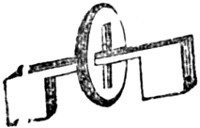
To perform this trick successfully, you must place the fourth on the first, seventh on the third, fifth upon the ninth, the second upon the sixth, and the eighth upon the tenth.
This puzzle should be read thus:—
If your grate be (great B) empty, put coal on.
When your grate is (great IS) full, stop putting coal on.
The counting, which stopped at every seventh man, was made to begin at the sixth from the landlord, who sat at the end of the table.
The trees were planted in this form:—
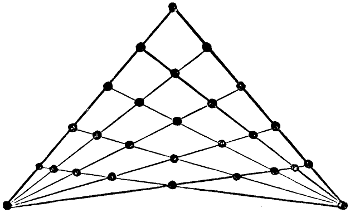
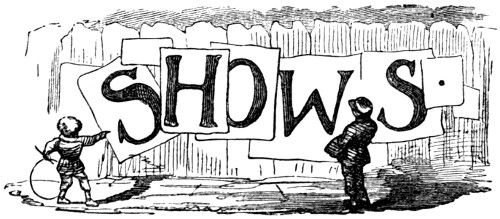
Under this head we describe those shows which may be exhibited by any ingenious youth for the amusement of a large circle of friends. Parents frequently employ the itinerant Punch-and-Judy man to astonish and delight a juvenile party with his comical puppets; and we are convinced that they act wisely, as children of all ages enjoy nothing so much as a good show. The reader, by following our directions, may exhibit the freaks of Punch and Judy, the dancing figures of the Fantoccini, the grotesque shadows of the Gallanty Show; in fine, he may become quite an expert showman.
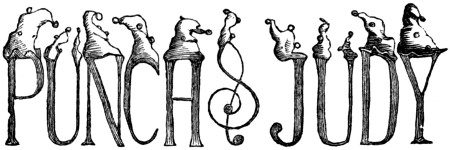
By following our directions, the reader may, with comparatively little trouble, construct some comical puppets, and acquire sufficient skill in working them, to give private representations of the celebrated drama of “Punch and Judy,” which never fails to excite the laughter of old and young.
In carving the heads of the puppets, the ingenuity of the reader will be most severely taxed. Each head must be fashioned out of a piece of soft wood, with a sharp penknife, and then painted with oil colours. An old wooden doll will be a capital model for the reader to work from, only he must cut much deeper, in order to make the features of his puppets sufficiently prominent. Punch’s nose and chin may be[747] formed of separate pieces of wood, and then fastened on to the face with a little glue. Our artist has drawn a full-length figure of Punch (see next page), and the faces of the other characters in the drama—namely, 1. Judy; 2. Beadle; 3. Foreigner; 4. Ghost; 5. Doctor; 6. Clown; 7. Jones; 8. Hangman. The carver should study these illustrations attentively, and endeavour to imitate them. The eyes of the Ghost are two black beads, which may be fixed by pins, or loosely attached by short pieces of thread, so that they may roll about in their saucer-like sockets. The eyes of the other puppets may be formed of white beads, fixed by black-headed pins in small cavities made to receive them. The hair and beard of the Foreigner, and the Clown’s three tufts, may be made of any kind of fur; the Hangman’s wig, and the Doctor’s scanty locks, of worsted. Each head should be about the size of an ordinary hen’s egg, and should have a hole made at the bottom, large enough to receive the tip of the showman’s finger.
Punch is the only puppet that exhibits his legs to the audience, and therefore the only one requiring lower limbs; these legs, as well as the hands of all the characters, are to be cut out of wood and painted.
The cloth figures of the puppets must be so constructed, that the exhibitor can easily slip them over his hand and wrist; to these hollow bodies the heads and hands are to be securely fastened with a little glue, or some small tacks. Punch’s figure may be formed of red merino, or any other gay-coloured stuff; the “goodly hunch” and prominent stomach must not be forgotten; these important appendages may be stuffed with cotton or tow. Judy’s dress may be made of cotton print; the Beadle’s, of blue cloth, edged with gold lace; the Foreigner’s, of almost any kind of stuff; the Doctor’s, of black cloth; and the dresses of Jones and the Hangman, of any sober-coloured stuffs. The Ghost must be enveloped in a long white linen gown; and the popular favourite, the Clown, must be arrayed in the true pantomimic style. In constructing the dresses, the reader[748] will have his patience sorely tried, unless he can persuade a few young ladies to aid him with their nimble fingers.
Motion is given to each of the puppets by the showman’s hand, the forefinger of which moves the head, while the thumb and second finger work the two arms; the annexed engraving will elucidate this operation.
We have not yet alluded to two important characters in the drama—namely, the Baby and the eccentric dog Toby. Any little doll may be dressed in long-clothes to represent the Baby, so the reader may be spared the trouble of carving another head. The part of Toby is generally filled by a living performer, but as we do not suppose the reader to be the owner of a properly-trained cur, we recommend him to procure one of those barking or squeaking dogs which are sold at the toy-shops; with such a Toby, the fun of the piece will be increased rather than diminished.
Punch’s stick must be about a foot long, and quite half an inch thick; it must be formed of tough wood, as some rough work is performed with it during the progress of the drama. The gallows must be of the letter F form, and must have two holes bored through the end of the projecting beam; the cord having been knotted at one end, is to be passed through each hole.
Having described the puppets, we will now say a few words about the show in which they are to be exhibited. The dingy curtains which conceal the street performer of Punch, are supported by a tall rectangular frame of wood, which the reader could not imitate without considerable labour and some knowledge of carpentry. The show we recommend is simply a box about three feet square, open in front and at bottom; this is hung upon nails against the wall, above the head of the amateur showman, who is hidden from view by curtains which reach from the box to the floor. The box may be a large tea-chest inverted, with the lid and one of its sides removed. The inside of the box should be hung with green-baize, or any other dark-coloured stuff. A proscenium cut out of pasteboard, and tastefully[749] painted, should be fastened in front of the box, so as to conceal the unsightly edges of the wood. A shelf of wood about four inches wide should project beyond the proscenium, so as to form a little stage upon which Punch may drum his legs, lay down his stick, and place the dead bodies of his victims; this shelf may be fixed by screws passing through the two sides of the box.
During the performance the puppets must be kept in an open box hanging against the wall within reach of the showman.
The reader having prepared everything, should learn the drama, and practise the different voices which he intends to give to the different characters. He will probably be some time before he can acquire the peculiar squeak of Punch, which is generally supposed to be produced by an instrument called a “squeaker.” With none of squeakers we have seen could any distinct words be uttered, and we therefore recommend the reader to trust to his own powers of mimicry. With regard to the musical accompaniments, the amateur showman should get some kind sister or cousin to sit at the piano, the notes of which are much more pleasing than those of the Pandean pipes and drum.

About sixty years ago, a puppet-show was exhibited at the west-end of London, with the Italian title of Fantoccini, which greatly attracted the notice of the public, and was spoken of as an extraordinary performance; it was, however, nothing more than a revival of the old puppet-show, which drew crowded and fashionable audiences during the reign of Queen Anne, and rivalled the more pompous exhibitions of the larger theatres. In the present day Fantoccini are exhibited in the open streets by the itinerant showman, whose ragged coat and battered hat show how puppets have fallen in the estimation of the fashionable public.
Any ingenious youth may amuse and astonish a large circle of friends with an exhibition of dancing puppets, as the different figures are not difficult to construct, and their motions are very easily managed. The puppets may be common wooden dolls dressed up in appropriate costumes. The arms and legs are to be loosely attached to the bodies, so that they may be moved about in any direction by threads fastened to their extremities. These threads may be formed[750] of black sewing-silk, or strong black cotton. All the threads proceeding from the different limbs and joints of a puppet are to be attached to a stick in such a manner as to allow the figure to stand in a natural attitude; the annexed engraving shows two puppets thus supported.
The puppet-show may be formed in the following simple manner:—Take a tall, three-sided clothes-horse, and place its outer edges against the wall so that it may inclose a square space; then hang curtains or shawls over the horse, leaving no part uncovered except a rectangular space close to the floor in front; to this opening you may, if you think proper, fix a painted proscenium. Now place a small towel-horse, hung with black stuff, at the distance of a foot behind the proscenium, to serve as a background to the stage, and to conceal your legs while you are engaged in working the puppets: having done this, lay down a little green-baize carpet on that part of the floor which represents the stage, and your puppet-show will be complete. The puppets may be illuminated by candles placed on the floor in front of the proscenium. The spectators are to be stationed as far from the show as possible, so that they may not perceive the threads.
The performer takes his seat behind the small horse, and holding the stick to which the threads are fastened in his left hand, he manages the motions of the puppet with the fingers of his right hand. When the motions are very complicated, the showman may[751] attach the stick to a string hanging from a rod placed across the top of the show, and employ the fingers of both hands in working the figure. With very little practice the amateur puppet-man may acquire great proficiency in the art of giving lifelike movements to the dolls.
The reader may dress up his puppets in any fancy costumes, but he must endeavour to give to each its appropriate action. The following characters may perhaps be allowed to figure in his Fantoccini:—
This puppet, which is represented in our illustration, is a popular favourite. The doll should have whiskers of Berlin wool glued on its cheeks, and a trim black silk pigtail attached to the back of the head. It is to be dressed in the conventional naval costume, namely, a blue jacket, loose white trousers, and a straw hat. On its entrance it should be made to bow to the audience in a characteristic manner, by inclining its body and kicking one leg behind it. The Sailor’s Hornpipe is then to be struck up by the pianist, and the puppet made to dance to the music. If the showman can manage six strings at once, two threads, not shown in our illustration, may be attached to the knees.
May be dressed in a fanciful Eastern costume; a string is to be attached to the head, and another to each of the hands. A gilded ball, having a hole pierced through it, is strung on each hand-thread, and to each ball a fine silken thread is attached. Our illustration shows how the five threads are to be attached to the supporting-stick. A little practice will enable the showman to work this puppet so dexterously that the spectators will be fairly puzzled to tell how the rapid tossing and catching of the balls is managed.
This puppet may be dressed according to the reader’s fancy; its head is not fastened to the body, but is strung on a thread attached to the neck. When the showman has made the doll dance for a short time, he pulls the head from the body by means of a thread fastened to it, and makes the headless puppet dance on as if nothing had happened.
A puppet, dressed like a woman with a yoke of milkcans, makes its appearance and performs a country jig. Before the dance is concluded a little white doll jumps out of each can. The milkwoman tries to catch the dolls, but they fly out of sight. The trick is easily managed; to the head of each little doll is fastened a thread, which the showman pulls at the proper time. The yoke may be cut out of a piece of soft deal, and the cans may be made of pasteboard covered with tinfoil.
Our young readers may vainly turn over the pages of any existing dictionary to find the scientific alias of the heading of this article. We trust the omission will be soon supplied, Philately, or Postage Stamp Collecting, having reached the dignity of a recognised science.
The word is the English rendering of the French term Philatélie, bestowed by a distinguished Parisian amateur in substitution for what was called timbromania, the latter portion of which word caused an unpleasant association of ideas, and gave rise to many a sneer from the wiseacres who had not sense enough to understand the real utility of the pastime. It is derived from the Greek φίλος and ὰτέλεια, the nearest equivalent traceable in classical lore to a modern postage stamp.
To schoolboys in general be ascribed the honour of introducing the elegant and instructive fancy forming the subject of our dissertation. The young students of the college of Louvain in particular claim to have been the earliest collectors: thence the fancy spread over France and Germany, inoculating many an English pupil in continental seminaries, by whom it was transmitted home. Some Louvain scholars informed us last year that it had been long prohibited by the professors, as tending to induce inattention to their regular tasks! We think this a mistaken notion; convinced that a knowledge of geography, history, and the values of foreign coins is materially facilitated by the study of postage stamps; which, moreover, induces neatness, regularity, and a sure refuge from ennui on a rainy day. Before the reign of postage stamps, who ever heard of the obscure city whence emanates that unit of a strange set of five, engraved at page 759, or the equally mysterious Thurn and Taxis?
What can give a better idea of the chances and changes fewer than ten years have produced in the vast tract of land known as the[753] Danubian Principalities, whose stamps are representatives of Moldavia alone, of Moldo-Wallachia united, and of the same countries resuming their ancient denomination of Roumania, first under Prince Couza, now under Prince Charles of Hohenzollern?

At the head of this paper is a reprint of an engraving taken from an old work on ancient and modern posts, printed at Paris in 1708. It portrays the various methods of transmitting news in use before the present almost universal system. The left-hand tower bears a lighted beacon; on the top of the right and central towers are men supposed to be shouting messages to be passed onwards from place to place, in the way some of our young classical scholars will remember is mentioned by Cæsar, book vii. chapter 3. The carrier pigeon above, and the dog in the foreground, represent other well-known modes. The former was, and still is, common in the East, and by no means disused here in the case of races, prize-fights, &c.; the latter was employed by the Portuguese during their East Indian conquests, and has been used until a late period by the Peruvians and other Americans.
An early anticipation of the modern post-paid envelope is still in existence, appropriately addressed to the celebrated authoress of “Cyrus the Great,” the originator of ἄγγαρα (angara), or posting-stations; but, strange to say, Persia, the earliest postal pioneer, has not yet adopted the stamp system, though essays have been submitted to the State.
The Californian Pony Expresses, and the earliest emission of Buenos Aires, are exemplars of this primitive way of communication. The[754] last-named stamp has been supposed merely an essay; but we have seen it post-marked. A modification of the same is the Humboldt Express of Langton and Co. and a sort of travestie, the United States local of D. O. Blood.
Other methods of transmitting correspondence, &c. are typified by the sailing vessels of British Guiana, the steamers on the extinct stamps of Buenos Aires, and the Pacific Steam Navigation Company; those of La Guaira and the Russian for the Levant sea-ports. An American idea, even too go-ahead for the reckless Yankees, for we cannot hear that it was ever put in practice, is also here embodied.
Nearly two centuries after the plan was broached in Paris appeared the well-known absurd Mulready envelope, an extraordinary evidence of official vagaries, that such an abortion should have received preference over hundreds of essays, of which the cut pictures by no means the best!
The current envelopes for Great Britain, simple and compound, comprising every value from one penny to one shilling and sixpence, excepting only elevenpence and one shilling and fivepence, are certainly perfection; but are so little known or used that few are aware of other than the penny ones. We think our undeservedly vaunted[755] penny label far surpassed in its own style by that of the islands of Antigua or St. Vincent, and the St. Kitt’s essay here given.
In the third year after the introduction of postal labels in Great Britain, the canton of Zurich would appear to have entertained the idea of imitating our example, the wonderfully rare if not unique pair of essays bearing the date of 1843 testifying visibly to that intention. Brazil, however, in the same year actually produced its first set, and is entitled to all the merit of seconding this marvellously successful move of ours. This was the large figure series, continued in the same style till those lately superseded, of which the red 280 and the yellow 430 reis alone remain in use.
Although the Zurich above alluded to was never in circulation, a pair something like it was so, either in the same or following year. The canton of Geneva next followed the lead. One of its stamps is unique on account of the custom of dividing it when but half value was needed.
The canton of Basle next joined the philatelic ranks, followed after three years’ interval by Vaud and Neufchatel. A twelvemonth previously our transatlantic brethren in the United States started the 5 cents bronze bearing the head of Franklin, and the large 10 cents with that of Washington.
In the same year (1847) a decree for the adoption of postage stamps in Belgium was made, which was carried into effect a year and a half afterwards. Six months in advance appeared the beautifully engraved effigies of the French Republic; during the course of twenty years followed the counterfeit presentments of the Presidency, the uncircled, and the laurelled heads of the Emperor Napoleon.
The ensuing year witnessed emanations from Austria, Bavaria, Lombardo-Venetia, Prussia, Saxony, Sardinia, and the first of the[756] interminable issues of Spain: also the long solitary pair recording the abortive insurrection of Schleswig Holstein in 1848-50. The postal representatives of Schleswig, of Holstein, and of the two States in combination, now number two dozen!
This succession of stamps will ever possess a strong historical interest in consequence of their country’s connexion with the startling events attendant on the continental convulsions of 1866. A similar value in relation to European annals, entitling them to the style and title of Paper Medals, must be laid on the now extinct hosts of Hanoverian labels and envelopes, with those of the defunct office of Thurn and Taxis, overwhelmed by the needle-guns of Prussia, after an existence of more than three hundred years.
An approximate idea of the number of postage stamps, current and extinct, may be obtained from the latest edition of any good catalogue. That of Oppen’s Album (10th edition) contains about 2,800 distinct individual stamps, but includes no varieties of colour other than those recognised by the most fastidiously disposed collectors, such as the light and dark blues of Thurn and Taxis, first issue; neither does it take much note of proofs or essays, or any of railway or local British labels, or of differences in watermark or mode of perforation; which latter variations are now considered important by the higher order of philatelists.
The stamp-issuing localities amount at present to 122, 51 being in Europe; of these no fewer than seven have enlisted within the past twelvemonths, viz. Servia, the Virgin Islands, Guatemala, Salvador (see p. 758), Heligoland, Breslau, and Turk’s Island. The latter is exquisitely engraved, but with the exception of the pink, the colours are execrable. The first two, and the Breslau local are appended.
Excluding the United States locals, whose name is legion, as well as those of Hamburg, most of which are spurious, the emissions of Spain count the highest. They amount to nearly ninety impressions for general postal purposes, besides several telegraphic and exclusively official issues. The later portraitures of Her Catholic Majesty, if correct, prove how very well she carries her age, with[757] the assistance, perhaps, of some Spanish Madame Rachel. Compare one of the current set with those depicted at pages 759 and 767 and note the dates.
The United States of North America, and those of Colombia, or the Granadine Confederation, afford us each the liberal allowance of between fifty and sixty varieties in colour, device, or value: the stamps of the former country, which are usually models of choice engraving, bear almost invariably the heads of their worthies, such as the late President Lincoln, and General Thomas (Stonewall) Jackson.
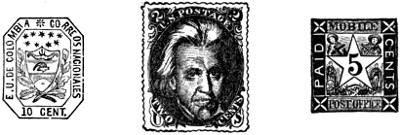
The memory of the great Confederate struggle will be ever preserved by the postage stamps issued from various cities in the revolting States; such as Memphis, Baton Rouge, Mobile, Charleston, New Orleans, &c. These had fancy devices, but the features of Jefferson Davis and J. C. Calhoun will reach posterity on two of the Confederate issues. On one of them also figures “Hickory” Jackson, a hero of the war in 1812.
It is a singular fact that the illustrated postage stamp magazines, &c. are purchased by non-philatelic collectors for the purpose of cutting out the miniature portraits of celebrities, whose effigies are otherwise less conveniently attainable.

The palm of beauty will be assigned nem. con. to the current pair of Nova Scotia types. There are three of each, one representing the[758] full front bust of our gracious Queen in state attire; the other Her Majesty’s profile: the former in scarlet, green, and black; the latter in lilac, blue, and black. Of these the pair of black are by far the most effective. One of them is more or less perfectly rendered by the Newfoundland 12 cents, and the South Australian two shilling, and fourpenny stamps; the other by the 24 cents of the former colony.
There are numerous other exquisite specimens of the engraver’s art to be found in a collection of postage stamps. The French republics, the Greek Mercuries, the Russian and Polish adhesives, and the Hong Kongs are admirable.
The current Saxons, Bavarians, all the Portuguese, and the lately emitted Heligolands are the best examples of the relief or cameo style: engravings of these give but a poor idea of the original. The same method of type is much less effective in the Prussians, Oldenburgs, Schleswigs and Holsteins; but radiates in full effulgence in the faultless envelopes of our own country, in those of Baden, Hanover, and the extinct Saxons and Prussians; with our colonials of Ceylon and the Mauritius.
The American Bank Note Company, we must perforce, most unpatriotically, admit to be unrivalled in plain engraving; of which the Nova Scotias, and some others noted above are instances: the trio of large newspaper and periodical labels issued last year in the United States, which bear the profiles of Washington, Franklin, and Lincoln respectively, and the Central-Fair locals too, are wellnigh perfection. The symbolical Newfoundlands are equally noteworthy.
To the same, or a branch firm, we believe ourselves indebted for the lovely landscapes of Guatemala, Nicaragua, Costa Rica, and Salvador.
The swans of Western Australia, repeated in such variety of colour, ever attract attention; as do the keys of Bremen, the castles of Hamburg, the compounds of mysterious Bergedorf, the eagles of Lubeck, the quaint emissions of the Argentine Confederation, and the crossed keys and tiara of the Papal States, after the eye is wearied by the incessant array of heads and armorial bearings exhibited by the majority of stamp-emitting countries.
The adhesives of the kingdoms once composing the Two Sicilies[759] are both equally remarkable; that of Naples for its singularity, that of Sicily from its peculiar boldness of design and rich colouring.

The first stamps of Luxembourg, those of the Dutch East Indies, and Holland, exhibit marvellous variations in the portraiture of one and the same individual sovereign.

The marketable value of a postage stamp for collections does not, however, by any means, depend upon its beauty or deformity. The greater portion of the more attractive in appearance are purchasable at a very low figure: the most beautiful of all, the Nova Scotian black profile, can be had at its natal place for one cent, or an English halfpenny. The circular specimen of meagre ugliness below may be worth a couple of sovereigns, even when cancelled; a moderately well-stored juvenile album could be purchased for the price of an unused specimen, were such existing, which we strongly doubt. That of Romagna and the early Van Diemen’s Land are little better.
Some of the frightful libels on the august countenances of the Emperor Napoleon, the Queen of Spain, and our own Sovereign,[760] fetch also exorbitant fancy prices. The French affair goes by the name of the Cayenne essay; possibly because its concoctor was, or at least, deserved to be, transported thither for his impudence. The Queens’ profiles on their colonial stamps for the Philippines and the Mauritius are mere caricatures.
Slight improvement on the British Guiana stamp is made by some of the Honolulu emissions; also the local Bavarian; the Bollo Straordinario of Tuscany; the 10 and 15 centimes à percevoir of France; and the Land Post trio of Baden. The latter have the advantage of being printed on yellow paper.
Some of the Sandwich Islands stamps, nevertheless, far outstrip the productions of some countries that were highly civilized long ere the full dress of one of their natives consisted of aught save a few beads. Portraits of the great, the late, and the regnant kings bearing the joint name of Kamehameha exist on stamps: the one given does but scant justice to its chastely designed original.

The French labels just alluded to are placed by the postal authorities on insufficiently paid letters. They are only surreptitiously purchasable at the post-offices, not being for public use; but this bit of red-tapeism is easily evaded for a con-sid-er-ation. Of similar character are the Bavarian before-mentioned, and the Italian segnatassa, figured above. A collector in Leghorn, unable to procure one of these latter, wrote a letter to himself without stamping it, expecting one of the then new labels to be affixed before delivery. Such was the case; but the letter lying on the hall-table, a friend of ours innocently abstracted the stamp and inclosed it to ourselves as the last new postal curiosity.
Besides such slightly abnormal deviations from the general run of postage stamps, may be enumerated the “too late” label formerly used by the colony of Victoria, now particularly recherché by philatelists, especially in an uncancelled state. This individual is unique in its application; but there are several impressions exclusively devoted to the registration of letters. Those of Victoria, New South Wales, and Queensland (like the cut, but the word “registered” substituted for the value) are well known; and the recently emitted Prussians, one of which is given on the next page, are of somewhat kindred nature.
The quaint centre device is an offshoot from that fertile field for philatelists, New Granada, alias the United States of Columbia; the R standing for registrados (registered).
Besides strictly governmental issues, many private firms and individuals have been tacitly allowed to issue postage stamps, more or less partaking of the character of regular official emanations. Such are those of the United States, amounting to upwards of five hundred; some of which, though catalogued, never did duty, and were only concocted for sale. They are now, we believe, all extinct. Some of them are represented on previous pages. The City of Hamburg has produced upwards of a hundred, of which the greater part are impostors. An unimpeached one will be found depicted farther on.
The pages devoted to the U. S. locals by those who collect them, present a most varied and extraordinary appearance, from the endless varieties of device and colour employed. Profiles, busts, figures of men and animals, numerals, plain inscriptions, symbolical and allegorical representations meet the eye, varied with all the colours in and out of the rainbow.
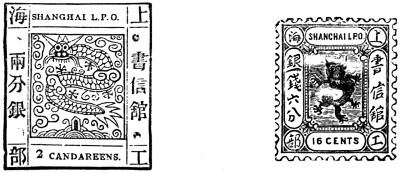
Dresden, Breslau, Montreal, Shanghai, Constantinople, Edinburgh, Glasgow, and London, also contribute their quota towards the ranks of locals. These are all emissions of private firms: those of the third place mentioned are more than doubtful; the latter are now prohibited by law.
To these may be added those of Throndhjems (Drontheim), Tammerfors, Helsingfors, with the Levant, Danubian, and Pacific Steam Companies. The legally authorised issues of Malta, the Danish West Indies, &c. and the very low values of continental stamps, may be likewise termed locals; not being available out of their own birthplace. The La Guairas, one of which is figured at page 754, must not be omitted from the list.
Still farther than the unaccredited locals from a strictly legitimate postal collection are the numerous labels issued by the several railroads. They amount to a considerable number altogether, ranging in value from one farthing to five shillings.
Many of the foreign telegraph stamps are extremely tasty, especially the Belgian and Spanish: these, however, are not usually admitted into collections. Still less are our own now disused “Customs” labels, which far exceed the postals in beauty; as do our receipt, bill, and legal adhesives, some of which are as high as 5l. or more in value.
The “needle-gun” war of 1866 introduced quite a novel genus of postage envelopes. They were employed in Prussia, Saxony, &c.; some for the use of civilians writing to their friends or relatives at camp; others for the exclusive service of the military. Some Brazilian youths, of more ingenuity than probity, concocted an imitation of these, and passed them off at a price among dealers and amateurs, as being employed for a similar purpose in the conflict between the Brazilians and Paraguayans.
The highest priced postage stamps were the once rare Pony Expresses (see page 753), one of which cost 4 dollars (16s. 8d.) The 2 dollar one ranks next; then the five shilling of New South Wales, the Mauritius, and our own; the 96 cents of Hong Kong, the 8 reales of Mexico, the 90 cents of the United States, the 1 scudo of Rome, and the 25 piastres of Turkey. The Ceylons are the most numerous in varieties of value, having no fewer than thirteen, from one halfpenny to two shillings. From four to six is the average number of monetary denominations for the same country. Some have more, as Hong Kong, which counts ten. The United States have the same number, besides four additional values in envelopes.[763] New South Wales has eight, and Victoria nine values. France has nine at present, but a higher priced stamp is announced. Liberia, Turk’s Island, and British Honduras have only three; Grenada, Nicaragua, British Columbia, and Antigua, issue but two; and Vancouver’s Island, Malta, Sierra Leone, and Corrientes, only one. The last-named locality, being a small province of the Argentine Republic, has issued the same die for two several values. It was originally marked un real, but this was subsequently erased, no designation of value appearing. Three centavos was then its price. It is impressed in black, on blue, as well as green paper. Like the New Caledonian, it was printed in sheets from a single block, each impression slightly differing.
This is one of the few exceptions to the rule of postage stamps bearing a facial value. The earlier issues of the Mauritius, Trinidad, and Barbadoes partake of the same defect, being distinguishable by colour only. The Ionian Islanders were in a like category: but the sole existing specimens of this inconvenience are the halfpenny and penny Barbadians, and the whole set of St. Lucias.
The result of this is, that the values of more than one of the early stamps of the Mauritius are still a subject of debate among some erudite philatelists. One of these stamps is sometimes found endorsed with “eightpence” in black letters, another with “fourpence.” This clumsy method is even yet being adopted in a few instances, we suppose to save the expense of a new plate. The original sixpenny of St. Helena is printed in three different colours besides its own blue, and does duty in green, carmine, and red, cruelly tattooed with printed characters according to the stated value. The ninepenny of South Australia, doffing its modest hue for a bright orange, hand-stamped with black, is worth a penny more than heretofore. In like manner, the Italian government, wishing to put the screw on its faithful subjects, raised the tariff on home letters from 15 to 20 centesimi, and barred out the original value. The provisional East Indian may be joined to this uncomely group of disfigured identities, as also the newly emitted set for Singapore.

The impressions of Nevis; those now current of the Cape of Good Hope; and what are termed the Sydney stamps of New South Wales, are elegantly symbolical of their respective localities.
The adhesives of British Columbia, Sierra Leone, and British Honduras, claim a very high rank for elegance of design and correctness of execution among our colonials. The extinct shilling stamp of Victoria may worthily dispute with its lately superseded sixpenny the unenviable distinction of ugliness.
Excluding the railway stamps, and the United States newspaper labels, Liberia produces the largest stamps; Mecklenberg Schwerin and Brunswick the smallest. The latter two countries present the singularity of allowing the four small stamps to be used singly or in combination.
The inscriptions on stamps being of course in the language of their native country, many impressions necessarily bear a particularly quaint appearance; as those of Egypt, Turkey, Cashmeer, Shanghai, Poland, Moldavia (see page 765), and Servia (see p. 756). The early emission of the Argentine Confederation is also an oddity.
The shapes of postage stamps present but little variation; a very large majority being more or less unequally sided rectangles. Few are perfectly square. The set of Bergedorf, and the disused Danish and Thurn and Taxis adhesives are instances, the former showing the further peculiarity of different sizes in regular gradation according to value. The impressions run sometimes on upright, sometimes on oblong rectangles. The narrowest of the latter is one of those of Wells, Fargo, and Co.; of the former, a very rare English essay, too elaborate for description.

Some few are octagonal, more or less irregular; some oval; some perfectly round; some indescribable, as the one-and-ninepenny Ceylon; and the ninepenny envelope of the Mauritius. The earlier[765] emissions of Nova Scotia and New Brunswick were printed in such a way as to render the stamp lozenge-shaped.
A small minority are triangular; the superseded stamps of the Cape of Good Hope, a solitary type of Newfoundland, and one of New Granada, are the only ones we can recollect ever seeing, except a black Austrian newspaper adhesive. The Langton local is unique in form.
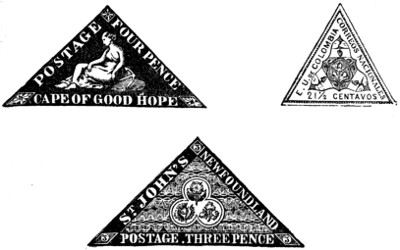
Many stamps have been issued exclusively for newspapers, feuilletons, and printed matter in general, such as some Austrian and Venetian impressions. The B. G. and tassa gazzette of Modena, the 6 c. and 9 centesimi of Parma, and others, were of like nature; as are the lower priced French, Italians, and Belgians. That of Frankfort is not adhesive, but hand-stamped, like those on our own newspapers, and is by some considered inadmissible in strictly postal collections.
The returned letter stamps must not pass unmentioned. That of Wurtemberg was long “alone in its glory;” but Munich, Augsburg, Nuremberg, and other Bavarian cities, have lately adopted them. Those forming the seal on returned letters in our own country are collected by some amateurs.

The enormous accumulation of proofs and essays, all which are ignored by many philatelists, are not to be lightly rejected. The former are certainly articles de luxe or fantaisie, being simply veritable stamps printed in abnormal colours, as some of the United States, &c. Of the latter are three sorts—those by authorisation; those proposed by enterprising individuals to various governments; and those invented for sale to entrap the unwary.
The best, as in the case of England, were not always chosen: look at the essay of Pellas the Genoese, and admire Italian discrimination—if you can. The Sicilian, on the other hand, is indubitably inferior to the adopted design. In the centre lies the audacious offspring of the Fenian rebellion.

Several essays proposed for Governments which have not yet instituted the postage stamp system, are surpassingly beautiful in device and execution. Those by M. Riester, of Paris, are particularly elegant, Bolivia for example. The Poisson d’Avril (April Fool) stamp is a curiosity in philatelic lore; it was gravely chronicled as emanating from Moresnet, and deceived the very knowing ones. (See cut at foot of next page.)
The longest reign in postal annals is twelve years; the defunct Dutch having lasted that period. Of the Spanish sets only two have outlived a twelvemonth unchanged. The 1 franc of the French[767] empire, and the first issue of Schleswig-Holstein (see p. 755), were current rather more, the 25 centimes of the Empire and the Italian (represented below) less than a year. The 1⁄2 tornese, Neapolitan arms, and the same transmogrified into the Cross of Savoy, endured each about a month. The 1⁄2 schilling violet, and 3 sch. rose of Bergedorf, were a nine days’ wonder.
Among the notabilities of a choice postage-stamp collection may be chronicled the Connel essay. A New Brunswick postmaster of that name took the liberty of having his own physiognomy transferred to a sheet of postage stamps;—the result was his resignation. The tenpenny above depicted is unique, and was long supposed to be from Van Diemen’s Land; but we rather believe it an English essay.
The space allowed us compels an abrupt conclusion. We had intended touching on the eight various distinct modes of perforation, besides variations; and the distinguishing watermarks of various issues. We should also have liked to describe the amusing and exciting humours of ‘Change, which many of our readers may remember witnessing in Lombard Street and its neighbourhood, or in the gardens of the Luxembourg and the Tuileries in Paris, during the early days of stamp-collecting; but we trust enough has been written to excite the interest of many who have purchased this volume on other accounts, yet may thus be induced to become votaries to the interesting and instructive pursuit of Philately.
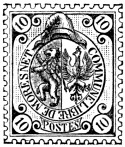
Should the reader feel inclined to try his hand at tinselling, he must procure one of those full-length theatrical portraits that are sold at the shops for a penny each. He ought to select one of the best-known figures, as he will then have no difficulty in procuring the embossed gold and silver work with which it is to be adorned. The whole figure must be carefully painted with water-colours, and the artist should take pains with those parts which are not intended to be covered or cut away. Having finished the preliminary operation of colouring, the artist should neatly cut away those parts of the engraving which represent drapery, and place under the spaces thus formed, satin, silk, or velvet of the proper colour, which may be secured to the back of the picture with a little gum.
Many tinsellers employ regular print-colourers to shade their silks and satins, but we strongly advise the reader to trust to his own abilities, and boldly set work to indicate the folds of the drapery by proper shadows. The pieces cut out of the engraving will show him where the different shadows ought to fall, and as for the colours to be used, we may state as a general rule that silk, satin, or velvet of a certain colour ought to be shaded with darker tints of the same colour. Gum-water should be mixed with the colours used in shading, to prevent them running when applied to the woven fabric.
The artist may now proceed to the work of tinselling, which consists in gumming little spangles and embossed ornaments over certain parts of the picture. Every piece of armour, every button, every jewel, and every weapon, should be represented in embossed work. All the pieces required for tinselling a figure may be purchased at the proper shops. In the figure of the warrior, the breastplate, shield, sword, and jewels would have to be formed of pieces of gilt or silver paper cut and stamped into proper shapes and patterns. The price of each piece of embossed work depends of course upon its size or elaborateness. When the picture is finished, it should be mounted on fine card-board, and placed in a neat frame.
The national game of ball of the American people, though having its origin in the English game of rounders, nevertheless possesses sufficiently marked features to entitle it to the distinction claimed for it. Unlike the schoolboy pastime from which it originated, it requires manly qualities in a high degree to excel in it. In fact, the difference between base-ball as played in America, and rounders as played in England, is as great as the contrast between the graceful and daring movements of an accomplished skater of the present time, and those of the skaters who, with pieces of ivory fastened to their feet, used to strive to glide over the ice in the year 1600. In base-ball, as in rounders, you use a bat and a ball and run round bases; but there all resemblance ceases.
The American game of base-ball, as now played, is not more than ten years old, for its date only extends back to the period just previous to the organization of the National Association of Base-Ball Players, which Association formed the present code of rules, and is the only authorized body having any supervisory power over the game. In fact, the history of the game commences with the formation of the National Association, inasmuch as the rules previously in vogue were crude and irregular, and different in one locality from what they were in another. Since the organization of the National Association and the meeting of the first annual convention, however, the game has spread throughout the country, and entirely superseded every other game of ball as a national pastime. At first the Association consisted of delegates from clubs, but now it is composed of a congregation of representatives from State base-ball associations, governed by the National Association proper, each State association having immediate control of the affairs of its own clubs, and possessing its own judiciary committee to settle disputes, but no supervisory control over the playing rules of the game, that matter being placed in the hands of a committee of rules of the parent Association, to which is also attached a judiciary committee, forming a court of appeal from the decisions of State judiciary committees, and also a court to adjudicate upon disputes between clubs of two States.
At the last convention of the “National Association of Base-Ball Players,” which was held in Philadelphia, Dec. 11, 1867, and in which clubs from all sections of the country, from Maine to Iowa, and Michigan to Kentucky, were represented, the following code of rules was adopted to govern the play during the season of 1868:—
Sec. 1. The ball must weigh not less than five, nor more than five and one-quarter, ounces avoirdupois. It must measure not less than nine and one-quarter, nor more than nine and one-half, inches in circumference. It must be composed of india-rubber and yarn, and covered with leather, and, in all match games, shall be furnished by the challenging club, and become the property of the winning club as a trophy of victory.
Sec. 2. The bat must be round, and must not exceed two and a half inches in diameter in the thickest part. It must be made of wood, and shall not exceed forty-two inches in length.
Sec. 3. The bases must be four in number, placed at equal distances from each other, and securely fastened upon each corner of a square whose sides are respectively thirty yards. They must be so constructed and placed as to be distinctly seen by the umpire, and must cover a space equal to one square foot of surface. The first, second, and third bases shall be canvas-bags, painted white, and filled with some soft material; the home base and pitcher’s points to be each marked by a flat plate, painted white.
Sec. 4. The base from which the ball is struck shall be designated the home base, and must be directly opposite to the second base; the first base must always be that upon the right-hand side, and the third base that upon the left-hand side of the striker, when occupying his position at the home base. And in all match games a line connecting the home and first base, and the home and third base, shall be marked by the use of chalk, or other suitable material, so as to be distinctly seen by the umpire. The base-bag shall be considered the base, and not the post to which it is, or should be, fastened.
Sec. 1. The pitcher’s position shall be designated by two lines two yards in length, drawn at right angles to the line from the home to the second base, having their centres upon that line at two fixed iron plates, placed at points fifteen and sixteen and one-third yards distant from the home-base. The pitcher must stand within these lines, and must deliver the ball as near as possible over the centre of the home base, and fairly for the striker.
Sec. 2. Should the pitcher repeatedly fail to deliver to the striker fair balls, for the apparent purpose of delaying the game, or for any cause, the umpire, after warning him, shall call one ball, and if the pitcher persists in such action, two, and three balls; when three balls shall have been called, the striker shall take the first base; and should any base be occupied at that time each player occupying it or them shall take one base without being put out. All balls delivered[771] by the pitcher, striking the ground in front of the home base, or pitched over the head of the batsman, or pitched to the side opposite to that which the batsman strikes from, shall be considered unfair balls.
Sec. 3. The ball must be pitched, not jerked or thrown, to the bat; and whenever the pitcher moves with the apparent purpose or pretension to deliver the ball, he shall so deliver it, and must have neither foot in advance of the front line at the time of delivering the ball; and if he fails in either of these particulars, then it shall be declared a balk. The ball shall be considered jerked, in the meaning of the rule, if the pitcher’s arm touches his person when the arm is swung forward to deliver the ball; and it shall be regarded as a throw, if the arm be bent at the elbow, at an angle from the body, or horizontally from the shoulder, when it is swung forward to deliver the ball.
Sec. 4. No player shall be put out on any hit ball on which a balk or a ball has been called; and neither shall a strike or a foul ball be called, or a base run on such a hit ball. But bases can be taken on third-“called” balls, and on “balked” balls, in accordance with Section 2 of Rule II.
Sec. 1. The striker, when about to strike the ball, must stand astride of a line drawn through the centre of the home base, not exceeding three feet from either side thereof, and parallel with the front line of the pitcher’s position, and he must not take any backward step when striking at the ball. The penalty for an infringement of this rule shall be the calling of one strike; and when three such strikes have been called, the striker shall be declared out. If a ball on which such a strike is called be hit and caught, either fair or foul, the striker shall be declared out. No base shall be run on any such called strike, and any player running the bases shall be allowed to return to the base he has left, without being put out. As soon as the striker has struck a fair ball, he shall be considered “a player running the bases.”
Sec. 2. Players must strike in regular rotation, and, after the first innings is played, the turn commences with the player who stands on the list next to the one who was the third player out.
Sec. 3. Should a striker stand at the bat without striking at fair balls, for the apparent purpose of delaying the game, or of giving advantage to a player, the umpire, after warning him, shall call one strike, and, if he persists in such action, two, and three strikes. When three strikes are called, and the ball be caught, either before touching the ground or upon the first bound, the striker shall be declared out, provided the balls struck at are not those on which balls or balks have been called, or not those struck at for the purpose of wilfully striking out. If three balls are struck at and missed, and[772] the last one is not caught, either flying or upon the first bound, the striker must attempt to make his run, and he can be put out on the bases in the same manner as if he had struck a fair ball.
Sec. 4. The striker is out if a foul ball is caught, either before touching the ground or upon the first bound; or if a fair ball is struck, and the ball be held before touching the ground; or if a fair ball is struck, and the ball be held by an adversary on first base, before the striker touches that base.
Sec. 1. Players must make their bases in the order of striking; and when a fair ball is struck, and not caught flying, the first base must be vacated, as also the second and third bases, if they are occupied at the same time. Players may be put out on any base, under these circumstances, in the same manner as when running to the first base.
Sec. 2. Any player running the bases is out, if at any time he is touched by the ball, while in play, in the hands of an adversary, without some part of his person being on the base.
Sec. 3. No run or base can be made upon a foul ball. Such a ball shall be considered dead, and not in play, until it shall first have been settled in the hands of the pitcher. In such cases players running bases shall return to them, and may be put out in so returning, in the same manner as when running to first base. Neither can a run or base be made when a fair ball has been caught without having touched the ground; but such a ball shall be considered alive and in play. In such cases, also, players running bases shall return to them, and may be put out in so returning, in the same manner as when running to first base; but players, when balls are so caught, may run their bases immediately after the ball has been settled in the hands of the player catching it.
Sec. 4. When a balk is made by the pitcher, every player running the bases is entitled to one base, without being put out.
Sec. 5. A player making the home base shall be entitled to score one run.
Sec. 6. If two hands are already out, no player running home at the time the ball is struck can make a run to count in the score of the game, if the striker is put out.
Sec. 7. Players running bases must touch them, and, so far as possible, keep upon the direct line between them, and must touch them in the following order—first, second, third, and home; and if returning, must reverse this order; and should any player run three feet out of this line, for the purpose of avoiding the ball in the hands of an adversary, he shall be declared out; or if he fail to touch each base he runs to he shall be declared out, unless he return to such base before the ball be held on it.
Sec. 8. If the player is prevented from making a base by the intentional[773] obstruction of an adversary, he shall be entitled to that base, and shall not he put out. Any obstruction that could readily have been avoided shall be considered as intentional.
Sec. 1. The game shall consist of nine innings to each side, when, should the number of runs be equal, the play shall be continued until a majority of runs, upon an equal number of innings, shall be declared, which shall conclude the game. An innings must be concluded at the time the third hand is put out.
Sec. 2. In playing all matches, nine players from each club shall constitute a full field; and they shall be members of the club which they represent. They also must not have been members of any other club, either in or out of the National Association, for thirty days immediately prior to the match. Positions of players and choice of innings shall be determined by captains previously appointed for that purpose by the respective clubs. Every player taking part in a regular match game, no matter what number of innings are played, shall be, in the meaning of this section of the rules, considered a member of the club he plays with.
Sec. 3. When a club sends a challenge to play a first-nine match game of base-ball, and the same is accepted, the first game shall be played upon the grounds of the challenging club, within fifteen days from the date of the acceptance of the challenge; the second game shall be played upon the grounds of the challenged club within fifteen days thereafter; and if a third game be necessary, it shall be played upon grounds to be mutually agreed upon, within fifteen days from the date of the second game; provided: that the above arrangement may be varied by mutual consent. And when a first-nine match game is to be played, the contestants shall present on the field their recognized first-nines, as far as practicable.
Sec. 4. Whenever a match shall have been determined upon between two clubs, play shall be called at the exact hour appointed; and should either party fail to produce their players within thirty minutes thereafter, the party so failing shall admit a defeat, and shall deliver the ball before leaving the ground, which ball shall be received by the club who are ready to play, and the same shall be considered as won, and so counted in the list of matches played; and the winning club shall be entitled to a score of nine runs for any game so forfeited, unless the delinquent side fail to play on account of the recent death of one of its members, and sufficient time has not elapsed to enable them to give their opponents due notice before arriving on the ground.
Sec. 5. No person who shall be in arrears to any other club than the one he plays with, shall be competent to take part in any match game.
Sec. 6. No player, not in the nine taking their positions on the[774] field in the third innings of a game, shall be substituted for a player, except for reason of illness or injury.
Sec. 7. No match game shall be commenced when rain is falling; and neither shall any such game be continued after rain has fallen for five minutes. No match game shall be postponed unless by the mutual consent of the contesting clubs.
Sec. 8. Every match game shall be decided by the best two games out of three, unless a single game shall be mutually agreed upon by the contesting clubs; and all matches shall terminate before the close of the season.
Sec. 9. No person who shall be in arrears to any other club, or who shall at any time receive compensation for his services as a player, shall be competent to play in any match. No players, who play base-ball for money, shall take part in any match game; and any club giving any compensation to a player, or having, to their knowledge, a player in their nine playing in a match for compensation, shall be debarred from membership in the National Association; and they shall not be considered by any club belonging to this Association as a proper club to engage in a match with; and should any club so engage with them, they shall forfeit membership.
Sec. 1. If an adversary stops the ball with his hat or cap, or if a ball be stopped by any person or persons not engaged in the game, no player running the bases can be put out unless the ball shall first have been settled in the hands of the pitcher while he stands in the line of his position.
Sec. 2. Any player who shall intentionally prevent an adversary from catching or fielding the ball, shall be declared out; or if any player be prevented from making a base by the intentional obstruction of an adversary, he shall be entitled to that base, and shall not be declared out, even if touched with the ball.
Sec. 3. If a fair ball be held by a player before touching the ground, after rebounding from the hands or person of a player, it shall be considered a fair catch. And if a foul ball be similarly held after touching the ground but once, it shall be considered a fair catch.
Sec. 4. If the ball, from the stroke of a bat, first touches the ground, the person of a player, or any other object, behind the line or range of home and the first base, or home and the third base, it shall be termed foul, and must be so declared by the umpire, unasked. If the ball first touches the ground either upon or in front of the line or range of those bases, it shall be considered fair.
Sec. 5. Clubs may adopt such rules respecting balls knocked beyond or outside of the bounds of the field, as the circumstances of the ground may demand; and these rules shall govern all matches[775] played upon the ground, provided that they are distinctly made known to the umpire previous to the commencement of the game.
Sec. 6. The captains of each nine shall alone be allowed to appeal for the reversal of a decision of the umpire.
Sec. 7. No base can be run, or player be put out, on a dead ball.
Sec. 1. The umpire shall take care that the regulations respecting the ball, bats, bases, and the pitcher’s and striker’s positions, are strictly observed, and he shall require the challenging club to furnish a ball, on which the size, weight, and the name of the manufacturer shall be stamped. He shall be the sole judge of fair and unfair play, and shall determine all disputes and differences which may occur during the game. He shall take special care to declare all foul balls and balks, immediately upon their occurrence, in a distinct and audible manner. He shall, in every instance, before leaving the ground, declare the winning club, and shall record his decision in the books of the scorers. The umpire shall also require that the game be recorded by a scorer for each of the contesting clubs. In all matches the umpire shall be selected by the captains of the respective sides, and shall perform all duties above enumerated.
Sec. 2. The umpire in any match shall determine when play shall be suspended; and, if the game cannot be fairly concluded, it shall be decided by the last equal innings, provided five innings have been played; and the party having the greatest number of runs shall be declared the winner.
Sec. 3. When the umpire calls “play,” the game must at once be proceeded with; and the party failing to take their appointed positions in the game within five minutes thereafter shall forfeit the game. When the umpire calls “time,” play shall be suspended until he calls “play” again.
Sec. 4. When the umpire “calls” a game, it shall end; but when he merely suspends play for any stated period, it may be resumed at the point at which it was suspended, provided such suspension does not extend beyond the day of the match.
Sec. 5. No person engaged in a match, either as umpire, scorer, or player, shall be either directly or indirectly interested in any bet upon the game. Nor shall any person be permitted to act as umpire or scorer in any match unless he shall be a member of the National Association, or of a State branch thereof. Neither shall the umpire or scorer be changed during a match, unless with the consent of both parties, except for reason of illness or injury, or for a violation of the above rules.
Sec. 6. No decision given by the umpire shall be reversed upon the testimony of any player; and no decision whatever shall be reversed, except for a palpable infringement of the rules, and then only on an appeal by the captain.
Sec. 7. No person shall be permitted to approach or to speak with the umpire, scorers, or players, or in any manner to interrupt or interfere during the progress of the game, unless by special request of the umpire. Any match game played by any club in contravention to the rules adopted by the National Association, shall be considered null and void, and shall not be counted in the list of match games won and lost.
For the information of clubs desirous of joining the National Association, or of organising a State branch thereof, we give below those portions of the constitution of the Association bearing upon the subject:—
Article 3, Section 1. This Association shall be composed of delegates from the several State base-ball associations which have been duly admitted to a representation in the convention forming this constitution, or which may be admitted to a representation in the manner hereinafter provided. Each State association shall be entitled to one delegate for every ten clubs, or fractional part of ten clubs, belonging to such association. No individual club shall be entitled to representation in this Association unless located in a state, territory, or district, where there are not sufficient clubs to form a State association. Each delegate shall be entitled to one vote, and no vote by proxy shall be allowed.
Sec. 2. Any State base-ball association desiring to be represented in this Association shall present to the recording secretary, at least thirty days previous to the annual meeting of this Association, a written official certificate, signed by the president and secretary of the State association they represent, giving the names and number of the clubs composing said association, date of their organization, names of their officers, and number of members belonging to each club; also the date of organization of the State association, and the names of their delegates. Territories and the district of Columbia shall be considered as states within the meaning of this section.
Sec. 3. All applications shall be immediately submitted to the committee on nominations; but no such application shall be received by said secretary unless presented thirty days previous to the annual meeting. Said committee shall thereupon ascertain the condition, character, and standing of such State base-ball association, and report the same at the annual meeting, with the said application and their opinion thereon; and a ballot shall thereupon be had at such meeting, upon the admission of such State base-ball association, when, if two-thirds of the members present vote in favour thereof, such State base-ball association shall be declared duly entitled to representation in this Association. Any informality or irregularity in the form or substance of the application may be waived by a two thirds vote of the members present at the annual meeting.
Sec. 4. No State association shall be represented in the Association unless composed of ten clubs, numbering at least eighteen active members each, or by any delegate under twenty-one years of age; nor shall any State base-ball association be so represented until its delegates have paid a fee hereinafter designated.
Sec. 5. Any State association organized after the adjournment of the annual meeting of this Association, may be elected probationary members thereof, after conforming to the requirements of sections second, third, and fourth, by the nominating committee. They shall be liable to the payment of dues and assessments, and be eligible to all the privileges of regular members of the Association until the next annual meeting, at which time they must be duly elected in the same manner as all regular members.
As before asserted, the American game of base-ball requires a high degree of physical ability, and the possession of manly characteristics to excel in it; for although in theory a schoolboy could easily comprehend the system, in practice an amount of manly vigour, courage, and physical endurance is requisite, surprising to those who regard the game in the light only of an improved edition of the old English school-game of rounders.
The theory of base-ball is as simple as that of any field sport in vogue, and therein lies one of its attractive features. But yet to play the game up to its highest point of excellence requires as great a degree of mental ability, and the possession of as many manly physical attributes, as any known game of ball. The theory of base-ball is as follows:—In the first place, a level field for play is selected, about three hundred feet wide and five hundred long. A space of ground is then marked out in the form of a square, with one corner as the position of the home base, and the other corners for the first, second, and third bases, the first base being on the right of the batsman, as he stands at home base, and the third base on the left. The contestants in a game consist of nine players on each side, and these nine players occupy the following positions: catcher, pitcher, first, second, and third basemen, short-stop, and left, centre, and right fielders. The first six players above-named form the “in-fielders,” and the last three the “out-fielders,” the nine taking the field being known as the “out-hand,” or “field.” After the parties toss for the innings, the losing side go to the bat, and the winning party to the field, and each man to his position. The pitcher then delivers the ball to the batsman of the opposite nine, who endeavours to send it out of reach of the opposing field party, and far enough into the field to admit of his running round the four bases, in which case he scores one run, provided he is not put out in the interim. He is followed by his companions, one after the other in regular rotation, until three of the batting side are put out, when the field side take the bat and[778] have their innings. Nine innings constitute a full game, and no game is considered as played unless five full innings have been completed. The ball—the only trophy in a match—goes to the party making the most runs in a full game, or in any number of even innings played not less than five.
In case of a tie at the close of the ninth innings, the game, unless by mutual consent, must be prolonged innings after innings, until one or other of the contesting sides obtains the most runs. And if anything occur to interrupt or put a stop to the game before five innings on each side have been played, the game must be drawn. The rules and regulations of the game define all further particulars in reference to it.
There are nine positions in a base-ball field, two less than in a field of cricketers in a match. The catcher plays behind the batsman to receive the ball from the pitcher. The pitcher stands near the centre of the in-field, forty-five feet from home base, and he is allowed only to “pitch” the ball to the bat, not to throw it, jerk it, or bowl it. The first base man attends to balls fielded to him on the base, his principal duty being to hold the ball, while having one foot on the base, before the batsman reaches it. The second and third basemen have not only to hold the ball, but also to touch players running to the bases before they can touch the bases. The short-stop attends to the duties of backing up the pitcher and basemen generally, and of stopping balls from the bat, and sending them to the bases, when the ball happens to come within reach. The principal duties of the three out-fielders are to catch long high balls, and to return in ground balls sent to their positions. But the following are special instructions to occupants of each position in the nine:—
This player is expected to catch or stop all balls pitched or thrown to the home base. He must be fully prepared to catch all foul balls, especially “tips,” and be able to throw the ball accurately and swiftly to the bases, and also to keep a bright look-out over the whole field. “Foul balls” are those high balls which are hit so as to fall to the ground back of the line of the bases, from home to first base and home to third. “Tips” are also foul balls, coming sharply from the bat to the catcher.
When a player has made his first base, the catcher should take a position nearer the striker, in order to take the ball from the pitcher before it bounds; and the moment the ball is delivered by the pitcher, and the player runs from the first to the second base, the catcher should take the ball before bounding, and send it to the second base as swiftly as possible, in time to cut off the player before he can[779] touch the base. In throwing to the base it would be as well, in the majority of cases, to send the ball a little to the right of the base. The same advice holds good in reference to a player running from the second base to the third.
The catcher should have a thorough understanding with the pitcher in regard to a code of signals by means of which he can not only direct the pitcher to throw to a base to catch a player napping off the base—as a wicket-keeper does the batsman when out of his ground in cricket—but also so as to direct him where to send a ball to the bat, high or low, in or out, as the peculiarity of the batsman’s play may require. The catcher needs to be a swift and accurate thrower to the bases, a plucky player in facing and stopping swiftly-pitched balls, and a patient player in his efforts to prevent passed balls from inaccurate pitching. When facing a swift pitcher, his aim should be to stop the ball, and to be on the qui vive for sharp “tips.” Off slow pitching more activity is required, as the chances offered for difficult catches from foul balls are greater.
As the position occupied by the catcher affords him the best view of the field, the person filling it is generally chosen captain, although the pitcher is sometimes selected for that position. We would suggest, however, that some other player than the pitcher be chosen for captain, from the fact that the physical labour attached to that position tends to increase the player’s excitement, especially if the contest is a close one, and it is requisite that the captain should be as cool and collected as possible. The catcher, whenever he sees two or more fielders running to catch a ball, should designate by name the one he deems most likely to catch it, in which case the others should refrain from the attempt to catch the ball on the fly, and strive only to catch it in case of its being otherwise missed.
More skill and judgment is requisite in this position than in any other in the game. In fact, half the battle almost in a contest depends upon the ability of the pitcher; and yet the best man in the position is comparatively useless in a nine unless he be well supported in the field. In cricket a bowler can take wickets when unassisted by a good field party, but in base-ball a pitcher’s skill is entirely thrown away unless well supported in the field, especially by the in-field portion of the nine.
The pitcher’s position is within the lines of a space of ground six feet by four in extent, located on the line between home and second base, the front line of the position being distant forty-five feet from the home base. The pitcher, in delivering the ball to the bat, is prohibited from either throwing, jerking, or bowling the ball, and he is also prohibited from making any motion in his delivery which will admit of a ball being thrown, such as bending his arm outward at the elbow, &c. And if he makes any one of the series of motions he[780] uses in delivering the ball, and fails to deliver it, then he incurs the penalty of a “balk,” in which case players running the bases, but not the striker, are allowed to take one base. The rules governing the delivery of the ball also require the pitcher to deliver the ball over the home base—which is sixteen inches in width—and “fairly for the striker,” viz. within the legitimate reach of the bat, and as near as possible to the point indicated by the batsman, the boundary line in question extending from within a foot of the ground to the height of the batsman’s head. The pitcher in his style of delivery, may adopt any movement he likes, provided he moves to deliver while standing within the lines of his position. It is regarded as throwing the ball, however, if it be delivered in any way except by a straight arm, swinging perpendicularly with the body; and it is considered as “jerked,” if the arm touches the side of the body in delivery. He should remember that the rules define unfairly-pitched balls to be those pitched over the head of the batsman; to the side opposite to that he strikes from; on the ground before reaching the home base, or pitched so as to hit the batsman when he is standing in his legitimate position—viz. astride the line of the home base, and distant one foot from it. The pitcher should be exceedingly cautious, and on the alert in watching the bases when the players are attempting to run, and in such cases should endeavour his utmost to throw a swift and true ball to the basemen. When a player attempts to run in to the home base while he is pitching, he should follow the ball to the home base as soon as it leaves his hand, and be ready at the base to take it from the catcher. The pitcher will frequently have to occupy a base on occasions when the proper guardian has left it to field the ball. And in cases where a foul ball has been struck, and the player running a base endeavours to return to the one he has left, he should be ready to receive the ball at the point nearest the base in question, in order to comply with that section of the rules wherein in such cases it is required that the ball be settled in the hands of the pitcher before it is in play. The pitcher has to face the most dangerous balls sent from the bat, and therefore he requires to be a plucky, courageous fellow, not afraid of being hurt. He should also be an accurate thrower at short distances, and a sure catch. But the most important requisite in the position, next to the ability to pitch the ball accurately, is good judgment in pitching according to the skill and peculiarities of his opponents at the bat.
THE FIRST BASEMAN.
The principal duty of this fielder is to hold the ball in hand, with some part of his person touching the first base, before the batsman reaches it. If held simultaneously with the base runner’s touching the base, the latter is not out. The first baseman’s position, in the[781] beginning of an innings, is about twenty feet back of his base and towards second base, but not too far away from the foul ball line or from his base, as the majority of balls, which come anywhere near enough for him to field, are hit within twenty feet of his base. The moment the ball is struck, and he finds that it does not come near him, he should promptly return to his base, and stand in readiness, with one foot on the base, to receive the ball from any player who may have fielded it. As we said before, the striker can be put out at this base without being touched by the ball, provided the fielder, with the ball in hand, touches the base with any part of his person before the striker reaches it. The player will find it good practice to stand with one foot on the base, and see how far he can reach and take the ball from the fielder; this practice will prepare him for balls that are thrown short of the base. In the same manner he should learn to jump up and take high balls. This position requires the player filling it to be the very best of catchers, as he will be required to hold very swiftly-thrown balls. The moment he has held the ball, he should promptly return it to the pitcher, or to either of the other bases a player is running to, as in some instances two, and sometimes three, players are put out by promptitude in this respect.
THE SECOND BASEMAN.
This position requires its occupant to be a very active fielder indeed, and especially a good judge of fly balls, and a sure catch. He should also be a swift and accurate thrower at short distances. His position, in the beginning of an innings, is at “right short,” that is, about twenty or thirty feet back of his position and towards the foul ball line, in fact nearly opposite the short-stop’s position on the other side. But he should take his position according to the known peculiarities of the batsman he faces. He should back up the pitcher well, allowing no balls to pass both that player and himself too. When the striker reaches the first base, the second baseman should immediately return to his base and stand prepared to receive the ball from the catcher, and put out his opponent by touching him with the ball, which it is requisite to do on this base as well as on the third and home bases, except in the cases of balls caught on the fly, or foul balls, in both of which instances a player can be put out in returning to the base he has left, in the same manner as when running to the first base, viz. by the ball being held by the baseman, with some part of his person on the base, before the base runner reaches it. When the catcher fails to throw the ball with accuracy to the second baseman, the latter should by all means manage to stop the ball, if he cannot catch it in time to put out his opponent. He should also promptly return the ball to the pitcher. He should be especially on the look-out for a double play when a base runner is on first base, in which case all that the baseman has to do, to put two players out, is to field the ball from the bat sharply, or receive it[782] from short-stop or the third baseman, and first touching second base with ball in hand, to send the ball to first base in time to cut off the player running there. When a base runner, too, is on first base, and a high ball is hit for the second baseman to catch, if he sees the base runner standing near his first base ready to run back on the catch being made, he should manage to let the ball pass through his hands, partly checked in its progress, but not held, in which case the base runner being thereby forced from his first base can be easily captured at second. Should the second baseman, however, see the base runner trying to get to second, he should hold the fly ball, and return it promptly to first base, thereby putting two players out on a double play—one on the catch, and the other on returning to his base on the catch, as base runners have to do in such cases.
THE THIRD BASEMAN.
This position is the most difficult one, to play skilfully, of any of the three bases, as the throwing to first base from this position requires a stronger arm than that from short-stop or second base, while the third baseman has the most difficult catches to make on foul balls of any in-fielder except the catcher. Besides which, errors in the way of failures to stop balls thrown or batted to this position are more important in their results than at any other base, as an error at third base gives a run, while at first or second only a lost base is the result. The third baseman, after fielding a ball from the bat, has to throw it generally from a hundred and twenty-five to a hundred and fifty feet to the first base, while the short-stop has not to throw it a hundred, and the second base player generally not more than about eighty or ninety. A good third base player can readily play at first or second with comparative ease, but skilful players on the first and second bases cannot as readily play third base. In fact, it is a position requiring more practice to excel in it than that of either of the other bases. This position is no place for a left-handed man, first base being the only suitable place in the infield for such a player. When three men are on the bases, the third baseman frequently has a fine opportunity afforded him for double plays. Suppose, for instance, that each base is occupied, and a ball is sent direct to the third baseman, his point of play is to throw the ball to the pitcher or catcher at home base, and for the player receiving it to return it promptly to third base, and if this is done sharply two players can be readily put out on the one ball. The rule for all basemen is to cut off the player nearest to home base. For instance, if three men are on the bases, and a ball is hit to the first baseman, the latter, instead of putting the striker out, should throw the ball home, unless there was no fielder near enough to take it. So in the case of a ball hit to short-stop, under similar circumstances, unless two men are out, in which case the surest play should be selected.
This is the position in the field for the most active of the six in-fielders. Of course, like all in-fielders, his duties include the stopping of hot ground-balls, and in throwing the same accurately to the base the striker of the ball happens to be running to, generally the first base. But his principal work is to back up all the in-fielders. He should be on the alert the moment the ball is hit, and if it does not come within his reach, he should be ready to get on a base to receive it, or to back up the fielder it is thrown in to; in fact, the short-stop should be the “general utility” man of the nine, and especially active in saving the pitcher from over work in fielding. The short-stop should be a fearless fielder, and one ready and able to stop a swift ground-ball; and if he can throw swiftly and accurately, it would be as well to be a little deliberate in sending the ball to the first base, as it is better to be sure and just in time, than to risk a wild throw by being in too great a hurry. His position is generally in the centre of the triangle formed by the second and third bases and the pitcher’s position, but he should change it according to his knowledge of the striker’s style of batting. He must be on the alert to take foul balls on the bound, that are missed on the fly by either the third baseman or pitcher, or indeed any other player he can get near enough to be of assistance to in this respect. In doing this, however, he should be careful not to interfere with the fielder who is about catching the ball so as to prevent him doing so. An effective short-stop and a good first base player, especially if they are familiar with each other’s play, will materially contribute to the successful issue of a well-contested game.
A great deal depends upon the skill of the three out-fielders of a nine, when the pitching is of medium pace, and plenty of chances for catches are offered off the pitching. The principal qualifications of out-fielders are: the power to throw a ball in well nearly a hundred yards, and the ability to judge high fly balls and to catch surely. The three positions require equally good fielders, though, if the nature of the ground requires one man better than another, the best judge of a ball should be placed in the difficult position. Out-fielders should watch the batsman closely, and either lay out well for the heavy hitters, or get closer in for those who strive to hit “safe” balls just over the heads and out of reach of the in-fielders. After the ball has been either caught or stopped, the out-fielder should promptly return it, either to the base requiring it, or to the pitcher. Out-fielders should never hold the ball a moment longer than is necessary to throw it. Another point of their fielding should be to start the moment the ball is hit, and try their utmost to take it on the fly, and not wait until it is about touching the ground. Bear in mind that it is easier to run forward to take a ball than, by being[784] too eager, to try and take it by running backward; remember, however, that a ball hit high to long field invariably appears to be coming further than it really does.
The position of the batsman is expressly defined by the rules, which require that the striker, when about to strike the ball, must stand astride the line of the home base. This line is six feet in length, running through the centre of the home base, and parallel with the front line of the pitcher’s position. He can take a step forward, but he is prohibited from taking any backward step. The batsman is known as the “striker,” and so considered in the rules, until he has struck a fair ball, when he immediately becomes “a player running the bases,” and ceases to be the “striker.” When the batsman takes his position at the home base, viz. standing astride the line of the base, and not less than one foot to the left of it, the umpire asks him where he wants a ball, and the batsman responds by saying “knee high,” or “waist high,” or by naming the character of the call he wants pitched to him, the pitcher being required by the rules to deliver to the batsman a ball within the legitimate reach of his bat, and as near the place indicated as he can, and also to pitch over the home base; and if he fails to do this twice, the umpire, after first warning him of the penalty he incurs, is required to call a ball for every unfair ball delivered after the warning has been given, and when three such balls have been called the batsman drops his bat and goes to first base.
In striking at the ball it must be hit fairly to entitle the batsman to run for his first base, and it is only hit “fairly” when sent to the field in front of the lines of the bases reaching from home to first base and home to third base. If the ball from the bat first touches the ground back of these lines, it is considered “foul,” and in that case, though the batsman can be caught out, he cannot run to his base. The moment the batsman hits a fair ball, therefore, he drops his bat and runs to first base, and if he reaches it before the ball is held by the baseman while touching the base, the striker escapes being put out; but if the ball be held by the baseman, while on his base, before the batsman reaches it, the latter is out. The batsman is liable to be put out in the following manner. If the ball he hits “fair” should be caught by any of the fielders before touching the ground; or if a ball he hits “foul” should be caught by any of the fielders either “on the fly” or on the first bound; or if he strikes at the ball three times and fails to hit it each time, and the ball, on the third strike, be held on the bound, or, if not so held, it be held on the first base before the striker reaches it, the batsman is out; and lastly, he is out if he takes a step backward three times when striking at a ball. These are the various ways in which the batsman or striker can be put out. After making his first base, and thereby becoming a “base runner,” he is liable to be put out as[785] follows. If he be touched by any fielder with the ball in hand and in play, when he is off a base, he is out; also, if when running to a base on a foul ball, he fail to get back to the base before the ball, in play, is held by the baseman; or, if in running to a base on a fair fly ball, he be similarly off his base when the ball is held by the base player after being caught; also, if he fail to reach the next base to the one he occupies when a fair ball is hit, and not caught, and the ball be held on the base he is running to before he reaches it, he is out.
The moment the striker hits a fair ball he ceases to be the “striker,” and becomes at once “a player running the bases,” and he then becomes liable to be put out in the several ways alluded to under the head of “The Batsman,” viz. by being “forced off” his base; by being “run out;” and by being put out in returning on a fly or foul ball. We will now illustrate more particularly the manner in which the base-runner can be thus put out. When, as above referred to, the striker has made his first base, and become a “base-runner,” and he is occupying the first base when a fair ball is hit, the moment such a ball be struck that moment he ceases to have any right to occupy the first base, he being what is termed “forced off” by the batsman. In such case he must try and make his second base before the ball is held by a fielder on the base. If he fails to do this he is out. When occupying the first base, too, when a fair ball is hit and is held on the fly, he is required to return and touch the base before he can legally run for the next base; but the moment he has touched the base, after the catch has been made, he can then run for the next base. If, however, the ball that is hit be a foul ball, then he must not only return to the base he left when the ball was struck, but he must remain on it until the ball has been settled in the hands of the pitcher before he can again attempt to run to the next base. If at any time, too, when the ball is in play, he be caught off a base, and be touched by the ball in the hands of any fielder, he is also out. If, too, in running round the bases at any time he should fail to touch any of the bases, he must return and touch the base he failed to touch when first running round, and in such case, if the ball be held on the base before he can touch it, he is out; and he must also return to touch the base, in such case, the same way as he ran round, he not being allowed to cross over from home base to second, or from third to first. Base-runners should, however, remember that they have a right to return to the base they have left—except when “forced off” by the batsman—until they touch the next base; and no base-runner, occupying a base, can force another off the next base, unless he himself be forced off by the batsman, or by a base-runner who is forced off by the batsman. That is, a player occupying the second base, when there is no one on the first base, cannot force a base-runner off the third. When all the bases are occupied,[786] and the batsman hits a fair ball which is not caught, then each base-runner is obliged to vacate the base he occupies and run to the next, and in this case all that is necessary to put either base-runner out, is simply for any fielder to hold the ball on the base the base-runner is trying to reach before the latter reaches it. It should be borne in mind that the moment the batsman is put out by a fair fly catch, or put out at first base, that moment the base-runners preceding him cease to be “forced” to leave their bases, and in this case they must be touched by the ball, in the hands of a fielder, before they can be put out. Base-runners, too, when high balls are hit into the outer field, and in such way as to make a catch apparently certain, should stand on their bases in readiness to run to the next base the moment the ball is held by the out-fielder. When a base-runner is on the first base, and a high ball is “popped up,” which looks as if it would surely be caught by the short-stop or pitcher, or indeed by any in-fielder, the base-runner has a double difficulty to escape from, inasmuch as, if the ball is caught on the fly, he has to return to the base he left when the ball was hit; but should the ball, instead, be purposely dropped before being held, he then becomes obliged to run for his second base, and is in such case liable to be easily put out from being forced off his first base. Either horn of the dilemma is bad, but the safest way generally is to anticipate the ball being caught, and to stand ready to get back to first base easily, as the effort to drop the ball for a double play is one not often successful. A base-runner, when on first base at a time when another is on the third, can safely run down to second, except where two hands are out, as the catcher in the former case sacrifices the one base to prevent the player on the third from getting a chance to run home. When two hands are out, however, it does not matter so much, as the catcher can far easier put the third hand out by a throw to second than can the base-runner at the third get home before the third hand be put out. In the position in a game when two hands are out and a base-runner is running home, the run he would otherwise make does not count, if the batsman be put out before he makes his first base; and neither does it count in such case, if the base-runner in question fails to touch the home base before the third hand is put out. Players who desire to become expert as base-runners should not only familiarise themselves with the theory of base-running by attentive study of the rules, but they must realize by practical experience all the points of play above alluded to before they can successfully exemplify their theoretical knowledge, or derive any advantage from it. It is one thing to be thoroughly acquainted with the manner in which any special object in view should be attained, but it is altogether a more difficult matter to practically illustrate your theory; and an afternoon’s experience in running bases against a field of practical experts would soon show you the fallacy of trusting to thorough theoretical knowledge for success.
Skill in fielding is the first requisite of an expert base-ball player. What is called a “muffin” player is one who is a mere tyro in handling the ball. Muffins can bat well, and yet not be anything but “muffins.” Occasionally, too, we find an effective pitcher who is a “muffin” in fielding. But a player who can field well, though he may not be a skilled batsman, or even able to pitch effectively, is nevertheless eligible to a position in the first nine of a club, when a good batsman who is not a good fielder would be very properly ruled out. Among the requisites of a first-class fielder are: first, the moral qualifications of courage, nerve, control of temper and coolness of judgment in emergencies, together with perseverance in the face of difficulties and in contending manfully against large odds. The physical ability necessary consists of the strength to throw a ball a hundred yards; the agility to catch a flying ball close to the ground, or two or three feet above your head; the activity to pick up a ball while running; the quickness of the eye to judge the fall of a high ball, or the rebound of a foul one; and the endurance to stand the fatigue of a long game.
Among the general rules worthy the attention of fielders are the following:—
The most important rule is the one which commands obedience to the directions of the captain of the nine. Fielders should also bear in mind that the captain of the nine is alone the spokesman of the party and the commander of the field.
Secondly. No out-fielder should hold a ball a moment longer than it is necessary for him to handle it in throwing. In the in-field, however, a ball can be sometimes held by the fielder with safety and advantage.
Thirdly. Never stand still in your position simply because the ball happens to go in another direction than the position you occupy, but always be on the move to aid the other fielders or to back them up. Activity in the field, and judgment in being prompt in support, is one of the important requisites of a first-class fielder.
Fourthly. Play earnestly at all times, whether in an ordinary practice game or in a match. Get into the habit of doing your best on all occasions. It is invariably the mark of a vain and conceited ball player to walk on the field and play in a game as if he was conferring a favour by participating in the contest; and players who play with an air of indifference as to the result of the game, or who become despondent when the odds are against them, are no players for a first class nine.
Fifthly. Next to seeing a man field well, the most attractive thing is to see a player take things easily and good-naturedly. If you miss a fly ball, allow an important ball to pass you, or fail to handle a ball in time on a base, nothing is more boyish than to vent your ill-temper[788] on some one who may have balked you in catching it, or thrown it to you badly. Control yourself and take it smilingly, or if you lack the moral courage to do that, keep your tongue still at least. Your good-natured fellows, who play their best all the time, and yet take everything bad or good with a good-natured smile, are as desirable as companions on a ball field as your growlers are to be detested.
Sixthly. When an error of play is committed, do your best at once to remedy the evil by using your best efforts to get at the ball either after “muffing” it, letting it pass you, or failing to hold it. Some players after missing a ball will walk after it like an ill-tempered, sulky ten-year old.
Seventhly. There is no habit fielders have that is more characteristic of school-boys, or which leads to more unpleasantness and ill-feeling in a match, than that of finding fault with those who commit errors of play in the field. Every man in the field tries to do his best for his own credit sake, and if he fails censure but adds to his chagrin without in the least improving his play; on the contrary, fault-finding is only calculated to make him play worse. In no game are the amenities of social life more necessary to a full enjoyment of the pastime than in base-ball. Particularly acceptable are words of commendation for good play and remarks calculated to remove the annoyance arising from errors in the field, to young ball players, and these form some of the strongest incentives to extra exertion on their part, besides promoting kindly feelings on the field and during the game. The fact is, such men as your constitutional grumblers are the nuisances of a ball field, and destroy all the pleasure which would otherwise result from the game. Every manly player will keep silent when he sees an error committed, or if he makes any remark at all, will apologize for it in some way. Those who find fault and growl at errors of play are of the class who prefer to gratify their malice and ill-temper at the expense of the unlucky fielder who happens to “muff” a ball or two in a game.
Lastly. Remember that the winning of the trophy is one of the main objects in view, and as it is not the most important thing in life to win it, or a very great disaster to lose it, the less you act as if it was, the less likelihood of the spectators suspecting you of having some ulterior object in view, such as the winning of a sum of money, for instance. To conclude, however, let it be remembered by every player in a match that a creditable victory abides only with that party who, in winning the match, have marked their play as much by their courtesy of demeanour, liberality of action, and the good-nature they have displayed in the contest, as by their skill in the several departments of the game.
The position of an umpire in a base-ball match is one marked by onerous and important duties. Before proceeding to comment on what these duties are particularly, we will first give the rules of the[789] game applicable to the position which are included in Rule VII. of the code of rules and regulations:—
Sec. 1. The umpire shall take care that the regulations respecting the ball, bats, bases, and the pitcher’s and striker’s positions, are strictly observed, and he shall require the challenging club to furnish a ball, on which the size, weight, and the name of the manufacturer shall be stamped. He shall be the sole judge of fair and unfair play, and shall determine all disputes and differences which may occur during the game. He shall take special care to declare all foul balls and balks immediately upon their occurrence, in a distinct and audible manner. He shall, in every instance, before leaving the ground, declare the winning club, and shall record his decision in the books of the scorers. The umpire shall also require that the game be recorded by a scorer for each of the contesting clubs. In all matches the umpire shall be selected by the captains of the respective sides, and shall perform all the duties above enumerated.
Sec. 2. The umpire in any match shall determine when play shall be suspended; and if the game cannot be fairly concluded, it shall be decided by the last equal innings, provided five innings have been played, and the party having the greatest number of runs shall be declared the winner.
Sec. 3. When the umpire calls “play,” the game must at once be proceeded with; and the party failing to take their appointed positions in the game within five minutes thereafter shall forfeit the game. When the umpire calls “time,” play shall be suspended until he calls “play” again.
Sec. 4. When the umpire “calls” a game, it shall end; but when he merely suspends play for any stated period, it may be resumed at the point at which it was suspended, provided such suspension does not extend beyond the day of the match.
Sec. 5. No person engaged in a match, either as umpire, scorer, or player, shall be either directly or indirectly interested in any bet upon the game. Nor shall any person be permitted to act as umpire or scorer in any match unless he shall be a member of the National Association, or of a State branch thereof. Neither shall the umpire or scorer be changed during a match, unless with the consent of both parties, except for reason of illness or injury, or for a violation of the above rules.
Sec. 6. No decision given by the umpire shall be reversed upon the testimony of any player; and no decision whatever shall be reversed, except for a palpable infringement of the rules, and then only on an appeal by the captain.
Sec. 7. No person shall be permitted to approach or to speak with the umpire, scorers, or players, or in any manner to interrupt or interfere during the progress of the game, unless by special request of the umpire. Any match game played by any club in contravention to the rules adopted by the National Association shall be[790] considered null and void, and shall not be counted in the list of match games won and lost.
It will be seen by the above rules, that among the most important are those requiring each player first, to be a member of a club belonging to the National Association, or a State branch thereof. Secondly, that he is to be considered the sole judge of fair and unfair play, and one from whose decision there is no appeal, except in certain instances where the rules are grossly misinterpreted, in which case the injured parties can appeal for redress to the judiciary committee of their State association. Also, that from the time “play” is called until the period the umpire either suspends play by calling “time,” or closes the game by “calling” it, the game must be proceeded with, or otherwise the party failing to play forfeits the ball. Also that the umpire is required to see that the ball played with is one having the maker’s name stamped on it, and likewise the figures indicating the size and weight of the ball.
The umpire should invariably render his decision in accordance with the first impressions of the point of play made on his mind. If he hesitates at all, the influence of any particular bias he may have will affect his judgment, and very likely make his decision a partial one. Be prompt, therefore, to decide according to the very first impression made. Promptness in deciding is strong testimony in favour of impartial judgment, and is always satisfactory to contestants. He should also see that the foul ball posts are in position, and especially that the rule requiring chalk lines from home to first base, and home to third, be complied with. He should keep silent when a fair ball is struck, but if asked if it be a fair ball, he can of course say so; but he is not required to call fair balls.
The umpire, before calling “play,” should see that the captains of the contesting sides are mutually agreed upon what the rules of the ground are for the match. Thus, for instance, that a ball going over a fence shall give but one base, or that a ball taken on the fly from a tree, or the roof of a house, or the side of a fence, shall be regarded as a bound catch, and only legitimate in the case of a foul ball; or that a ball passing the catcher, and being stopped by a fence too close to the home base, shall give one base, &c.
One of his most difficult duties is that of calling balls for unfair delivery in pitching, and also in calling strikes on the batsmen for not hitting at fair balls.
The umpire should first instruct himself in regard to the definition of unfair balls, and the following rules will give him the required information:—
Firstly. A ball that strikes the ground in front of the home base is not a fair ball; as, in the first place, by striking the ground before reaching the baseman, it becomes a “bowled” ball, and secondly, because it is not pitched “over the home base,” and “fairly for the[791] striker;” for unless it goes over the home base before touching the ground, it is not “pitched,” but “bowled” over, and unless so pitched, it cannot be “fairly for the striker.”
Secondly. A ball that is pitched on the side opposite to that the batsman habitually strikes from is not a fair ball, because not pitched “for the striker.”
Thirdly. A ball that is pitched so as to hit the striker—provided he is standing in his legitimate position, viz. astride the line of the home base, and one foot to the left of the base—is not a fair one, for the same reason. The striker should, however, stand far enough from the base to admit of the ball being pitched over it without its striking him.
Fourthly. Balls, too, which are pitched beyond the legitimate reach of the batsman, either in front of him or over his head, are, for the same reason, not fair balls.
All of the above balls are “unfair” balls, and must be called when it is legitimate to call a ball at all, that is, first, after two unfair balls have been pitched, and secondly, after the pitcher has then been warned of the penalty—this warning being given in the form of the words, “ball to the bat,” or some exclamation of similar purport.
Should the striker not stand in his position, as required by the rules, or should he hit at balls at a different height to that he calls for, in such case the umpire is not required to call any of the above delivered balls as unfair balls except those out of the batsman’s reach.
We now proceed to close our instructions in the game with a chapter on scoring, which is a part of base-ball requiring a considerable degree of statistical and analytical talent to do it well.
The present system of scoring was first introduced by the writer in 1867, and since then has been adopted by every competent scorer in the country. The scorer of a base-ball match has either a simple task to perform, or a duty requiring his close attention to every movement of the players in the field. To record the “outs” and “runs” in a match requires simply the use of the figures 1, 2, 3 for the score of outs in each innings, and dots for each run scored, and at the close of the game these are added up and the total of each placed opposite the name of the batsman making them; the score of runs made each innings being recorded at the foot of each column of the innings. To score a game properly, however, considerable work is necessary, as will be seen by the following.
The following diagrams show the blank forms of the score-sheets used in recording the play, and also the total result, in a match game of base-ball; and we present these blanks before proceeding with our instructions in scoring:—
No. I.
Diagram of Score Sheet used to record the Movements of the Players in a Match Game.
The Score of the Club of
| Base- running. |
Bases on errors. |
Bases on hits. |
Total score. |
Play called. | Played at .............. 186. | Game ended. | Po- si- tion. |
Good Plays in the Field. | To- tal put out. |
As- sist- ing. |
||||||||||||||||||
| H. | L. | B. | M. | B. | T. | O. | R. | Batsmen. | 1. | 2. | 3. | 4. | 5. | 6. | 7. | 8. | 9. | 10. | Fielders. | B. | F. | L. | D. | K. | R. | |||
| 1. | 1. | |||||||||||||||||||||||||||
| 2. | 2. | |||||||||||||||||||||||||||
| 3. | 3. | |||||||||||||||||||||||||||
| 4. | 4. | |||||||||||||||||||||||||||
| 5. | 5. | |||||||||||||||||||||||||||
| 6. | 6. | |||||||||||||||||||||||||||
| 7. | 7. | |||||||||||||||||||||||||||
| 8. | 8. | |||||||||||||||||||||||||||
| 9. | 9. | |||||||||||||||||||||||||||
| Total | ||||||||||||||||||||||||||||
| Grand total | ||||||||||||||||||||||||||||
| Winning Club | ........................................ | Scorers | ........................................ |
| Umpire | ........................................ | Duration of game | ........................................ |
The letters on the left refer to the batting score, as follows:R, for runs; O, for outs; T, for the number of times the first base is made on hits; B, for number of bases on hits; M, for first base on muffs; B, for first base on called balls; L, for left on bases after clean hits; and H, for home-runs. On the right, the letters refer to the fielding only: B, for outs on bases; F, for fair fly-catches; L, for foul fly-catches; D, for foul bound catches; K, for outs on strikes; R, for run out; the last two columns being for the record of the total number of players put out by each fielder, and the total number of times each assisted in putting out players.
No. I.
Diagram of Score Sheet used to record the Movements of the Players in a Match Game.
The Score of the Club
of
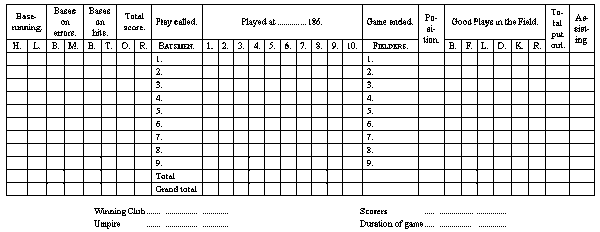
The letters on the left refer to the batting score, as follows:R, for runs; O, for outs; T, for the number of times the first base is made on hits; B, for number of bases on hits; M, for first base on muffs; B, for first base on called balls; L, for left on bases after clean hits; and H, for home-runs. On the right, the letters refer to the fielding only: B, for outs on bases; F, for fair fly-catches; L, for foul fly-catches; D, for foul bound catches; K, for outs on strikes; R, for run out; the last two columns being for the record of the total number of players put out by each fielder, and the total number of times each assisted in putting out players.
The following diagram presents the blank form used to record the particulars of a match game at its close:—
No. II. Batting Score.
| Club. | Club. | ||||||||
| Players. | Pos. | O. | R. | B. | Players. | Pos. | O. | R. | B. |
| 1. | 1. | ||||||||
| 2. | 2. | ||||||||
| 3. | 3. | ||||||||
| 4. | 4. | ||||||||
| 5. | 5. | ||||||||
| 6. | 6. | ||||||||
| 7. | 7. | ||||||||
| 8. | 8. | ||||||||
| 9. | 9. | ||||||||
| Totals | Totals | ||||||||
Innings.
| Clubs. | 1. | 2. | 3. | 4. | 5. | 6. | 7. | 8. | 9. | Totals. | |
| Home runs | |||||||||
| No. of times first base on hits | times | times. | |||||||
| No. of times first base by errors | times | times. | |||||||
| No. of times first base on three balls | times | times. | |||||||
| Total bases on hits | |||||||||
| Times left on bases after clean hits | |||||||||
Fielding Score.
| Base play—put out by | ||||||||||||||||
| Fly catches | ||||||||||||||||
| Foul bound catches | ||||||||||||||||
| Catches on strikes | ||||||||||||||||
| Double plays | ||||||||||||||||
| Outs on bases | times | times. | ||||||||||||||
| Outs on foul balls | times | times. | ||||||||||||||
| Total errors of play | ||||||||||||||||
| Umpire, Mr. | of the | Club, of | ||||||||||||||
| Owners, Messrs. | and | |||||||||||||||
| Time of game | hours | minutes. | ||||||||||||||
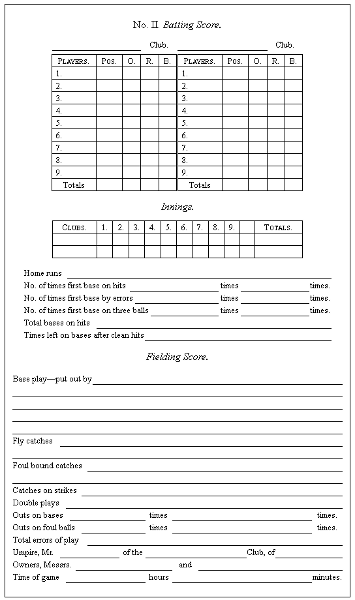
In recording a game on score-sheet No. 1 we proceed as follows:—Under the heading of “Batsmen” we place the names of the batting nine, and under the heading of “Fielders” we place the names of the opposing nine. These names are recorded on the two score-sheets of the score-book; the names of the two nines thus appearing on the book twice, once as batsmen and once as fielders. Over the heading “Batsmen” we record the time of commencing the game, and this is done only on the page of the nine who first go to the bat; the figures of the hour of closing the game being recorded over the heading “Fielders,” on the page of the nine who last go to the bat; and over the figures of the “innings” we record the name of the grounds the match was played on, and the date of the game.
Each fielder is numbered from 1 to 9, and in recording by whom players are put out these figures are used to indicate the name of the fielder. In recording the positions of the fielders we simply use the initials of the words of the position, thus C for “catcher,” P for “pitcher,” &c. Instead of using C for “centre field,” we use M for “middle field,” as C is used for “catcher.” The figures 1, 2, 3 are used to indicate the outs of each innings, and a dot thus (.) for each run. Dots only are used in recording the details of the batting on the left hand of the score-sheet, and also for recording the particulars of the fielding on the left. Thus, if the batsman secures his first base by a “clean hit”—that is, not by means of a wild throw, a dropped fly ball, or a palpably muffed ball—we place a dot in the square of the column of “times bases on hits” opposite the batsman’s name; and if instead he be put out on the fly, we place a dot in the square of the column headed “fly catches,” on the right, and opposite the fielder’s name. Now the above score only gives the data for estimating the skill of the batsman as far as his score of bases on hits, or on muffs, &c. is concerned, and of the skill of the fielder as far as the record of the totals of his work in the field is concerned. To complete the score, however, something more has to be done, and that is, to record how and by whom each batsman is put out; and how this is to be done we now proceed to show.
The scorer must first make himself familiar with the following abbreviations of words used to indicate the various movements and actions of the fielders, and these abbreviations will be found very easy to commit to memory. They are as follows:—
| A | Put out at | first base. |
| B | „ | second base. |
| C | „ | third base. |
| H | „ | home base. |
| F | Put out on | fly catch. |
| K | „ | three strikes. |
| R O | Put out | between bases. |
| L F | „ | on foul fly. |
| L D | „ | on foul bound. |
| T F | „ | on tip fly. |
| T D | „ | on tip bound. |
| H R | „ | for home run. |
As before stated, the figures 1, 2, 3 are used for recording the outs, and dots for runs; with small figures thus, 1st, 2d, 3d, to indicate being left on the bases.
The key to the above abbreviations is as follows. The first three letters of the alphabet indicate the first three bases, and we use the initial letters of the words Home, Fly, Run Out, and Tip, and the last letter of the words Struck, Foul, and Bound. Thus L stands for foul and F for fly, and both together for “foul fly.” The above system will be found to include everything necessary in recording the important details of a game, to the extent of showing the good plays made at the bat and in the field. In “reporting” the details of a match, however, we necessarily require a still more elaborate system, and our short-hand system for the use of reporters will be found in detail in our “Book of Reference,” published in New York.
In order to illustrate fully the working of the system of scoring above described, we will proceed to score an imaginary game as follows:—
Suppose the fielders in their places and the batsman in his, and
the scorers ready to record the game. “Play” is called, and the
time of beginning the game at once recorded. The first striker then
hits a ball, which is caught on the fly by the left-fielder, who is the
seventh striker, we will say, on the other side. On the square of
the first innings opposite the name of the first striker you first write
down the figure 1, indicating the first hand out, and above it write
the figure 7 and the letter F, and your record will then appear thus:
7 F
1
![]() the 7 representing the name of the fielder, and the
letter F the initial of the word fly, showing by whom and in what
manner the player was put out. Opposite the name of the seventh
fielder, too, under the head of “On fair fly,” you write down a dot,
which gives him credit for the fly catch in the score of good plays.
The second striker now takes the bat, and, hitting a low grounder to
centre-field, makes his second base just before the ball is well fielded
in to the second baseman. To record this properly you place a dot
opposite the batsman’s name to the left under the head of “number
of times” bases are made on hits; and in the next column you place
two dots, showing the number of bases made on the hit; or, if you
like to be more particular, you can write the figure 2 in place of the
two dots, and then you will know the bases he made on each hit.
The third striker now comes to the bat, and hits a ball to short-stop,
who passes it to the first baseman in time to put the player out.
You now have to record the second hand out, and you do it thus:
first, the figure 2 for second hand out, and the figure 3 for the
name of the short-stop, who is the third striker on the list of names
on the other side, and then 4 for the first baseman, who is the fourth[796]
striker. The square will then appear thus:
3-4 A
the 7 representing the name of the fielder, and the
letter F the initial of the word fly, showing by whom and in what
manner the player was put out. Opposite the name of the seventh
fielder, too, under the head of “On fair fly,” you write down a dot,
which gives him credit for the fly catch in the score of good plays.
The second striker now takes the bat, and, hitting a low grounder to
centre-field, makes his second base just before the ball is well fielded
in to the second baseman. To record this properly you place a dot
opposite the batsman’s name to the left under the head of “number
of times” bases are made on hits; and in the next column you place
two dots, showing the number of bases made on the hit; or, if you
like to be more particular, you can write the figure 2 in place of the
two dots, and then you will know the bases he made on each hit.
The third striker now comes to the bat, and hits a ball to short-stop,
who passes it to the first baseman in time to put the player out.
You now have to record the second hand out, and you do it thus:
first, the figure 2 for second hand out, and the figure 3 for the
name of the short-stop, who is the third striker on the list of names
on the other side, and then 4 for the first baseman, who is the fourth[796]
striker. The square will then appear thus:
3-4 A
2
![]() thereby showing
that the batsman was the second hand out by a ball fielded to
the first base player by the short-stop. You then, opposite the
fielders’ names to the right, under the head of “number of times
assisting,” place a dot opposite the third fielder’s name, and under
the head of “on bases,” a dot opposite the name of the fourth
fielder, thus crediting the short-stop with the assistance rendered and
the first baseman with putting the batsman out. The fourth striker
now takes the bat and strikes out, and you then record the out by
the figure 3 for the third hand out, and the letter K for struck out
(in this instance, as in one or two others, as we have shown, we
use the last letter of the word), and under the head of “on third
strike,” opposite the fielder’s name acting as catcher, we place a dot.
This closes the innings. When the game is closed, we add up the
total outs and runs charged and credited to each batsman, and place
the totals under the heading of “Outs and Runs” to the left of
the batsmen’s names. The above will suffice to show the general
plan of scoring we adopt in this system. The statistics of the batsman’s
play, to the left of the batsmen’s names, include his total score
of outs and runs, the total number of times the first base is made,
and the number of bases made on clean hits; and a similar record of
bases made on “muffed” and wildly thrown balls, and on balked
and called balls, together with the number of times base-runners are
left on bases, and the number of clean home runs. The statistics of
the fielding, to the right of the fielders’ names, include the totals of
outs on bases, on fair fly catches, on foul fly and foul bound catches,
on three strikes, from being run out, the totals of the players put
out, and of times assisting to put them out.
thereby showing
that the batsman was the second hand out by a ball fielded to
the first base player by the short-stop. You then, opposite the
fielders’ names to the right, under the head of “number of times
assisting,” place a dot opposite the third fielder’s name, and under
the head of “on bases,” a dot opposite the name of the fourth
fielder, thus crediting the short-stop with the assistance rendered and
the first baseman with putting the batsman out. The fourth striker
now takes the bat and strikes out, and you then record the out by
the figure 3 for the third hand out, and the letter K for struck out
(in this instance, as in one or two others, as we have shown, we
use the last letter of the word), and under the head of “on third
strike,” opposite the fielder’s name acting as catcher, we place a dot.
This closes the innings. When the game is closed, we add up the
total outs and runs charged and credited to each batsman, and place
the totals under the heading of “Outs and Runs” to the left of
the batsmen’s names. The above will suffice to show the general
plan of scoring we adopt in this system. The statistics of the batsman’s
play, to the left of the batsmen’s names, include his total score
of outs and runs, the total number of times the first base is made,
and the number of bases made on clean hits; and a similar record of
bases made on “muffed” and wildly thrown balls, and on balked
and called balls, together with the number of times base-runners are
left on bases, and the number of clean home runs. The statistics of
the fielding, to the right of the fielders’ names, include the totals of
outs on bases, on fair fly catches, on foul fly and foul bound catches,
on three strikes, from being run out, the totals of the players put
out, and of times assisting to put them out.
The American game of base-ball will be found an excellent substitute for cricket in England, for those who have not the leisure time for the English game, as a full game of nine innings a side can be played in three hours at most. It is a more vigorous exercise than cricket, and in a closely contested match, fully as exciting to spectators, when understood. For boys, after school hours, it is far better than cricket, owing to the short time required to play a game.
The four ball, or “American game” of billiards, differs both from the English and French game, and in a measure combines the merits of both. Though it does not require the skill the French game does, it avoids, by custom, the simple, mechanical “hazard” feature of the English game, as first-class American billiard-players at the hazard and carom game never hole the spot ball consecutively, as in the English game. In fact, the hazard feature of the American game is rapidly falling into disuse, the four ball carom game taking its place.
The American tables now are made without side pockets, and no saloon has any tables of this kind, except for playing pool; the four pocket tables and carom tables without pockets being the only style in vogue now. The four pocket tables were introduced by Michael Phelan, Esq., the “father” of the game in America.
The general principles of the American game, which unites those of all others, are as follows:—
To make a carom, the player must cause his own ball to strike two or more balls in the same shot.
When he strikes his adversary’s ball, and either the light or dark red, he scores two.
When he strikes the two red balls, or, in billiard phrase, caroms on them, he scores three.
There are two sorts of hazards—winning and losing.
A WINNING HAZARD is made by pocketing the adversary’s ball, or either of the red balls.
In the first case, the player scores two; in the second, he scores three.
When the player pockets his own ball it is a LOSING HAZARD. If his ball is pocketed after having struck the white or adversary’s ball, two points are added to the adversary’s score.
If the ball is pocketed after having struck either of the red balls, three points are added to the adversary’s score.
If the ball be pocketed after having made a carom or winning hazard, the player cannot score the count he may have made.
A miss, or a failure on the part of the player to strike any other ball with his own, counts one for the opponent.
The word carom, used in this portion of the work, is derived from the French word “carombolage.” In England the word “cannon” is used, an evidently corrupt derivation.
In learning all games of billiards practical experience is the best teacher. No amount of intellectual study can impart to a novice the manual dexterity and adroitness essential to the display of the beauties of the game. But months of labour and learning by practical experience alone may be avoided by learning thoroughly beforehand the principles of the science afterwards to be practised as an art.
Among the most important things in billiards is a good attitude, and to attain this should be the student’s first effort. Good attitude is the ‘groundwork’ of a player’s success. If his attitude be ungraceful, viz. strained or unnatural, his playing will assuredly be unreliable.
The student’s attitude must, in the first place, be perfectly easy and natural. His left foot should be slightly advanced, in a straight line, the right drawn backwards and pointing outwards, to the extent and at the angle most familiar and convenient to the player. The left arm should be extended and supported on the table by the tips of the fingers and the junction of the palm and the wrist (which position of the hand constitutes the natural bridge). His body should be perfectly balanced, and should form an acute angle with the side of the table at which he stands. The tapering end of the cue should rest in the natural groove formed by the elevation of the thumb; the thick end should be grasped in the right hand, loosely while being drawn back preparatory to the stroke, and firmly at the moment of contact with the ball. The cue should be held in a perfectly horizontal position, except in the case of some particular strokes, which will be described in the proper place. Beginners should pay especial attention to this. It should be impelled chiefly by the fore-arm, while the body should remain perfectly steady, as the slightest swaying motion of it will give a false direction to the stroke. The speed of the cue, and not the weight of the body, gives strength to the stroke.
In the instructions in the game contained in the body of this work, the fundamental principles of the game are fully exemplified and enlarged upon. But there are exceptions to these fundamental rules to which we now briefly refer, and among them may be prominently named the results of the different degrees of strength with which the cue ball is struck, inasmuch as important modifications of the angles of incidence and reflexion are produced by the varieties of strength in the impulsion of the ball.
It is a general law that the angle of incidence is equal to the angle of reflexion; this law is, however, modified in billiards by the degree of strength with which the cue ball is struck. The angle which the[799] cue-ball will take after striking a cushion, being materially altered by the force imparted to it, the greater the strength the more acute will the angle of reflexion become.
When the ball, instead of being played against a fixed and inert body, such as a cushion, is played against a moveable sphere, such as itself, the angle formed by the line of direction of the object-ball, and the line of the subsequent course of the cue-ball, will be more obtuse the greater the strength communicated to the cue-ball.
Without an approximate knowledge of the different degrees of strength to be imparted in order to produce different angles, the pupil labours through a maze of uncertainty; and if not of a patient and reflective tendency, is inclined to arrive at the hasty and erroneous conclusion, that chance constitutes an important element in successful billiard playing.
Before commenting further on the game we will proceed to give the rules of the American four ball game, and also of the French three ball game as played in America; and here we would acknowledge our indebtedness to Messrs. Phelan and Collender, the great billiard-table manufacturers of the United States, for the privilege of quoting from their complete publications on the science and practice of the game of billiards.
Whoever, playing from within the “string-line” against an outside cushion, brings the returning cue-ball nearest the head cushion, which is the one at which the players stand, is entitled to choice of balls and lead. Provided—
1. That, in stringing, the player’s ball has not touched his opponent’s while the latter was at rest. 2. Nor has fallen into any of the pockets. In either case the player loses choice and lead. 3. Should the cue-balls, both being in motion, come in contact, the strokes are invalid, and must be played over.
2. In “stringing,” it is required that both cue-balls shall be struck simultaneously, or so nearly together that one ball cannot reach the lower cushion before the other has been put in motion.
Note.—It will be well for players to bear in mind also that in “stringing” for the lead both cue-balls should be struck, if not simultaneously, at least so near together that one ball cannot reach the lower cushion before the other has been put in motion.
1. The player who wins the choice of balls and lead must either roll his ball down towards the lower cushion, as an object for his[800] adversary to play at, or else compel his adversary to lead off as above described.
2. In leading, the player’s ball must be played from within the string-line, and struck with sufficient strength to carry it beyond the deep-red ball on its appropriate spot at the foot of the table. But it must not be played with such strength as to repass, after coming in contact with the lower cushion, the deep-red ball. Nor yet must it touch either red ball, nor lodge on the cushion, nor fall into a pocket, nor jump off the table. In any of the cases mentioned in this section, or in case the cue-ball is not struck with sufficient strength to pass beyond the deep-red, it shall be optional with the adversary (Player No. 2) to make No. 1 spot his ball on the pool spot nearest the lower cushion, or lead again: or he may take the lead himself.
3. No count or forfeiture can be made or incurred until two strokes have been played.
4. Once the lead is made, the game is considered as commenced, and neither player can withdraw except under circumstances specified on page 803.
1. The game is opened by player No. 2 playing on the white ball at the foot of the table.
2. Should he fail to hit the white first, or fail to hit it at all, he forfeits one point, which shall be added to his adversary’s score. Should he pocket himself after hitting a red ball first, he loses three points, even though he may have subsequently hit the white.
1. If the striker fails to hit any of the other balls with his own, he forfeits one point, which, as well as other forfeitures, must be added to his adversary’s score. (See note, page 812.)
2. The striker forfeits two when the ball that he plays with is pocketed, or lodges on the cushion, or goes over the table, after having struck or been in fixed contact with the other white, no matter whether it has touched one or both of the reds.
[An exception to this clause will be found in Sec. 2, on “Opening the Game.”]
3. The striker forfeits three when the ball that he plays with is pocketed, or lodges on the cushion, or goes over the table, after having come in contact with one or both of the reds, and not the white. The same applies if neither red nor white be struck.
4. If the player cause any ball to jump off the table, and should it, by striking any of the bystanders, be flung back upon the table, it must still be treated as if it had fallen to the floor. If a red ball, it must be spotted; if a white, held in hand. Should it be the last striker’s ball, he forfeits two or three, the same as if he had gone into a pocket.
The penalty of a foul stroke is, that the player cannot count any points he may have made by such stroke, and his adversary is entitled to the next play. The following, in addition to those already mentioned, are foul strokes:—
1. If either player plays with his opponent’s ball, the stroke is foul; and, if successful, he cannot count, provided the error is found out before a second shot is made.
2. Should two or more strokes have been made previous to the discovery, the reckoning cannot be disturbed, and the player may continue his run with the same ball, or he may have the balls changed. The same privilege is extended to the opposing player when his turn comes to play.
3. Should it be found that both players have used the wrong ball successively, he who was first to play with the wrong ball cannot put in a claim of foul against his opponent, as the latter, in using the wrong ball, was simply playing from his proper position on the table.
[It is the position of the cue-ball, and not its mere colour or designation, that governs. Aside from this, before one player can charge another with error, it must be shown that no act of his contributed to that error.]
4. Though the striker, when playing with the wrong ball, cannot count what points he may make, except in those cases mentioned above, nevertheless, whatever forfeitures he may incur while playing with the wrong ball, he is bound to pay, as if he had been playing with his own.
5. Should, however, both the white balls be off the table together, and should either player, by mistake, pick up the wrong one and play with it, the stroke must stand, and he can count whatever he has made.
[As he plays from his proper position, it is immaterial, because no advantage is to be gained, which ball he uses. In this case, as in the others where it is permitted to play with the wrong ball, the balls should be changed at the conclusion of the run. This will prevent confusion and disputes.]
6. If the striker play at a ball before it is fully at rest, or while any other ball is rolling on the table, the stroke is foul.
7. If, after going into a pocket, a cue-ball or an object-ball should rebound and return to the bed of the table, it must be treated as a ball not pocketed.
8. If the player, when playing with the butt or side of his cue, does not withdraw the butt or side before the cue-ball touches the object-ball, the stroke is foul.
9. A stroke made while a red ball is off the table, provided its spot is unoccupied, is foul. When its proper spot is occupied, the[802] red must remain off the table until its spot is vacated and all the balls have ceased rolling. [See following rule.]
10. If the game being played is one in which hazards, or pockets, do not count, a red ball that has been pocketed or forced off the table shall be spotted on another spot, provided its own is occupied, and provided also the non-striker’s ball is off the table at the time. If the light-red, it shall be placed on the dark-red spot; and if that spot is occupied, the light-red shall be placed on the pool spot at the foot of the table. If the dark-red, it shall be placed on the light-red spot, &c. If both reds are off the table at the same time, and their spots are occupied by the two whites, one of the reds may be placed on the pool spot. The other must remain off the table until its proper spot is vacant.
Note.—In the full game, or when pockets are counted, the old rule applies, and the red ball, when its spot is occupied, must remain off the table until its spot is uncovered and all the balls have ceased rolling.
11. If, after making a successful stroke, the player obstructs or otherwise affects the free course of any ball in motion, the stroke is foul, and he cannot score the points made thereby.
12. A touch is a shot. And if, while the balls are at rest, a player touches or disturbs any ball on the table other than his own, it is foul. He has, however, the privilege of playing a stroke for safety, provided his own ball has not been touched, but he can make no count on the shot.
13. In playing a shot, if the cue leaves the ball and touches it again, the stroke is foul.
14. If the striker, through stretching forward or otherwise, has not at least one foot on the floor while striking, the shot is foul, and no points can be reckoned.
15. If, when the player’s ball is in hand, he does not cause it to pass outside the string before touching any of the object-balls or cushion (except in the case mentioned in the following rule), the stroke is foul, and his opponent may choose whether he will play with the balls as they are, have them replaced in their original positions, or cause the stroke to be played over; or, should the player make a losing hazard under such circumstances, the penalty may be enforced.
16. Playing at a ball whose base or point of contact with the table is outside the “string,” is considered playing out of the “string;” and the stroke is a fair one, even though the side which the cue-ball strikes is hanging over, and therefore within the “string.”
17. Playing directly at a ball that is considered in the “string” is foul, even though the cue-ball should pass wholly beyond the “string” line before coming in contact.
18. Giving a miss inside the “string,” when the player is in hand,[803] is foul. But he may, for safety, cause his ball to go out of the “string” and return.
19. If a player alters the stroke he is about to make, at the suggestion of any party in the room,—even if it be at the suggestion of his partner in a double match,—the altered stroke is foul.
20. Placing marks of any kind whatever, either upon the cushions or table, is foul; and a player, while engaged in a game, has no right to practise a particular stroke on another table.
[At the request of a majority of the leading players, amateur and professional, the rule observed since 1858, under which no count could be effected unless the striker first played upon some ball other than that with which his own was in contact, has been amended as below. The new rule came into effect January 1, 1867.]
1. When the cue-ball is in contact with any other ball, the striker may effect a count either by playing first upon some ball other than that with which his own is in contact, or by playing first against the cushion, or by a masse. In either of the two last-mentioned cases, it is immaterial which ball the returning cue-ball strikes first.
2. Should the cue-ball be in contact with all the other balls on the table,—or, if with two balls only, while the remaining ball is on the table, in such a way that the striker cannot play either on the free ball or the cushion first,—it shall be optional with him to have all the balls taken up and the reds spotted as at the commencement of the game. It shall also be at his option to take the lead himself or compel his opponent to lead.
[This is the same as starting the game anew, except that there is no occasion to “string” for the lead and choice of balls.]
1. The player may protest against his adversary standing in front of him, or in such close proximity as to disarrange his aim.
2. Also, against loud talking or any other annoyance by his opponent, while he is making his play.
3. Also, against being refused the use of the bridge, or any other of the instruments used in that room in playing, except when a special stipulation to the contrary was made before commencing the game.
4. Or in case his adversary shall refuse to abide by the marker’s, referee’s, or company’s decision on a disputed point, which it was agreed between them to submit to the marker or company for arbitration. In any one, or all of the foregoing cases, if the discourtesy be persisted in, the party aggrieved is at liberty to withdraw, and the game shall be considered as drawn, and any stakes which may have been depending on it must be returned.
5. Should the interruption or annoyance have been accidental, the marker, if so requested by the player, who is entitled to repeat his stroke, must replace the balls as near as possible in the position they occupied before the player made the stroke in which he was interrupted.
1. In the case mentioned in the 5th paragraph of the preceding rule.
2. Where any of the balls, when at rest, are moved by accident.
3. Where any of the balls, while rolling, are suddenly obstructed either by accident or design on the part of any person other than the player. In this case, the marker, if so requested by the players or referee, shall place the interrupted ball as nearly as possible in the situation which it would apparently have occupied had it not been stopped.
4. Where the cue-ball, resting on the edge of a pocket, drops into it before the striker has time to play.
5. Where the object-ball, in a similar position, is rolled back into the pocket by any of the ordinary vibrations of the table or atmosphere.
6. In all the cases aforementioned where it is specified that in consequence of a foul stroke the player’s opponent shall have the option either of playing at the balls as they are, or causing them to be replaced by the marker.
7. When either or both of the red balls are pocketed, or forced off the table, it is the marker’s duty to spot them before another stroke is played—except (the game being played is caroms and pockets) the spot appropriate to either be occupied by one of the playing balls, in which case the red one must be kept in hand until its position is uncovered.
8. If, after playing a ball, the player should attempt to obstruct or accelerate its progress by striking it again, blowing at it, or any other means, his opponent may either play at the balls as they stand, or call upon the referee or marker to replace them in the position they would otherwise have occupied.
9. It is the duty of each player to see that a ball is properly spotted before the next stroke is made. As in the case where a player is in hand, a claim of foul, after the cue-ball has been struck in the one instance, and the red ball disturbed in another, cannot be entertained. All claims to the effect that the red ball is not on its spot, or that the striker’s ball is not inside the “string” when he is about to play after having been in hand, should be made before the stroke is played, as it can seldom be decided after the stroke, whether there was any ground for the claim.
1. Each player must look after his own interest, and exercise his own discretion. His opponent cannot be compelled to answer such questions as, “Is the ball outside or inside the string?” “Are the balls in contact?” and so forth. These are questions for the player’s own judgment to decide.
2. When the cue-ball is very near another ball, the player must not play directly upon that ball without having warned his adversary that they do not touch, and given him or his umpire time to be satisfied on that point.
3. It is obligatory upon the adversary or umpire to call “time!” or give some other notice of his approach, if, while the player is preparing to make a stroke, either of them desires to look at the balls, or submit a question to the referee.
4. Each player should attend strictly to his own game, and never interfere with his adversary’s, except in the cases mentioned in Section 9, on p. 804, or when a foul stroke or some other violation of these rules may call for forfeiture.
1. In a single game, no one, except the player and his umpire, has a right to interfere with the play, or point out an error which either has been or is about to be committed. The player to whose prejudice the foul stroke is being or has been made, should find that out for himself.
2. Even after a stroke has been made, no one in the room has any right to comment upon it, either for praise or blame: for the same stroke may occur again in the course of the game, and the player’s play may be materially altered by the criticism to which he has just been listening.
3. Let the marker and spectators keep their places as much as possible, for if they crowd or move around the table they are liable to interfere with the players, and certain to distract their attention.
4. When the spectators are appealed to by the marker or referee for their opinion on a point which he has been asked, but finds himself unable to decide, such of them as are well acquainted with the game should answer according to the best of their knowledge and belief. Those who know little or nothing of the game would oblige themselves and others by at once confessing their incompetency. Either they may not have seen the disputed stroke, or, seeing it, may not have been familiar with its merits.
This is considered by many the finest and most scientific game of billiards in vogue. The game is played with three balls only, two white and one red, and on a carom table. The red is placed on the spot assigned to the dark-red in the American four-ball game. At the commencement of the game one of the white balls is placed on the light-red, or upper spot, connected with which is a described radius or semicircle of six inches, usually marked on the cloth with chalk. The other white ball, being “in hand,” may be played from any part of this semicircle, which answers for what is known as the “string” in the four-ball game, and whenever the cue-ball is “in hand” the player has the right of playing it from this half circle. Points are reckoned by caroms, which ordinarily count one point each; but when the rule of counting, as in the four-ball game, is allowed, then misses count, but not otherwise.
In France, where the three-ball game had its origin, there is no standard code of rules to govern it. In America the following rules are observed:—
1. The game is begun by stringing for the lead and choice of balls, as in the four-ball game, the same regulations governing. In “stringing,” the players should endeavour to strike the cue-balls simultaneously, and he whose ball stops nearest the cushion at the head of the table shall have the choice either of playing first or of making his adversary do so—a privilege which thereafter shall belong to both players alternately.
2. Unless a special agreement be entered into between the players and the table-keeper, the game commonly consists of twenty-one points, if each carom counts one only, and of forty-five when each carom counts two, and misses are scored.
3. The first to play places his ball in any part of the semicircle, at his option. He then plays at the ball on the deep-red spot, and has no right to hit the white first without having caused his ball to touch the cushion at some point outside of the “string.”
4. Player No. 2, whose ball has been placed on the spot, plays in his turn. On a carom table he has the right to play on either ball, even though both should be within the “string.” On a pocket table it is his privilege to have the red placed on its appropriate spot, or he may elect to play the balls as they are. Should he adopt the latter course in this instance, or at any other time he happens to be in hand on a pocket table, he must, before hitting either of the balls in the “string,” cause his own to pass outside.
5. When a player is in hand on a carom table, and the other balls are within the “string,” he may play directly upon either. But on a pocket table, he can only play as described in Section 4. Furthermore, he must confine his ball to the semicircle, and not let the lower[807] half of his body pass beyond the right line which the edge of the side cushion would describe if prolonged.
6. The player must have at least one foot on the floor.
7. A ball exactly on the “string line” is considered within the string.
8. The carom is good, and the points count for the player, even though his ball should be lost; and he continues to play. [A ball is considered lost which goes into a pocket, jumps off the table, or remains on a cushion.]
9. A pushing stroke subjects the player to the loss of the point or points he may have made by that stroke, and puts his ball out of hand.
10. A player who plays before all the balls have ceased rolling loses his stroke, and his hand is out.
11. When the cue-ball is in contact with one or more balls, all are taken up and placed as at the commencement of the game; and the player, being considered in hand, continues his play.
12. If the balls are disturbed accidentally, through the medium of any agency other than the player himself—as, for instance, through the interference of his opponent, or the marker, or other outside party—they must be replaced, and the player allowed to play.
13. If, in playing, or after having played, the player disturbs any ball other than his own, he cannot make a counting stroke, but he may play for safety. But if he touches his own ball, except with the cue, or if he touches it more than once with that instrument, the stroke is foul, and he cannot play for safety.
14. A player has no right to disturb the balls, and ought not to do it without the consent of his adversary.
15. When the cue-ball is very near another ball, the player ought not to play without warning his adversary that they do not touch, and giving him time to satisfy himself on that point.
16. Playing with the wrong ball is foul. The rules as to playing with the wrong ball in the four-ball game are applicable to the three-ball game.
17. Blowing on a ball, or using any other means to alter its course or position, is foul. If the player so offending is in play, he must yield the table to his adversary, should the latter demand it. In all cases, the opposing player shall have the privilege either of having the ball or balls replaced, or played with as they are.
18. If a lost ball, on being put back on the table, disturbs another, the ball so disturbed must be put in its place again by the marker or referee, and the player whose turn it is to play shall proceed.
19. The red ball being lost, and its spot being occupied, it shall be placed on the “string” spot; if this latter should happen to be occupied also, then the red shall be placed on the pool spot at the foot of the table. A white ball being lost and its spot being occupied, shall be placed on the deep-red spot, or if that is occupied, on the pool spot, provided that it is not the turn of the player whose ball is lost to play. In that case, there is no occasion for spotting the lost ball.
20. On a carom table, a lost white ball that has been placed on the “string” spot cannot be moved after the opposing player has played a stroke while the ball was in this position; but on a pocket table, where the owner of a white ball that has been lost is compelled to play outside of the “string,” he can, when his turn comes, play from any point within the semicircle, provided that his ball has not been struck by another. On a pocket table, it is held that a ball is in hand until it has been struck or moved from its position, it having been placed on the spot simply to afford the in-striker a chance to count. On the contrary, on a carom or pocket-less table, custom has made the rule that a lost ball ceases to be in hand after one stroke has been played; and, in consideration of this ruling, the player, instead of being allowed to shift the position of his ball, is privileged, in this country, to play at any ball irrespective of its being in or out of the “string,” and regardless, also, of whether he stands at the head or at either side of the table.
[Explanation.—The two rules last preceding may be further explained in this wise: Either on a pocket or a carom table, a ball that rolls on to and occupies the “string” spot in the course of play cannot be moved aside to permit the spotting of a white ball that has become “lost.” The lost ball must be spotted on the dark-red, or the pool spot, as directed in rule 19, if its owner is not entitled to the next play, or within the semicircle if he is. But when, on a carom table, a white ball has been placed on the “string” spot by either player, instead of having rolled thereon, it may be moved aside to accommodate a “lost” white ball, provided that subsequent to the placing of the ball as mentioned no stroke has been played. In marked contrast with this, a white ball that has been placed on the “string” spot on a pocket table, may be moved aside at any time in order to permit the spotting of a “lost” white ball, provided always that the first-mentioned ball has not been touched while occupying the spot.]
21. A player who abandons a game declares it lost by so doing.
There is a pretty variation of this game called the “Pillet Game,” in which the above rules are varied only to the extent of requiring the cue-ball to touch the cushion first before a carom can count, the score in this game being ten points up only.
The old adage, “Experience is a great teacher,” holds equally true in billiards as in any other of the many occupations of life. There is no royal road to learning, but the student of the present day enjoys vast facilities over his ancestors in the acquirement of every variety of knowledge. Every new fact promulgated aids in the development of additional facts, which, though ever existent, have but just been discovered. Bearing these axioms in mind, we propose to embody in[809] the present article a few hints to billiard players, which will enable the tyro at once to benefit by the information which the proficient has only obtained by years of practice and observation.
Remember that all players have equal rights, and that no gentleman will take any advantage of an antagonist excepting such as he may be fairly entitled to by superiority of judgment or of skill.
Never make any remark or unnecessary noise when your adversary is about to play, but stand away from the table and not opposite the pocket at which he may be playing.
Do not play carelessly, or strike at random, but with some definite object in view; and if no eligible stroke presents itself, endeavour to leave the balls as safe for your opponent as your skill will permit.
Never despair of winning a game; care and caution frequently insure success, even against apparent impossibilities. Fortune may seem to be against you, but remember that in the long run luck will invariably succumb to skill.
Attempt only strokes which seem to be within the compass of your abilities, except the necessities of the case require a deviation from this rule. This, however, is only to be considered a general law, and not by any means imperative.
Effecting the stroke at hand is but a part of the game, and the player should endeavour, in making this shot, to leave the balls in a position where a second count can be secured.
By way of illustration of some of the “points” in the game of billiards, we present below a few diagrams, and the first is that illustrative of the method of taking advantage of the chances for making points. The following is an explanation of abbreviations used in describing diagrams:—
A. stands for above the centre of the ball; B. for below it; R. to the right of it; L. to the left; and D. for diagonal. Q. P. means the strength or quantity of power with which the cue-ball must be struck. We describe as follows: Q. P. No. 1, strength enough to make the ball roll from the string to the lower cushion and back to the head cushion. Q. P. No. 2, from the string to the lower cushion, back to the head cushion, and from that to opposite the centre pocket. To propel it from the string to the opposite cushion, thence back to the head, and from that back to the lower cushion is Q. P. No. 3. Q. P. No. 4, is sufficient force to propel the ball from the string to the lower cushion, back to the head cushion, back to the lower cushion again, and thence half way down the table.
In playing billiards we frequently find the balls in a position where a count can be effected in several different ways. In such cases, it is advisable for the player to take into consideration the probabilities of effecting the stroke, and the position of the balls thereafter. If the stroke be at all doubtful, he should play where he would have the greatest prospect of success, or, in other words, “take the chances.”
We will suppose the cue-ball to be in hand, and the player desirous[810] of securing a good “break.” The diagram below illustrates the position.
If, in the above case, the student is playing the usual game, it would be advisable for him to play on the object-ball, so as to pocket it and return over line 1, in this way taking three chances to make a count. If he is playing caroms alone, it would be better for him to play on the left of the object-ball, so as to draw it back in the string, as near the other balls as possible. To make the first stroke: strike the cue-ball 1⁄4 A., 1⁄4 R., with Q. P. 21⁄2; and if the object-ball be pocketed in the corner, as represented, the carom will be made on one of the balls numbered 2 and 3. To make the second stroke: strike the cue-ball 1⁄4 A., 1⁄2 R., with Q. P. 21⁄2, the object-ball to be hit ⅜ L.
The grand strength and science of the game consists in managing the balls so as to leave them in a favourable position for the next play, or if the player considers it impossible to count, to leave them as safe as may be for his antagonist.
We cannot insist too strongly upon a perfect mastery of this art. After the player has acquired a thorough practical knowledge of the philosophy of the follow, the force and the twist, the next great essential is the exercise of judgment with regard to the feasibility of strokes and their relative relation to the game. The term judgment is applied to the choice of strokes. The player, for instance, may have two apparent shots; the first may recommend itself to him because it is more facile, but if made will leave the balls safe, while the second, although more difficult, will, if successful, leave the balls in a position where a second count or even a run can be effected. Judgment, therefore, would dictate that he should attempt the second, rather than the first.
The diagram annexed will illustrate our remarks.
Strike the cue-ball 1⁄4 B., ⅜ L., with Q. P. 21⁄2, the object-ball to be hit so as to make it roll over the lines, as represented, and the player will have a break of balls, which, with judicious management, will enable him to effect a long run.
With one more illustration of this feature of scientific play we close our article.
To play the balls as shown in the illustration following the player must strike the cue-ball a little below the centre, and with a deadened stroke, caroming gently on the second ball; the object-ball about one-third to the right. This carom should be practised until each position has become familiar to the player.
In either practice or ordinary play the beginner should never play carelessly, or strike at random, but with some definite object in view; and if no eligible stroke presents itself, endeavour to leave the balls as safe for your opponent as your skill will permit.
[Note.—There are two exceptions to this rule. The first occurs in leading off, and has already been explained. The second is where the cue-ball, while at rest, is in contact with another ball. Then the player does not forfeit. It is impossible to cause the cue-ball to hit, by a direct stroke, the ball with which it is in contact, and the player should not be penalized for failing to accomplish an impossibility. But, as it is possible for him to count by playing away from that ball—for example, by striking some other ball, or a cushion, first, or by taking up all the balls if his own is in contact with two or more—it is a settled ruling that, in case he should pocket his ball either by accident or design, or send it over the table, or cause it to lodge upon the cushion, he must pay forfeit—two points, if his ball was in contact with a white, and three if with a red.]
The game of La Crosse, now known as the “National game” of the new dominion of Canada, is of Indian origin, and is the oldest and only legitimate American game of ball now in vogue. La Crosse was played among the American Indians before the tread of a “pale face” invaded the “native heath” of the red man, and consequently our British friends cannot claim the credit of even originating the basis of this game, as in base-ball, though La Crosse resembles the Scotch game of Golf.
An attractive feature of La Crosse is that it can be played when base-ball or cricket cannot. No rolling or levelling of grounds are required, and but a merely nominal expense for materiel. The rules of La Crosse are simple enough for a child to comprehend them; but yet it is a game capable of yielding a great degree of exciting sport, both to the young and old as participants, and to both sexes as spectators. Moreover, wherever there is an ordinary field or common, if the grass be not too long, a ground is ready for a match. As regards the physical requisites and advantages, the former are the possession of pedestrian skill and endurance to a more or less degree, with considerable activity of movement, while the latter consist of the benefits the excitement of a contest and the rapid exercise the game yields, agility, speed, and endurance being developed in the process of becoming a skilful player in the game.
La Crosse is played by twelve men on each side. These twelve players occupy the following positions, viz.: goal-keeper, point, cover-point, centre, home, and seven fielders. The goal-keeper’s duty is to defend the goal; point is the player occupying the position out in the field, and nearest the goal-keeper; cover-point fronts the latter’s position; the “centre” is the player who faces the playing[813] party in the centre of the field; home is the position of the player who stands nearest the goal of the opposing twelve; and the fielders skirmish round generally.
Each contesting twelve elect a captain to superintend the game, and they choose umpires and toss for choice of goal.
There are two umpires, and these select a referee, whose decision on disputed points is final.
The “crosse” is a species of battledore, the ball being in the place of the shuttlecock, the difference being, that the portion of the bat formed by network is of a similar form to an English kite (see diagram). The network requires to be strung tightly together, so as not to “bag,” but to be quite level.
The ball is made of soft spongy rubber, not exceeding eight inches in circumference.
The goals consist of flag-poles, with flags, the poles standing six feet above the ground, and six feet apart generally, but the distance is optional on mutual agreement by the captains of the contesting sides. In front of each goal, and distant six feet therefrom, is drawn a line, called the “goal crease,” and within this line the players of the opposite side to that the goal belongs to are prohibited from standing, unless the ball is near the flags. The position of the umpires is behind the above goal flags. The goal-keeper, while defending the goal, may stop the ball in any manner he chooses.
The game consists of each party striving, by means of the crosse, or netted bat each player uses, to send the ball to the goal of their adversaries; and in doing this the ball must not be handled, or even touched by the hand, except it falls into a hole, in which case the man handling it must bat it direct to the nearest opponent; and except by the goal-keeper while defending his goal.
But the appended rules describe all further laws of the game.
It was not until 1867 that a regular code of rules was adopted for the government of all regular La Crosse clubs. These laws were enacted at the Convention of La Crosse Clubs, September 26, 1867, and are now the rules of play for Canada.
A Canadian writer on the game says:—“Although our early days were devoted to cricket, we must confess to a decided preference for our own game, with its athletic struggles. There is nothing like La Crosse. No other game throws such a fascination over the spectator, who seems riveted to the spot in admiration of the dashing and skilful play of the champion twelve. For beauty and variety, skilful play and sober excitement, it has no equal.”
Any information required about the game by those desirous of forming clubs, will be furnished by addressing the Secretary of the Montreal La Crosse Club, Montreal, Canada.
The following are the recognised code of rules governing La Crosse in the Canadas, where it has been adopted as the “National game” of the new dominion:—
Rule 1.—The “crosse” may be of any size to suit the player, but the network must not be bagged: it must be flat when the ball is not on it. A leading or outside string, above the level of the others, may be used. It may rest on the top of the stick, but must not have anything under to increase its height.
Rule 2.—The ball shall be india-rubber sponge, not less than eight, and not more than nine, inches in circumference. In matches it shall be furnished by the challenged party.
Rule 3.—The goals may be placed at any distance from each other, and in any position agreeable to the captains of both sides. The top of the flag-pole shall be six feet above the ground, including any top ornament, and six feet apart, and in a match may be furnished by either party.
Rule 4.—There shall be a line or crease, to be called the goal-crease, drawn in front of each goal, at a distance of six feet from the flags, within which no opponent shall stand, unless the ball is actually near or nearing the flags.
Rule 5.—Spectators must stand at least twenty feet from the goals.
Rule 6.—There shall be two umpires at each goal, one for each side. Unless otherwise agreed upon by the captains, they shall not be members of either club engaged in a match, nor can they be changed during a match, except for reasons of illness or injury. They must be thoroughly acquainted with the game, and in every way competent to act. Before a match begins, they shall see that all the regulations respecting the crosse, ball, goal, goal-crease, &c. are strictly complied with, and in deciding whether or not a crosse is bagged they shall take the opinion of the captains and the referee. During the game they shall stand behind the flags, and shall have power to decide all disputes, subject to Rule 7, and suspend from play any player infringing these laws. No umpire shall, either directly or indirectly, be interested in any bet upon the result of the match. No person shall speak to the umpires, or distract their attention when the ball is near or nearing their goal.
Rule 7.—The umpires shall select a referee, to whom all disputed games whereon they are a tie may be left for decision. He shall take the evidence of the players particularly interested, the respective opinions of the different umpires, and, if necessary, the opinions and offers of the captains, in cases where the discontinuance of the game is threatened. His decision shall in all cases be final.
Rule 8.—Field captains, to superintend the play, may be appointed by each side previous to a match, who shall toss up for choice of goal, and select umpires. They shall report any infringement of the laws to the umpires. They shall be members of the club by whom they are appointed, and may or may not be players in a match; and if not, they shall not carry crosses.
Rule 9.—The players of each side shall be designated as follows:—
Rule 10.—Twelve players on a side shall constitute a full field, and they must have been regular members of the club they represent, and of no other club, for thirty days prior to a match.
Rule 11.—No change of players shall be made after a match has been commenced, except for reasons of accident or injury during the match. When a match has been agreed upon, and one side is deficient in the number of players, their opponents may either limit their own players’ numbers to equal them, or compel them to fill up the complement.
Rule 12.—The players shall not wear spiked soles to their shoes.
Rule 13.—The ball must not be touched with the hand, save in the cases of Rules 14 and 15.
Rule 14.—The goal-keeper, while defending the goal within the goal-crease, may stop balls in any manner.
Rule 15.—Whenever the ball is taken up, or out of a hole, with the hand, during the progress of a game, it must be faced for with the nearest opponent.
Rule 16.—Should the ball be accidentally put through a goal by one of the players defending it, it is game for the side attacking that goal. Should it be put through a goal by any one not actually a player, it shall not count for or against either side.
Rule 17.—Players shall not hold each other, nor grasp an opponent’s crosse; neither shall they deliberately strike or trip each other, nor push with the hand.
Rule 18.—After each game the players shall change goals, unless otherwise agreed upon.
Rule 19.—Any player convicted of deliberate foul play, or infringement of these rules, shall be suspended from play by the umpires, at request of his captain.
Rule 20.—A match shall be decided by winning three games out of five, unless otherwise agreed upon.
Rule 21.—Any amendment, revision, or alteration, proposed to be made in any part of these laws, shall be made only at the Annual Conventions of “The National La Crosse Association of Canada,” and by a three-fourths’ vote of the members present.
R. CLAY, SON, AND TAYLOR, PRINTERS, BREAD STREET HILL.
This text follows the original work as much as possible. Inconsistencies in lay-out, spelling, hyphenation, capitalisation, etc.
have been retained, except as mentioned below.
Depending on the hard- and software used and their settings not all used symbols and characters may display correctly.
Hyperlinks point to the relevant sections, illustrations, etc., not necessarily to the page on which they appear in the original work.
The Table of Contents in the original work usually does not show all levels; this has not been changed. (Sub-)section headers show
different levels, based on the text. The sub-sections under Baseball, American Billiards and La Crosse are not mentioned in the original
Table of Contents, these have not been added.
Remarks on the text:
Page 75, hang from the strong downwards: possibly typographical error.
Page 127, orbele poplar: possibly error or variant spelling of abele poplar (white poplar).
Page 130, table: Smith’s scores are not according to the calculation given in the text; this has not been changed.
Page 389, illustration plate electrical machine: reference letters B are not visible in the original illustration.
Page 459, first illustration: reference letters D, E and F are not visible in the original illustration.
Page 487, spectra: the scans available of this edition show a fraction of letters in the right-hand margin of the page. A later
edition (1881) of the book shows the same illustration, the symbols for the elements have been taken from that edition. The “metal
discovered by Professor Bunsen” is rubidium. Page 490 lists the same elements.
Page 569: Angola rabbit it possibly a misspelling of Angora rabbit; the word occurs in other publications of the same period, and has not
been changed.
Page 627, (or Var. A.): there is no Var. A. for this game in the original work.
Page 650, Fig. 6: reference number 1 is missing from the original illustration.
Page 670, ... and ask some to choose ...: possibly (part of) a word is missing (someone, some person or similar).
Page 682, Amstelod.: Amstelodanum (Amsterdam).
Page 697, realgor: possibly error or variant of realgar.
Page 724, In order to the full success ...: possibly a word is missing (In order to achieve ... or similar).
Page 752 ff (stamp collecting): it is not always clear to which stamps the text refers; in those cases there are no hyperlinks to what
might be the illustrations referred to.
Page 764: Mecklenberg Schwerin: possibly error or English variant spelling for Mecklenburg Schwerin.
Page 798, carombolage: the French word is carambolage.
Page 812, a similar form to an English kite (see diagram): the diagram is not present in the original work.
Changes made to the text:
Some missing punctuation, repeated words and typographical errors have been corrected silently.
Footnotes have been moved to underneath paragraph they refer to.
i.e. and i. e. have been standardised to i. e.
Some illustrations have been moved from within text to underneath/above paragraph. Several tables and forms have been moved and
re-arranged; therefore page numbers referring to illustrations are not necessarily correct in this text.
Parts of some illustrations have been enhanced for better visibility.
Page vii: Snow-Ball changed to Snow-Balls; Will you ’List changed to Will you List (both as in text)
Page viii: The Hoop added (as in text)
Page ix: Under-hand-hand bowling changed to Under-hand bowling; Single Wicket changed to The Laws of Single Wicket (as in text)
Page x: The Britzschaka, New Brougham and The Family Coach deleted from ToC, these are illustrations, not sections; BROADSWORDS treated
as hierarchically higher level section, as in the text
Page xiii: Phantasmacope changed to Phantasmascope
Page xv: To crack Walnuts on your Elbow changed to To crack Walnuts in your Elbow (as in text)
Page xvi: The Row of Halfpence added
Page 1: Heading PART I added for consistency with other parts
Page 16: National-school doys changed to National-school boys
Page 17: water slashed over changed to water splashed over
Page 31: the second mode changed to The second mode
Page 124: fixed their staes changed to fixed their stakes
Page 155: snooters changed to shooters
Page 166: alloted changed to allotted
Page 170: illustration rotated 90°
Page 172: illustration (post) rotated 90°
Page 189, illustration: d changed to D as in text
Page 208: coupé sur peint changed to coupé sur point
Page 212, figure Target: inverted R changed to 1
Page 218: Page 605 changed to Page 219
Page 265, illustration: 7 changed to 4 as in text
Page 302: proportionably changed to proportionally
Page 310: not two high changed to not too high
Page 315, first illustration: text paragraph changed to caption
Page 328: free from noles changed to free from holes
Page 359: Is is a powerful supporter changed to It is a powerful supporter
Page 370, sal ammoniac: NH4C2 changed to NH4Cl
Page 371: section title IODINE--BROMINE--FLUORINE changed to IODINE as in ToC (sections on Bromine and Fluorine follow on same and next
page)
Page 381: hickel changed to nickel
Page 391, illustration ringing bells: reference letter A added
Page 392: the knob E changed to the knob F
Page 405: jet-d’eau changed to jet d’eau
Page 406: jet-d’-eau changed to jet d’eau
Page 408: superscripts in chemical formula changed to subscripts as elsewhere
Page 448: a open umbrella changed to an open umbrella
Page 453: representatation changed to representation
Page 489: Kirchoff changed to Kirchhoff; fraction 1⁄2,500,00: the numerator was lacking in the original,
numerator 1 has been added
Page 490: Kirchoff’s changed to Kirchhoff’s
Page 495: combe changed to combs
Page 505, Frequently the claws ...: “former” and “latter” reversed
Page 549, illustration Tumbler: moved to before section, caption deleted for consistency with other breeds
Page 551, illustration Fantail: moved to before section, caption deleted for consistency with other breeds
Page 554: hither and hither changed to hither and thither; créve cœur changed to crève cœur
Page 557: créve cœur changed to crève cœur
Page 593: indiarubber changed to india-rubber as elsewhere
Page 640, Variation A. on Black’s 3d Move: column headers BLACK and WHITE changed to WHITE and BLACK
Page 642, GAME II, White’s second move: 1. changed to 2.
Page 658: A changed to A
Page 676, Charles I. code: letter r inserted
Page 678: coded messages corrected to be in agreement with cipher given and coding procedure
Page 709: Mississipi changed to Mississippi
Page 712: Liliputian changed to Lilliputian
Page 719: Beurre Diel changed to Beurré Diel (as in Beurré d’Amanlis, same sentence)
Page 737, Cross Puzzle illustration: pieces renumbered according to solution
Page 760: à perçevoir changed to à percevoir
Page 767: Van Dieman’s Land changed to Van Diemen’s Land.
End of the Project Gutenberg EBook of Every Boy's Book: A Complete
Encyclopædia of Sports and Amusements, by Various
*** END OF THIS PROJECT GUTENBERG EBOOK EVERY BOY'S BOOK: SPORTS AND AMUSEMENTS ***
***** This file should be named 42172-h.htm or 42172-h.zip *****
This and all associated files of various formats will be found in:
http://www.gutenberg.org/4/2/1/7/42172/
Produced by Chris Curnow, Harry Lamé and the Online
Distributed Proofreading Team at http://www.pgdp.net (This
file was produced from images generously made available
by The Internet Archive)
Updated editions will replace the previous one--the old editions
will be renamed.
Creating the works from public domain print editions means that no
one owns a United States copyright in these works, so the Foundation
(and you!) can copy and distribute it in the United States without
permission and without paying copyright royalties. Special rules,
set forth in the General Terms of Use part of this license, apply to
copying and distributing Project Gutenberg-tm electronic works to
protect the PROJECT GUTENBERG-tm concept and trademark. Project
Gutenberg is a registered trademark, and may not be used if you
charge for the eBooks, unless you receive specific permission. If you
do not charge anything for copies of this eBook, complying with the
rules is very easy. You may use this eBook for nearly any purpose
such as creation of derivative works, reports, performances and
research. They may be modified and printed and given away--you may do
practically ANYTHING with public domain eBooks. Redistribution is
subject to the trademark license, especially commercial
redistribution.
*** START: FULL LICENSE ***
THE FULL PROJECT GUTENBERG LICENSE
PLEASE READ THIS BEFORE YOU DISTRIBUTE OR USE THIS WORK
To protect the Project Gutenberg-tm mission of promoting the free
distribution of electronic works, by using or distributing this work
(or any other work associated in any way with the phrase "Project
Gutenberg"), you agree to comply with all the terms of the Full Project
Gutenberg-tm License available with this file or online at
www.gutenberg.org/license.
Section 1. General Terms of Use and Redistributing Project Gutenberg-tm
electronic works
1.A. By reading or using any part of this Project Gutenberg-tm
electronic work, you indicate that you have read, understand, agree to
and accept all the terms of this license and intellectual property
(trademark/copyright) agreement. If you do not agree to abide by all
the terms of this agreement, you must cease using and return or destroy
all copies of Project Gutenberg-tm electronic works in your possession.
If you paid a fee for obtaining a copy of or access to a Project
Gutenberg-tm electronic work and you do not agree to be bound by the
terms of this agreement, you may obtain a refund from the person or
entity to whom you paid the fee as set forth in paragraph 1.E.8.
1.B. "Project Gutenberg" is a registered trademark. It may only be
used on or associated in any way with an electronic work by people who
agree to be bound by the terms of this agreement. There are a few
things that you can do with most Project Gutenberg-tm electronic works
even without complying with the full terms of this agreement. See
paragraph 1.C below. There are a lot of things you can do with Project
Gutenberg-tm electronic works if you follow the terms of this agreement
and help preserve free future access to Project Gutenberg-tm electronic
works. See paragraph 1.E below.
1.C. The Project Gutenberg Literary Archive Foundation ("the Foundation"
or PGLAF), owns a compilation copyright in the collection of Project
Gutenberg-tm electronic works. Nearly all the individual works in the
collection are in the public domain in the United States. If an
individual work is in the public domain in the United States and you are
located in the United States, we do not claim a right to prevent you from
copying, distributing, performing, displaying or creating derivative
works based on the work as long as all references to Project Gutenberg
are removed. Of course, we hope that you will support the Project
Gutenberg-tm mission of promoting free access to electronic works by
freely sharing Project Gutenberg-tm works in compliance with the terms of
this agreement for keeping the Project Gutenberg-tm name associated with
the work. You can easily comply with the terms of this agreement by
keeping this work in the same format with its attached full Project
Gutenberg-tm License when you share it without charge with others.
1.D. The copyright laws of the place where you are located also govern
what you can do with this work. Copyright laws in most countries are in
a constant state of change. If you are outside the United States, check
the laws of your country in addition to the terms of this agreement
before downloading, copying, displaying, performing, distributing or
creating derivative works based on this work or any other Project
Gutenberg-tm work. The Foundation makes no representations concerning
the copyright status of any work in any country outside the United
States.
1.E. Unless you have removed all references to Project Gutenberg:
1.E.1. The following sentence, with active links to, or other immediate
access to, the full Project Gutenberg-tm License must appear prominently
whenever any copy of a Project Gutenberg-tm work (any work on which the
phrase "Project Gutenberg" appears, or with which the phrase "Project
Gutenberg" is associated) is accessed, displayed, performed, viewed,
copied or distributed:
This eBook is for the use of anyone anywhere at no cost and with
almost no restrictions whatsoever. You may copy it, give it away or
re-use it under the terms of the Project Gutenberg License included
with this eBook or online at www.gutenberg.org
1.E.2. If an individual Project Gutenberg-tm electronic work is derived
from the public domain (does not contain a notice indicating that it is
posted with permission of the copyright holder), the work can be copied
and distributed to anyone in the United States without paying any fees
or charges. If you are redistributing or providing access to a work
with the phrase "Project Gutenberg" associated with or appearing on the
work, you must comply either with the requirements of paragraphs 1.E.1
through 1.E.7 or obtain permission for the use of the work and the
Project Gutenberg-tm trademark as set forth in paragraphs 1.E.8 or
1.E.9.
1.E.3. If an individual Project Gutenberg-tm electronic work is posted
with the permission of the copyright holder, your use and distribution
must comply with both paragraphs 1.E.1 through 1.E.7 and any additional
terms imposed by the copyright holder. Additional terms will be linked
to the Project Gutenberg-tm License for all works posted with the
permission of the copyright holder found at the beginning of this work.
1.E.4. Do not unlink or detach or remove the full Project Gutenberg-tm
License terms from this work, or any files containing a part of this
work or any other work associated with Project Gutenberg-tm.
1.E.5. Do not copy, display, perform, distribute or redistribute this
electronic work, or any part of this electronic work, without
prominently displaying the sentence set forth in paragraph 1.E.1 with
active links or immediate access to the full terms of the Project
Gutenberg-tm License.
1.E.6. You may convert to and distribute this work in any binary,
compressed, marked up, nonproprietary or proprietary form, including any
word processing or hypertext form. However, if you provide access to or
distribute copies of a Project Gutenberg-tm work in a format other than
"Plain Vanilla ASCII" or other format used in the official version
posted on the official Project Gutenberg-tm web site (www.gutenberg.org),
you must, at no additional cost, fee or expense to the user, provide a
copy, a means of exporting a copy, or a means of obtaining a copy upon
request, of the work in its original "Plain Vanilla ASCII" or other
form. Any alternate format must include the full Project Gutenberg-tm
License as specified in paragraph 1.E.1.
1.E.7. Do not charge a fee for access to, viewing, displaying,
performing, copying or distributing any Project Gutenberg-tm works
unless you comply with paragraph 1.E.8 or 1.E.9.
1.E.8. You may charge a reasonable fee for copies of or providing
access to or distributing Project Gutenberg-tm electronic works provided
that
- You pay a royalty fee of 20% of the gross profits you derive from
the use of Project Gutenberg-tm works calculated using the method
you already use to calculate your applicable taxes. The fee is
owed to the owner of the Project Gutenberg-tm trademark, but he
has agreed to donate royalties under this paragraph to the
Project Gutenberg Literary Archive Foundation. Royalty payments
must be paid within 60 days following each date on which you
prepare (or are legally required to prepare) your periodic tax
returns. Royalty payments should be clearly marked as such and
sent to the Project Gutenberg Literary Archive Foundation at the
address specified in Section 4, "Information about donations to
the Project Gutenberg Literary Archive Foundation."
- You provide a full refund of any money paid by a user who notifies
you in writing (or by e-mail) within 30 days of receipt that s/he
does not agree to the terms of the full Project Gutenberg-tm
License. You must require such a user to return or
destroy all copies of the works possessed in a physical medium
and discontinue all use of and all access to other copies of
Project Gutenberg-tm works.
- You provide, in accordance with paragraph 1.F.3, a full refund of any
money paid for a work or a replacement copy, if a defect in the
electronic work is discovered and reported to you within 90 days
of receipt of the work.
- You comply with all other terms of this agreement for free
distribution of Project Gutenberg-tm works.
1.E.9. If you wish to charge a fee or distribute a Project Gutenberg-tm
electronic work or group of works on different terms than are set
forth in this agreement, you must obtain permission in writing from
both the Project Gutenberg Literary Archive Foundation and Michael
Hart, the owner of the Project Gutenberg-tm trademark. Contact the
Foundation as set forth in Section 3 below.
1.F.
1.F.1. Project Gutenberg volunteers and employees expend considerable
effort to identify, do copyright research on, transcribe and proofread
public domain works in creating the Project Gutenberg-tm
collection. Despite these efforts, Project Gutenberg-tm electronic
works, and the medium on which they may be stored, may contain
"Defects," such as, but not limited to, incomplete, inaccurate or
corrupt data, transcription errors, a copyright or other intellectual
property infringement, a defective or damaged disk or other medium, a
computer virus, or computer codes that damage or cannot be read by
your equipment.
1.F.2. LIMITED WARRANTY, DISCLAIMER OF DAMAGES - Except for the "Right
of Replacement or Refund" described in paragraph 1.F.3, the Project
Gutenberg Literary Archive Foundation, the owner of the Project
Gutenberg-tm trademark, and any other party distributing a Project
Gutenberg-tm electronic work under this agreement, disclaim all
liability to you for damages, costs and expenses, including legal
fees. YOU AGREE THAT YOU HAVE NO REMEDIES FOR NEGLIGENCE, STRICT
LIABILITY, BREACH OF WARRANTY OR BREACH OF CONTRACT EXCEPT THOSE
PROVIDED IN PARAGRAPH 1.F.3. YOU AGREE THAT THE FOUNDATION, THE
TRADEMARK OWNER, AND ANY DISTRIBUTOR UNDER THIS AGREEMENT WILL NOT BE
LIABLE TO YOU FOR ACTUAL, DIRECT, INDIRECT, CONSEQUENTIAL, PUNITIVE OR
INCIDENTAL DAMAGES EVEN IF YOU GIVE NOTICE OF THE POSSIBILITY OF SUCH
DAMAGE.
1.F.3. LIMITED RIGHT OF REPLACEMENT OR REFUND - If you discover a
defect in this electronic work within 90 days of receiving it, you can
receive a refund of the money (if any) you paid for it by sending a
written explanation to the person you received the work from. If you
received the work on a physical medium, you must return the medium with
your written explanation. The person or entity that provided you with
the defective work may elect to provide a replacement copy in lieu of a
refund. If you received the work electronically, the person or entity
providing it to you may choose to give you a second opportunity to
receive the work electronically in lieu of a refund. If the second copy
is also defective, you may demand a refund in writing without further
opportunities to fix the problem.
1.F.4. Except for the limited right of replacement or refund set forth
in paragraph 1.F.3, this work is provided to you 'AS-IS', WITH NO OTHER
WARRANTIES OF ANY KIND, EXPRESS OR IMPLIED, INCLUDING BUT NOT LIMITED TO
WARRANTIES OF MERCHANTABILITY OR FITNESS FOR ANY PURPOSE.
1.F.5. Some states do not allow disclaimers of certain implied
warranties or the exclusion or limitation of certain types of damages.
If any disclaimer or limitation set forth in this agreement violates the
law of the state applicable to this agreement, the agreement shall be
interpreted to make the maximum disclaimer or limitation permitted by
the applicable state law. The invalidity or unenforceability of any
provision of this agreement shall not void the remaining provisions.
1.F.6. INDEMNITY - You agree to indemnify and hold the Foundation, the
trademark owner, any agent or employee of the Foundation, anyone
providing copies of Project Gutenberg-tm electronic works in accordance
with this agreement, and any volunteers associated with the production,
promotion and distribution of Project Gutenberg-tm electronic works,
harmless from all liability, costs and expenses, including legal fees,
that arise directly or indirectly from any of the following which you do
or cause to occur: (a) distribution of this or any Project Gutenberg-tm
work, (b) alteration, modification, or additions or deletions to any
Project Gutenberg-tm work, and (c) any Defect you cause.
Section 2. Information about the Mission of Project Gutenberg-tm
Project Gutenberg-tm is synonymous with the free distribution of
electronic works in formats readable by the widest variety of computers
including obsolete, old, middle-aged and new computers. It exists
because of the efforts of hundreds of volunteers and donations from
people in all walks of life.
Volunteers and financial support to provide volunteers with the
assistance they need are critical to reaching Project Gutenberg-tm's
goals and ensuring that the Project Gutenberg-tm collection will
remain freely available for generations to come. In 2001, the Project
Gutenberg Literary Archive Foundation was created to provide a secure
and permanent future for Project Gutenberg-tm and future generations.
To learn more about the Project Gutenberg Literary Archive Foundation
and how your efforts and donations can help, see Sections 3 and 4
and the Foundation information page at www.gutenberg.org
Section 3. Information about the Project Gutenberg Literary Archive
Foundation
The Project Gutenberg Literary Archive Foundation is a non profit
501(c)(3) educational corporation organized under the laws of the
state of Mississippi and granted tax exempt status by the Internal
Revenue Service. The Foundation's EIN or federal tax identification
number is 64-6221541. Contributions to the Project Gutenberg
Literary Archive Foundation are tax deductible to the full extent
permitted by U.S. federal laws and your state's laws.
The Foundation's principal office is located at 4557 Melan Dr. S.
Fairbanks, AK, 99712., but its volunteers and employees are scattered
throughout numerous locations. Its business office is located at 809
North 1500 West, Salt Lake City, UT 84116, (801) 596-1887. Email
contact links and up to date contact information can be found at the
Foundation's web site and official page at www.gutenberg.org/contact
For additional contact information:
Dr. Gregory B. Newby
Chief Executive and Director
[email protected]
Section 4. Information about Donations to the Project Gutenberg
Literary Archive Foundation
Project Gutenberg-tm depends upon and cannot survive without wide
spread public support and donations to carry out its mission of
increasing the number of public domain and licensed works that can be
freely distributed in machine readable form accessible by the widest
array of equipment including outdated equipment. Many small donations
($1 to $5,000) are particularly important to maintaining tax exempt
status with the IRS.
The Foundation is committed to complying with the laws regulating
charities and charitable donations in all 50 states of the United
States. Compliance requirements are not uniform and it takes a
considerable effort, much paperwork and many fees to meet and keep up
with these requirements. We do not solicit donations in locations
where we have not received written confirmation of compliance. To
SEND DONATIONS or determine the status of compliance for any
particular state visit www.gutenberg.org/donate
While we cannot and do not solicit contributions from states where we
have not met the solicitation requirements, we know of no prohibition
against accepting unsolicited donations from donors in such states who
approach us with offers to donate.
International donations are gratefully accepted, but we cannot make
any statements concerning tax treatment of donations received from
outside the United States. U.S. laws alone swamp our small staff.
Please check the Project Gutenberg Web pages for current donation
methods and addresses. Donations are accepted in a number of other
ways including checks, online payments and credit card donations.
To donate, please visit: www.gutenberg.org/donate
Section 5. General Information About Project Gutenberg-tm electronic
works.
Professor Michael S. Hart was the originator of the Project Gutenberg-tm
concept of a library of electronic works that could be freely shared
with anyone. For forty years, he produced and distributed Project
Gutenberg-tm eBooks with only a loose network of volunteer support.
Project Gutenberg-tm eBooks are often created from several printed
editions, all of which are confirmed as Public Domain in the U.S.
unless a copyright notice is included. Thus, we do not necessarily
keep eBooks in compliance with any particular paper edition.
Most people start at our Web site which has the main PG search facility:
www.gutenberg.org
This Web site includes information about Project Gutenberg-tm,
including how to make donations to the Project Gutenberg Literary
Archive Foundation, how to help produce our new eBooks, and how to
subscribe to our email newsletter to hear about new eBooks.